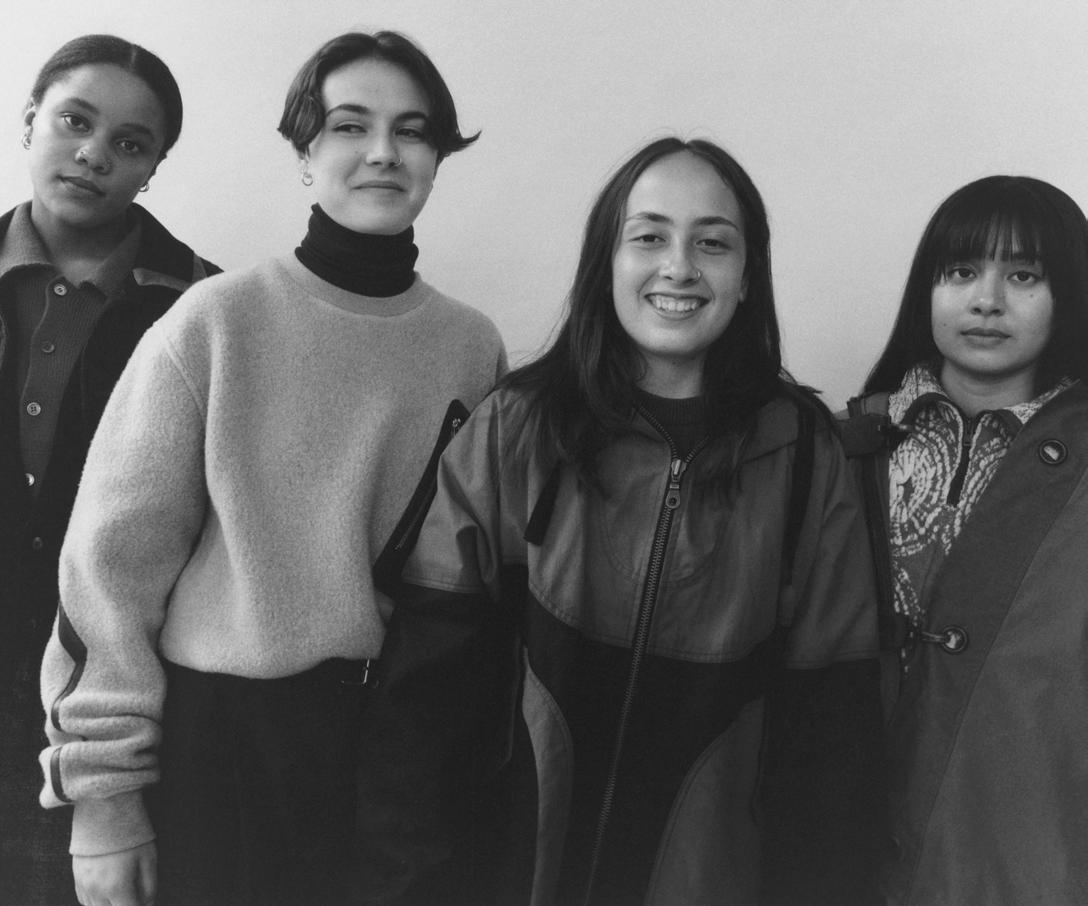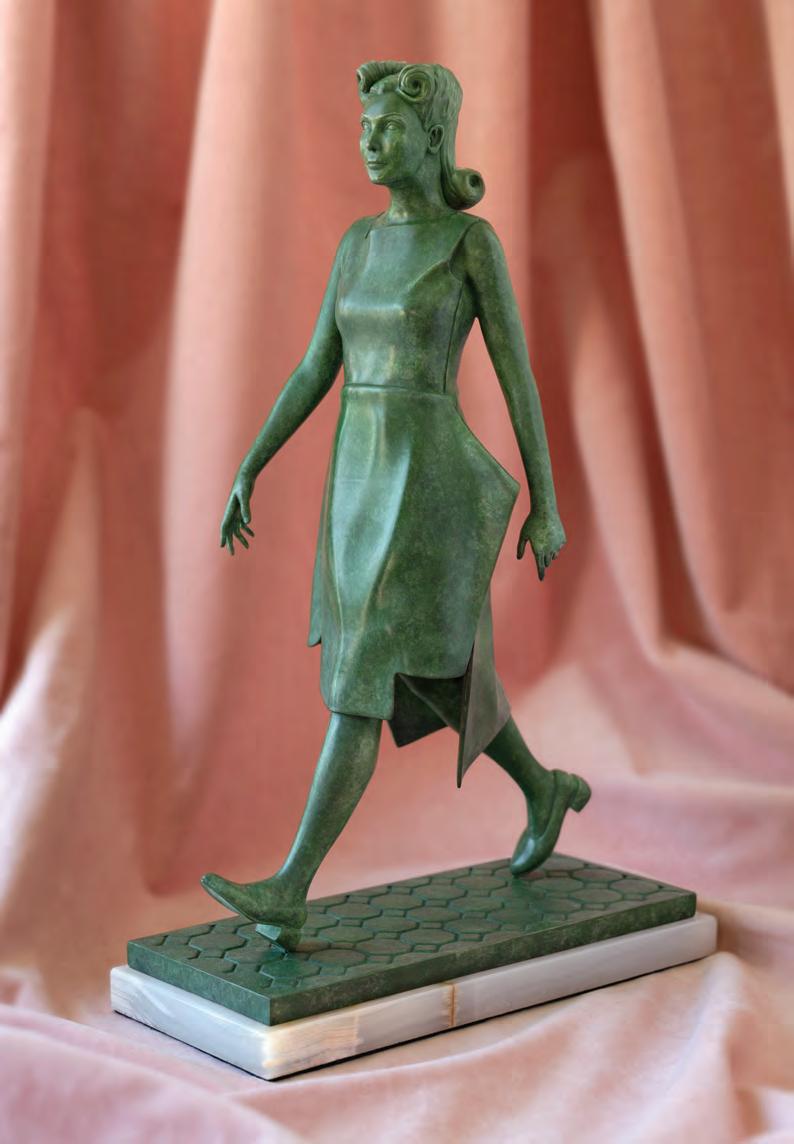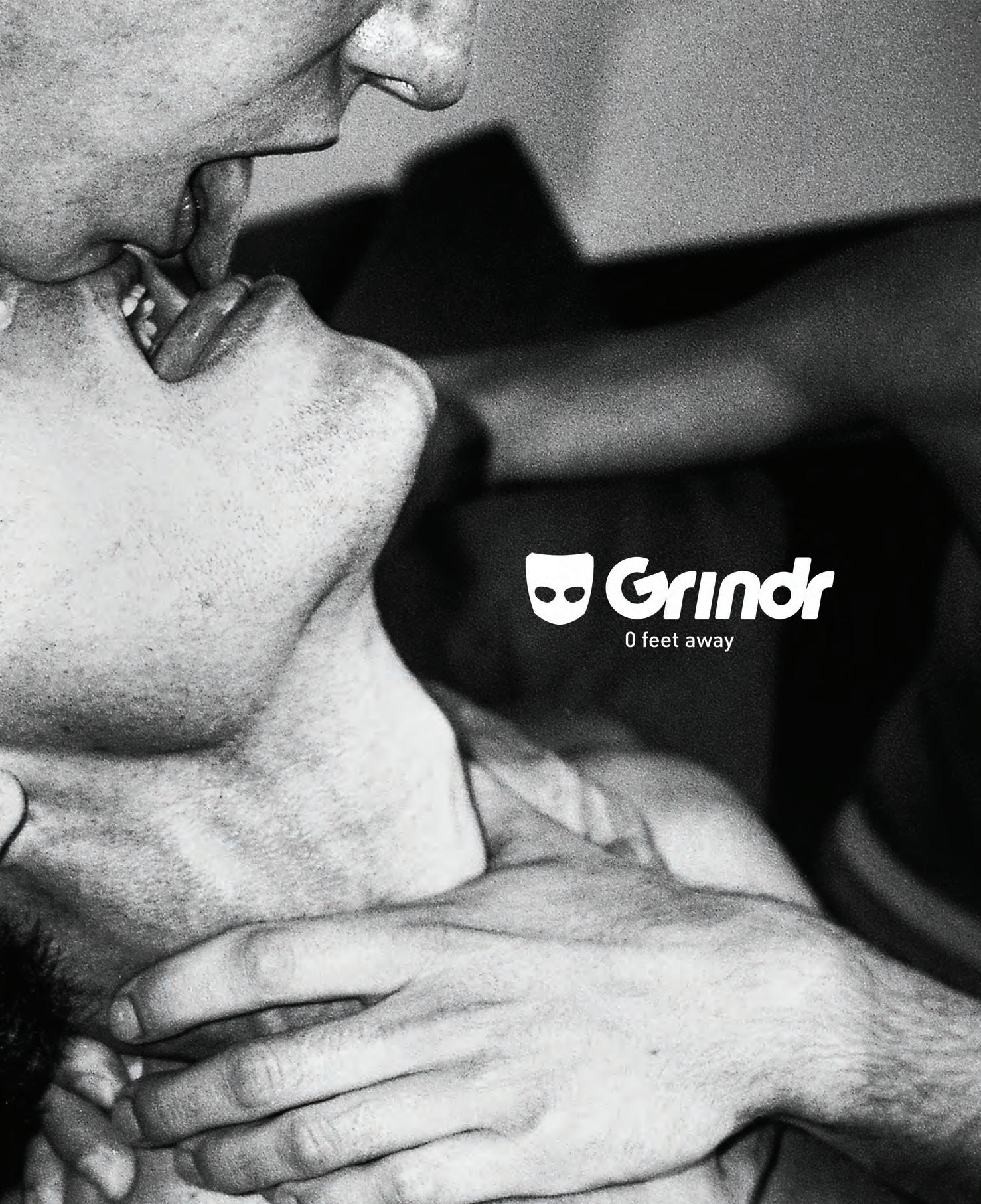AU




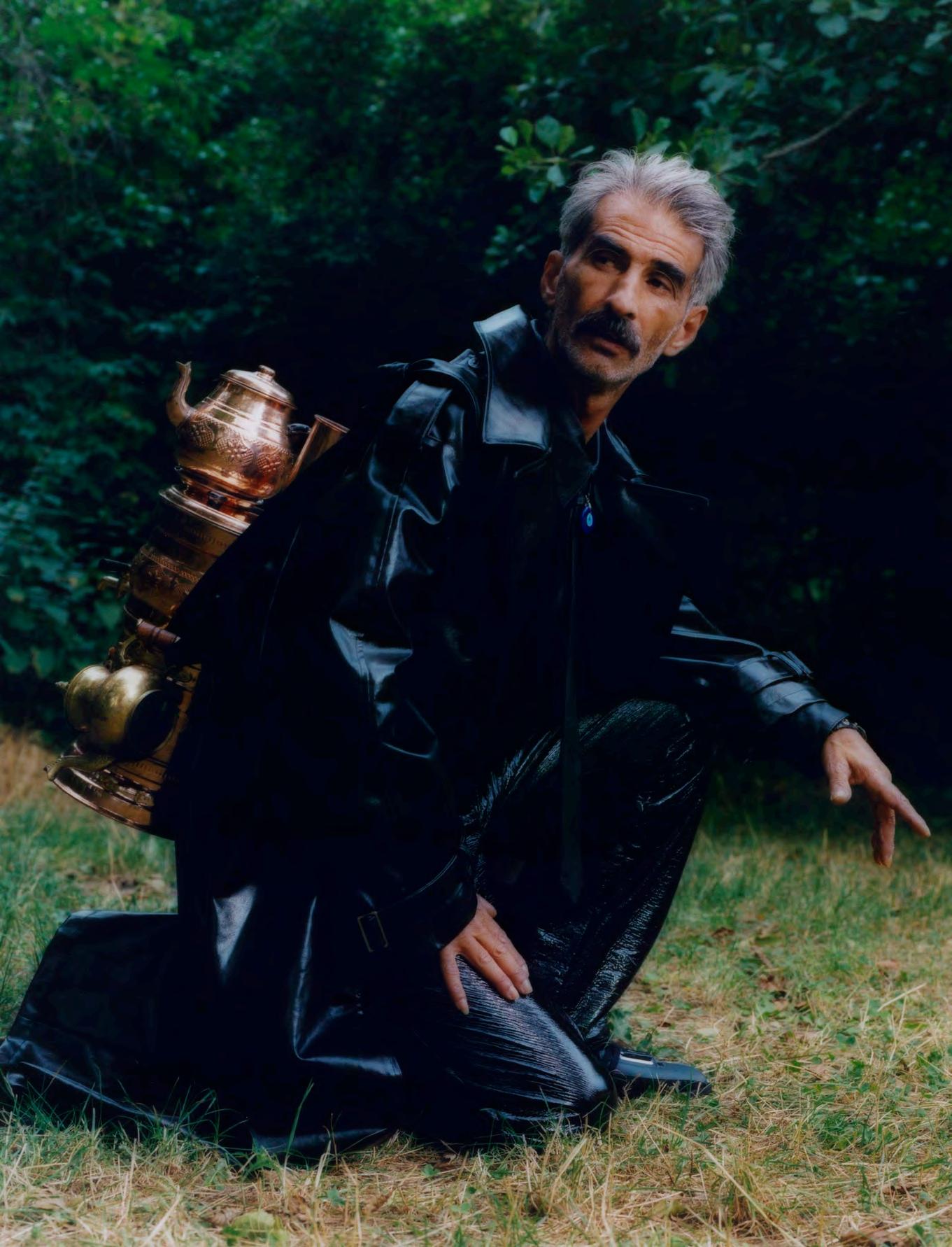

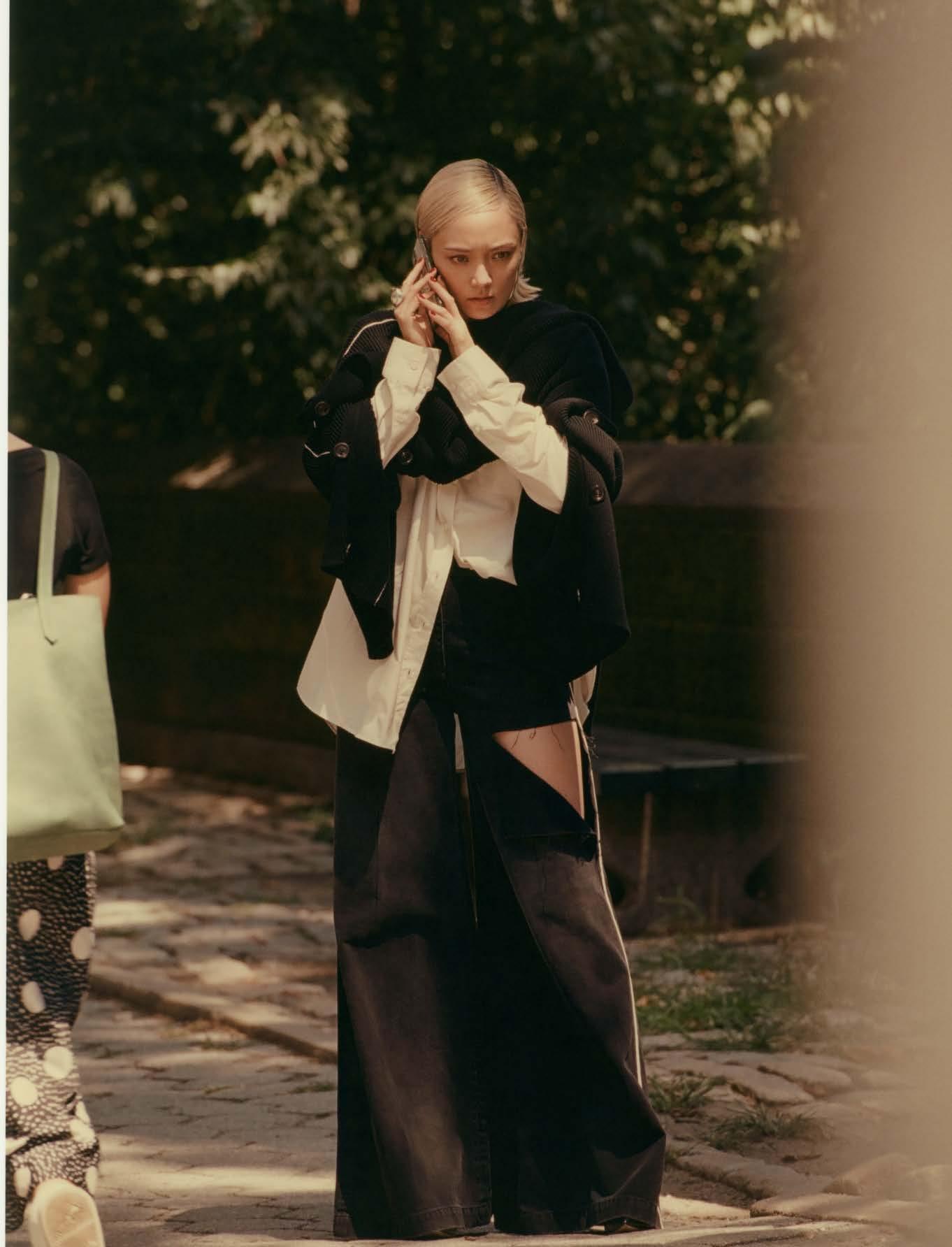
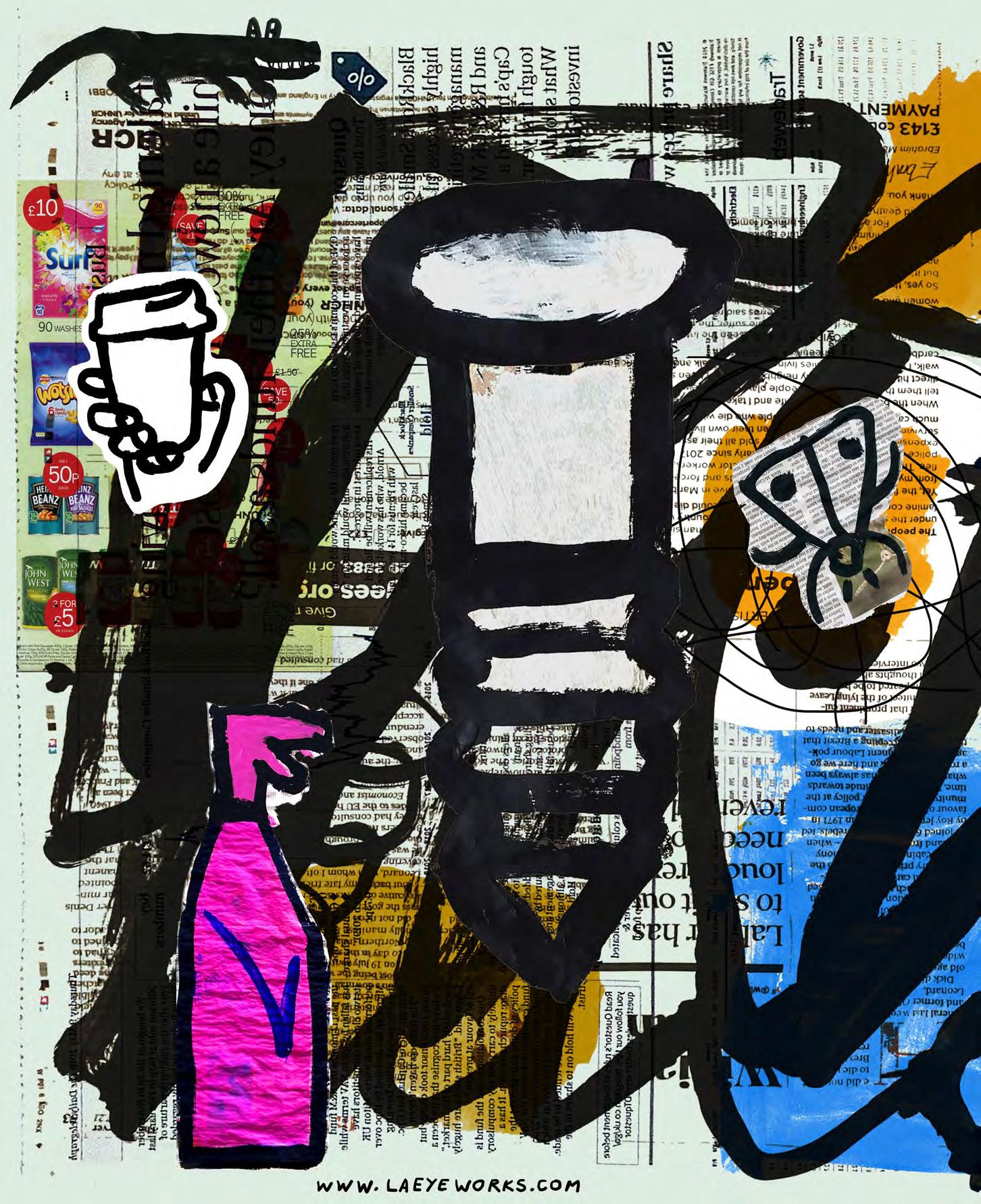
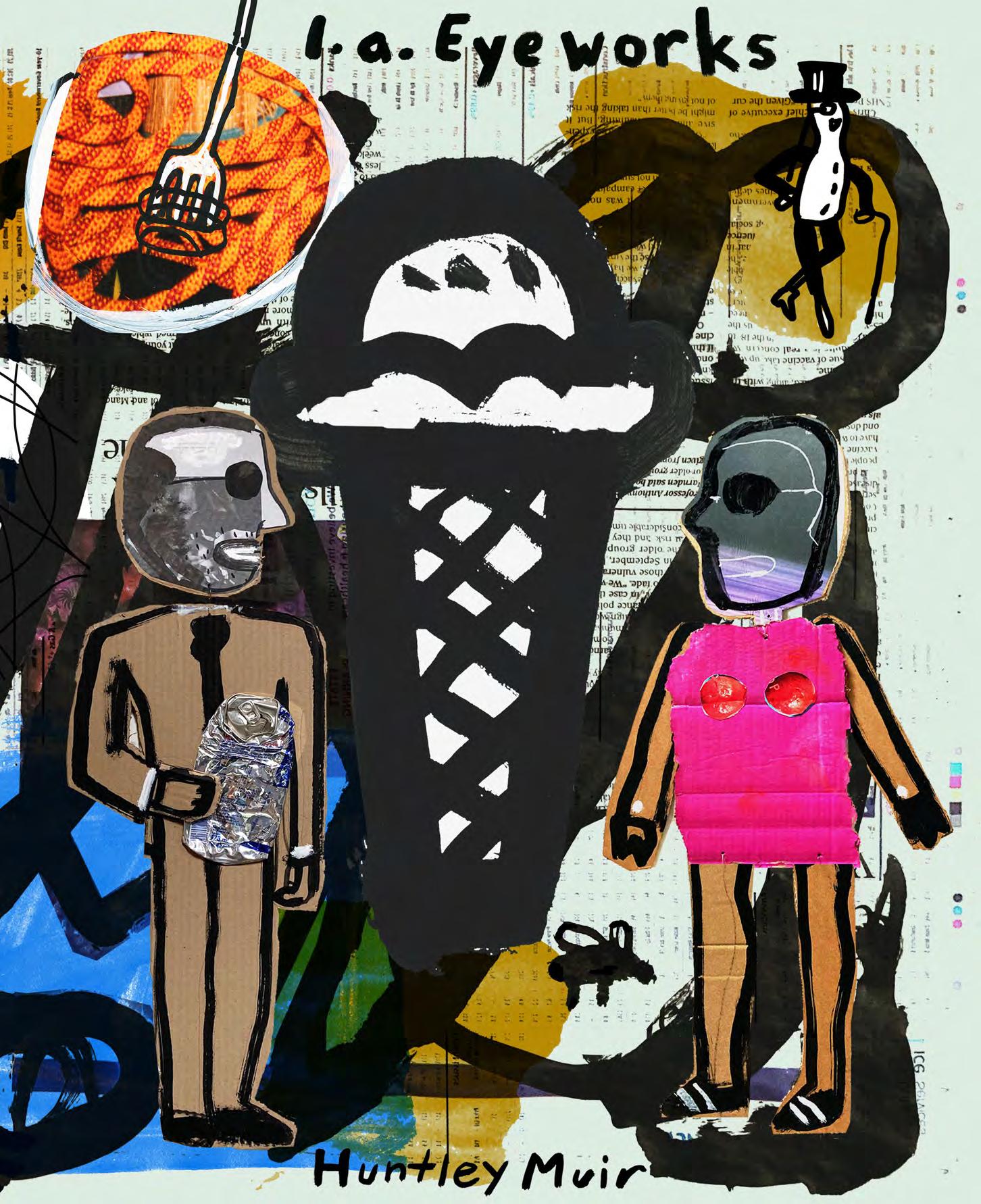



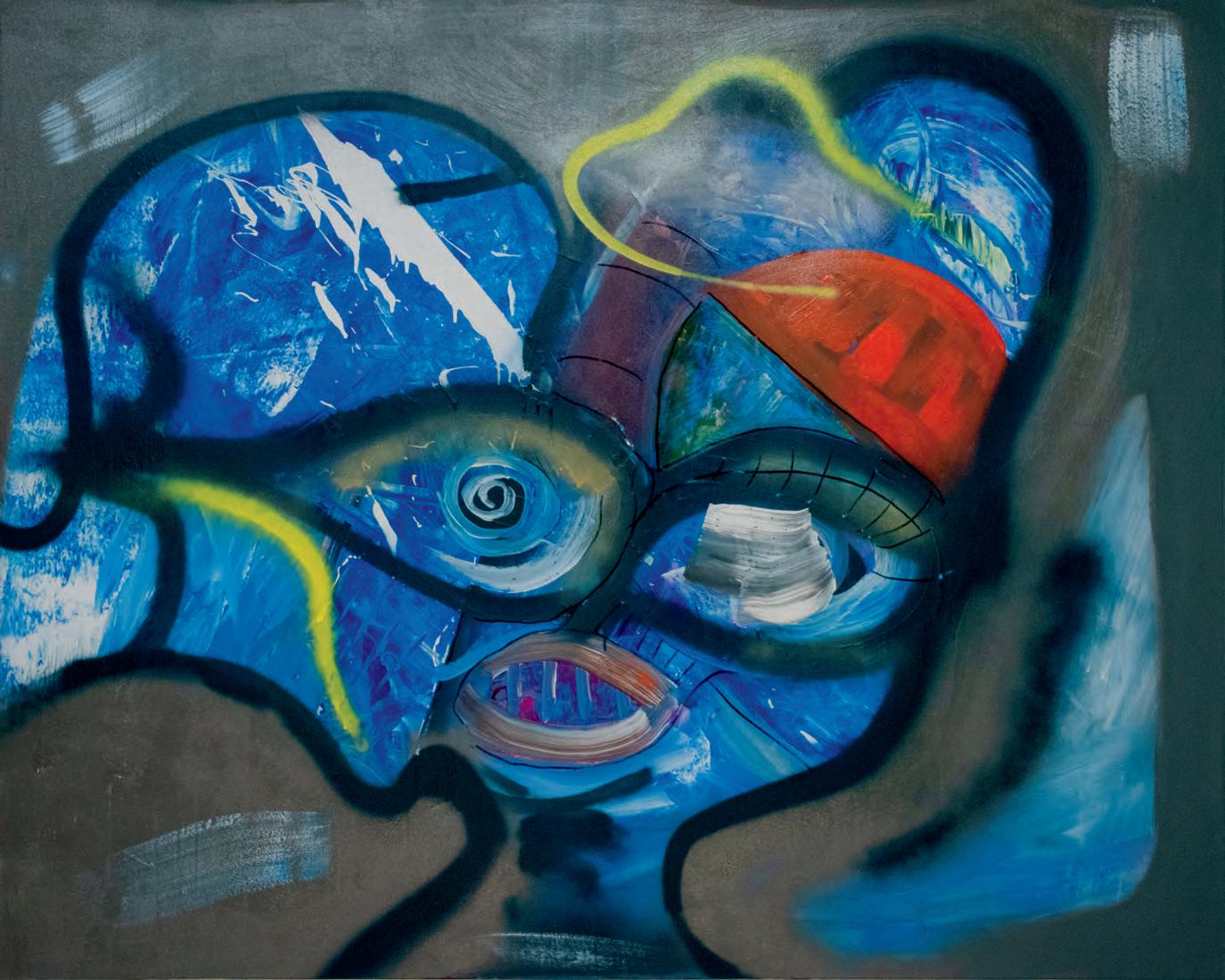


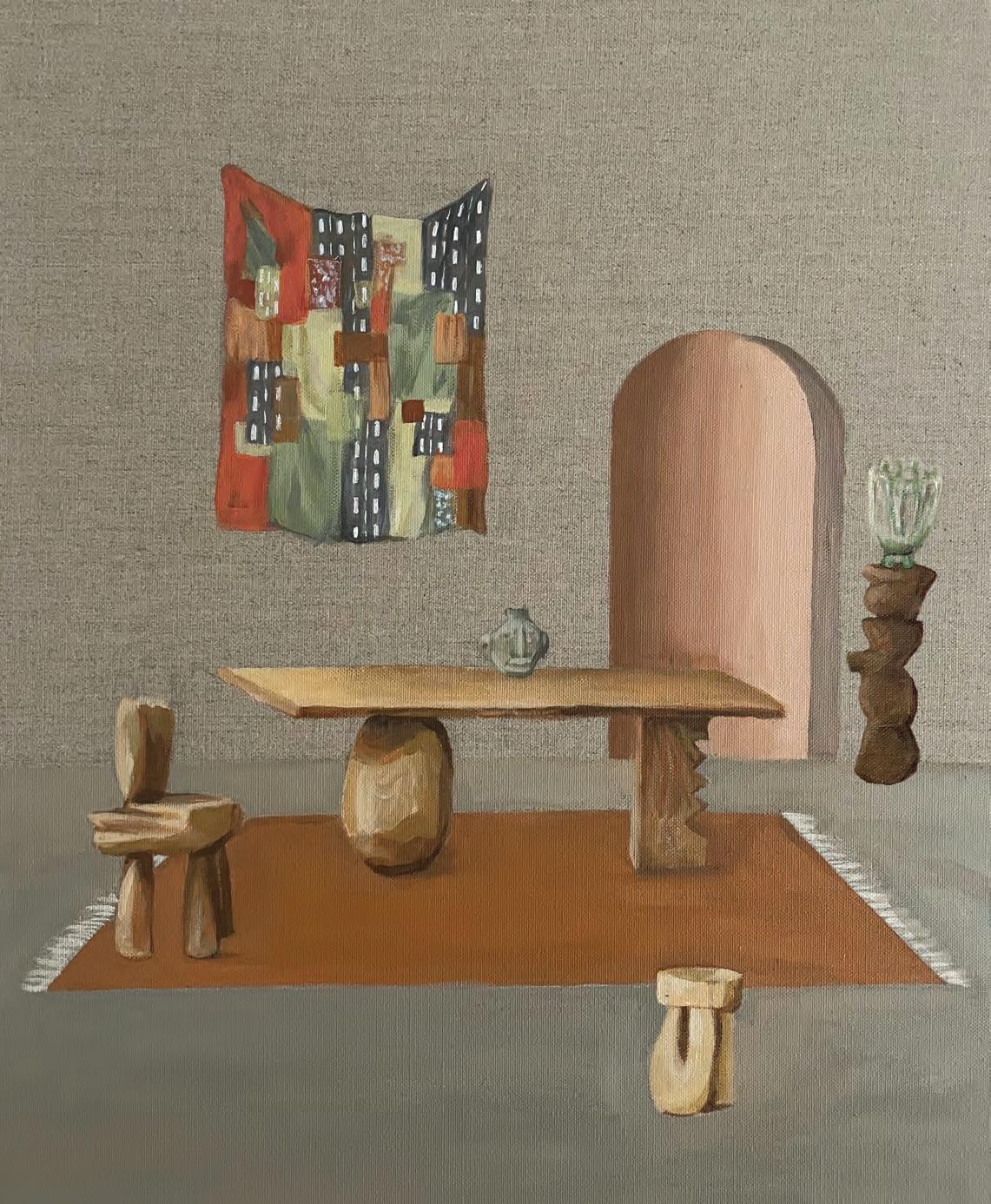








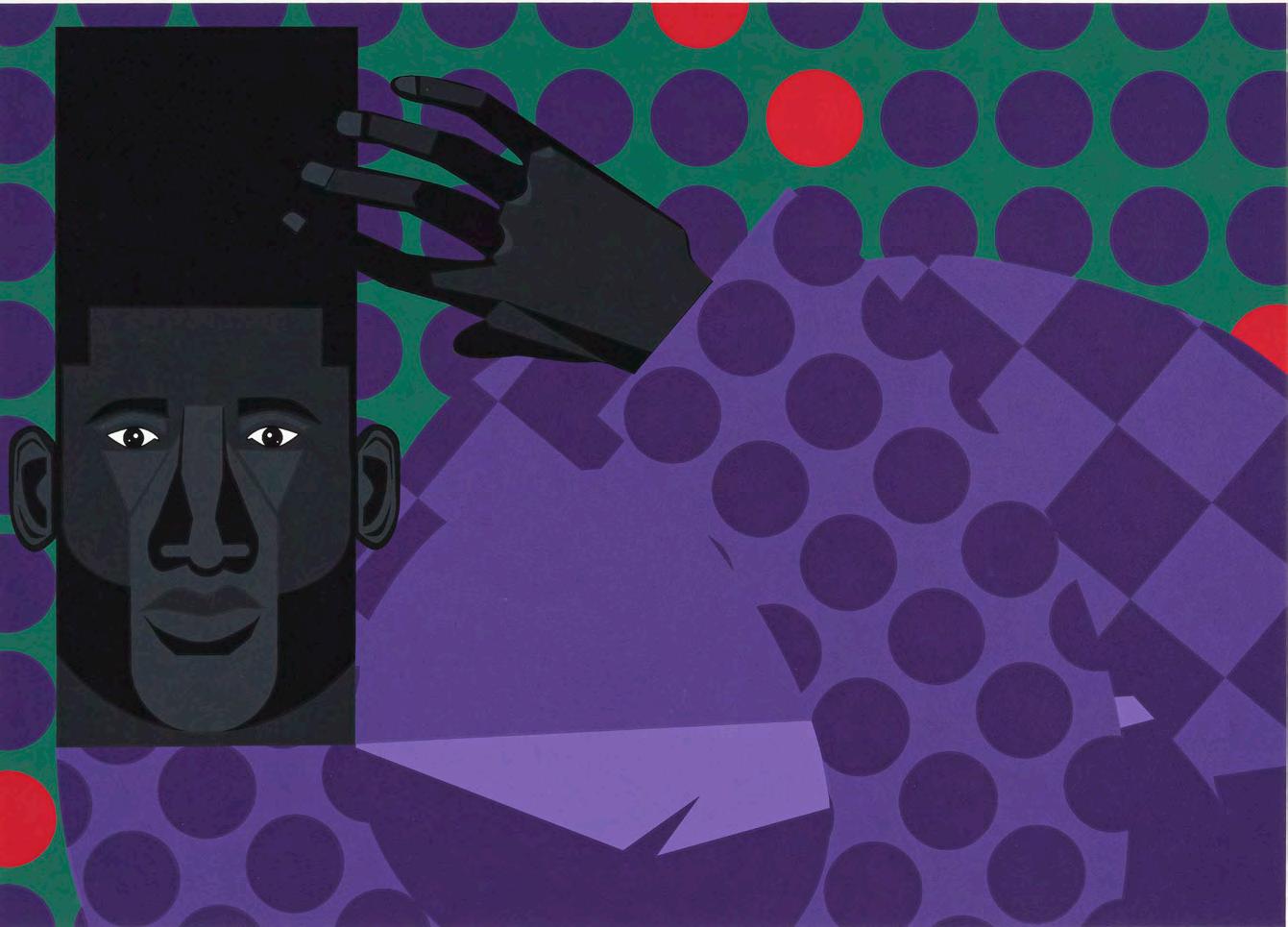
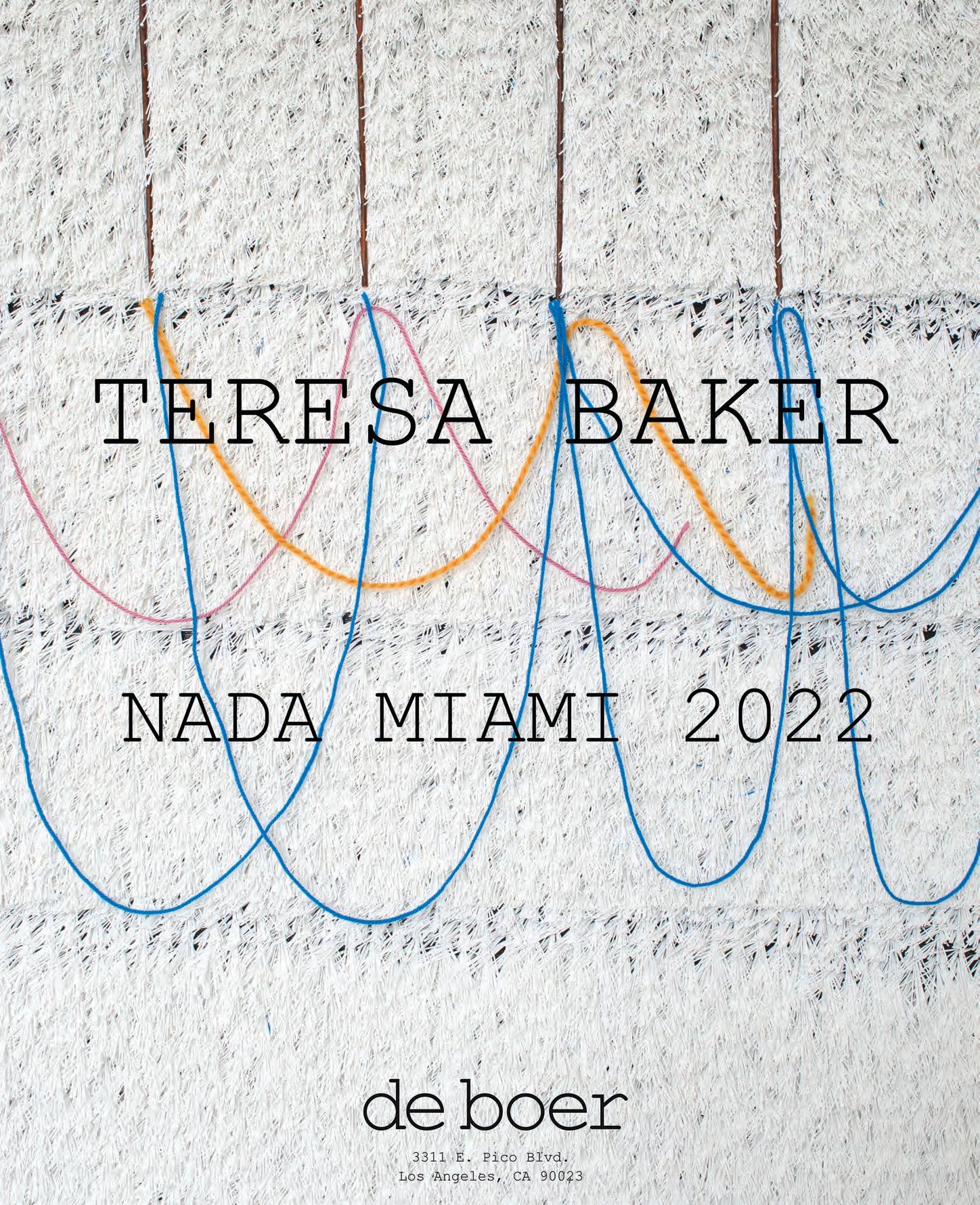

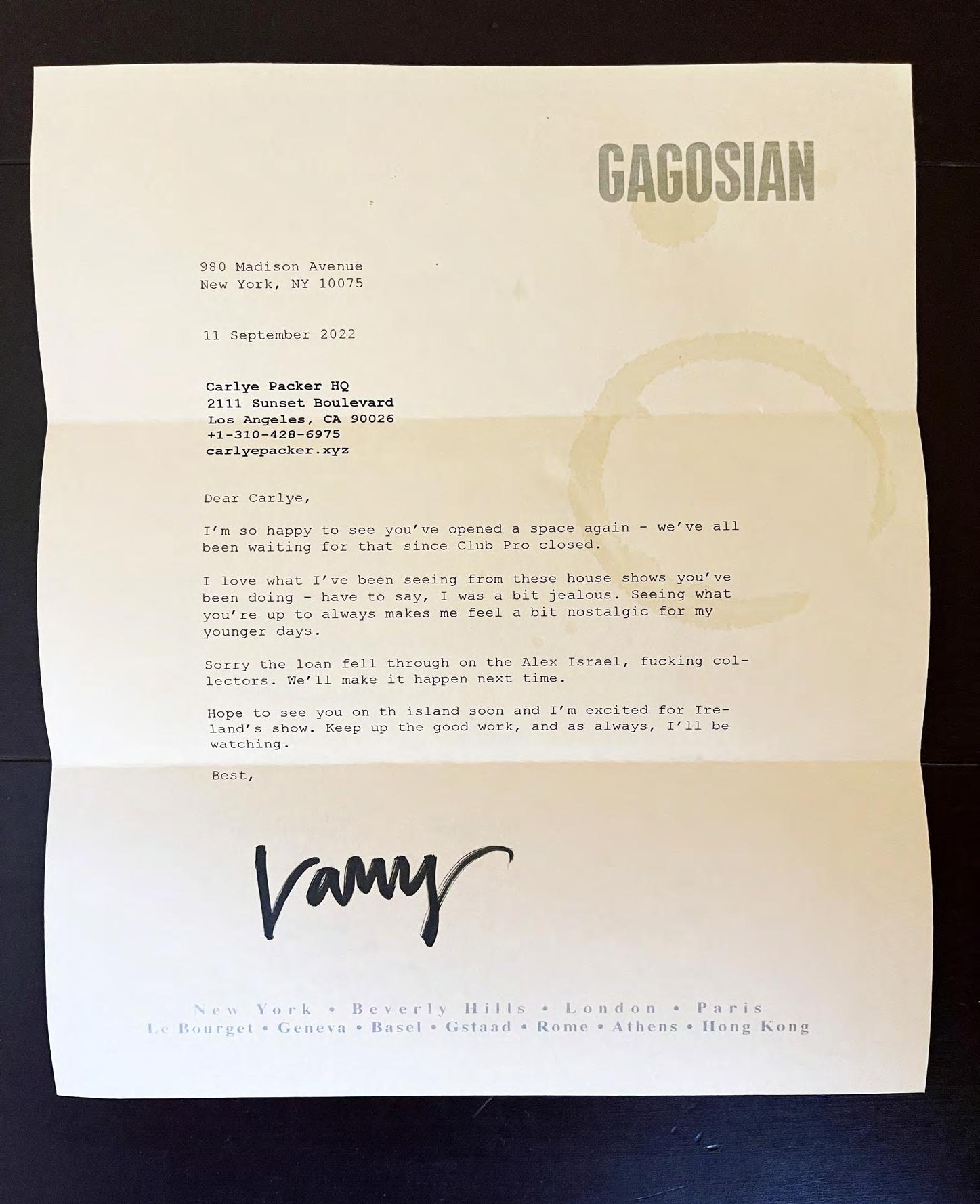




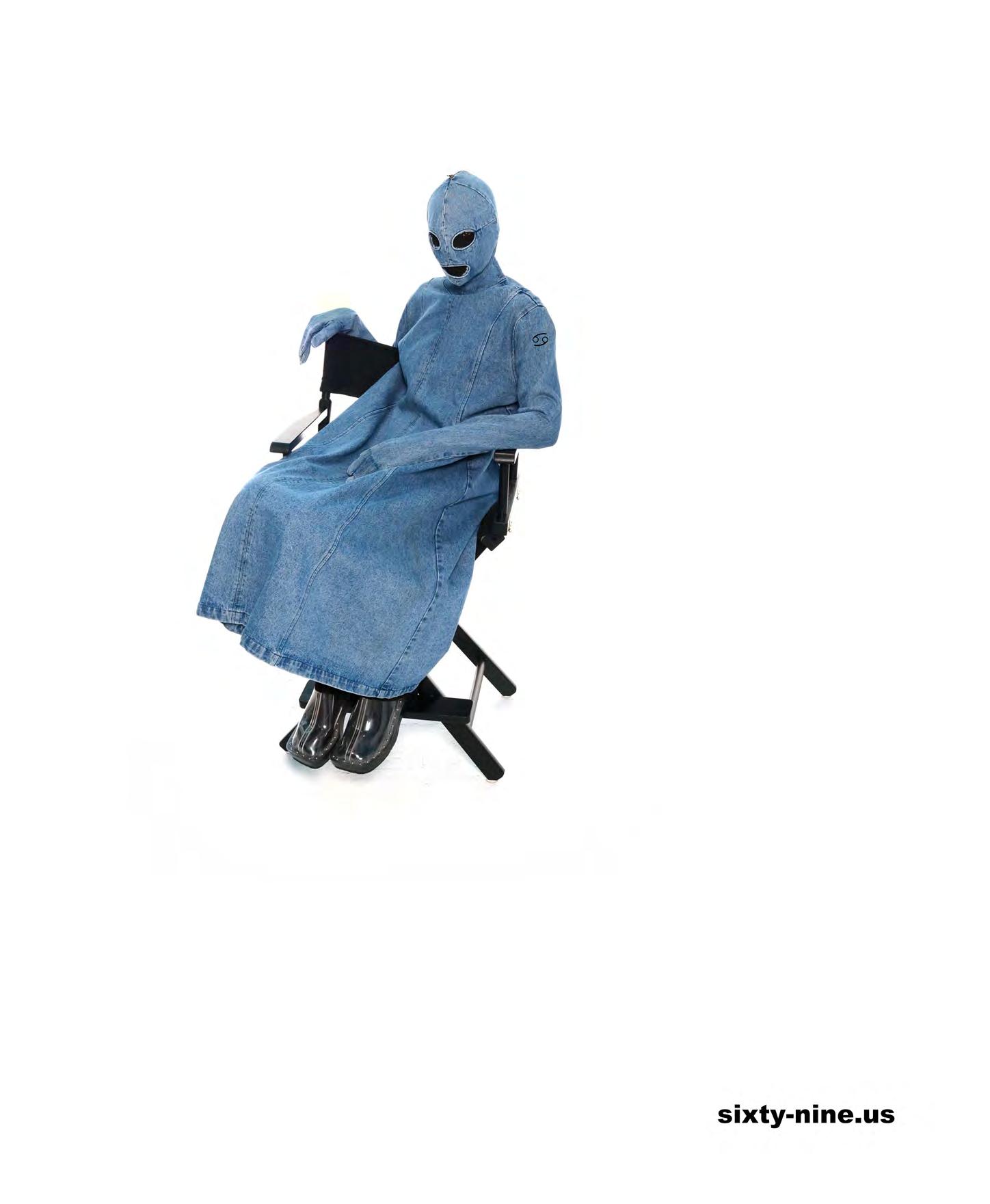
EDITOR-IN-CHIEF
Oliver Kupper
MANAGING EDITOR
Summer Bowie
CREATIVE DIRECTOR
Toby Grimditch
FASHION EDITOR
Hakan Solak
JUNIOR FASHION EDITOR
Camille Pailler
NEW YORK EDITOR-AT-LARGE
Alec Charlip
ART DIRECTOR
True Love Industries
PRODUCTION
Laura Howes
INTERNS
Andrea Riano
Stella Peacock-Berardini
Anni Pullagura
Billy Lobos
Chloe & Chenelle
Defne Ayas
Edward James Lee
Hamish Wirgman
Hans Ulrich Obrist
Jeffrey Deitch
Jonny Woo Jordan Richman
Linn Phyllis Seeger
Marie Louise Von Haselberg
Max Jolivet
Michael Slenske
Naomi Miller Noemi Polo
Forensic Architecture
Gagosian
Grindr
IDEA Books
Jacqueline Kennedy Onassis
Kunsthaus Bregenz Kurimanzutto
Marni
Michael Stipe
Praying REM Uncle Paulie's Deli
KOPA OFFSET PRINTING HOUSE
Industrijos g. 12, Kaunas, Lithuania www.kopa.eu
Oliver Misraje
Robert Longo
Sami Knight
Andy Jackson Clément Pascal
Coley Brown Damien Maloney David Brandon Geeting Denny Sachtelben Dustin Lynn Jason Nocito Javier Castán
Jermaine Francis Joseph Kadow Jules Moskovtchenko Liberto Fillo Magnus Unnar Matias Alfonso Max Farago
NTI
Nadia Lee Cohen Nick Sethi Pat Martin Patrcio Malagón Paulo Sutch Rob Kulisek Sina Östlund Suzi & Leo Victoria Pidust
Camera (ABC Dinamo)
Digestive (Jérémy Landes)

Tomato Grotesk (Andrea Biggio)
Whyte Inktrap (ABC Dinamo) ZIGZAG (Benoît Bodhuin)
Allison Berry Center For Spatial Technologies David Zwirner Dream Factory Studio Eva Chimento
AUTRE LOS ANGELES
6711 Leland Way Los Angeles, CA 90028
GENERAL INQUIRIES, ADVERTISING & DISTRIBUTION info@autre.love
FOLLOW AUTRE @autremagazine www.autre.love
ISSN 2767-7958
All rights reserved. No part of this publication may be reproduced, distributed, or transmitted in any form or by any means, including photocopying, recording, or other electronic or mechanical methods, without the prior written permission of the publisher, except in the case of brief quotations embodied in critical reviews and certain other noncommercial uses permitted by copyright law.
IMAGE Jeremy Shaw, Phase Shifting Index, 2020 seven-channel video installation, multi-channel sound, lights. Installation view Centre Pompidou 2020. Photo Timo Ohler.ALL RELIGIONS ARE CULTS, Letter From The Editors 25
MOBILIZATION, Victoria Pidust & Volo Bevza on the Russian Invasion of Ukraine 28—29
THE ARCHITECTURE OF VIOLENCE, A Conversation Between Eyal Weizman and Maksym Rokmaniko 30—35
PIET HEIN EEK, Design In The Age Of Crisis 36—39
THE FRAGILITY OF MEMORY, Greg Ito Interviewed by Anni Pullagura 40—45
JERMAINE FRANCIS, No Fake News Here 46—59
PUBLIC HOUSE, Exploring The Queer Pubs Of London 60—83
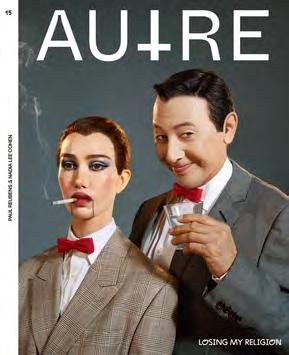
BREEDERS, by Daniel Roché and Marie-Louise von Haselberg 84—99
JEREMY SHAW, Accessing Altered States 100—109 PRAYING, by Paulo Sutch 110—121
MACHO SENTIMENTAL, Bárbara Sánchez-Kane 122—129
EATING THE RICH, An Interview of Ruben Östlund 130—145
MUSICAL CHAIRS , A Story About False Scarcity by NTI 146—159
FAIR GAME , Featuring Pom Klementieff 160—171
CERISE CASTLE, Uncovering The Deputy Police Gangs Within The Los Angeles Sheriff's Department 172—175
JORDAN WOLFSON, Interview By Jeffrey Deitch 176—191
RITUAL, by Rob Kulisek & Billy lobos 192—203
THE PROSECUTOR, An Interview of Luis Moreno Ocampo 204—207
ICEBOY VIOLET, by Jules Moskovtchenko 208—217
PAGAN FASHION, An Interview of Marni's Francesco Risso 218—239
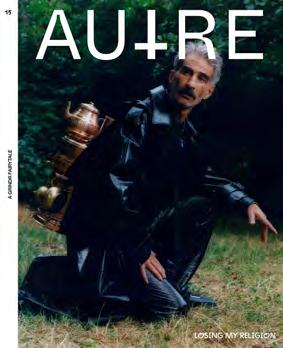
A TALE OF LOST CHATS, A Special Collaboration with Grindr 240—261
AA BRONSON, Interview by Defne Ayas 262—269
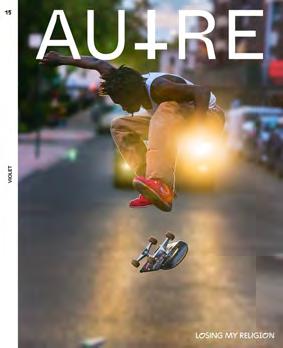
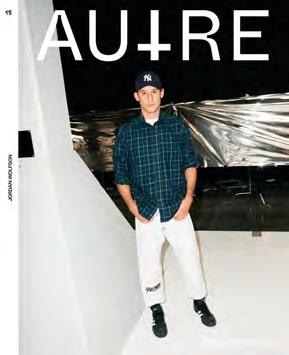
MY FATHER IS A GURU, by Suzie & Leo 270—287
PEE-WEE & NADIA'S PLAYHOUSE, Pee-wee Herman by Nadia Lee Cohen 288—295 WU TSANG , Queer Spaces, Activism, and Cinema 296—301 BROOKLYN BOHÈME, Mickalene Thomas and Derrick Adams In Conversation 30—31 WILLIAM STROBECK: NO WAY TO LOSE, Photographs by Jason Nocito 308—323
ODILIA ROMERO, Reversing The Erasure Of Indigenous Voices, photographs by Max Farago 324—329
LUKE KEMP, On Existential Threats With A Portfolio of Artwork by Robert Longo 330—335
MICHAEL STIPE, An Interview By Hans Ulrich Obrist and Photographs by Nick Sethi 336—343 BECOMING TOMORROW, by Liberto Fillo 344—353
The ghosts of the past keeping visiting us. Is this déjà vu or something more sinister? In 1991, Rodney King was beaten nearly to death by officers of the Los Angeles Police Department in a case of excessive use of force that catalyzed a wave of uprisings in the streets of Los Angeles. That same year saw the dissolution of the Soviet Union and the official sovereignty of Ukraine. And in 1991, R.E.M.’s surprise hit single, “Losing My Religion”, echoed through the radio waves like a generational anthem. With its evocatively yearning and ambiguous lyrics, the song, written by Michael Stipe (who gives a candid interview to Hans Ulrich Obrist for this issue), is about the torment of love and newfound fame, but it could just as easily be a soundtrack for the time we are living in now. In an age when privacy is an illusion, the bells of sectarian bloodshed and an irreversible climate emergency are ringing louder than ever. We are all under the spotlight, collectively losing our religion. This issue is a startling exploration of changing belief systems in the age of information and disinformation, secularization, conspiracy theory and a testament to contemporary life in a burning hot post-truth world. It is an issue about the violence of borders, invisible enemies, and the hauntology of history.
Our current predicament is laid out perfectly in Guy Debord’s vital and prescient text, The Society of the Spectacle (1967)—our commodity fetishization and rabid consumerism have led to the flattening of culture and class alienation. We spend our days absorbed in the spectacle—awash in images of other people’s lives mediated by filters and celebrity deepfakes. We mimic the movements of others like social chameleons in a glass cage. History has no meaning, the present is a wasteland, and the future is unimaginable. We find spirituality in products, salvation in status, and holiness in interminable work. The logo has replaced the cross. The work hard, play hard, hustle culture ethos is nothing more than capitalist mythos forcing us into indentured labor so that we can meet the cost of living—a term of utter brutality normalized and neutralized by the white noise of necropolitics.
In 1972, MIT published a damning report predicting complete societal collapse by the mid-21st century due to rapid growth and the excessive mining of finite resources. While it was initially dismissed as being overly alarmist, a recent reevaluation of the study updated with fifty years of data strongly suggests that we are right on track for this collapse by roughly 2040, rather than the initial estimation of 2050.
In his latest book, Brutalisme (2020), Achille Mbembe proposes that the arrival of the 21st century has seen a spectacular return to animism. Only, unlike the 19th century model of worshiping objects that were believed to embody the spirits of ancestors, this newer version is characterized by the worship of self and of our numerous selves as objects. We talk to Wu Tsang about her new production of Pinocchio in which the sentience of the protagonist begins during his life as a tree, calling into question notions of ontology and their origins. We talk to Jeremy Shaw about the role of faith in our very survival, which explains why Mbembe underscores the ethical duty of Western institutions in the restitution of African art.
It seems only logical that a society, which subsists on the extraction of raw materials from a finite planet would be fated to such a spiritual ouroboros. In a conversation between Eyal Weizman of Forensic Architecture and Maksym Rokmaniko of Center for Spatial Technologies we learn about the art of counter forensics in holding nation-states accountable for the ravages of civil unrest. Luis Moreno Ocampo, the former chief prosecutor to the International Criminal Court tells us that “there is no chaos. Only complexity”, and Luke Kemp, a researcher at Cambridge University’s Centre for the Study of Existential Risk, tells us that societal collapse is often a boon to the masses.
This issue is not about religion—it is about faith in all of its illusive forms. It is about the perils of isolation and nihilism. It is about the role of mutual support networks as we rebuild our faith in the society to which we wish to belong. It is a time to break from the age of individualism and welcome the other. Our survival is dependent on it.
— Oliver Kupper and Summer Bowie

When the 2022 Russian invasion of Ukraine began, the country responded with an unprecedented civilian defensive that stunned occupying forces. Four days before the war, photographer Victoria Pidust, and artist, Volo Bevza returned to their home country for Bevza's solo exhibition at WTFoundation. The opening happened to fall on the day of the invasion. With the exhibition canceled, Bevza decided to stay in Ukraine to help make antitank obstacles called 'hedgehogs.' Pidust photographed the process. They built hundreds of hedgehogs and beds for soldiers as the bombs fell all around them.
CAMILLE ANGE PAILLER First of all, can you give us some context for your trip to Ukraine?
VOLO BEVZA We traveled to Kyiv on February 20th, 2022 for the opening of my solo show Softimage at WTFoundation. The opening was scheduled to take place on the 24th, but that turned out to be the day that the Russians launched a full-scale military invasion of Ukraine. For six to eight weeks prior to the invasion, we were attending demonstrations in Berlin against the war and the accumulation of troops on the Ukrainian border. We already knew it could happen, but after speaking with friends in Berlin we decided to fly home and do a show to oppose Putin’s suppression of normal cultural life and work in Kyiv; to oppose the fear.
PAILLER Why did you stay and in which area? Were you with your family?
VICTORIA PIDUST We were in Kyiv when it started. My brother called us at five in the morning and woke us up, his windows were shaking from missile explosions. We
were going to stay with Volo’s parents in the suburbs, but just as we got in the taxi, his father called to say he had tested positive for coronavirus. So, we went to Volo’s brother in Vyshneve, in another suburb of Kyiv, and stayed there for one terrible night. We had to barricade the windows to protect ourselves from the explosions. We heard planes, helicopters, and missiles. The next day, we took an evacuation train with my brother and went to Lviv to stay at his friend’s parents’ place. Volo’s parents and brother came a few weeks later and part of my family came to Lviv as well. I stayed with the family for one month to see how the events would go. Then, I left for Germany with my grandmother, aunt, and cousin to bring them to a safe place, because my native town, Nikopol, is very close to the frontline.
PAILLER Victoria, where did you get the idea of photographing the hedgehogs that Volo was making?
PIDUST When we first came to Lviv, we stayed at artist, Roman Romanyshyn’s place.
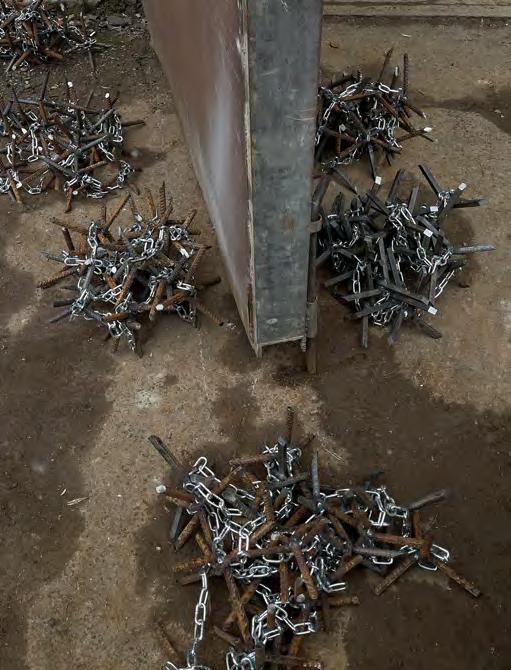
Near their house there was a glass and metal workshop, which was considered the best in the country fifteen years ago. The guys were making antitank obstacles, or ‘hedgehogs’. So, we joined them; Volo helped to build them and I photographed. We couldn’t think about art the first week, as we were still too in shock. It was best to just do the work without any intellectual labor, just doing. When the metalwork was finished, we started with fundraising and giving interviews to the media. Several friends and others from Germany helped us out. With Gallery Judith Andreae, we managed to collect around 25,000 €. The guys built a few hundred Hedgehogs for the whole country, as well as several beds for soldiers and others who were displaced inside the country. We also spent money for territorial defenses and humanitarian needs.
PAILLER How would you compare your artistic vision in the treatment of war with that of the press?
PIDUST There are many brave and professional people from all over the world who are clarifying the reality of this terrible war. We are all thankful to them for the jobs they are doing. Some of them gave their lives. I need to set my sights on the photograph— to see and show the abstractness of reality through lens-based pictures. I do this with the help of algorithms to show a variety of human perceptions, how events can be perceived or manipulated based on certain facts through photography and other digital media on the internet in our time of post-truth.
PAILLER Do you think you will continue to document and use these photographs for future projects? If so, can you tell me more about it?
PIDUST Yes, I did some works for an iPhone series in Lviv and Kyiv, I also did some photographs for photogrammetric works. As for Volo, we were in Kyiv one more time again in April to document some destruction for our latest group exhibition POSTOST: Ukraine. And I will be back in Ukraine again soon.
PAILLER How do you feel after all this to be back in Berlin?

PIDUST We are feeling huge support from the people of Europe, our friends and colleagues, but not enough from the German government. They continue to buy Russian oil, thus financing the war and they still haven't delivered any heavy weapons, even though they promised them months ago. It’s disappointing because with the help of Europe, we can win this war together. It is an identity war. The Russians want to destroy the
Ukrainian identity: our country, our heritage, our people. There is a new definition for Russian terror, ‘Russism.’ They have been doing this for five hundred years. It must be finished soon. Ukraine is part of Europe. Ukrainians defend democracy. We are a free country with people who are ready to fight for European values, to protect Europe, and we will win very soon. We want to thank every nation and every single person that stands with Ukraine.
end
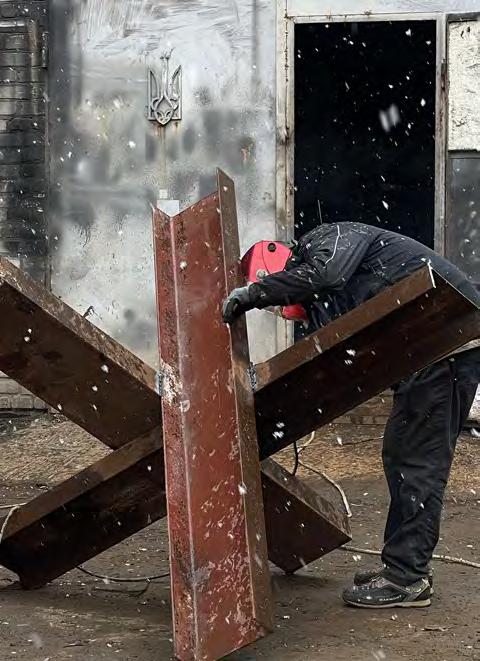
Shortly after 5pm on March 1st, 2022, Russia rained down two air-launched cruise missiles on the Kyiv TV tower. The first missile was a direct hit, exploding just below the control tower. The second missile seemingly missed the tower and landed close to a Soviet-era sports complex, virtually destroying the structure. The attack was not the deadliest or the most injurious (five people were killed and five people were wounded). Nor was it the most militarily effective—most TV channels were back up and running in about an hour after the strike. Nevertheless, the objective was deadly clear: to cut off information, demoralize, and control the narrative, a post-truth tactic all too common with Putin and the Russian armed forces. Over the course of a month, there would be a total of ten attacks on TV towers throughout the country. But the attack on the TV tower in Kyiv also had deeper, stranger, and darker historical ramifications. In Putin’s new ideological war, haunted by the ghosts of the former Soviet Union and the brutality of World War II, he offers the delusional promise to “denazify” Ukraine, the implications of which are equally ironic and irrational. The tower is located in a territory called Babyn Yar, a ravine in the center of the city where one of the largest massacres was committed by the Nazis. In 1941, over the course of two days, death squads killed over 33,000 Jews. Between 1941 and 1943, over 100,000 Jews, Ukrainian political prisoners, Romas, Soviet prisoners of war, and psychiatric patients would be murdered on the grounds of Babyn Yar. As Soviet forces were closing in on the Nazis, prisoners from the Syrets concentration camp were forced to dig up the bodies and incinerate them. After the war, at the directive of Stalin to erase the memory of the Holocaust, the ravine was filled in by liquid mud. History vanished. From February 2020 to February 2022, Maksym Rokmaniko and the research organization he founded, Center for Spatial Technologies—with a commission from the Holocaust Memorial Center—have been using a vast array of tools to investigate and digitally reconstruct the topography of Babyn Yar, discovering long buried secrets in the process. The TV tower itself, and multiple structures within the vicinity, were built on Jewish, Muslim and Orthodox Russian burial sites from the 19th century. The sports complex, Avangard Gym, destroyed by the second missile, was due to become the Museum of Holocaust in Ukraine and Eastern Europe. With these findings, Maksym reached out to Eyal Weizman, founder of groundbreaking multidisciplinary research group, Forensic Architecture—established in 2011 at Goldsmiths, University of London—to join him in drawing the parallels between Babyn Yar and the attack on the Kyiv TV tower. When the war broke out, Weizman used his network to help Rokmaniko escape Ukraine. From Forensic Architecture’s Berlin office, Weizman and Rokmaniko discuss Babyn Yar and the unique architecture of violence.


OLIVER KUPPER Eyal, can you tell me about Forensic Architecture, how it started, its core missions, and where it’s going?
EYAL WEIZMAN Forensic Architecture emerged from an experimental program that was set up at Goldsmiths [University of London] back in 2005. It was a multidisciplinary group of practitioners, filmmakers, curators, writers, and architects. At some point, we were discontent with critique and we needed our analysis to play out in the most antagonistic and difficult forum, which is in a legal setting. It started almost as a strange proposition: let’s come up with a forensic agency. So, imagine a group of creatives thinking: we need to reclaim forensics, we need to take it back out of the jaw of the pit bull. How do we create a counter state practice? A practice that actually only targets states, which is what we call the inversion of the forensic gaze, or counter forensics. Then, we engaged with a number of investigations that immediately triggered an amount of attention that we were completely unready for. A UN Special Rapporteur heard our talk at an academic conference at Goldsmiths and gave us the most incredible commission, which was to monitor CIA targeted assassinations in Somalia, Pakistan, Afghanistan and Yemen, and Israeli strikes in Gaza. It was the time when targeted assassinations shifted to buildings, to cars on the road, to camps in the countryside. All of a sudden, a kind of an architectural reconstruction of those buildings that were targeted became the most important evidence. Then, we were flooded with commissions. Of course, it is all based on my architectural practice in Palestine—mapping the urban warfare of Israeli Occupation in the West Bank in Gaza, and trying to understand the Israeli Army’s use of critical theory, like [Gilles] Deleuze and [Félix] Guattari, which was a ridiculous abuse of theory. Then slowly, Forensic Architecture evolved from that kind of proposition into an agency in 2011. But now, we are at the stage in Forensic Architecture where we decided to dematerialize. It hasn’t completely happened yet, but we want to become fifteen different organizations, each one with different names, operating in local dialects in relation to different conflicts worldwide.
KUPPER In this issue, we are looking at how the violence of various belief systems operate in the chaotic times we are living in. Maksym, can you tell me about The Center for Spatial Technologies and some of the projects you are working on?
MAKSYM ROKMANIKO The Center for Spatial Technologies was much more of an experimental design practice that hacked around using all these clever tools to understand and study complex systems and societal issues. A lot of the things we first researched were around the housing crisis. For instance, we looked at the High Line in New York and the rise in property value as a result of publicly funded infrastructure. We are currently working on a case investigating the bombing of the Donetsk Academic Regional Drama Theatre in Mariupol. But the TV tower case in Babyn Yar was an important stepping stone. We were working on it for two years before the war with support from the Babyn Yar Holocaust Memorial Center, and that is how I met Eyal [Weizman]. We were using the tools and methods of Forensic Architecture, but studying war crimes wasn’t the plan. The Babyn Yar project was fairly long and complicated, because the Holocaust Memorial Center wanted to build a
series of museums on the site. I showed Eyal the work I was doing and the feedback was positive. For three and a half hours we went into a lot of niche historic stuff.
WEIZMAN Seeing the work that Maks and his colleagues had done at Babyn Yar in Kiev was one of the most original projects I had seen. They were starting from something like Forensic Architecture and diving into Second World War history, using historical documents and open social investigations, pulling videos from online, geolocating them, and building them into models. And they were doing it all from photographs that were taken in 1941. We were thinking, wow, we are seeing something that cracks history open. When Maks was showing it to me, it blew my mind. The key, in my view of reading their work, was to understand a topography that no longer exists. Because that place was unknown, you need to conceptualize it: Babyn Yar is a kind of ravine, and the entire use of that place was a site of mass murder. That massacre took place in a topographical depression in the middle of the city, a place that is both central and hidden. Every photograph included a bit of that topography that started to change over time. The ravine had sort of collapsed on the buried bodies—the Soviets flattened it with mud. So, the story of the ravine is a story about terraforming and continuous transformation. A group of young Ukrainian architects discovered something that the most serious Holocaust historians couldn’t manage to find in eighty years, and that got my attention.
ROKMANIKO When we discovered the burial site at Babyn Yar, it was a moment where we had to basically revisit Forensic Architecture’s work from A to Z, just to ensure we were not missing any tools we could be using. That is the first time I met Eyal and really dove into what could theoretically be a Forensic Architecture project, and we were still working on research for this project up until the war broke out in February of this year. Up until then, Spatial Technologies were mainly involved with the reconstruction of this important location in Kiev as a site of mass killing by the Nazis. We also looked at Babyn Yar as a site where the Germans set up labor camps with Jews and other prisoners who were forced to dig out the bodies and burn them to erase the evidence. So, we had a lot of work to do. When Eyal reached out to ask if I was okay, I replied and said we were already looking at some of the missile strikes. We were mapping things to understand what was hit and what types of missiles they were using. When the missile that targeted the Kiev TV tower missed and hit the area very close to Babyn Yar, we knew that this is the first case that we wanted to look at, and it was the first collaboration with Forensic Architecture.
KUPPER What was that moment like, when they started raining down missiles? How long was the period between going into hiding and meeting up with Eyal in Berlin?
ROKMANIKO I got a message from Eyal when I was with my parents, my girlfriend, and her kid, in a car leaving Kiev, on the 25th of February. I was very happy to hear from him, although I did not respond immediately because it was a massive ordeal. We evacuated from Kiev to western Ukraine. I spent a couple of months in the Carpathian Mountains. But all the work before the war, and all of that thinking about sustainability, materials, and equitable housing, everything completely stopped. We were obsessively looking at these strikes, and to be honest,
it isn’t an overstatement to say we could not do anything else. These things were happening and we were curious about what was going on. So, we started to work immediately with Eyal and Forensic Architecture, and it was important because they helped us leave Ukraine. I think we are one of those future organizations that Forensics will dissolve into. Their Berlin office is our new home, which is where we are speaking to you from. I remember saying to Eyal that there were too many obstacles in our way in Ukraine.
WEIZMAN We were thinking that Ukraine was going to fall any day. And we had the top worldwide expert in encryption and digital security basically making Maks disappear online and offline. It took six weeks to get him out, but now he is here. When people come from a war zone, you are so happy that they are safe, but then there is a whole other process that begins. And there was a whole office, not just Maks. And they became like Twitter junkies. Every time there was another missile strike in Kiev, the entire office was under the emotional shrapnel of that missile. So, I thought it would be interesting to ask Maks and the team if they were interested in working on other things. We received a strange invitation from the House Of World Culture (Haus der Kulturen der Welt—HKW), which is a major art and intellectual space in Berlin. The HKW were organizing an event in honor of David Graeber and David Wengrow for their new book The Dawn of Everything (2021), which is a super important book on archeology that just came out and is being discussed everywhere. It’s a book about political philosophy based on archeological evidence, and it’s perhaps the best counter forensic project I have ever seen. They are digging and looking at archaeological evidence from the Neolithic/Paleolithic threshold, and finding evidence that completely transforms the perceived history of cities. Cities don’t need to be apparatuses for control, surveillance, slavery and subjugation of women and others—they could be places of debate, equality, and creativity. The most insane thing was that one of the cities that made this paradigm shift was in Ukraine. In recent decades, archeologists discovered a city in the center of Ukraine, a city from 7,000 years ago—older than the cities in Mesopotamia—without temples, without elite burials, essentially without classes. So, the HKW asked Forensic Architecture to do what we are doing, but in the Neolithic era, and connect what Maks is doing in Ukraine with what was happening 7,000 years ago. The lecture is online, but I thought it was an important project to get their mind off the war.
KUPPER You both grew up very close to the echoes of war. Eyal, you grew up in Haifa, which still had remnants of Palestinian communities. And Maksym, you grew up with the ghost of the Holocaust and Russian entanglement. Can you talk a little about that and how that inspired your interest in architecture?
ROKMANIKO The one thing from your question that resonates is the Russian entanglement. For my family, it was quite specific. I grew up very curious about Russian culture, mainly because my family prohibited it. I remember my dad chasing me around for using Russian words. But all this dislike of Russian culture made me more interested, which annoyed my family. Now it seems like I have to almost align with how my family feels about Russia. It’s something I am dealing with now.
KUPPER When did architecture start to come into the fray? When did it take the form that it took, in terms of your mapping histories?
ROKMANIKO From the hacker culture in Ukraine. I grew up downloading software, torrents, and playing with it. Software that is meant to design plane engines or architectural software. Even in high school, I was making walls and doors. And I was always good at math. I won second place in Ukraine in the Olympics for Mathematics. And my dad is a painter, so it’s a sweet spot between those things.
KUPPER And Eyal, what about your background, growing up in Haifa, Israel—how did that inspire your architectural interests?
WEIZMAN I can’t distill it, because one’s decisions in life are very complex, but politically, like many people of my generation, we were existing between twin shadows. On the one hand, my family are Auschwitz survivors. I still have very strong living memories of my grandparents and their difficulty adjusting. But then, there was my own lived reality of the Israeli apartheid, in which I was part of the dominant group. All of that started to exist in strange spatial, architectural forms in Haifa. It was this Palestinian modernism that was between traditional stone construction and fine line, British-imported colonial modernism, which produced a dialect of modernism in Haifa and the whole topography, where Jewish neighborhoods exist on top of the remnants of scattered Palestinian
groups. But I was reading philosophy and trying to make peace with the fact that maybe one day I would study architecture, and that one day I was going to be able to write philosophy through stone and the built environment. My inclination was always a very theoretic, text-based, approach to architecture. The idea was architecture as optics, understanding political, social, and economic realities as they become form. And the form was really interesting to me. In my recent book, Investigative Aesthetics [Conflicts and Commons in the Politics of Truth] (2021), we had this term hyper-aesthetics, which is a way of augmenting the capacity of a surface, of matter, of the built environment, to be read as a trace of something. If aesthetics is the way we perceive the world, then hyper-aesthetics is to augment it conceptually, technologically, by networking signals from different places, traces on the wall, with a video, a fragment of traumatized memory, you connect them together into what we call a hyper-aesthetic assemblage.
KUPPER Can you talk about your definitions of architecture through your own practices, but also how architecture and war tie into each other today?
WEIZMAN I think that forms of violence and domination are articulated as spatial transformations. To dominate people, you need to conceive of an environment that will facilitate that domination. When you fight in a city, you redesign the city for destruction. You open new boulevards,
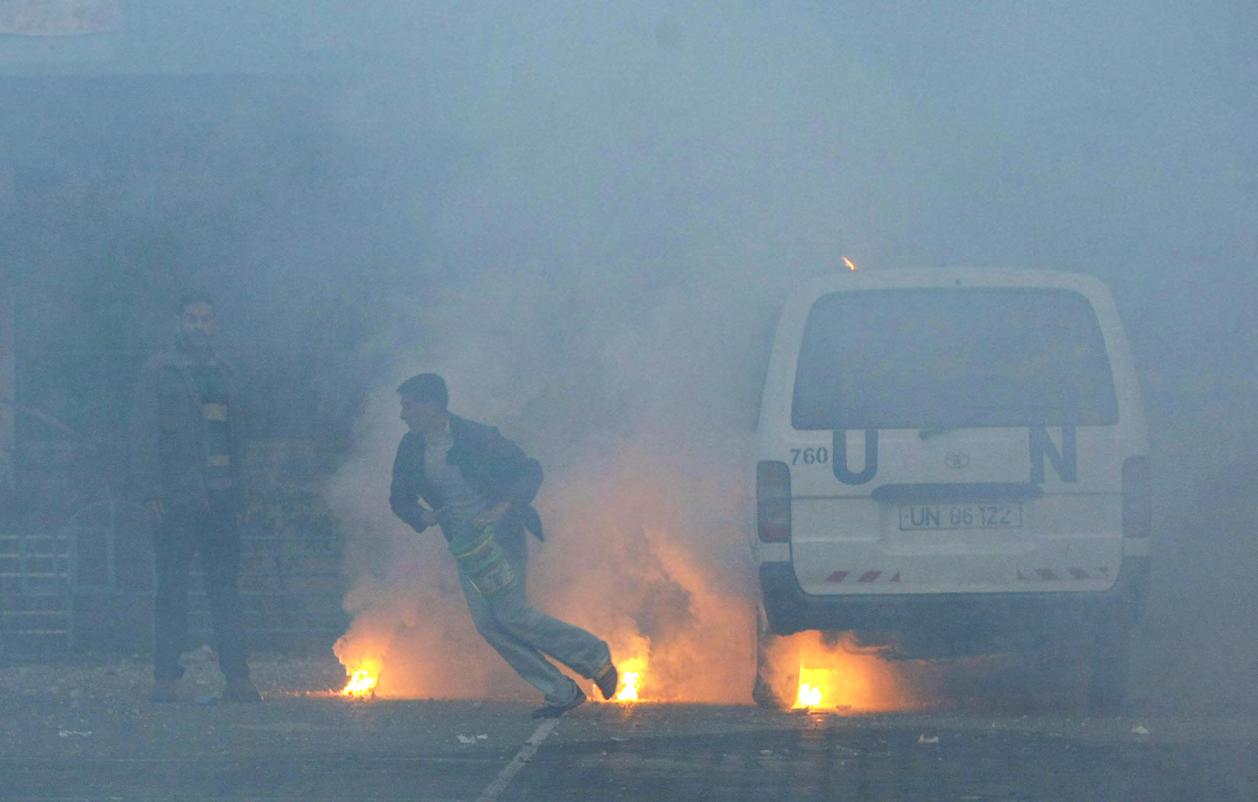
remove strategic points, build walls, checkpoints, and lookout points, as you redesign the optics of an urban environment. We usually separate construction and deconstruction, but I believe that they belong to a meta category of spatial transformations. So, when you are thinking about the relation of war to architecture, construction and deconstruction become contiguous—it is transformational space. You destroy something, you move it, you build with it, you create with it—even a pile of rubble becomes strategic when it blocks a road. You asked for my definition of architecture: it is matter slowly changing form, but continuously, in an elastic medium— almost in an incessant mode of transformation.
KUPPER Earlier, you talked about the Israeli’s co-option of Situationist philosophy in their attacks. Can you talk a little about rhizomatic movement and the analogy you used of a worm eating its way through an apple?
WEIZMAN This is where construction and deconstruction becomes materially illustrated. So, the Israeli military was caught off guard, like many other militaries, when war got into the city. Then, they understood that they had to master a whole new philosophy of space from post-colonialism to architectural theory, to system analysis. So, they were developing schools of architecture and all this progressive stuff that we were reading, such as Liberation theory, was subverted into the military. They realized the safest, most surprising,

and effective way for them to move through the contiguous fabric between Palestinian cities is to move between walls, sometimes into the floor through 100-meter long tunnels that were eating into the city. This is a way of redesigning. We believe that the city dictates our movement, in war this changes, movement dictates space—the way you move is to break your way through, and that becomes the organizing principle of space. This is where [Jacques] Derrida, Deleuze and Guattari, and all the Situationist International philosophies started to be abused as a technique. I was very interested in that, and strangely, when I published that piece in a very radical, left wing journal in Israel, we got sued by Aviv Kokhavi, who is now the Lieutenant General of the Israeli Army. I was writing about him and what he was doing, and he got an AmericanIsraeli heavyweight legal team. They tried to get me to change my piece and I was not willing to change anything. This started an entire debate about how we write theory in a state of colonial struggle. There is a way in which you can speak immaterially about things, in general ideological terms, but then nobody cares. However, if you say that person did this, you are in the realm of investigative journalism, and that was my call. We need to combine investigative journalism with political theory, and that is the kind of machine that can deal with colonial situations.
ROKMANIKO There is a theorist that I started to read early named Keller Easterling, she always talks about a city being a product of this infrastructural logic that produced the city. In the architecture of cities, there is an object form, but also an active form. We engaged with this logic when we did all those hacking exercises. The TV tower in Kiev is infrastructure at its purist: media networks and communication systems that transmit all kinds of signals for radio and TV, and towers also have transmitters for military purposes. So, you can see how important TV towers are. This is still unpublished, but we started to look at all the towers that were targeted from the beginning of the war. We found a tower, which was newly financed by Ukraine’s presidential office in the town of Komyshivka, that the Donetsk People’s Militia were targeting in November 2021. It was a brand-new project that was meant to transmit Ukrainian voices into the territories that are contested and it immediately got targeted. In this way, you can see the practical meaning here, in how these electromagnetic waves come from both sides to fight for territory. In these contested places under Russian control, at some point people start believing the narratives they hear, especially elderly people who can’t navigate these post-truth scenarios.
Suddenly, you hear these missiles exploding all the time and you do not know what to believe. Then you turn to the radio and there is a Russian voice that announces “Ukrainians betrayed you. They started to shell your city.”
KUPPER Why was the attack on the TV tower so symbolic?
ROKMANIKO In Kiev, I could see the TV tower from my bedroom, so I lived super close to Babyn Yar. It is a massive landmark. It’s the tallest structure in Kiev, maybe Ukraine, so it’s impossible to not know about it. The attack on it carries a symbolic meaning simply because of its visibility. Then, there is the intention to take down the means of communication, so Russia can have a monopoly on communication. But we also looked at the more unintended aspects and symbols of this attack. For
example, one of the missiles missed the TV tower and landed in an area where civilians were killed, and we know exactly where their bodies are. There is footage of the area being extinguished by firemen. But then, of course, the building that caught fire is a building called Avangard Sports Complex, which was built on a Jewish cemetery and is meters away from the ravines of Babyn Yar, and was going to be turned into the Holocaust Museum. In fact, I was in the presentation with president Volodymyr Zelensky when we were explaining our goals for this memorial complex that they were planning. So, it is ironic that in Putin’s project of “denazification,” one of the first missile strikes is a major Holocaust burial site. With war crimes, it is important to know exactly what happened—where those missiles came from and what types of munitions were used. Then, you go through this metaphorical idea that pierces through the site, this land that we consider sacred to the Jewish population of Kiev and everywhere else. Suddenly, you have these corpses lying on that ground and you have this immediate invocation of the events that happened here before. We are, of course, the people who spatially know more about this area than anyone else.
KUPPER It is really interesting to use the technology of not only algorithms and spatial technology, but also cameras—the same technology that their missiles use—to see through these environments. Maybe you could tell me about some of the tools that you use to needle through these environments.
ROKMANIKO The site doesn’t look like other European Holocaust memorials, it is a Soviet spin on that. It doesn’t say anything specific about the Jews. We know that in 1948 there were competitions to memorialize Babyn Yar and there were attempts to find the best architects to build a memorial addressing the horrors that occurred there. But at the time, something had shifted with Stalin’s relationship to the Jews. And since we all knew about this site, we also knew how little people understood about where those mass shootings took place. There is a Nazi military photographer named Johannes Hählee, and he arrived in Kyiv to specifically take photographs for Nazi propaganda. He shot a roll of film that he never gave to his bosses. When he died in Normandy, the film wound up in the hands of his wife, who sold it to a German journalist, and it was later used at the Nuremberg Trials. Within these photographs, you can see how profoundly the topography has changed from then until today. We are trying to get all these materials together and structure them in a way that makes sense, so that we can cross reference them. Once we had a 3D model, we could look at the whole topographical map. One of our colleagues is a technical magician and he managed to build an algorithm that allows you to project into a photograph and look at a certain landscape. So, that was the work that we did at the very beginning. Then, we started discovering where the bodies were—over 33,000 bodies. On top of 3D modeling, we also had witness testimonies.
KUPPER Do you think that Putin's forces knew that there were plans for a memorial?
ROKMANIKO The second missile was clearly targeting the TV tower. But this is the reason why we wanted to go into this historic strata. You can see a similar logic by the Soviets when they built the TV center in the first place. First, they got rid of a Jewish cemetery to build the tower and another building
across the street. And this logic is coming from Moscow, a logic that is deeply colonial in its nature.
For example, the TV tower was originally planned for Moscow and it would have been the largest structure in the world, so they needed to shrink the one they built in Kiev to ensure it was smaller than the one in Moscow. Also, Kiev had to wait ten years for a TV tower until the one in Moscow was finished. So, this cultural erasure has many layers. Like in Mariupol with the theater that was bombed—it was built on the grounds where a church was destroyed by the Soviets in the 1930s when they exploded all these cultural heritage places for ideological reasons. So, these are the links that me and Eyal are looking at. How can we explain this war in a way that is not coming out of the blue. This has been going on for centuries. During the Bolshevik Revolution, the Soviets needed to consider the Ukrainian's autonomy, but by the ‘30s, when they gained this control, they went back and tried to control their territories. They killed the smartest people in Ukraine, destroyed churches. Everything that is happening today has a similar logic and a similar desire.
KUPPER Eyal, you mentioned that Forensic Architecture will start to decentralize into fifteen different groups. Can you talk a little bit more about that?
EYAL We have done a lot of work with the Colombian Truth Commission, so we opened an office in Bogotá. In Mexico, we looked at the disappearance of forty-four students from the Ayotzinapa Rural Teachers' College, so now we are opening an office in Mexico. We have an office in Palestine with a hacker human rights organization, which unfortunately Israel has banned claiming it’s a terrorist group.
KUPPER And Maksym, what are some of the projects you are working on now?
ROKMANIKO We are currently looking at grain, and how the Ukrainian food supply chain has been broken. How Russians have taken over farms, and grain storage facilities. We’re also looking at the historic references of Stalin’s Holodomor [Terror-Famine] in the 1930s, which aimed to get rid of Ukrainian speaking populations in Central Ukraine. Four to seven million people starved to death. The project with grain is infrastructural, so we are mapping territory and trying to understand how the grain is being produced. A big part of that is sunflower seeds. All of this food supply and grain is distributed across Ukraine in a certain way, and there is infrastructure to support this process. But it is cut off by Russian territories. They just opened the Odessa port, but we want to know how much of it is opened and controlled. In Mykolaiv, we researched a case about the bombing of an administrative building that is a major agricultural terminal. So, we are looking at the weaponization of food and trying to study these things in a historical context, which is critical to understanding the war.


In 1992, Piet Hein Eek created a cupboard made from reclaimed wood as his final project before graduating from the Academy for Industrial Design in Eindhoven, Netherlands. Eek’s “Scrap Wood Cupboards” became an instant success and made him one of Holland’s most important designers. He used the money from those first sales to start his own design studio in 1992. Today, the studio includes a 10,000 square meter multi-purpose space in Eindhoven, which includes a restaurant, a shop, a gallery, a showroom, and now a hotel. A master craftsman with a DIY ethos and a devilish sense of humor, he has turned discarded timber into an empire of sustainably-designed furniture that is the absolute antithesis of the industry’s ethos of cheap materiality and mass production. In an age of crisis and supply chain chaos, Eek has the last laugh.
OLIVER KUPPER Your design process seems to be very self-sustaining in a time of global crisis and supply chain issues. What has this time been like for you as a designer and an artist?
PIET HEIN EEK It's not the first time that there has been chaos. Around the disaster of the Twin Towers, there was chaos. And then, we had the bank crisis after that. And now, we have the COVID crisis, which is actually the least of everything. In general, a crisis is something that comes and goes. So for me, it doesn't feel that special. I think the latest one got fueled by many other things happening at the same time. It's the most psychological crisis. Normally, when there is a real crisis we are doing okay, and when the whole world is enjoying life, we are doing shit (laughs). I don't know why, but our company always performs the opposite way. During the coronavirus crisis, we rebooted a lot of things. And after a few months, we have been doing better than ever before.
KUPPER What are some of the crises that exist within the studio?
EEK It's always something. When I was younger, I thought any crisis would be the end of the world. When you read about The Great Depression, you get the impression that the whole world stopped functioning. Of course, there were a lot of poor people, but a huge amount of people still worked and made money. So, the economy goes on, even during the worst crisis. I didn't know this when I started. And now, I know that a crisis
can pass without even hurting your company, or sometimes it can even help your company. The biggest general crisis we had was actually because of ourselves. We are a production company, and if you don't cherish a production company or maintain it, that's not the best thing. At a certain moment, we were performing so badly that the outcome was negative. Even if we sold more tables, we had bigger problems, because we lost money on every product. Due to the pandemic, we had to change. I tried several times to change, but people were not so convinced. And because of the coronavirus, everybody was aware that the world might fall apart. So, they took themselves into consideration. If you are not productive, the production has to change their way of working, and there was a huge difference before and after.
KUPPER You seem to embrace crises in an interesting way. You like to solve problems. There's your famous Crisis Chair. Can you talk about the Crisis Chair in terms of it being a symbolic design object of our times?
EEK That chair was actually designed during the Twin Towers attack. I was annoyed during that time, because everybody in Holland was complaining about the crisis and about the lack of money, and so on. But no one was actually hurt by anything—everybody was equally rich, but still complaining. So I thought, if you are complaining so much, I'll just give you an inexpensive chair
that you can put together yourself. It was like a cynical joke. Here's a chair for your little thoughts. It became our most successful series, and also the most affordable.
KUPPER There's a lot of conceptual ideas and philosophies behind your designs. And some of them are funny. Where does that humor come from?
EEK I think it's because I look around and I always think the opposite thing. If you reverse almost everything, it is often funny. And if you turn things around, it also opens up your eyes and it's more fun. When it's successful, it becomes an even better story. We have a lot of products that come from being annoyed about things and just doing it the way you want, which is not often economical. There are so many things we do that you don't do if you want to be successful. And sometimes it works.
KUPPER Most people choose the path of least resistance. You've chosen the path of almost all resistance.
EEK It feels like that, but I don't feel it myself. It's an attitude. I always try to stay close to my own way of thinking and what I think is important. If It goes wrong it goes wrong, and something will come from that.
KUPPER Going back a little bit, I read that you used to make furniture out of matchbooks. Was that your first experiment in designing objects?
EEK I made complete houses from matchbooks, and I built the furniture for these houses too. As a child, I was always making things. My mother used these matchbooks to make fire on the gas stove, so there was always material. It is actually quite similar to what I do now. Now I have bigger machines. The room where I was sleeping and working when I was a kid was very small, so no machines, no possibilities, except for the matches, the glue, and the knife. And now, I have a factory with machines, carpenters, and welders. But that was the starting point for the creativity and for the production.
KUPPER What did your parents do? Were they supportive of your creative pursuits?
If you reuse material, it doesn't always mean it's good for the environment, because oftentimes it takes more energy to reuse than to use something that is new. It took me twenty years to find a better description, which was inspired by the holiday homes we made in the Dordogne region of France. I found out that the houses that were built there, around 150 to 200 years ago, were built alongside a small river, because it's a water mill. Also, they were made there because of the stones uphill, which were for the stone yard, and there was plenty of wood and timber around. The first time I slept at the mill, I found out that in winter time, the sun sets right on the mill. So, they knew exactly what nature gave them, and the possibilities they were
it because it was twenty times more expensive than our most expensive table, and we sold it. Easy. It was a total surprise.
KUPPER I've seen those tables. It almost has a trompe-l'oeil quality—it goes beyond reclaimed wood and starts to look like ceramics.
EEK Everybody in the world tries to do things efficiently, and the whole idea about this is, let'stry todoitinefficientlyandseewhatcomesout. The contrast with the world and the way we normally behave is so big that I think this is one of the reasons why people like it. It's a coincidence that it works. It's a joke actually. (laughs)
KUPPER Most of your work is one of one. But when you collaborated with Ikea, that seemed like a big leap in terms of mass producing products. How did that project come about?
EEK They were both teachers and they supported me enormously when I was young, but not specifically in what I did. It was always seen as stupid that I was only working with my hands. I didn't like school and so they said, “Okay, he's going to be a carpenter,” which is one of the oldest practices in the world. My father loved that. You hear often from people who are educated that they want their children to also be educated. I also had a lot of energy, high energy—I still have high energy, but at that time it was extreme. I got in fights almost every day at school, and everywhere. I was not the easiest child, but they supported me as a person. Everybody, the neighbors, thought that I would be a criminal or something.
KUPPER So, you put your anger into design.
EEK I was playing football at that time, because I had to get rid of my energy. That was one of the major themes when I was young. After graduation, I started working so hard that there was no energy left.
KUPPER In the beginning, was it the material or was it the objects that attracted you?
EEK I never start with an object. For me, designing is a process that comes to me in a split second. I have in mind what it should be, and then there's an image. I don't know how to describe it. It's not like the product, but I have an idea that is sort of the archetype of what will be made. I won't make it if I can't keep this archetype.
KUPPER I want to talk a little bit about the Calvinist influence within Dutch design, especially in terms of efficiency and the lack of waste. How has that influenced your practice?
EEK If you ask me specifically about the words Calvinistic and efficient, I think about Holland. So, I think within the field of designers in Holland, I'm one of the best or worst examples of this Dutch mentality. I don't throw things away and I want to be efficient. All my work has a pragmatic approach. And I always felt very annoyed about the recycling and eco-friendly stigma that was created around me, because there is so much more to it.
given by nature. They didn't have a choice. This was the very start of industrialization. Since then, of course, we created the sort of endless amount of freedom to choose what you want. It’s the adage of our times. So, if you want to have marble in your home, it doesn't matter because it will be taken from Egypt, put on a boat, and you’ll have it in your bathroom. This freedom is actually a false freedom. I think you ruin the world by thinking that everything is possible instead of thinking that you use what's available around you. For me personally, it's my way of working.
KUPPER There's almost a transcendental aspect of your practice, especially in terms of the extreme labor involved. There are multiple layers of sanding and lacquering. Can you talk about that part of your design practice?
EEK As a child, I made the smallest things, but spent an enormous number of hours on them. Adding hours to something is sort of fun. Maybe it's masochistic, but it's the opposite of what everybody does. I realized very early in my practice that I was fascinated with labor. And why should I limit hours because it's affordable? They are my hours, you know? I also realized that we throw away scrap wood because to keep it on the shelf is too expensive. So, I thought it was totally idiotic that you throw away this material. Why not turn it around and act as if labor costs nothing, and at the same time treat material like it's worth a fortune? Why not design as if the world is like that? And then, we started piling up and puzzling with reclaimed wood from containers. And at a certain moment we made a table, but it was extremely rough. So I said, “Why not lacquer it ten times. As long as it's a lot of work, just do it.” So, we spent as many hours as possible sanding and lacquering. This process was inspired by a found motorboat we renovated years before, which was also like meditation. I wanted the table to be smooth and shiny like the motorboat. But instead of smooth and shiny, it looked like ceramic tiles because the lacquer became attracted to the colors in the reclaimed wood. We thought we would never sell
EEK We got that commission because I met Karin Gustavsson, who has worked at Ikea as a lead designer for a long time. We were becoming friends and each time we saw each other, we talked, and we laughed, and wanted to do something together. Finally, she said, “Okay, we're just going to do it. Next week, I'll call you and we're starting this project.” So, it was very personal. It was not a company thing. It's a nice way to collaborate because it's more about your intuition. In the end, we looked at what resources were available and what we could do with them. They wanted some products for the ceramic industry in Vietnam, and some wooden pieces for the Polish factories, because nobody liked the shiny pine furniture anymore. So, we made a very rough version. She gave me the problems they had and we tried to solve them by designing in a different way than they were used to, which was also extremely funny once in a while. Their factories are used to working in a certain way, so if you try to do something different, you'll get a really funny response. In the end, Ikea has had the biggest influence on the democratization of global design. But I thought it could and should be better. If you make a couch, why don't you put the legs in the right place?
KUPPER I want to talk a little bit about building community in a time of crisis. A central part of your factory is the restaurant. Can you talk about how the restaurant adds to the communal aspect of what you're building?
EEK When we started in this building, instead of hiding away, we decided to open up. More people knew us by then, the collection was bigger, and people were willing to buy our products. So, it was a good moment to change the building and our attitude from being hidden on the street to welcoming. We had a lot of clients coming from far away, so I figured we should offer them something to eat. We had a lunch room, which eventually became a restaurant, and it also becomes like a showroom, a gallery, and a shop, with different products. We wanted to create a complete world, and this became more and more the theme in the building. Last year, we added a hotel, which also has a restaurant.
KUPPER I want to talk about your use of military fabric from tents, which is one of my favorite series that you've made. How did those pieces come about and where did you source these military tents?
"I think you ruin the world by thinking that everything is possible instead of thinking of using what's available around you. "
EEK We always buy a lot of materials and machines at auctions. Right from the beginning, we bought half of our machinery at auction. When there's a crisis, we buy a lot faster. It's good for us sometimes. When the US Army was retreating from Europe and demilitarizing, there was a huge amount of material left behind. So, there are two auction houses that are both Dutch who sell these materials, and one of the things they sell is army tents. I liked the fabric. It's a beautiful material. The quality is, of course, amazing. And the funny thing is that we sell most of those items to America. So, people buy the Dutch made, highlabor-cost products, relatively expensively with American fabric. And it goes back to New York and LA. There’s another funny joke.
KUPPER What is your advice to young designers in terms of solving solutions for this new world that we're in?

EEK That's a difficult one, because it seems hard for young people to find the proper way. For more than a hundred years, you negotiated your hours so that you work as little as possible for the most money possible in order to be able to enjoy your free time. This is nice, but it neglects the quality of work. If you work three hours a week and it's lousy work, then you will never be happy. And now, they don't want to work because if it's only for money, there’s no real value in that. The whole idea is that you have to find a balance between work and freedom, but you also have to find the quality of work that you are satisfied with. I think now is the perfect time to experiment with this idea. Designers have a beautiful profession that can be fulfilling. To create is the most wonderful thing in the world. For me, the way I approach work is to first create the environment. With nice people and a nice place, chances are that you'll be happy.


Greg Ito describes himself as a storyteller. Known primarily for his paintings—bearing a distinctive, illustrative style that omits the gestural painted mark, masking the presence of his hand almost entirely— the Los Angeles-based artist’s recent experiments in installation and performance are perhaps his most personal work, laden with family stories and heavy with questions of responsibility to those experiences. We met virtually for this conversation, where I asked Ito about this choice to engage more intentionally with his own history and beliefs in his art practice.
ANNI PULLAGURA I’ve been thinking about empathy in contemporary art, how some artists are tasked with helping people deal with their feelings about really large systemic or personal traumas. And then, thinking about how artists choose to engage with the burden of having to account for these histories through artwork.
As much as I believe that art is a way to ask really difficult questions, I’m also cognizant of who gets tasked to do that work and who doesn’t have to necessarily address those kinds of questions.
GREG ITO I have been coincidentally thinking about a lot of the same ideas. I’m an artist, and enjoy curating, and I contribute to our family-run space Sow & Tailor in LA. I just love art. I grew up around art and I’m fortunate to see and experience a lot of it.
I’m a fourth-generation Japanese American, but growing up I didn’t feel the burden or pressure of being overly Japanese. I still hold my Japanese ancestry very closely and the memories I had growing up at my local Japanese Community Center in Venice, but I had to distance myself [because I felt that] my art was not focused on being Japanese American, and needed to develop in a broader cultural spectrum. It was really just about emotions. The first body of work that I really felt like, this is me, are these vignette paintings inspired by Rothko that I started painting in 2014. They have these segmented registries on the painting where I placed symbols and scenes—painted flat and crisp so you don’t see the artistic hand. I wanted to remove myself from the surface, [so that the painting exists] like how a sign lives on the street.
It’s there to communicate with an audience, but it’s not supposed to show the gesture of the artist. I wanted these paintings to present openended stories where they are inspired by my personal life and things that I was going through, but offered a visual space for others to reflect on their own personal histories and experiences.
Over time, I started seeing these segmented areas in the paintings begin to overlap and open up. They started to become portals like a window, doorway, or a keyhole. It was becoming more of a world that I was creating. That’s how my experiences became an entry point for me as an artist and the growth of my practice.
I think right now, a lot of people are using identity to give structure to their work, and they’re retelling stories that are important to them. Every artist should tell their story, but I’ve been wondering what happens after these histories are unearthed. Recently for the first time in my last exhibition at ICA San Diego, I told my family’s story in depth. I’ve never done this before. I could only share the little I knew, which was hard to talk about, even for my grandparents when they were still with us. Growing up, they didn’t want to talk about their experiences in the camp. They were young when they were interned. After the war, they just wanted to acclimate to normal life, to let go, to live on, and start a family. As a person from the younger generation, you hope to preserve those things that can be lost. If these histories aren’t recorded, they’re gone forever. And I used to beat myself up over it because I really have trouble remembering all that information. I don't have the time to archive everything. It's a whole lifetime's
worth of work. And for me it's like, what do I hold onto? Do I hold onto all the little grains of sand and as much of the information that I can, or do I just hold a polished stone? The transformation from a deep, expansive past experience to a more simplified family legend or folklore.
These are the things I think about—the fragility of memories and the pressure that younger generations have to preserve those memories.
PULLAGURA I’m interested in how you describe the segmented sections in your paintings as a breakthrough—that you'd found a form that was interesting for you intellectually, but also formally. Treating the canvas in these disparate kinds of sections provides many entryways into the artwork. The window or the keyhole is as much about the viewer coming in from their own perspective as it is about you pouring yourself into these separate sections on the canvas. That’s an interesting way empathy can be performed unexpectedly in the art encounter, leaving the experience open for people and even yourself to come and go.
ITO I like to frame my work as if you were to look in a dirty mirror. It's not clear but it’s still a reflection of yourself.
First and foremost, access is one of the most important things in my practice. You don't need to know my history or read a thick text to understand it, to enjoy the work, or even to be critical of it. But specifically for my show [All You Can Carry] at ICA San Diego [North], I really just wanted to share our story so that people knew more about me as an artist; where I'm coming from, and my inspirations for living. It felt safe to unpack



this history at a museum versus a commercial gallery. Painting, sculpture, installation, and family ephemera coalesced into an exhibition. It came together with a final performance of me carrying buckets of water up this hillside [where an installation of a charred house foundation acts as a flower bed]. At first, they were going to be large, five-gallon buckets filled to the brim with water, and I wanted it to be this strenuous struggle.
In my head it sounded so beautiful, because my grandfather walked up a hill to keep watch at the [Gila River Internment Camp, Arizona] camp’s water tower every day—that was his job there. I thought I wanted to replay those feelings where I'm carrying this water and the trauma of their experience. But the performance ended up so intimate and so quiet and peaceful, and it made me realize I didn't need it to be a strenuous, sad, backbreaking experience. I don’t even know for sure what his feelings were walking up that hill every day. Instead, I needed my performance to be nourishing and accommodating for whomever showed up. It gave me space to ask myself, how do I really want this performance to operate, and why am I sharing our story? Did I want people to just see me struggling, so they feel bad for me and for my grandparents' experience—one that I’m still learning about myself? So, I was like, okay, it's not about exploiting this struggle. I selected smaller buckets for the performance, and at first it was just gonna be me sprinkling the water on my outdoor installation at the top of the hill where seeds were planted by visitors, but at the last minute I asked [my wife] Karen and [my daughter] Spring to water the sculpture with me. And then, I asked the audience to water the seeds and just think about whatever connects with them. In the end, it had to be inclusive and a transformational moment for everyone, not just me.
PULLAGURA It’s an important question: why do we expect suffering to be instructive? I’ve heard you speak before about how sometimes a loss of that past can be instructive, too. What does it mean, and how is it possible to let go of the pressure we put on ourselves to account for our incomplete stories? That sense of incompleteness reminds me of how you remove your hand from your painting, that gesture of markmaking. Perhaps accepting the incompleteness is a refusal to perform certain expectations about how to tell your story. There’s also a sense of protection in that absence of the artist’s hand, or the covered faces in the family photographs you exhibited, not just your family’s personal stories, but also protection for yourself as an artist.
ITO And the protection of my daughter. I don't want her to have to feel that pressure to carry these stories if she doesn’t want to. My brother is a research-based artist. He really respects the way that things should be done, and how information should be accessed, and cataloged and shown, and he has taught me a lot about that. We were talking one day and he's like, “You know, we're gonna be the ones that carry the family legacy, out of all our cousins.” In my head, I was just like, I don't want that responsibility. Thinking about it made me shake, because it really is hard to carry those expectations on your shoulders. Obviously, I want
to preserve as much information as possible about my family, but the way that he said it struck a chord and made me think. If I’m always cataloging and archiving the past, I feel like I'm missing out on what's happening in front of me, you know?
PULLAGURA There are different ways that responsibility to the past can be carried forward. There's the cataloging, the archiving, and preserving for whatever future purpose. Storytelling is another way, too. There are things that are held in stories that will always exceed the catalog and the archive.
That makes me think of your comments about the liberation of loss and what that means: to acknowledge the fear of loss and giving that fear its place. Just like the seeds you had visitors plant in your ICA San Diego exhibition, and then watered months later, or the butterflies that left
exists and you need to have a splash of chaos in your practice. Most artists are very chaotic, but having some chaos integrated into the actual work is great.
I like a lot of the California conceptualists’ work, like Chris Burden, Paul Kos, postwar Japanese performance, like the Gutai movement. And then Ed Ruscha and John Baldessari. And I loved looking at Takashi Murakami when I was growing up. I feel like all of those artists embrace chaos in their own special ways. You can see how their work synthesized into my practice. And then Urs Fischer, who’s an artist that’s like, I'm gonna do whatever the hell I want and I'm gonna stick it in the same room and you're gonna like it. When I saw his show at MOCA in LA, it blew my mind—specifically the participatory elements. The clay installation
and reproduced somewhere else at your solo exhibition with Anat Ebgi Gallery in Los Angeles. At a certain point, we have to let go of that control, or that need to be responsible for the future in a direct way. It’s so much larger than each of us.
ITO I'm just trying to allow myself to not be in control of everything. I'm very much detailoriented and feel a need to keep agency and control—you can tell by looking at my paintings and installations, perfectly tailored. But having to hold onto something for so long, it gets tiring. I can give myself a little bit more breathing room by allowing myself to be who I am and not feel so heavily tied to ancestry. I would rather be empathetic to the communities that share the same kind of stories. How are we all connected? That's the big question. Because I was talking about it with my studio manager and she said, “We're going through a global extinction event. Now it’s official.” And I'm like, wow,allthis preservation,allthishardwork,allthisfrustration and hardship is just going to fade away, just like all the other civilizations that lived before us. The only thing that is going to be remembered is what gets dug up out of the ground. I know that sounds really dark.
PULLAGURA No, I really don't think it is.
ITO It’s dark, but it's also beautiful, too. You know, being able to live your life knowing it will end one day. Like with my daughter, Spring— she has been the inspiration for everything since she entered my life. She was the inspiration for my last solo show, the big installation with the butterflies. She was the inspiration for my ICA San Diego show, my first museum show—I want her to know her dad wants to share our history and for her to be a part of it with the performance. I really wanted her to be there, because there was a chance she couldn’t make it and that broke my heart. I'm kind of realizing it right now, talking to you, that I needed to have elements in the work that I couldn't control. There’s a chaos in life that
at the Geffen Contemporary, he just had tens of thousands of pounds of clay dropped off at the museum and invited normal people to come in and sculpt whatever they wanted. The whole square footage of the museum’s industrial location in Little Tokyo was full of everybody's little, handmade objects. It was beautiful. It was a show shaped by the people.
PULLAGURA So, do you think you'll do performance again?
ITO I want to do more performance, for sure. I learned a little bit from doing it this first time, just scratching the surface, but I was so vulnerable. I was like, Idon'tknowwhatI'mdoing. I don't know how people are going to react. Will people think this performance is stupid? There were a lot of inner child moments I had to face. But I’m happy I did it and I’m happy my family was there to support me. It will have shaped my practice forever.
PULLAGURA The vulnerability of art making is something that I'm continuously impressed by of artists.
ITO It's intense, you know? During the months leading up to the ICA San Diego show, it was just so taxing on me, an emotional whirlwind. It even caused some friction with some of my family members too. My brother was tapping me on the shoulder being like, “Hey, you know, I'm not telling you how to do things, but….” It really informed me of how working with this material is important and needs the time, space, and energy to talk about correctly. And then, you see other artists who aren't taking those kinds of considerations and it just seems a little exploitative when done cheaply. Having down time between my exhibition and the performance was super important, because it allowed me to heal and re-center myself. And then, when I did the performance, I was like, this isn't about me suffering for my grandparents’ experience. It's just about being with my family and people, focusing on watering these seeds

together and helping them grow from the ashes. And yes, the performance was inspired by where I came from, but it changed to be about this new journey I’m embarking on, together with our group procession carrying life’s nectar, water, to this high vantage point on the hill with the cool breeze on our faces, the sun setting and for everyone to just share a nice moment with strangers, feel safe, held, and listened to. In the end, it wasn’t about me. It's about us.
PULLAGURA I wanted to make sure to talk about the environments that you create to present your paintings. You described them as staged treatments. How did you arrive at that?
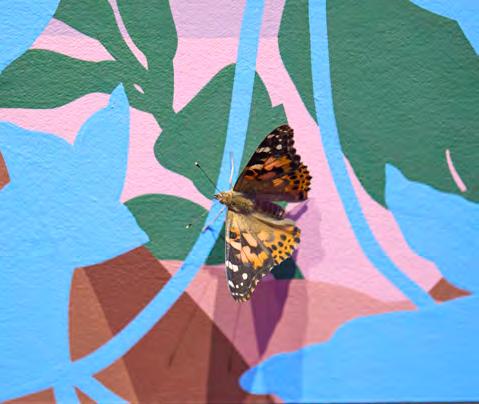

ITO When I was in school, there was a big relational aesthetics conversation happening as well as the agency of the image versus object, and how things are staged and placed around one another shaping the viewer's experience. How does one object give context to an image and vice versa? And then, how does the work create social circumstance? It was very much about exhibition design to me, tailoring an experience for viewers, and also being able to access different ideas with different mediums. I grew up painting, but also hated painting at times. I received a BFA in painting from SFAI and I was in the studio every day, but there was a New Genres department too. So, I did a lot of New Genres courses to mix things up. George Kuchar was teaching there at the time, and my painting professor Carlos Villa, an amazing Filipino painter really pushed what a painting can be. Also, Paul Kos would come by the campus once in a while too. That school had such a rich history. As I was focusing on painting in school, all these new conversations were happening and was just like, what am I doing? So, I started making sculptures and diving aesthetically into this kind of cleaner style of exhibiting work, which was very clinical, clean, minimal. You know, enjoy the beauty of this empty floor kind of work. It's delicate. It's very sensitive. But then, all my friends who weren’t in art school were like, what is this? They told me, “I miss the paintings.” And I was like, this is not the kind of art I wanna make. Why am I making art that only the art community can connect with? This is not how I want art to operate in general, to be exclusive and inaccessible to others that don’t have the same training as me. When I moved back to LA from San Francisco, I started seeing how these new paintings I was making operated on a whole new level, where I'm connecting with people. I'm telling my story; they're telling their stories. There's this very intimate exchange, and I wanted the space to conduct that without me being there.
So, I needed to start fabricating space as an open hand to hold and guide the viewer, using that exhibition’s design to build a transformative experience when visiting the show. They look at the paintings, they turn around, and they see a sculpture with an object from that painting. They turn around again, going back to reinvestigate the painting, the way it flows and carries into the next work and the next. When I moved back home from my time in San Francisco, I was basically starting from scratch. So, I started working on movie sets in the art department and working on scenic
and props mainly for commercials. I took this use of “treatments” like lighting design, painted walls, and floor coverings and injected it into my art practice to see how I can build experience, because experience is what shapes people, and experience is what we hold onto, and experience is transformational.
PULLAGURA I learned from another curator the principle that an exhibition is an argument made in space. It’s about the environment and the movement and relationship between objects and people. I think about the haptic experience when organizing an exhibition: how will this feel in space, in these relations?
ITO At the Anat Ebgi exhibition I did a sound installation, something I’ve never done before. It was the sound of waves sourced from a sound machine which we actually had in our room throughout my wife’s pregnancy during the peak of COVID in Los Angeles. It was a difficult pregnancy, and it was a time of high stress and anxiety for us, but it rested on her shoulders more heavily. The sound machine played 24 hours a day, and really helped her drift away and have a little bit of peace during these difficult times. So, for the show, I built a house in the gallery, one large enough that you could walk inside of it. The front of the house looks like a cute little homestead, a symbol of a home that I was painting a lot in my work. At first it looks inviting, but when you step into the house, the whole back side was burned down. It was just covered in black and it smelled like burned wood. And the inside of the house was painted super bright red, which just evoked this heightened sense of anxiety, but with the sound of waves lapping over the sand playing over and over and over again brought a contrasting sensation to the room. And it is this contrast that I feel we all have within us. When someone asks us how we’re doing, we normally say “I’m good” or “I’m okay,” but in the back of our minds we all have this fire that is burning. It could be the loss of a loved one, someone who is sick, maybe even a parking ticket that pushed us over the edge that day. Life is like a rollercoaster. It goes up, it goes down, it goes side to side, and flips, and turns onto itself. It’s scary, but it’s also joyful and exciting, and sometimes it’s just best to let go of the safety bar, put your hand up, and enjoy the ride.


How is one? One is buoyantly dysphoric. I dreamed about the nuclear war and Putin kept dropping bombs whilst I was cutting down a Christmas tree in the woods. The truth is, the horror of Christmas is far more a reality for me than the war. It’s all happening at the same time. I mean, I’ve been up since 3:30 am; watched Queer Eye all night. Had three coffees before dawn at the hotel bar. Great time to be doing a solo show. I’m so in despair with Europe, it’s terrifying. The lines between left and right are very thin. They don’t real ize it but they are merging. In the end we all were Thatcher’s children. I don’t know what’s going on but half of the park is closed. Is it mercury retrograde? Anyways, I’m navigating around it. Have I mentioned how much I hate people? It didn’t really sink in until Monday when I woke up. That stuff creeps up on you.
I am so bored of the art world not being able to be comfortable with looking at the work in the context of its space. Let’s face it, Du champ put a urinal in a gallery—no need for explanation. Did I tell you I dreamed about Darth Vader the other day? Dreams and con sumerism are both really interesting. There is a brilliant quote about how artists are the ‘stormtroopers of gentrification’. Makes me wanna go to Mayfair again. Instead I’m sitting at Elephant Park with my feet in the fountain reading Specters of Marx and filming dogs.
It’s a big day: Boris Johnson is resigning and a friend of mine died. I talked to some weird collector dude last night. He kept calling me darling and asked if I was a photography girl — what is this, the '80s? I would imagine you must be losing it a bit. Or have you come to terms with your self-isolation? Might never reappear. Maybe it’s time: move away and find a little place. Disappear, just make work.
It’s tempting; a bit like a drug. Isolation feels safe, it’s the ultimate comfort zone. Honestly, I felt really addicted to being alone after lock down. I have been playing with the idea of undermining my own authorship. It’s not new, though. I’m working so much right now about the unpaid emotional labor of living through history. Should I mint my trauma as an NFT?
I guess at this point I can still afford to go wrong and change my mind about things, pull out of stuff. Like a penis. I’m actually a dick. I’m not signing shit until Sunday. My signing is at 3 PM, bring boobs. I wanted to go to this opening but I stayed in and napped like a newborn. Then I literally went to get an iPhone 13 at the O2 shop, and I didn’t have to pay a penny. I love capitalism. Being an ti-capitalist is also part of capitalism. My new
phone is so big and beautiful. I’ve spent the morning reading about how bat couples give each other head all the time. It was elating. I think this is much bigger than just a question of religious delusion. Really it’s about the po liticization of non-reproductive pleasure. It’s the same as Brexit. That beautiful sound of the tumbleweed. Are you still feverish? Fuck me, it’s hot. This is the hottest place on the continent. I was shocked by how many peo ple were out. I wanna be at a beach. Great place to weep. I couldn’t sleep so I scrolled through my following and unfollowed over 100 accounts. Clean the house, Abramović style. My algorithm thinks I’m an aging mil lennial with erection issues. I only get ads for Viagra and hair regrowth. I mean they are not wrong. I should sign up with a fake email and see what happens. They really prey on the weak. Derrida speaks about this out-ofjointnedness and about translations of the expression and their different cultural nu ances. It all repeats itself through so many works: Derrida, Fukuyama, Fisher, Wolu kau-Wanambwa, and their contemporaries. Trying to make sense of these fractured stories. Funnily, Werner says in (I think) his cave documentary, that “the art of storytelling shouldn’t be fractured.” I wrote it down be cause I disagree. I feel that all that storytelling can possibly do today is fracture further what we think is true; the common threads in that myriad of narratives are for us to find. Sums up why I have a disdain for certain fashion photographers. This is so funny, it’s dread ful. Really we should start a book club. But I’m too busy. Where are my fans? I feel like in 2011 when I downloaded Instagram. Now, I’m against the understanding of photography as a representational medium. Trust no one. I’m always like, is it my intuition or my anxiety?
But it’s always an abstraction, produced by a coded, unstable medium. I left right before the orgy started, which I now regret. I got so tired I fell asleep under the table and then Ubered home. And now I’m waiting for the drama. It’s exactly what one would expect of someone working with online media. I acci dentally replied to their story instead of your message, saying their job offer was amazing but 35 hours per week was too much. Today is not the day to test my limits. I’m a Hoo ligan, and I can’t keep posting for free. It’s called a proper job. Is there no alternative? I bet Elon Musk would like my first book. But I’m not in a rush. Just walking through this park and this guy gets up from his bench, asking “Ma’am are you stalking me?”—not
sure whether to laugh or cry. Between yes terday and today I’ve become obsessed. Have you seen my shopping receipts? I’ve sinned. I’m staying in this insane villa filled with a million stuffed animals. Got a tattoo of a Greenland shark today, my favorite crea ture. I wonder if they actually remember the ships crossing the Atlantic 500 years ago. The universe knows how much I hate it here. I was told people in the UK don’t eat on a night out but we have oysters. Technology is always complicit. Actually I have been writing about how social media encourages people to communicate information through imag ery. It’s not opaque at all. Image production is not reserved anymore for the visual arts. The results are raw but really interesting. It’s not about aesthetic but about mere commu nication. And you only see other people’s posts if you post yourself. I’m doing it right now. Historically, the amateur market has been dominated by semi-ambitious dads interested in the camera apparatus and its role in manufacturing memories. Seriously, it’s insane. The amount of men I’ve experi enced re-enacting their favorite porn during sex because their pleasure is irreversibly tied to a specific visual experience. I just shed a single tear. Anyways, I don’t have time for this, I’m not fucking immortal. I am impa tient and irrational. Looks like the only place I’ll stay forever is Google Maps, where I’ve been eternalized sitting in front of my house in summer 2020. I remember waving at the cameras on top of the car. And though time goes by, I will always be hysterically wav ing at a Street View car in 2020. Here we go again. An absolute must-see. Last night a woman walked past me yelling into her phone, “I’m going to my dad’s funeral, I need to be drunk.” Strange ruminants. Heightens the risk of being hacked if you ask me. Not that you asked. I’m just bombarding you with content. I should be paid for this. Instead, I’m getting all these ads for consolidation loans now. Story of my life, so close and yet so far. I went for a walk at midday, it was 35 degrees, but I had chills from thinking about this me morial lecture. I found out his ex-girlfriend is a nutritionist. She left him last year and is now dating a model who looks exactly like him, just more ripped. The common notion of a good representation of self is alarming. Is your outfit set for tonight? I’m gonna be late, as always. It’s performative tardiness. Very niche, but my kind of fun.





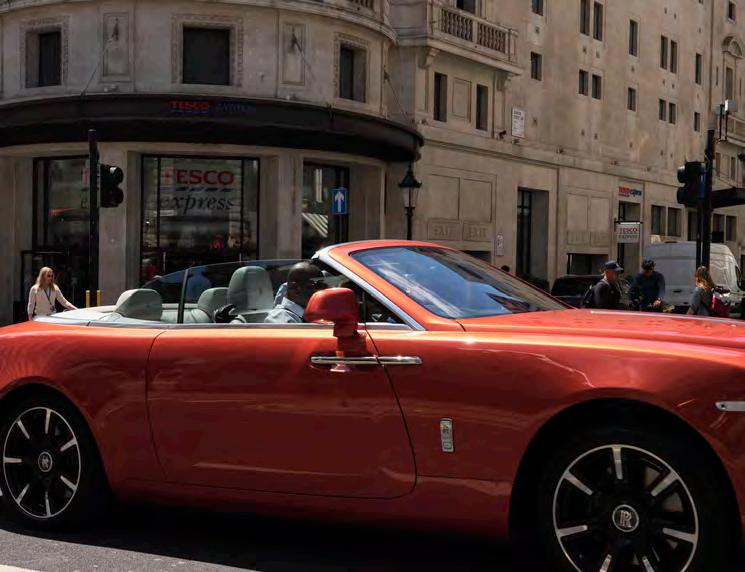



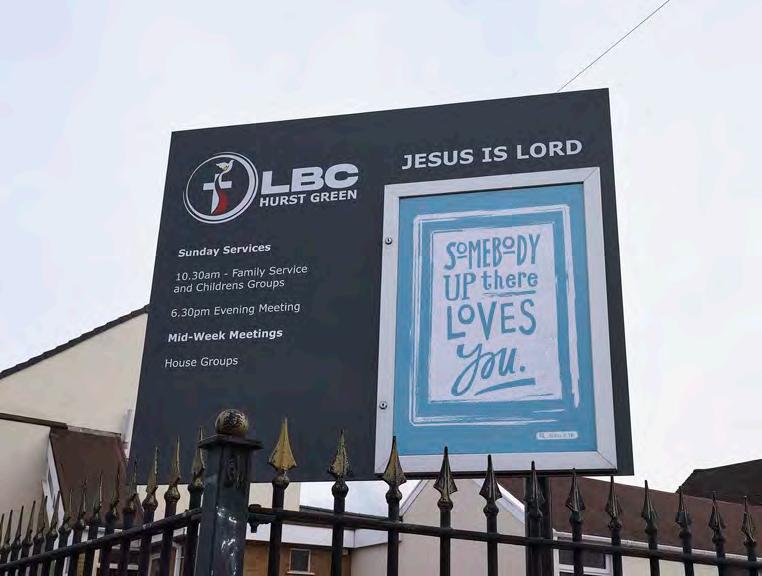




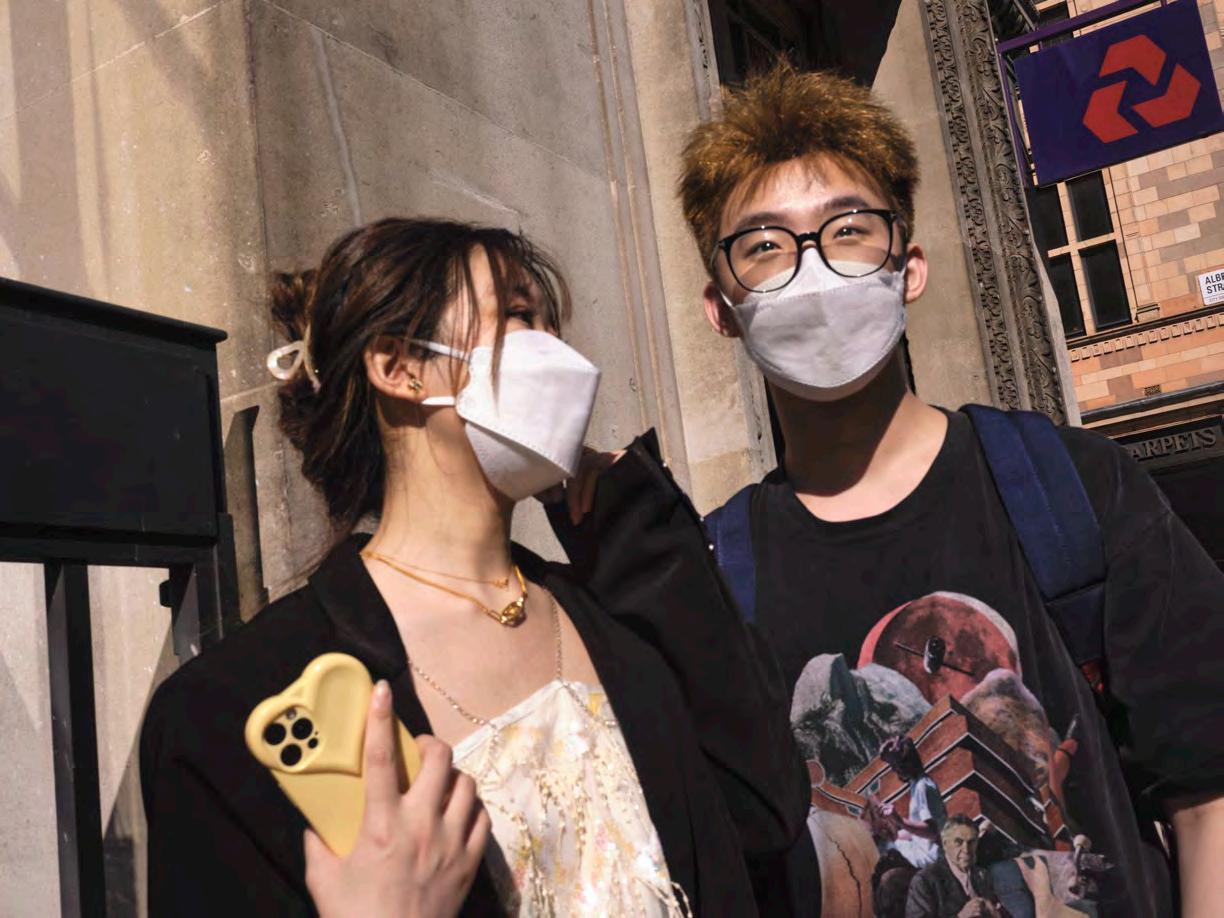

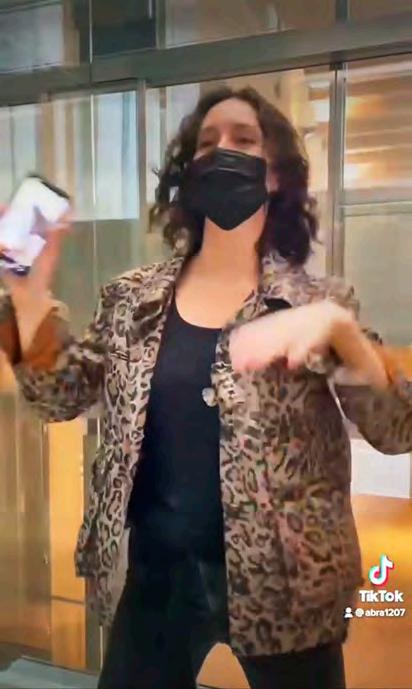
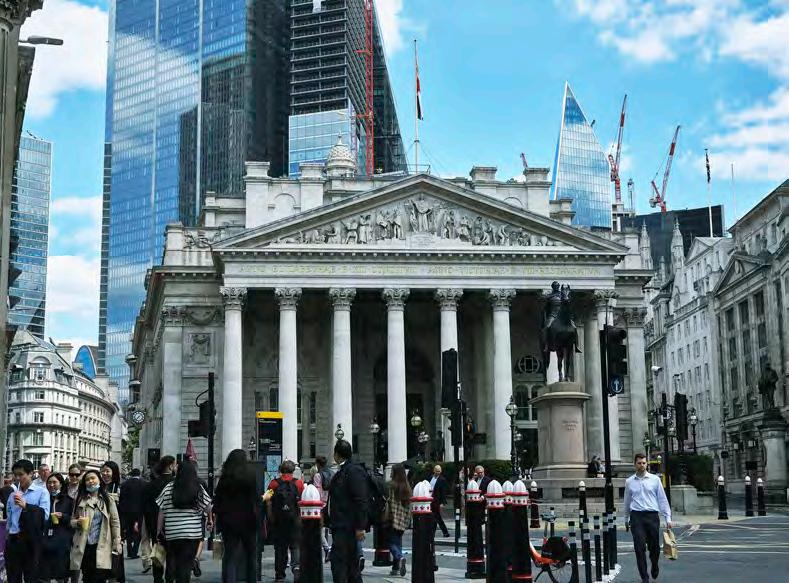


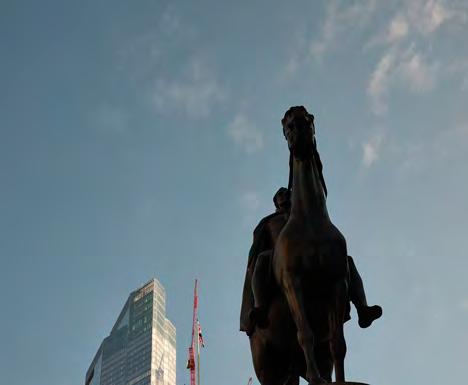




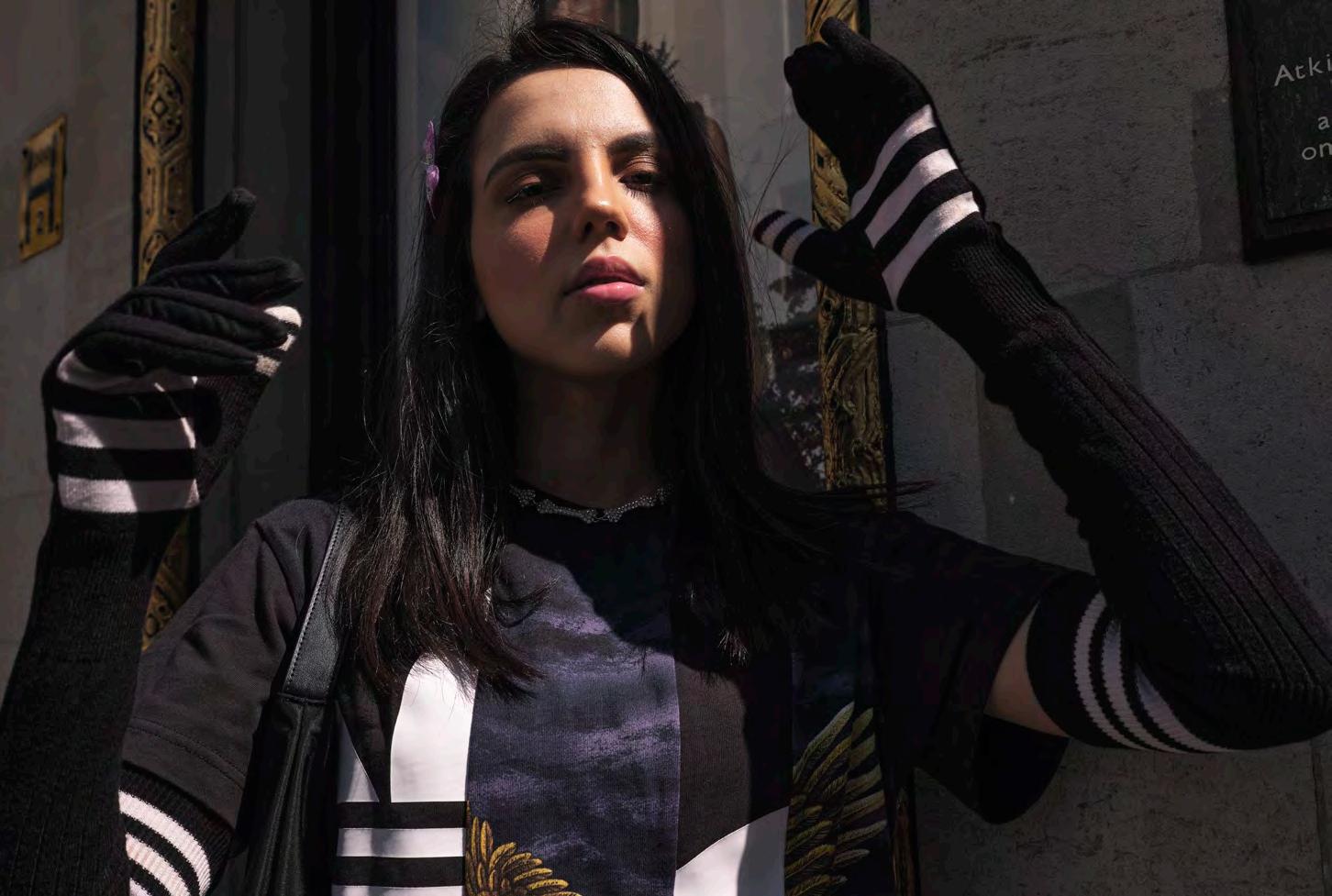
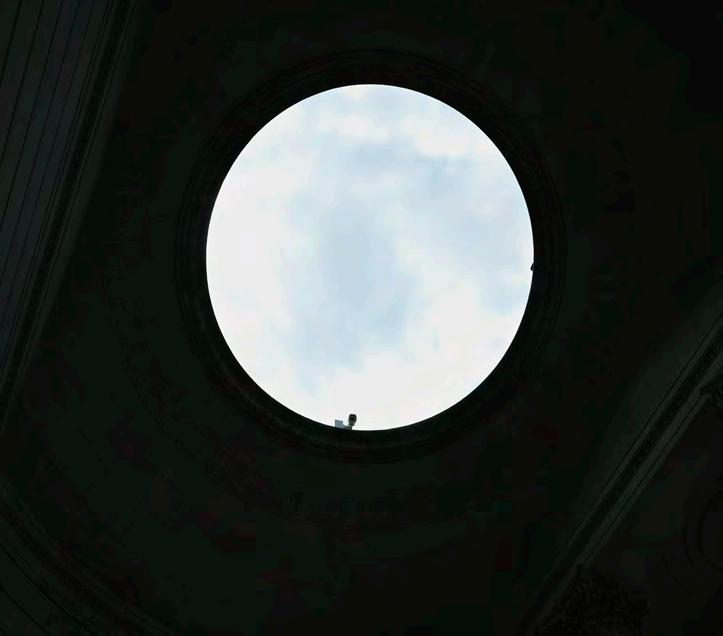
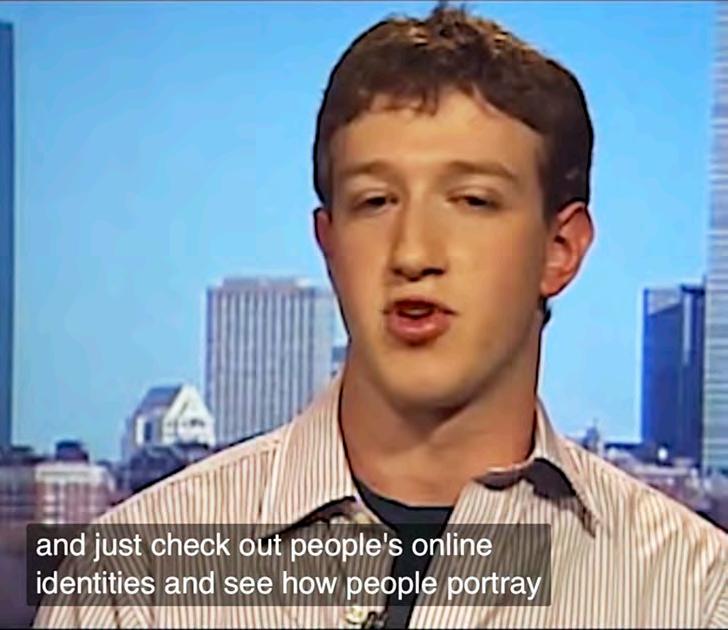

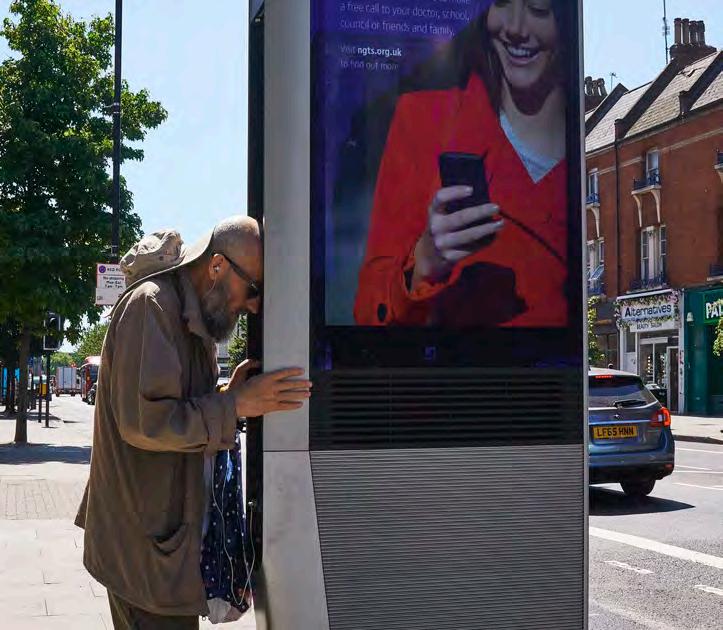
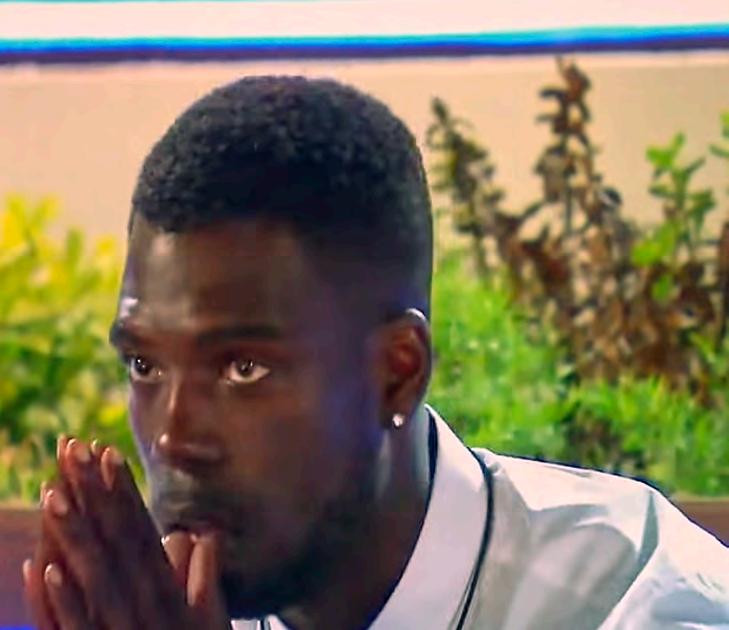
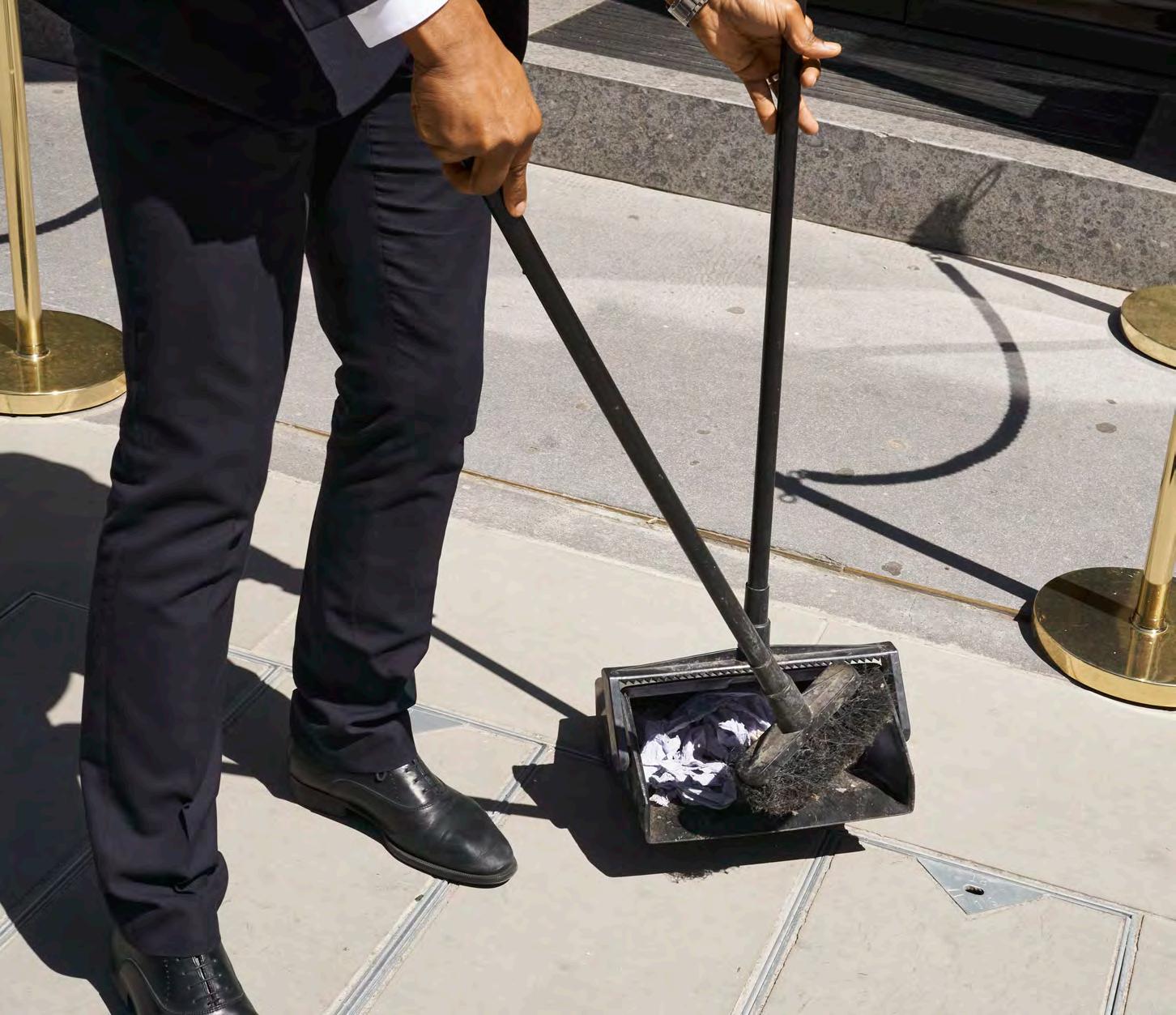


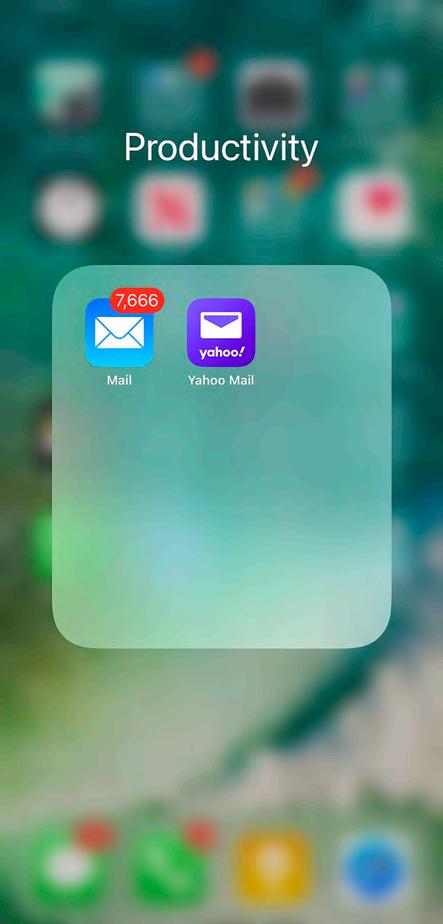
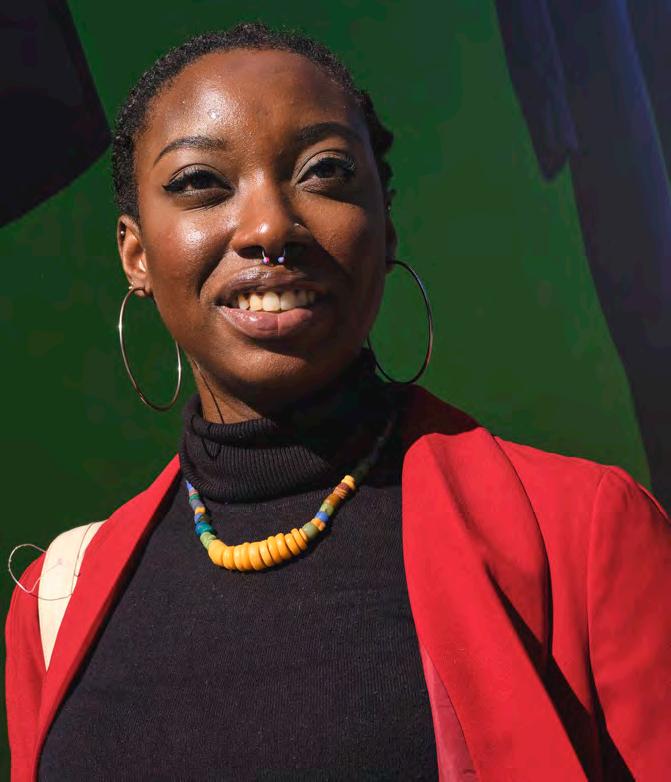
“The first gay club I ever went to was Tunnel in Leeds. I will always remember the initial feeling of acceptance not only within myself, but from everyone there too. She Soho can sometimes draw in straight women, and while I'm glad they have a space where they can be danger-free and avoid men, in the same breath, they are putting our lesbian customers at risk. If one of our customers approaches one of these women it can end in an awkward and uncomfortable situation, where our customers have placed trust in us to provide them with a space without the calamities that might unfold in a straight bar.”


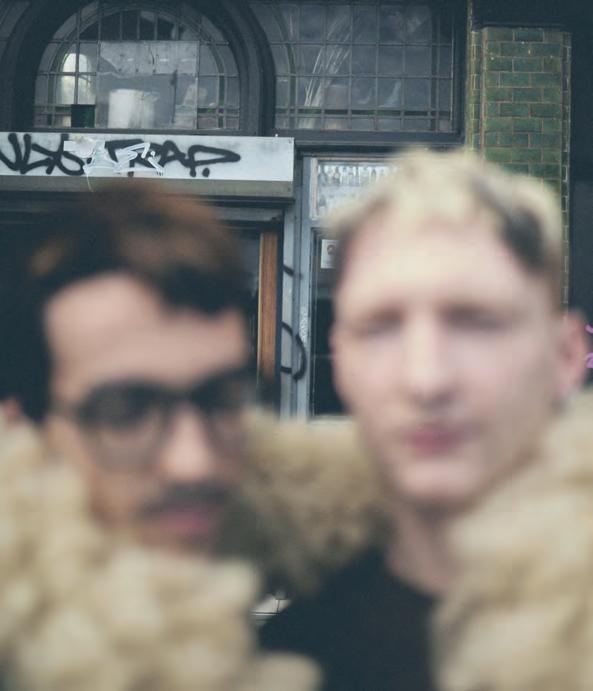
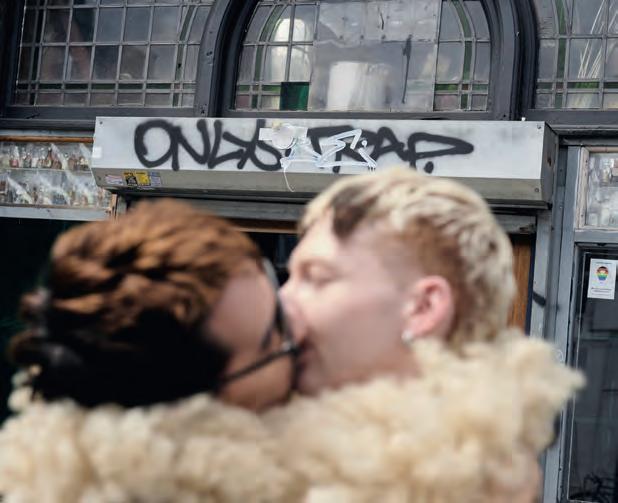
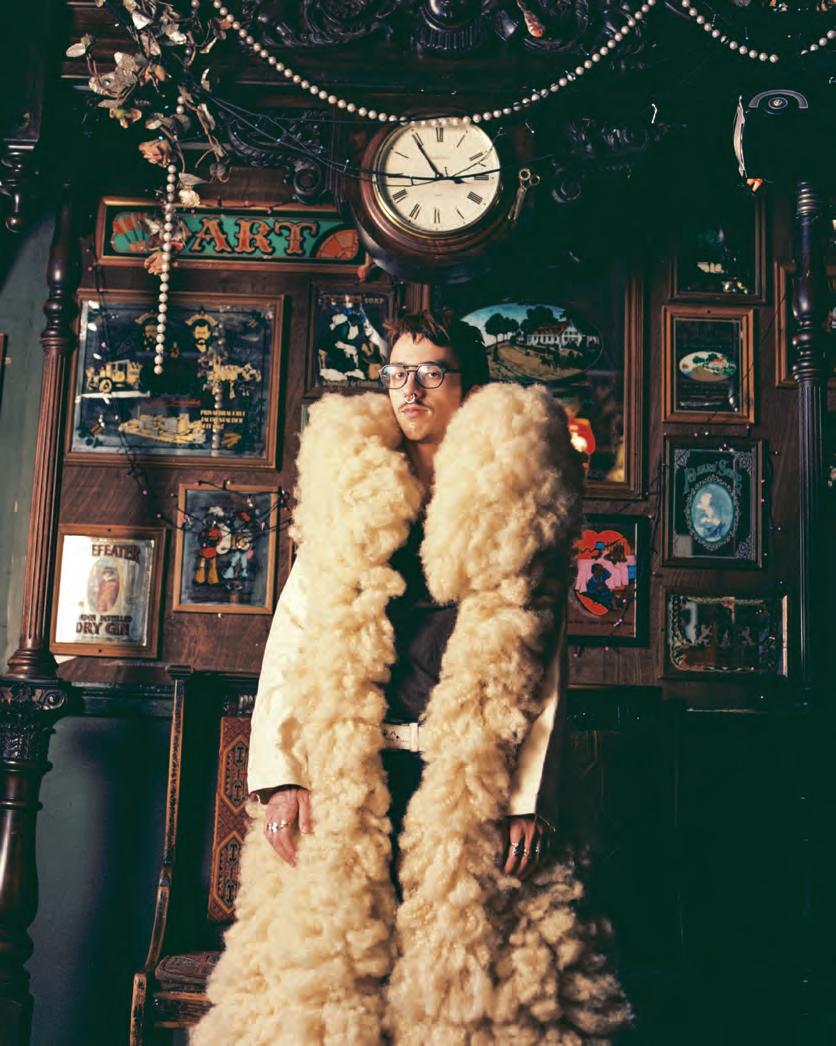

“Coming from India, where the LGBTQ+ community was so closed 10 years ago, I have been delighted in the change I have seen coming to London and working at Ku. I now have the freedom to be my authentic self, which is all I have ever hoped for, and it has changed my life for the better immensely. We welcome all members of the LGBTQ+ community and their allies with no strict door policy.
We only insist on mutual respect within the communities to create a safe space for customers.”

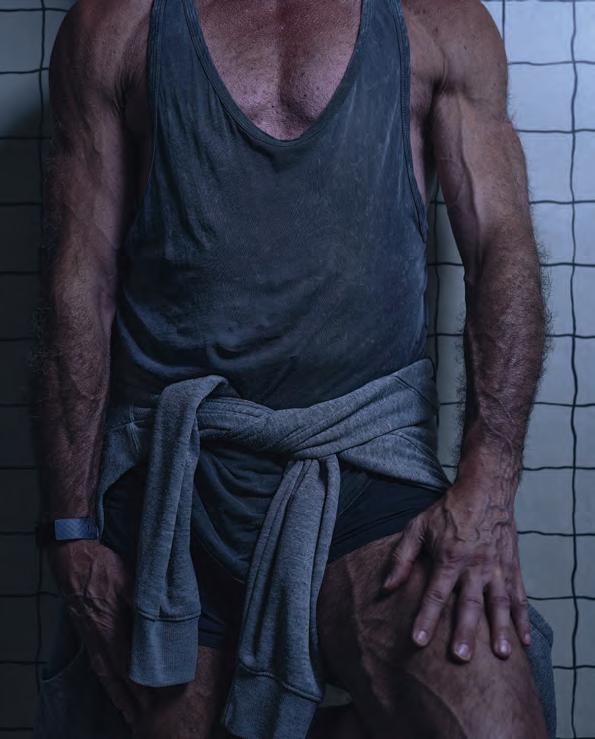
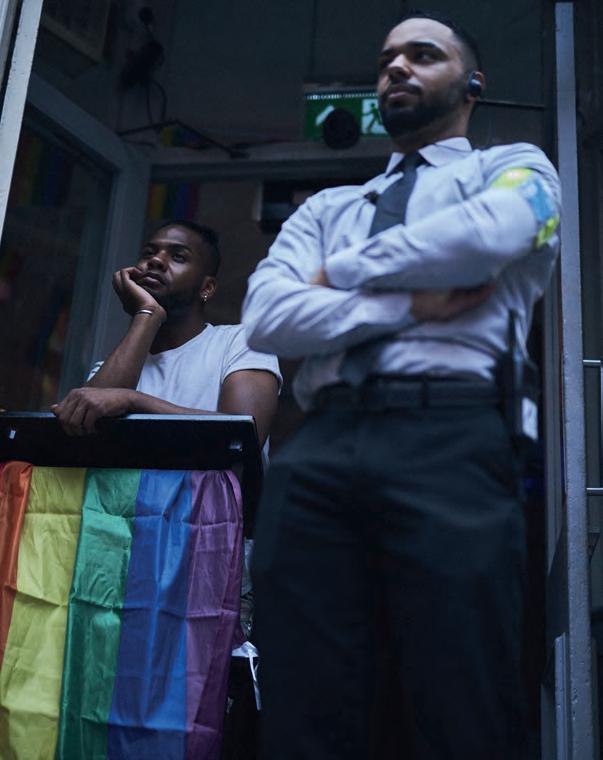
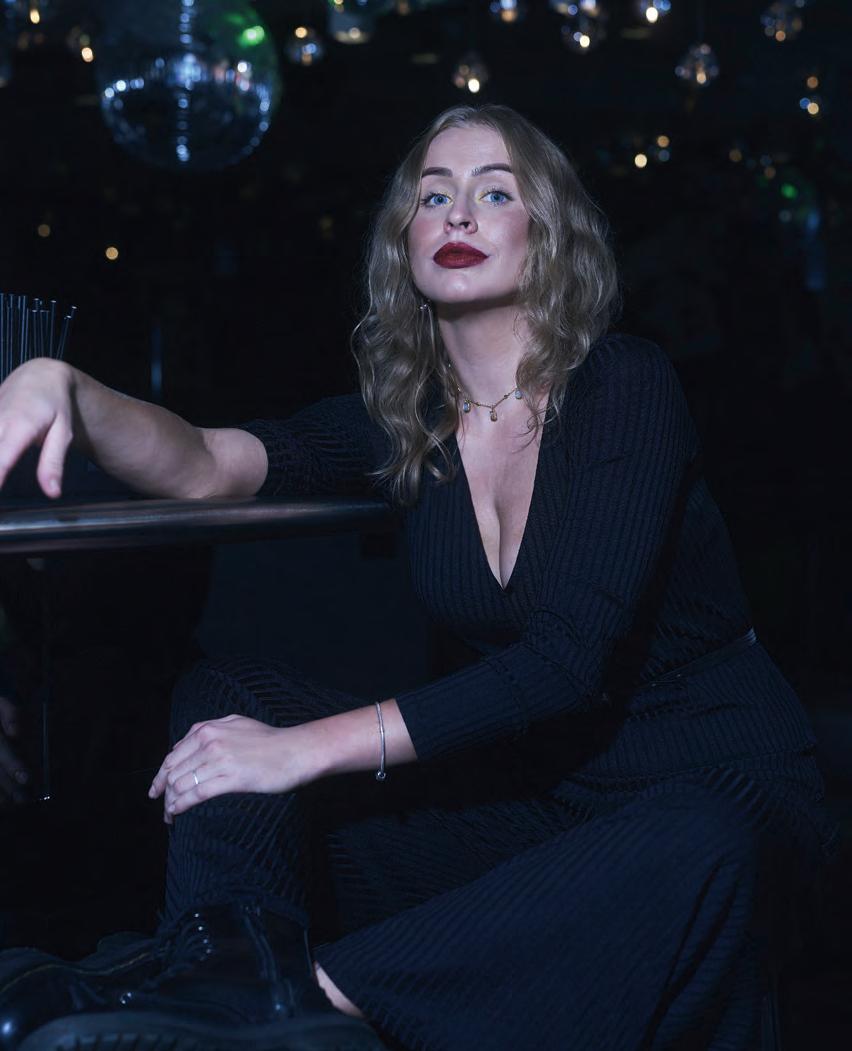


“The Nelson was bought from under our feet and they tripled the rent overnight. It took three years and four places to fall through before The Cock came along. We thought it might take some time to get going, where we would be serving cricket people and former Tiki customers. But No. We opened the doors to crowds of fabulous gays.” FARIKA
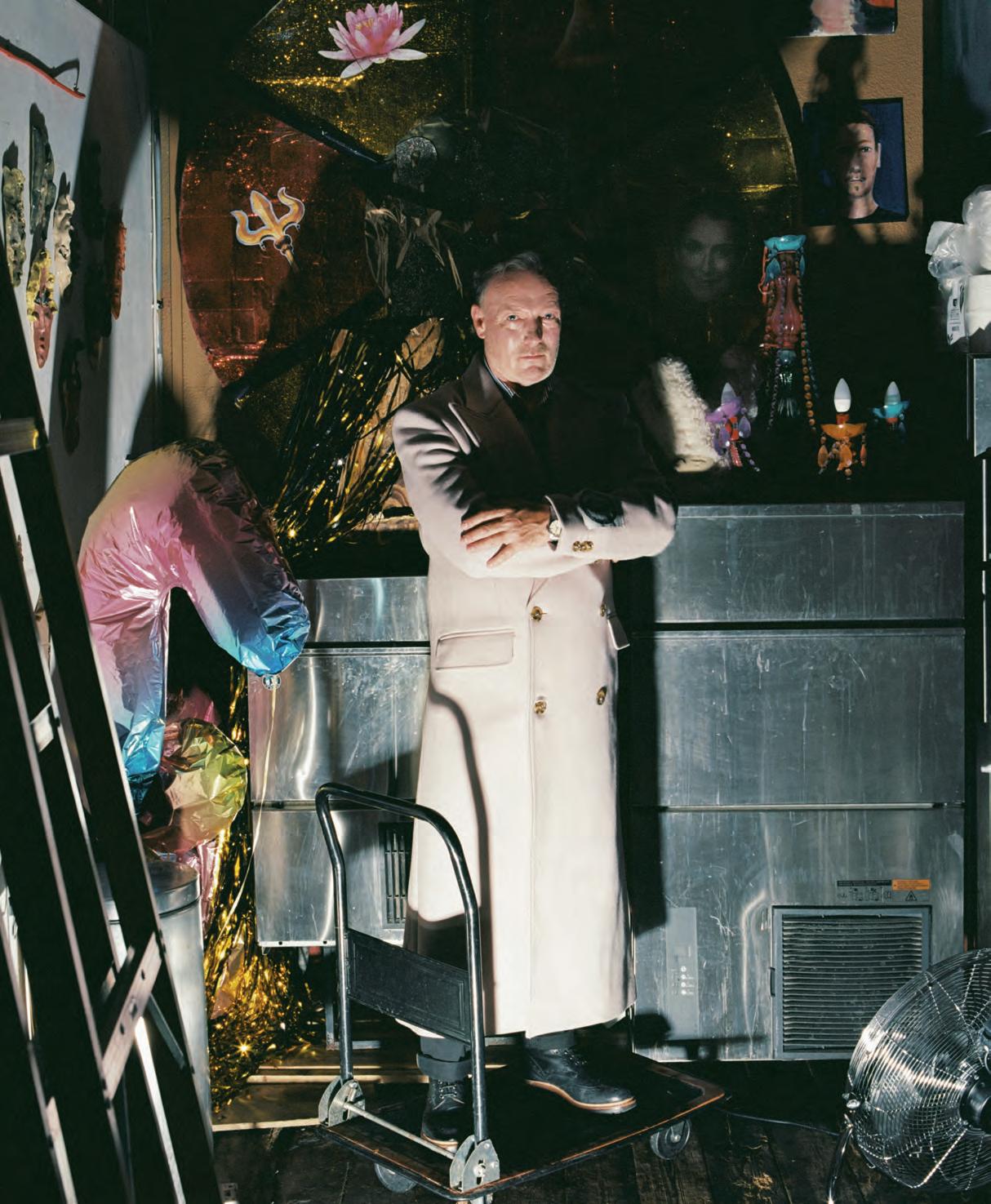
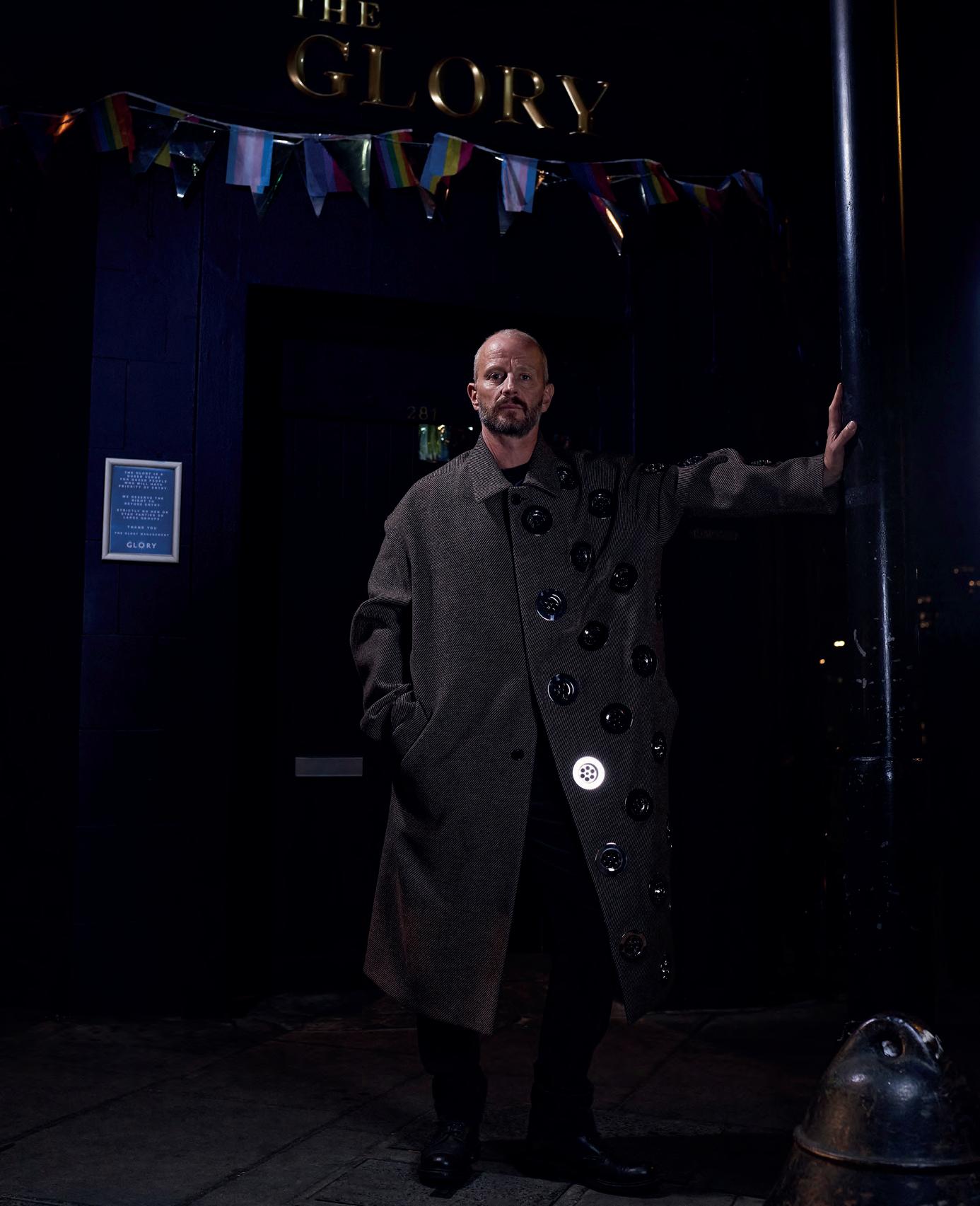
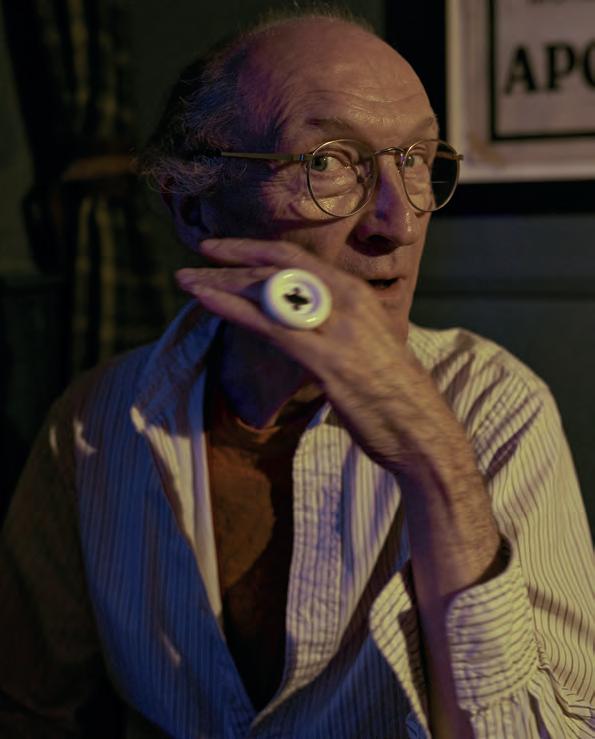


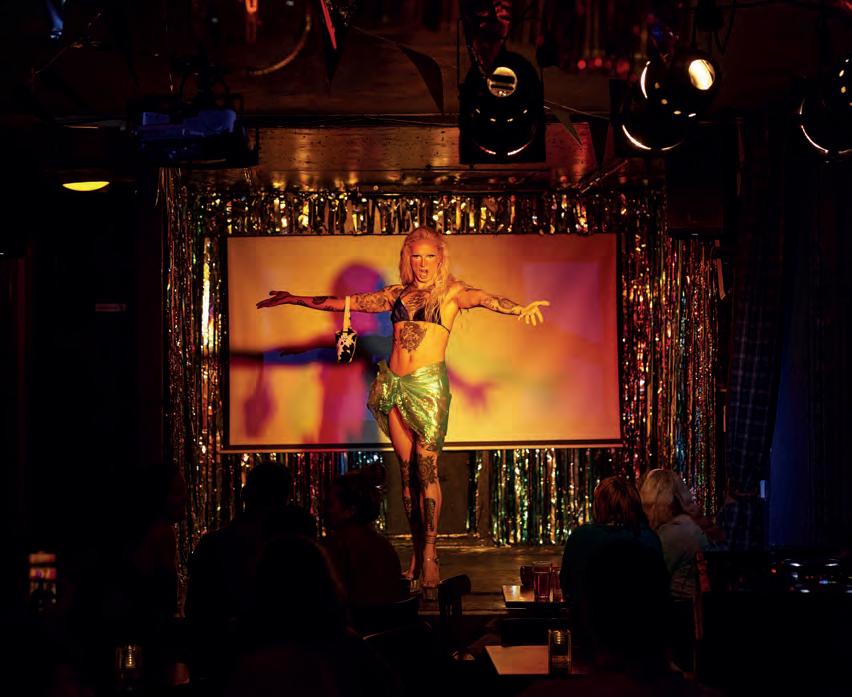
“Our community are who have made Eagle what it is today. Our community use us like an essential service. Somewhere they can go and feel safe, meet like-minded people or simply have a night out and let loose and who knows, as so many have, meet that certain someone who becomes their someone special.”
 MARK OAKLEY
MARK OAKLEY


“We operate a scheme of ‘No Means No.’ If another patron tells you they’re not interested, then take that as their one and final answer. Consent is key in whatever activity it may pertain to. As soon as one party withdraws consent and says no, that’s it. No ‘ifs.' No ‘buts.’ Sex has been around since the dawn of man and ensuring a safe and stable environment for people to attend and meet likeminded individuals in the modern age to me is a must. I could not imagine my life without a venue like Vault in it.”
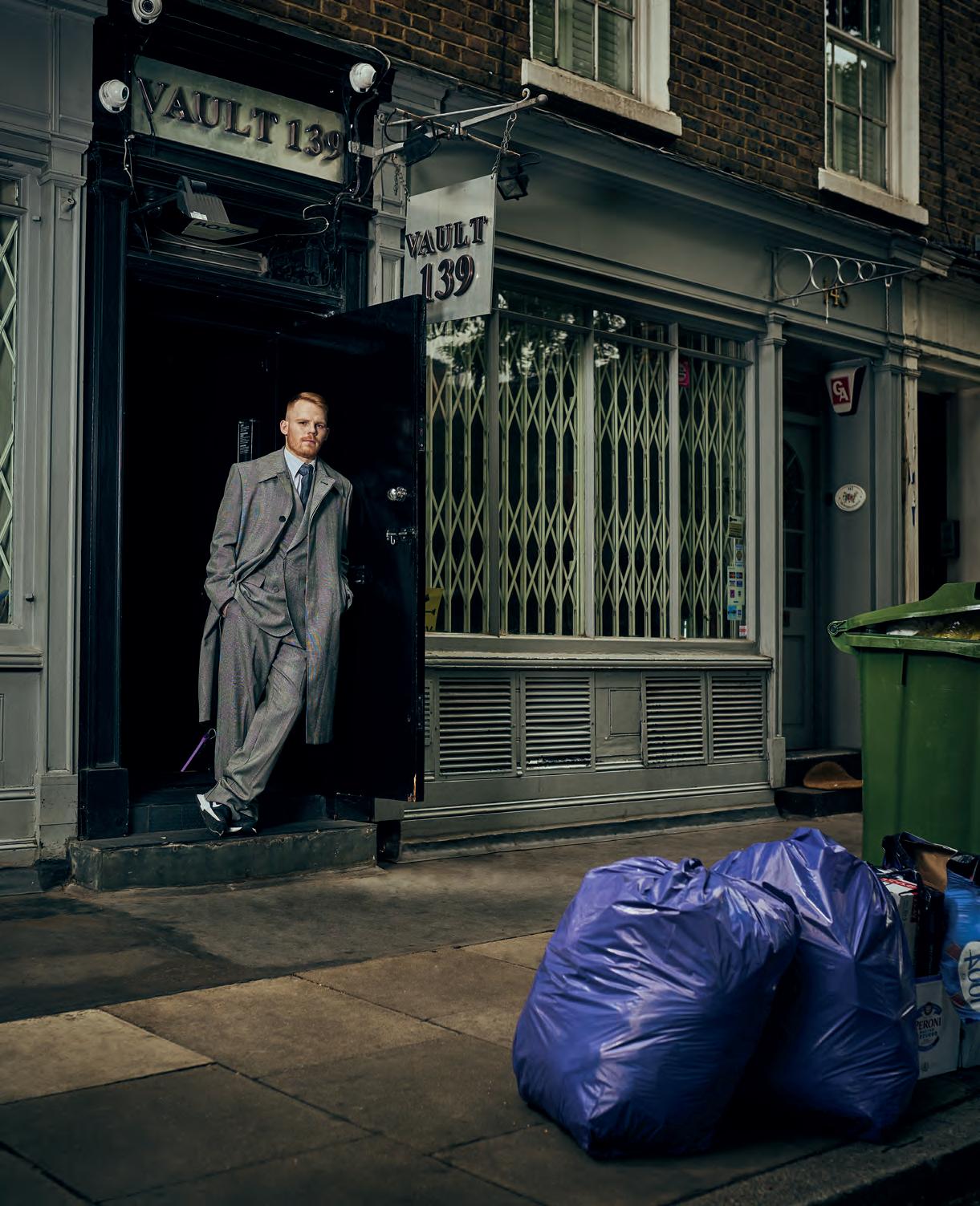
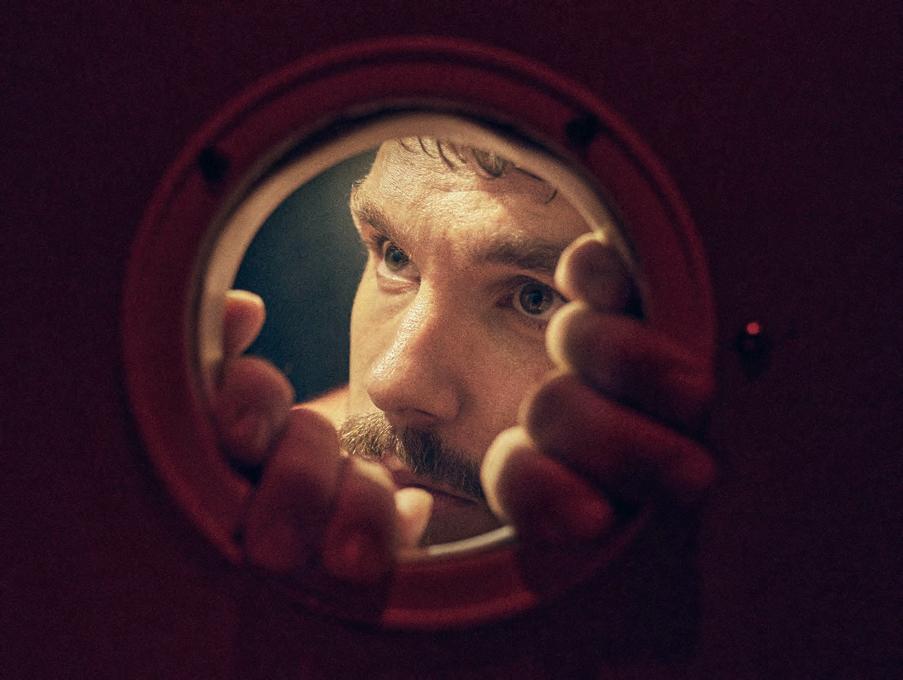
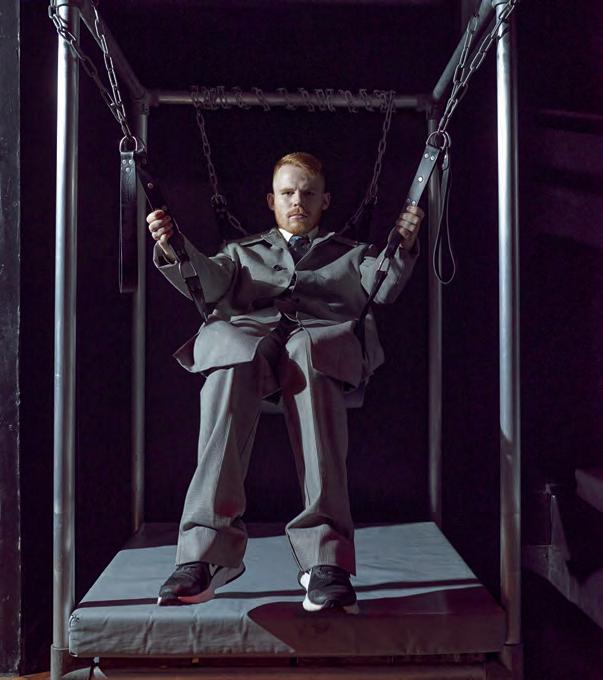
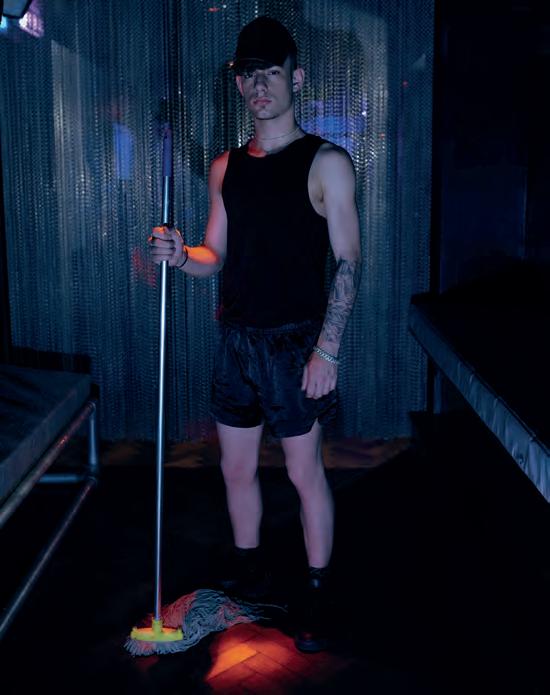

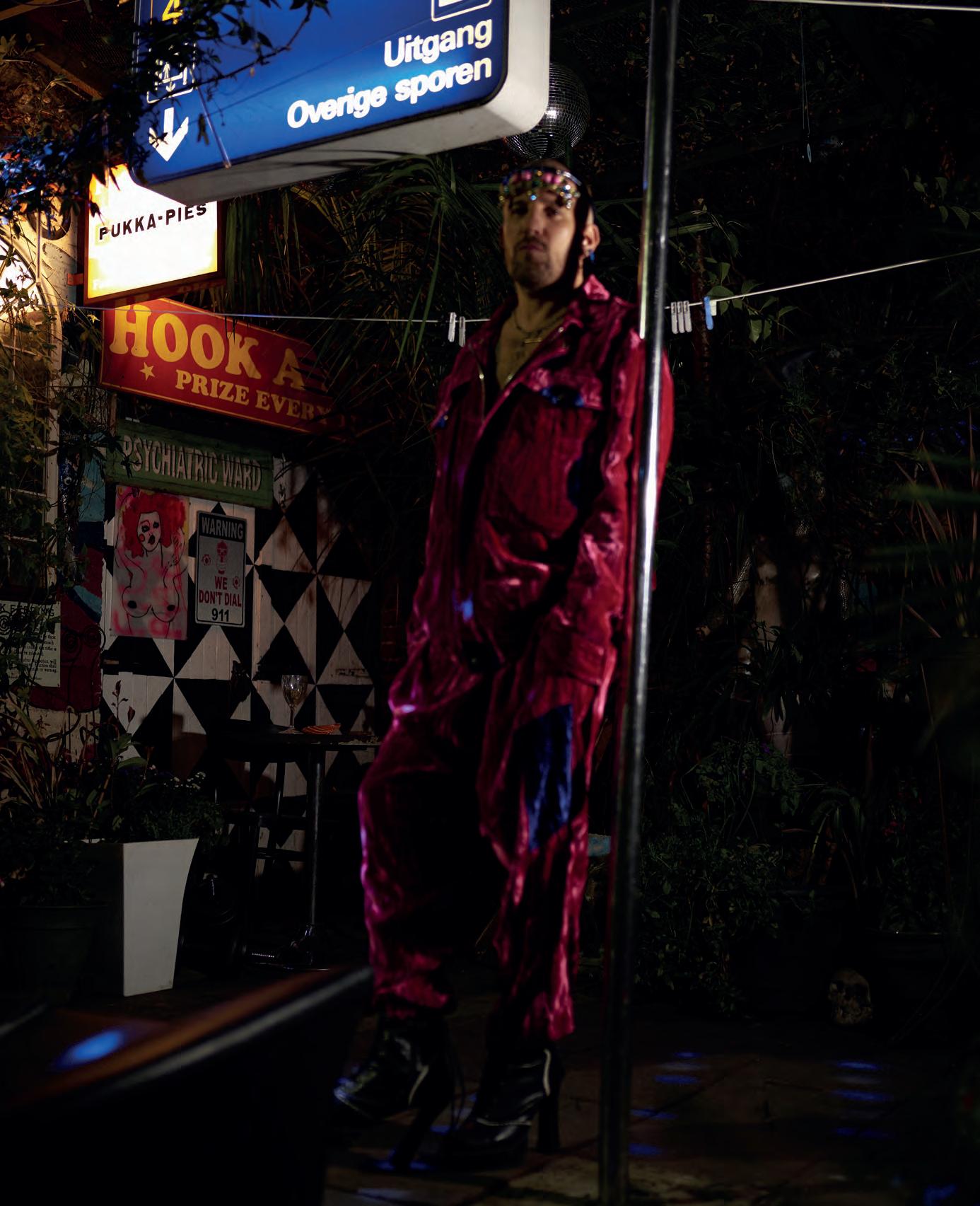


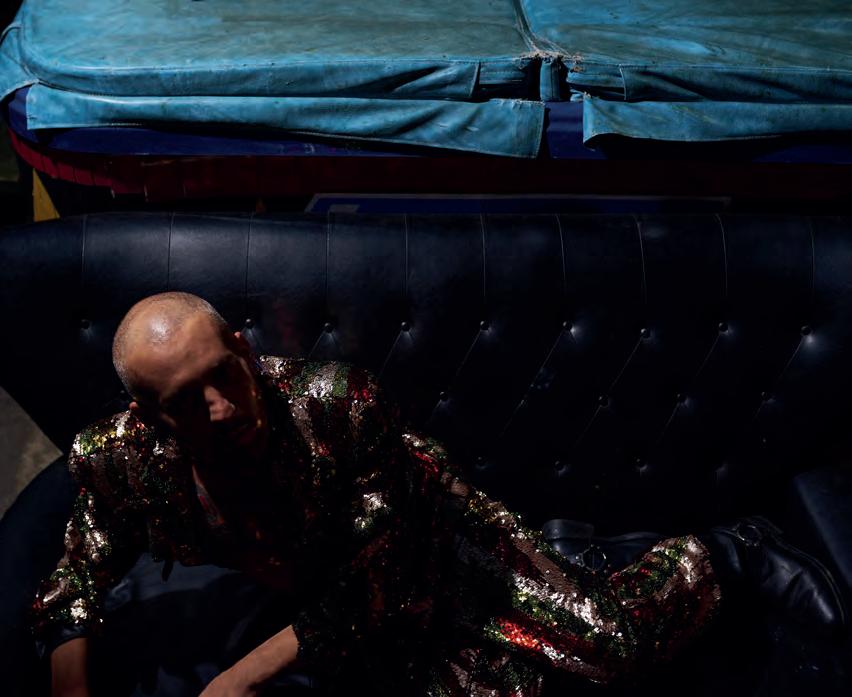
“I came out to my friends when I was 21 in Manchester while at Uni in the 90’s. I hadn't wanted to tell my parents yet, as they were very religious. Being two hundred miles from London gave me the freedom to try out new things. The first gay club I went to was Paradise Factory.” COLINTOP Colin wears a jacket and joggers by Edward Crutchley. BOTTOM suit by Anastasia Bull.



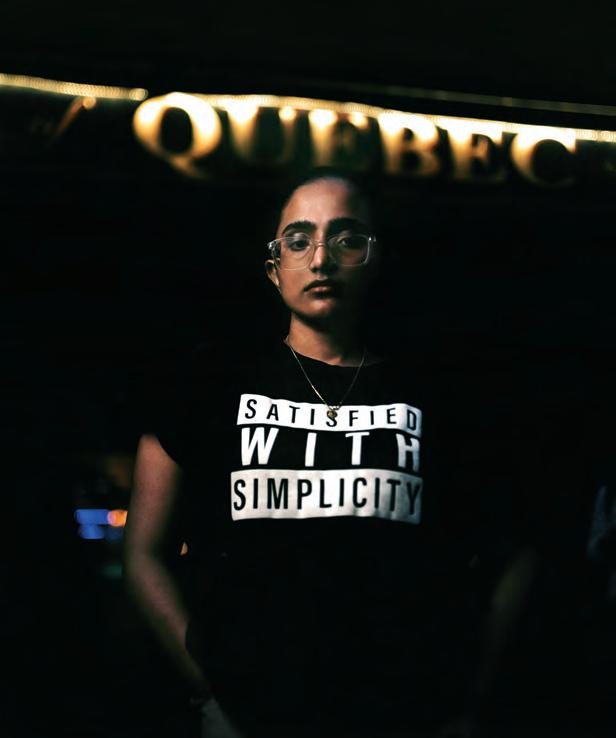

“I moved to London as an 18-year-old in September 2000, from a tiny rural town in the Pennine Hills of Lancashire, I couldn’t believe the power and the magic I found here. It cast such a spell on me that I have remained here ever since. We are lucky to have had our head doorman Chris at the venue for a very long time. He is a Soho institution!! He has a great relationship with our crowd and can spot the new, the unsure and the first timers. If you appear friendly, stylish and fun then you are always welcome at Freedom.”
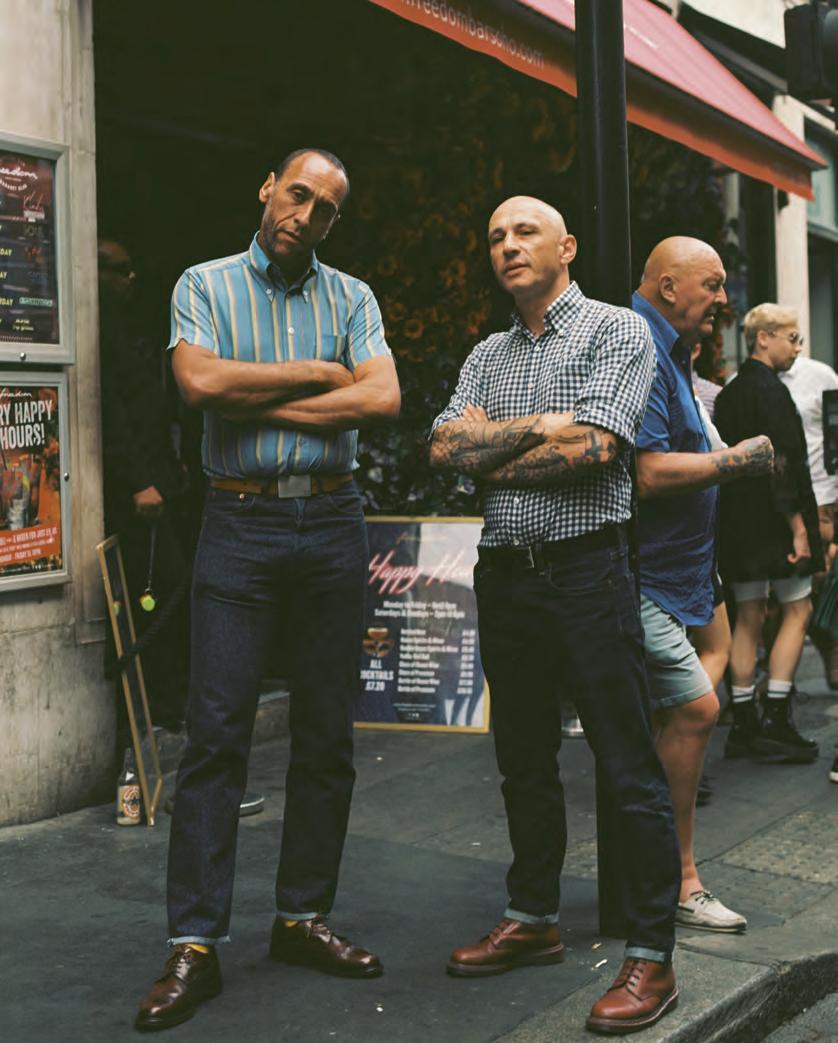

CARL
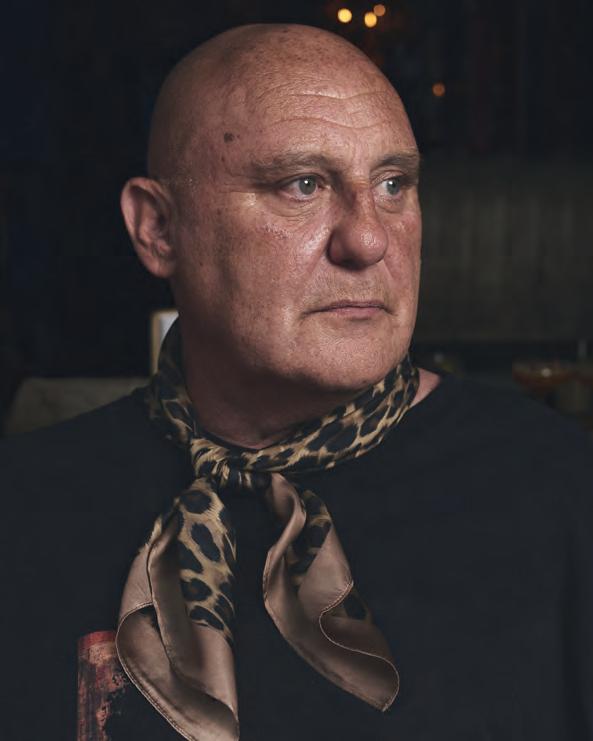

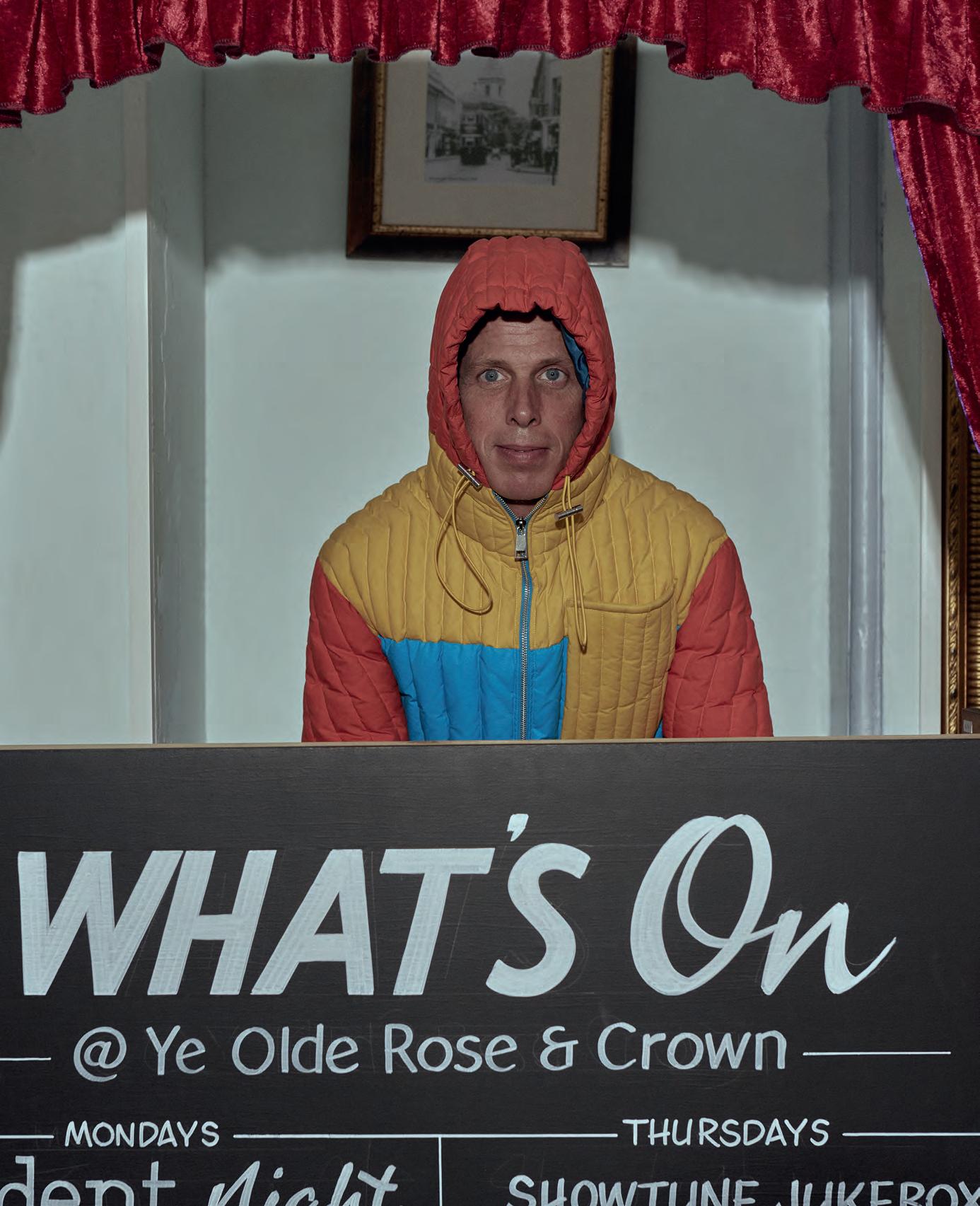

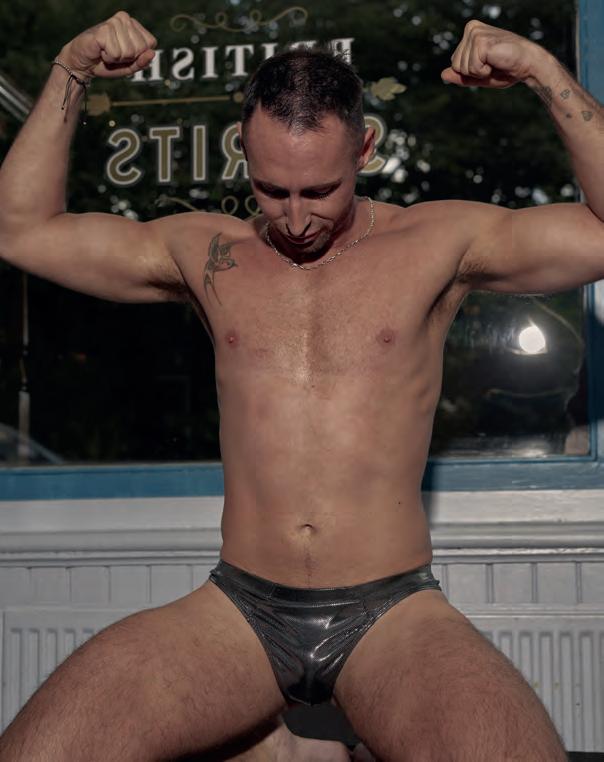
It’s still there. The Ship Inn. On the lower road from Rochester to Chatham in the Medway towns. The main bar, straight, and around the side down and alley, a door. Claire and I both jostling each other to go first. I don’t recall who pushed who, giggling, into a room which felt no bigger than my living room at home. The conversation stops. The music from the jukebox keeps rasping and a few disco lights flash persistently. Shuffling to the bar. 2 pints of cider and the eyes revert to those of their drinking companions, and we find a table and huddle, chuffing on Silk Cut fags, or ‘Silky Cunts’ as Claire used to call them, and scour the room surreptitiously. Other gay men and women. The year was 1988. You’d get battered for wearing the wrong-colored shirt or had the wrong hair cut or walked in the wrong manner; being seen as gay in public was to be avoided. Moderating our behavior, our dress, our speech. It’s terrifying and thrilling those first steps into a gay bar as a 16-year-old. It’s terrifying the thought that the room would turn its gaze to the door as it swings open and you would be, for the first time, maybe, recognized. Seen.
I wasn’t consciously hunting for ‘safe spaces’. The term wasn’t used back then. There was a thrill and a sense of danger going to gay bars. I approached each new bar with heart thumping anticipation. And whilst each new pub or bar or club came with the threat and the thrill of the unknown, I knew I wouldn’t be smacked in the face because I was a poof. I could cross my legs when I sat and maybe hold a fag the way girls did, pass my hands through my flopping hair as a man, older would look at me from the other side of the bar and send me over a drink. It was 1990, Soho, London. The pub, Comptons. ‘You’re far too
languid for your own good’ he said. I had to look it up when I got home. He took me down some stairs in a Soho side street and pushed me down onto his cock. We were concealed only by shadows and the grate of the stairwell landing and people walked over head. This was a dangerous space. I loved it. I was 18, he was older, 28 and it was illegal for the two of us to be sucking each other’s cocks; not just there. Anywhere.
By 1995, the consent law had changed to 18. I was over 21 now anyway. I lived in stumbling distance of The London Apprentice (The LA), a ‘men-only’ club on Old Street in East London. You could get in for free before 11pm; double vodkas were a fiver; blacked out windows; a ‘maze’ of draped netting upstairs and a strange urinal toilet on the way down to the dancefloor, which was crammed full of men under lights, blacked out by torn scraps of BOYZ magazine. My friend pushed me through the door to that urinal just after 11pm on my first visit’ Check that out!’ I stumbled out and back up the stairs close to 5am. I loved the intensity of being in a club full of men. A potent ambiance of desire and opportunity to pursue men like me; to be pursued. I felt sexy in a way I couldn’t beyond those blacked out windows.
“In London it was the LA in Old St. I couldn't believe the naughty room upstairs it was very exciting after all those years of being in the closet. I was like a kid in a candy store.” Colin (The Shed)
I was still the same nervous 16 yearold in The LA though. I got my confidence through drink. Lots of drink. Then I could snog men. Suck men. Fuck men. With abandon. Without caution. This space hid dangers. Dangers to which I was drawn like a moth to a flame. Still shackled by the shame of societal stigma and
prejudice. HIV was a terrifying spectre. And it haunted me. I was addicted to those moments in the dark backrooms of London. I woke the next day, often, terrified.
The turn of the century saw East London lose a slew of gay bars with no fanfare. A sex club became a Cost Cutter. A side street dive with drags and strippers became an architect’s office. A notorious late night karaoke bar got sold and went straight. The LA changed its name and was rebranded for the trendy scruffy Hoxton crowd. But as one scene died another thrived. The ‘90’s was the decade of the pink pound. The boarding came down from windows and the doors flung open. The community could be seen and was seen as a chance to make money. Soho buzzed 24/7. It was a wild time. London was glorious. We had one goal. To have a much fun as we possibly could for as long as we could. It was literally the fin de siècle! Venues like Freedom, Village West One, Rupert Street and the Yard let passers by watch smart London queers chink glasses under a haze of 90’s signature perfume, L’Eau D’Issey before hitting one of the many clubs that proliferated across the city.
I spent three years in NYC at the turn of the new century and discovered a new sense of identity and community amongst the downtown performance art scene of Manhattan. Artists, drags, burlesque, go-go, sex, rock, techno. I felt a tangible sense of identity that I hadn’t experienced before. A new possibility of what a night out could be. It could be radical. It could be joy. It could be filth. In 2003 I showed Richardette, owner of the newly opened George and Dragon, Shoreditch, pictures of my new drag look in NYC. ‘I’m Satanica Pandemonia’. ‘Does Satanica DJ?’ And so, our Sunday soiree, Radio Egypt was
born and a new scene of like-minded gays, dykes, queers, stylists and artists gathered around and spilled onto the streets of this small characterful corner pub. The George was the anchor where the fashion led queer scene met. Down the road was The Joiners Arms, a survivor of the late 90’s cull. It was favored by local East London gays. Tougher. A different posturing. There was a frisson between the original East London gays and the new trendy queers thrown together in the grime of The Joiners. It was a tinderbox of excitement that was explosive and free, blurred by poppers and pills and pints. There was a crackling excitement of the unexpected. We were safe to dance with abandon and cautiously two scenes melded into one but the walk between the two or the stumble home late at night was not without danger; I got smacked in the mouth in drag; a brick was thrown through a pub window; someone got stabbed in a back street.
“Vauxhall is changing beyond all recognition from 20 years ago when we arrived. The gentrification and cultural cleansing of our area will continue to erode a once vibrant exciting LGBTQ+ area. Vauxhall once had over fifteen venues. We are now down to the last four.” Mark (Eagle)
Mid 2010’s, The Black Cap in Camden one of London’s oldest LGBTQ+ pubs closed. The Joiners Arms followed shortly. London also lost lesbian bar, The Candy Bar; Barcode in Vauxhall, Madam Jo Jo’s, The George and Dragon and The Nelson’s Head in East London shut their doors. The streets were becoming safer. Our spaces were not. The desire for urban developers to maximize their profits at the expense of our spaces felt relentless. Unlike in the ‘90’s when as one scene died another flourished people now began to acknowledge the value of our spaces and their role as the heart of our community. Space was being taken away and new spaces weren’t so readily available for us to inhabit. Had we taken our spaces for granted thinking ‘oh they’ll still be there when we get bored of Grindr’?
We opened The Glory in 2014. A complete coincidence with the closures since we’d been looking for a space for four years; myself, Colin, John and Zoe. Our narrative wasn’t to fill the gaps where other venues had closed but to create the kind of place where we wanted to go out. I still had memories of my NYC days when no night out was complete without a show and so with the parties and the décor we sought to create the kind of place we wanted to go to. I was
conscious when looking for spaces that sometimes we’d see pubs that were once local working-class pubs for the local community. The give and take of the city. Where one community thrives, another is displaced. Our pub was unloved and barely open when we got it and we spent a small fortune making it look like we’d been there for 20 years. We were busy quickly. But we still had to build our crowd.
diverse. We are city of people from many backgrounds and ethnicities and I see our spaces responding to the changing needs.
I see people taking up and carving out space for their part of the community where they feel their representation is lacking or the type of night out that they want has gone. Our bars, clubs and nights out are only the product of
We had to program heavily. And in time a new community with performance at its heart blossomed around us. One evening a transgender customer came up to me and said ‘The other night you came up to me as soon as we arrived and bought us a drink. I’d just been abused on my way here. You made us feel so welcome. It was just what I needed. Thank you’. It was so humbling.
‘The warmth and love radiate as soon as you walk through the door. We have plenty of customers that arrive alone and anxious, but within a few hours and a couple of strong drinks we see those same customers leave with a potential lover. The sisterhood we see before us is so incredibly special and unique to our bar. Only lesbians understand lesbians, it is a unique experience for us which is why it's so sacred’ Liv (She Soho)
With Covid our survival as a pub was very much put in doubt but with the real threat that we might close and I thought, ‘If we have to close The Glory, there will be no Glory’. The performance space we’d created had become a valuable resource to not only staff and performers but to our customers. A space to share in the dialogue between an artist and their audience. A sharing of familiar experiences. Covid literally kept our community apart, but it brought into focus the real need for LGBTQ+ people to have spaces where they can come together to connect and to be their authentic selves. The importance of our space had grown beyond the bricks and mortar that shapes it.
I need to know LGBTQ+ spaces exist in a city. We need to know that these spaces are there as despite changes in societal attitudes we are still ‘other’ than the ‘hetero-norm’ and there are times we need to be with people like us. But just as our pubs and clubs work to serve the community so the community needs to nurture their spaces. They are precious. The acronym LGBTQI+ tells us we are
a handful of entrepreneurial people who say, ‘let’s make something happen’. In a licensed space, or in their own back yard.
“I've always liked putting on parties— my mum did too. I had a tiny shed in my back garden. But it was a potential death trap with broken glass and old toilet seats. I got a new, much bigger one. I got it soundproofed and had electricity and decks installed and then the fun began. A bit too much—especially after we got the hot tub too. The neighbors would often come round and say 'What is it this time? The fucking cat's birthday?!” Colin (The Shed)
We, at The Glory listen to what our audiences need whilst trying to deliver something that is quintessentially ‘us’. I will only speak from my own experiences with queer spaces from my first steps in a gay pub in Chatham to being a venue owner and space creator today. I have no authority to comment on the needs of others to their queer spaces. The pub and bar owners featured in this amazing shoot will have their own challenges and triumphs; their communities will have their own needs and expectations. You, the reader can only speak of your own relationship and experiences to the queer spaces around you. Only you know when and if you feel safe, what you are looking for and what can you give. Our community is only as strong as the effort made by its members.
I’m 50 now. I’m not so far removed from that 16-year-old stumbling into his first gay bar. I still like to see communities grow around new parties and performances. I still enjoy the few remaining sex clubs of London and sober, I’m happy and conscious with the choices I make.
After all these years and everything I’ve seen and learnt, I’m still looking for the same thing. Somewhere I can be myself.
"Friendship overrides race, religion, and sexuality." Farika (The Cock)
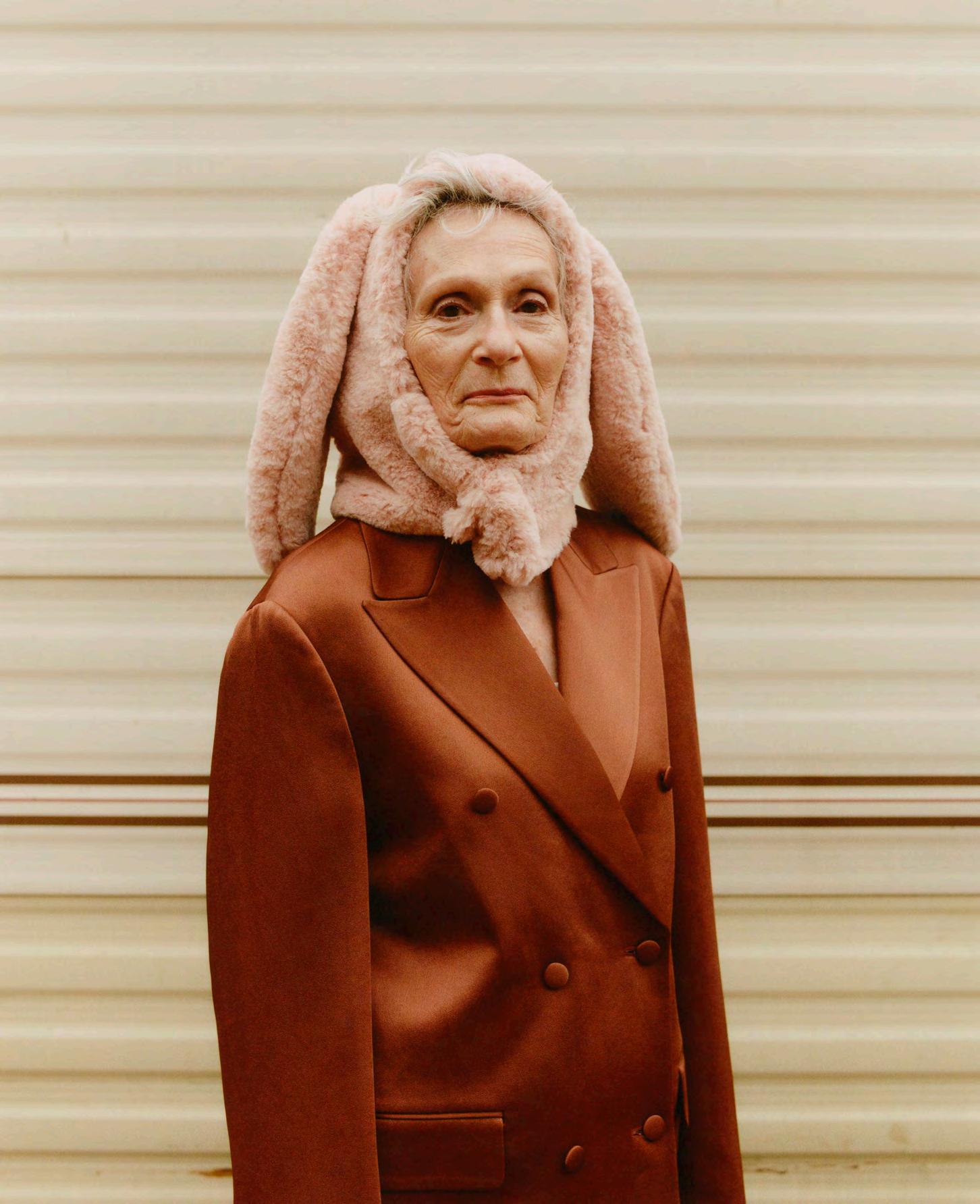

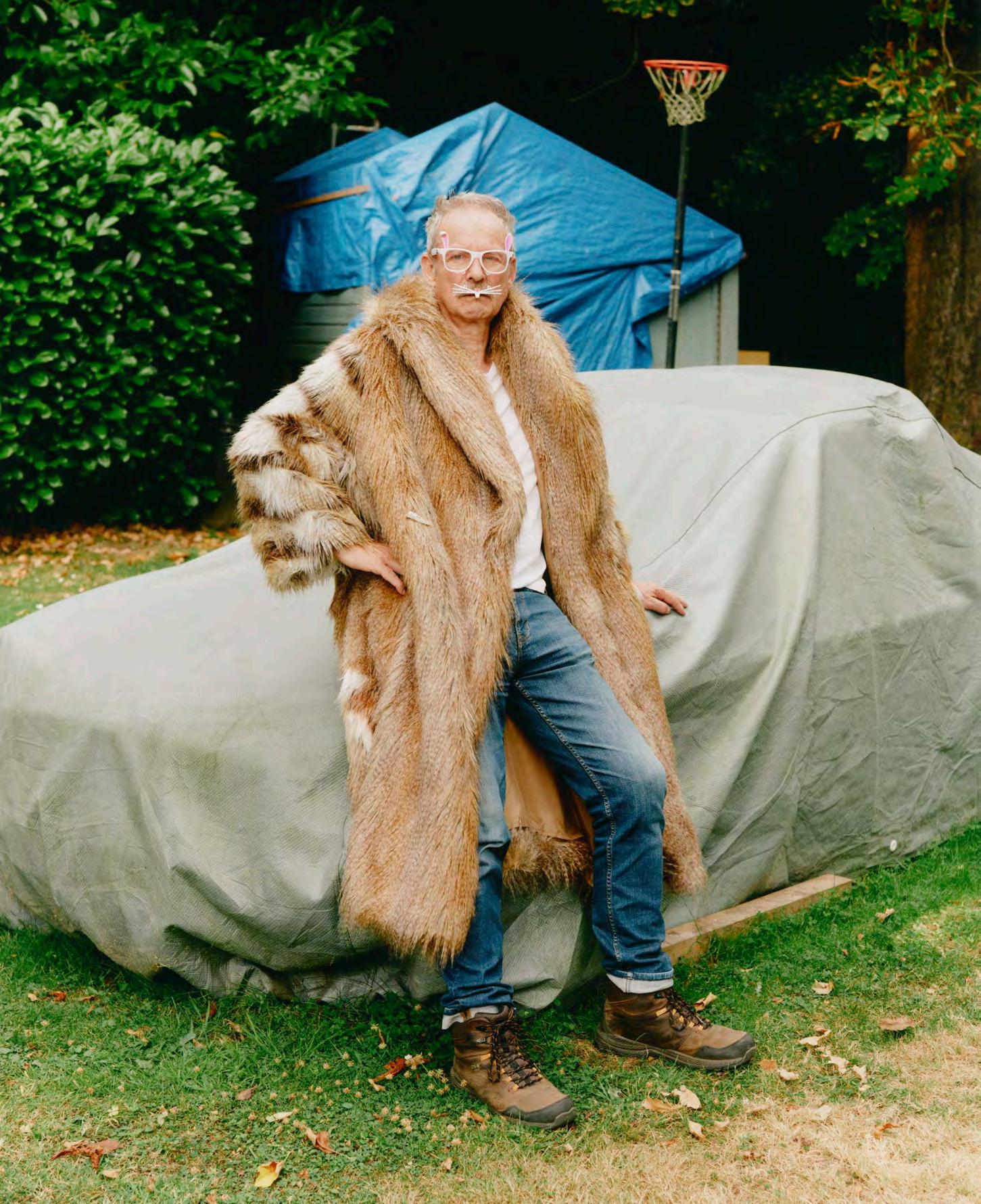

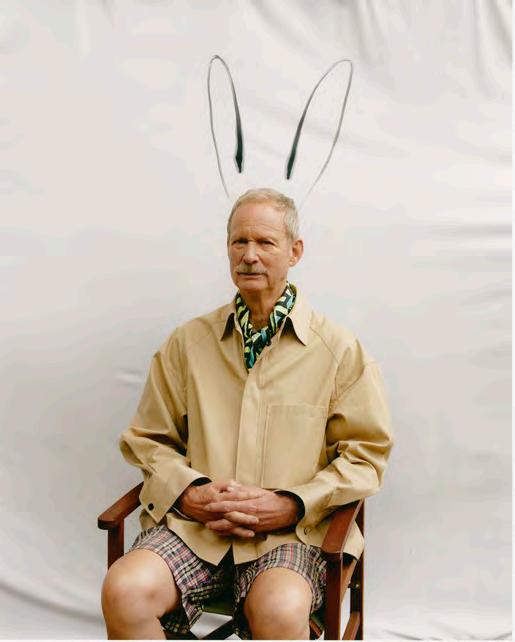
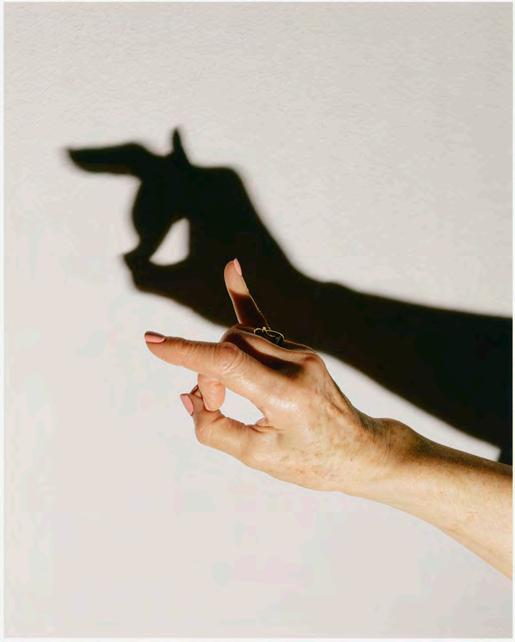
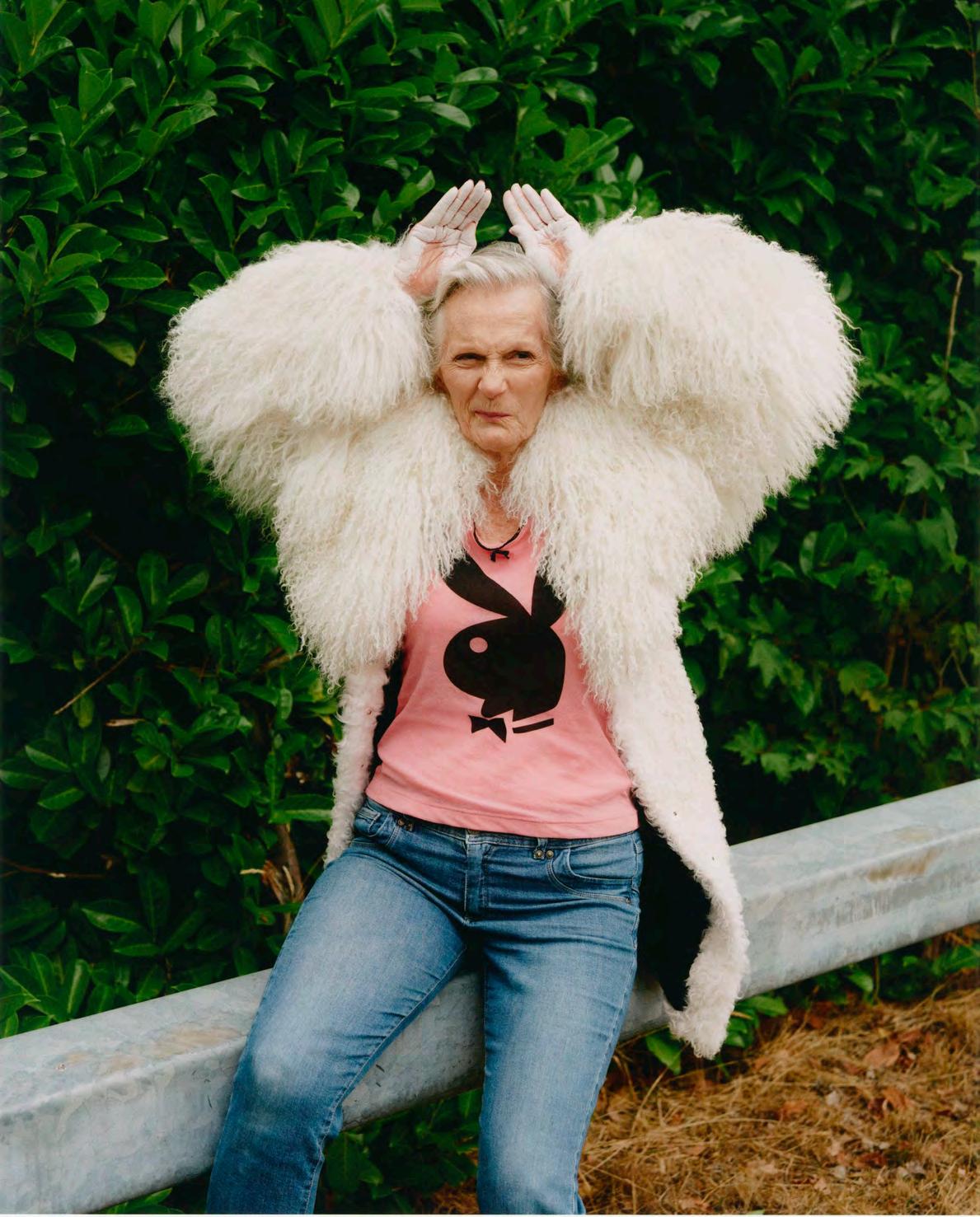
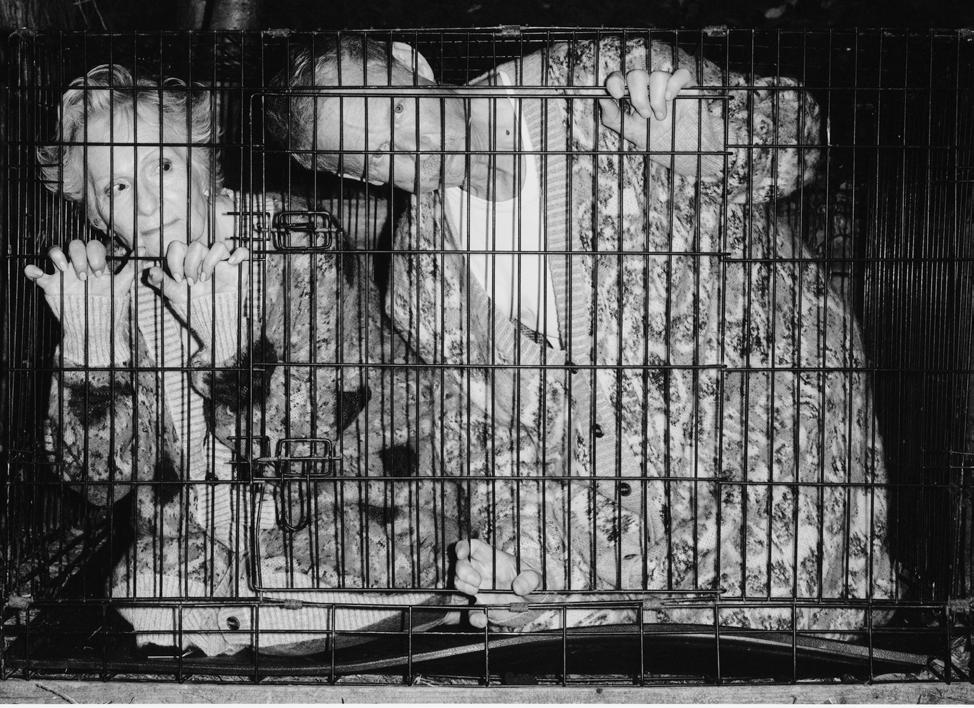

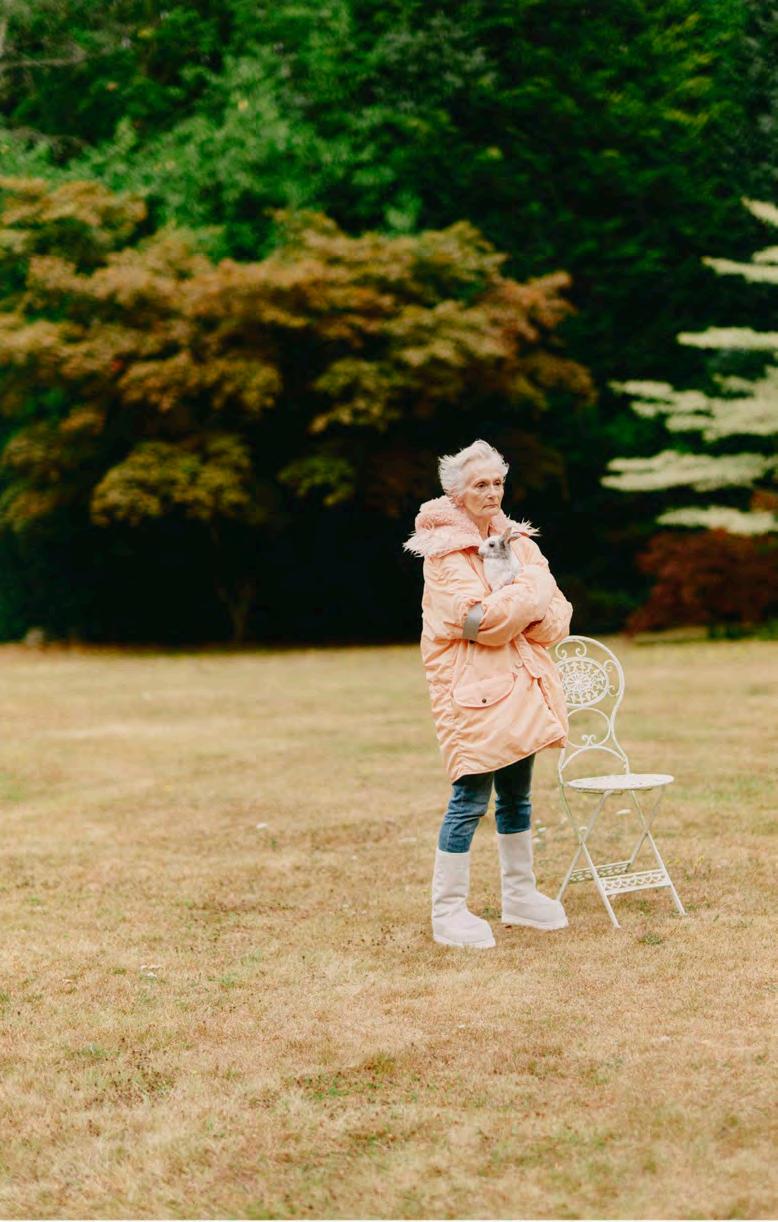
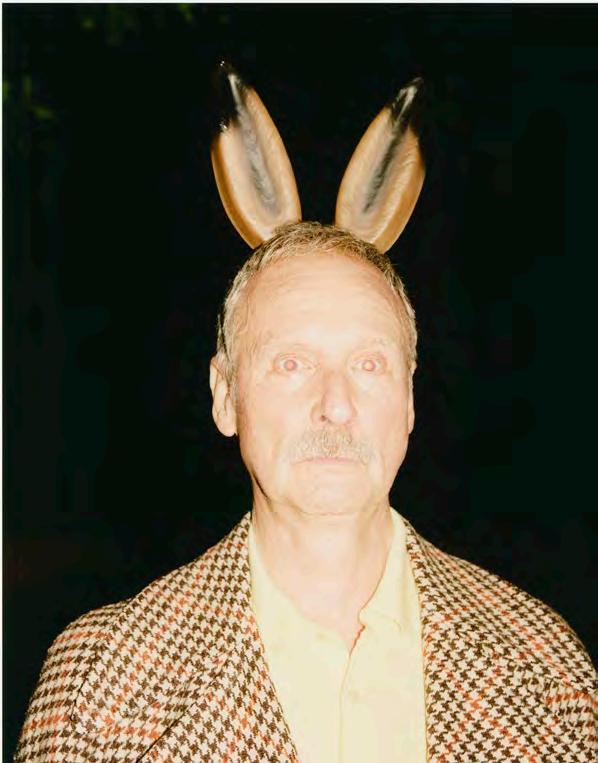
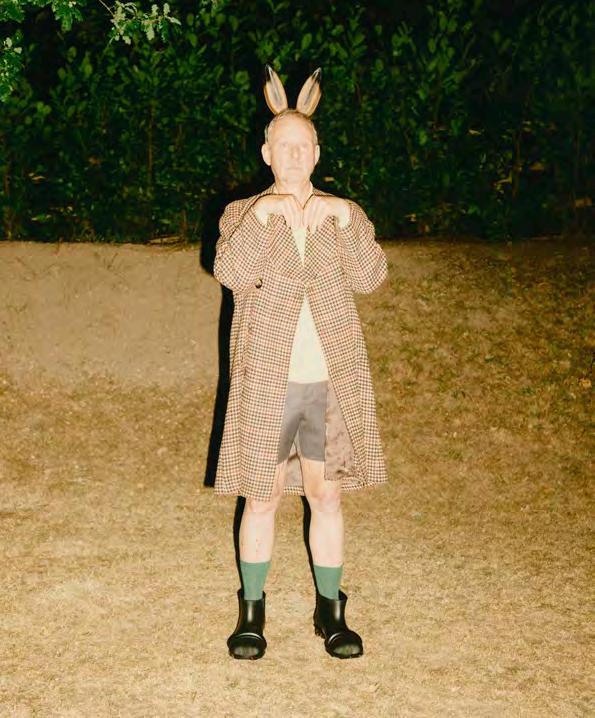



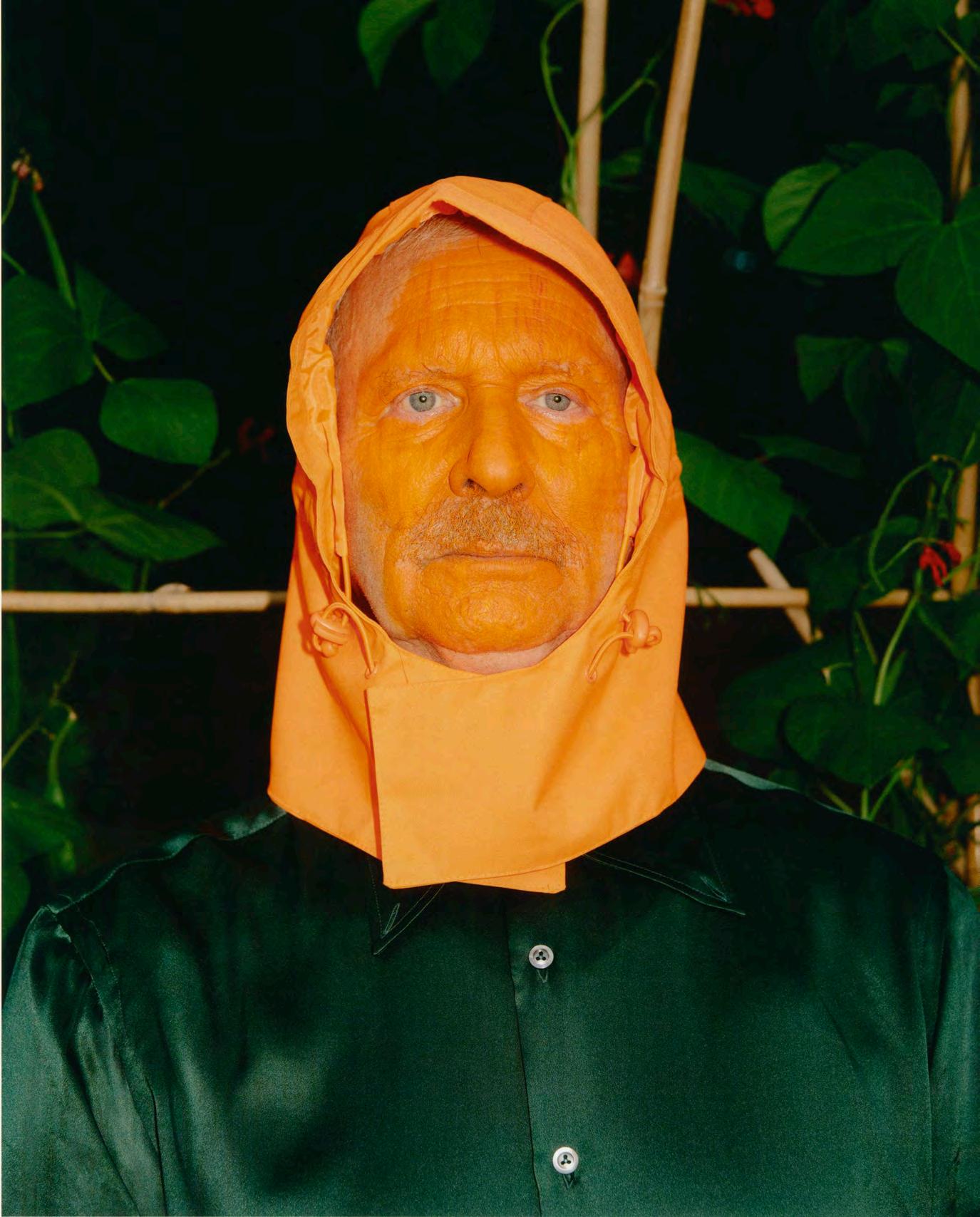
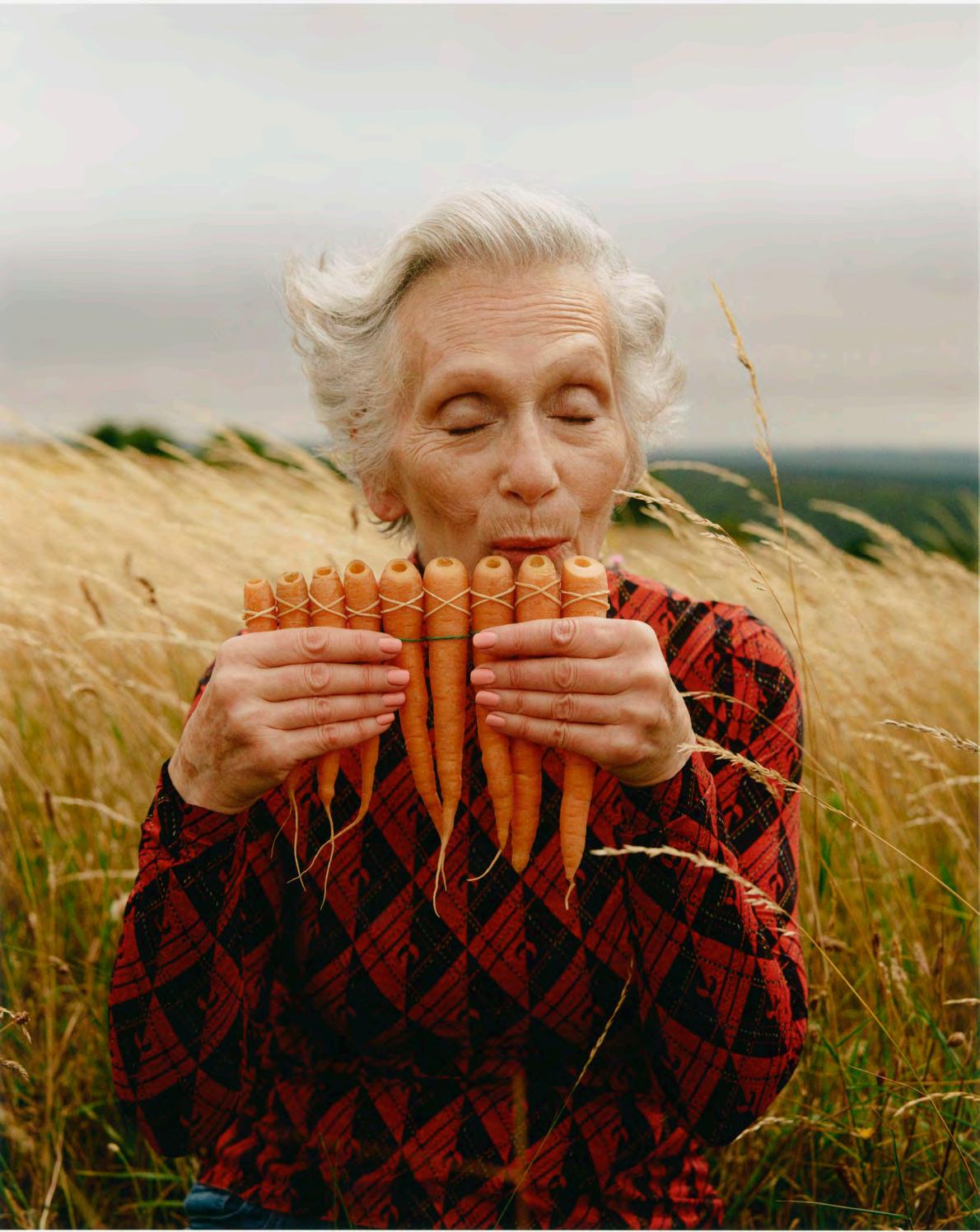

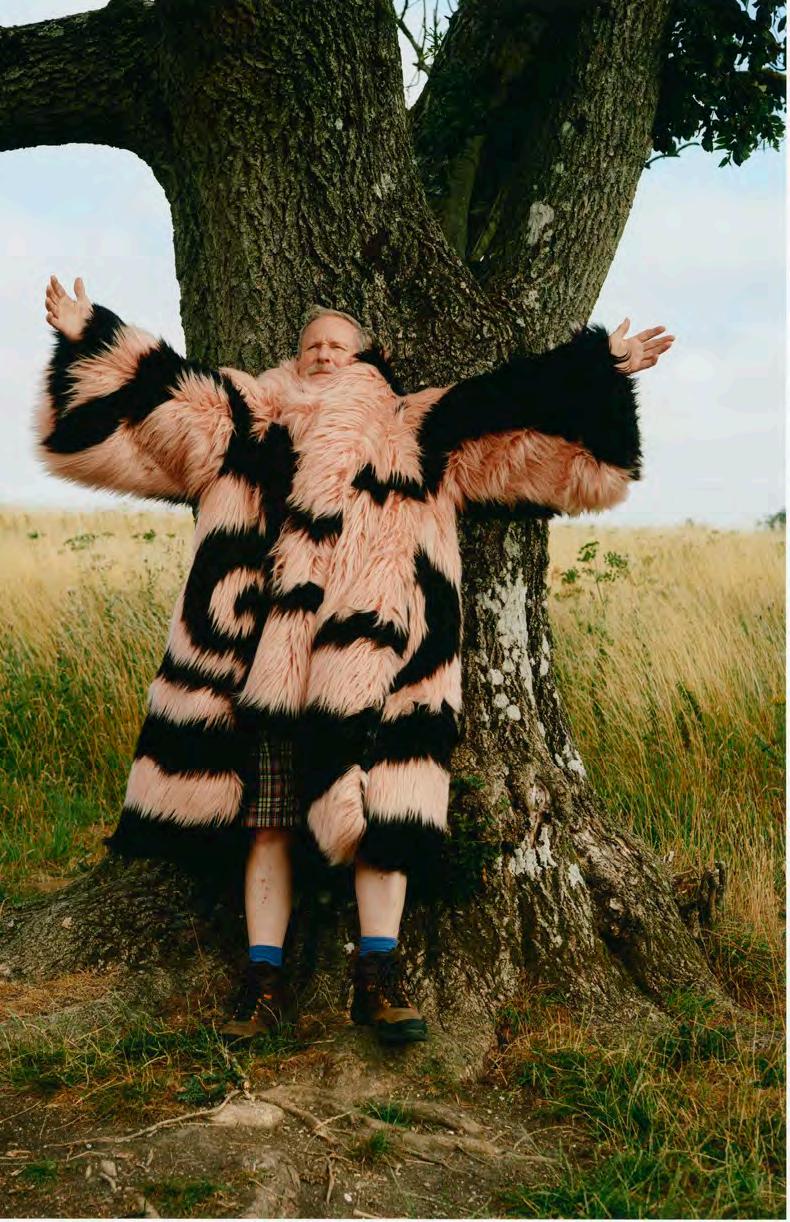

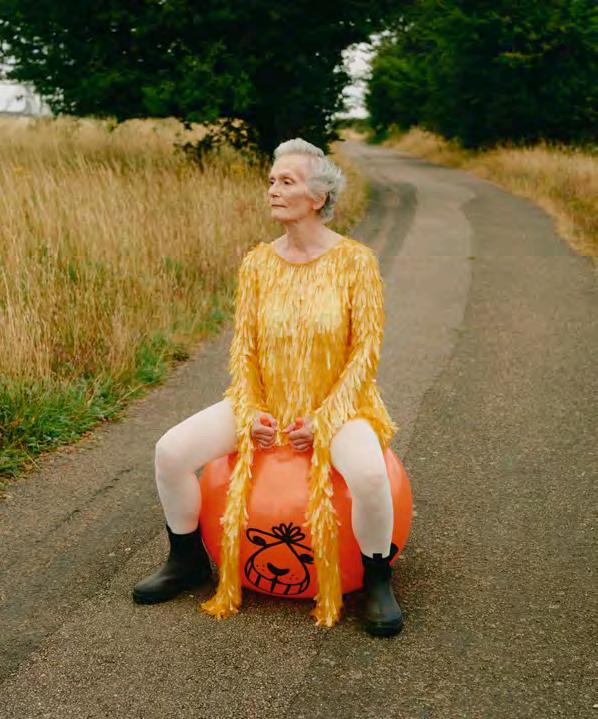
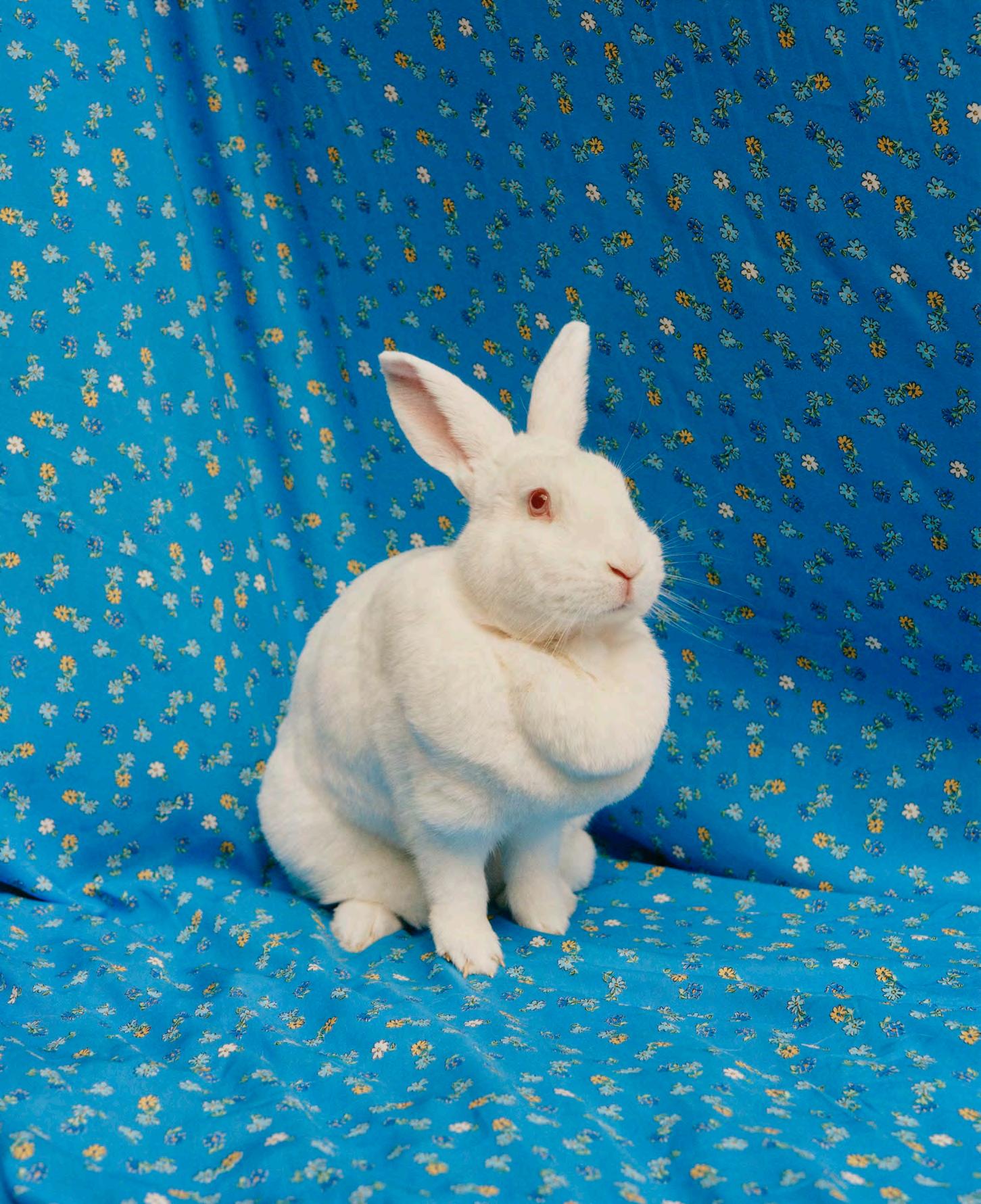
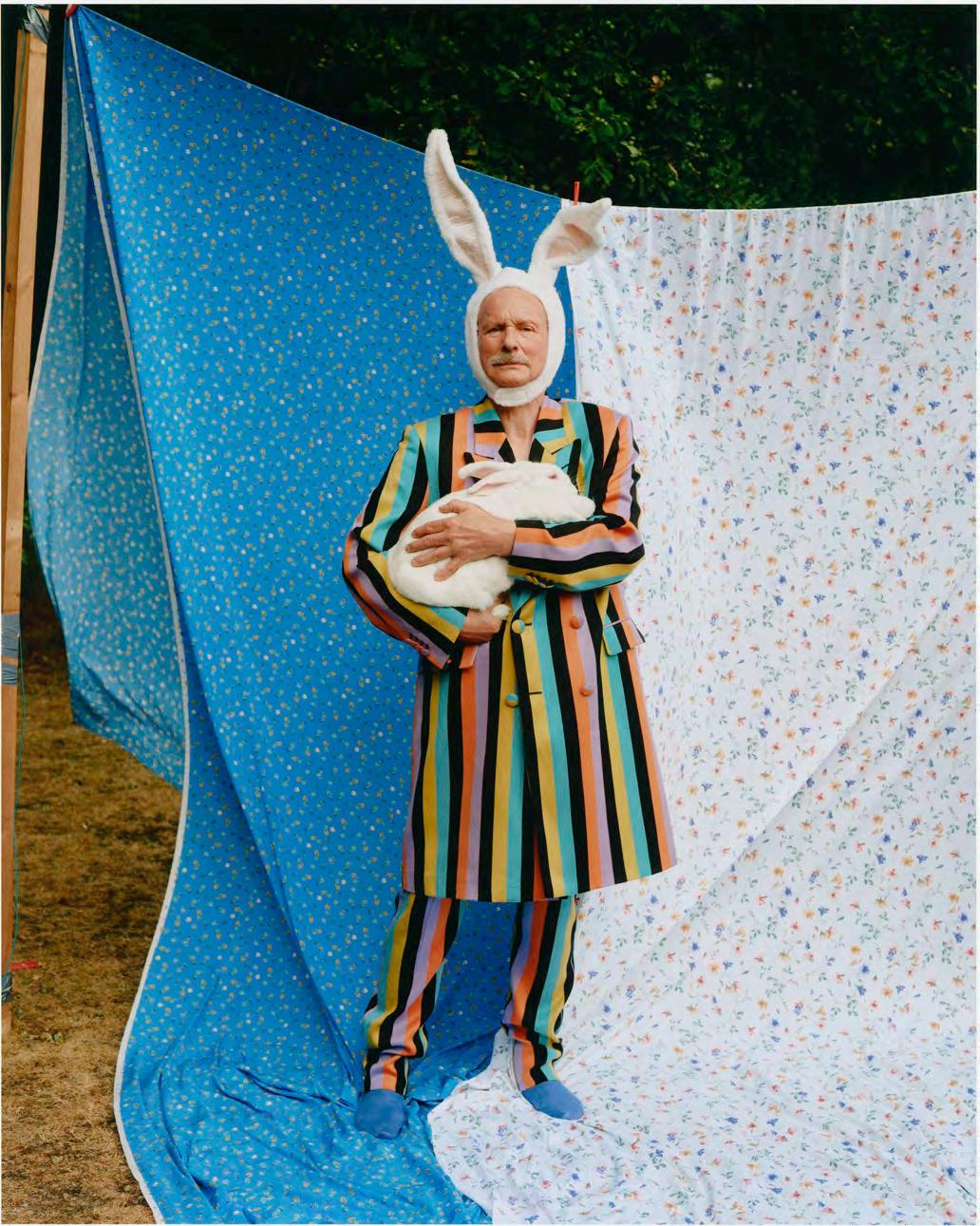


Canadian-born, Berlin-based artist Jeremy Shaw is immersed in the speculative imaginings of altered states and the human mind’s uncanny ability to reach outside of its perceived reality. Transcendental experiences are psychedelically, spiritually, and technologically induced. His films burn bright like solar quasars of the unconscious and cross the thresholds of past, present, and future. Inspired by neuroscience, dance, and subcultures, Shaw’s psychological odysseys are a hallucinogenic dissection of the human experience through quantum leaps of time and space. Including short films, installation, film projections, and Kirlian photography—a technique used to capture electrical discharges, Shaw’s works are like lucid dreams that pierce the liquid mirror of our physical world and into a realm beyond language. They are an attempt to materialize the unmaterializable, to pry open what Aldous Huxley called “the doors of perception.” But what is beyond these doors in the post-human age?


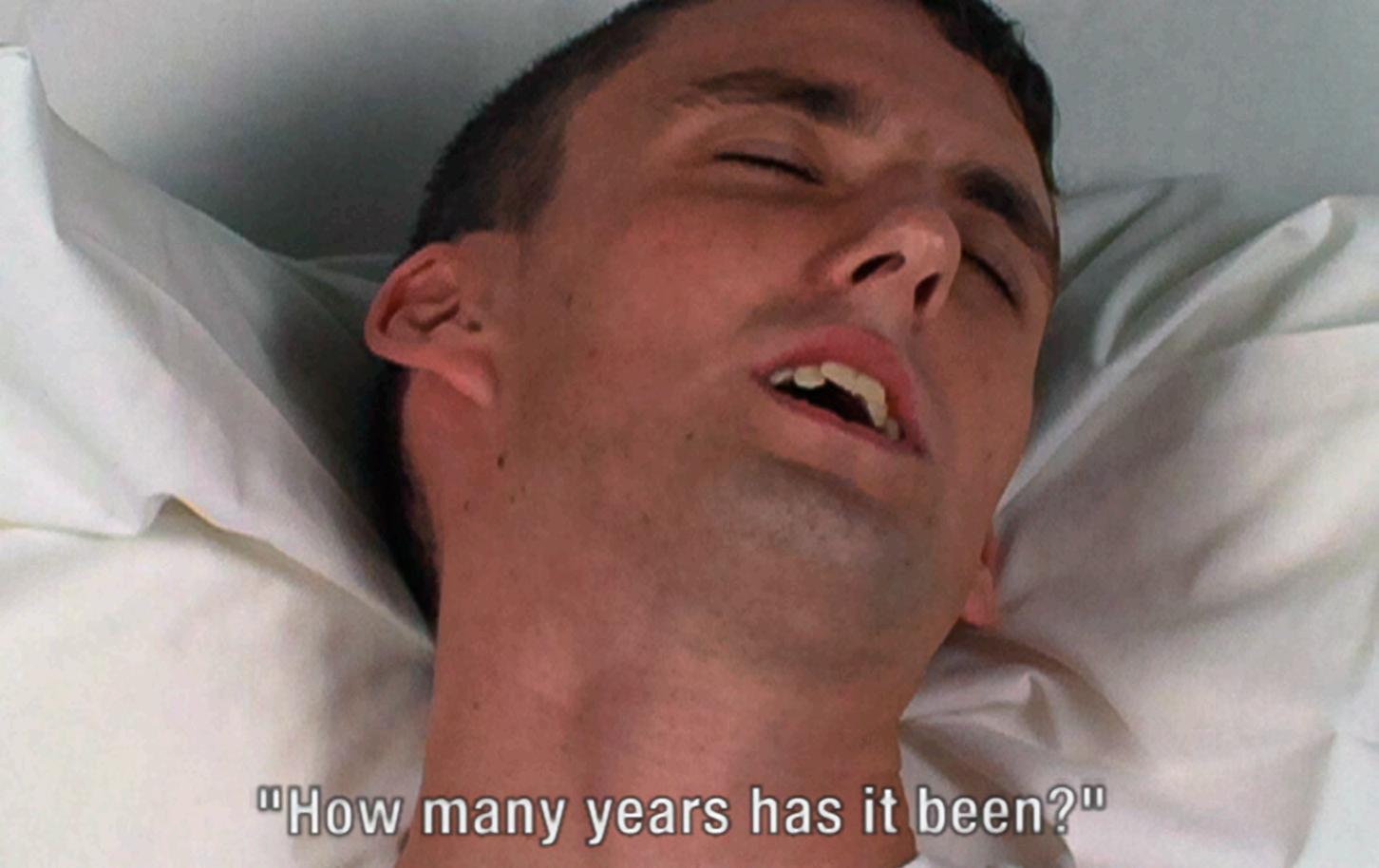
OLIVER KUPPER Much of your creative exploration has to do with altered states, or an escape from our perceived reality, which a lot of people are trying to do right now because of how horrifying our world is. Can you talk about your first experiments with altered states and hallucinogens?
JEREMY SHAW It goes way back with me. I was raised Catholic, which is very decadent and ceremonial with its notion of an earned transcendence through the committed ritual of it all: learning in Sunday school about Moses, the burning bush, and all the effects associated with these great ‘seeing God’ experiences. But I don't remember having an explicitly ecstatic spiritual experience myself, short of feeling a bit tingly and warm after my confirmation, which was quite late in the game, so it could have been a number of things. I was always enamored with the idea of religious visions, but sadly never caught the spirit that way. In those days, when I was probably seven or eight, I used to play a game with my friends where we would hyperventilate, grab each other from behind, choke each other, pass out for a few seconds, and then come back really dazed from this fainty-hazy dream world. That was definitely an early gateway into self-induced altered states. Experimenting with drugs came next. I took acid when I was fourteen, and that was my first truly mind-blowing moment. It really was a lifechanging experience, regardless of the fact that it took place on a pretty average teenage evening in suburban Vancouver. But I mean, it was as fantastic as it gets and I guess these things do often happen in mundane environments, even the biblical ones. It was instantly like revisiting the sense of wonder you have as a child—that total enchantment with the world, with every tiny detail.
KUPPER Once you unlock that, you don't really want to go back.
SHAW Yeah absolutely, and yet I don’t think it ever happened quite like that again until I took DMT, many years later—although I certainly tried. I figure there are only so many times you can truly have your mind blown.
KUPPER When did these manipulations of consciousness begin to take a musical or artistic framework?
SHAW That's an interesting question, because I was always making art, painting, doing graffiti, playing guitar, but I wouldn't say it was psychedelic, or even aspiring to be. Psychedelia was a canonized, referential thing in my youth. I’m thinking of paisley shirts, blacklight posters and Yellow Submarine. The associations were almost silly a lot of the time. Musically, we were making pretty trippy stuff already in the early Circlesquare days, but more in an ethereal, shoegazey way—it was familiar somehow. But around 2001, when I shot the first part of the DMT work, was when I explicitly addressed this notion of ‘the psychedelic’—in both an experiential and conceptual way. From 2004 to 2012, I made a lot of visual work about psychedelics, or about transcendental experiences, but from a conceptual viewpoint—it was about this experience and its mechanisms, but I wasn’t attempting to illicit it. I became very interested in a universal notion of
transcendence and the multitude of ways that people go about attempting to achieve it, as well the endless subjective ways people interpret and define it. Also during this time, I got quite into the scientific aspirations to explain these experiences, to quantify them, to map them somehow in the brain. This became the core of what I was dealing with as an artist. But again, this was me discussing it from a somewhat calculated distance. It wouldn’t be until later that I attempted to incite the experience, or at least to engineer a phenomenological response to the work as well.
KUPPER I want to talk a little bit about the DMT piece, because it seems like your first anthropological, documentarian, scientific observation of the transcendental experience. How did DMT come about?
SHAW It came from hearing about this drug for many years that was said to be the be-all, endall of psychedelic experiences. I had friends who had taken it and referred to it as the paint splatter feeling, like you’ve transformed into a bucket of paint being thrown in the air or against a wall. I purposely hadn’t read much about it at the time like I would go on to do later—like [Terence] McKenna. I was given a book called DMT: The Spirit Molecule and read a bit of it, but found it so dry that I abandoned it less than halfway through. I often don’t want too much information before doing a project. I was mostly going on friends’ testimonials, which had me very curious, because I thought that my romance with drugs had pretty much ended by then. I didn’t expect to learn much more. And so my initial thought was, well if this drugreallydoesliveuptotheexpectationsI’vegot forit,whatwillmybodybedoingwhilemymindis having this completely other worldly experience?
And that was the genesis—a curiosity about the connection or disconnection between the mental and the corporeal, amongst many other things, but those were the formal parameters that sparked the work. I took it alone the first time and it was the most full-throttle drug experience of my life. Truly mind-blowing and practically indescribable— exactly as I had been told. The second I started to feel myself coming down, I started attempting to recount the experience to the camera, which I then transcribed and overlaid as subtitles on the video of me high. There are many different temporalities at play, because you’re watching a recording of me on the drug in real time while reading these posttrip recollections, which become a kind of textbased version of the psychedelic experience. I’m attempting to elucidate these extremely abstract and fantastic psychedelic visions, but you're being presented with super inarticulate Helvetica text over a talking-head frame of my face looking like I’m having a really intense dream, or masturbating. So after shooting that and learning more and more about the drug and the apparent similarities in people’s experiences, I decided to turn the work into more of a survey, which is when I shot around thirty different people all under the same parameters: take the drug and the second it starts wearing off, start trying to recollect the experience to the camera. It’s a very formative work for me—it encapsulates a lot of what I continue to address to this day: exploring this inherent desire to transcend
your present reality, but the inability to translate the profundity of that into everyday language. And also a real urge to explore and combine both affect and analysis. I think I’ve strayed there a bit, but it’s definitely what led me into areas of neuroscience where real empirical research is going on around similar things—even though it’s in an early, but also incredibly altruistic phase. Neuroscientists are so committed, it’s amazing. There is so much more faith involved in science than you expect, until you see what they are going through.
KUPPER Speaking of faith, I want to go back a little bit to your religious upbringing. Can you talk a little bit about how that affected your work and how you excommunicated yourself from that world?
SHAW It's funny, this comes up a lot. I think I must give the impression that I was raised in some really hardcore, puritanical, Christian family, but I wasn't. I mean, we went to church every Sunday, we said grace before meals.
KUPPER That is, in and of itself, a pretty intense indoctrination.
SHAW I actually had to go to catechism on Thursdays as well, until 8th grade, so I guess you're right, it does seem pretty intense under contemporary parameters. And Catholic guilt—let me tell you, it’s a real thing. It’s something that gets so deep into your psyche—via the sermons, and Sunday school, and having to do confession. The guilt was so insidious that I used to lie about my sins in confession, or just detail really minor things that weren’t nearly as bad as the actual ones that I wouldn’t report. It’s quite twisted. I had pretty much abandoned all of it by the time I was a teenager, though. The nail in the coffin was when I went on a trip with my class to Italy in 11th grade, and we visited the Vatican. I have this very vivid memory of stepping in there and seeing the absolute excess and decadence, and having flashbacks to my mom placing at least twenty dollars in the donation hat that is passed around in the church each week. A kind of donation/public-shaming ritual. There were definitely times when we were not in the position to be giving away money, so this grotesque display of wealth in Rome really got to me. I had had it with the hypocrisy of the church, but I think I was still drawn to the ritual, the community, the mystery of Catholicism. There’s something in all of that that will always be instilled in me. I loved dressing up and going to mass, I loved the incense and the costumes. I love to see people believing in something and surely that was sparked by my experience with the church. I’m a big fan of belief, but maybe more of other people's than my own.
KUPPER There's something about subcultures being their own communal experience, and I think that your work explores a lot of what it means to have a belief system shift away from the belief system you grew up in. Do you remember when that shift happened?
SHAW I think it started to happen quite young. I've always been somewhat skeptical in my belief, even from those early religious days. I wanted to believe, you know? But I’m gay, so right from the start there was a paradox in who I was meant to be for the church and of who I truly knew that I was, even if it was before I was fully conscious of
this part of myself. But, when I was on the verge of being a teenager, there was a deep questioning, not only of the theology and monotheism of Christianity itself, but also of the internal politics, and mechanisms, and the wicked world around it. The bizarrely archaic hierarchy of untouchable men in control that take your family’s money and abuse children. That was all rattling around in my head and not adding up. I remember clearly the night when Sinéad O’Connor tore up that picture of the pope on SNL. I can’t say I fully understood her motives at the time, but I felt her anger and frustration with the church. I got that she wanted to be a member of this community but was upset with what was going on within it and I felt aligned
the time things were so much more regimented.
So, I would go to hardcore shows, even though I wasn't “true till death,” but because I liked the music, and loved the energy, and dancing. Best Minds was actually shot in a community center in North Vancouver right beside the skatepark
I grew up in and where I’d been to many shows back in the day. Back then, the style of dancing was different in every city, even from suburb to suburb. Often, you would have to go to other suburbs for shows, or maybe even down to Seattle, and kids would get hostile about how you were supposed to dance. Vancouver had really gone for this martial arts element that had evolved in the dancing, with all these roundhouse and jump kicks
watching them get out of their day-to-day and their mind. The way people physically interpret sound.
with that. Funny how many people agree with Sinead in hindsight, though.
KUPPER It’s interesting to think about who the Catholic Church considered heretics. Then later, people realizing those heretics were actually right. Sinéad is a good example. Or in Scotland, they are trying to pardon thousands of witches who were sentenced to death, burned alive. But back then, a lot of these alternative believe systems were just pagan modes of medicine or healing—mainly women who lived in an exclusionary patriarchal world where they couldn't even talk in their own homes, so they communed in the forest at night, built fires, and created their own community, which is essentially a subculture.
SHAW I mean, absolutely. It’s similar to groups practicing alternate lifestyles or ideologies that are deemed cults. What makes something a cult? Numbers, really. Any organized religion could be defined as a cult—it’s just the scale that somehow alleviates the negative connotation.
KUPPER Speaking of subcultures, I want to talk about your piece, Best Minds, which explores straight edge culture. The soundtrack is inspired by William Basinski’s Disintegration Loops, which was completed and made right around the time of 9/11, so there seems to be all these overtones of this post 9/11 world in Best Minds, this strange new form of puritanical, sometimes toxic masculinity that infiltrates these cultures, which leads to where we are now with the rise of school shootings and violence. Can you talk a little bit about Best Minds?
SHAW That piece came about because I started getting into straight edge shows again. I used to go to hardcore shows as a teenager, but I was never straight edge, by any means. I was quite atypical in the ‘90s in that I was really interested in all sorts of different music. I was a skateboarder at the core and therefore hardcore was okay, but I would also go to raves, which was a total no-no. As a skateboarder in the ‘90s, that was off limits because “ravers suck.” I was also super into hip hop in high school, but also punk and goth and early house/techno, which seems so normal now but at
directly in the pit that were insane. Straight edge hardcore is sort of the antithesis of the usual youth subculture, if you can even use that term anymore. It's an almost unmarketable rebellion, because it's uncool to be puritanical, or abstinent—it goes against the entire model of the teenager, really. And that's what's remarkable about it—when I went back to shoot that footage in 2005, the scene was just as insular as it had been in the mid ‘90s. It had never become mainstream. They sell their own records, they do their own shows in youth centers during the day—they love to preach their superior lifestyle, but they’re not really looking for converts. But it was the dancing that I was still most enamored with, so I wanted to somehow document the way that these guys danced to this incredibly cathartic level without drugs, without drinking, purely on the music, and teen angst, and testosterone, or whatever else they had to spare. Of course, I intervene in the situation by shooting on old cameras, slowing the footage down and magnifying or amplifying the almost balletic nature of it, projecting it on two huge, freestanding walls with the viewer in between, and adding this kind of sea-sick nostalgic ambient soundtrack.
But yes, in terms of the overload of masculinity and borderline fascist attitude of the subculture, it was still absolutely there in 2005. I've heard that in recent years there are a lot more girls at the shows and a lot more girls in the pit, but there were still very few back then. I actually revisited the whole thing again in 2020 when I made my PhaseShifting Index piece for the Pompidou. It’s a seven-channel installation comprised of seven films about fictional subcultural groups, and one of them is an all-female group who appear to be part of a mid/late ‘90s, hardcore scene and dance in a way very similar to the hyper aggro manner of the boys in Best Minds
KUPPER The way their bodies move is almost virtuosic. Were you always interested in dance and the way bodies move?
SHAW I was always into dance. I have no training or background in it, but I've always been totally compelled by watching people move,
I have always loved seeing people either totally freaking out or getting so dialed with control that it's a similar thing, trancing out through control, virtuosity. Dance is one of the primary ways of achieving these states I’ve followed—drugs, prayer, dance, meditation, they’re so often the basis for achieving this type of experience. When I look at the works I’ve made in the past fifteen years, dance is really my go-to. But I have a very limited, theoretical understanding of it. I seem to have consciously avoided this—it’s a part of my practice that remains intuitive, somehow. I don’t really have any desire to be able to talk too much about it in this way, or about why exactly it moves me. I think for fear of somehow having too much critical discourse around why I shouldn’t like something, do you know what I mean? Something about learning too much feels like it would taint my love of, or response to it, like how that can interfere with my reading of art or music at times, so I chose to remain naive. I can talk about music, or art, or drugs, or skateboarding for days, but with dance, I really only know what moves me from my gut.
KUPPER Language is a crucial part of your explorations, especially in the Quantification Trilogy. I don't know if you've read The Origin of Consciousness in the Breakdown of the Bicameral Mind (1976) by psychologist Julian Jaynes—it's a controversial book that explores consciousness as this very new phenomena— not an ancient one. Up until very recently, our brains operated as two separate spheres—one was much more psychedelic and communicated via verbal hallucinations, like a daily schizophrenic experience. There’s a quote from the book that I think pertains to your work: “Language is an organ of perceptions not simply a means of communication.” Can you talk a little bit about your use of language, or the uselessness of language as a tool to describe our reality.
SHAW My interest in language as our main, fraught mode of translation was definitely sparked during those DMT sessions when I was listening to thirty different people “um” and “ah” and “do you know what I mean?” their way through their attempted description of these minutesprior psychedelic experiences. The limits to our language in describing profound experiences became so apparent, people were stumbling over every second word, grasping to make connections to sci-fi movies and animations as a way to relay the information. But not just with psychedelic experiences—in many extreme situations you can find yourself at a loss for words, even with love. So that started it, but in a very organic way, whereas I really began manipulating it myself with the Quantification Trilogy because altering the language was a means to an end from the start. The first one of the films, Quickeners, reworks archival footage of a Pentecostal, Christian, snake-handling church from 1967. I wanted to tell my own story using this material, so I needed to figure out a way to alter their language. We attempted many things and finally landed on a style of manipulation that makes it so they appear to be speaking a lip-locked language, but
"Any organized religion could be defined as a cult—it’s just the scale that somehow alleviates the negative connotation."



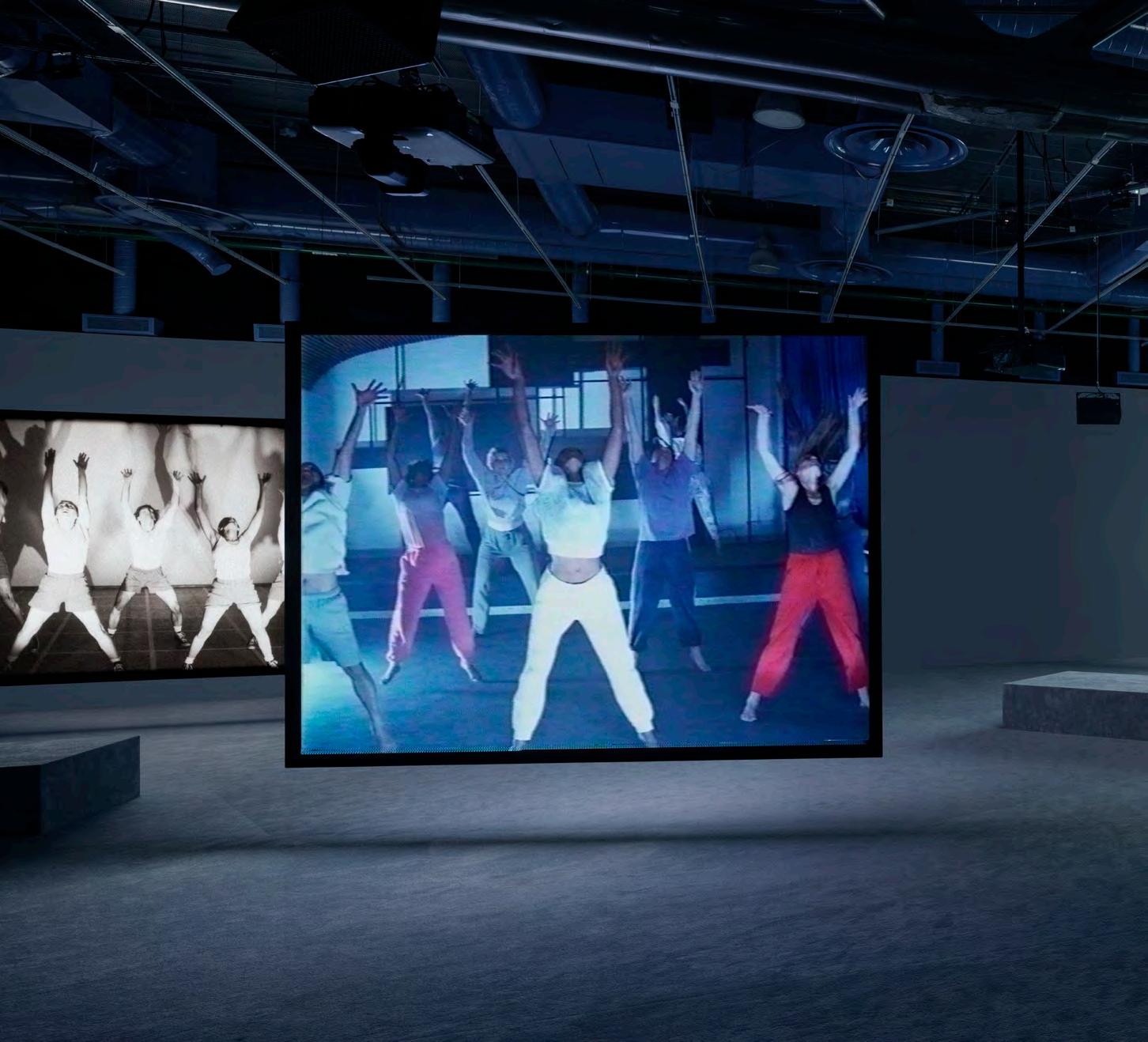


it's become an indecipherable foreign tongue with only fragments resembling intact English. From there, I was able to subtitle over this to tell the story. So, it was basically English reverseengineered into gibberish and then translated back into English. The dissonance this created with the viewers of that film was really strong, people were super confused and frustrated by being on the edge of comprehension, but not. I found the effect so engaging that I continued this strategy in the subsequent films of the Trilogy, Liminals and I Can See Forever, but with a lot more control because I was actually able to work with actors in advance and have them say things within the parameters of what I wanted to be said. So, the manipulation of the language became even closer and, as a result, even more confusing. It creates this constant negotiation between the language spoken and written and I think furthers the thread that was started in DMT but in a more manipulative, or even less autonomous way—this struggle to elucidate what we're feeling or have experienced, and the trouble truly understanding others descriptions of such insular things, even when they’re in a language we speak. Do you knowwhatImean?No,Iactuallydon't.
KUPPER I wanted to talk a little bit about the proliferation of technology and how it pertains to your work. And also, just about our cyborgian future and how technology has infiltrated our transcendental state.
SHAW A through-line in much of my work the past years has revolved around the question that if science was able to empirically explain what's happening in our brains during a transcendental or spiritual experience, like, if they could tell you that it’s exactly because these specific synapses are firing in a row that you’re seeing god, does that discount the experience? Or does it further enforce it? And not just the blanket neuroscience explanations of these experiences being evolutionary defense mechanisms or a result of psychotic episodes, but like a totally quantified empirical reading across humanity. The whole setup of the Quantification Trilogy is about a scientific breakthrough named “the quantification,” which does exactly that. It proved that every time people have a transcendental spiritual experience, it is an identical set of synapses firing in the brain in the same order, and it's the same in all human beings across the board regardless of denomination, or practice, or spiritual whatever. And as a result of this discovery, humanity has almost entirely abandoned spiritual belief systems and replaced them with a virtual reality device that replicates these ecstatic experiences. Eighty years later, they discover that we have an actual specifically allocated faith area in our brains that had evolved to be biologically necessary for our survival. And now, through its disuse, this area has atrophied to a state of disrepair. Alas, we are set on a course towards extinction. So, that’s what I wonder about quite often: what happens to humanity if faith becomes obsolete? How could technology initiate, or alter, or aid, or detract from this process. I don’t have a clear read on any of this, by any means, but I’m fascinated by the idea. I mean, what really becomes of us if we lose the capacity for faith?
KUPPER It’s super interesting, I think there's a nihilism in not being able to believe in something, in community, in the future.
SHAW Absolutely! How bleak does that sound? Belief is so subjective, of course, and like you were saying earlier, belief systems evolve around all sorts of things until they become your reality, often taking you out of the previous one. So, most likely, our understanding of belief will be transferred into new models, new theologies, new beliefs around technology, or community, maybe animism revivals, or whatever. I mean, it's already happened in many ways and I guess it’s a bit oldfashioned to continue associating faith and belief so closely with spirituality, but that’s going to take some time.
KUPPER How can we apply these sorts of ideas of spirituality, transcendence, and these hallucinogenic experiences into building a better world? Are you optimistic or pessimistic?
SHAW I’m all for the destigmatization and reintroduction of psychedelics for integration into building a better world, or person, or community, or anything, but the fact that they have been instantly marketed as productivity tools is insane. It’s classic—of course, finally psychedelics start to shake decades of ridicule in the sciences and culture, and they are immediately exploited by Silicon Valley to boost your capitalist potential. It seems so cliché. That said, it’s really amazing how much more discourse there is around them in the past ten years or so. I remember hearing Lindsay Lohan talking about doing ayahuasca in some interview, and I was like, ahh, it's really come a long way (laughs). When I made DMT in the early 2000s, procuring the drug was so difficult, it felt almost mythical at times. When I finally found it, enough of it, the guys who gave it to me were so tight with it, and so hesitant for fear of me misusing it, or not treating it with enough respect. Now in Berlin, you get a daily Telegram channel offering you every psychedelic you’ve ever heard of delivered to your door within an hour. But anyways, yes, essentially I’m optimistic about it all, for sure. I think this general swing towards more personally-tailored spiritual and somatic practices, or mindfulness, or wellness, is undoubtedly a positive thing for the world. It needs to be kept in check, just like anything with the potential of spiraling into mania or just becoming total nonsense, but I do undoubtedly see it as a positive thing that people want to take time to question existence, or become more aligned with their time and place.
KUPPER Do you personally believe in a future where we can become more communally cohesive towards a common goal, to not destroy our world?
SHAW I would love to, I do, but I'm skeptical— I’m so noncommittal with this kind of question. I’m better at propositions than answers, somewhere in the alchemy of optimism and fatalism.
KUPPER There's a lot of future thinking in these ideas, which is fascinating and super important, so I'm curious what you're thinking about in the present?
SHAW I reached an apotheosis of this way of thinking with Phase Shifting Index. It’s a culmination of all the strategies I developed in Quantification Trilogy into an immersive,
seven-channel installation with a cross-temporal synchronized climax. This work is a much more positive vision of the future, too. In the previous works, the narrator was speaking to you from the future, implicating you in it temporally, but being very critical of the subjects’ ideologies and cynical towards their quest for human salvation. Whereas with the latest one, Phase Shifting Index, the narrator still implicates you in the future, but he comes from even further ahead in time, and is reporting back to confirm that these groups on screen are the first documented cultures that were able to use movement and belief to physically alter their reality. I think all these works use documentary aesthetics of the past combined with speculative fictional setups in the future, mostly to comment on what we’re faced with today, what's at stake in the present moment. Of course, it all leads to the future, you could say that about anything, about this very sentence, but those future situations I’m depicting have always felt to me to be super steeped in the right now with the questions we are facing: questions about faith, about AI, about evolution, community, isolation, belief systems. So, I guess that’s what I'm thinking about now: what’s going to happen to us in the future.
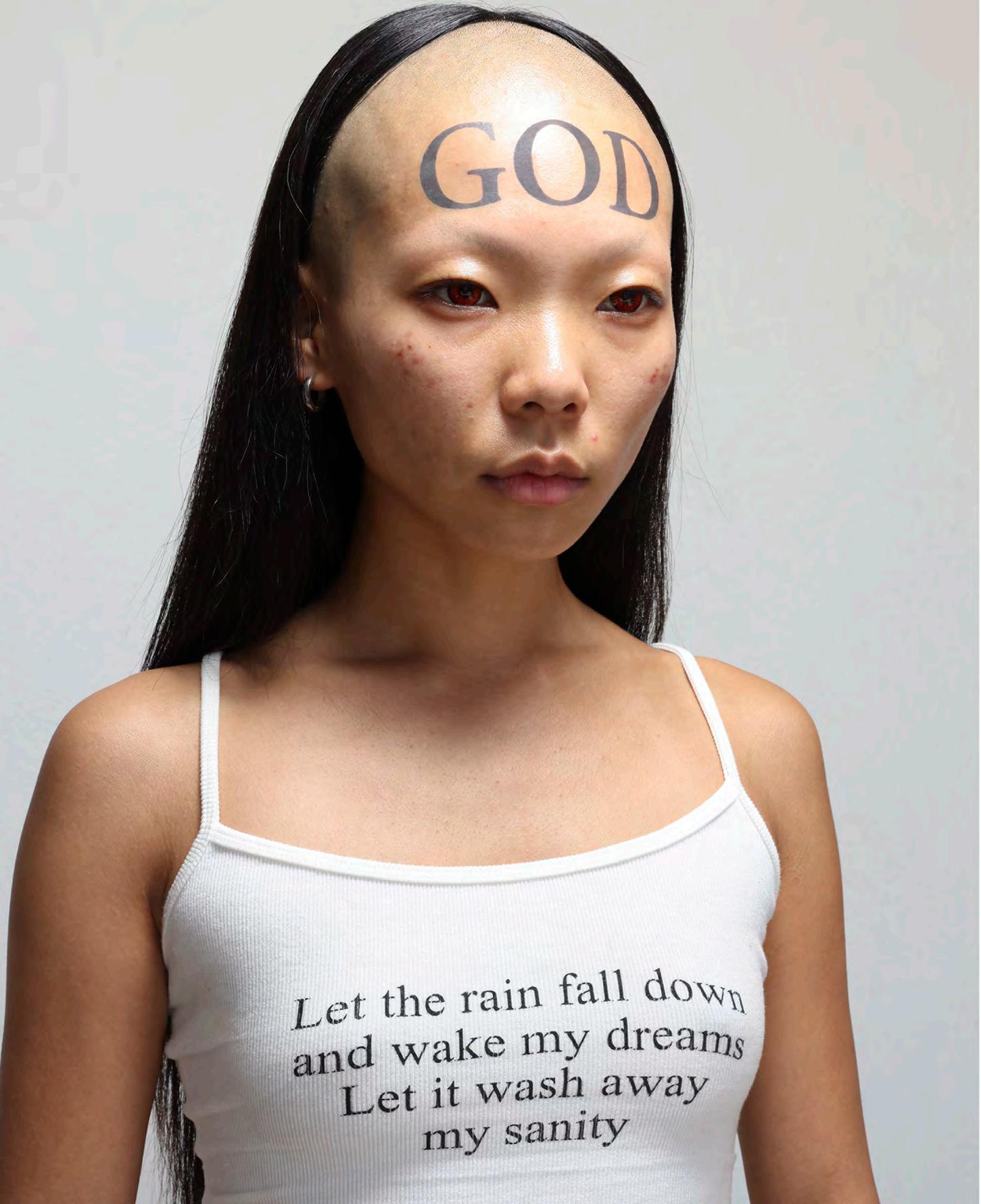
The Y2K Bible-camp-inspired fashion label, Praying, was founded in January of 2020 by Alex Haddad and Skylar Newman. Bored of their corporate office jobs, and conceived in the disaffected miasma of the post-pandemic Great Resignation, Praying offered salvation in irreverent and nihilistic sartorial expression. Their two-piece white bikini emblazoned with the text “Father, Son, Holy Ghost”, which was designed on Instagram Stories, became a sacrilegious staple and spread like wildfire across social media with perfect Gen Z irony. When American girl-next-door TikTok sensation Addison Rae posted a photo of herself in the Holy Trinity bikini—mouth agape with eyes suggestively downcast—to advertise the brand’s collaboration with Adidas, Christian fundamentalists and conservatives were incensed. On its early HTML website, you’ll also find tank tops, shorts, hoodies with similar blasphemous slogans, anti-capitalist symbology, positive affirmations, and their famous purse eulogizing Brad Pitt and Angelina Jolie's relationship (Brangelina 2005-2016). All in all, Praying feels like the cast offs from a rejected Bush-era Target back-to-school collection found after the ruins of a tornado decimated a trailer park where everyone already died from a fentanyl overdose. There is something for everybody, and nobody, because nothing matters and no one will answer your prayers.


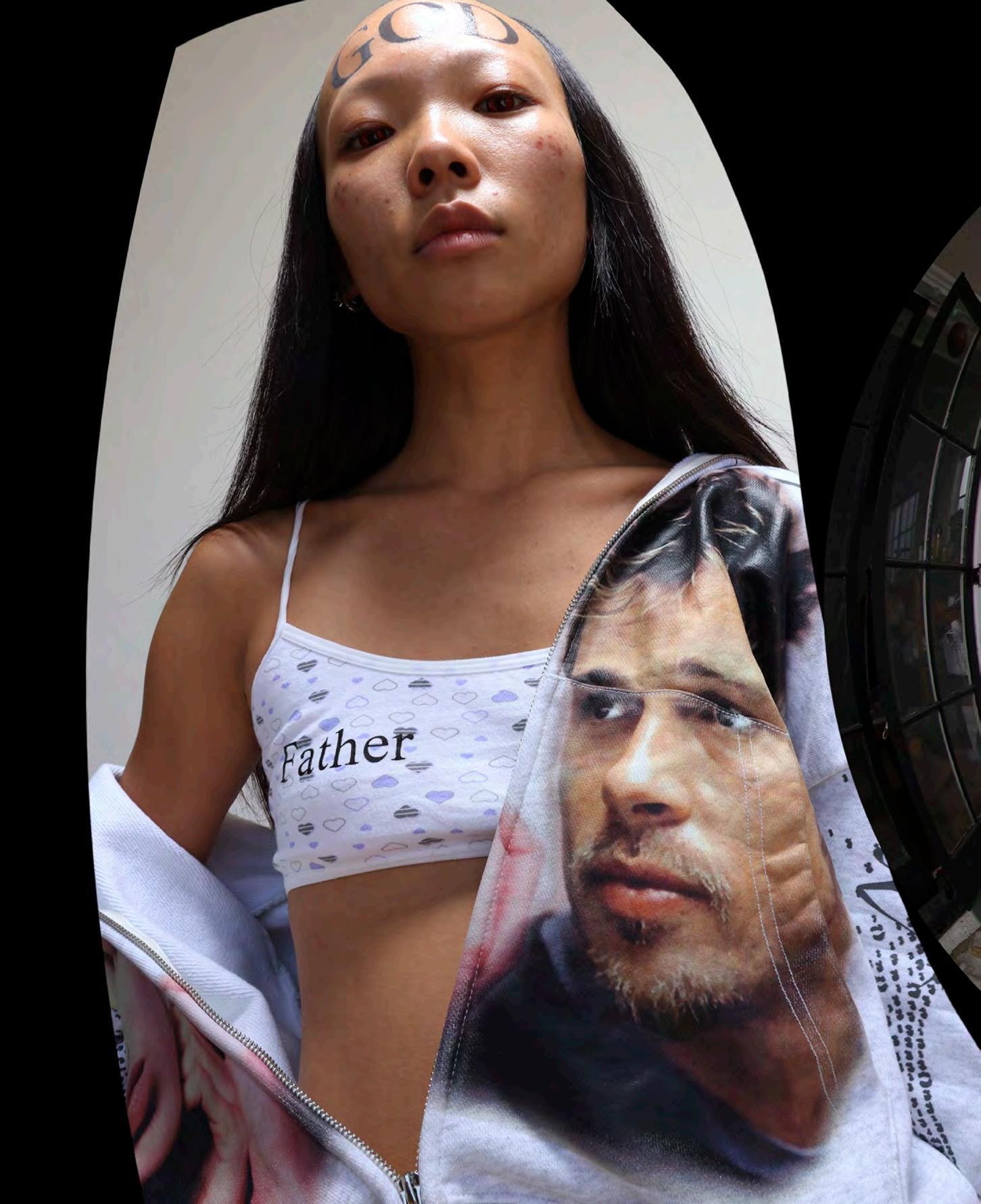

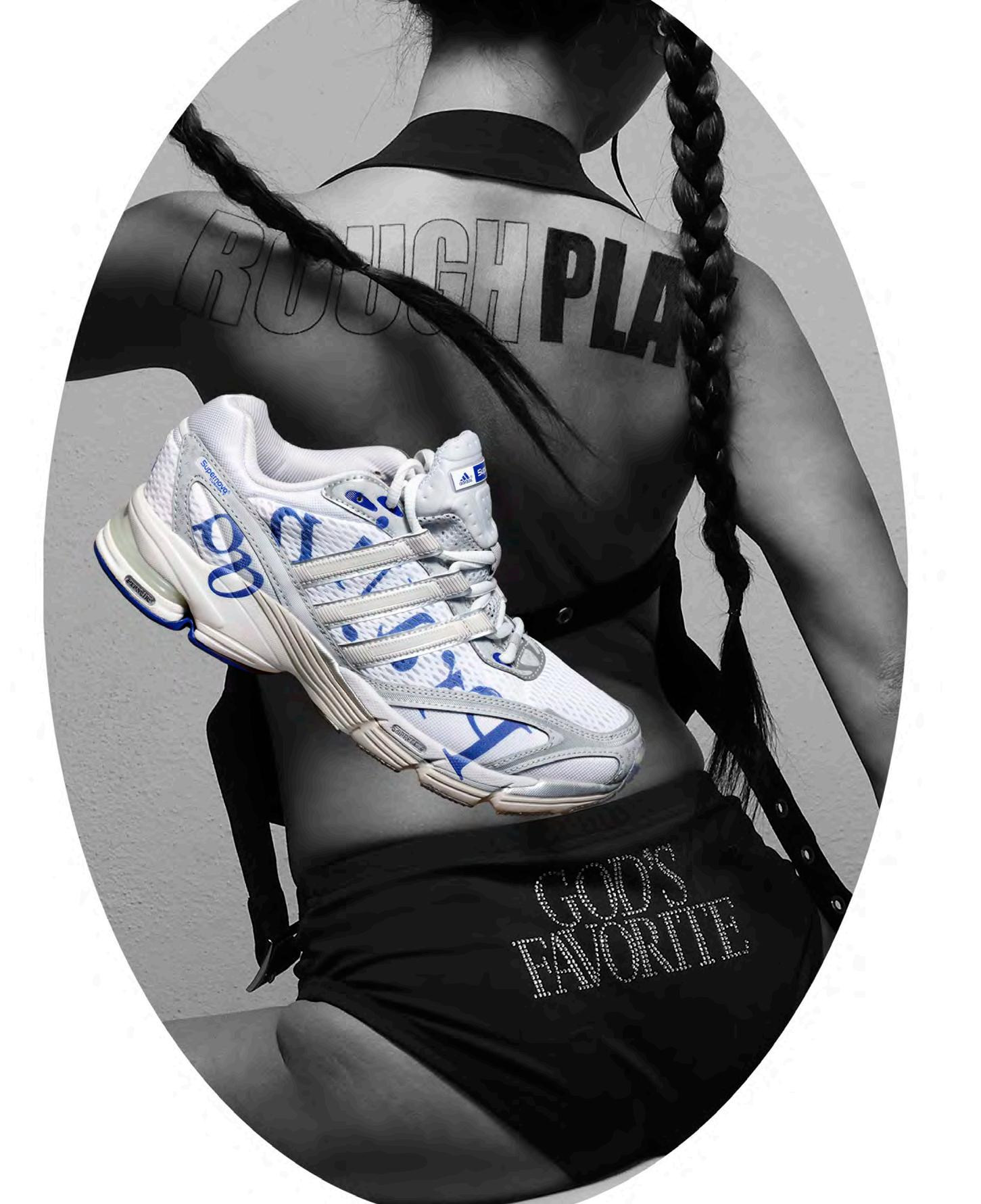

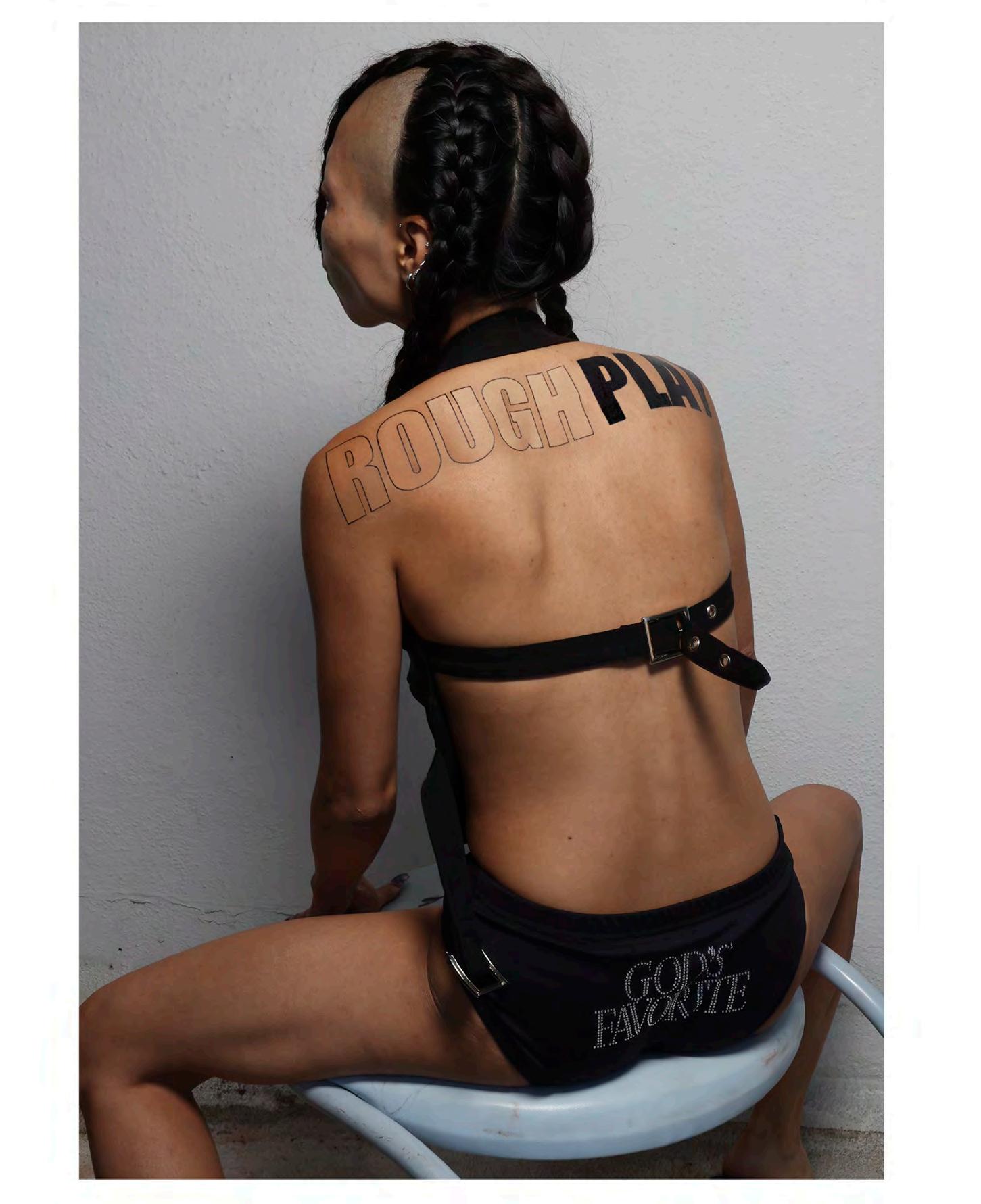
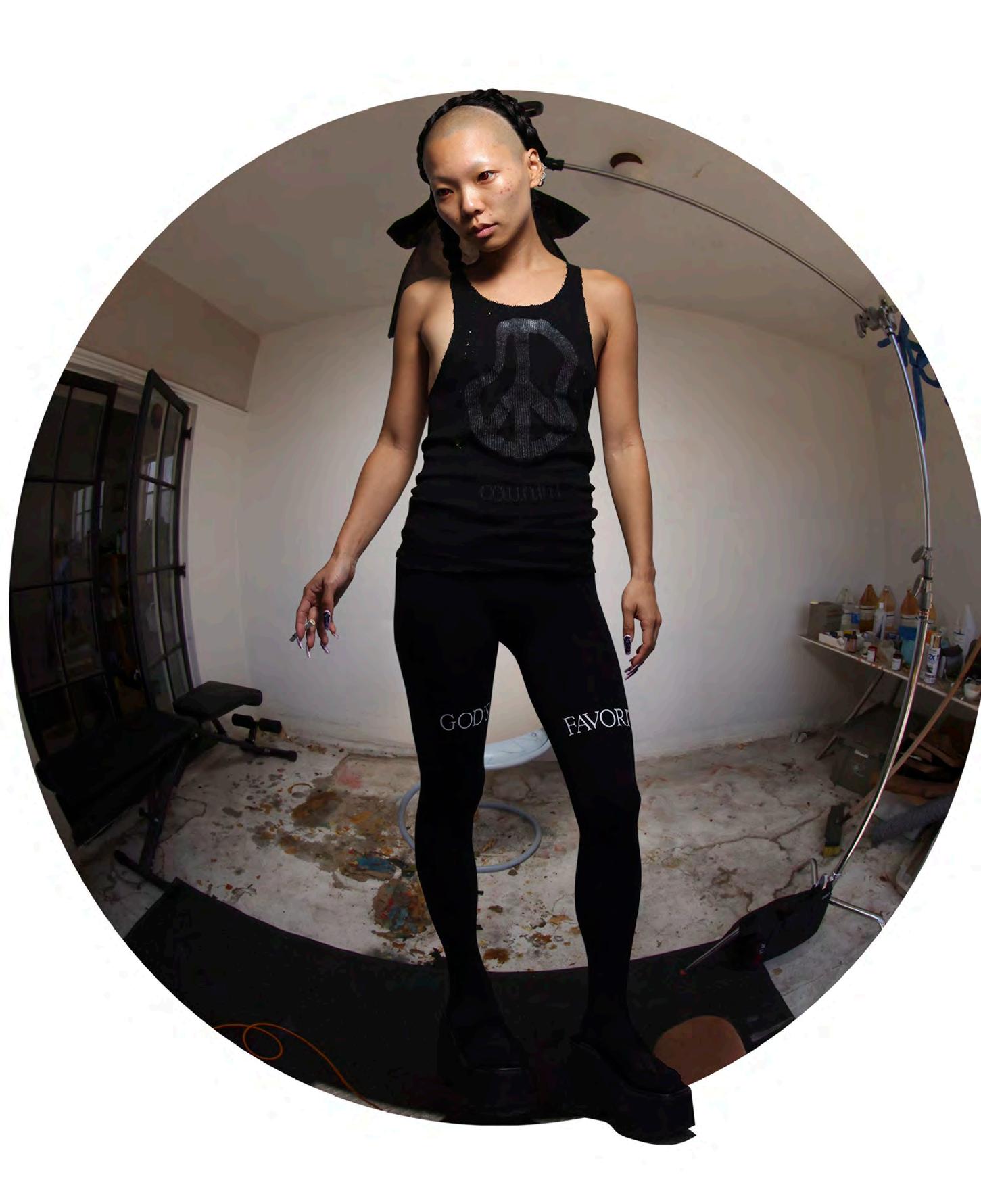
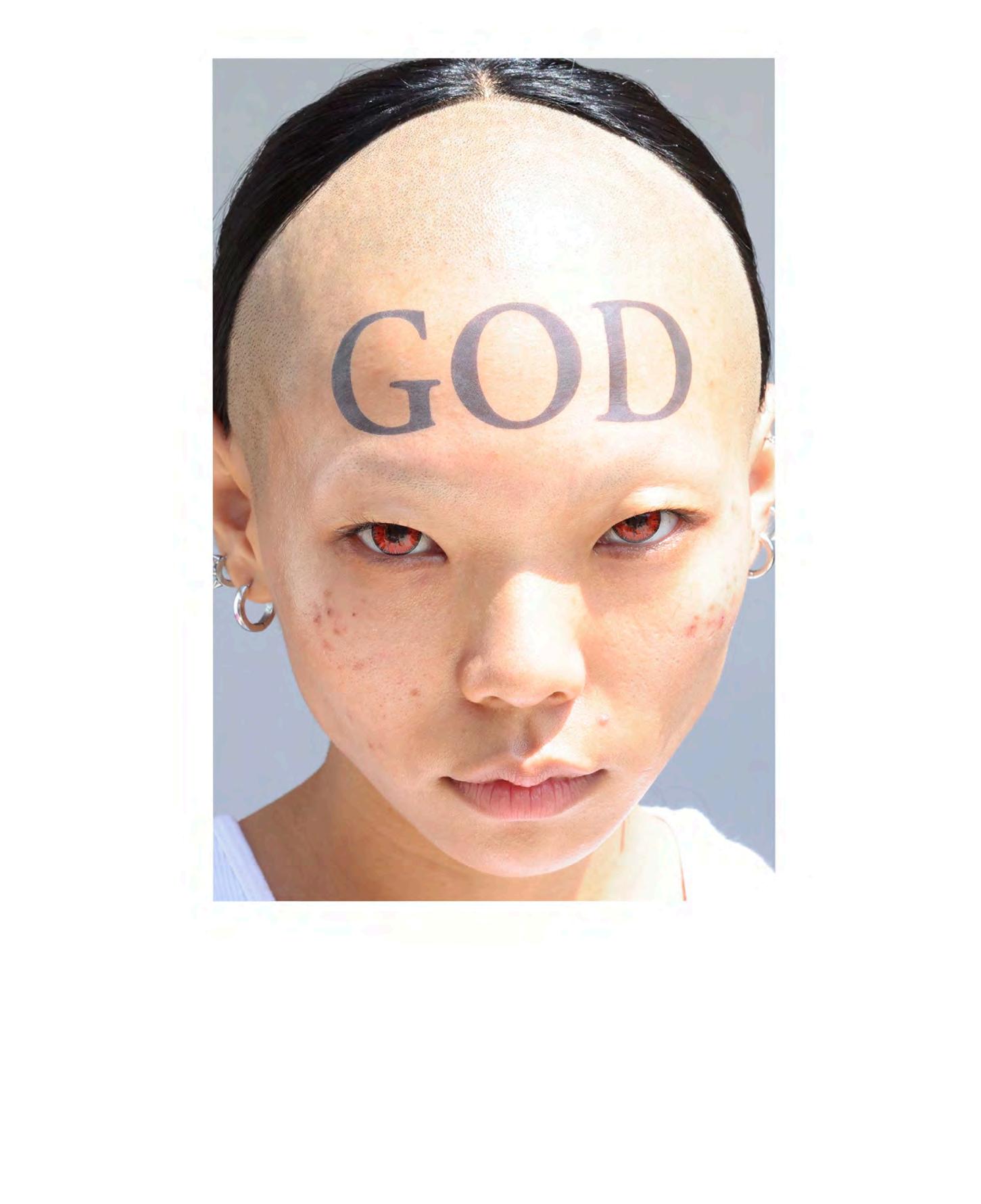
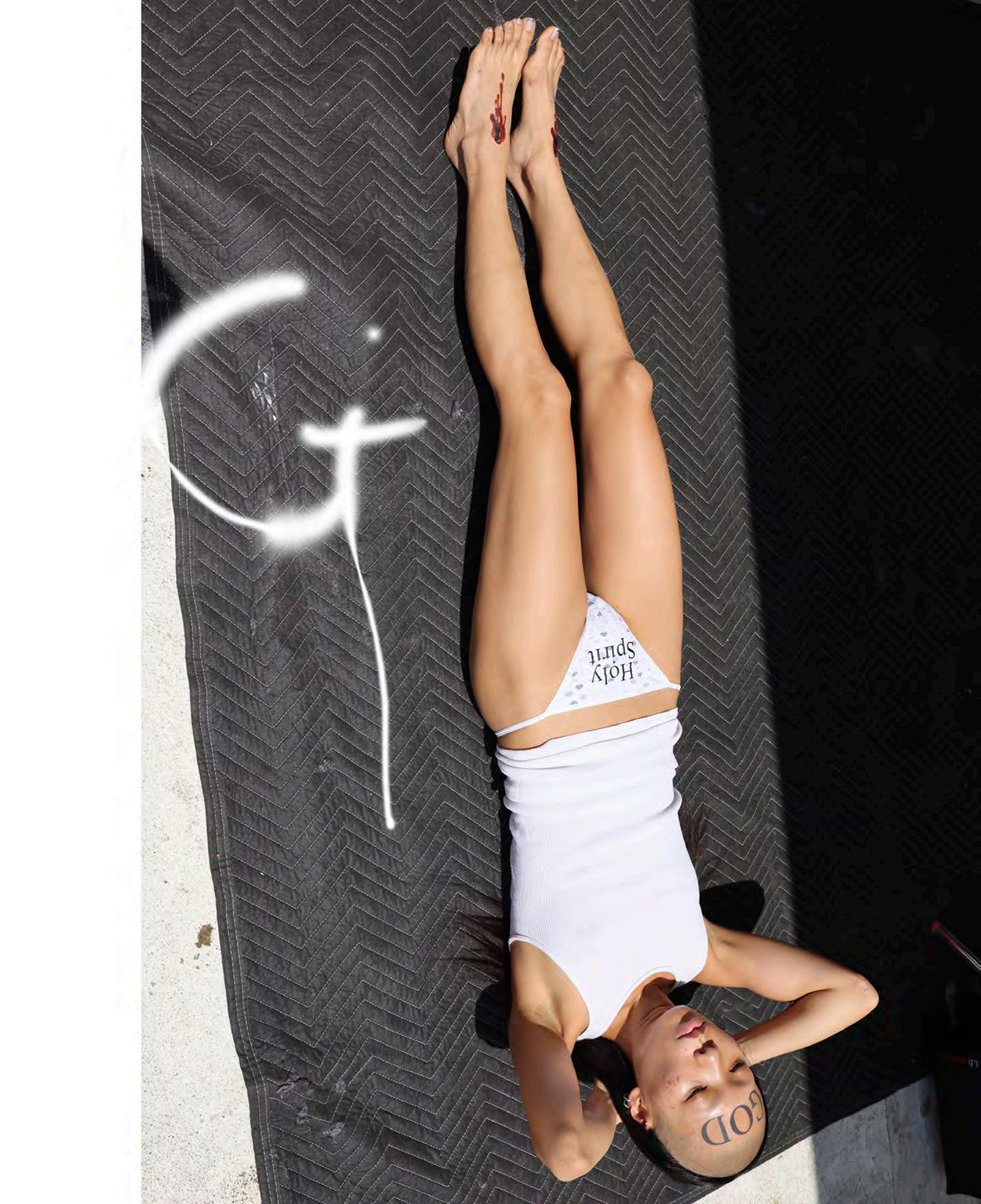
During Mexico City’s Art Week this past February, the name that seemed to be on everyone’s tongue was that of Bárbara Sánchez-Kane. At every party or opening she attended, in her signature three-piece suit, disco-ready wide lapels, blue-lens glasses, and slicked back hair, the Mérida-born fashion designer and artist was swarmed by a coterie of in-demand artists, curators, and collectors. At the Zona Maco art fair, her paintings and sculptures—including a bronze of an eagle emerging from a pair of spread, high-heeled legs, the same logo she employs in her belts and hoodies—sold out from the Kurimanzutto booth during the preview. When I went to her light-filled, multi-level studio in Roma Norte one morning where she was preparing her new collection, Sánchezkaneismo, which she would present as a performative artwork at the gallery in April, she was also busy fitting Kibum Kim of Commonwealth and Council for a baby blue suit with operatic, Gehry-esque details coming off the lapels. Kim is part of a growing number of art world fans clamoring for her provocative, genderless designs, which incorporate everything from stilettos with miniature shopping carts as the heels, to denim with multiple pouches for flowers, to the logos of Banamex bank on hoodies and hats. Defined by her “Macho Sentimental” moniker, Bárbara Sánchez-Kane’s world is at once whimsical and polemical, sensual yet restrained, camp and chaotic, and it is growing every day beyond its humble roots in Mérida to an international audience that is embracing her, not only as a designer, but as a painter, sculptor, and performer. One who is participating this fall in the Okayama Art Summit in Japan curated by Rirkrit Tiravanija with a showstopping rawhide sculpture that blends both her art and design practices while teasing out the complexities of her conservative upbringing and her queer identity. Over two conversations in Mexico (and via WhatsApp from her childhood bedroom in Mérida), we discussed the juxtapositions that comprise her shape-shifting oeuvre.

MICHAEL SLENSKE
What was it like for you to grow up in Mérida? You’ve told me about the Catholic identity and how it was very conservative there. Were you involved in anything creative?
BÁRBARA SÁNCHEZ-KANE It was super, super conservative. I analyze it now in therapy, but I was depressed until I was twenty-two. I didn’t even go to art exhibitions. It was not like I wasn't interested, but I just didn’t know that world existed. It was very difficult to be motivated or think about making a living as an artist. You're born in this world that has one collective psyche and there’s no other path. So, it was very difficult. It was tormenting to have all these fantasies and not be able to reach them.
SLENSKE What were you fantasizing about?
want to do.” Even while studying fashion, I didn’t know how to make a brand. I wanted to stay in Europe, because I studied fashion in Italy. I was in Florence for four years and I couldn’t stay because of my visa. I knew the designers in Mexico were not representative of my creative process. I didn’t feel attracted to that, but if I were in Mexico, why not make my own brand? So, I moved back to my parents’ house when I graduated, I was twentyseven. They gave me a space in the house and I started the brand there.
SLENSKE Going back a little bit, after realizing you didn’t want to become an industrial engineer, you said you were depressed until you were twenty-two. Can you talk a little bit about this?
and blogs, and going to music festivals. I would design my stuff growing up, but I never thought about pursuing something in fashion. I just found this tartan skirt that I designed when I was sixteen and it had a super low waist. Now it fits me perfectly, but it has such a low waist (laughs). Even now I don't buy things—everything is secondhand, or things that I make.
SLENSKE And did you design your quinceañera dress?
SÁNCHEZ-KANE It wasn’t so much a quinceañera, it’s something they do in the Yucatán when you’re sixteen that's like a princess ball (laughs). And yes, I designed my dress. It had feathers and it was black. It’s not something I would like now, but at that moment I thought it was beautiful.
SLENSKE So, in this traditional environment, with a princess ball and traditional dress, did that influence what you are doing now with genderless fashion?
SÁNCHEZ-KANE Just building things. I remember decorating my room when I was seven.
I slept in a room with my older sister, and she didn't even care about the color of the carpet or the ceiling. I was always asking for my birthday gift to be the decoration of my room. When I was sixteen and seventeen, I was obsessed with Andy Warhol.
It was the art that I was exposed to. So, my room looked like Andy Warhol’s Factory. Silver, gray walls with a light that changed colors, like a discotheque. And I was always reupholstering the fabric of old furniture. That was something I always did growing up. But it was very difficult to think I had a creative side, because it was very much turned off. Everything was just part of my imagination and I thought it wasn’t going to be used for anything.
SLENSKE What did you think you were gonna become then? What was the reality?
SÁNCHEZ-KANE The reality I imagined was becoming a systems engineer in computers.
I studied that for six months and I was like, no, no, no. And then, I wanted to become an industrial engineer and I finished that. I wanted a career that could give me a broader perspective. As an industrial engineer, I could work in an office, or a motor shop, or a manufacturing company. It all depends on which area you specialize.
SLENSKE So, if you had this Andy Warhol silver Factory in your room, what were you dressing like? How did you express yourself in fashion?
SÁNCHEZ KANE The first time somebody questioned my sexuality was because I was wearing a tie. I was probably thirteen or fourteen, because I have always been obsessed with ties, and still am today. I remember arriving at a party and being dressed like one of the guys. But for me, it was not even about being gay or not. I was born in a world where there's just heterosexuality. The only path was marriage, except for being a priest or a nun. I didn’t question whether I liked women or not—I was just very blind to this.
SLENSKE Was your family supportive?
SÁNCHEZ-KANE They are a very supportive family. They said, “Find yourself, do whatever you
SÁNCHEZ KANE I thought, what if my creative side was useless? You know, what if these scenarios will not play a bigger role in my life? I was just removed from it. And I was diagnosed with ovarian cancer when I was twenty-two. It was the year before ending college.
SLENSKE What was it like learning about this diagnosis?
SÁNCHEZ-KANE Basically, they had to operate on me without knowing it was cancer and they removed a teratoma. They gave me a pelvis scan and they told me that they needed to remove a fallopian tube and an ovary from the left side. But they said, “Don’t worry, you will be able to have children in the future.” So, I had surgery here in Mérida and the recovery was very tough. I remember a picture of the teratoma and it was huge. After the biopsy showed some troubling signs, I went to a cancer specialist in the US—the head of his department at a Methodist hospital in Houston. My mother's family is actually from there. They didn’t talk about death or anything like that, but they told me that the worst thing that could happen is that it could spread, and you will need chemo or radiation and all these things could be painful. Obviously, at that age, I was so scared and that fear really pushed me to start questioning my life. When I came back to Mérida, the doctor said I only needed two small operations and otherwise I was okay. I think it was the best thing that happened to me. Spiritually and mentally I was awakened. You know, what am I doing with my life? What's my sexuality? It's when I finally questioned my sexuality. Before, I was too afraid of going toward this different path. So, it was an explosion, literally. It was when I was like, oh I want to study fashion. I'm gay. I want to move to Italy. That’s when everything happened.
SLENSKE So, it took a near-death experience to question these things. Growing up, what were the outlets you explored that indicated you would want to live a life of creativity?
SÁNCHEZ-KANE I was very much interested in fashion. I would know every runway show and all the designers. I was reading fashion magazines,
SÁNCHEZ-KANE In terms of sizing, it is difficult to mix a man's body and a woman's body. I think the body and space is something that has been very fascinating to me—the performance of what you're wearing. Clothes become our skin, and what drives that psychologically? The transformation of what you’re feeling—whether you're melancholy or you're happy—using that as an exploration of space. We all occupy space with what we are wearing, even the colors and the structure. I think it's something that is very palpable in my work—through fashion, sculpture, painting, there’s always these scraps of clothes.
SLENSKE Did that lead to the idea of Macho Sentimental?
SÁNCHEZ-KANE When I graduated from fashion school in Italy, I was just trying to see what was gonna happen to the work with the hybrid of my experience in Europe and coming back home. It didn't have any form yet. I didn’t even know if I was going to call the brand Sánchez-Kane. So, in that discourse came Macho Sentimental—this person that I believed was in contact with both their masculine and feminine side.
SLENSKE And that was inspired by getting a tattoo with a friend.
SÁNCHEZ-KANE In 2018, I was getting a tattoo with a friend, and he showed me a sketch and I was like, “It’s too macho. I want it to be more sentimental.”
SLENSKE If you were to define it, what is Macho Sentimental?
SÁNCHEZ-KANE Well, it's somebody who doesn’t question the gender they were born with. Even a woman can be macho, you know? When you look at gender studies, like the writings of Judith Butler or Paul B. Preciado, the construction of gender is something that we perform daily. And we perform it to obtain certain roles that would not be obtained if we were perceived more as a woman or a man, and that should be broken.
SLENSKE So, is it an idealized gender identity, in a way?
SÁNCHEZ-KANE It’s more like, what if gender doesn’t exist? Society puts these two binaries together and they end up in a collision. Macho Sentimental is a sentiment that instead of being divided, we should be united based on our identities—what covers us is the same. I feel like everything in this world is going backwards. We’re
"The first time somebody questioned my sexuality was because I was wearing a tie"

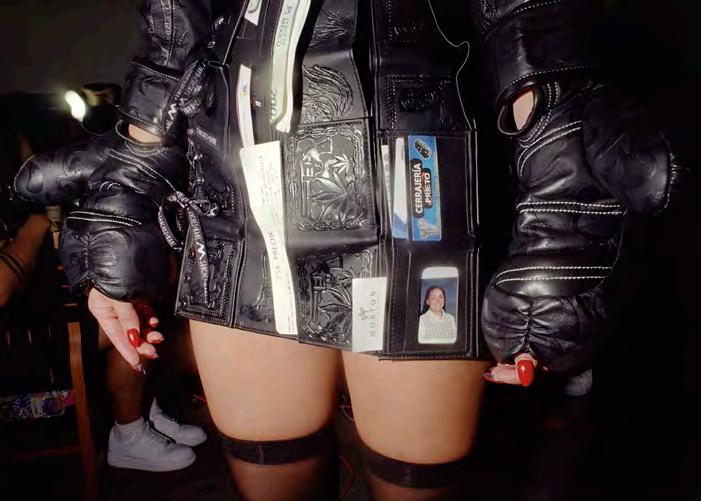
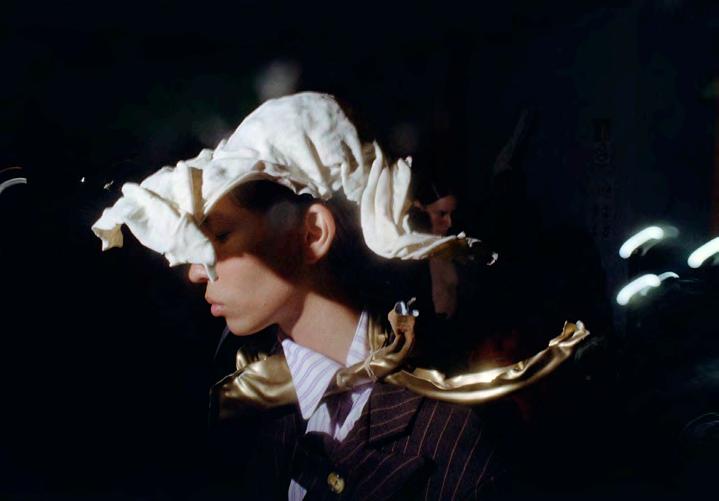

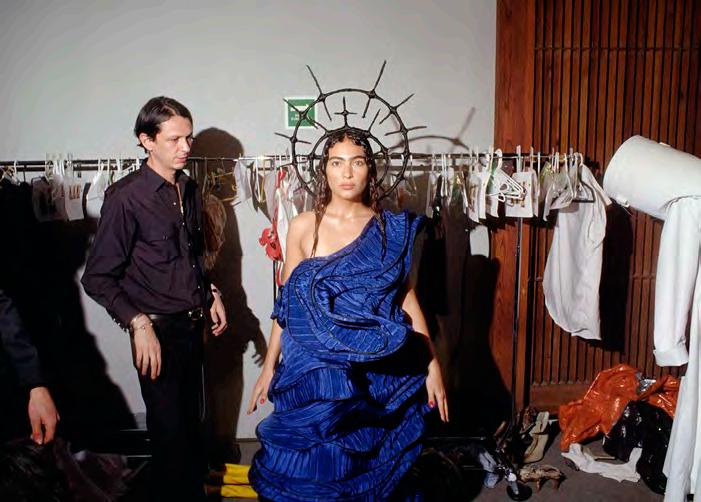


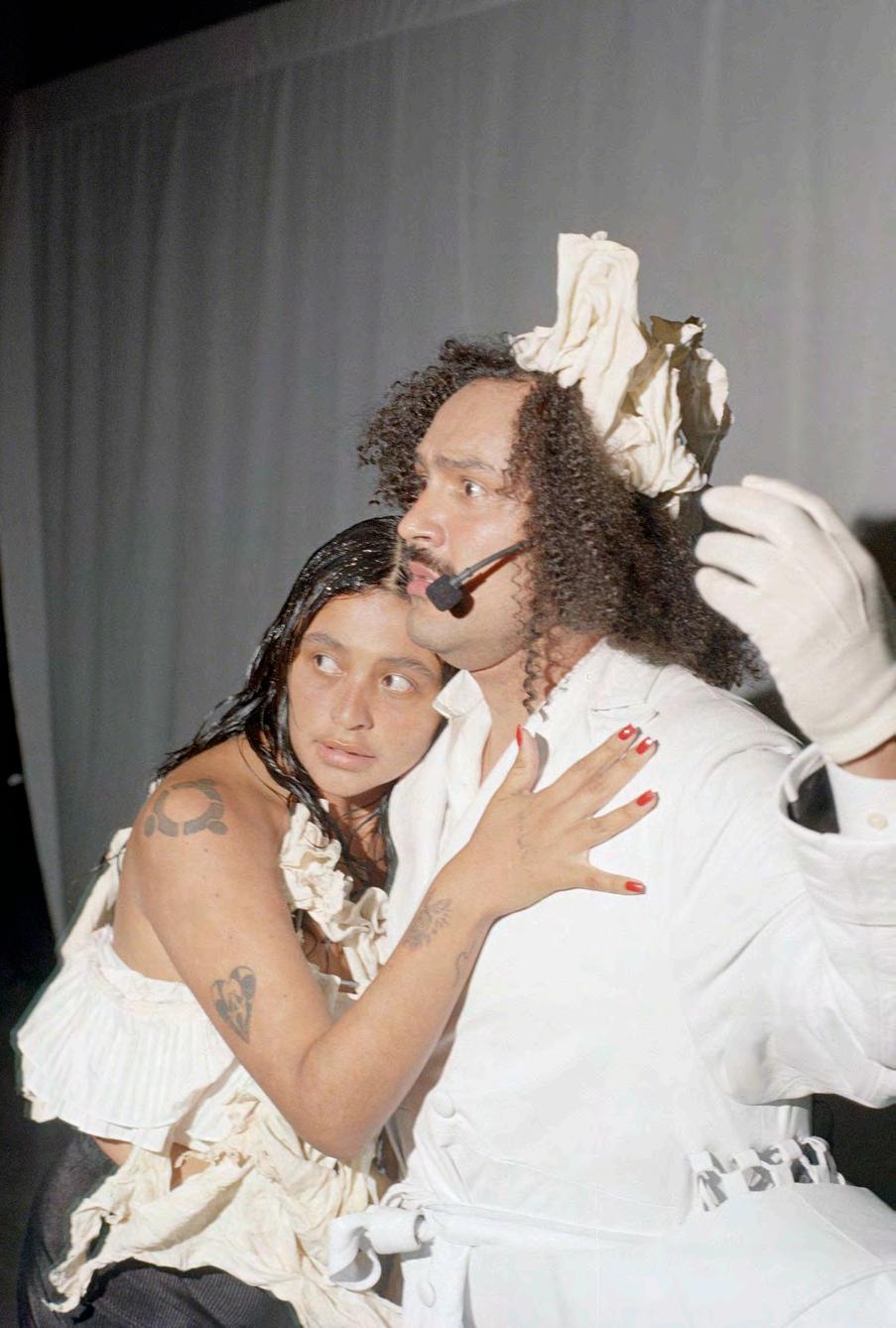
still living in this era where we’re fighting for abortion rights, and it's hard. I can’t believe we're still discussing gender, but that’s probably because it still needs to be discussed.
SLENSKE These concepts about gender that are in the collections now, were you thinking about that when you were in school in Italy?
SÁNCHEZ-KANE No, I think I was more interested in how to not appropriate the folklore we see in Mexico—trying to find a modern way to portray this modern Mexican. I think that was something I was very interested in at that time. And sometimes being obvious in a funny way, like putting the word macho in a phrase. Mexicans will always tell you that they are macho. Or, there are certain stereotypes of religion and how we go about religion. That is very inside of us—it’s in our collective subconscious.
SLENSKE When did the clothing fit this Sánchez-Kane profile? When I told people I was doing this interview, they told me that Bárbara is the person you meet, and then there’s SánchezKane, who has a more public persona. There's you when you're out at night, and then there’s you in the studio. It's almost like armor or something— the suit, the glasses.
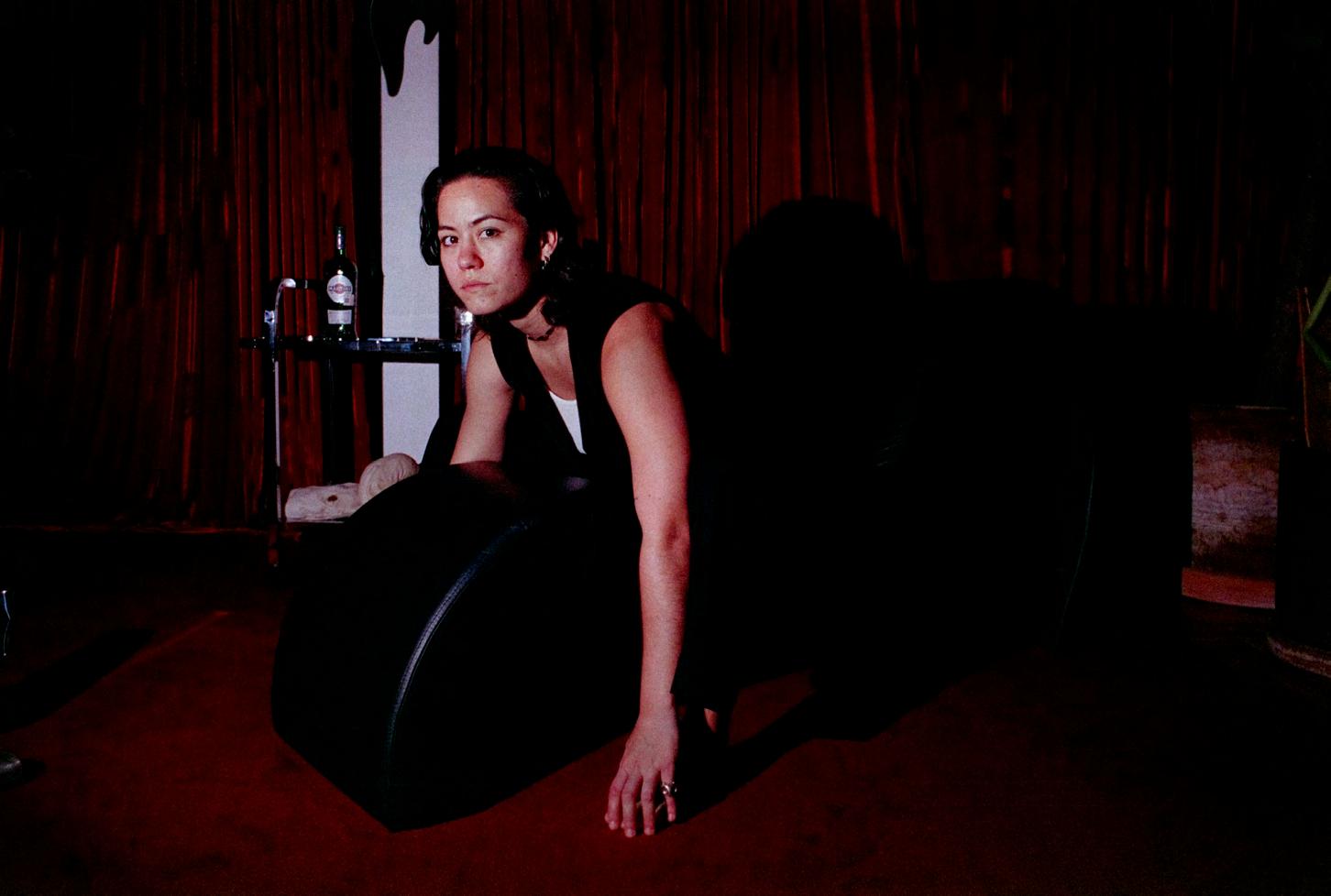
SÁNCHEZ-KANE The persona. Well, I guess, as I told you, it’s how our bodies inhabit space and sometimes you need armor to not show your bare bones and not be an object of people's perception. Sometimes it's very difficult to navigate—just
trying to be a person is very difficult, and having a brand, people expect things from you. It's difficult to understand that sometimes there’s no room for failure. So I guess, yes, there is sometimes this persona that’s inside me, but it’s not necessarily me, and I think it’s important to keep this box that you only show to certain people.
SLENSKE So, does Macho Sentimental reflect you as the designer, as the public person, or both?
SÁNCHEZ-KANE I think I’m both. Right now I'm in this period where I very much feel like a loner. The city was too much for me. I'm flying back just to oversee certain projects that need to be delivered, but that’s it. But I'm a double Scorpio for god's sake. My friends are like, “Oh you're in your Scorpio zone.” I can spend like three days alone in my apartment—not going out on the weekends. I think it's good to understand that sometimes you want to be out and sometimes you want to go inward, and not let people in. And it’s in these times I like making work that’s just for me. It’s not for a museum, or for a show, or for a client. These are the works I adore the most. Like now, I'm working on this sculpture that is the biggest bronze sculpture I've ever made.
SLENSKE What does it look like?
SÁNCHEZ-KANE It's this study I did with two people entangling each other and it comes from a poem. It didn’t come from a sketch, but from a 3D cutout that I was doing one night in
my apartment. It's very amorphous—it’s like the bodies you see in my paintings. It’s like taking the body from the painting and doing it in 3D.
SLENSKE So, you're sort of abstracting the painting, which becomes a 3D version, which goes back into this classical form.
SÁNCHEZ-KANE And it can look like a lot of things from different sides. Even my paintings don’t look anything like what I’ve been painting in the past two years, and I’m still discovering what I can do with a paintbrush.
SLENSKE I want to talk about materiality too, because that seems to be so much a part of the process, whether it's in the art or especially the fashion. Like the shoes with the shopping carts on the high heels, or mesh with leather, with rubber, with screen printing. You combine so many different materials in unexpected ways. Can you talk about the expression of materiality?
SÁNCHEZ-KANE Things are all centralized in Mexico city. So, when I went there in 2018, it was crazy—I discovered a leather manufacturer, and some specialists in dying and doing interesting things with denim. Obviously it was a big jump when I moved to Mexico City, especially with the quality and finding people that could sew my clothing. In the south of Mexico, the producers weren’t very good, and I couldn't find the fabric I needed. A lot of designers buy their fabric from New York or Italy. I was thinking, what'sthefabric that’s available to me? But pattern-making really
transformed my use of fabric. Obviously you need certain fabrics for certain silhouettes and inner linings, depending on whether you want it to be more rigid, or more soft, or bendable. Moving to Mexico City gave me a bigger range of materiality in terms of the brand. And let's say I wanted to do shoes for a collection, I could easily find a welder. These people that contribute are very important for me and the brand. In Mérida you would maybe find a welder that is doing kitchens—the first welder I found was doing kitchen tables.
SLENSKE In the Sánchezkaneismocollection you had shoes with mini shopping carts on the heels. How does that work?
SÁNCHEZ-KANE I made those for the collection, but didn’t actually put them in the show. In the end, I decided to use the shoes with the monobloc chair as heels. The thing about the monobloc chair is that it has no real owner—you can go to any factory that does plastic injection and you can have your own monobloc chair. Monobloc chairs can be from any part of the world—not necessarily from Mexico.
SLENSKE Can you talk about this collision of specific materials—like the silk, lace, and leather and how it fits into your designs?
SÁNCHEZ-KANE I've always been curious about how things work and how you can push through the materiality of a garment. And how long it can last, or how it can be sewn or not sewn, or look sewn. Something that drives my practice is curiosity about material. I'm always touching things, smelling things, and learning from other artists, or going to other exhibitions, or meeting people, like welders and artisans. When it comes to the structure, that’s why I moved to Italy—to learn tailoring. Tailoring is something that is very rigid and has a lot of layers. In the end, you just see the fabric, or the outside of the garment, but it’s a long process to get to the sartorial point.
SLENSKE Would you say that’s the breakdown of your approach in general, that you're almost always sculpting?
SÁNCHEZ-KANE Something about giving an object another life is very much part of my practice. And it’s very automatic. Sometimes it comes from things I see on the street. For the knife shoes, I was downtown and there was this store full of glassware and knives. I don't even cook, but I bought these amazing knives because they were so shiny and nice. Also, there was something about the symbolism of kitchenware and a woman’s traditional place in the kitchen. When I did the Sánchezkaneismo collection it was an obvious decision to include them. So yes, whether I’m having a fashion show somewhere or an exhibition, it all collides.
SLENSKE Can you talk about what you're doing for the Okayama Art Summit that Rirkrit Tiravanija is curating?
SÁNCHEZ-KANE I was going to show my first erotic movie. I wanted to show this sex video on these objects being destroyed by dogs. But there was not enough time. So, I'm doing an installation consisting of six students. It’s going to be at a closed school in Okayama. It's six students dressed in the same pattern—a dress shirt made of rawhide, and there’s the teacher, or god figure according to the hierarchy, dressed the same as them. But the juxtaposition of the shirt is slightly different than the students. Religion played a very
important part in my growing up. Just thinking back to not doing certain things as a six-yearold because you think you are going to go to hell.
As a six-year-old, imagine thinking about hell!
All these dogmas that society teaches you are quite violent.
SLENSKE Can you talk a little bit about your connection to H. Lorenzo, which is one of the stores in Los Angeles that has supported the brand—how did that come about?
SÁNCHEZ-KANE H. Lorenzo came about through VFILES, which is a fashion incubator and contest that a lot of fashion graduates apply to. That year, 2016, the jury committee consisted of Naomi Campbell, Mel Ottenberg, Fear of God’s Jerry Lorenzo, makeup artist Pat McGrath, and rapper Young Thug. They selected five international collections. It was an all-paid New York Fashion Week experience. And then they showed my brand in Paris and that’s where H. Lorenzo picked it up.
SLENSKE What has the work process been like with them since?
SÁNCHEZ-KANE Xochitl, the buyer is a very good friend of mine. She's Mexican and has been in LA for ten years. I've done a performance with them and a popup. They have been very supportive. I like the idea of people being able to find me there, but if you go to Mexico, you can experience the brand in my little studio. I don’t mass produce anything. It's all small production.
SLENSKE And you got connected to the Kurimanzutto gallery through Sarah Lucas, right? How did you meet her?
SÁNCHEZ-KANE Yes, through Sarah. Back in 2018, I wanted to get into this showroom in Paris and Xochitl from H. Lorenzo was very good friends with the person who owned the showroom. Xochitl told me that she was in LA doing a show at H. Lorenzo with two Korean designers and that I should meet her. So I bought a ticket that day. The next day I was on a plane to LA with two suitcases and my collection. The collection was called
LAS PUERTAS AL SENTIMENTALISMO. I arrived on Friday and the meeting was the next day. When I landed, my friend Nika Chilewich, a curator at Hammer Museum, invited me to Sarah Lucas’s Thousand Eggs performance. It was a very small thing—just friends and donors. Then I asked Nika to introduce me to Sarah and we just clicked. I remember Sarah liked the belt I was wearing, which had a buckle with a longhorn cattle that had legs and heels for horns. And I was wearing full Sánchez-Kane—black jacket, black trousers. But we kept in touch and then she invited me, Kris Lemsalu, and Kyp Malone [TV On The Radio] to do a performance at the opening of her exhibition at Barbara Gladstone in 2020—three months before New York went into lockdown. And I met José Kuri and Mónica Manzutto [founders of Kurimanzutto] at the dinner afterwards at Ugo Rondinone’s house.
SLENSKE So, how would you describe this show at Kurimanzutto where you presented the Sánchezkaneismo collection? Because you are decontextualizing both things—you're taking away the context of the fashion and putting it in the gallery, and putting the gallery in the context of fashion. Was that part of the reason for doing that?
SÁNCHEZ-KANE I was working on a new collection when Monica and Jose came to my studio. It was a much smaller collection at that time, and they told me that they had a space in the gallery because they were between two exhibitions. I got very excited to do a show there— to do what I call my little theater play. Because it’s important for me to show that fashion can live for more than one night and not just be something that you consume via Instagram. I still believe clothing can do that. So, we put it together in two days—a 27-minute play. I wanted to do something that everybody could understand: the origin or conception of the world. At that time I was reading Sexual Persona by Camille Paglia. That book opened my mind, and gave me the idea of drones and calla lilies hanging from the drones. For some reason, a lot of Mexican people are very afraid of calla lilies because they are very linked to Diego Rivera. And something that is recurring in my work is the question of how you can destroy perceptions of what being a Mexican person is like—where everything is very homogeneous. And so I was trying to push the boundaries of what Bárbara thought the world was going to be like in the future. There was narration and it was my first involvement in a bigger production. I asked everybody to go dressed in black, and everybody thought they were going to be part of the show, and they were part of it. For me it was like entering a womb, this space where we all looked the same. In my practice, this form of engagement, of how you occupy a space, is something that fascinates me.
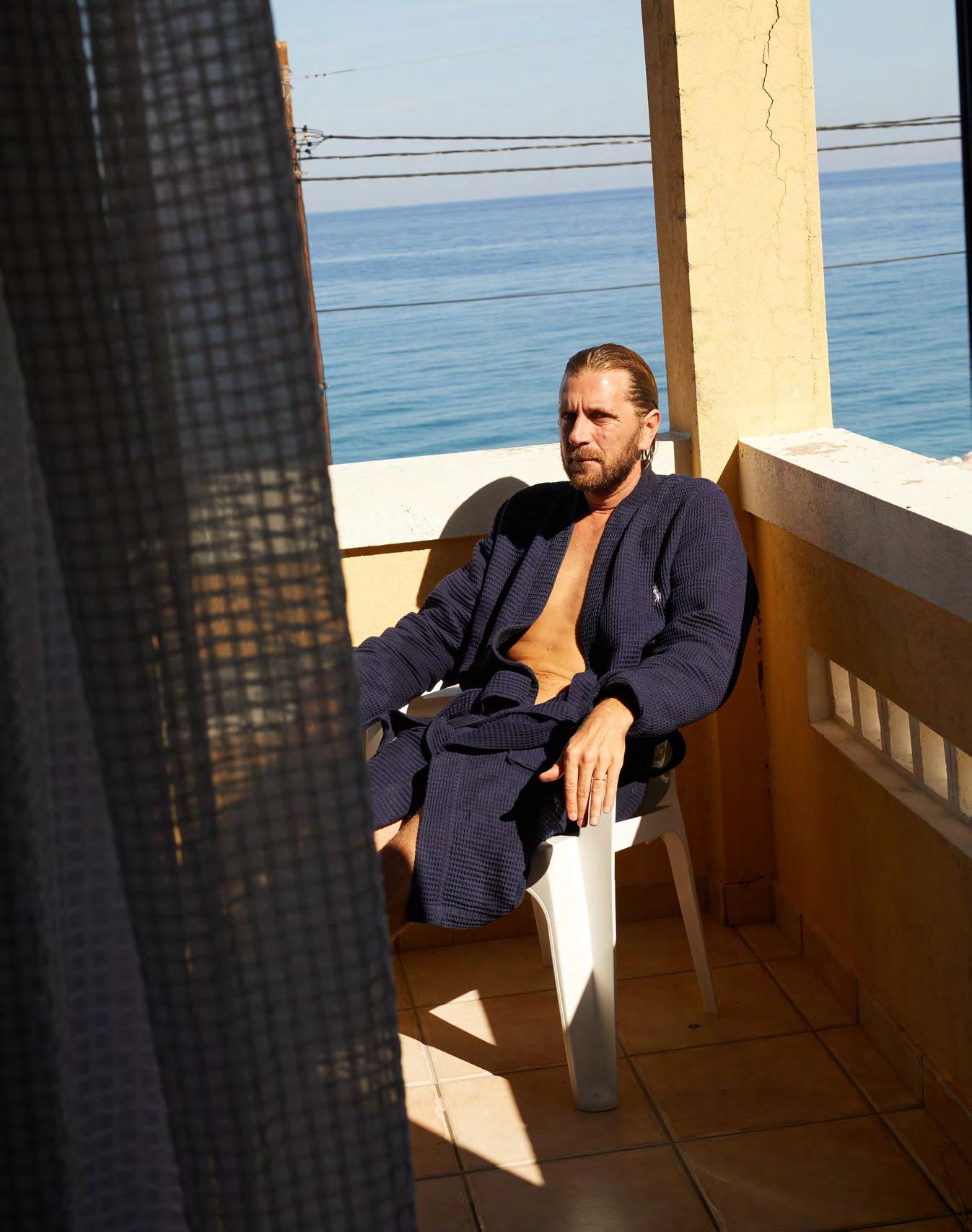
Swedish filmmaker Ruben Östlund is one of the most prescient directors of today's silver screen. His films are dark socio-behavioral comedies that brutally excoriate the art, fashion, and cultural production industries. His breakout film, ForceMajeure (2014) is a story of familial fallout after a father panics, abandoning his wife and kids in the blinding white haze of a controlled avalanche in the French Alps. The Square (2017), which stars Elizabeth Moss, sets its crosshairs on the contemporary art world and the public relation machine that feeds its insatiable gluttonous pretensions. Östlund’s latest, and his English-language debut, TriangleOf Sadness, which won the Palme D’Or at this year’s Cannes Film Festival, is a class war on the high seas. The satire takes place on a superyacht helmed by a Marxist captain (Woody Harrelson), toilet manager (Dolly de Leon), and a cast of sybaritic pleasure seekers, including an oligarch (Zlatko Burić) and his wife (Sunnyi Melles), a male model (Harris Dickinson), and an influencer played by rising star Charlbi Dean who tragically died at thirty-two after the film’s festival release. TriangleOfSadness will see a wide release this fall.
RUBEN ÖSTLUND I have always been interested in sociology because it tries to explain our behavior by describing the setup that the individual is dealing with; that there are certain circumstances in a situation, which can make us act and behave in a specific way. I wouldn't say there are morals in that. It's actually trying to explain the setup needed in order for us to do something that we maybe are not proud of, or we think is ethically wrong. So, I think that is very sympathetic when it comes to sociology. It doesn't point
of scientific study that I love to connect my movies to.
RICHMAN Within the fashion industry there has been a lot of intrigue, particularly around Triangle Of Sadness. Why did you choose to set this film in the fashion milieu?
ÖSTLUND Because my wife is a fashion photographer. When I met her six years ago, I got very curious about her profession and the fashion world. In many ways, the people working there are in control of beauty. I think beauty can be scary and attractive at the same time, because a beautiful person has advantages that not-so-beautiful people don’t
Germany, and Sweden, and the question he added to the pyramid is, where do we put our trust? The Swedes are kind of extreme; we are very individualistic and we have a lot of trust in the State. We don't 100% put our trust in the family. And Americans don't put that much trust in the State. You put more trust in the individual and in the family. The Germans put trust in the family and the State. We had a great belief in folkhemmet when it came to the idea of building a social democratic dream, or utopic society.
RICHMAN Do you think folkhemmet resulted in a more bleak Swedish society?
fingers towards the individual and say, you are bad or good. It rather says, okay, if we wanttobeabletoactinaspecificway,these are things we should think about. When it comes to Triangle Of Sadness, it is inspired a lot from [Karl] Marx's theories. Marx was also one of the founders of sociology, the idea that our behavior is changing depending on which financial or social position we are in. I wouldn't say that is moralizing.
RICHMAN Do you see making a film as a social experiment? And if so, what were your findings from the Triangle Of Sadness set.
ÖSTLUND I see not the making as a social experiment, but the themes and content very often come from an interest in sociology. I got to know a lot of interesting things about how the fashion industry works, and the way that beauty is affecting us. One of the examples is how the fashion industry is selling and marketing their clothes. There was a scientist that was looking at zebra camouflage. He was asking himself why they are black and white when they live on the sandy, yellow savannah. Wouldn't it be more efficient if they had camouflage that made them blend into the environment? And then he started to follow herds of zebras and tried to spot one individual, to see how they were behaving. And it turned out, it was very hard to follow one individual because they immediately disappeared in the herd. But, when they sprayed a red dot on the fur of one of the zebras, it almost immediately got eaten by lions. So, the camouflage is to hide zebras within the herd. The scientist then drew parallels to the fashion industry. What we are doing is buying clothes for a specific kind of social group that we feel connected to and we are trying to hide within them. And then, of course, it's very efficient for the fashion industry to change the camouflage every fall and every spring. So, this is a very typical kind
have. And, beauty is also a parameter when it comes to setting the hierarchies in a group. So, the starting point was to look at beauty as a currency. There is money and education, of course, beauty is one of the few ways that you can climb from the bottom in a closed society. Maybe we are more aware that women can use these tools, but my starting point was with male models, because men use beauty as a currency too. So, a lot of the inspirational starting points come from discussions that I had with my wife and some of our struggles when it came to cultural differences.
RICHMAN In The Square, the curator's assistant says to the curator, “Don't be so Swedish.” I once interviewed another Swede who told me that to understand the bleakness of Swedish society, you have to watch Roy Anderson's films, particularly Songs from the Second Floor (2000). And the political concept of folkhemmet—that society should provide a place of safety for the people. What do Anderson's films portray about Sweden?
ÖSTLUND There's a certain dry, melancholic feeling to most of Roy Anderson’s films. I consider his feelings very interesting in looking at the perspective of the great Swedish films. And also, his advertising work has the exact kind of quality that his films have. That is the starting point for me when I talk about Roy Anderson's films. If you look at Sweden and folkhemmet, or ideas about what a human needs to be happy, then we decide what kind of space to live in. What level of wealth do we need to create happiness? That is basically what folkhemmet is. My way of trying to describe Swedes for someone that has not lived in Sweden is to draw a pyramid. At the top you write “the State,” and on the left corner of the pyramid, you write “family,” and on the lower right corner, you write “the individual.” There was actually a Swedish sociologist who had been living in the US,
ÖSTLUND I mean, that kind of Sweden doesn't really exist anymore. I believe that Sweden has become much more Americanized today than it was during the ‘60s, ‘70s, ‘80s, and ‘90s. My wife who is German, the first time she came to Sweden, she felt like she was in the Soviet Union. But the second time, when she came to visit me, she said, “Oh my god, you are so Americanized.” This is something that has happened to Sweden since I was young.
RICHMAN Can the TriangleOfSadness be summarized by the Karl Marx quote, “From each according to his ability, to each according to his needs.”
ÖSTLUND I wouldn’t say everything that happens in the film is applicable to this quote, because there are a lot of characters that have much more than they need. But I think the Marx quote is a beautiful one and there's truth in it. What I really wanted to do when it came to this film was to break the convention of how we portray rich and poor people. There’s this middle class perspective of the world that also, in some way, legitimizes inequality. We portray rich people as egoistic and non-authentic, and poor people as generous and genuine. Basically, rich people are bad and poor people are nice. This leftwing, European description of the way the world works I don’t agree with. I'm now quite sure that Marx wouldn’t agree with it either. I mean, one of his best friends was [Friedrich] Engels, who came from a very rich family. Marx didn't think individuals are responsible for the failures of the system. And so, I wanted to look at the behavior of the different characters in the film from their position in a naturalistic hierarchy—that our behavior changes within a different position within this naturalistic hierarchy. The reason I wanted to focus on these things is because we live in a time where we are focusing too hard on the individual. We are trying to explain everything that goes on in the world from the perspective of an individual. We try to explain a school shooter by trying to get to know the psychological background of the person. But we don't look at the much more realistic context—that’s it’s actually a societal problem. Even news reporting has started to adopt this way of explaining the world—that there are protagonists and antagonists, like
"What I really wanted to do when it came to this film was to break the convention of how we portray rich and poor people."
in a fictionalized drama. So, this is one of the strongest intentions that I had with the film. For example, I wanted to make the arms dealer couple the nicest characters. They are nice to the crew, and they still love each other after all these years. And then, we get to know that they have made their money selling land mines and hand grenades.
RICHMAN Once, I referred to the philosopher Slavoj Žižek as a Marxist and he called me consumerist bourgeois in response. Would you call yourself a Marxist, or are you critical of Marx?
ÖSTLUND I don’t know, but it would be very interesting to hear in which way Slavoj Žižek is critical of Marx. I actually had a quote from Žižek in the movie, when the captain (Woody Harrelson) and the oligarch (Zlatko Burić) are going back and forth, which is, “See you either in hell or in communism.” But I think to call yourself a Marxist is to simplify things a little bit too much. There’s so much knowledge from philosophers and thinkers around the years of when Marx was active that we can compare in the context of where our behavior comes from. It's very hard to have a discussion with someone that doesn't have a naturalistic viewpoint of the world and doesn’t understand the consequences of materialism. So, from that point of view, I definitely believe that Marx has so many great ideas that are still shaping the way we look at the world. For example, if you look at all the billionaires and entrepreneurs that are successful, they have a lot of knowledge about human behavior that Marx brought to us. So, they probably know a lot about the Marxist spirit, even if they don't know how to attribute it to him. Also, I was raised by a single mother that considers herself a communist. I would say that for many of her comrades and the political party she was connected to, the mistake was that they started to discuss political ideologies like they are talking about football, and therefore did not want to admit that capitalism has a lot of advantages and has helped us to develop the world, helped the extremely poor, increased the lifespan, and reduced child mortality. There's no question that the market economy and capitalism have helped us to do these things and Marx predicted this. He predicted that capitalism would help us in this way. But when it comes to politics today, about how to create a great society, it’s like a discussion about which football team you are a fan of. And then, you want to disqualify all the other thoughts that come from the opposite side. During the ‘70s, when you had the Eastern and Western world perspective of everything, these two different ideologies were bashing their head against each other. And, I felt like just before the invasion of Ukraine, the world had finally reached the point where we could have a discussion and combine the best of these two worlds. So, I can understand people that don't want to claim themselves



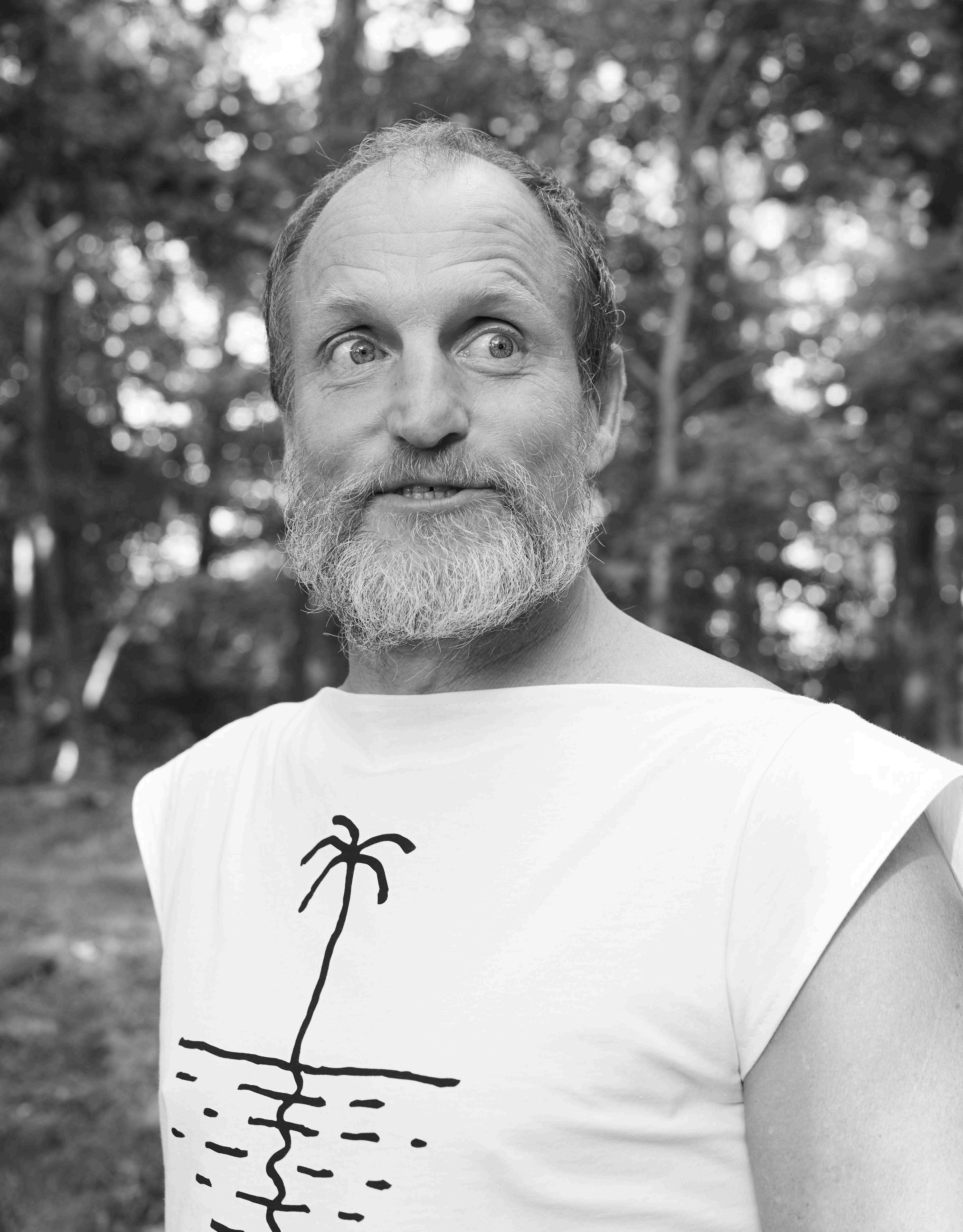
to be a Marxist, because it's so connected to these football hooligan rhetorics.
RICHMAN I think Žižek would say that he's critical of Marxism, the roots of which basically turned into Stalinism.
ÖSTLUND The one thing that I don't believe Marx was right in was the idea of a communistic utopia where everything will be balanced—equality will exist and it will not be threatened. I don't believe in that because power makes us corrupt, and it makes us abuse power. A couple of years ago, I read a book from a Swedish author and economist named Per Molander called The Anatomy of Inequality (2016), which compares inequality with gravity. So, in all human social relations, inequality will happen. Someone is stronger, someone is smarter, someone is more skilled. And he compares inequality in a society like holding a stone in your hand, and when you drop the stone, it will fall to the ground. But there are ways of keeping that stone floating in the air, and there are ways of keeping a society equal. For example, we have morals and ethics, and in some ways, religion, politics, the idea about trust in the State, and how to share responsibility. There

are a lot of human inventions that have tried to maintain that stone floating. When you look at equality from that perspective, whatever political ideology you put your trust in, you understand it's an ongoing struggle to maintain an equal society. Even an equal relationship between a man and a woman, or just between two people, it's an ongoing struggle. It's a lot of work. And when I read this book, it was a bit of a missing link for some of these Marxist ideas, but also for me as a person who believes in a lot of socialist ideas.
RICHMAN In Triangle Of Sadness, the class roles are kind of inverted, but we see similar abuses of power continue. What does that say about power?
ÖSTLUND Jenny Holzer has a quote that says, “Abuse of power comes as no surprise.” I was almost finished with the script and was editing when I read that quote. I felt like, okay, that is actually applicable to this film. The film was written during the peak of the Me Too movement. And I felt there was a lack of discussion about women in a society where men have more resources than women. A discussion about beauty
and sexuality as a currency. It’s almost like love and sexuality are never connected with economical transactions. Of course, a woman that is beautiful is aware of her currency. Therefore, I thought it was an interesting setup to change the power structure on the island and make the young man very aware of his sexual currency, and his beauty, and how it's impossible to not use it if you are beautiful. If we really start to say the truth about these things, people would of course admit using the currency of beauty. For me, it was a pleasure to be able to turn the pyramid over when the characters got to the island and show a different kind of power abuse. This is why I wanted the female cleaning lady, Abigail (Dolly de Leon) to abuse her power.
RICHMAN One of my best friends was a very successful male model, and for many years he lived off the royalties from one multiyear perfume campaign. Towards the end of the film, the characters are stranded on this deserted island, and the male model character finds a bottle amongst the washed up trash of the fragrance brand whose ad campaign he appeared in. What was his realization when he was staring at the bottle?
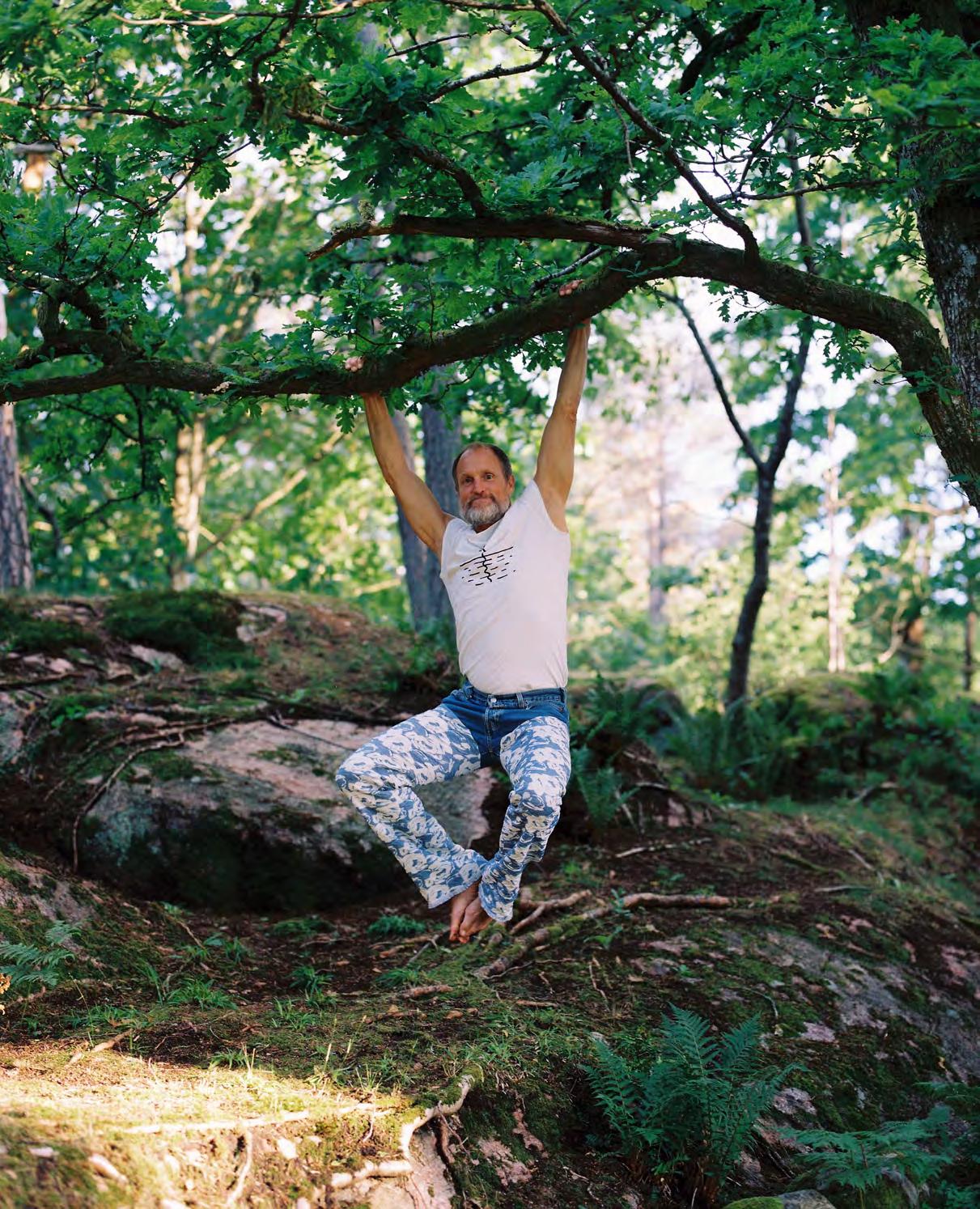
ÖSTLUND The character was inspired by a male model I knew. When he was nineteen, he saw his future as a car mechanic, or something like that. But he got street cast and someone asked if he wanted to be a model. Two years later, he is the best paid male model in the industry. But at the peak of his career, he started to realize he was losing his hair. So his agent was saying, “Maybe we have two more years to push your career, but the problem for you right now is that you are so connected with this perfume brand that it would be great if you get together with a famous girlfriend so we can rebrand you”, and he was like, “what about love?” I thought it was very interesting—when I was pitching the film to younger people and I talked about the branded couple, they totally understood it. But, when I told older people—my generation—they also said, “That is horrible. What about love?” I don't really know who is right. The younger generation feels like they are so aware of this exchange that is going on between couples, especially when it comes to these influencer couples. With the perfume bottle, I wanted to use it to remind him of the currency that he had in the other world.
RICHMAN Your previous film, The Square, and now Triangle Of Sadness, perfectly ape this institutional art world, influencer culture, and the lifestyles of the mega rich. Would you say that you're a very astute witness, or is it an example of Nordic LARPing [Live Action Role Play]?

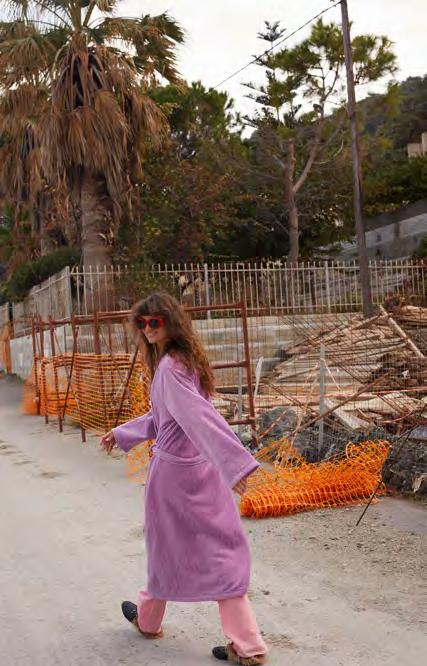
ÖSTLUND I always try to find situations in the art world, or maybe on a luxury yacht, where I can relate to the behavior of the character that is dealing with that specific dilemma. If I can't relate to the behavior of the rich person’s character, I think I have failed in some way. I have to get to know what kind of setup is provoking this behavior. When I research it enough, I can very often understand it. To quote Marx again, “Nothing human is alien to me.” In TheSquare, it was easy for me to find the ethical and moral dilemmas that Christian [Claes Bang] was dealing with. They either came from my own experiences or from something that a friend had told me about. For example, the scene when someone stole his cellphone and he’s printing these flyers to put in every single mailbox in this apartment building in the ghetto, that was something a friend of mine did in order to get her cellphone back. I like distance, but still I want to point the questions towards myself and criticize the group I’m connected to. When it came to getting to know the super-rich, I did a lot of research on luxury yachts and talked to a captain that works on a luxury yacht.
RICHMAN Is there anyone you were seriously afraid of offending while writing TriangleOfSadness?
ÖSTLUND Some real people that inspired the characters—it was the same for The Square. For example, Dominic West's character was inspired by Julian Schnabel.
But the beautiful thing with fiction is that I don't have to attack people and that feels like a privilege today, because so much of how we communicate is based on creating a conflict between real people. So, I enjoy creating fictional characters, because I can be as mean or as nice as I want to be, and not hurt anyone's feelings. That is important for me. I would much rather make the audience feel awkward and pushed into a corner. I don’t know if you confront this, but if you talk to journalists today, you can tell that they actually feel quite bad because they have the pressure in this new landscape to create conflict and take away nuances in order to get attention. That is a problem with journalism today—it is too much in the hands of this attention economy. Fiction is such a great playground because you don’t really deal with human beings. You don't have to exploit anyone.
RICHMAN The casting director of Balenciaga told me that they can't wait to see TriangleOfSadness. Do you think those you satirize the harshest appreciate your films the most?
ÖSTLUND Yeah, maybe it is like that. The ones that are intelligent, they don't believe it’s the individual's responsibility in the way that our times make us believe it is, like the shame of flying or buying an electric car. If we don't solve these things on a societal level, we will never be able to solve the problem. I pitched the film for so many billionaires in the US when I was looking for financiers, and I didn't meet a single one that didn't laugh when I was telling them about this Marxist captain that is reading from the Communist Manifesto to all these billionaire passengers, and he's screaming to them to pay taxes. Even though these billionaires who were sitting in front of me were part of the system, they had no problem seeing the comical side. That is maybe the great thing about capitalism, like whatever has commercial value, you will try to sell it, and you will not be loyal to your ideology.
RICHMAN The opening scene takes place at a model casting, and one of the casting associates tells the male models to relax their triangle of sadness, meaning to unfurrow their brow. Where did you first hear this poetically absurd phrase?
ÖSTLUND When my wife and her friend were in Los Angeles doing some portfolio shoots, they met up with someone who was a plastic surgeon. My wife told me that all of a sudden, he says to her friend. “Oh, I can see that you have a triangle of sadness.” And he was referring to the wrinkle that you have in between your eyebrows. In Sweden, it’s called a trouble wrinkle. It's a wrinkle that you get from having a lot of trouble in your life. There was a certain kind of dark humor in that. He was saying, “Don't worry. I can fix that with Botox in fifteen minutes.” So, there was something about the inner struggles that are exposed on the surface, but we can fix them
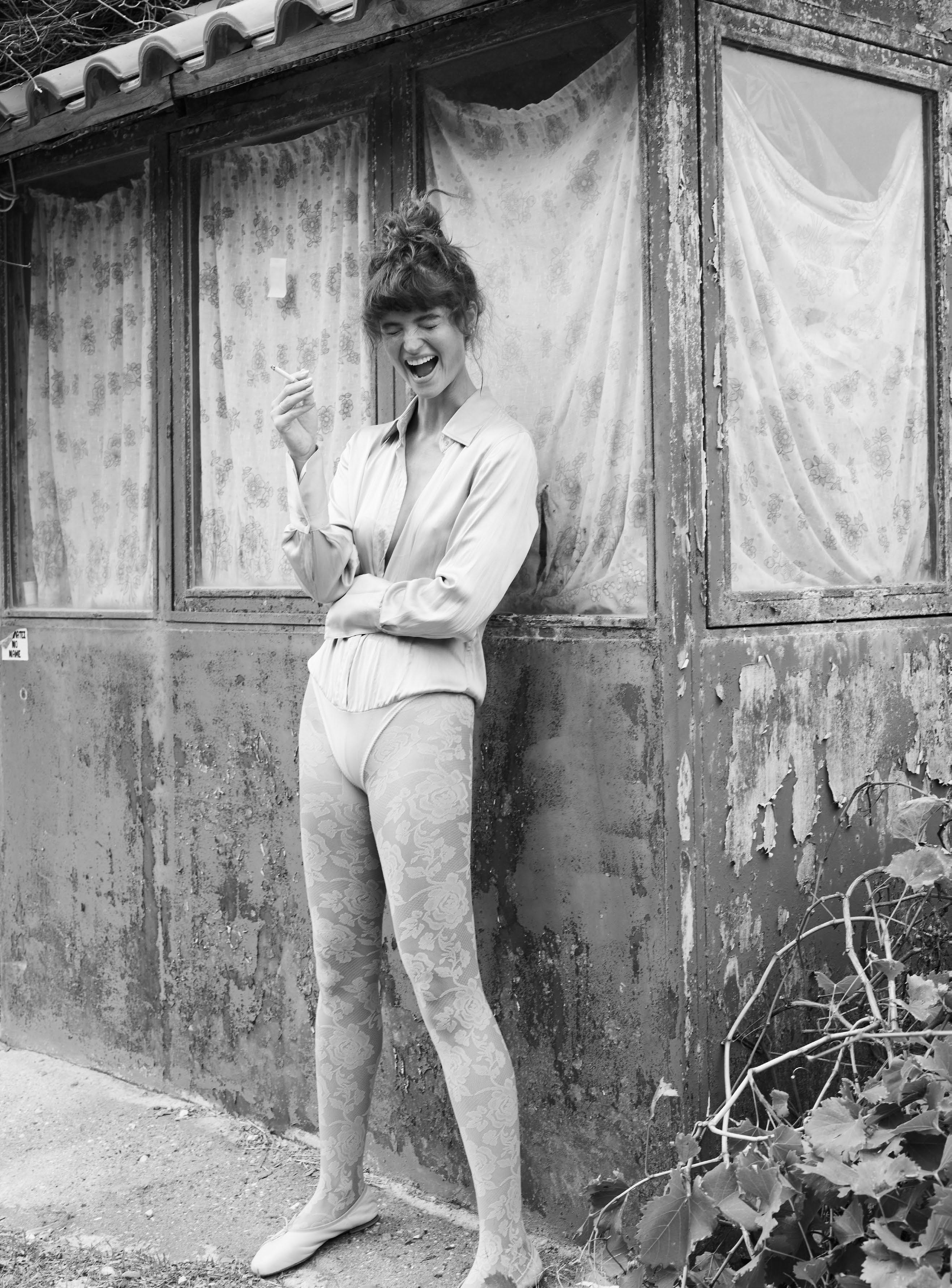
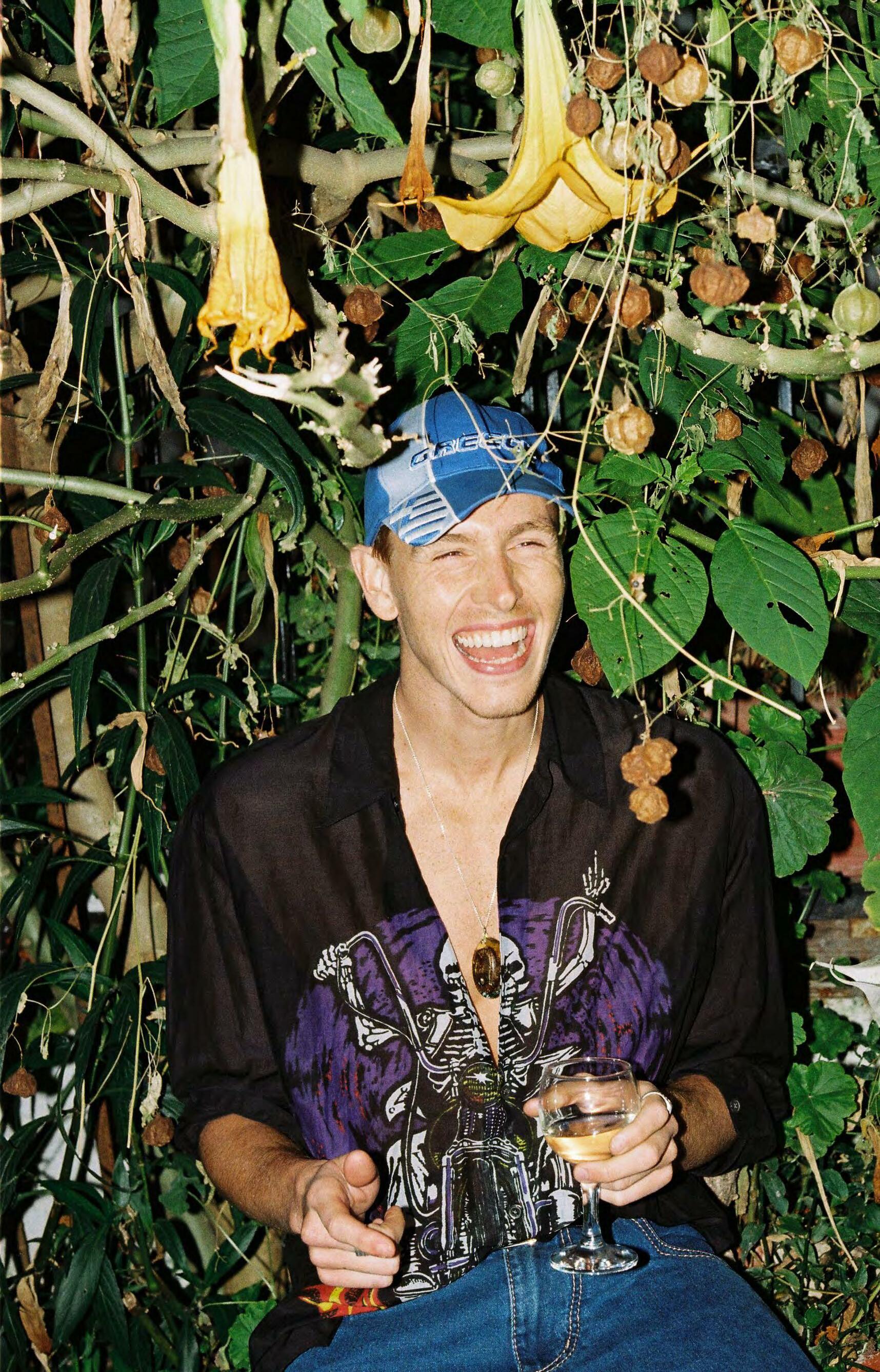
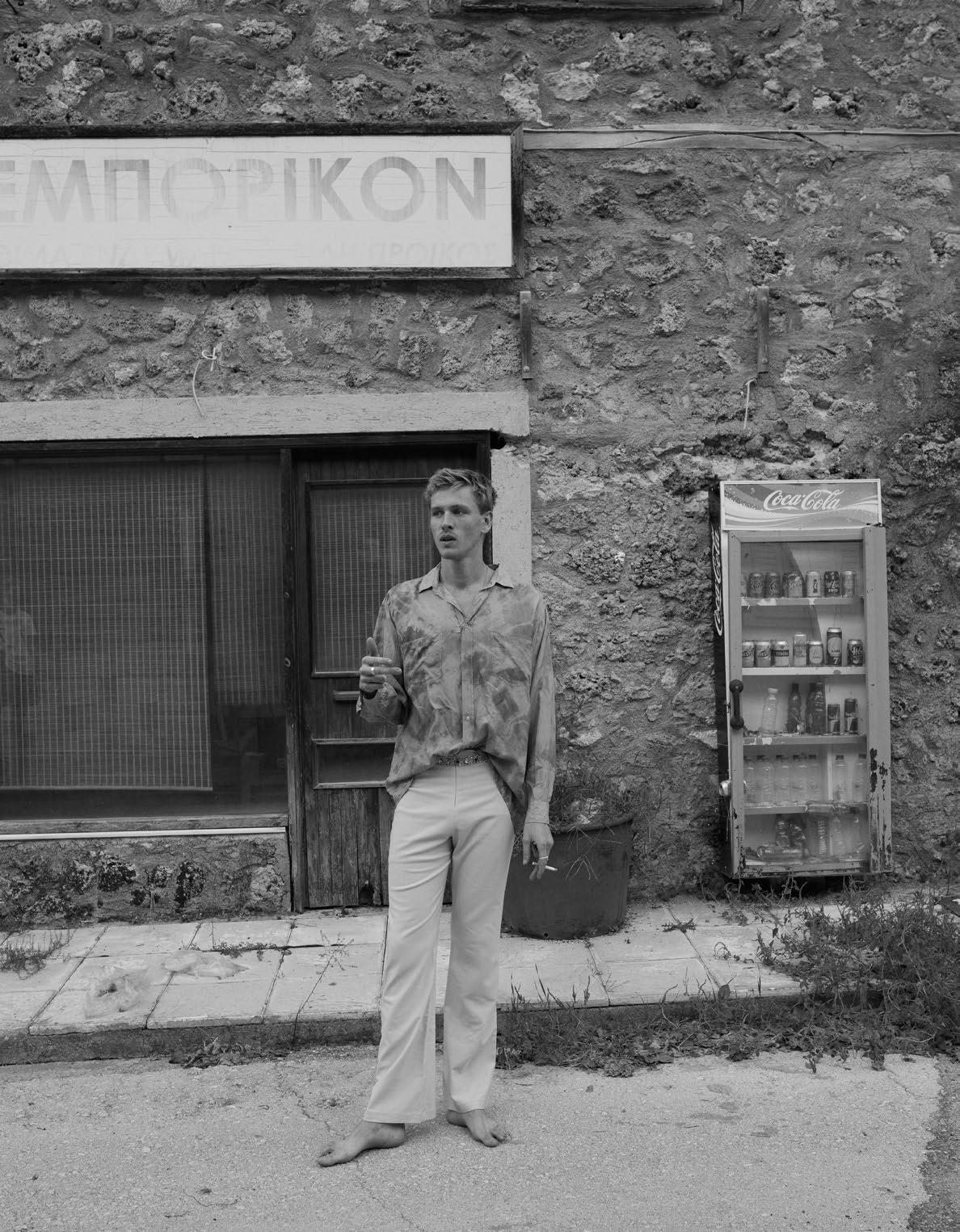

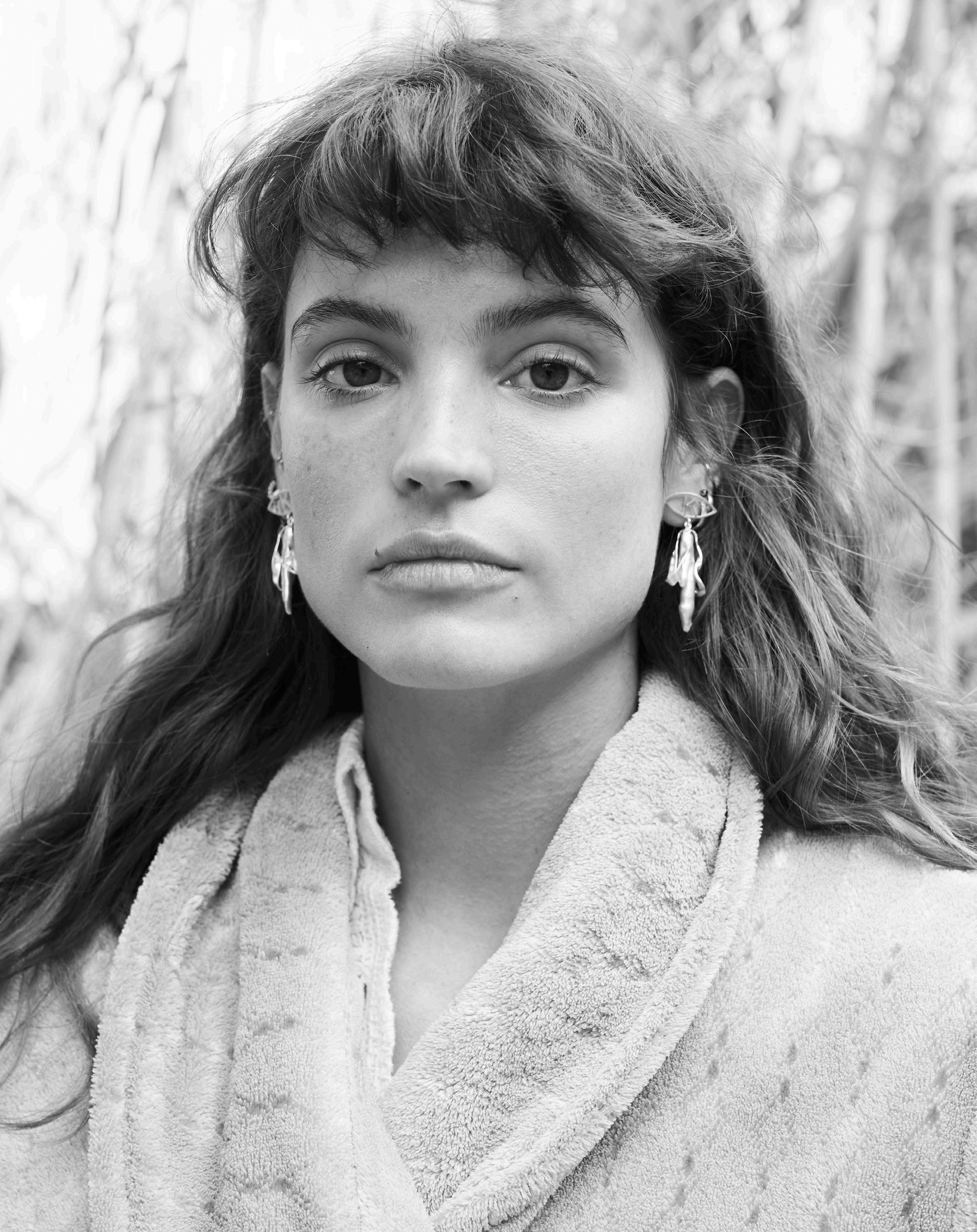
with Botox. And I thought it said something about the fashion and the beauty industry.
RICHMAN In addition to the vomiting histrionics, there are also these really brilliantly, subtle blink-and-you-can-miss-it details throughout the film. This year, much has been made about the placement of books in films and television, and in the hands of celebrities, especially seen in paparazzi photos. Also, the new role of the book stylist has emerged. One of my favorite moments is in the beginning, when the male model character, played by Harris Dickinson, is reading Ulysseson the ship deck. It reminds me of these boys skating around Tompkins Square Park lugging around Infinite Jest What does Harris Dickinson's character reading Ulyssesreveal about him?
ÖSTLUND Of course, it reveals something about being a male model. I was a little shocked when I got to know how male models were treated in the industry, and how differently they were treated than female models. First of all, it's interesting that they are called male models. Also, they make one third the salary that female models make. Maybe that’s not so strange, because clothes and beauty products are mostly consumed by women. But, I think male models have to struggle with the fact that it’s considered vain to be good looking. As a man, to make a living out of your beauty is not considered high-stakes work. So, Harris Dickinson's character is trying to compensate for the prejudice that if you are a beautiful person you are also stupid. I thought it was natural for him to read a book that makes him look a little bit more sophisticated and intelligent.
RICHMAN What is the most surprising book you've ever seen someone incredibly attractive reading?
ÖSTLUND Ulysses is quite fun because it's impossible to get through it. But it’s one of those books that you have to say is good. I have been interested in this, because when it comes to the film industry, it can be boring to show your film to cineastes, to watch people who think they know about film, because they sit with their arms crossed and they're just nervous about what the person sitting next to them is thinking. They are not an audience, they are individualists sitting there watching the film. They don't want to laugh. They don't want to show you anything, because it’s a risk. When the film industry is flying from the Venice Film Festival to the Toronto Film Festival, and you look at what they're watching on the airplane, they're not looking at their own films, they're looking at Adam Sandler movies. I want my films to be wild and entertaining, and I believe something that is wild and entertaining— that you actually want to click on—can, at the same time, deal with content that is interesting. It's kind of self-aspirational, and my aspirational self is what picked the book
for Harris Dickinson’s character, but it's not actually what he enjoys reading.
RICHMAN In your new film, all it takes for societal collapse is a couple of grenades, some pirates, and the sinking of a $250 million yacht. Do you see the collapse of Western civilization playing out similarly to the plot of the film, but on a larger scale?


ÖSTLUND Yes. I mean, if you look at today's football players or soccer players, it has become acceptable to show off wealth, to show off luxury products. But, they are taking a risk by doing this because people can rob them of these valuable things. When I was twelve years old, I was in Copenhagen with my father and we were walking in an area with luxurious houses. Outside one of the houses, there was a Rolls Royce, and I wanted to walk over and have a look at it, but the car didn’t have the hood ornament that it usually has. The driver explained that he had to take it off because people were spitting on the car. In Scandinavia at that time, during the '80s, it was not considered nice to show off your wealth. And then, during the making of Force Majeure, I asked my wife to take a picture of me pouring champagne in one of those champagne waterfalls. You know, where all the glasses are stacked like a pyramid. And it's such a tacky thing to do. I was not aware of what I was doing when I was doing it. The attitude has changed so much when it comes to how we portray ourselves. We are basically imitating the successful lifestyles we see in advertising.
RICHMAN But do you think societal collapse will happen with the tipping of the roles of social classes?
ÖSTLUND No, I don't think so. I think it's going to take a lot of work and a lot of effort to change the power structure. Even if we go into an environmental catastrophe, it's not going to change the position of the pyramid. It’s definitely not going to happen like in a catastrophe movie, where all of a sudden it tips over. It’s going to be a long process.
RICHMAN Last question. Do you heed the advice of the ship captain in Triangle Of Sadness when he quotes Mark Twain: “Never argue with stupid people, they will drag you down to their level, and then beat you with experience.”
ÖSTLUND It’s a great quote and I wish that I could live off it, but I always end up in an argument. Maybe I’m just as stupid as the people I'm arguing with, I don't know. But some conflict I definitely try to stay out of, to not let myself be provoked.
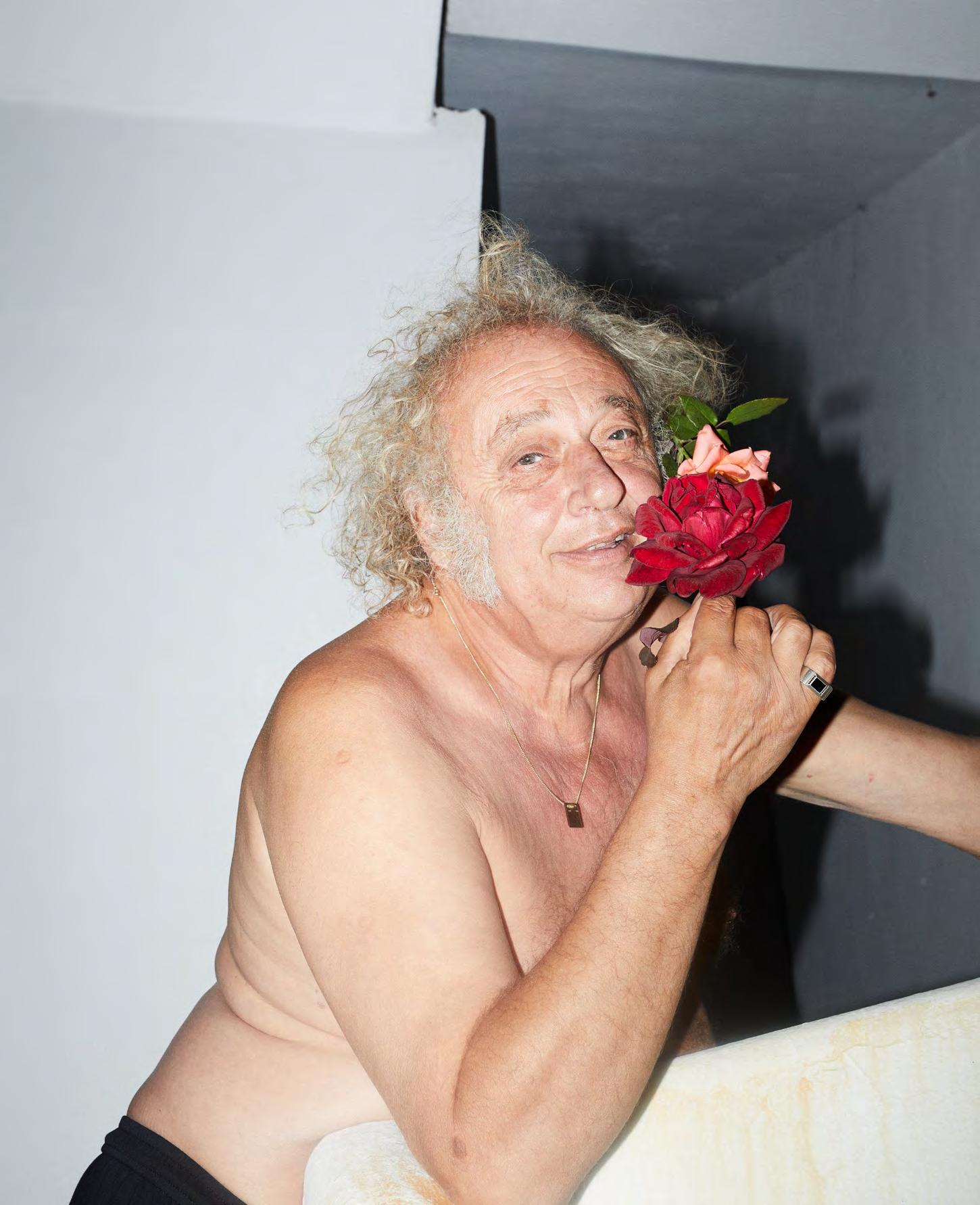
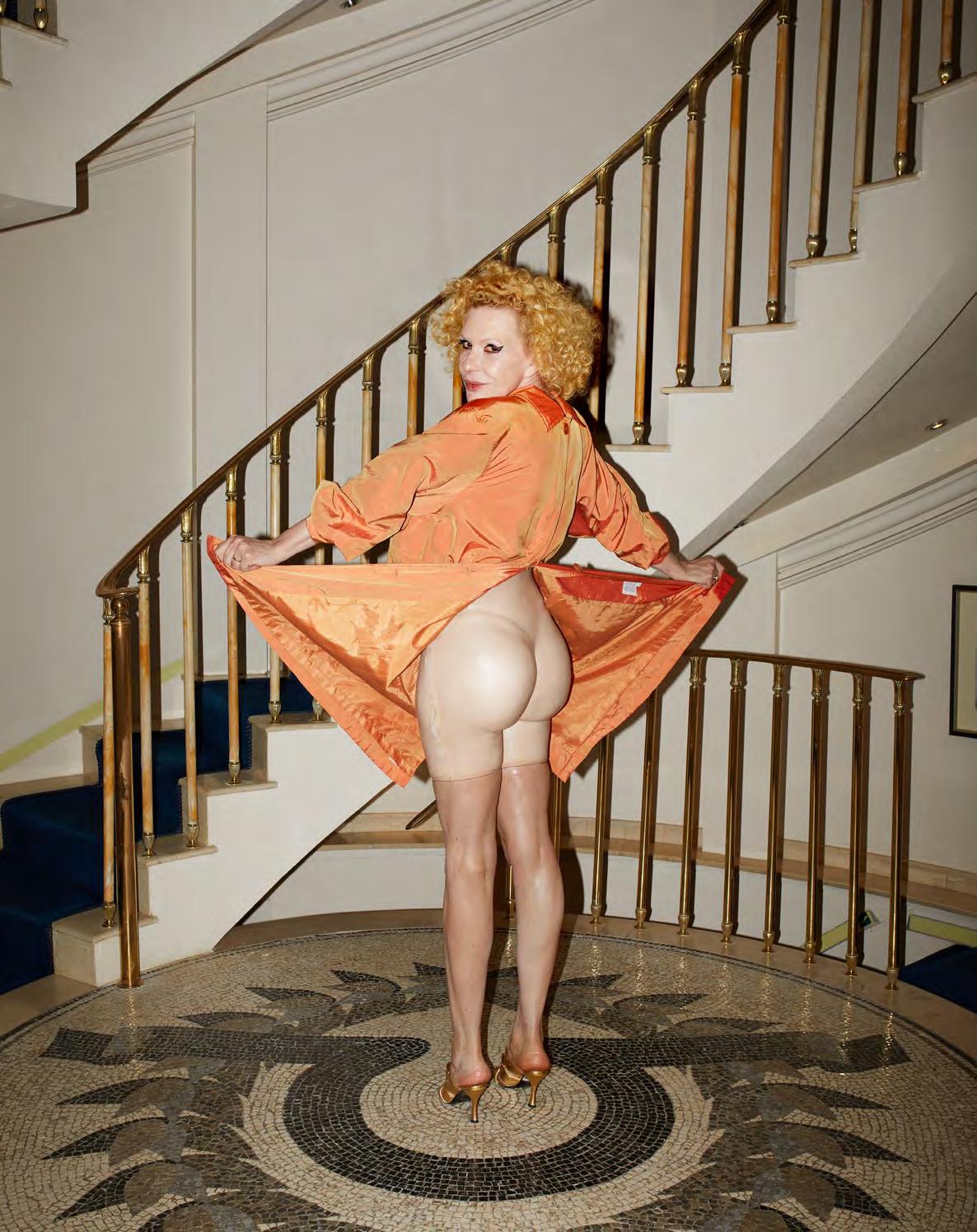

OPPOSITE PAGE Sunnyi wears a costume-made coat. Butt by Beate Karlsson, and heels by Valentino.
THIS PAGE Sunnyi wears sunglasses by Valentino.

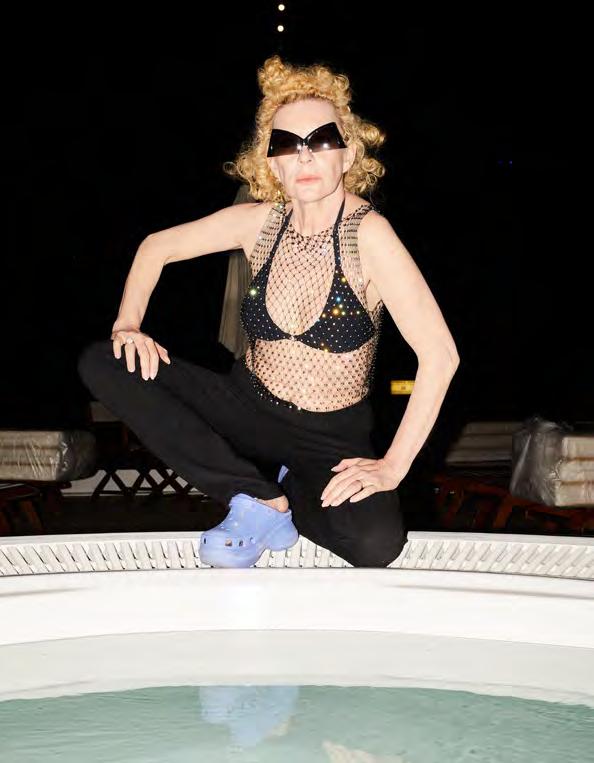

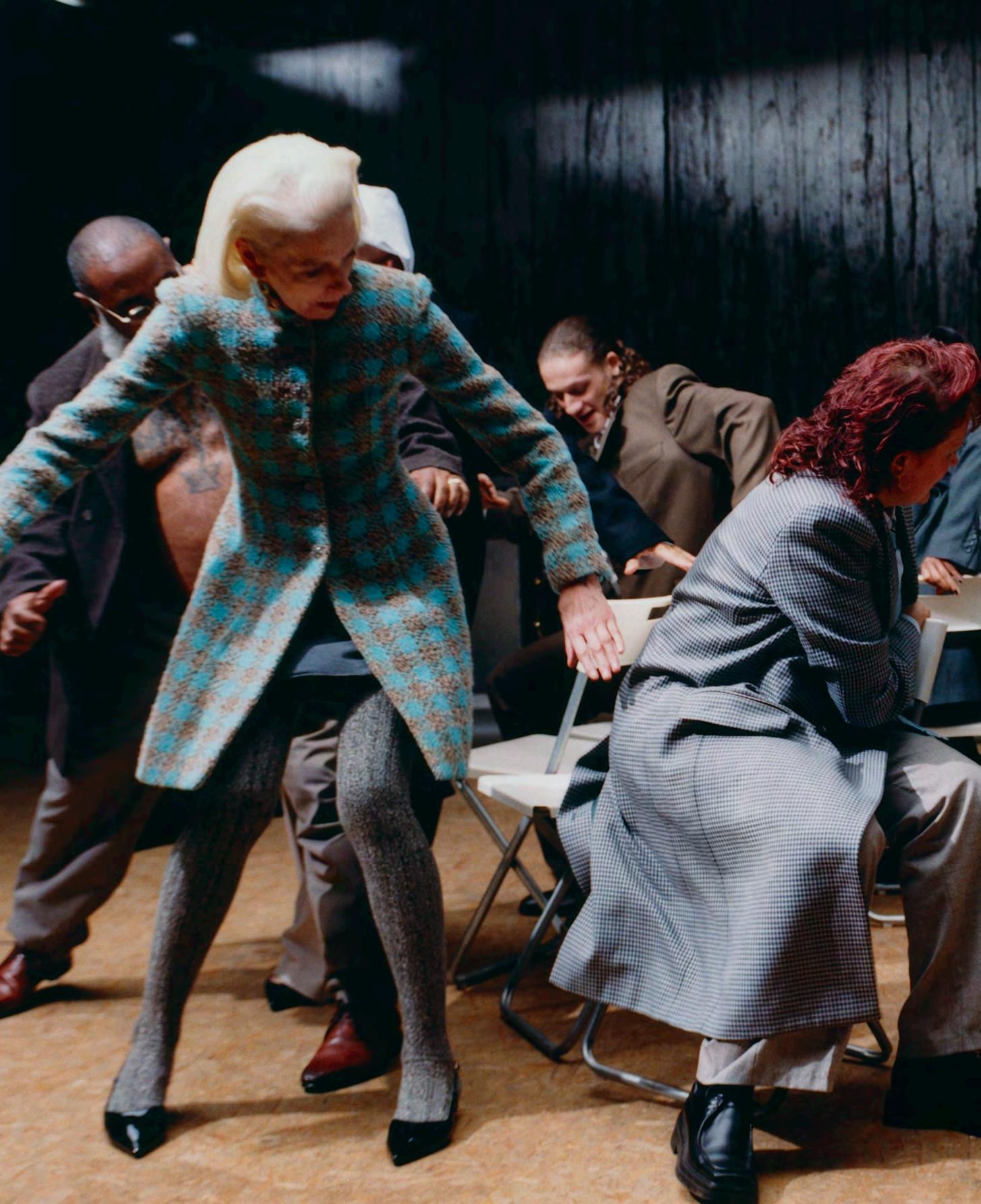
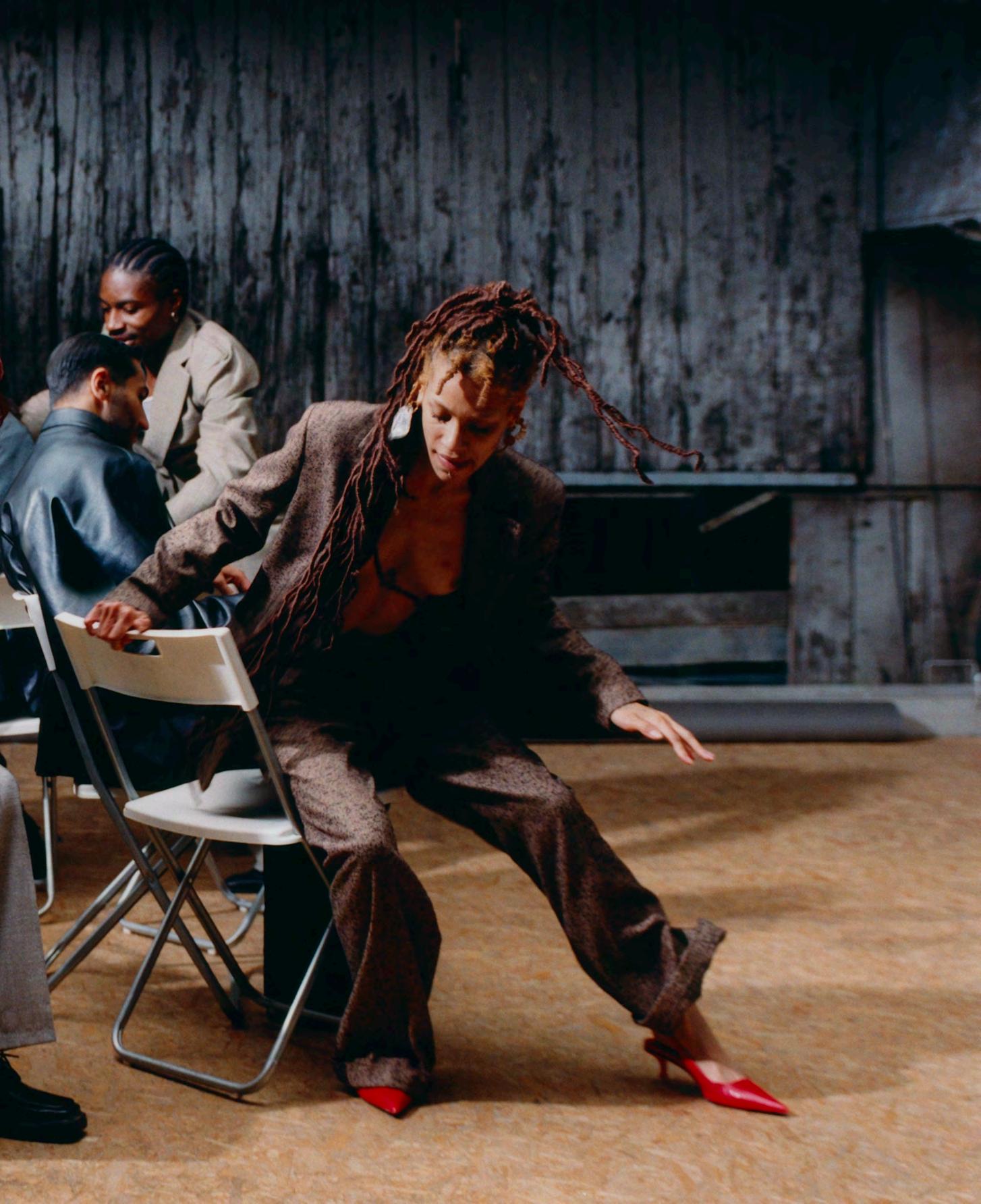
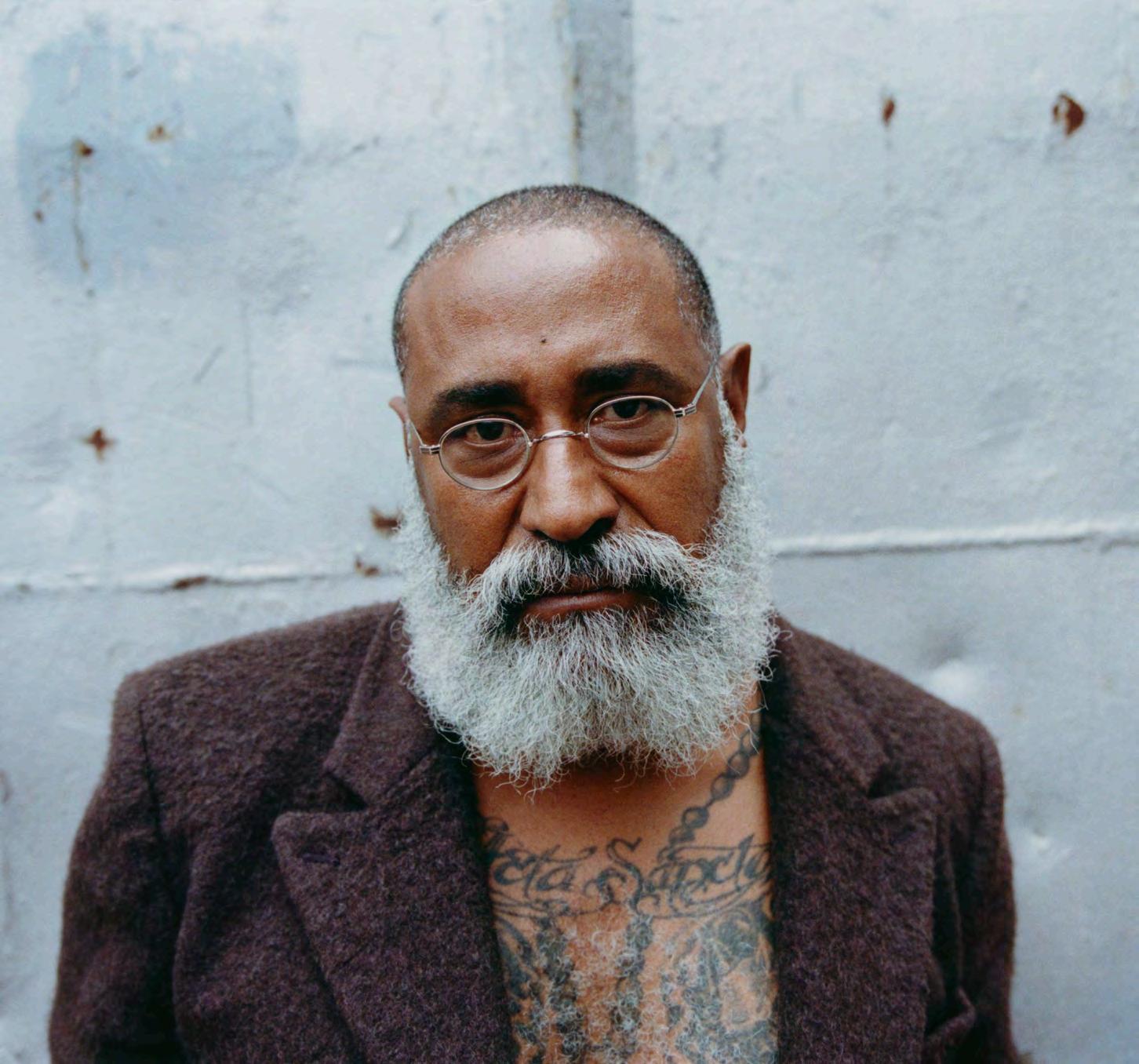
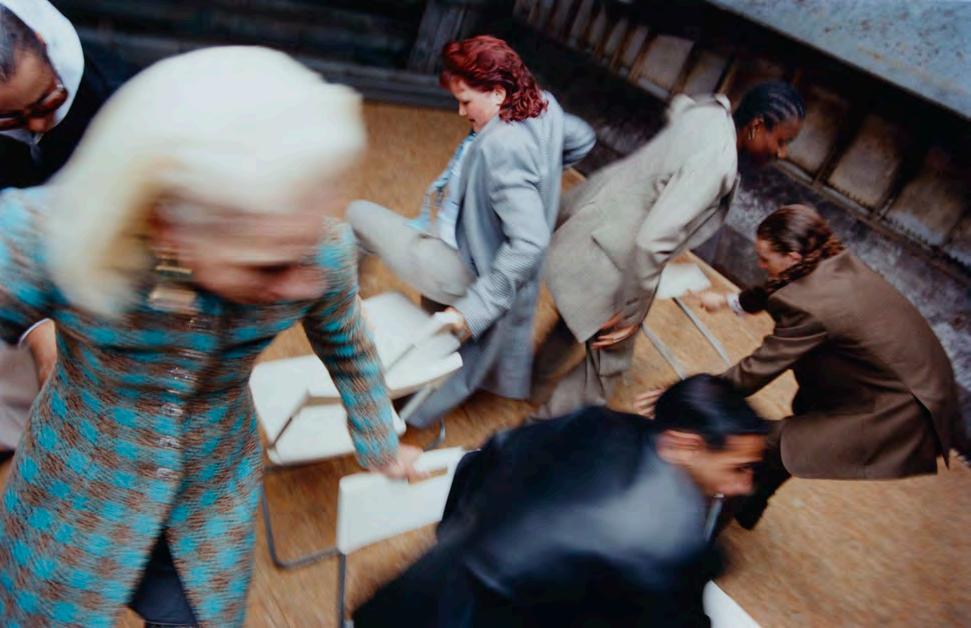
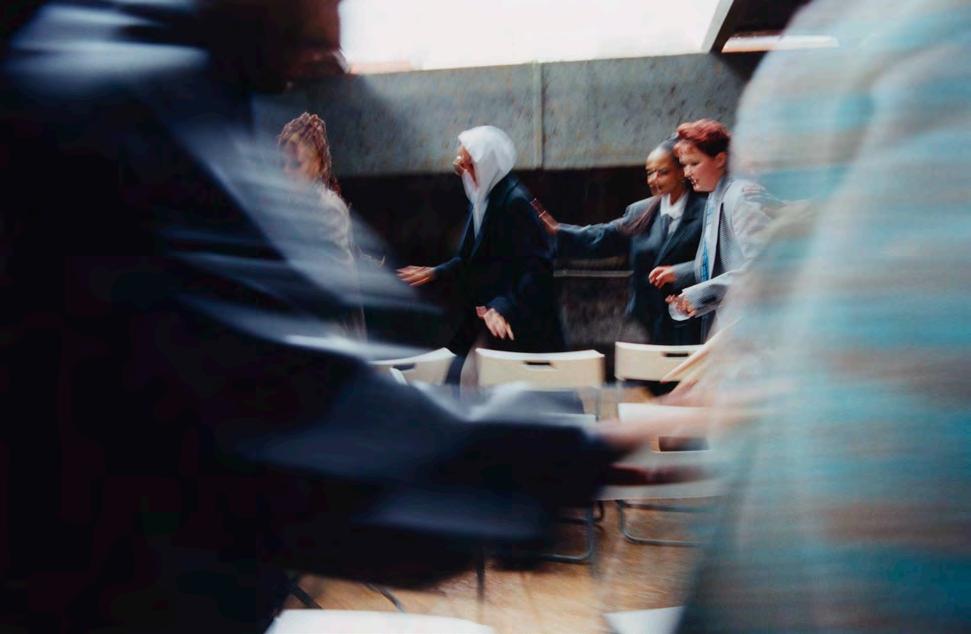
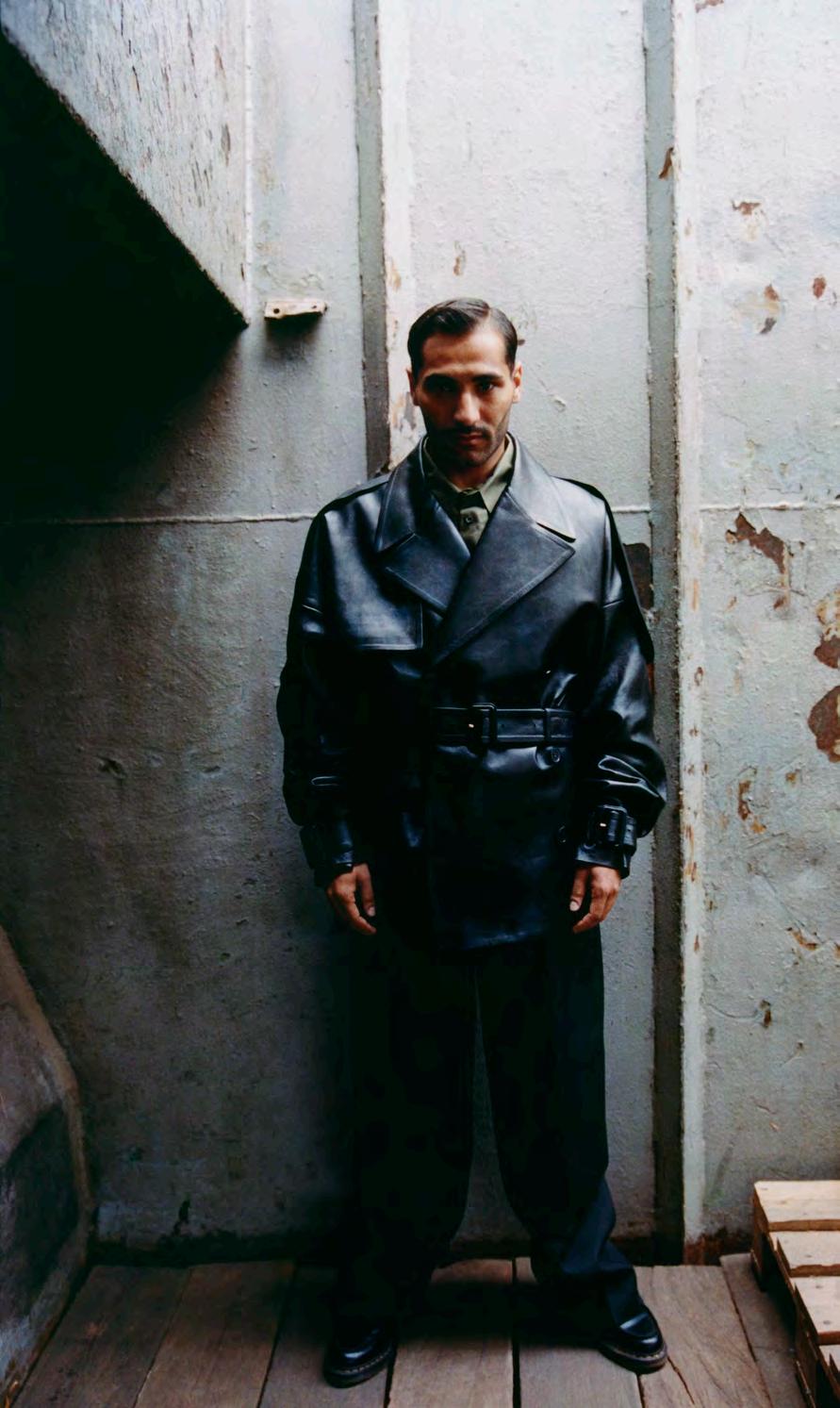



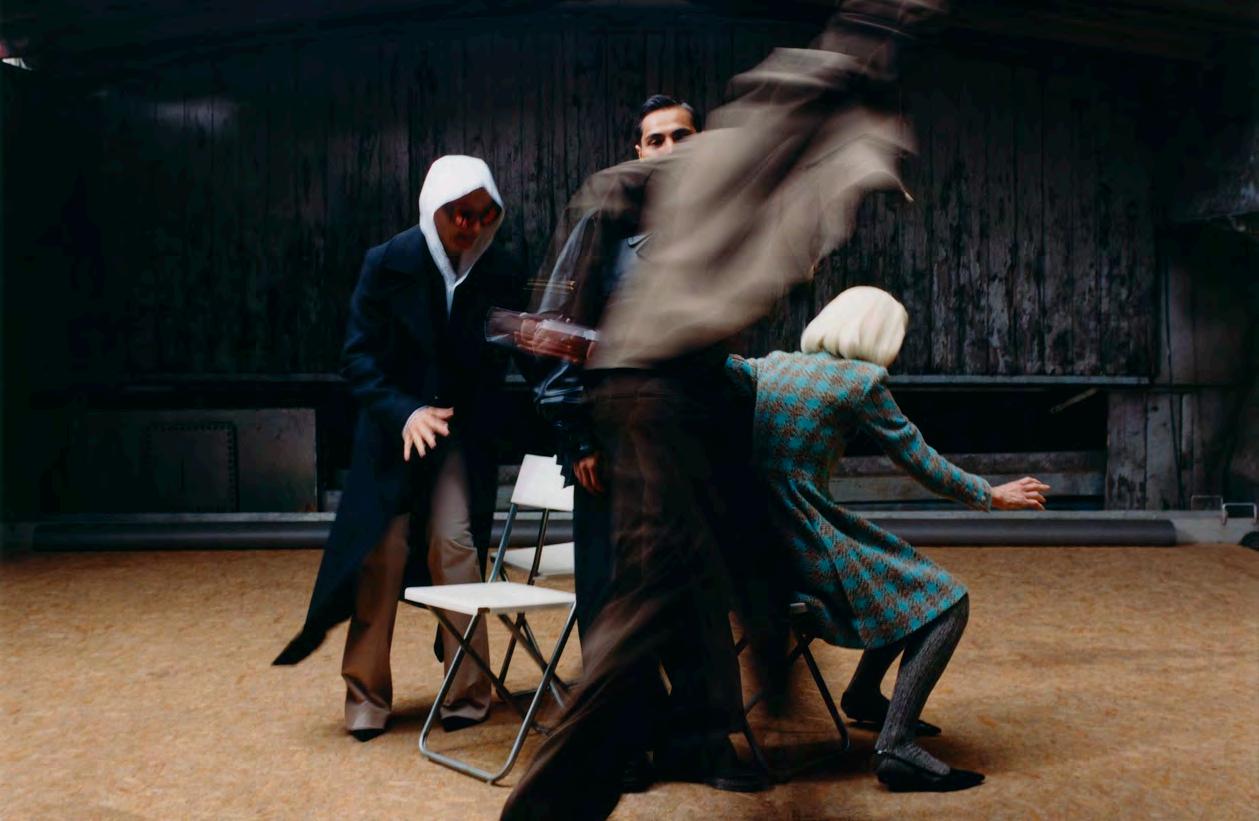

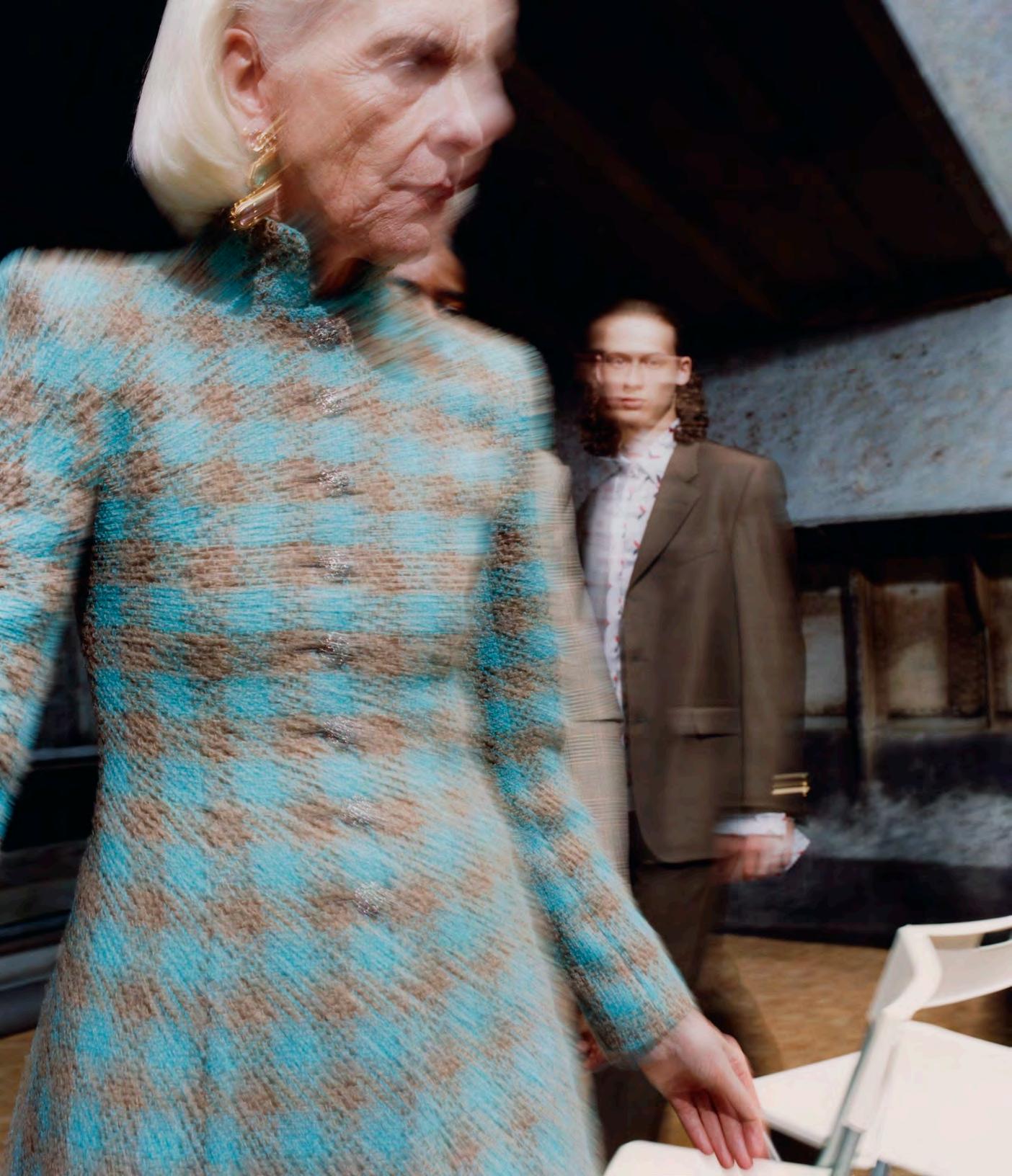
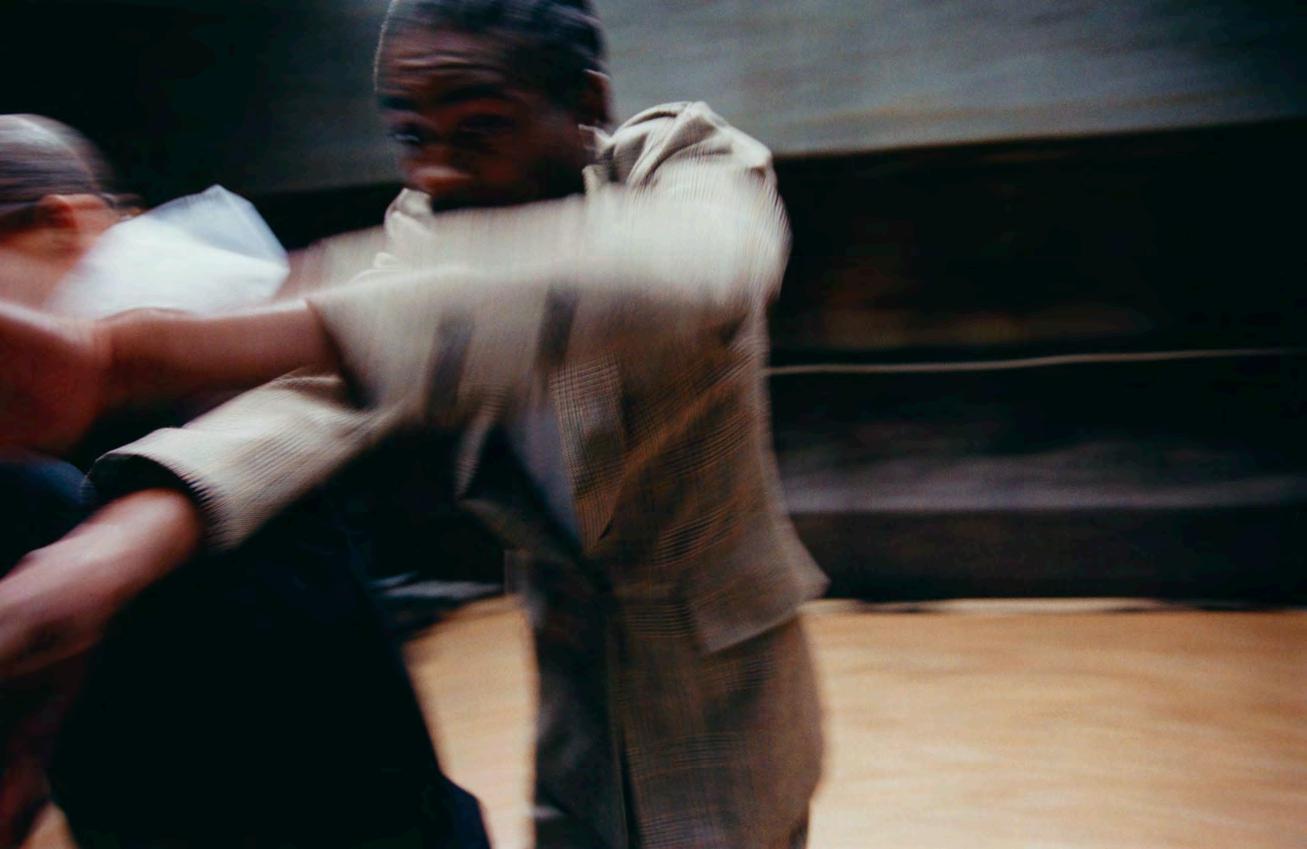

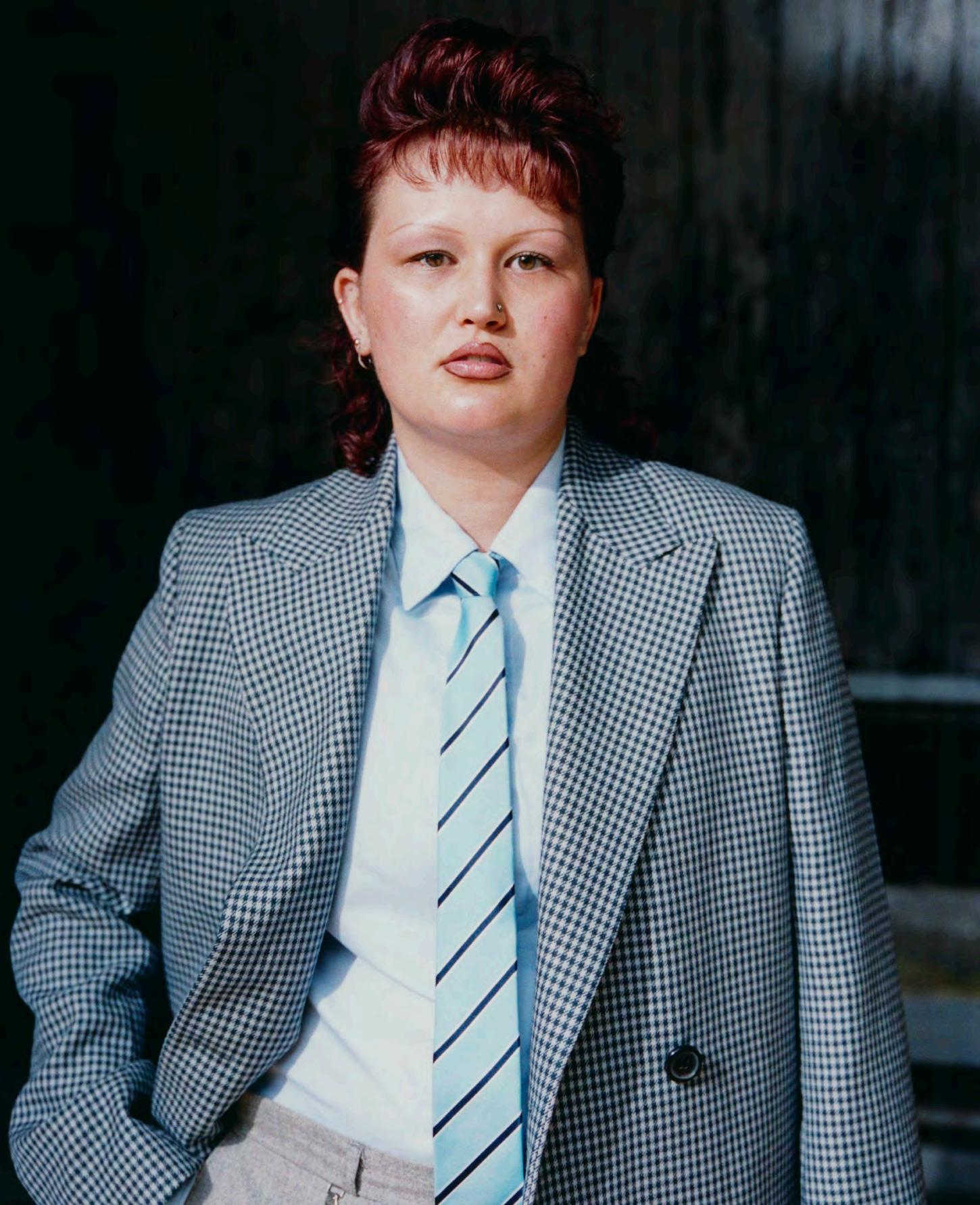 THIS PAGE suit and tank top Richert Beil, shoes Floris van Bommel OPPOSITE PAGE shirt and coat Paul Smith, tie stylist's own, pants model's own, shoes Vagabond, earrings model's own
THIS PAGE suit and tank top Richert Beil, shoes Floris van Bommel OPPOSITE PAGE shirt and coat Paul Smith, tie stylist's own, pants model's own, shoes Vagabond, earrings model's own


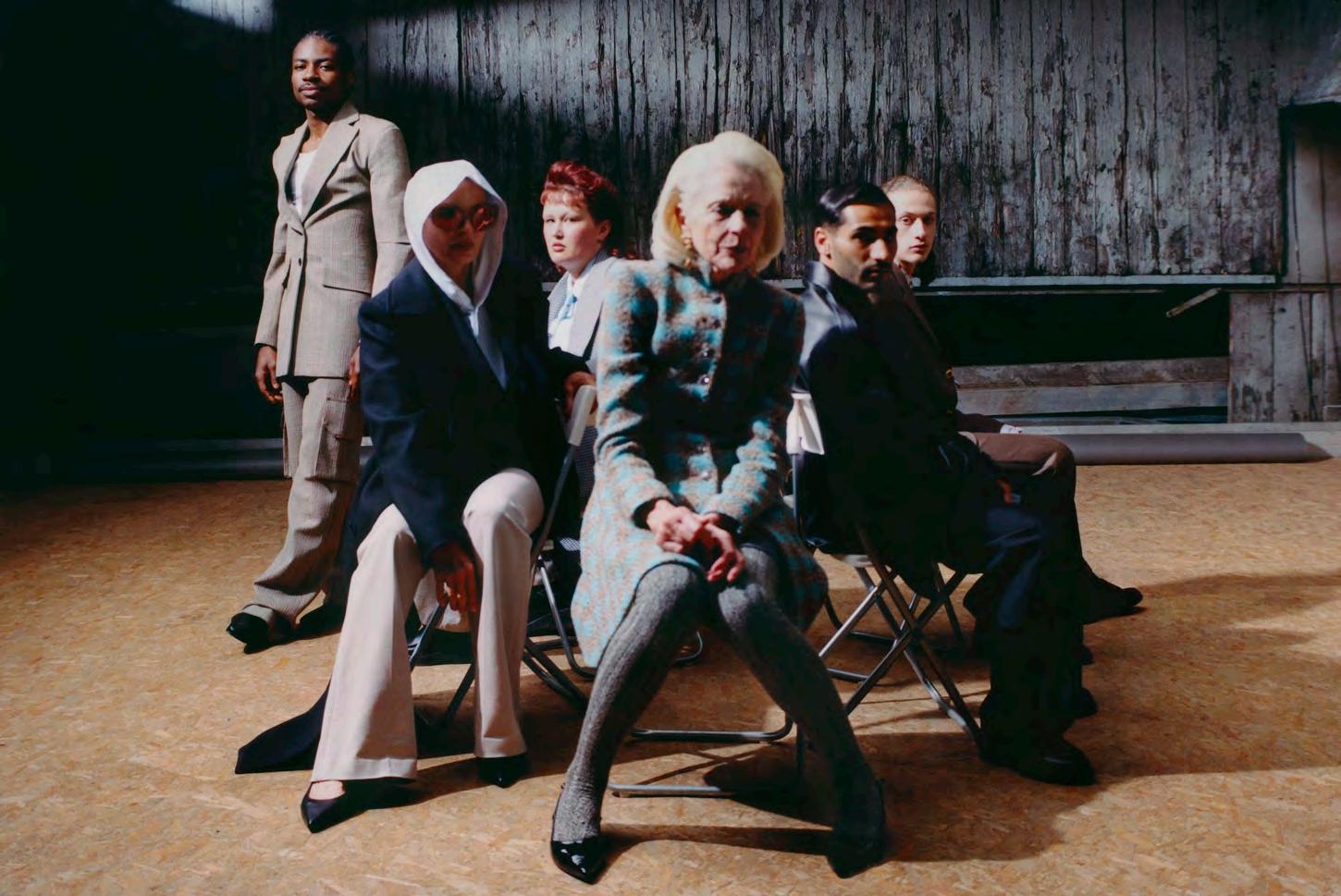
Starring POM KLEMENTIEFF
Styling IAN MCRAE (Born Artists)
Hair ERIC WILLIAMS (Streeters) (Using R+Co)
Makeup KUMA (Streeters)
Manicurist CLAUDIA DE PACE BOTARDO Production BORN ARTISTS
Stylist Assistant RUJA
Photography Assistant NORMAN CACHO
Special thanks to MIKEY BESCH, HANNA CORRIE, HANK
THE POODLE
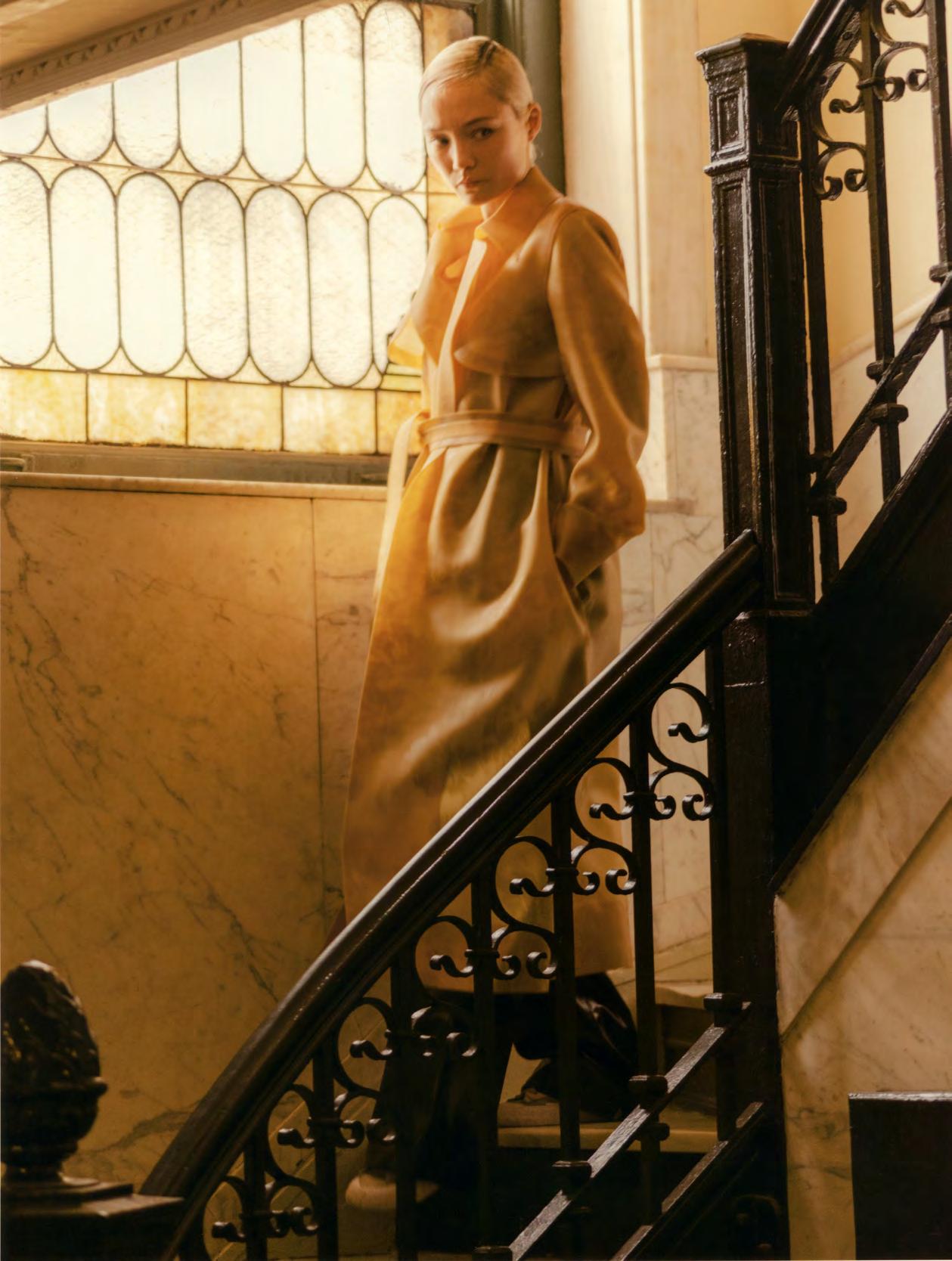



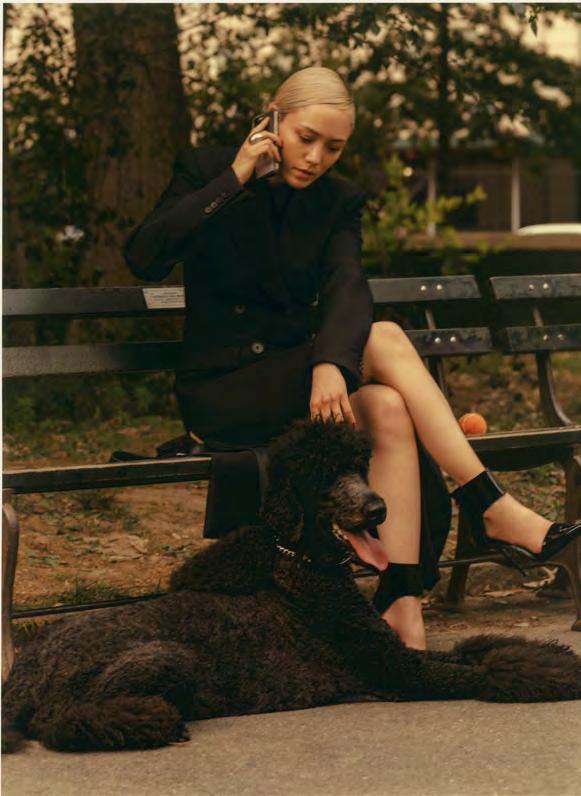
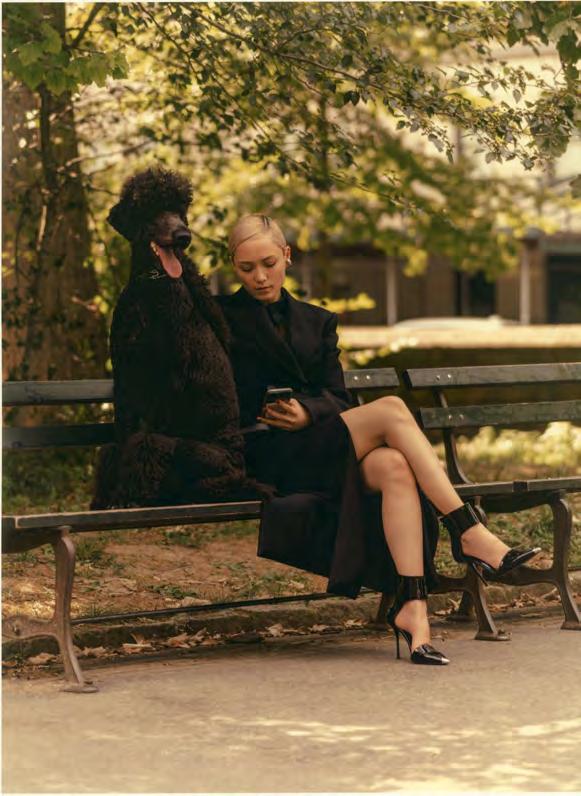
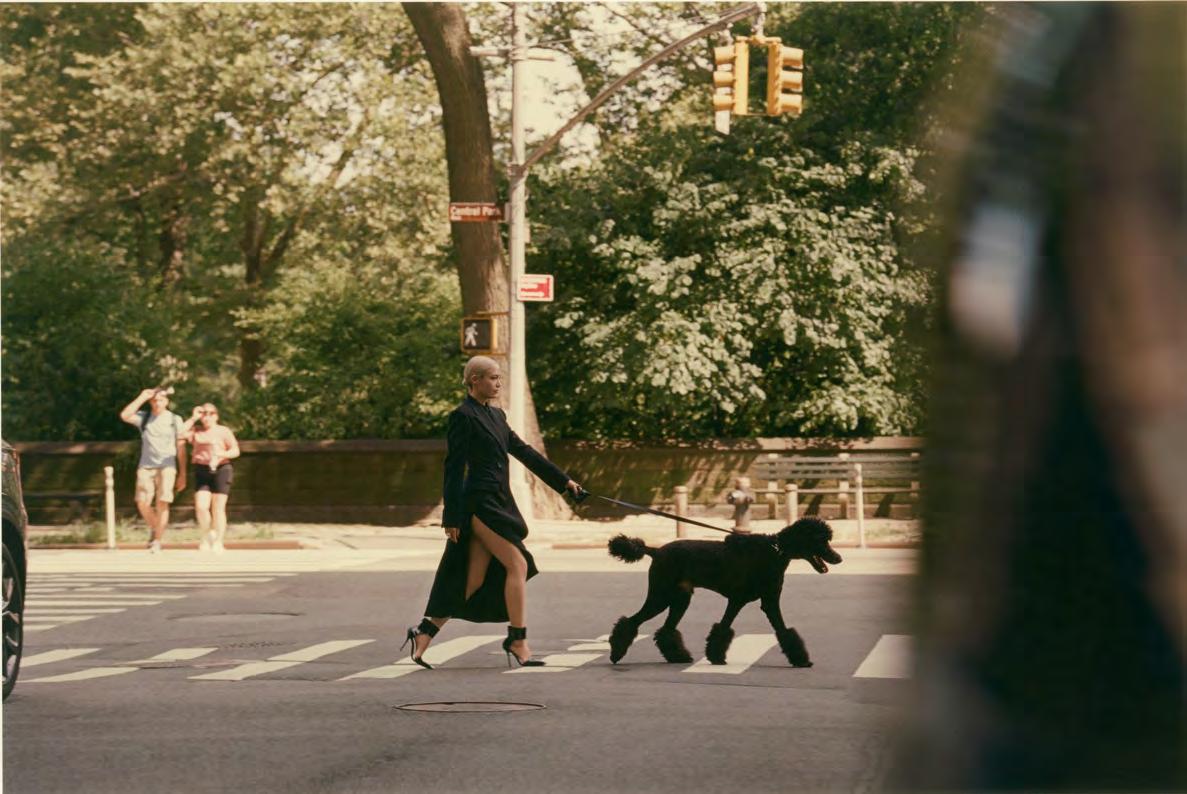

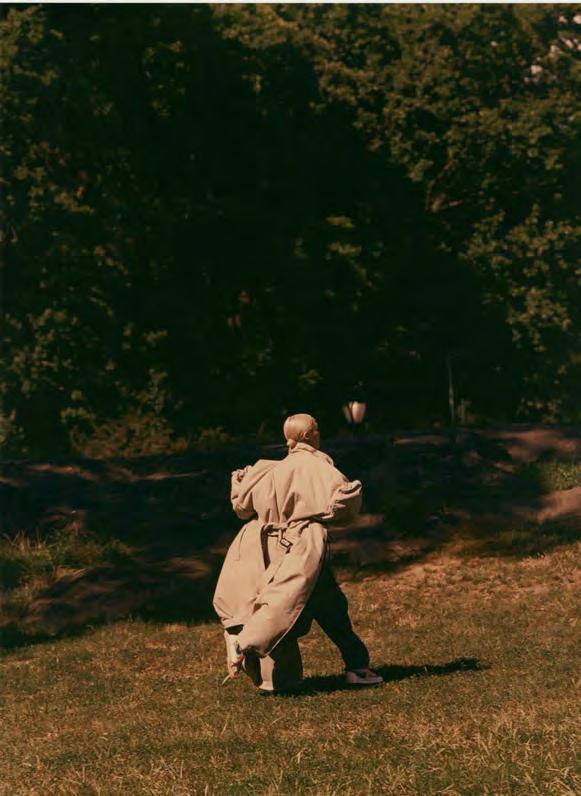
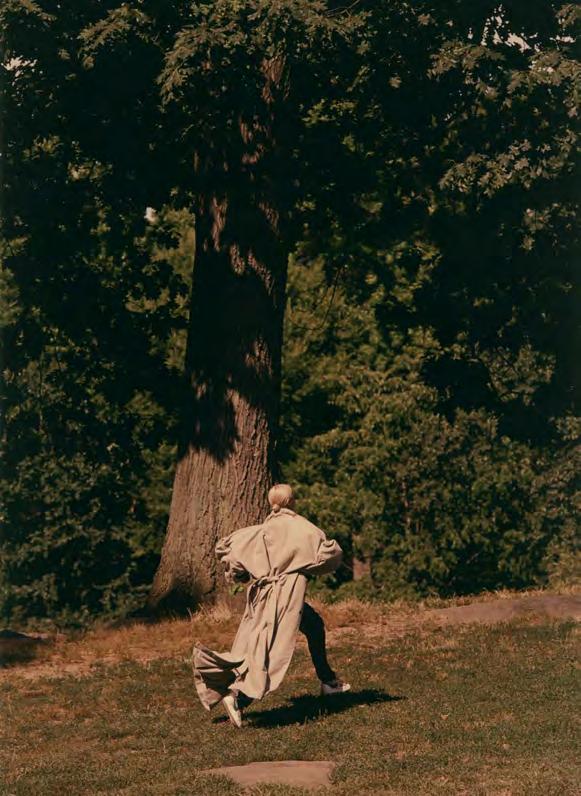

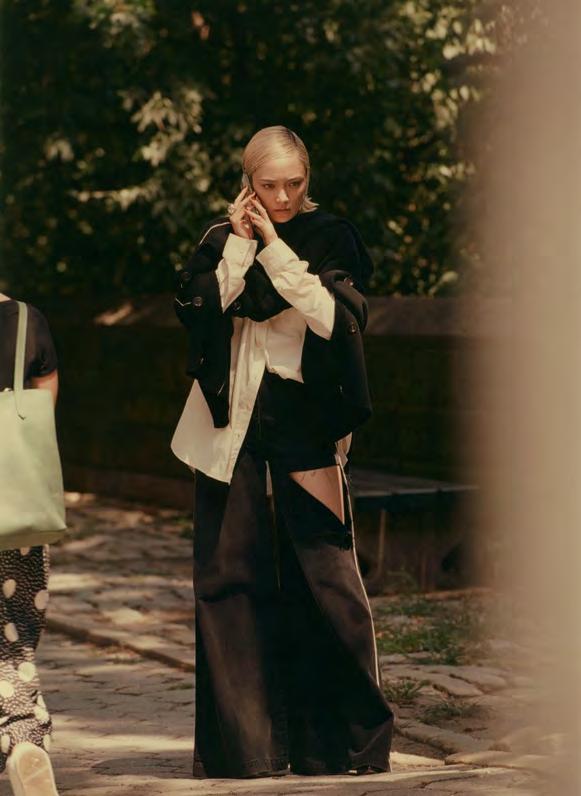



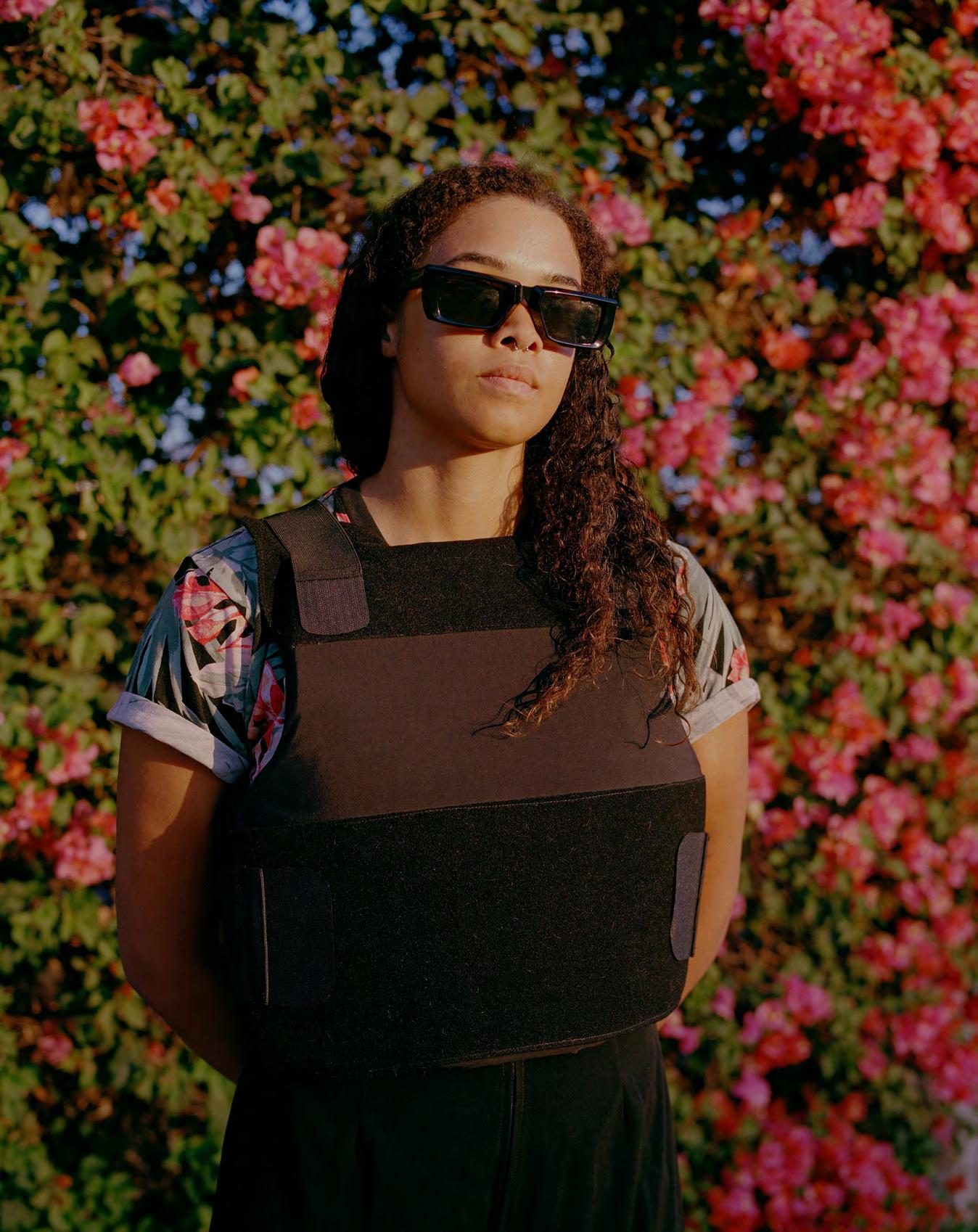
In Los Angeles the most nefarious gangs might be found in Compton, Lynwood, Downtown, and East LA, but you’ve likely never heard of them. They call themselves names like the Executioners, Jump Out Boys, Banditos, Wayside Whities, and the Grim Reapers. They flash hand signs, sport matching tattoos, their new recruits are violently hazed, and they routinely harass the families of their victims. These are the gangs of the Los Angeles Sheriff’s Department and they have been a menace to their communities for over fifty years. Cerise Castle, a Los Angeles-based investigative journalist and culture writer, had always heard rumors about the Sheriff’s gangs, and on March 30, 2020, while peacefully marching for Black lives, she was shot with a rubber bullet by a Sheriff’s deputy on the corner of Beverly and Fairfax. Unable to work on her feet for several months, she spent the rest of the year poring over hundreds of thousands of publicly available legal documents, peeking behind “the curtain of local government bureaucracy.” What she uncovered was a vast network of violent gangs hiding in plain sight. All of these files come from lawsuits that are invariably settled out of court with hundreds of millions of taxpayer dollars to avoid any deputies or victims speaking under oath. These findings were published in a 15-part series by Knock LA, prompting a slew of violent threats made to Castle and members of her family. Knowing precisely the degree to which qualified immunity provides these officers with extrajudicial power, she is careful about disclosing her whereabouts and is known to wear a bulletproof vest at times. Holding the City of Los Angeles to account has always been a cornerstone of Castle’s rapportage and it is indisputably dangerous work. This November, Sheriff Alex Villanueva is up for reelection and despite a growing body of negative press detailing evidence of unmitigated gang violence within his ranks, he and Robert Luna—both of whom are associated with gangs—took the lead in the primary respectively. I sat down for a video chat with Cerise to talk about the failures of city governance, the prevalence of police gangs in America, and the current candidates for the upcoming Sheriff’s election.
SUMMER BOWIE Thank you so much for doing this. It’s a really important component to this issue because the work that you do in Los Angeles on a local level speaks directly to where society at large is in regard to accountability. You’re challenging some of the most powerful and corrupt city officials, which requires an incredible amount of courage. How are you feeling? In your day-to-day, do you feel safe with the work that you do?
CERISE CASTLE It kind of changes day to day. A lot of my work involves going from place to place meeting people, often strangers, and discussing really sensitive issues. Some days I get death threats, so no, I do not feel safe going out and doing my work. And on days where my family's lives are being directly threatened, I do not feel safe. But 99% of the time I just have to push through, because I think the value of the work that I am doing greatly outweighs the risk. The fact that I receive so much pushback and so much negative energy from people who are the subject of the accountability is just further evidence that I am doing the right thing. BOWIE Right. The violent nature of the response speaks volumes. Before you started writing about the Sheriff’s gangs you were doing a lot of local reporting about the housing crisis. You reported on the families that were arrested and violently evicted from their homes on Thanksgiving 2020 by California Highway Patrol.
CASTLE That night was probably one of the worst things I have ever seen. Families being dragged out, sometimes by their ankles, from these homes that have been sitting empty for years. Some of those houses have been empty since the late 1950s. That is just government failure on every level. It was really hard to watch that happen. It was even more horrible to see the same images perverted by local television
news stations later that night when I got home.
Hearing commentary from helicopter pilots that were describing these families as criminals. I watched a child that I interviewed earlier that day being pulled out of a house in a hog tie position. While hearing the newscaster describe her as a criminal who was inconveniencing the neighborhood, when just a few hours ago, she had been telling me how excited she was to have her own bedroom for the first time in her life.
BOWIE They were given burglary charges rather than just trespassing, as if they were violent criminals rather than just people in search of vacant housing. We are, on the other hand, seeing the rise of organizations that are securing land trusts that are being used to provide humane housing for those in need.
CASTLE El Sereno Land Trust just purchased their first multi-unit apartment building. I am optimistic about that, but at the same time I know these groups face a lot of opposition from local government, particularly their city council members. When I interviewed [City Council Member] Kevin de Leon about some of these issues, he called them names on the record. There are videos on YouTube of him mocking these people, and that kind of hostility from local officials is very troubling. When they are discussing the needs and wants of the community, when you have a community that is so active, organized, and empowered—to be met with that response really scares me to think about the state of our democracy. In Los Angeles there is such a history of local officials putting the interests of capital and corporations ahead of their constituents. We have had several council members indicted by the federal government for issues around housing. To have those sentiments broadcast on the record with a journalist in such a cavalier way
is just disturbing, and it is not just Kevin de Leon, State Senator Maria Elena Durazo was saying the same things.
BOWIE You did a report on the Apple+ series TruthBeTold, where Downtown LA street residents were displaced so that they could shoot scenes with actors playing homeless people. It sounds like something The Onion would publish, right down to it being produced by a company called Are You Sleeping. And you even reported that the onsite doctor overseeing Covid compliance was a sushi salesman.
CASTLE Yes, yes.
BOWIE So, it seems like we have scant abilities when it comes to oversight in our communities, but there are some groups like KTown4All that are keeping FilmLA in check when they are issuing film permits. Are there very strict requirements?
CASTLE It really doesn’t seem like it. I was in a Los Angeles neighborhood just a few weeks after the Uvalde shooting and they were filming a television show where they were simulating police gunfire, and it was right in front of a school. With FilmLA, a lot of people have to sign off on that and I don’t understand how so many people can be so completely tuned out to approve a project like that.
BOWIE You have been doing a lot of work monitoring the Los Angeles Sheriff's Department. Do you know how many people they have killed so far this year?
CASTLE Oh, I was just working on a spreadsheet that tracks all of the people that they have killed or wounded since the year 2000. Lucky for you, I have updated it for the year 2022 … The Sheriff's Department has killed seven people, and we are in July, so that is around one person per month.
BOWIE A lot of your work is based on data you find in various police reports and lawsuits that have
been filed against the Sheriff's Department. Is most of this all public domain?
CASTLE Yeah, most of my data is publicly available stuff—depositions, sworn testimonies by deputies that are committing these violent acts, corrective action plans—those are forms that the county files when an incident happens to identify both the causations and the policies that need to be fixed. There aren't ever any admissions of wrongdoing, or guilt, but there are many statements of fact, which can be incredibly damning on its own. Complaints are also a great source. There are exhibits that are filed with court documents, exhibits that are filed with various motions. This also proves how much of this stuff has been in the public realm, hidden behind the curtain of local government bureaucracy. It also shows that people have known about this for decades and no significant action has been taken.
BOWIE Most of these criminal lawsuits where families are charging LAPD officers with criminal murder are settled out of court. So, is it our tax dollars that are being spent to fight against our own fellow citizens?
CASTLE I don’t think I have seen a case yet where the County Counsel has served as the attorney representing the County of Los Angeles. In every case that I’ve looked at, they always hire outside counsel. It’s usually two firms, and those counsels get paid no matter the outcome of the trial. Civil rights attorneys are only compensated when they win a case. When you hire outside counsel to defend you, you have to pay them, and all of that is being
funded by Los Angeles tax payers. We are paying a mean of $500 an hour for cases that take between three to ten years to make their way through court, not even trial, just to settle. That is a lot of hours and millions of dollars—$100 million by my calculations and that was just settlement fees alone. That did not include attorney’s fees. It is a business they have set up where deputy gangs can run rampant, abuse, and kill our community members without consequence. They have set up a machine where we are essentially paying for these families to go away, and we have been doing this for generations.
BOWIE The County Counsel concedes that the Sheriff’s Department has ‘cliques’ of officers that don matching tattoos, but they say there is nothing the department can do to ban tattoos or ‘cliques.’ You’ve identified eighteen gangs and their tattoos aren’t often a fixed design. They add smoke and bullets to them as they commit more crimes against the community. Is that right?
CASTLE I’ve discovered up to twenty gangs now. Each tattoo has its own sort of unique story and meaning behind it. One that people think of a lot that gets modified as time goes by is from a gang called the Jump Out Boys. It’s a group of deputies in Operation Safe Streets, which is ironically a gang task force. It is a tattoo of a skeleton wearing a bandana that says OSS on it. He is holding the dead man's hand—a poker hand that’s popular with police officers, and in the other hand he is holding a gun. It’s said that for each shooting a Jump Out Boy commits, a bullet and smoke is added to the revolving part of the gun.
BOWIE When you say cliques it sounds like a friendly club that celebrates how well they protect their communities, but they call themselves things like the Executioners, the Grim Reapers, the Jump Out Boys. You are a contributor to the LA Times, and they have been reporting on these gangs but not as ferociously as you have been with Knock LA, do they simply require a higher burden of proof than an independent online publication due to their higher profile? Or what has your experience been?
CASTLE Here is the thing, The LA Times used to actually call them gangs in the ‘90s. I have the clippings in my office. It has changed owners a couple of times. It is really sad to me that they have backed away from telling the truth. In 1991 they were gangs, what has changed? Arguably they have gotten more violent because we have seen more than a 100% increase in fatal shootings in the past year. I tracked the shootings myself. This year two shootings have been committed by deputies that have prior shootings on the record—one has three, the other has two.
BOWIE It seems like most of these deputies manage to stay on the force.
CASTLE Yes they are often promoted. A great example of that is Eli Vera, he ran for Sheriff and got about four percent of the vote in the primary. But this is a man that committed six different shootings. He is the department member with the second highest number of shootings. And he is allegedly a tattooed member of a deputy gang. He gave a testimony last month at a USC hearing, he spoke very vividly about how some deputy gang members had their tattoos removed, because they thought it was stupid and something that they might have regretted in the past. A member of the gang that Mr. Vera is also allegedly in, admitted he had his tattoo removed and that man was chief of staff to the Sheriff.
BOWIE Didn’t Eli Vera testify about how the thirty-six members of the Banditos that Villanueva reportedly removed had actually left voluntarily?
CASTLE Yeah, several people that were part of that have come out and said it was a volunteer move. It was Captain Ernie Chaves who admitted in a deposition shortly after Villanueva made that statement that those were volunteer transfers. Two of the founding members of the Banditos are currently on the civil commissions board fighting to get their jobs back. The member that allegedly came up with the tattoo currently serves on Sheriff Villaneuva’s security team.
BOWIE There’s an investigation being conducted by the civilian commission that oversees the Los Angeles Sheriff's Department in which a lieutenant Larry Waldie stated that the Executioners were being protected by the command staff of the LASD. Are you hopeful that this investigation will make a difference?
CASTLE I am hopeful, but we’ve had hearings like this. This is the first investigation into the deputy gangs and it cited my Knock LA series when it was announced. That felt like a mission accomplished, but it’s just the first step. There were hearings in the ‘90s about this same issue. There was a federal commission and nothing happened. The COC has subpoenaed Alex Villanueva five times now, and he has not appeared, and somehow he is not in jail right now. I have friends that have been arrested for not showing up to court. That happens all the time. I do not understand how the man who is supposed to be in charge of law enforcement in this county is somehow above the law.
BOWIE He publicly threatened Alene Tchekmedyian, the LA Times reporter who wrote about the incident where he tried to cover up the video of one of his deputies kneeling on somebody's neck shortly after the killing of George Floyd.
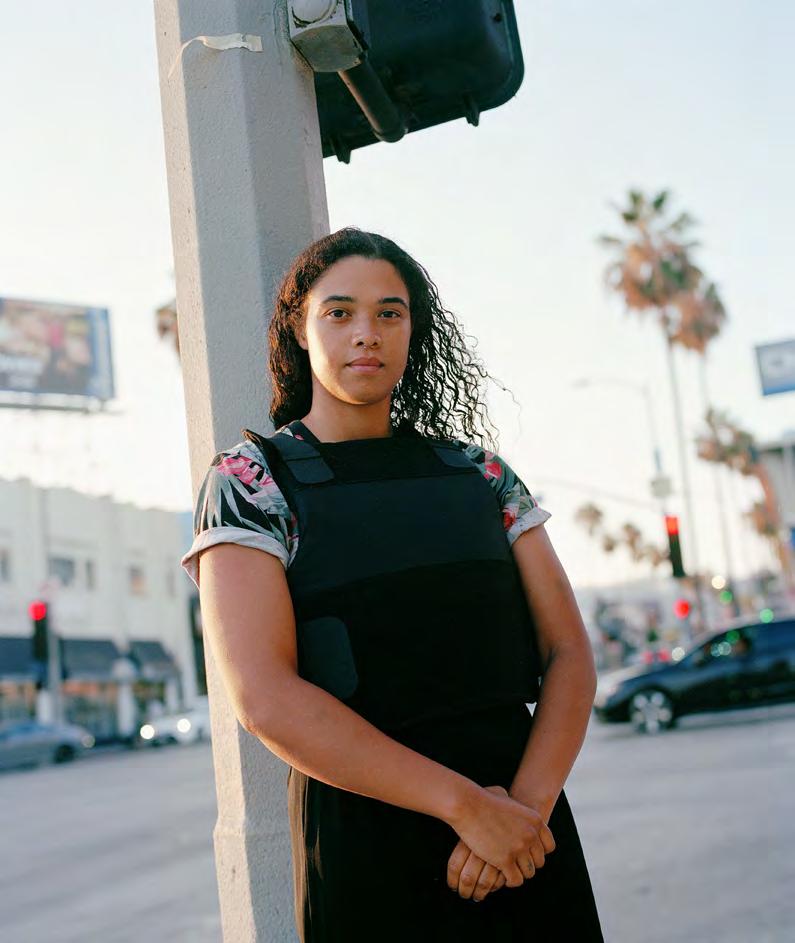
CASTLE He had a whole radio show where he went on an hour-long rant about my reporting and his campaign manager threatened to post my home address on Twitter. He called one of the board of supervisors a slur in a speech. He has also said that the all-women board of supervisors needs to be taken back and beaten into compliance.
BOWIE He’s made many contradictory public remarks, one of the more notable being that the sheriff’s gangs don’t exist, but that they also exist in every city and no one has done more to clean them up than him. Do you think these gangs exist in every city?
CASTLE I know they do. I hear from police officers across the United States almost every day, asking for me to come investigate their department, sending me things they have seen in their locker rooms, in their courtrooms, inside their holding cells.
BOWIE I mean we have movies like Training Day, but do people just assume this is fiction?
CASTLE A civil rights attorney said to me recently, “People do not want to recognize it as real, because if they accept that it is real, then it can happen to them, and that is a really scary thought.”
For this deputy crime issue, oftentimes people say, “Oh, that is a thing that happens in South Los Angeles, places where poor Black and Brown people live.” But I know deputy members that are working in Malibu, West Hollywood. I know deputy members that have killed white people in affluent areas. I was just reading about a seventeen-year-old child, a white child, that was killed in Studio City by a deputy that worked at a station affiliated with the Grim Reapers gang. People like to imagine that they are exempt.
BOWIE We're constantly seeing cases of excessive force in social media and on the news, but people still seem to believe that it's rare.
CASTLE Yeah, I have also found out through a public record request that the Sheriff’s Department assigned crime analysts to monitor my social media.
Getting shot with a rubber bullet, that was a really horrible experience, but ironically it is that event that led me on this journey. I was put on bed rest for six months, I couldn’t walk and I couldn’t do any field work. I was just on my couch and was supposed to stay still, which didn’t feel like the right thing to do. So instead, I started to research deputy gangs. It’s something I’ve heard about since childhood, something I always had questions about, but the newspapers and my colleagues were not covering it.
BOWIE How exactly did they end up shooting you?
CASTLE I ran into a film crew from Vice that I used to work with and we were just catching up at the gas station. I heard people screaming and saw police in riot gear on a truck pulling into the intersection, they got off and just started shooting randomly. No warning given, no dispersal order. It was what I imagine a war zone would be like.
BOWIE We were there as well and everything was so peaceful for hours, then suddenly out of nowhere, the police started coming out in riot gear and a mysteriously abandoned cop car was sitting in the middle of the intersection on fire.
CASTLE Deputies have told me that they will leave old cars along routes of demonstrations that are happening in the hopes that someone will deface it or do something to it.
BOWIE When did you start wearing a bulletproof vest and do you still wear it?
CASTLE I started wearing it after I got multiple, very specific death threats. After being shot, not with a metal bullet, but it can still kill you or give you lifechanging injuries, so it is something that I use when I think I need it. But I still take precautions. I take them every day when I go outside. With this kind of work, you do have to be a little paranoid. There are many sources of mine that have had their lives
threatened, been shot at, had their lug nuts on their tires loosened, had police officers showing up at their offices with keys to their doors for some reason. I hear these stories and I learn to be careful. I have been advised by people on the inside of this issue to take steps, and that is not something that I take lightly.
BOWIE More than half of the candidates who ran against Alex Villanueva for Sheriff in the primaries this past June are associated with deputy gangs, like Eli Vera. How does Robert Luna ,who is currently in second place, compare with Eric Strong, who is currently in third place?
CASTLE Robert Luna is an outsider when it comes to the Los Angeles Sheriff’s Department, but he is no stranger to controversy. Famously in the Long Beach Department under his reign there has never been a Black woman promoted above the rank of lieutenant. There has only been one Black helicopter pilot in the history of that division and he quit after he was subjected to years of horrible racist treatment. I believe they were leaving racist caricatures at his desk and calling him slurs. Robert Luna brought back a practice that went out of style in the late 1960s of going into gay bars and trapping queer people. He also oversaw the use of an application called Tiger Text, which is a self-deleting text messaging app that he encouraged Long Beach Police Department personnel to use. There are thousands of text messages that we will never see that pertain to cases. He oversaw a surveillance program of demonstrators that were coming out to the Black Lives Matter protests and had hundreds of people entered into a facial recognition database simply for being at a protest in defense of Black life. These are troubling actions.
BOWIE Do you know if Eric Strong has stated his position on qualified immunity? Can you explain a little bit of what that is?
CASTLE He is against qualified immunity, which has been around since the late ‘80s and is essentially the notion that if a police officer kills someone, they are protected. Let's take the shooting of Frederick Holder: this is a young man that was driving a box truck, stopped at a red light, and three police officers ran up and fired on him. Thirty-three shots were fired at Fred and let’s say this goes up to federal court, these deputies can say, “I didn’t know that we couldn’t run up behind someone and shoot them in the back.” Qualified immunity allows them to do that and get off.
BOWIE It’s amazing. So long as the policy is on the record, the departments can’t be held accountable because the police officers are not required to know or remember that the policy exists. What is the Police Officer’s Bill of Rights ?
CASTLE It basically makes us all second-class citizens. It ensures that if a police officer is being charged with a crime, they are not allowed to be questioned during working hours, while they are on the clock. Before they are questioned, they are given all the evidence with an attorney and their union representative telling them how to respond to things. If charges are not filed within a year, they cannot be prosecuted.
BOWIE It would be really nice if we were all afforded that.
CASTLE It would be really advantageous. Imagine someone stole your car and their defense is “I didn’t know that I couldn’t do that,” and they would get off with that. Or if someone assaulted a family member, that person could have an attorney helping them to answer questions and if it takes the district attorney more than a year to put a case together, they can never be prosecuted. It sounds crazy, but those are the realities for police officers.
BOWIE Maxine Waters has called for a federal investigation into the LASD. What would real change require?
CASTLE Real change would require firing these people. There is a lot of talk about transferring those individuals and breaking up the gangs, but that is already what’s happening, and it just allows the culture to spread and grow. You have a whole new generation of younger deputies being trained by these people, which just keeps the practice continuing. These people need to be fired and these tattoos need to be banned. I really think those are the minimal actions.
BOWIE Should a tattoo be a fireable offense?
CASTLE It is in the military. When you join the military, you have to strip and everything is documented. This is a paramilitary organization. Why are we not doing the same thing?
ABOVE tattoo for the Jump Out Boys, a skull with glowing red eyes wears a bandanna with the letters OSS (Operation Safe Streets), the background features an ace and eight of spades or the “Dead Man’s Hand.” BELOW tattoo for the Compton Executioners on the calf of former deputy Mizrain Orrego. A skeleton wears a Nazi-style helmet labeled "CPT" (Compton) and holds a Kalashnikov rifle with '28' (LASD's 28th substation) in Roman numerals on the magazine.
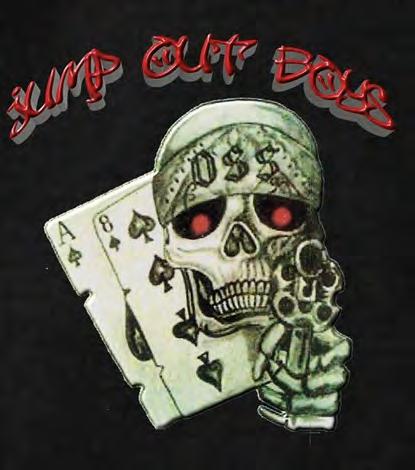


Sex, desire, fear, violence, religion, and primordial animalistic frequencies run through Jordan Wolfson’s oeuvre like a polygraph of our contemporary subconscious. There is a primeval and ancient yearning that pulsates like an uncontrollable muscle spasm. In works that span a plethora of technological 21st century media, from animatronics that make piercing eye contact, to an assault of holographic imagery, Wolfson’s art is the bright white highway rumble strip to the heart of our uninhibited id as it skids through the divider and into the great dark unknown. His breakthrough, Female Figure (2014), is a gender bending asteroid in the art historical canon and left a crater as deep and as fraught as Marcel Duchamp’s proto-Dada porcelain urinal (Fountain, 1917) or Jeff Koons’ highly sexualized “Made In Heaven” (1989) series, which depicted himself and his then wife, the adult film star Cicciolina, in hypersaturated pornographic bliss. Scuffed, but not bruised, and wearing a bustier and translucent skirt, the animatronic Female Figure dances in front of a mirror to appropriated music and personal narration by Wolfson, utilizing advanced facial recognition software to lock eyes with the viewer through a horrifying green witch mask. It is a conundrum of formality that crashes between the subjective and the objective. It is a Freudian paradox of shame and lust. Other works also lock eyes with the viewer: Colored sculpture (2016), an oversized animatronic puppet with a shock of red hair and demonic smile that resembles Howdy Doody, Huck Finn and Alfred E. Neuman, can track the presence of up to twenty viewers at a time. Strung by chains to a gantry system that forces the figure to crash violently to the ground, leaving a build up of residue and skid marks, most of the score is the sound of a body hitting the floor and metal rattling, and briefly, Percy Sledge’s “When a Man Loves a Woman” (1966). It is a solo dance of masochism and exhibitionism— all while two bright blue eyes transition from meeting your gaze to flashes of psychologically triggering imagery. Other works also question the very concept of morality, like one of his latest, ARTISTS FRIENDS RACISTS (2020), which offers a crescendo of themes that pertain to our present-day psyche: racism, homophobia, police brutality, terrorism, contemporary art, childhood trauma, Jewish identity, and more. Composed of HYPERVSN 3D displays on fan blades that produce multiple holographic images, the work is an earth-shattering and absorbing spectacle akin to watching your life flash before your eyes. A large exhibition of Wolfson’s work will be on view at Kunsthaus Bregenz, Austria until October 9th. And opening this October, Female Figure will be on view at The Brant Foundation’s New York space.
JEFFREY DEITCH I always like to start with the trajectory. I am fascinated by how with all the different options to direct your life, you became an artist, and an artist who is redefining what an artwork is. So, can we go back to Connecticut?
JORDAN WOLFSON My childhood? Yes. My father’s father was a hobby painter. My mother’s mother was a hobby painter. Neither of my parents are artistic, but one of my sisters is also artistic. So, I think it is a genetic thing. I was a regular kid, sort of. I had a lot of learning disabilities. I had a lot of organizational problems. I had some behavioral problems as well. I acted out—I think that was from the frustration of the learning disabilities, and I was always aware of art. My family always respected art. It was not a shameful profession to go into. It seemed like a sacred profession. Artists were considered important people within culture by my family, rather than bohemian outliers. So, when I decided to become an artist when I was sixteen years old, my family embraced it. Before that, I didn’t really know what I was going to do. I thought I would be a middle-of-the-road graphic designer, or someone who worked in an eclectic video rental store. I didn’t have that high of standards for myself. I had a fantasy about being a professional skateboarder, but I was never as good as the people who were physically fearless. I remember looking at someone doing something dangerous and I thought I would never be able to put myself through that physically. Yet, when I started doing art, I immediately thought of that person skating—I realized I could never do that physically, but I could do that artistically.
DEITCH Looking at a number of your wellknown works, it is interesting that you put yourself in danger in a different way.
WOLFSON I try to push both formal and moral limits. The art world that I come from told me that pushing the limit is what makes something a good artwork, an active object. How is the artwork good if it’s not pushing the limits of volume, or color, or a moral position? If it’s not trying to interfere, in whatever aspect, physically, morally, et cetera, how could it be a good artwork? You can talk about artists like Henry Moore—he pushed the limit of form, or you can talk about Cady Noland—she also pushed the limits of form and morals, as has Kara Walker. Charles Ray is also pushing the limits of content and material. Michelangelo's
David completely pushed the limits of how we look at the human body.
DEITCH I first became aware of you through your video collage works. Did you have a more conventional artistic start, or were you more interested in technological mediums?
WOLFSON I went to Rhode Island School of Design. In the first semester of my freshman year, in a 2D class, we were drawing on Super 8 film that we would project to create a sort of abstract animation. I thought it would be interesting to videotape the projection. It required less effort and the work potentially had
twee, moral, and crafty. I reminded the faculty and myself that I was only in this department because I wanted the option to make video installations, or whatever I pleased. I was at odds with the faculty for the most part and to satisfy them I agreed to make one sculpture for a wood lamination assignment: I carved a photo-realistic pillow out of wood, inspired by Felix Gonzales-Torres’s Untitled (1991), a billboard work of a recently slept in bed. They thought after this moment, I was going to do sculpture, but I said, “No, I made a sculpture— now I am going to make video installations.” I was young, defensive, and arrogant, and at odds with the department, but they also deceived and resented me, and ultimately, I reacted the best way my twenty-year-old self knew how to.
more aptitude than a two-dimensional painting. I kept on experimenting and I tried to make another one, but it was not the same because I was copying myself. Then in February 2000, I recorded my grandfather’s 100th birthday. I shot on a wide-angle lens and positioned the camera in the center of a white table that my grandfather was sitting at, I pointed the camera at different passing people who would lean in or sit down with him, and give him a kiss. I sped up the video to about 190%, but when people kissed him, it would slow down to 30%.
When I showed it in school, it generated a lot of feedback. There was something about the idea of a piece of video art as a sculpture. The video was a loop and that suggested it was an object.
There was no beginning and no end. The loop suggested that you could walk in at any time. That is the same as walking in on a painting, or a sculpture. No one tells you when to walk in on a Brancusi sculpture. So, I became obsessed with videos as objects.
DEITCH Were you making paintings and sculptures?
WOLFSON At RISD, the coolest department was painting—the coolest artists, the most cutting-edge ideas—best and most relevant teachers—but I thought that if I went into painting, I was going to be stuck making paintings, and if I went into the film and animation program, I would have to create short or experimental films, which I was not interested in. So, I went into the sculpture department, where I could retain the option to make whatever I wanted. At the time, the department advertised itself as multidisciplinary, but in fact it wasn’t, it simply couldn’t compete with the popularity of the painting department, so they told the students this to attract us to join. The heads of the department mostly made “New England post-modern sculpture,” which I found
DEITCH People are so fascinated with an artist’s formation. All the people who think they want to be an artist, all the people who are taking classes at RISD, or other art schools, but such a small number make an international impact in the course of art history. How does this happen?
WOLFSON I was ambitious, and mostly out of fear that if I couldn’t be an artist, I would be living the life of my learning-disabled self before becoming an artist. So, I was desperately trying to save my life. I didn't want the art career for money or vanity, even though I can’t deny that I saw the seductiveness of those things. For my junior year, I left RISD because of the attitude of the sculpture department. I attempted to apply as an exchange student at Goldsmiths because I was excited by all the YBA (Young British Artists), but my application got damaged in the fax machine. I thought it was kismet. So, I went to an art school in Sweden called Konstfack. I also thought—in my “save-mylife-mission-mindset”—that I was going to go to this small European city and get a show at a reputable art gallery and start my career. And somehow, miraculously, or because I showed my work to literally everyone, by the end of my junior year, I had a solo show at the Galleri Andreas Brändström & Stene. Andreas was an important gallery in Stockholm in the ‘90s. He represented artists like Clay Ketter, Spencer Finch, Olafur Eliasson. He reopened in 2002, and I was one of the first shows in his project space on Nybrogatan 25, which was in the center of Stockholm. Part of me thought I should stay in Sweden, as I had a gallery and finally a career, but I was miserable and depressed, and I was still in school; and my heart was broken by the daughter of the cool painting professor at school, not to mention the weather was bleak. I also felt that I wasn’t good at making art outside of the USA, that there was something about living in my target that was beneficial to my creativity and intuition. So, I went home and reenrolled at RISD in January 2003, graduated in May, and then moved to NYC.
"It’s a story about trying to save your life, but then at the same time realizing it’s about being your true self "
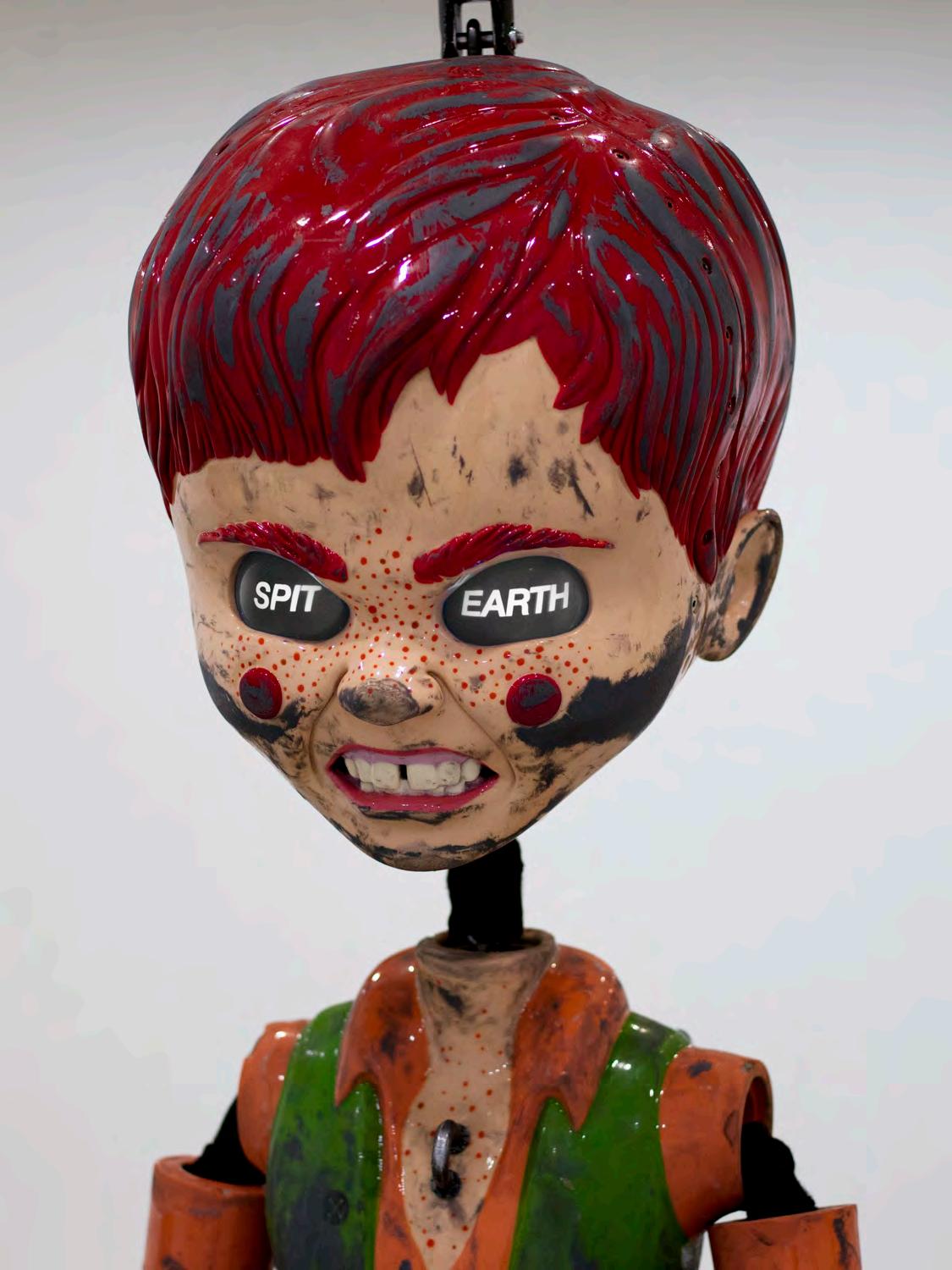

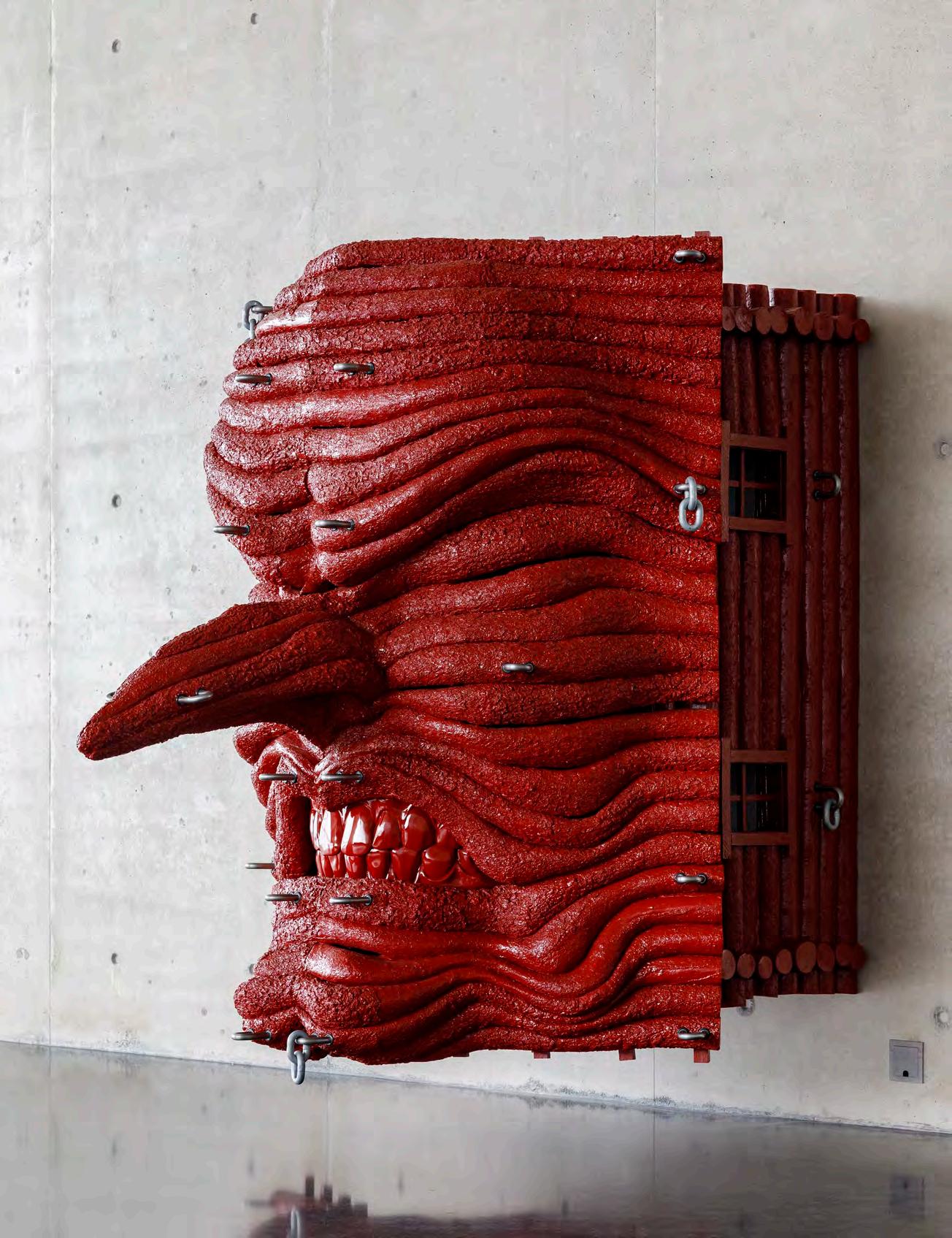
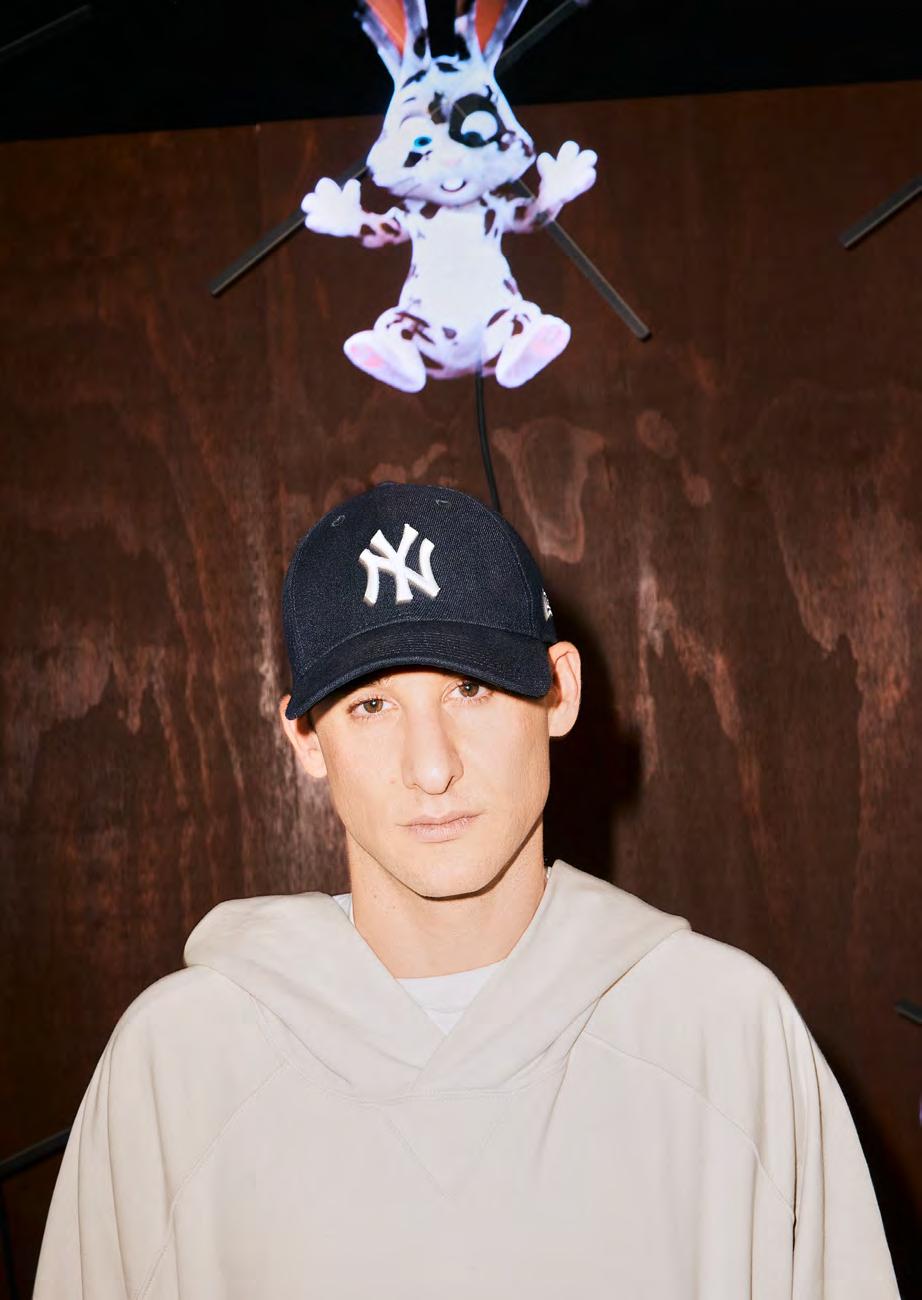



DEITCH That is quite a story. It’s a very personal story.
WOLFSON Before I left Sweden, I had the idea to create this video work called Infinite Melancholy, where the name “Christopher Reeve'' would repeat over and over. The video was included in my solo show at Kunsthalle Zürich in 2004—a year and a half later. The subtext here is that I was extremely ambitious and I was enormously obnoxious. Then a year and a half later, I was in the Whitney Biennale. And then, suddenly, I was getting a lot of bad reviews and I was getting scared. A lot of people were saying I was too good an artist to get bad reviews. And I thought, I have to do safe work
If I make safe work, I will have a safe career, and I will have money, and I will get to be an artist that no one interferes with, but I couldn’t make myself believe that. It took me three to four years to get out of that knot. I made an artwork called ConLechewhen I was twenty-nine years old, and then I made Animation,masks, which was even more free than Con Leche. Then Raspberry Poser; Female Figure; Colored Sculpture; Riverboat Song; Real Violence, House with Face, and ARTISTS FRIENDS RACISTS—each an attempt at trusting myself to figure out a way to make the art I want to make. It’s a story about trying to save your life, but then at the same time realizing it’s about being your true self.
DEITCH You are inside so many of your works. It’s very interesting that this personal struggle ties all the work together.
WOLFSON There is something about being in the work, and not being a performer, but identifying as the maker.
DEITCH I remember I saw you acting out the Bodysculpture piece, and although it’s not physically you, it’s your gestures.
WOLFSON It's me, but it’s also not me.
DEITCH You were giving us the chronology of your work, but Female Figure was not just another piece. It’s one of these rare instances where you arguably created the artwork of the decade. I wanted to ask you about this emergent breakthrough with Female Figure, which has reactions on many sides—there are some precedents, but there’s nothing like it.
WOLFSON All my artworks had male protagonists: Raspberry Poser; Animation, masks; Con Leche. The challenge would be to make an artwork with a female protagonist. I thought it could be a cartoon, but then I made a trip to Disney World. I never really thought I would be interested in making animatronics, but I saw this animatronic of Barack Obama at Disney World and I was stunned. As crazy as this sounds, as I stood there watching the Obama animatronic fluctuate and roll his hands, Female Figure was downloaded into my brain. I became obsessed with the idea of
making this sculpture; so much so that I had to change my entire career to make the piece.
The galleries that I was represented by were terrific, but they didn’t have the infrastructure to support this type of production. I told everyone I was going to make this piece—but I didn’t know how I was going to do it. My relationship with the Johann König Galerie had come to a close, but like a miracle—and thanks to the support of artist Helen Marten—Sadie Coles called me and asked me to participate in a group show.
I jumped at the invitation and took part—with Con Leche—and David [Zwirner] appeared at the opening and told me he was very familiar with my work and this specific piece. When Sadie formally invited me to join the gallery I told her about the concept for Female Figure, but understandably she wasn’t comfortable producing a work at that scale with me at the beginning of our relationship. About two months later, David Zwirner asked me to join his gallery and in our very first meeting I pitched Female Figure to him, and on the spot he offered to produce it. But, he said I’d have to move to LA to make it. So, I moved to LA to make Female Figureand it was done less than a year later.
DEITCH You showed me the Jeff Koons book. You opened it up and showed me the Jeff and Cicciolina work. Tell me about the relationship between Female Figure and Jeff Koons’s work.
WOLFSON I saw the Jeff Koons show, PopLife, at Tate Modern in 2009, when I was living there. The work I saw was Dirty (Jeff On Top). What was interesting is that it was matte and covered in dirt. The fingers were soiled. And when I was doing Female Figure, pre-visualizing it, I remembered this and added dirt marks to the figure. Once the dirt marks were added, it was as if the sculpture had some type of narrative; as if the sculpture had escaped from something. However, months earlier I had gone to a famous psychic, known for his accuracy. He said I was going to make something that was witchy and dirty, and that it would bring me to the world stage. He also said, “You need to watch the movie Mulholland Drive(2001). It’s something about this woman, the scene where she gets out of the car.” So, I went home and watched the movie. The scene he mentioned is the one where Rita, played by Laura Harring, gets out of the car in the hills at night, and climbs down to her house. When she
gets back home, she’s covered in dirt marks, but she has no marks of being hurt or assaulted. It’s as if she has become evidence of some sort of trauma, or avoidance of trauma.
DEITCH This is so interesting, because this is such a key piece in your history, and the history of contemporary art. There is another breakthrough with Female Figure. Essentially that FemaleFiguremeets the eyes of the viewer. I know an immense amount of effort went into this aspect of the piece.
WOLFSON I will tell you the genesis of it. I had won the Cartier Award in 2009 for Your Napoleon. In YourNapoleon, two things would happen. One, people would walk around the Frieze Art Fair and learn about String Theory,
which is about how the universe and time is constructed. In the piece, your conversation would get recorded and then transcribed. Then, I would take a lot of high and low cultural material and basically drop it into the dialogue. I was really secure with the structure, with the content, but what didn’t work was the form. I would sit with these two young actors in the park, and they would perform it. I would direct them. It was always a woman and a man. Each time they read these scripts, I would not really feel it. I was like, howisthisgoingtowork?I am trying everything I can try, yet formally this is not working. I was exhausted. So, I said, “You guys both just read the script and look at me.” When they did that, everything changed. They created this formal bridge between me and the viewer, because of the eye contact. Then I made Animation, masks—and the shylock character continuously makes eye contact with the viewer. The eye contact was crucial. If you create a formal bridge through eye contact, I thought, there would be no resistance, even for the most morally challenging content, or the most simplistic content, there would be no contrast, or incongruity between tonalities. The eye contact levels things: everything is taken in; everything is equal. Difference no longer matters. I also did it in RaspberryPoser
DEITCH Female Figure is not the first artwork that reacted to the viewer, but perhaps the most well-known.
WOLFSON Yes. That aspect of the work was effective.
DEITCH An important part of it is the dialogue. I remember talking to David Salle about your more two-dimensional work and his
"I had gone to a famous psychic, known for his accuracy. He said I was going to make something that was witchy and dirty, and that it would bring me to the world stage."
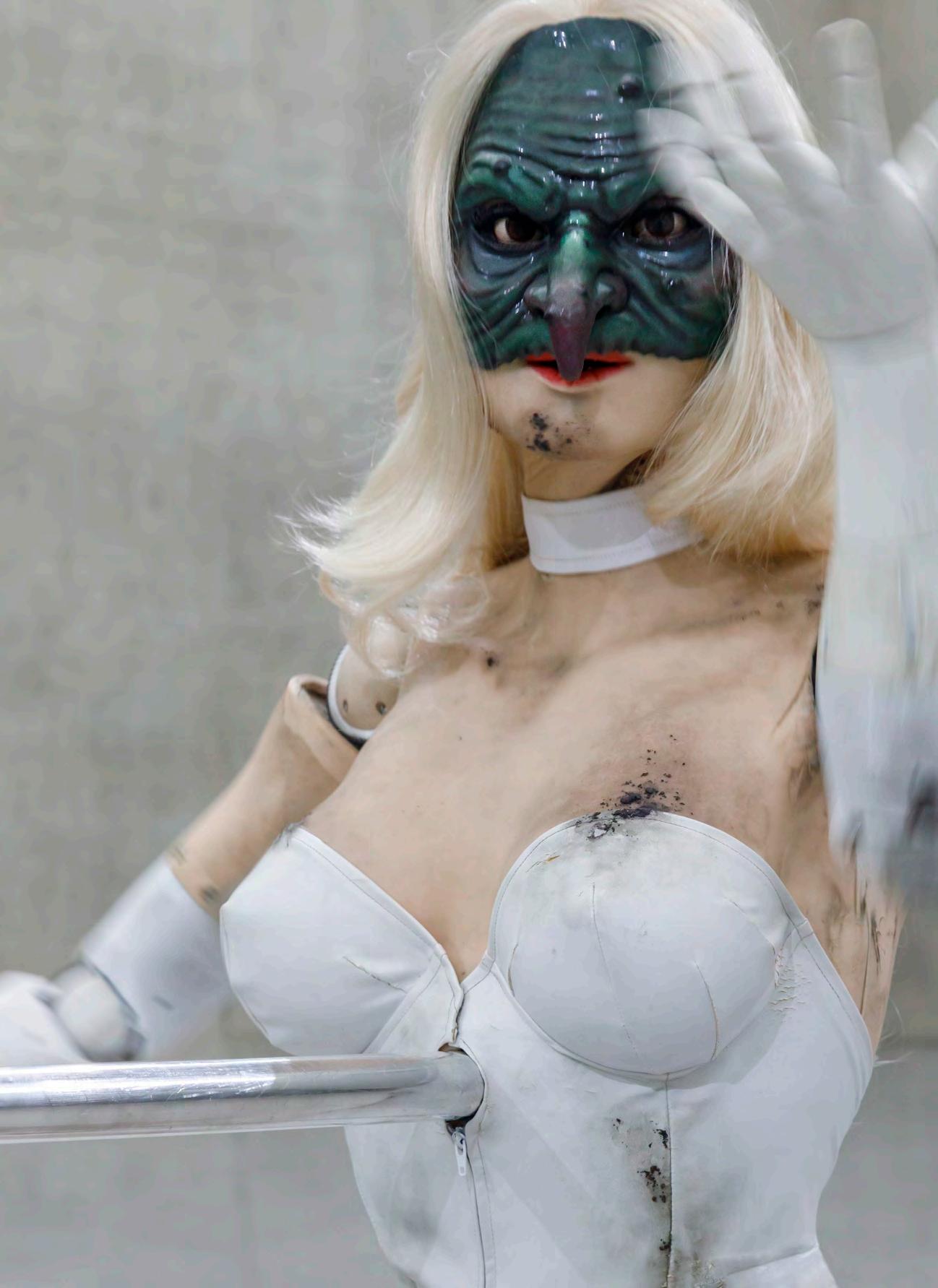

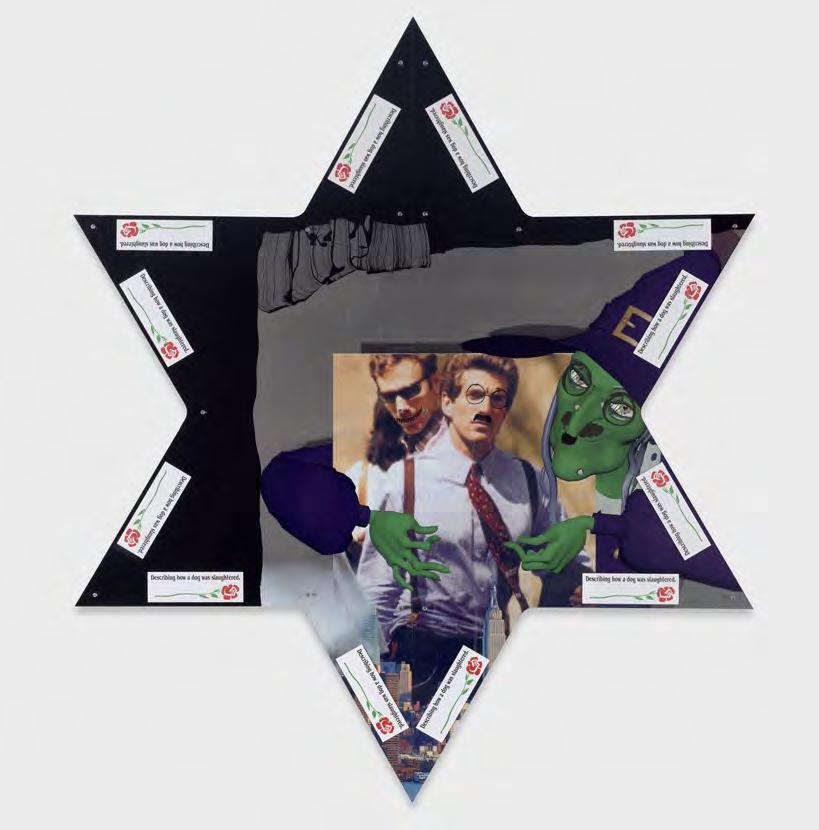



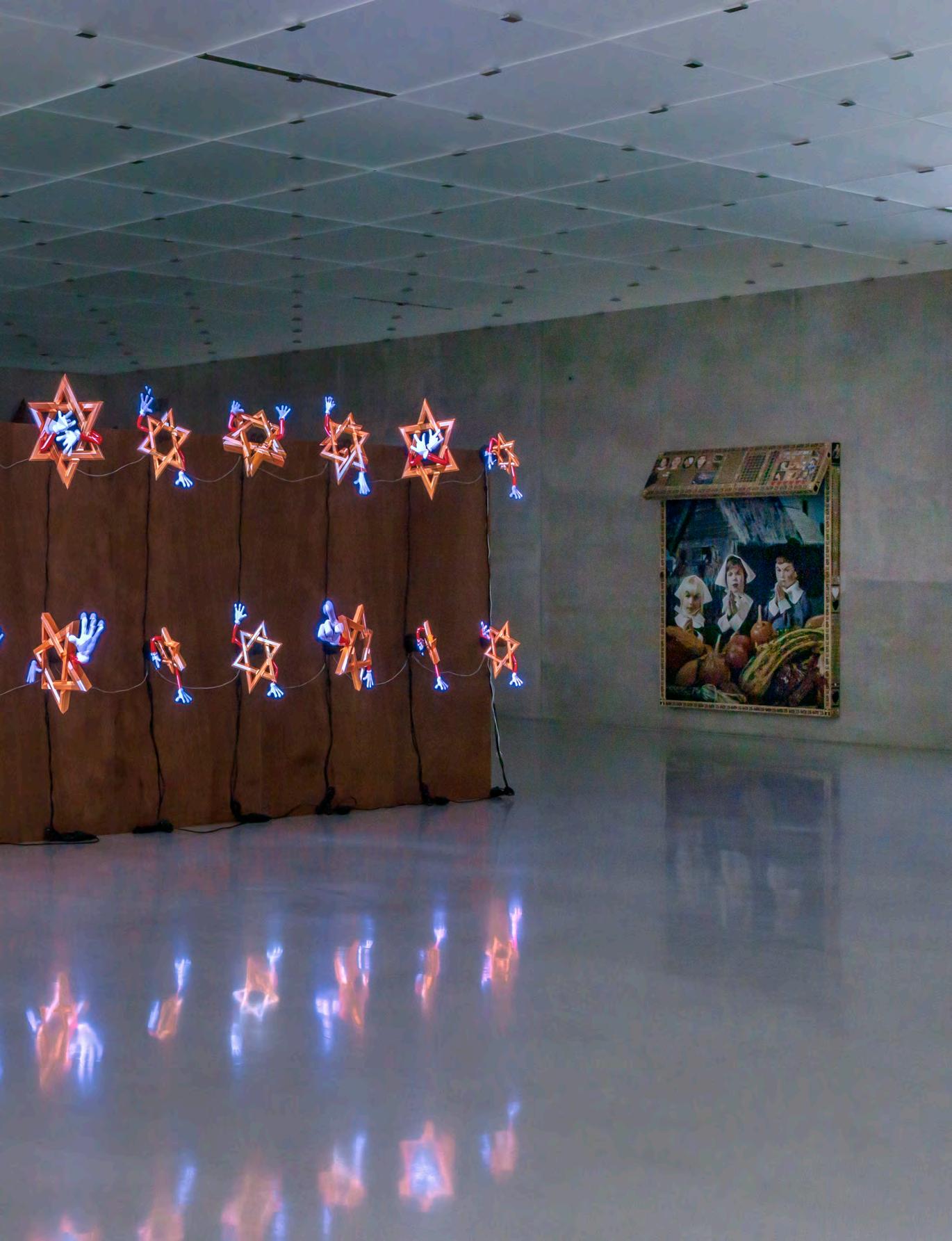
comment was that Jordan is really interesting as an American poet. The bumper stickers are some of the most interesting advances in American poetry.
WOLFSON I think that is an overstatement (laughs), but I do think that language, particularly aggressive language, has different frequencies and tones. It’s like hitting a xylophone, creating a composition of tones.
DEITCH (laughs) Female Figure had a very split reaction, with many people hailing it as a masterwork, others being offended. It was not just men versus women. There are distinguished female art connoisseurs, friends of mine who pride themselves on doing an exact imitation of Female Figure’s dance. A lot of artworks that make a big impact in our culture are controversial.
WOLFSON That is what a good artwork does. It questions something. Like Real Violence—the depiction of violence is what makes it an interesting artwork.
DEITCH The main aspect of controversy is a male artist depicting a battered, sexually charged female figure.
WOLFSON You know, it’s not about a battered woman. It’s called FemaleFigure, but the figure is hiding in plain sight. She is not battered, she is not bruised, there is no wound on her. But she is dirty, she has escaped from something. There are primitive things inside all
of us that we cannot deny. This is the primitive gaze—the primitive relationship of how representation can lead to arousal. You can look at these different artworks, and they are really just about these primitive human experiences.
And suddenly it’s controversial to talk about it, because no one wants to talk about human kind as the animal that it is. But it is and it is okay. We are murderers, rapists, thieves, and liars. We are talking about the human animal who is not perfect, still prone to making mistakes and acting on impulses. Is it controversial to talk about that when it has been going on since we've been here? It is ironic if you think about it.
I think the issue isn’t getting permission to talk about the animals we are, the issue is being told it’s okay.
DEITCH Tell us about the genesis of this astonishing work, ARTISTS FRIENDS RACISTS
WOLFSON Right before George Floyd, things were heating up in the country. I thought, I'mnot a racist. And I really asked myself, wait, am I a racist? I feel every person should ask themselves that question.
DEITCH The theme of this issue is Losing My Religion. You are doing something that is very unusual for an artist in your sector—there is Jewish content. Thinking of Jewish artists in modern history—Emmanuel Radnitzky changed his name to Man Ray, but there is not
much Jewish content. Philip Guston used to be Phillip Goldstein, and there is not much direct Jewish content there either.
WOLFSON Here is the deal about being a Jewish person in society. When gentile, white people talk about us, they will always bring up that we are Jews. They might say, “Jordan Wolfson, he’s a really nice Jewish guy.” Or they might compare me to another Jewish artist, the same way white people casually compare non-white artists. This is why these artists changed their names. Because I am Jewish, the more successful or ambitious handling of complex and challenging subject matter makes me appear threatening, and the culture is less and less at ease. One of the reasons I became interested in JFK Jr. was because he could go into any situation, any club, any social engagement, and gain immediate acceptance. So, I inverted it and turned him into Groucho Marx, who famously didn’t want to be a member of any club that would have him. end
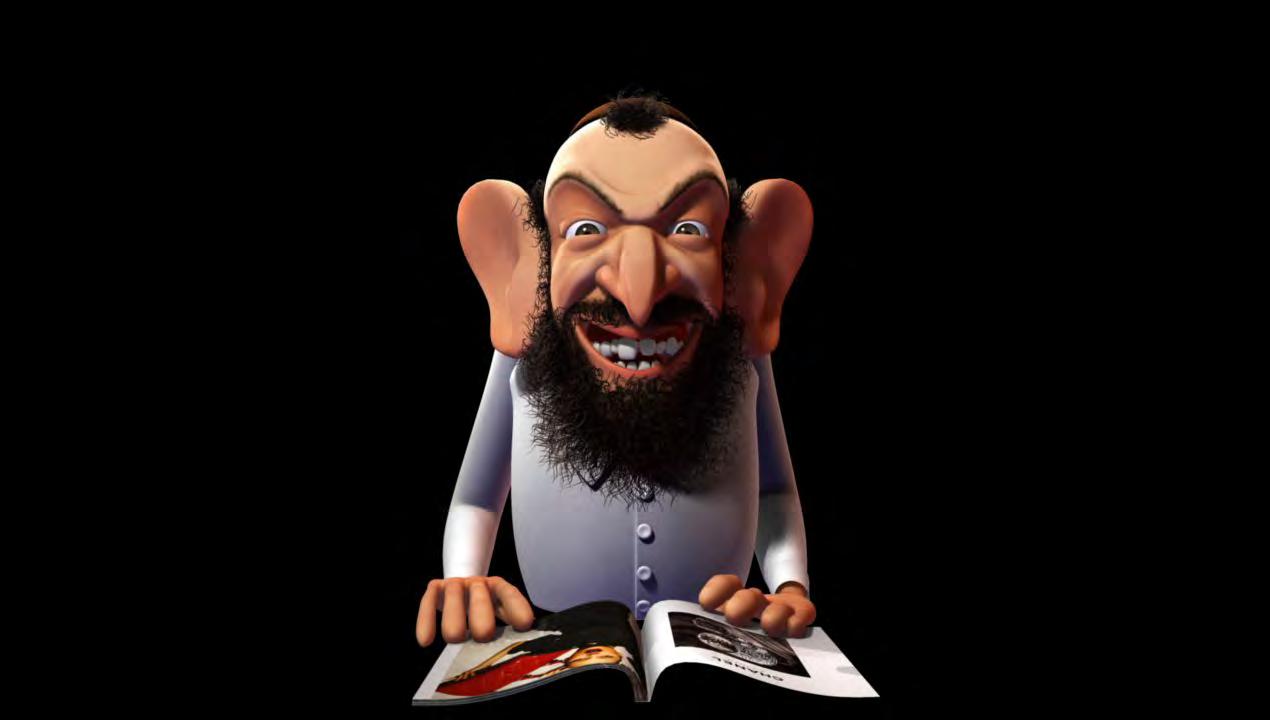
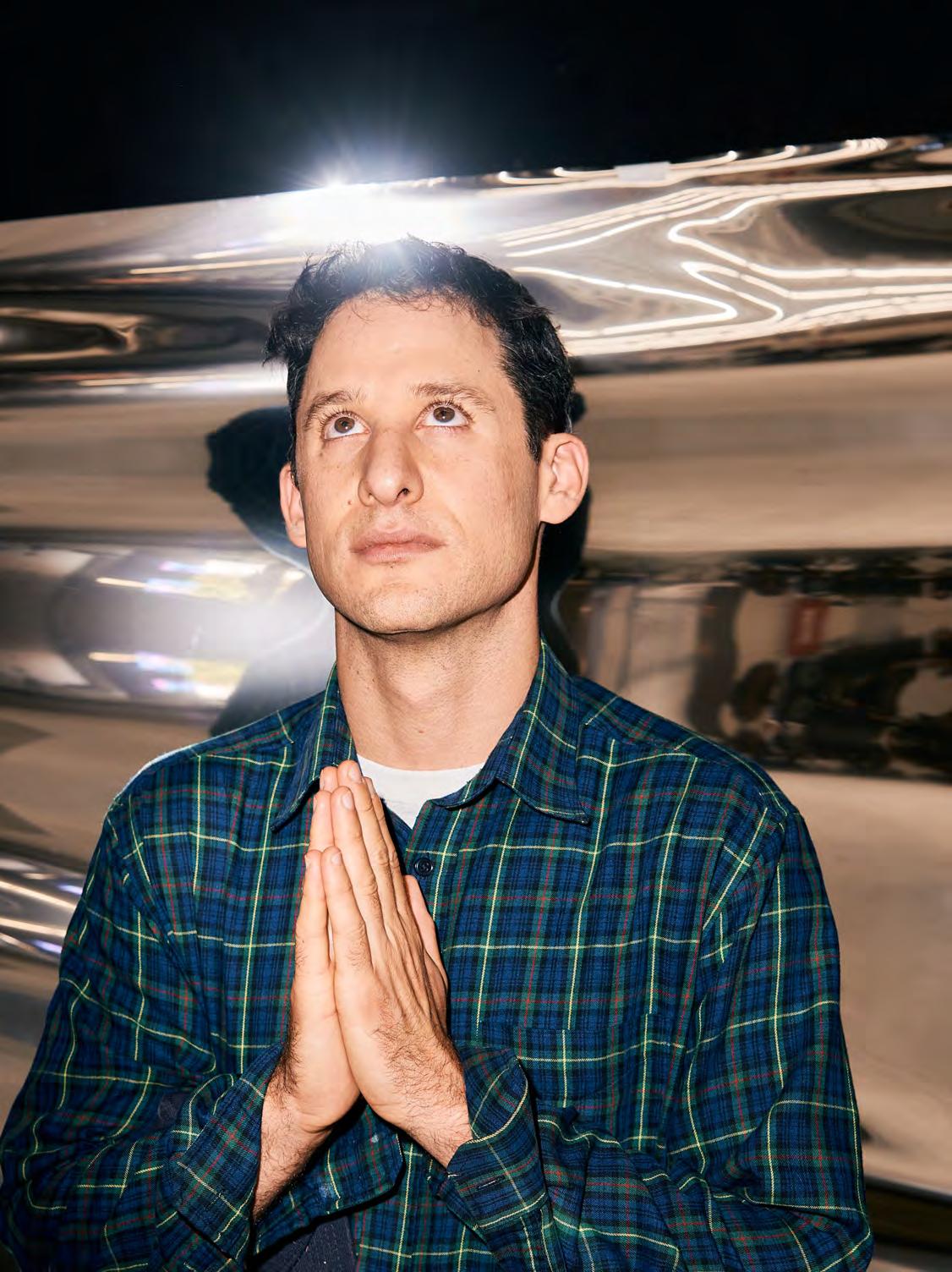
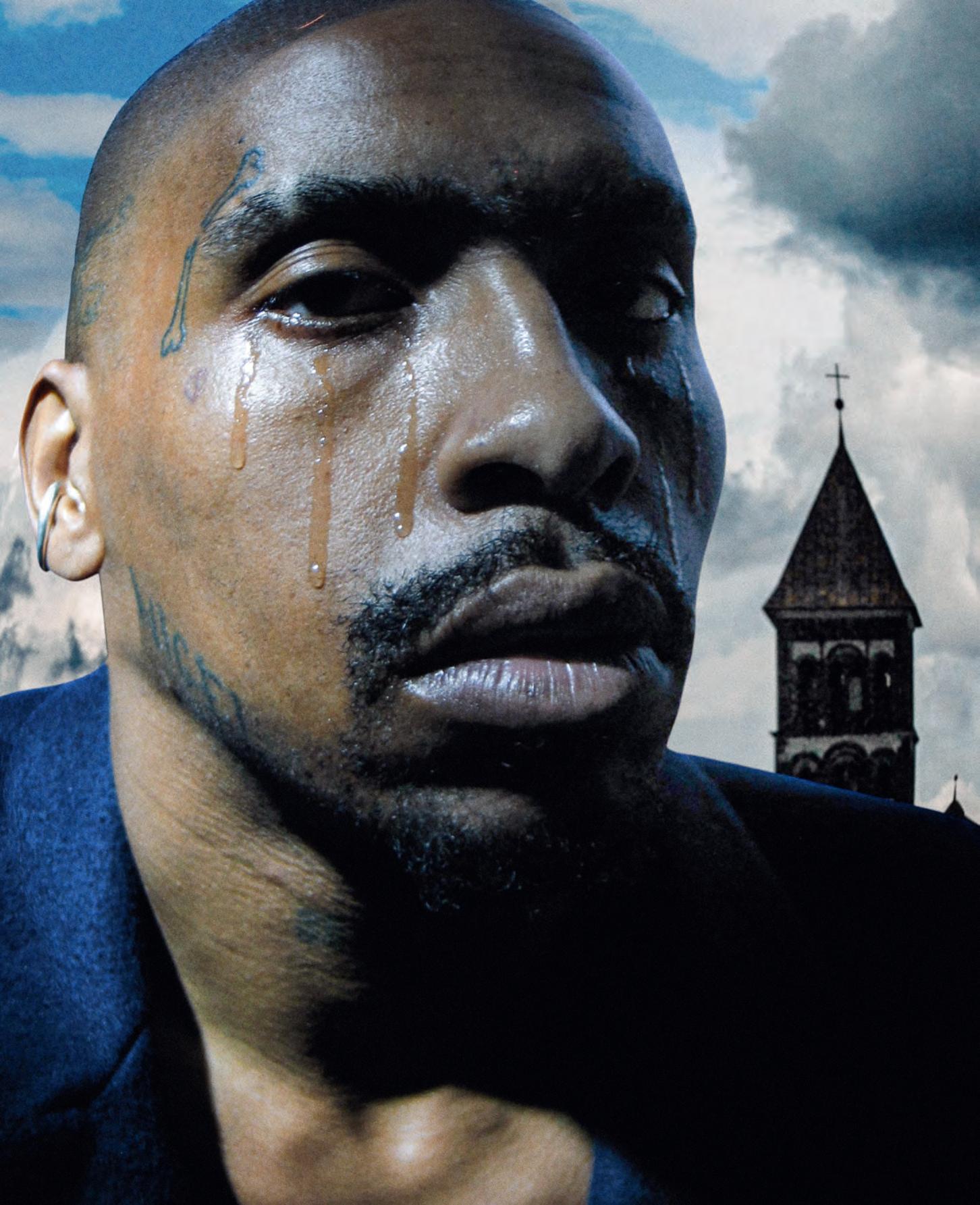
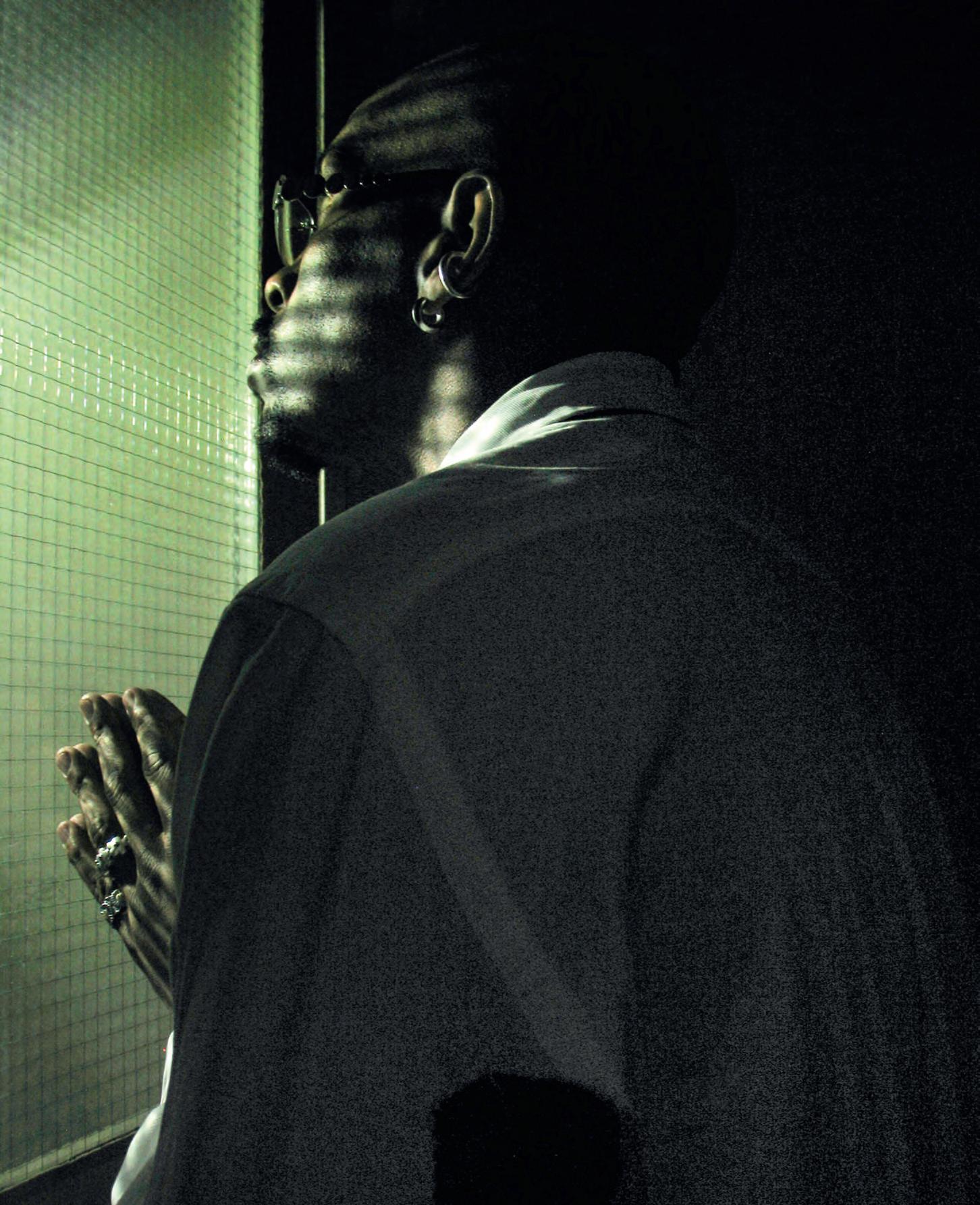
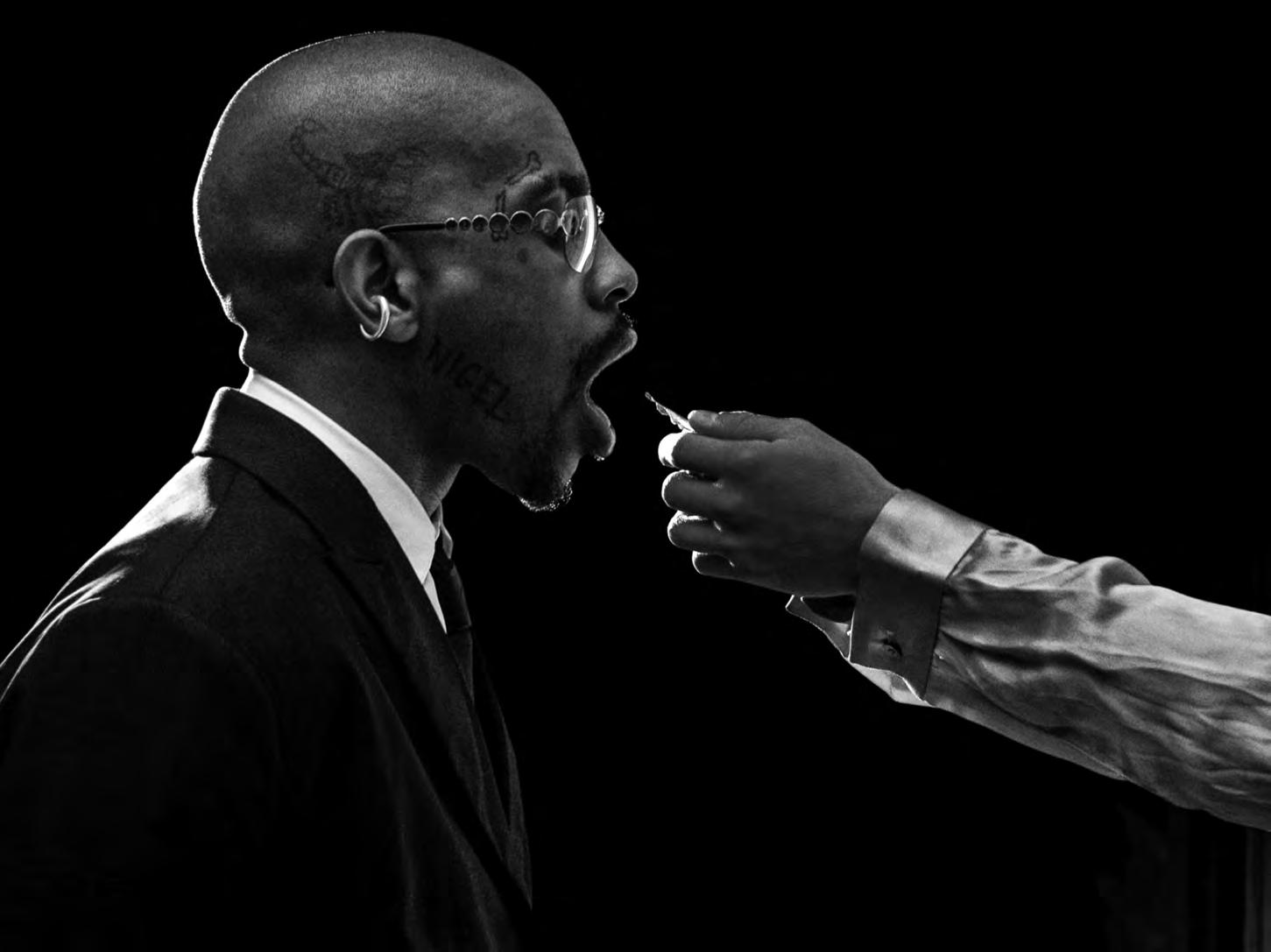

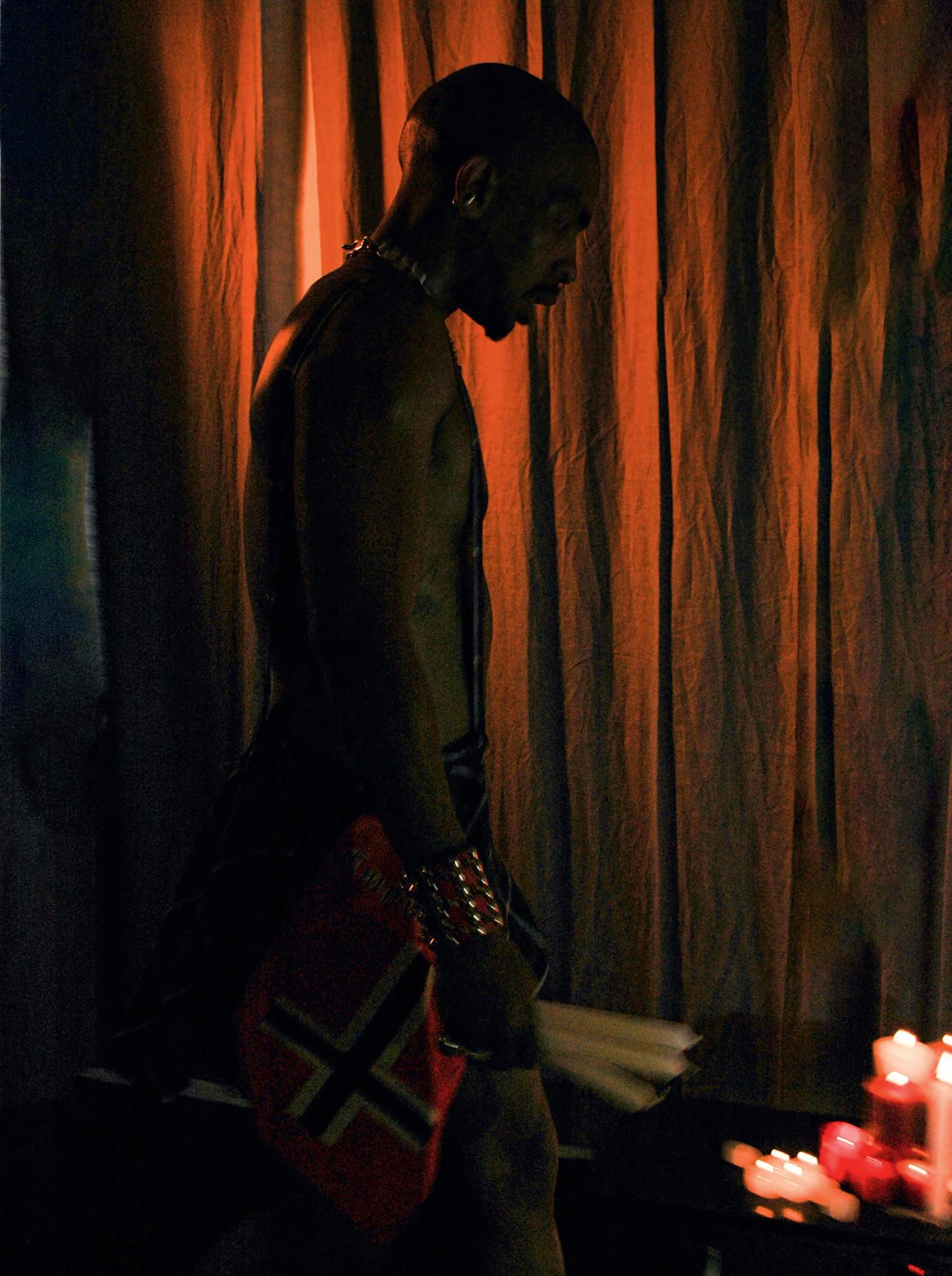

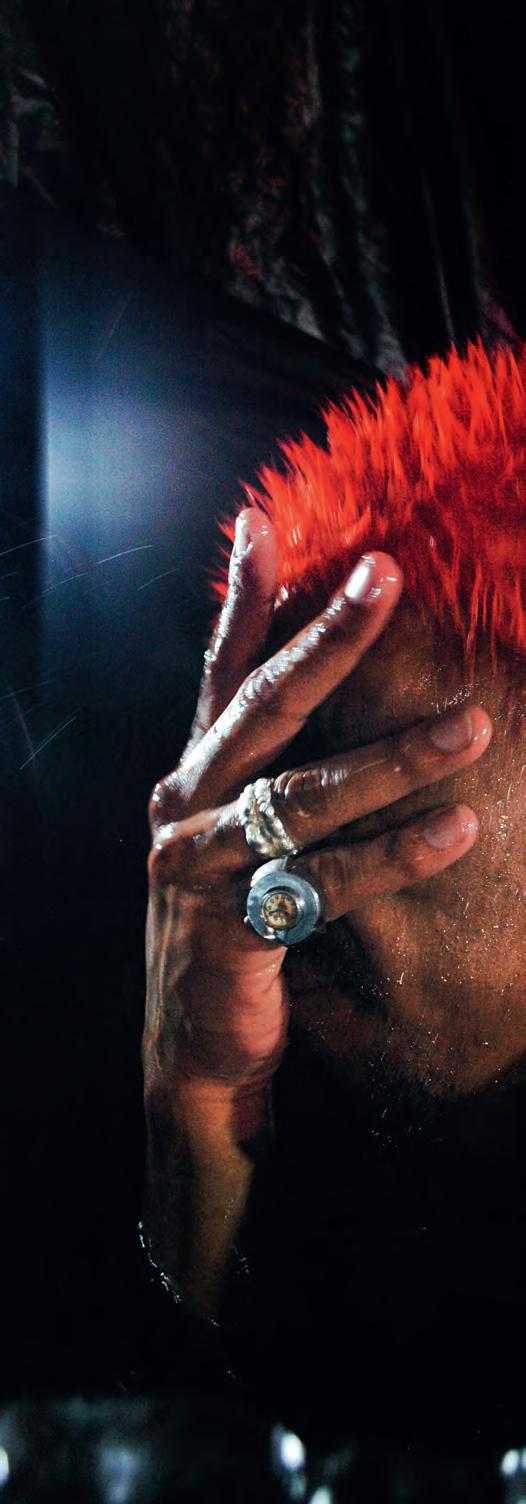
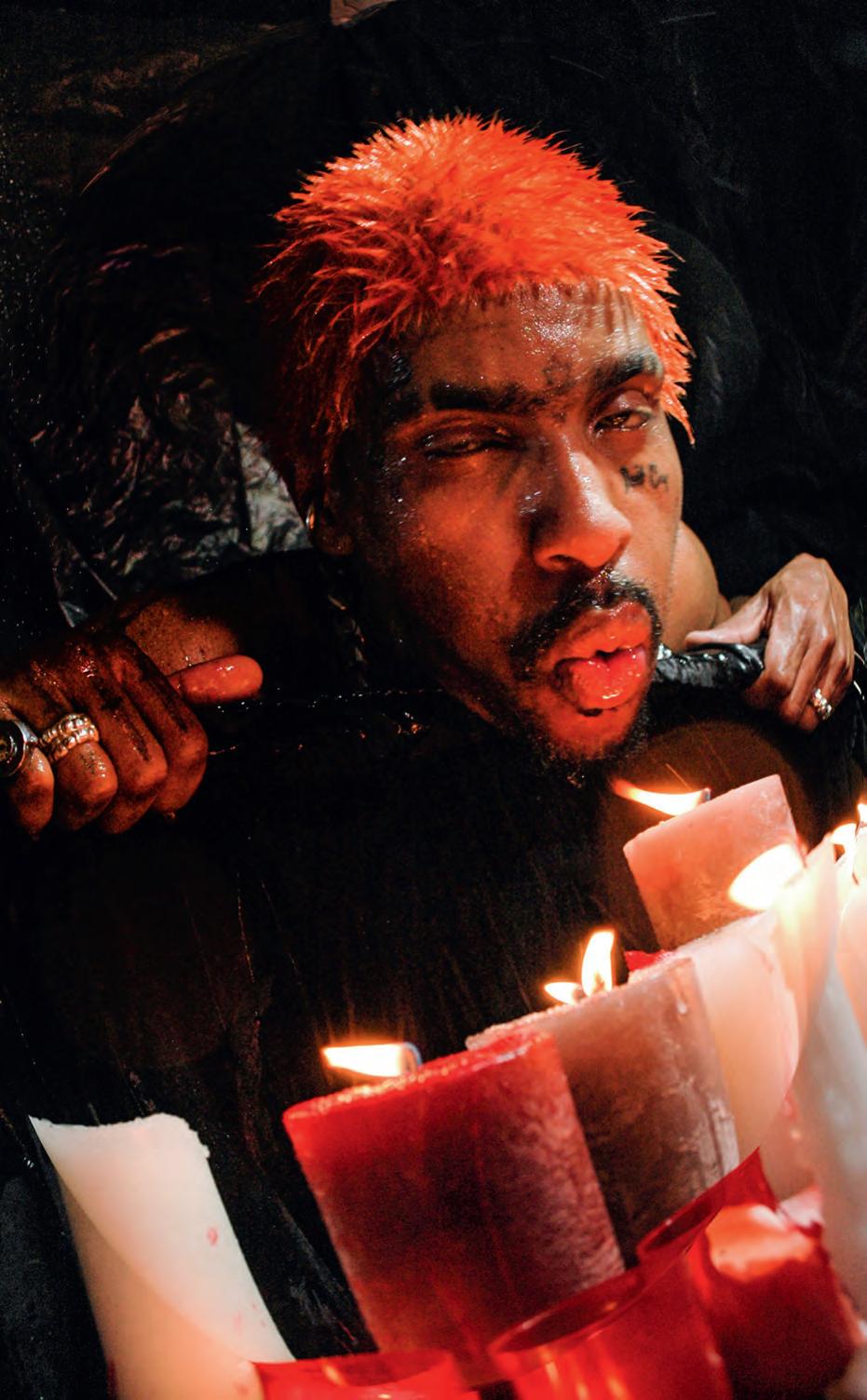


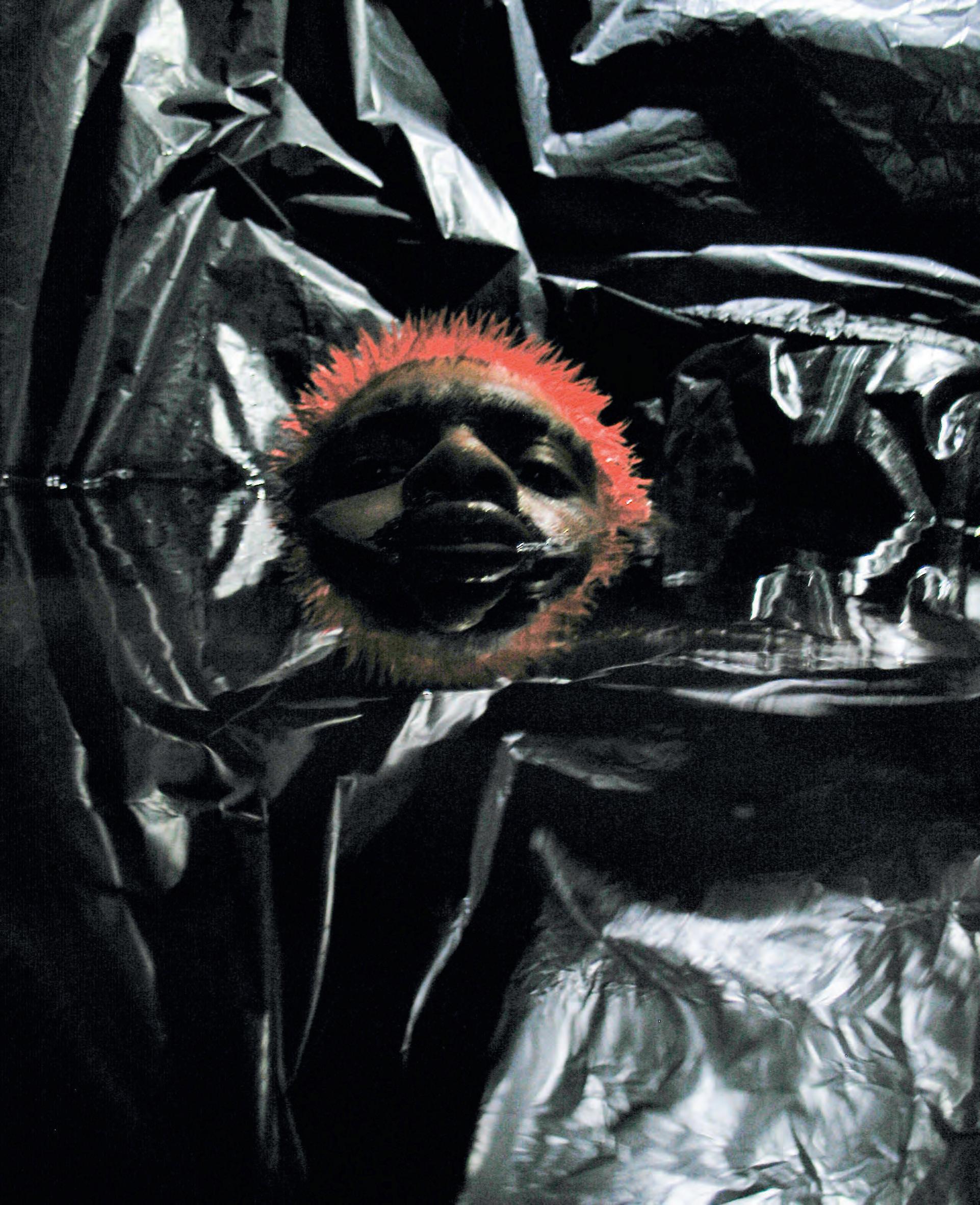



From 1976 to 1983, The Dirty War, backed by the United States, was waged by the Argentine rightwing military dictatorship against its own citizens. Luis Moreno Ocampo was only thirty-two when he accepted the seemingly insurmountable mission of prosecuting the juntas responsible for this bloodthirsty reign of state-sponsored authoritarian terror that saw the death, torture and disappearance of over 30,000 Argentinians. To this day, they are still trying to identify the victims discovered in mass graves. The 1985 junta trial was the largest trial of living war criminals since Nüremberg and the first in a civilian court. Ocampo’s prosecutorial strategy alongside chief prosecutor Julio César Strassera was simple and brilliant: let witnesses tell their stories. A total of 833 witnesses took the stand—they included survivors, but also experts, like forensic anthropologist Clyde Snow, a specialist in identifying skeletal remains. Some of the top generals convicted died in prison decades later. A new film, Argentina,1985, directed by Santiago Mitre, explores this violent and pivotal time in Argentinian history. From 2003 to 2012, Ocampo took his expertise to the Hague as the Founder Chief Prosecutor of the new and permanent International Criminal Court (ICC), which opened investigations into crimes against humanity across the globe—from Afghanistan; to the Central African Republic, to Côte d'Ivoire, Darfur, Sudan, the Democratic Republic of the Congo, Kenya, Libya, Uganda. Bangladesh, Myanmar, Palestine, and Venezuela. A case study and legal blueprint, which explores his experience at the ICC, will be published by Oxford University Press this fall. In the book, WarandJusticeinthe21stCentury (2022), he argues that the War on Terror expanded international terrorism rather than deterred it. Now retired, Ocampo lectures at USC School of Cinematic Arts on the relations between justice and popular narratives, inspired by novelist Viet Thanh Nguyen’s concept that “all wars are fought twice, the first time on the battlefield, the second time in memory.”
OLIVER KUPPER In this issue we’re looking at the seemingly out-of-control violence and suppression of freedoms that is pervading the world right now.
LUIS MORENO OCAMPO Well, the problem is that for 5,000 years, humanity has used violence to manage conflict. And in the US, the prevailing idea is that we have the biggest army, we are the nice guys, therefore we should control the world. Inside the US, we use the law to manage conflict, but outside we use war. The laws that allow artists to live in peace in the US, don’t exist outside the US. If you are an artist in Los Angeles, it's very difficult for you to perceive what is happening to someone in Syria today.
In 2012, people were using relatively new technologies, like YouTube, to amplify messages. There’s a documentary on YouTube called Kony 2012 [a short documentary putting a global spotlight on Ugandan cult leader, war criminal, and ICC fugitive Joseph Kony], which has received over 100 million views. But now, social media is more about people doing nice things for themselves and the global vision is disappearing. There’s no space to discuss it. I’ve seen Kim Kardashian talking about the Armenian Genocide, but we need a better balance.
KUPPER You mean a balance in using social media platforms to amplify these bigger issues.
OCAMPO And important topics, yes. There are no global authorities to manage issues like climate change and war. They should be addressed in a way that we understand. And that is something I am trying to explore. I came from a non-artistic side. When I was
the chief prosecutor of the International Criminal Court [ICC], I had to convince ambassadors to support our efforts to do justice but they don’t like to discuss how girls were raped in Darfur, such a topic is very emotional. In the diplomatic area, in the legal area, emotions are wrong.
KUPPER You have to be cold.
OCAMPO Yes. But prosecuting generals in Argentina I learned that people have to understand the cases. It's not just about what happened in the legal and technical court system—I needed to reach people like my mother. My mother was against me, but reading about the testimonies changed her mind. Reaching audiences around the world was my challenge at the ICC.
KUPPER Your upbringing in Argentina had a massive impact on your entire life, from your prosecutorial efforts with the military juntas to the ICC. What was it like growing up in that environment?
OCAMPO One thing you should understand is that you can live under a dictatorship and still have artistic activities. So, in Argentina when I was young, I still took music and theater classes. There were still people writing poetry. There was heavy censorship, but there was still a vibrant society doing different forms of art. I remember watching Polish movies from the Soviet era, and you feel empathy. We understood each other. So, people who live under dictatorship understand the codes.
KUPPER Can you talk a little bit about the stunted technological progress of the legal framework in taking down these dictatorships?
OCAMPO We celebrate technological innovation while denying institutional renovation. We are still living in a nation-state system that was designed in the 18th century. The UN is just a place where the nation-states’ representatives meet. Citizens have no representation. The UN is a meeting place, not a world government. Some blame the UN for the lack of security in the world, but that’s like blaming Madison Square Garden because the Knicks played bad basketball. We have Google giving connections to people and businesses in milliseconds in a global political system where people can’t even participate, and a few states decide whatever they want. Nothing has evolved in the law schools, even at Harvard where I was professor. No US university is proposing global models to complement national efforts and provide global solutions. Senator Jesse Helms said it very clearly, “There is the American people, the American government, and god. Nothing between the American government and god.” Nothing.
KUPPER In your book, you mentioned that people thought a global international prosecuting body was too utopian.
OCAMPO It was utopian, but a model was adopted by 120 nations and my job was to implement such a system, to turn this utopia into a reality. The International Criminal Court—created in 1998 and operating since 2003—is now a reality using justice to manage problems. The alternative is war between states like in Iraq and Ukraine. In such a model, Fortnite is the future. We have to kill each other and the winner will be alone.
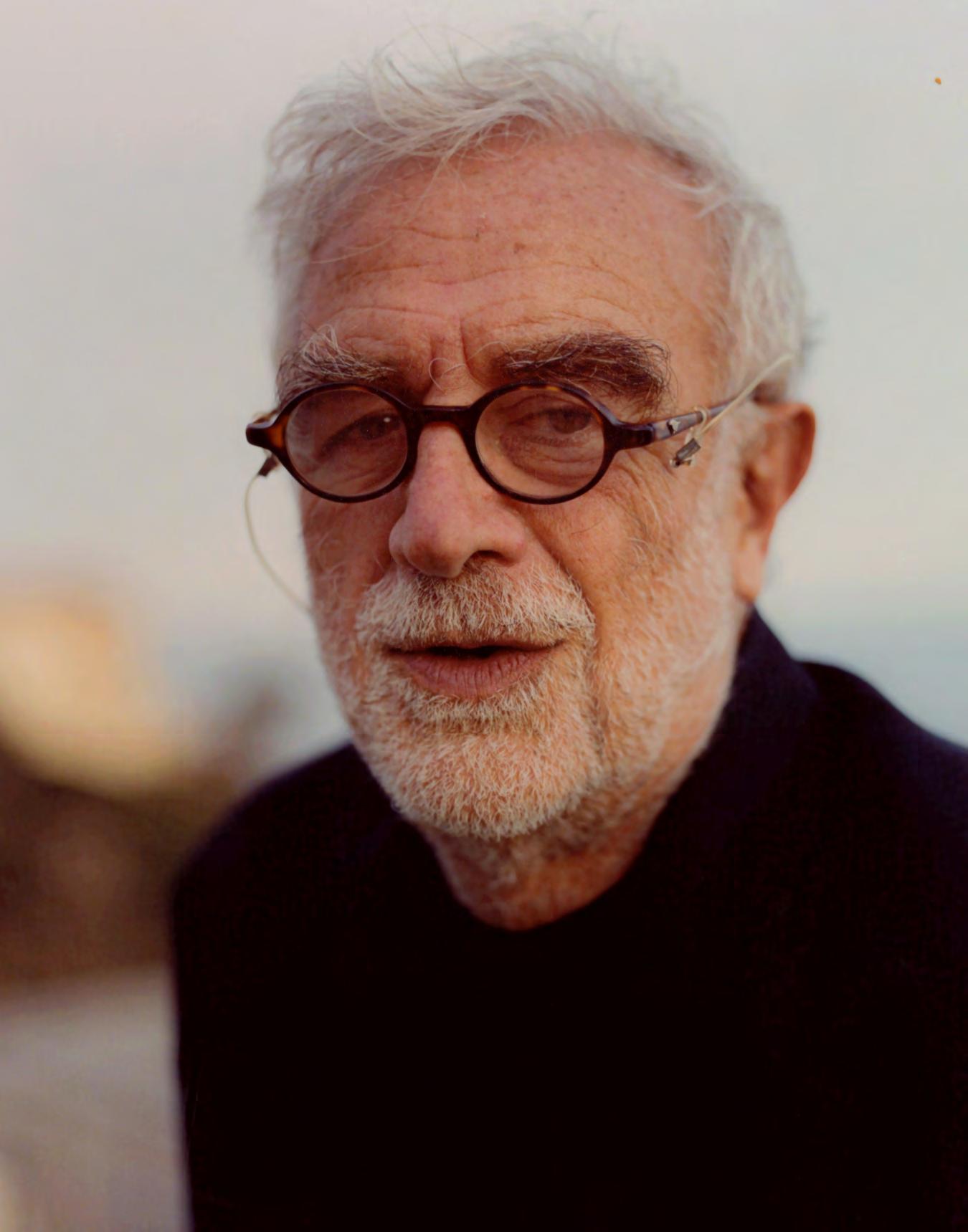
KUPPER Growing up in Argentina, before the trials, how old were you when you realized that there was something going on in your country where people were disappearing, where people were being murdered, and dissent was being quieted? Was there a specific moment when you realized something was wrong with the government?

OCAMPO From the moment of the junta coup d'état, we knew it was a dictatorship. And Argentina has had many dictatorships, but this was the first time they started a secret system to abduct people, torture and execute them, and disappear the bodies. There was strong censorship. The dictatorship lost power during the next election, one of the candidates, Raul Alfonsin, proposed to investigate the past. It had never happened before in any country in the world. This would be like Obama investigating Bush or Rumsfeld. Alfonsin was a minority candidate, but he won the election with 52% of the vote and created one of the first truth commissions to investigate the crimes. We used that information to prepare our case. There is an Amazon movie now presenting our efforts. During the court hearings, more than 800 witnesses told what happened to them. Awful stories, crazy stories. And then, people like my mother learned about what happened. The testimonies changed people’s minds.
KUPPER There’s an interesting correlation with what's going on with the House Committee and DOJ’s investigations into the attempted insurrection on January 6th. But it seems like Americans are so entrenched in their idea of exceptionalism that they can't even look at the evidence against Donald Trump. It almost seems like a cult.
OCAMPO Well, it’s not just Trump, because it’s happening all over the world. The 18th-century legal system is not working well in the 21st century. Many people feel like, okay, the law is not protecting me, so I’mgoingbacktomytriballeader. We are going back to tribalism. Trump is the epitome of that fact. Trump has proposed very clearly to protect his people, and that's it.
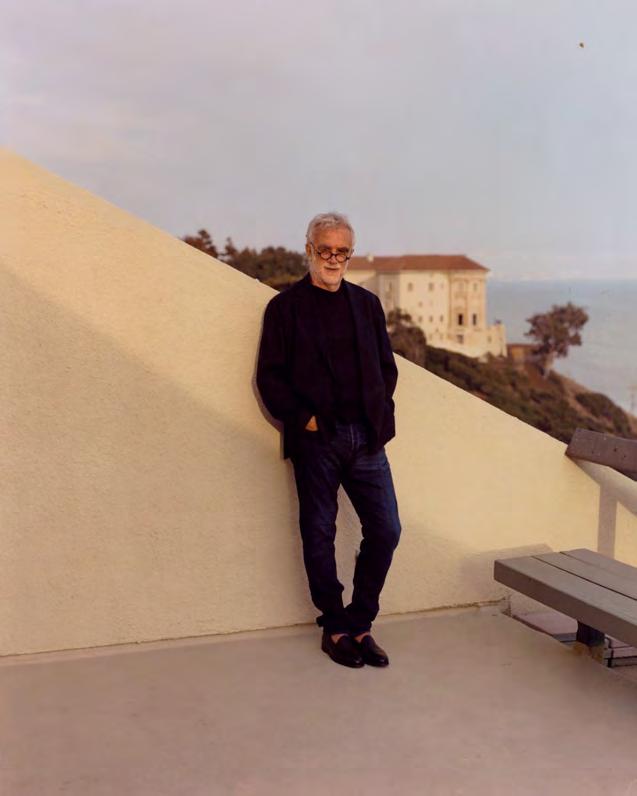
KUPPER And this return to tribalism is fueling a lot of violence.
OCAMPO Totally. Because tribes have to fight against other tribes and that’s how wars start. And that's the problem. National legal systems were created to control violence and were very effective. We need to create something to avoid wars. But social media is creating echo chambers and fueling tribalism.
KUPPER And pushing genocide.
OCAMPO Yes. It is the normal consequence. To protect your own people, your tribe, you promote attacks on your enemies. The Bedouins have a very nice statement. They say, “I fight against my brother, my brother and I fight my cousins, and all of us against the foreigners.” Osama Bin Laden said that he needed to protect his people by attacking the Americans. And that’s where we are today: China and Taiwan, Ukraine and Russia. And Syria. And now the idea of war is consolidated. In South America, the joke is that the only city the American military was able to consolidate control of is Washington (laughs). So now, the consequence is a military approach that promotes the popularity of leaders. It’s amazing—Obama received the Nobel Peace Prize for proposing war. It's fantastic. It's crazy wild. So, war is appealing for people.
KUPPER It seems like September 11th really thrust us into a new century of tribalism. We realized that the enemy was able to attack us directly on our soil. It seemed to change the legal system around revenge. And we became completely besotted by this idea of revenge, all under the guise of democracy, and we decided to wage war in the Middle East. You mentioned in your book that the War On Terror caused the insurgents to attack even harder.
OCAMPO After September 11th, the US could have prosecuted Bin Laden. They could have sent troops to arrest him. The US did that in Panama with Manuel Noriega. But instead, Bush decided to go to war. And war creates a different paradigm. You kill people and transform the game. But for me, the biggest problem is that eight years later, Obama took office and he received no new plan. And then sixteen years later, Trump took office and received no new plan. And Biden too. The expert community is not able to propose a different view. Remember, nothing between the American government and god. As the ICC Chief Prosecutor, I received a global mandate and I have to confront those ideas. I was the first independent global public servant.
KUPPER What were your feelings when you first arrived at the Hague and realized that you had this incredible responsibility?
OCAMPO Well, I always had the idea that my biggest achievement was the junta trials when I was thirty-two. That gave me freedom to explore and do whatever I wanted. I had a TV show teaching law to massive audiences—I was a visiting professor at Harvard and Stanford. And then, they offered me the job at ICC. I felt I was prepared. I didn't care if people attacked me or celebrated my decisions. I knew I had to do the best I can in accordance with my legal mandate. I was involved in impossible cases, including the Israel/ Palestinian conflicts, but my legal limits helped me to navigate this crazy world. My decisions were in accordance with my legal mandate, but the outcomes were different in various situations in Libya, in Darfur, in Uganda, and Colombia.
KUPPER But it’s clear that there are abuses by the Israelis against the Palestinians.
OCAMPO At the end of my tenure, both Palestinians and Israelis already told me they respect me because I was impartial. But the Israeli minister of justice told me something fascinating. He said, “Yes, we respect impartiality, but it's not enough for us because I have my kids at risk. I don't like to put the protection of my kids in the hands of an impartial person.” And that's the situation. So, I kept working on the Palestine and Israel situation. People believe that the wall divides Israel and Palestine. No, the wall divides the normal Israelis from the hyper-religious Israeli right wing who are living together with Palestinians. I was in Nablus two months ago where Israeli children from Israeli colonies were dropping stones on the Palestinian cars, and the Israeli army protects the kids because that's their job. Also, many of the roads are closed to the Palestinians, so Palestinians have to drive around for two hours to get to their homes. So, this is Palestine. Everyone is frustrated and they perceive violence against Israelis as a normal reaction.
KUPPER Going back a little bit to the junta trials, or whenever you were preparing for a trial against a dictatorship, what are some of your initial thoughts on preparation. In your book, you describe organizing the cabinet within the ICC as a symphony, which is a creative way to think about it.
OCAMPO I found that an orchestra is a good metaphor. You need a violin, a trumpet, and different types of instruments. And my job was to harmonize people who were playing different music. My orchestra had rock, jazz, and cumbia players. It was a mess. And then you have the audience. Some of the audience likes jazz, some of the audience likes Mozart and whatever you're playing is not what they expect. I had to respect my partiture, my mandate. It's funny because an artist has to break the rules. For me, it was the opposite: my job was to be an artist in a very limited way, by respecting my legal mandate.
KUPPER Was there ever any fear going into these trials? Fear of retribution?
OCAMPO Well, there were more security issues in my country, in Argentina, in 1985. We received death threats. In the Hague, nothing happened—just people riding bikes. And when I went to Congo or Uganda, I had an army around me. I didn’t feel like my life was in danger— just my reputation. But I didn’t really care about that.
KUPPER It must have been a lot more dangerous in Argentina.
OCAMPO For me, it was an opportunity. The chief prosecutor invited me to join the trial when I was thirty-
respecting the law, and a court to intervene when they fail to act. A sovereign state with no limit is Fortnight, and that’s what I mean by a failure by design.
KUPPER I want to talk about the Rome Statute— the treaty that created the ICC—and how that relates to the United States’ War On Terror, which gave the US a license to kill extrajudicially. The US basically created a law that undermines the Rome Statute and makes it impossible to extradite US personnel to the Hague.
OCAMPO Well, the ICC has no authority to intervene in countries which are not a member, and
two. This was my first case. I was a professor. I was also a clerk under the Solicitor General, basically doing research. I was not a lawyer in court or an investigator. And the chief prosecutor told me, “Look, we cannot use the police to investigate these crimes, so I need you to investigate this in a different way, invent whatever you can.” It was fascinating. My question was not about fear, but how can I do this in a rational way? So, my rational way was saying, “Okay, as soon as democracy is established, they can’t kill me.” But if there is a new coup d'état, I would have to escape—I wouldn’t think twice.
KUPPER I mean, it's brave, but when you are serving a duty for your country, you have to take the opportunity.
OCAMPO It was an incredible opportunity. It’s funny because now I'm here in Los Angeles teaching at USC [School of Cinematic Arts], exploring justice and popular narratives following a quote by a professor from Vietnam named Viet Thanh Nguyen’s that said, “all wars are fought twice, the first time on the battlefield, the second time in memory.” And the big trials that I was involved in, like the junta trial—it’s not just about what happened in the courtroom, but in memory. Next month, Amazon will premiere a feature film about my Argentina case. My youngest kid, who is twenty-three— he will learn about my job through the movie. So, that’s part of the art of transformation. The Amazon film will present the problem in a way that is emotionally attractive.
KUPPER I want to talk about the complexity of the world we live in now. You mentioned that there is no chaos, just complexity. Chaos seems impossible to control, but complexity seems like it's more manageable if you understand all the different components.
OCAMPO For me, there is no chaos, just complexity. The problem is that there is no academic field managing the complexity. There are no experts, no scholars organizing the complexity. The legal professors keep the discipline boundaries firmly and they ignore other problems like political power.
KUPPER You also talk about failure by design. Can you talk about what you mean by failure of design, or inaction by design in the context of the prosecution and prevention of international violence?
OCAMPO The world is organized, by design, as national sovereign states. And the theory is that the biggest states protect themselves and provide order, and conflict is basically solved by war. This is what I mean by Fortnite. The International Criminal Court is trying to do something different, but it's crazy because imagine the US without the White House, without the Congress, without the FBI—just a judge and a prosecutor, that's it. So, how to make this work is complicated. There are basically two legal designs in conflict. The first is based on the idea of sovereign states protecting themselves and attacking the other. The second idea is a peculiar confederation of sovereign states making alliances and
the US is not a member. But the real issue is that the US applies one model internally—that the law protects everyone, which is why the police officer who killed George Floyd is in jail. But internationally it's different. You have probably seen the video leaked by [Chelsea] Manning that showed the Apache helicopter shooting people on the streets of Baghdad. This was legal because they thought they were insurgents. So, the idea that you can kill people with no trial is part of the policy of the US. The Bush strategy was to officially undermine ICC and it failed. The ICC is now part of the international landscape. That was my main achievement. The next challenge is to increase justice relevance to reduce violence.
KUPPER Are there any cases that were particularly more challenging than others?
OCAMPO Each case is impossible. The ICC has to intervene when the national court system doesn’t work or when the national system is committing the crimes. I always say we are a plane that must land when there's no airport, or the airport is in the hands of the killers, and they will kill us.
KUPPER When these cases are a matter of life and death, it seems even more impossible.
OCAMPO It is a matter of life or death. The legal designs are invisible, but are influencing our lives. The future is Fortnight or a new legal system. There's no alternative.
KUPPER Are you optimistic or pessimistic about the future?
OCAMPO In the ‘80s, the Italian prime minister, Sandro Pertini, came to Argentina and a journalist asked the same question: are you optimistic? He said, “Look, in 1943 I was a partisan in the Italian resistance, jailed by Mussolini and the Nazis. Could I be optimistic? No! And now I am president of Italy.” You should be optimistic, but you have to fight. Victory is not a world without violence; it is impossible to create a global or domestic community without conflicts. Success is to learn how to use new technologies to establish peaceful models to manage violence, and failure is not to try. The battle for justice is endless, but the war should not be.
"The battle for justice is endless, but the war should not be."

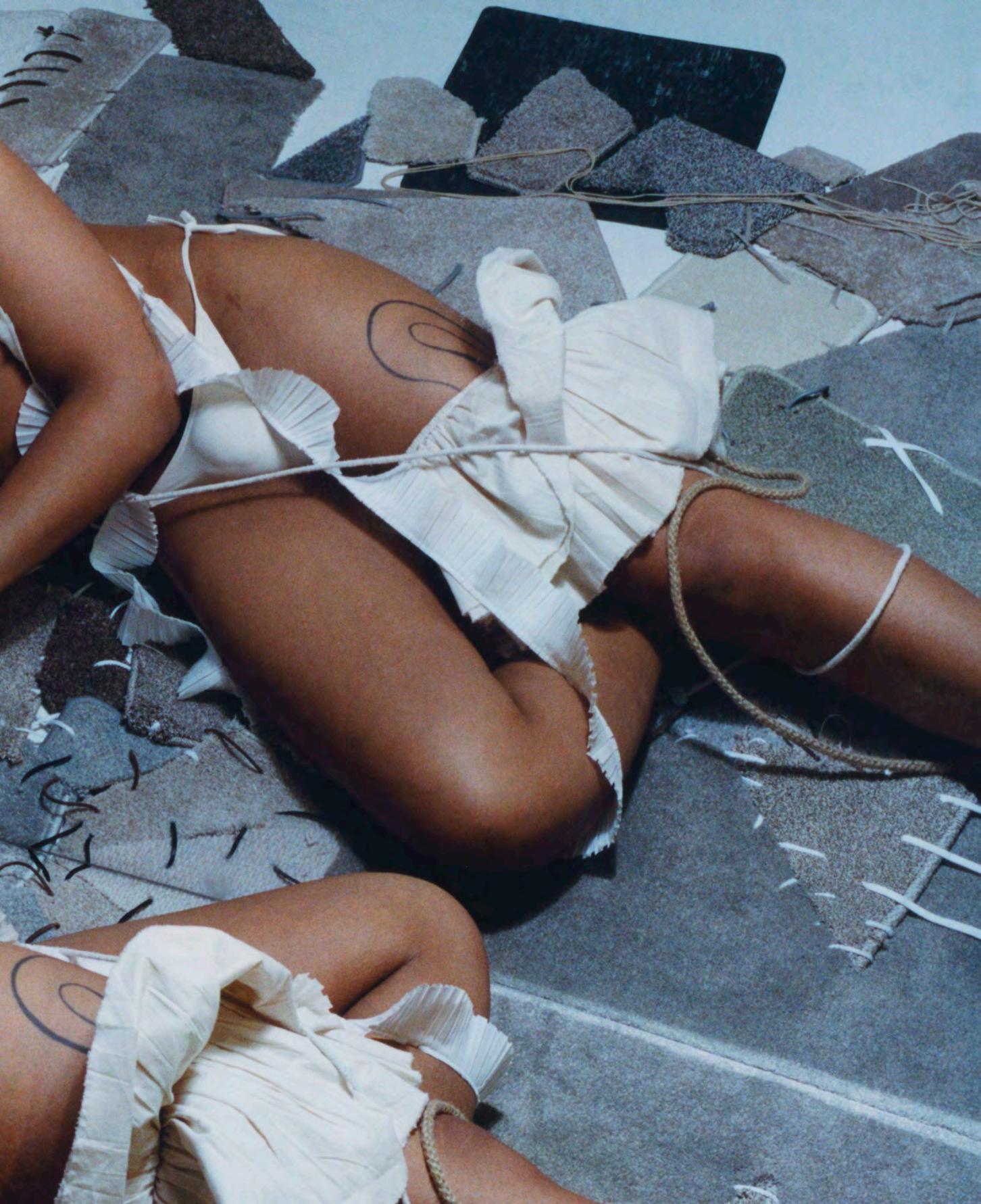 bikini Eres, latex bra and gloves Elisa Poppy, leg garter Evade House, jewelry Amy Rodriguez
bikini Eres, latex bra and gloves Elisa Poppy, leg garter Evade House, jewelry Amy Rodriguez

Rap, metal, grime, noise—Manchester-based Iceboy Violet defies norms of all kinds. Their debut mixtape as a vocalist, TheVanityProject, which was released this year, was critically lauded. Part of the queer dominated Mutualism Collective, Violet was also featured alongside Blood Orange on Blackhaine’s 2022 single, Prayer. Synthy and ambient, their songs are hopeless romantic odes of urban heartbreak that ricochet off hard industrial beats and complex rhyming structures. Amongst the eerily extant ruins of Manchester, Violet is quickly becoming a major voice in North England’s rapidly growing music scene.


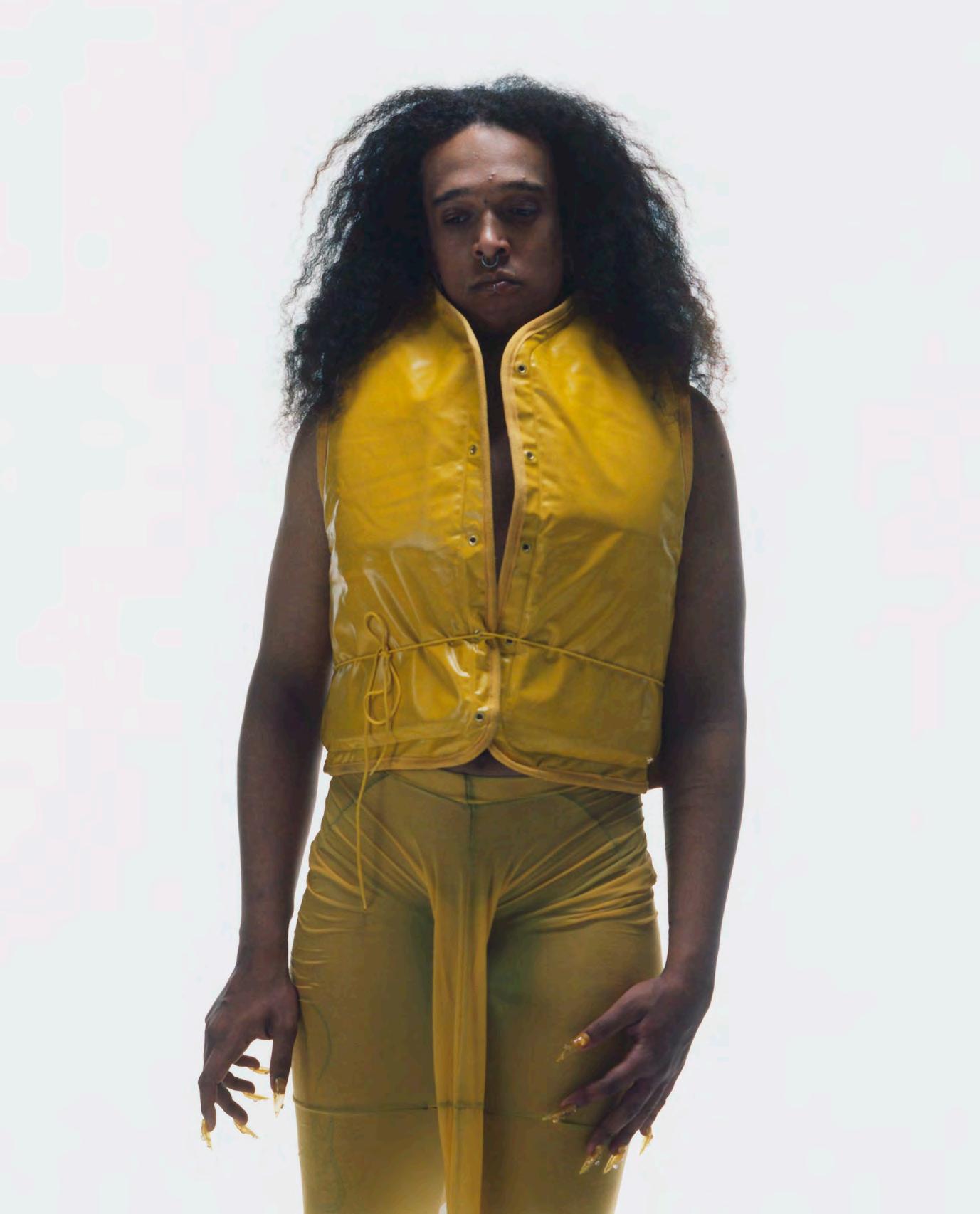
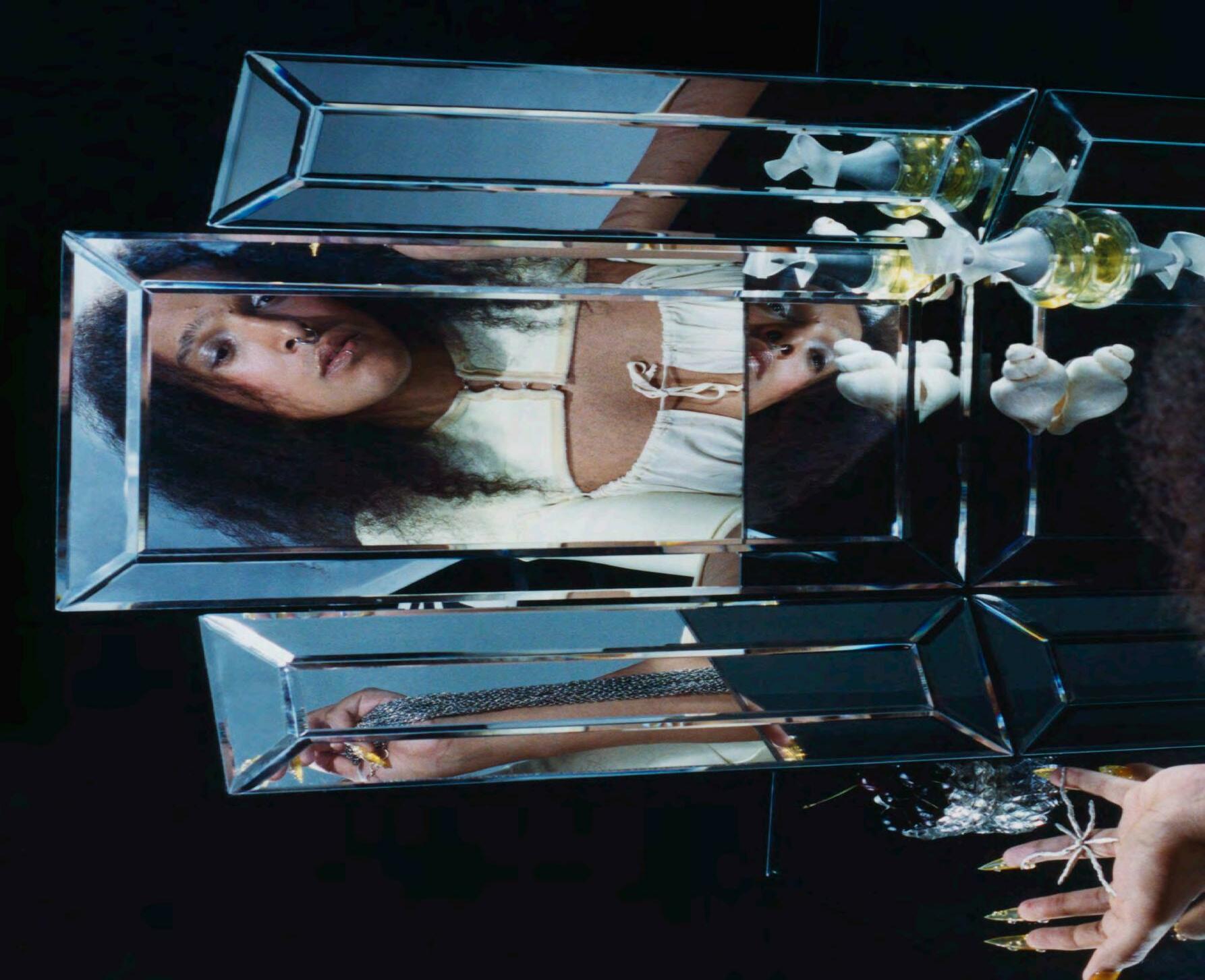 OPPOSITE
OPPOSITE



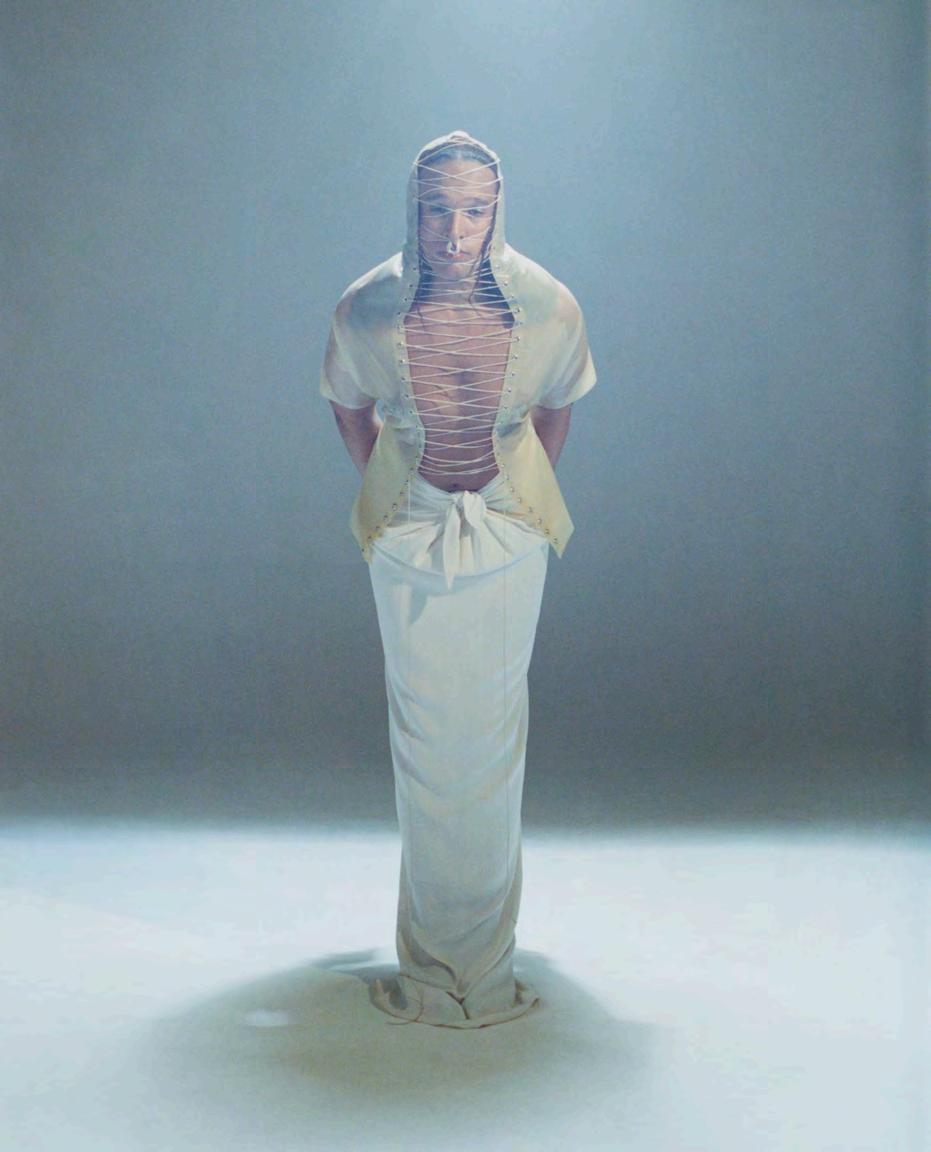

At the helm of the Italian fashion house Marni—founded in 1994 by Consuelo Castiglioni—its creative director, Francesco Risso, invokes a new, 21st-century, pagan renaissance through phantasmagorical mythos and sartorial storytelling. Among other luxury fashion designers, Risso stands out for his preternatural attention to detail, heritage, irreverent pattern making and disparate materiality that perfectly bridges the gap between the conceptual and the wearable. The DNA of Italian craftsmanship is evident in every thread and every pattern with a heavy dose of Risso’s imagined dreamscape. A designer with a peripatetic childhood at sea and an adolescence steeped in the '90s subculture of Italy, Risso has reinvented Marni as a brand with an unusually ardent and loyal fan base. In the following pages, Oliver Misraje invites Francesco Risso to ride a swanshaped pedal boat on Echo Park Lake where they discuss the designer's intuitively destructive process.
Francesco Risso pours an entire sugar packet into his coffee, stirs it three times, then leans back. A sweet-tooth is the second thing I notice about Marni’s creative director. First is his outfit: brown trousers, a dark blue leather coat thrown over a baby blue knitted sweater with a black and white checker pattern (all Marni), contrasted by his platinum hair gelled into little curls. We’re sitting in the corner of a subpar French bistrot in Los Feliz. Speakers directly overhead are playing Drake just a bit too loudly, but I can hear Francesco perfectly; his voice comes across with a distinct and crisp cadence. I watch the other patrons of the restaurant glance up from their soggy ratatouille and burnt escargot, trying to decide if he is famous and if so, why? It’s not so much his height or posture as it is an unassuming, catlike confidence that carries an air of nobility. In true Italian fashion, Francesco talks with his hands. They fan out, swivel, draw shapes and gesture, animating a boyish curiosity that sits just under his composed demeanor. In this case, he’s talking about Tim Burton’s 1993 film The Nightmare Before Christmas “I got in a fight at school once with this kid who was convinced The Lion King was a better movie. The Lion King? Are you fucking kidding me?”
Like The Nightmare Before Christmas, Francesco’s vision of Marni is a dark fairytale. There’s a quiet, persistent danger hidden just below the familiar storybook motifs and playful imagery. It's a Brothers Grimm tale, where the woods are foreboding and the daisies bare thorns. The pieces are as much material as they are negative space: carved, torn, ripped, or entirely absent from the silhouette. Symbology is inverted and hypercontrasted: flowers and spikes, studs and stripes, rags and patchwork. It's this tension that makes Marni so enchanting.
Francesco was born on a boat. A consequence of the many big, beautiful, but ultimately misguided, dreams of Francesco Sr., aka Chicco. Caught in the throes of a fantasy perpetually trapped on the other side of the horizon, his whims were often at the expense of Francesco and his mother, Elisabetta. But even so, with time Francesco grew to appreciate what he referred to as a double education:
“I inherited his voraciousness of dreaming. He was a brilliant man and he was cultured. But he couldn’t really attach himself to structure. My family comes from Genoa, a very conservative city, where creative jobs were looked down upon. But he was always the one building treehouses, and making clothes out of mattress covers.”
After seven years at sea, they returned to land. The transition was chaotic. No longer coddled by the sea as he lovingly put it, he lived in a multi-family household with many different personalities: grandmothers, grandfathers, half-siblings from both sides of his family, random friends and the occasional strangers. Naturally, Francesco
was a quiet child. Like most quiet children, he developed a vivid internal world and began experimenting with clothing at an early age. He tells me he didn’t have imaginary friends, but he’d cut up his family’s clothes to make his own kind. “Sometimes I still talk about it with my shrink,” he says laughing, “my sisters would get so upset, because I would steal their clothes and cut them up. It was a drug for me. It was not intentionally mean, I just had to do it for myself. It was quite pathological.” With fashion, he found an avenue to rebel against what he described as the, “decadent, noble, decayed reality of Genoa.” He led a double life in the local goth scene as a teen: the posh facade of his hometown gave way to a shadowy underworld of tight alleyways and sketchy strangers. He tells me, “I kind of looked like a scrap of some sort, with rags. I guess that is where I got my sense of this disruption, from the way I look at things.” Moonlighting at Nick Mansaniello, a members-only club that hosted a bizarre cornucopia of creatives and criminals alike, he developed an appreciation, not only for clothes, but for the characters that wear them, which would eventually inform Marni’s casting process.
Rebellion against austerity is still in the DNA of Marni today. “I don't realize how much I destroy,” He says, “My team takes the piss out of me. I get near a piece of clothing with my hand and I rip it and have fun, because somehow those rips just mold the piece in the way we want it. Sometimes that gesture creates an emotional tension.”
It’s the marks of a younger, mischievous Francesco, who would cut up his sister’s gowns. But his knack for deconstruction isn’t of the malignant sorts. It’s playful. Curious even. In A Magazine Curated By Francesco Risso, he collaborated with Merlin Sheldrake, Mycologist and writer of Entangled Life: How Fungi Make our Worlds, Change our Minds, and Shape our Futures , to inoculate a Marni sweater with mycelium. The photos are stunning: strands of white mold fan out like a nervous system over the vivid purple and yellow dyes of the textile. The garment’s destruction is as much a part of the art as its exquisite design. The decomposition feeds a brilliant oyster mushroom sprouted at the top like a gift bow that would later be cooked into an omelet. As above, so below.
At sixteen, after three failed attempts, Francesco ran away to Florence to study fashion at Polimoda, and discovered a thriving club scene. From there, he moved to New York City to attend the Fashion Institute of Technology, then London where he received an M.A. from the renowned Central Saint Martins. After university, Risso worked for several designers, including Anna Molinari at Blumarine, before joining Prada in 2008 to work on womenswear. Eight years later, he was appointed creative director of Marni.
I asked Isabelle Adams, an LA-based fine artist who has walked in the shows the past four seasons, to elaborate on the
‘Marni Look’. It’s not something that can be reduced to physical attributes in the same way that the ‘YSL look’ is Nordic twink. She described, “a certain alien quality in the face that is not conventional, regardless of the specific way a person looks or whatever demographic they occupy. It’s a discreet quality. In a way it almost seems archetypal, like there is something in every model that anyone can latch on to. An essence that carries some sort of visual weight.” Marni was created in 1994 by Consuelo Castiglioni, who gathered a humble cult following for a look she described as normal eccentricity The brand was always quirky, but it wasn’t until Francesco’s tenure that it became freaky. If Castiglioni’s Marni was microdosing shrooms, Francesco’s is smoking DMT from toad warts. It’s that gleeful disjointedness— the constant undulations between good trip and bad trip—that makes Marni so tantalizing. The Instagram bio, “The fashion industry’s fashion brand” speaks to its origins as a niche, but respected house. Since then, it’s become increasingly ubiquitous. In an analysis by Kona Equity, Marni’s annual revenue growth makes it one of the most profitable brands under the OTB umbrella.
After finishing our meal, we head to Echo Park Lake to ride the swan boats, the same lake depicted in Roman Polanski’s neo-noir Chinatown (1974). He’s only in town for an unseasonably cold weekend, but neither of us seem to mind. On the way there, I ask if he’d ever consider hosting a show in LA. “Not right after Gucci,'' he says, half joking. “But it’s certainly a possibility.” Gucci’s Love Parade was held on the Walk of Fame last November. It was a glittery tribute to Hollywood glamor that ultimately suffered from an inability to look beyond LA’s most worn tropes. “In a way we are the opposite of the Hollywood recipe,” Francesco tells me while watching pedestrians from the passenger window. “I feel very connected here, probably because of the variety, as well as the variety of stimulations. You find yourself on the hills, looking at the city, in the middle of nature, and then suddenly you drive twenty minutes and you’re in a posh highrise. I mean it is incredibly scattered. I like to approach Marni with a similar spirit.”
There’s a generous portion of the ‘Marni family’ that call the city home, there’s the many celebrity aficionados—Jonah Hill, Erykah Badu (whom Francesco dressed for the MET gala), Lil Uzi Vert, Kendrick Lamar, Drake, Miley Cyrus, Offset, to name a few.
And then, there’s the general aesthetic sensibility that appeals to a different side of the California fantasy—the barefoot-inTopanga-tripping-at-golden-hour sorts— that can just as easily teeter into bad-tripManson-fever-dream territory. Before our interview, I got Francesco a used copy of Nathanael West’s Day of the Locust, from The Last Bookstore downtown as a crash course on the darker side of the Hollywood mythos. Several months later he’d send me an underlined paragraph from the book:
It is hard to laugh at the need for beauty and romance, no matter how tasteless, even horrible, the results of that are. But it is easy to sigh. Few things are sadder than the truly monstrous.
We arrive at the park, sign the waivers, and don our life jackets. Thick billows of ocean fog push eastwards in the distance, casting a gloom over the lake. But Francesco is in good humor—he’d much rather be interviewed on a giant fiberglass swan boat than at a trendy French bistrot. That aforementioned boyish curiosity is infectious. There’s a strange poetic justice in riding a swan boat with Marni’s creative director, considering I was introduced to the brand largely by accident a year prior.
Tucked behind six trees on an innocuous street in Melrose, the Marni store is a small rose-brick building draped in ivy. It’s shrouded enough to be missed by passing cars but as fate would have it, I was walking on that street during a particularly unforgiving heatwave. It caught my attention partially because of how odd it looked on Melrose, but mostly because it had air-conditioning. It was like “California Dreamin’” by The Mamas and The Papas, but instead of seeking refuge in a church, it was 105° and I was in an Italian clothing store. I pretended to shop around for a few minutes, then quickly found myself amused at the disciplined chaos of feathers and fluff and paint and patchwork; how each piece was endowed with a strange, animal intelligence, like creatures out of a Dr. Seuss book. I left with a vague lingering curiosity. This is the romance of Marni. One I wouldn’t put into words until that moment on the swan boat. We alternated between steering and pedaling as he told me that, “Part of Marni’s DNA is the idea that an object has a soul, has a history, almost like the mythology of an object. When I work, I like to think that clothes can somehow transmit some kind of decoded history and experience of some sort. It is one of the bones of this big skeleton.”
Then it occurred to me: Marni is a pagan fashion house: It’s based on an animistic logic, where the natural world is imbued with metaphysical significance, where ceremony is the ultimate expression of the human spirit, and the tribe is prioritized over the individual. The ‘soul of material’ was a core belief of pre-Christian paganism, where there was never a delineation between the mundane and the divine. Craftsmen were assigned guilds with their own rites and rituals, each under the dominion of particular deities and spirits. Material was imbued with an innate character and alchemy, simply the transformative process that turns flour into bread, or mohair into a Marni sweater. After almost steering our boat into a troupe of ducklings, I brought this idea up to Francesco. He stopped pedaling for a beat to think, then said, “Paganism fascinates me. I see Marni like that, as if we’re in a sect
somehow. Everyone in the team has such a specific, charming talent. It is almost like we’re witches and wizards.”
The Spring/Summer 2022 collection, titled Wear We Are, was Marni’s most exuberant rite. Their first in-person show since the onset of the pandemic, it was an orgasmic celebration of community consisting of a choir, a spoken word performance by Mykki Blanco, movement choreography by Michele Rizzo, and musical direction by Dev Hynes, which included a live orchestra and an original composition performed by the infallible Zsela. And then, there were the five hundred guests, each individually dressed in a ‘Marni Uniform’ of repurposed, handpainted deadstock—a sanctifying ritual garb to blur the lines between audience and model. He tells me, “It was very challenging and ambitious. I wanted everyone to enjoy this ritual, to participate, and the uniform was a way to place everyone on the same playing field: the journalists, the models, the clients, the family members.” The show began with the slow procession of the choir (all dressed in Marni) singing a hymn. Guests sat along a wooden platform arranged into concentric circles, as the first wave of models sauntered through the winding isles like pedestrians caught in a daydream. In ceremonial magic, hermetics would cast circles to consecrate special regions of space and time. Magician and historian Jake Stratton-Kent writes, “a circle is not an obsolete symbol of superstition, but an intentionally created ritual space. Making sacred space is among the most primal of rituals, such intentional actions are worthy of the term psychoactive as any substance.” In Wear We Are, the circular runway consecrated the recurring stripes and daisies of the collection with the stripes symbolizing movement in space and the daisies symbolizing growth in time. There’s a spiritual poeticism to the lapping movements of the models wearing each respective motif that would be lost to the single dimensions of the linear runway. It was a nonverbal statement of solidarity: we might not know what the future holds or where we’re going, but we have each other, and for now, that is enough. There was still Francesco’s knack for disruption—ponchos with inverse stitchings, dresses torn to ribbons, oversized blazers, and punk headpieces—but there was also a playfulness embedded into the hand-painted dresses and trompe-l’oeil sock stilettos and handbags.
Choreographed by Michele Rizzo, the ‘Marni Walk’ is really more of a stroll. Francesco says, “We tell our people to walk like they’re on the street. We want to capture that specific feeling you experience when a beautiful stranger walks past you.”
For Francesco, the classical runway reflects the alienation of modernity: viewers watch at a distance while models strut down an invisible, governing flow of movement like products down a conveyor belt. I had a brief stint as a model when I was nineteen. I remember a casting director instructing
me to walk like you don’t want to be here , which wasn’t particularly difficult given the humorless setting. Back on the swan boat, Francesco says, “I refuse the concept of the fashion show. A model with clothes walking in a cold environment doesn’t transmit anything. I want the tension that comes with intimacy, there’s a rhythm we try to achieve between the spectacle and the audience. It’s that friction we look for.”
Each stream of models were introduced in coordination with the music, as if they were their own family of instruments participating in the symphony. After the first wave , the lights dimmed, illuminating the center stage where Mykki Blanco recited a poem, spoken like an invocation: “What marvelous beings of light are created from our breath, what marvelous, marvelous, beings of light. I sink, I sink into a smile that floats above me.” And then bellowed between hip thrusts: “I am the primal ejaculations of the mountains!” In the final stanzas, Blanco encapsulated the heart of the show: “It is a promise when we give ourselves away.”
After finishing our allotted hour on the swan boat, we head to a cafe nearby to wrap up our conversation. Francesco orders a lemonade and begins talking about the architectural layout for several new Marni stores. There’s a massive boulder suspended between the first and second floor of the Shanghai location with a fullyequipped artist’s studio inside, as though the store were rebuilt around a crashed asteroid. In Milan, there’s a hole between three stories housing a micro apartment complex made from recuperated car materials. Retail store is a misnomer. Each location is a home base for different artists and designers in-residency. The space within a space creates a unique scaling of perspective, like staring into a peephole— an intentional dynamic created by the architects and interior designers: “If you’re a painter and painting in a retail space, it’s going to be really different from painting in your studio or on the side of a mountain. How does that integrate seamlessly, but also collide, with retail? We don’t know what will come out of it, but we find this unknown element interesting.” Francesco isn’t just designing a shopping experience, he’s curating a Genus Loci, or spirit of place the ancient Roman idea that physical space is enchanted with a sentience made manifest in the architecture and interior organization of the enclosure. The modular living arrangements were inspired by Andrea Zittel’s Wagon Stations, an artist based in Joshua Tree whose practice integrates the natural landscape into clothing, furniture and food, to imagine a more holistic relationship to the environment. Like Zittel, Francesco’s fantasies are meant to be occupied. He says, “Fantasy can be achieved in simplicity, I want to exalt the humanity of the everyday, of getting up.” It’s why Marni is not glamorous. Glamor requires distance—perpetually
intangible and unachievable. It can’t exist in Marni’s dedication to presentness. Ashley Mears writes in Pricing Beauty: The Making of a Fashion Model , “Glamour, after all, has its roots in medieval Celtic alchemy. ‘Glamer’ is a spell used to cast an illusion, a magic charm, that is cast to blur the eyes and make objects appear different from, and usually better than, their true nature.” As Mykki Blanco said during her performance at the Spring 2022 show, “Seek something other than future sensations.”
Francesco is interested in time and its relationship to textile: what histories are embedded into our clothing, and how does a garment live, last, and deconstruct in time? In 2019, Francesco traveled to China to live, eat and learn among the Miao, an ethnic group in the Southern mountain region famous for their intricate embroidery, weaving, and silver making. In lieu of a written language, the Miao use embroidery to document the passage of time, and the respective histories of their house and family. Francesco told me about a woman who had been working on a coat for her daughter. She started nine years ago, and would likely take another five years to complete it. He says, “They perceive the passage of time like a symphony, where things are layered rather than in consequence. I’m attracted to this sense of timelessness. At Marni, we also make objects that live in time, but ultimately we’re about the moment. We’re dedicated to the sparkle of the now.”
The wearing of history was a central theme of Marni’s Fall/Winter 2022 show, which wouldn’t take place until several months after our interview. After Francesco orders another lemonade, I ask him if he has any clues to drop for the upcoming season. Between sips he says, rather cryptically, “I’m interested in the future but the future I’m interested in is completely un-futuristic.”
The show would be held in a nondescript Milanese warehouse, home to a dimly lit cavern, housing a small, man-made forest. With no seats, the audience crowded around a pathway of rocks in near darkness anxiously awaiting a commencement that wouldn’t happen for another forty-five minutes. Some whined, others relished in the ambiguity, but once again, all were forced to participate. With no boundaries separating the audience, the models entered through the center of the room, pushing past a crowd to a raised ground walkway, while guided by a masked man with a flashlight. In the show notes Francesco wrote, “The future came and went, leaving us alone, together in the dark, but lighter than before. Where do we go after? Where are we bound, beyond what binds us to each other?” In a similar vein as the Miao, the collection was a historical document. Evident in the repurposed rags and patchwork, you get the sense that the garments were made to be played in, dirtied, destroyed, then repaired into something new and eventually passed on. It’s a circular notion of time in which the
past is incorporated into the clothing itself.
Much like the Argo from Greek mythology, with each mutation, a discrete essence persists. Francesco debuted a collection of hand-tailored suits in collaboration with Attolini atelier. Inspired by Walter Benjamin’s The Work of Art in the Age of Mechanical Reproduction, which emphasized the importance of tradition to assure man-made objects can retain their soufulness, the collection was a marriage between Marni’s edge and Attolini’s heritage. Established in the 1930s by Vincenzo Attolini, who liberated the suit from the restrictive, shoulder-padded English standard, the atelier still tailors by hand with each jacket taking over twentyfour hours to produce. “I was blown away,”
Francesco tells me, “not just about the suits themselves, but the way the practice is passed down from the elders to the young.”
It was another way to grant the past a seat in his vision of the future. After exiting the runway, each model entered a shaded trail in ‘the woods’. Guided only by a flashlight, they wandered in the dark, dressed in their various histories. Outside, guests were greeted by a decadent feast fit for the Mad Hatter where all the models sat, still dressed in the collection, happily chatting in their post-show glow. Francesco’s utopia isn’t one of endless technological advancement.
It's one of communion, with each other and with the past.
It’s dark out when Francesco finally leaves the cafe. He said to me in parting, in his characteristically genial way, “You have to come out to one of our shows some day.”
It was like a friendly challenge—rather than write about Marni from a distance, it was an invitation to experience it firsthand. And who wouldn’t want to step further into his strange, beautiful world? This is the romance of Marni—that ephemeral, lingering desire to go chasing rabbits.
end

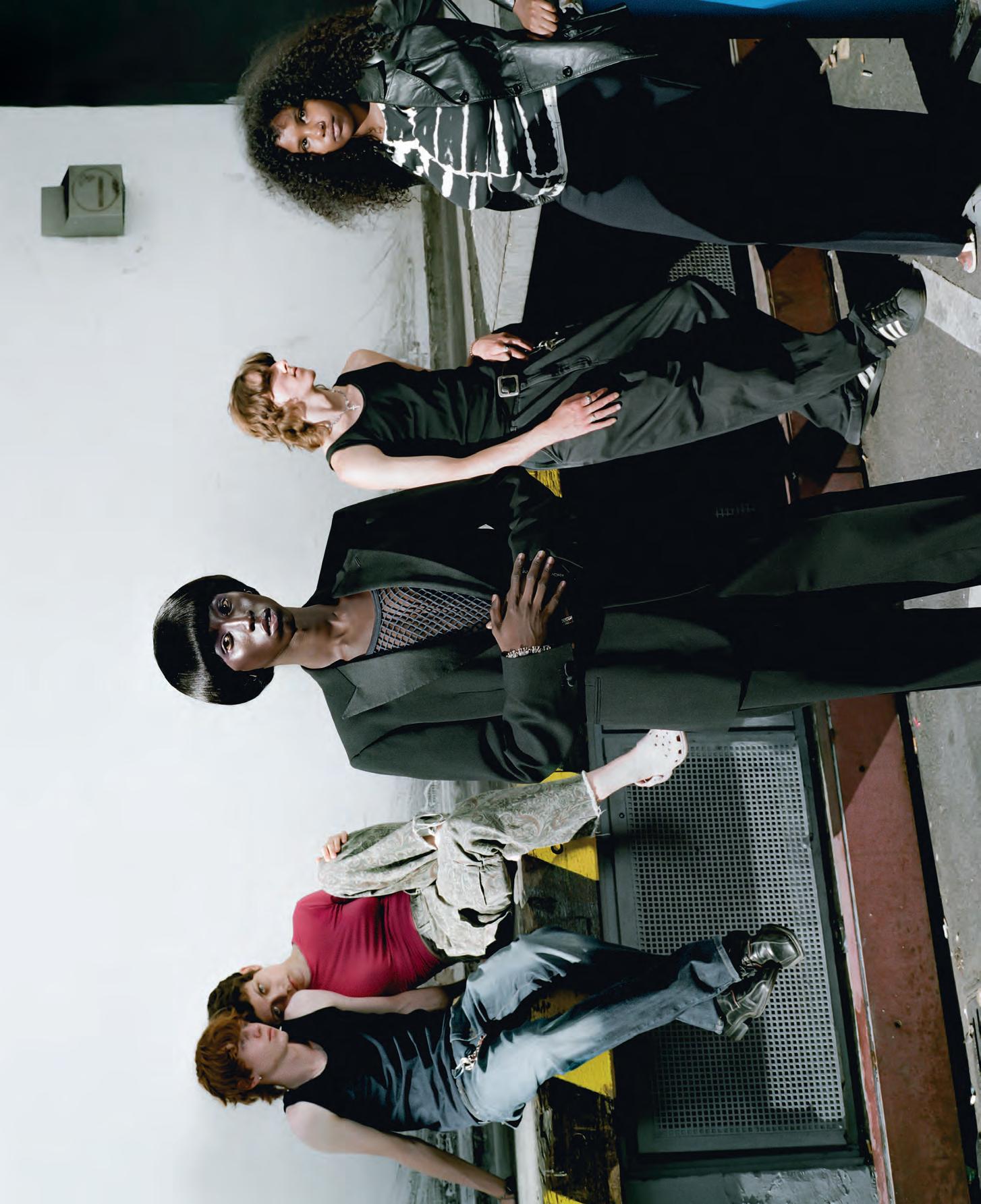
“Every morning in the bathroom I would repeat the same phrase to myself over and over again . . . TodayI’mreallygonnabeatoughguy.” Featuring Marni's Fall/Winter 2022 collection, which includes handmade suits by the legendary, nearly 100-year-old Neapolitan tailoring atelier Attolini, this editorial is inspired by Édouard Louis's searing autobiographical novel, The End Of Eddy (2014), about growing up gay and below the poverty line in a working-class French factory town. Already translated into twenty languages, the tour de force novel captures the agony and ecstasy of standing out from the crowd, and embracing otherness despite social pressure.

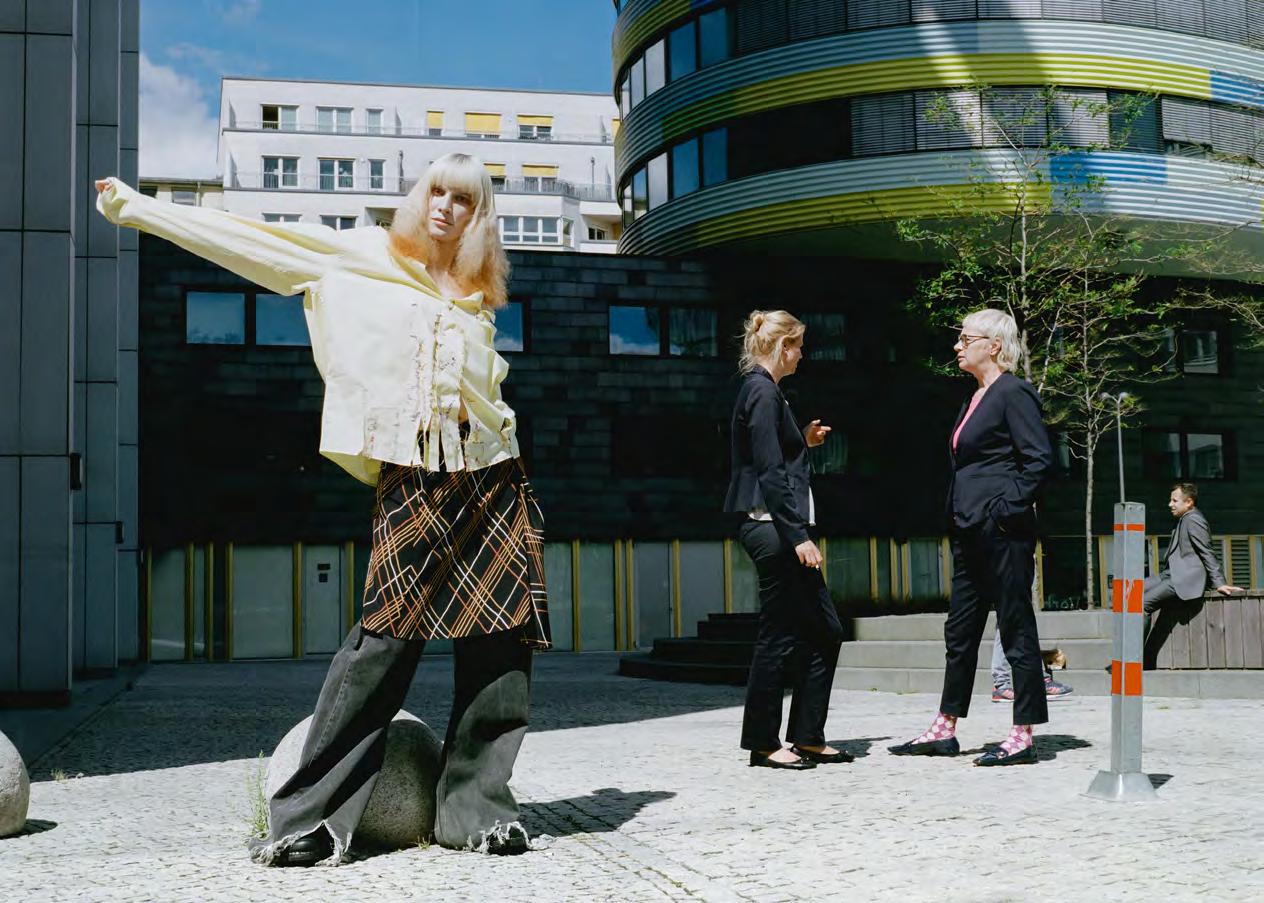
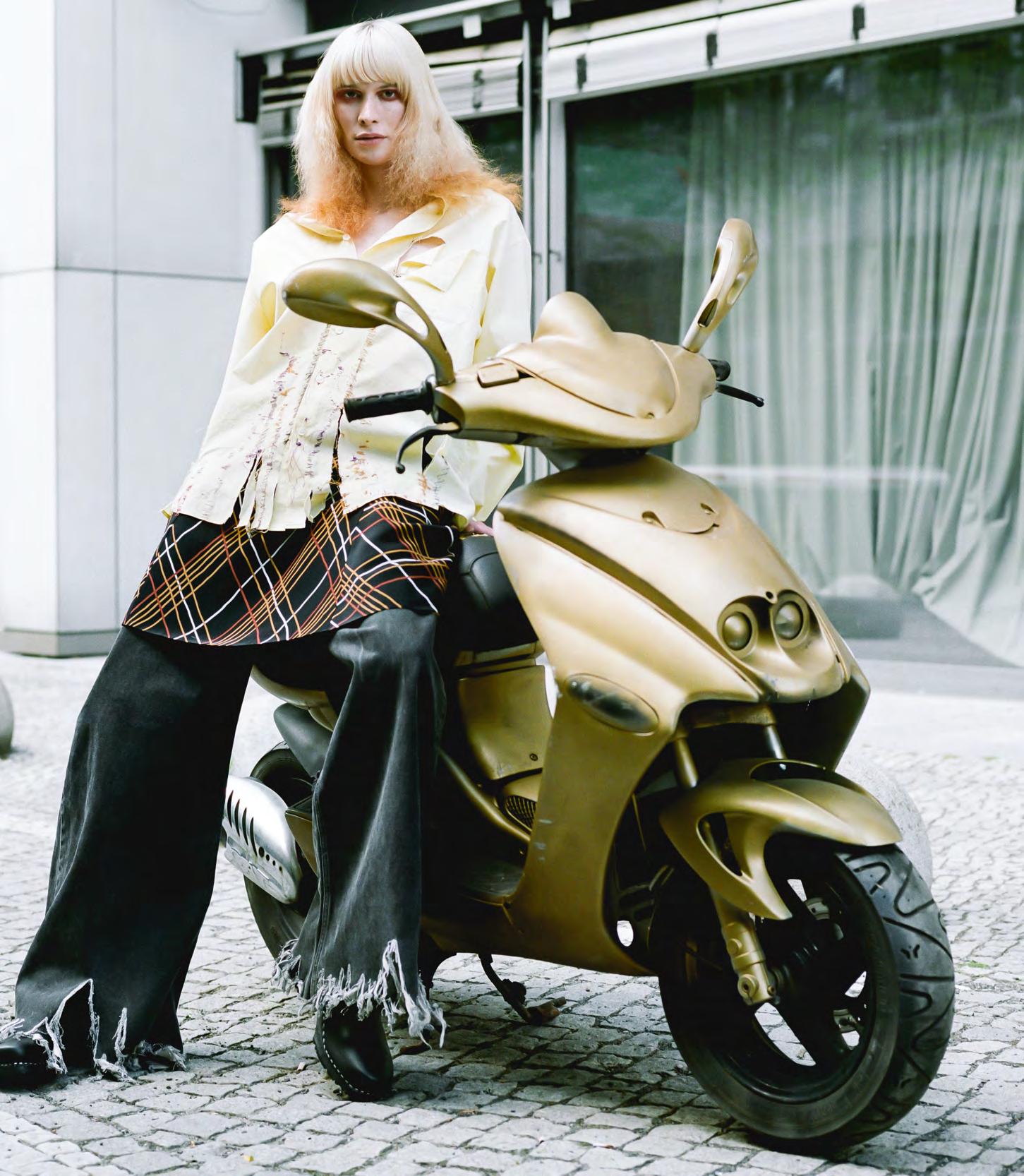

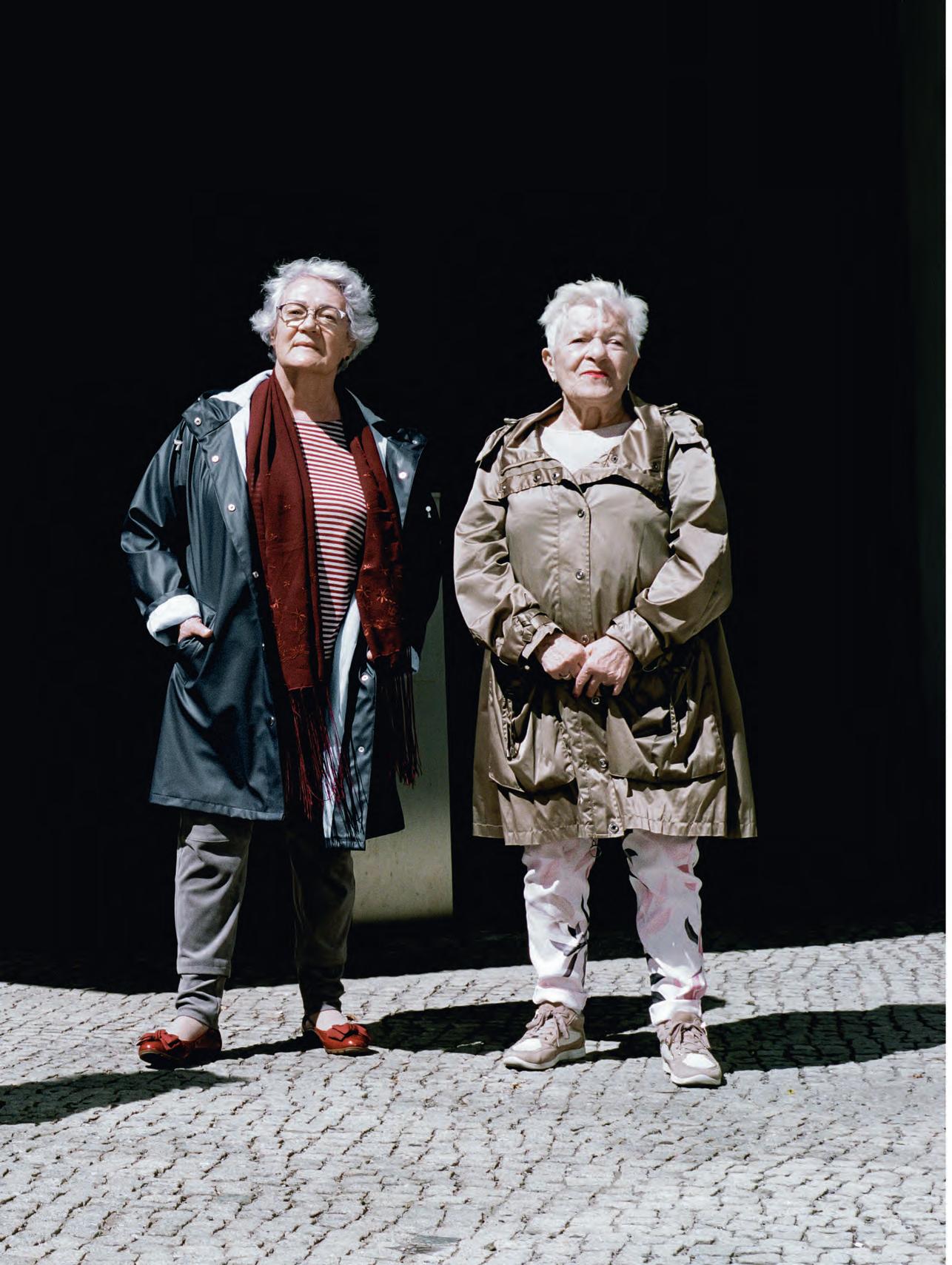

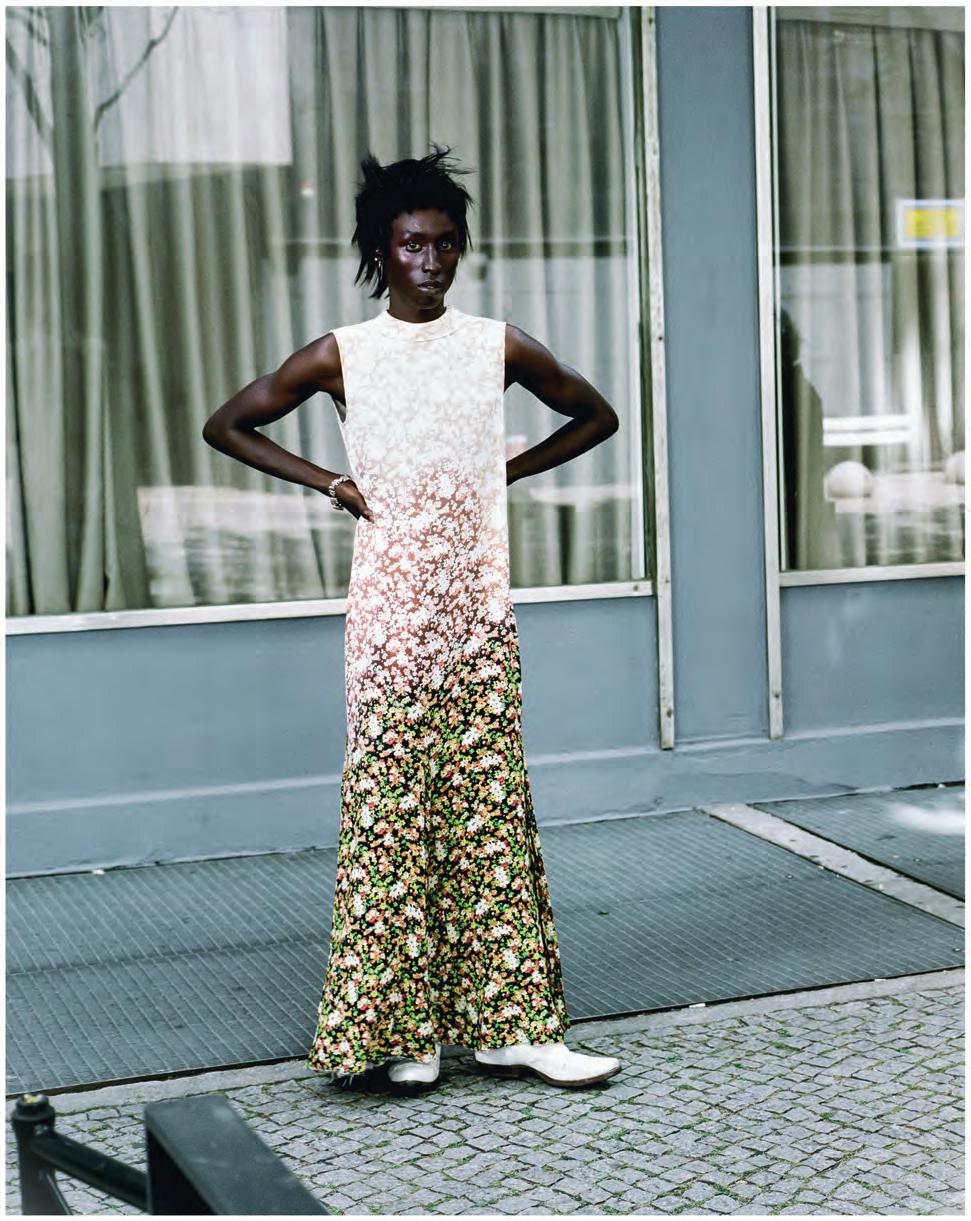
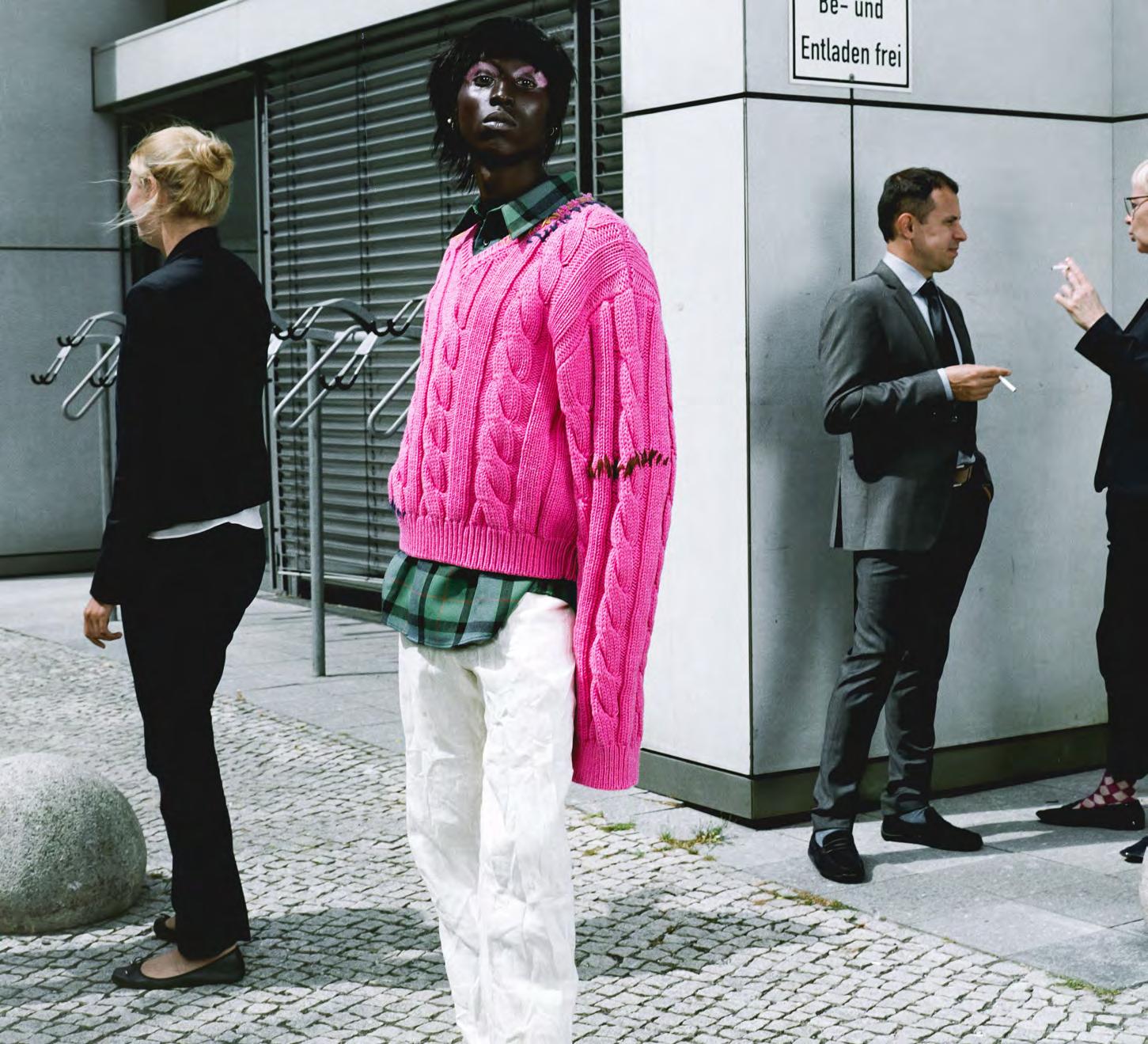

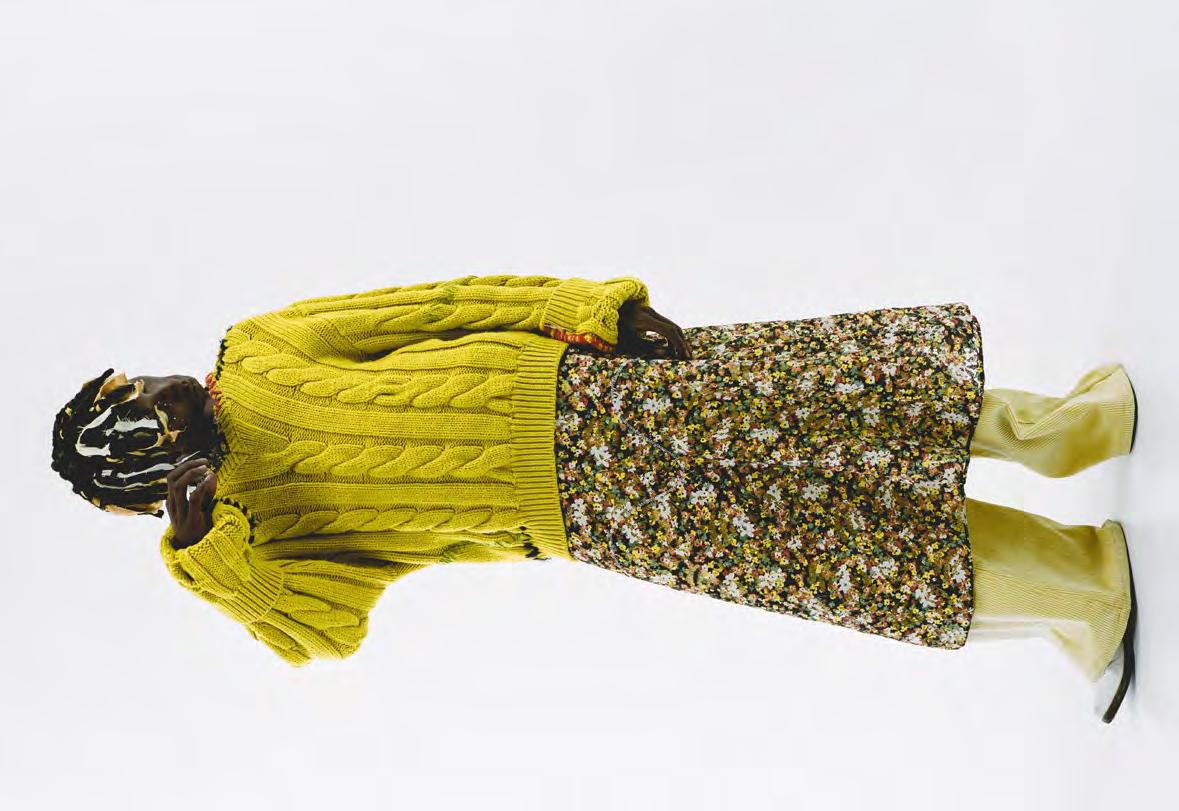





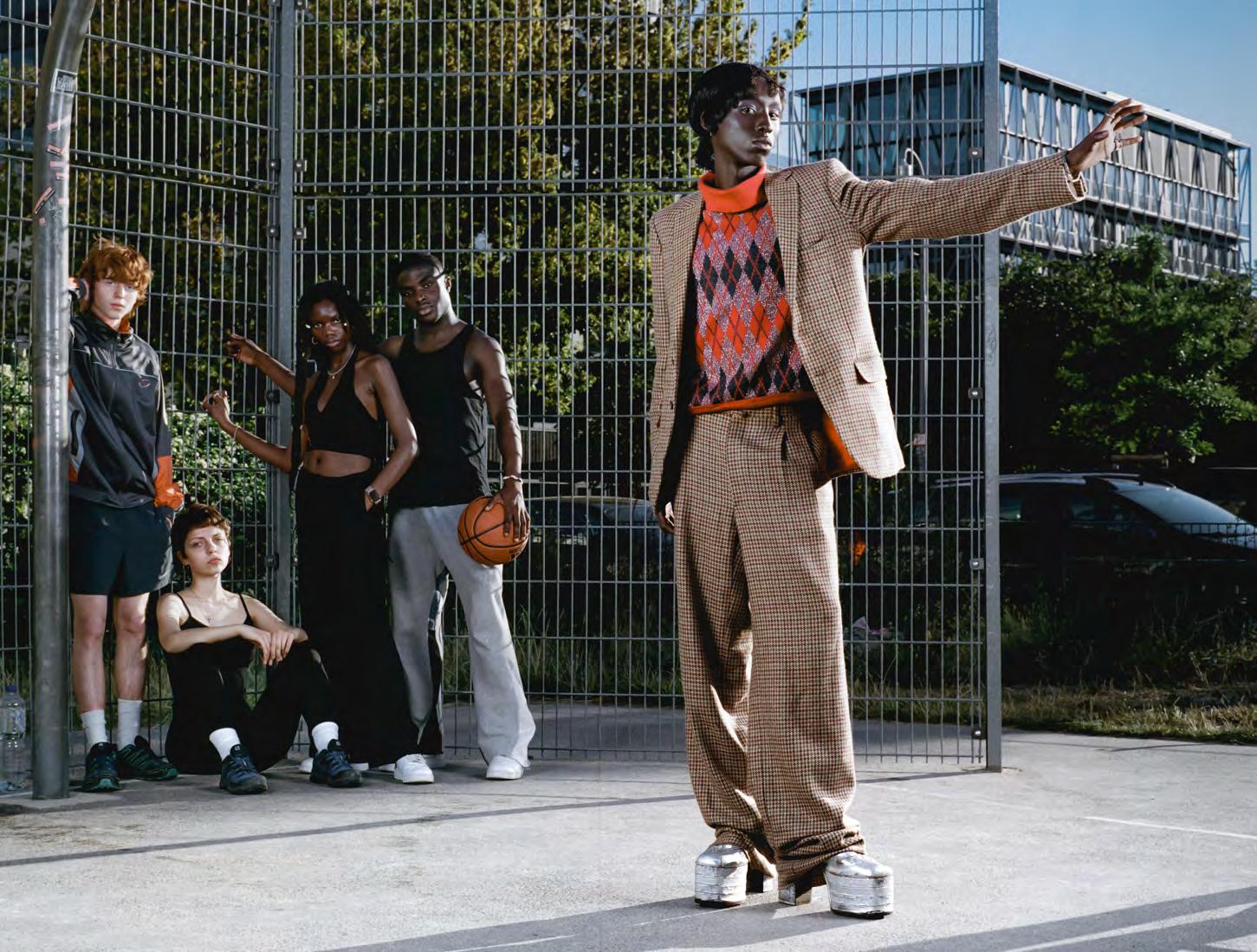
Once upon a time in Berlin….These days, trying to get laid IRL can feel like an odyssey through the haunted woods of a fairytale. In “A Tale Of Lost Chats,” Autreteamed up with Grindr, the world's largest social networking app for gay, bi, trans, and queer people, for a unique fable that blends fact and fiction. It is a how-to on navigating postmodern romance in the chaos of the information age. The chats are real. And most of the models—all serving Turkish Mediterranean realness—were cast through the app. The interiors are inspired by the domestic environments typical of Anatolian villages: crystal blue evil eye amulets, blankets and rugs, prayer shawls, black tea, baklava and bağlamas. From Bodrum to the bedroom, this is a tale of sex, desire, and a search for communion. Proof that an app like Grindr can serve as a vital tool for breaking through religious, societal, and cultural barriers—where queer Turkish men can find sexual liberation and freedom. A break from shame and stigma. This is a story of logging in, logging off, and getting off—an erotic exploration of Grindr’s wide menu of kinks, fetishes and simple delights. In Grindr’s enchanted forest, bears, otters, hustlers, sailors, and daddies may only be meters away. The moral of this story: be safe, be free, and don't lose your chats.


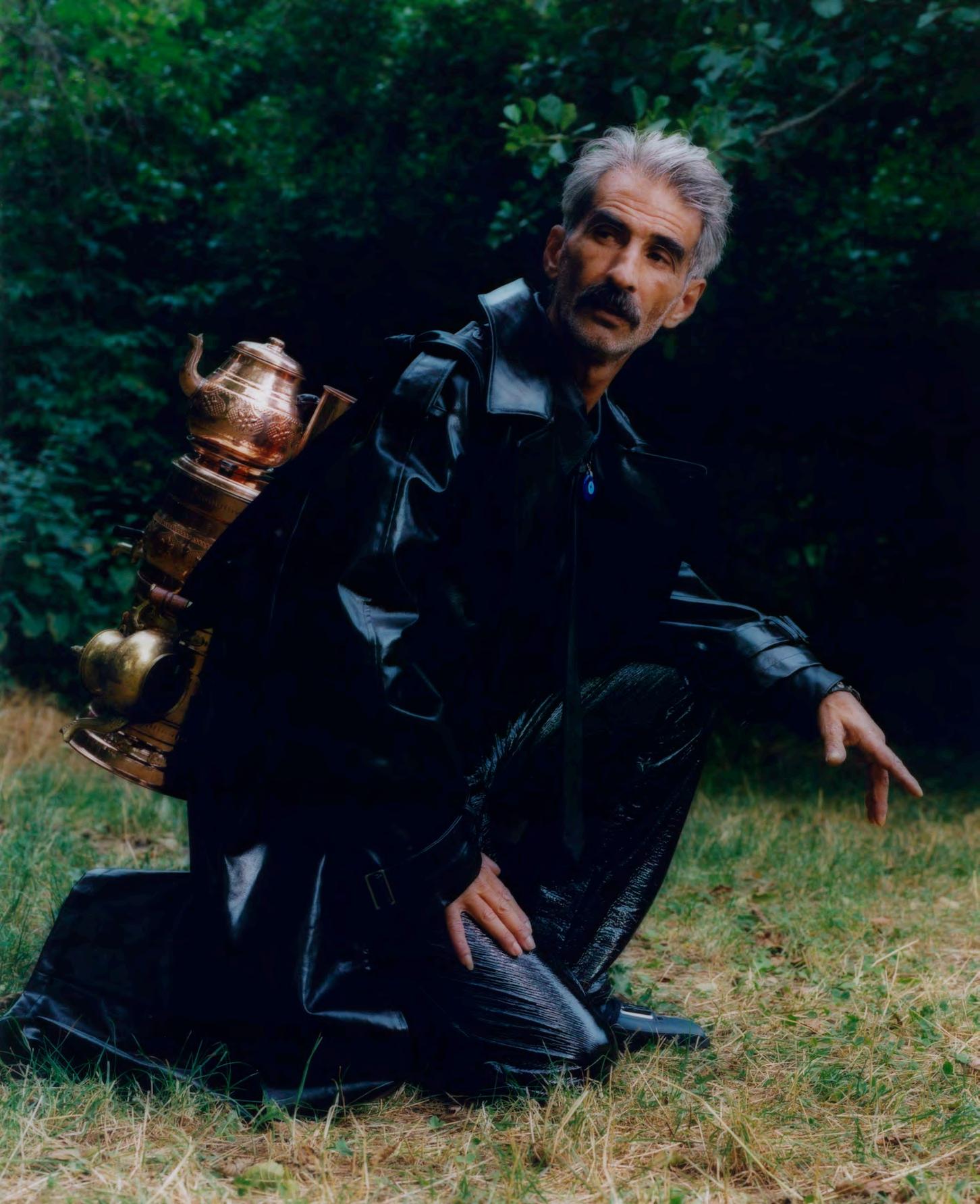
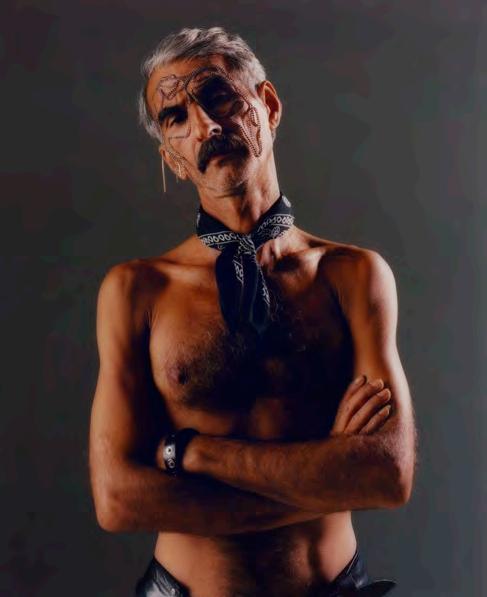

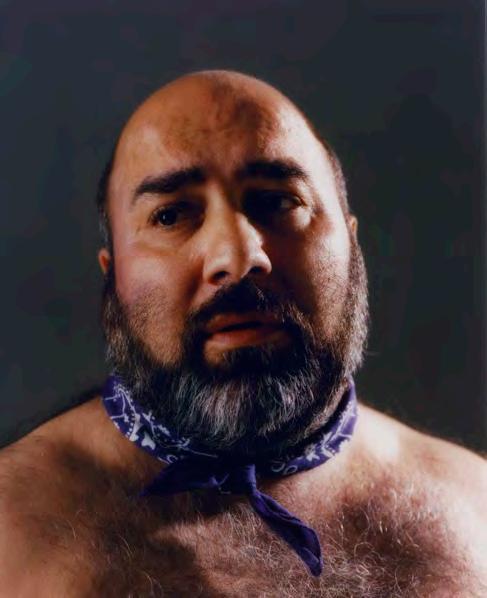
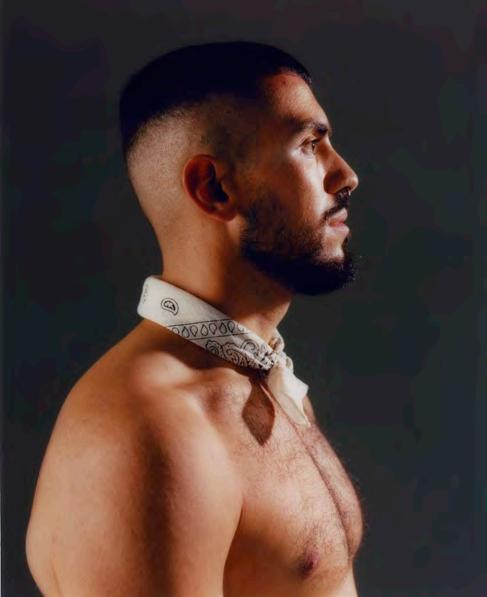


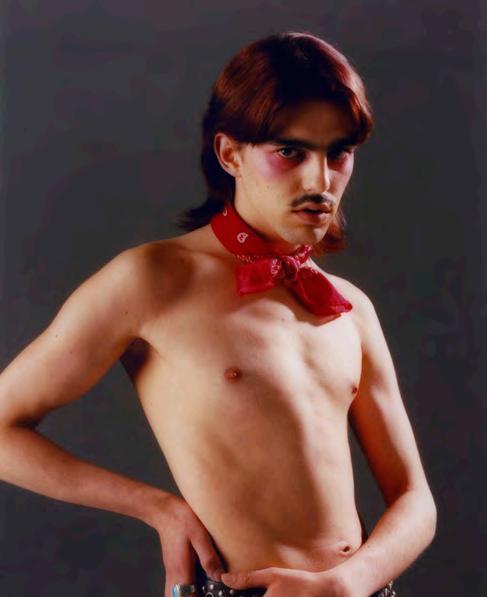


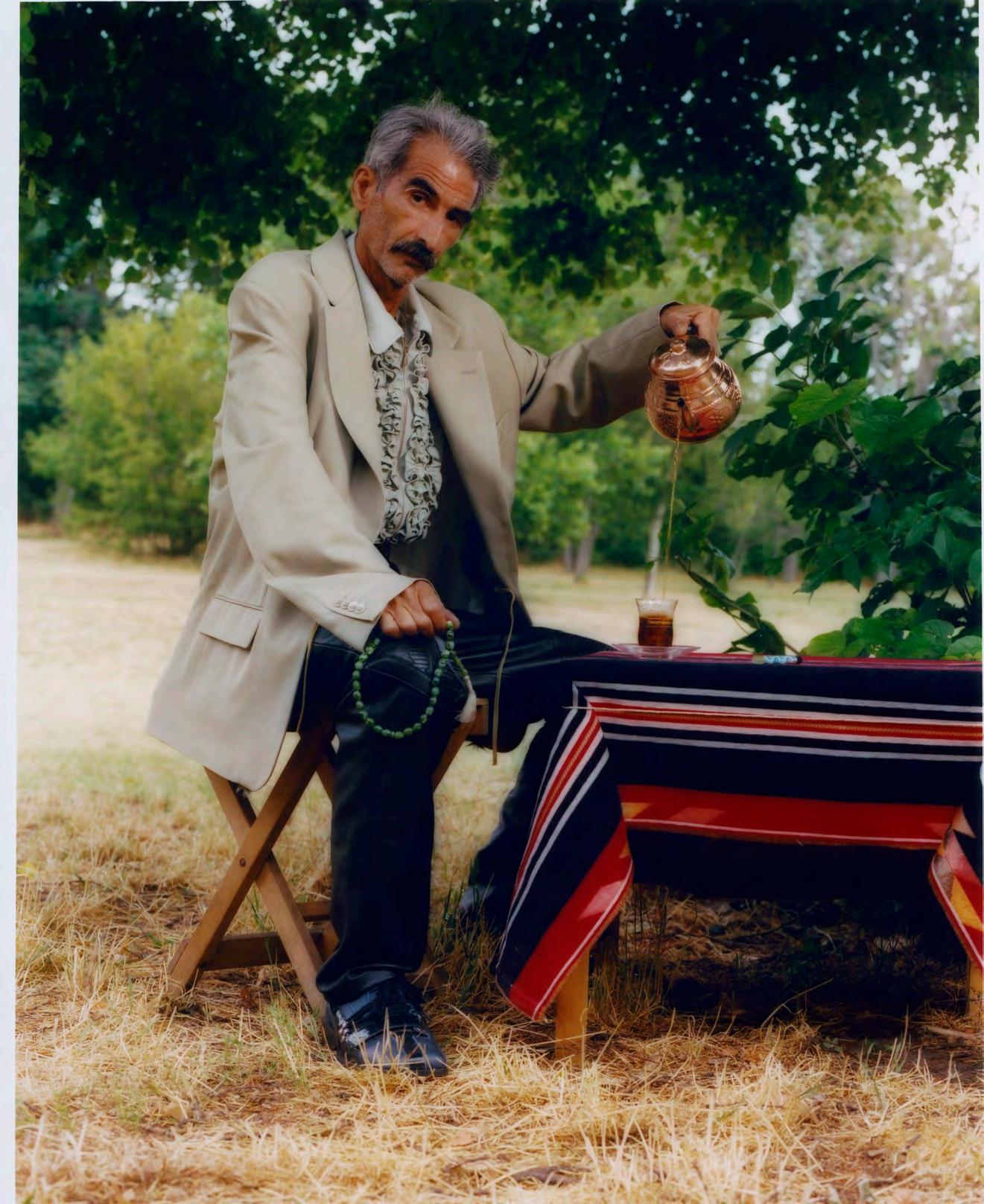



THIS PAGE Ömer wears jacket Magliano, track pants Adidas, necklace and tesbih stylist’s own, ring Versace. Lorenzo wears full look and sliders Adidas, necklace models own, socks Falke OPPOSITE PAGE polo shirt stylist’s own, sleeveless turtleneck and trousers Versace, keychain stylist’s own, socks Falke

 THIS PAGE Hossein wears full look Diesel, leather prayer socks and belt stylist’s own, socks Burlington. Ömer wears pullover and scarf Magliano, t-shirt, trousers and tesbih stylist’s own, socks Burlington. Eren wears shirt Études, sweater vest Wood Wood, trousers Y/Project, socks Falke Şafak wears longsleeve Études, t-shirt Magliano, track pants Adidas, socks Falke OPPOSITE PAGE faux fur jacket and trousers Georges Wendell, shirt Kenzo, necklace stylist’s own, socks Diesel
THIS PAGE Hossein wears full look Diesel, leather prayer socks and belt stylist’s own, socks Burlington. Ömer wears pullover and scarf Magliano, t-shirt, trousers and tesbih stylist’s own, socks Burlington. Eren wears shirt Études, sweater vest Wood Wood, trousers Y/Project, socks Falke Şafak wears longsleeve Études, t-shirt Magliano, track pants Adidas, socks Falke OPPOSITE PAGE faux fur jacket and trousers Georges Wendell, shirt Kenzo, necklace stylist’s own, socks Diesel
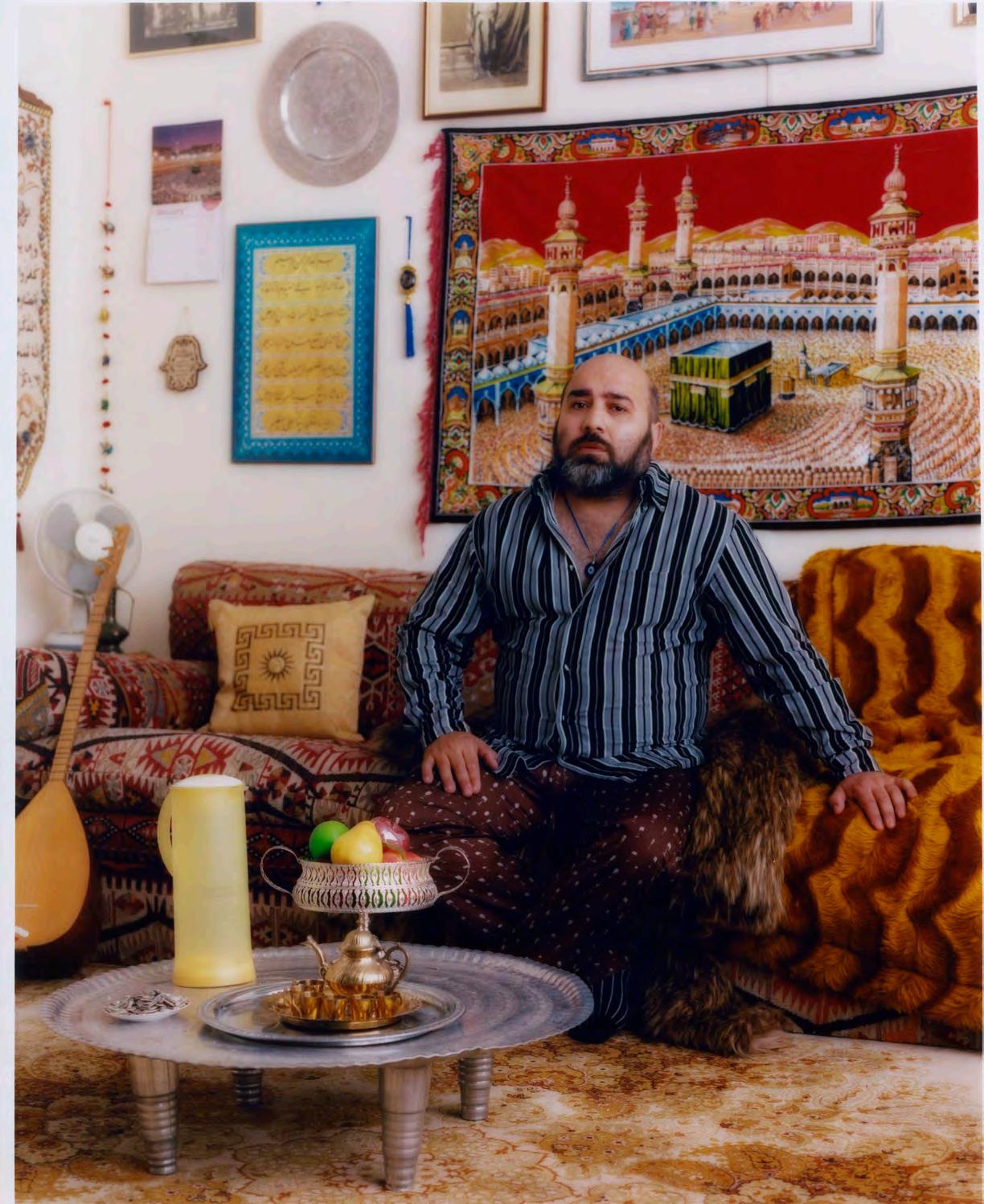

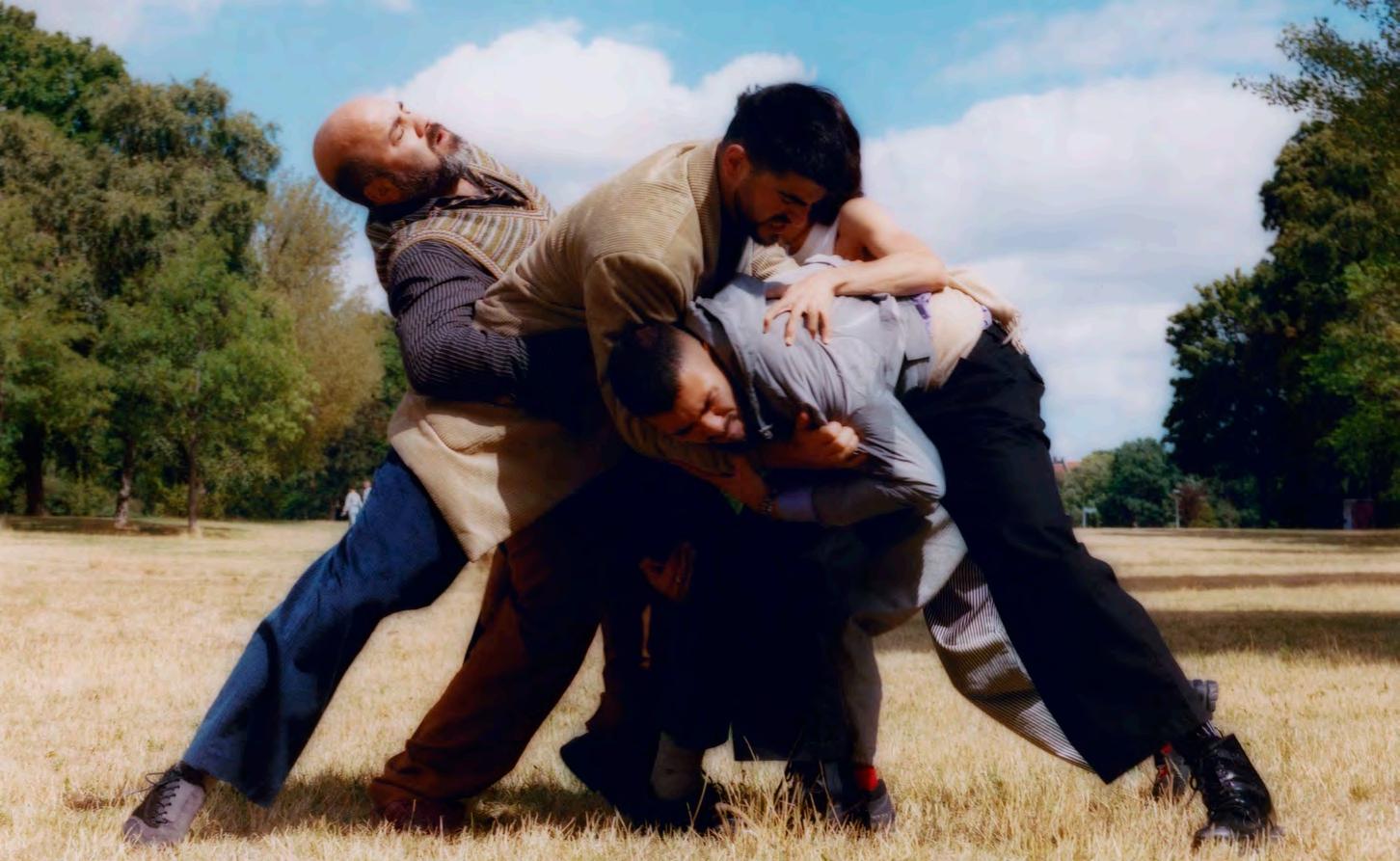
Hossein wears full look Celine, shoes Georges Wendell, socks Falke Youness wears jacket Adidas, shirt vintage Thierry Mugler, trousers stylist’s own, shoes Kenzo, scarf Magliano, necklace and tie stylist’s own. Metin wears polo shirt Ralph Lauren, knitted t-shirt vintage Missoni, blazer Magliano, trousers Études, shoes Our Legacy. Ömer wears vintage shirt Valentino, sweater vest Wood Wood, trousers Sandro, shoes Marsèll, tie stylist’s own. Lorenzo wears top Axel Arigato, dungarees Kenzo, shoes Kiko Kostadinov, socks London Socks.

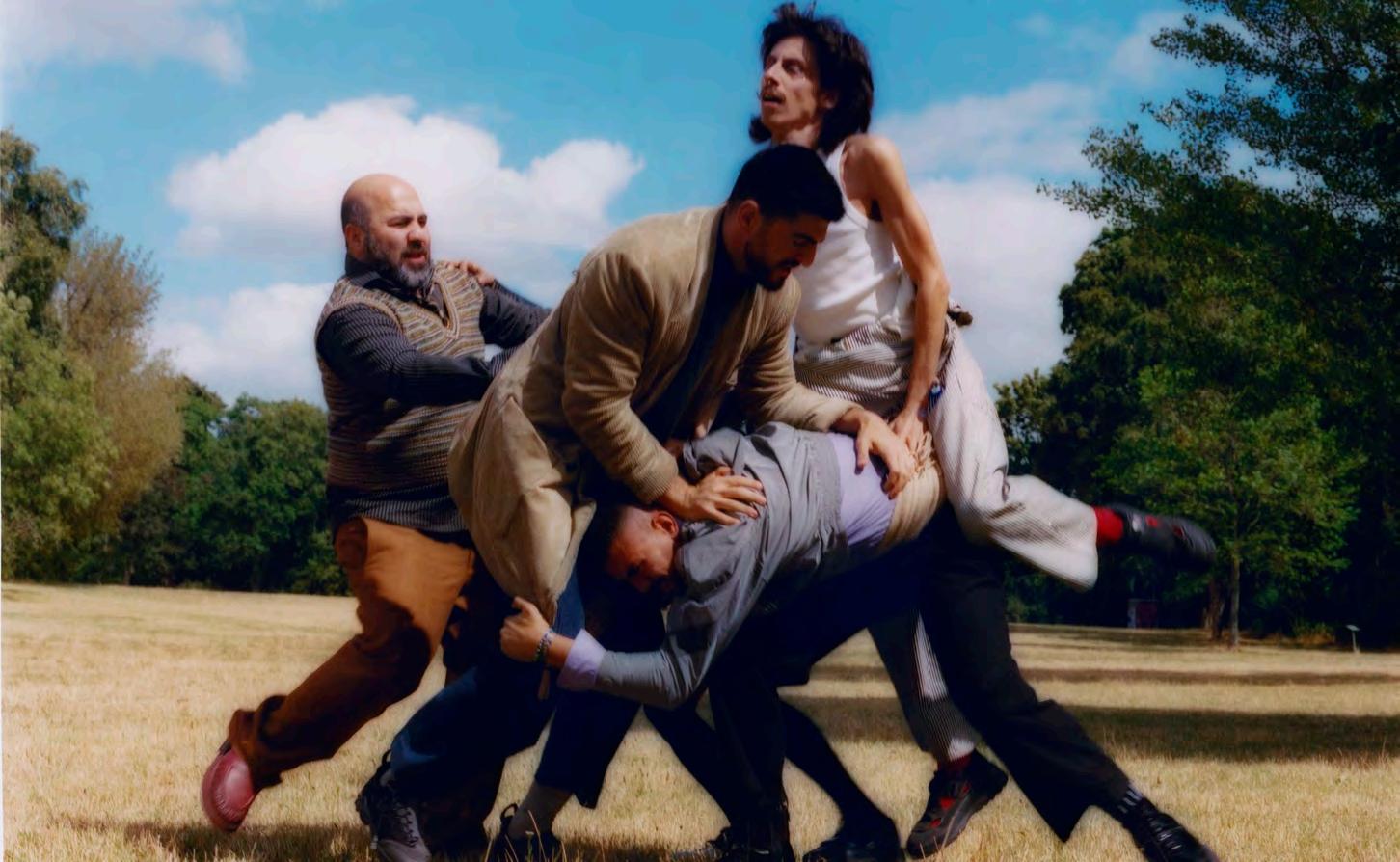
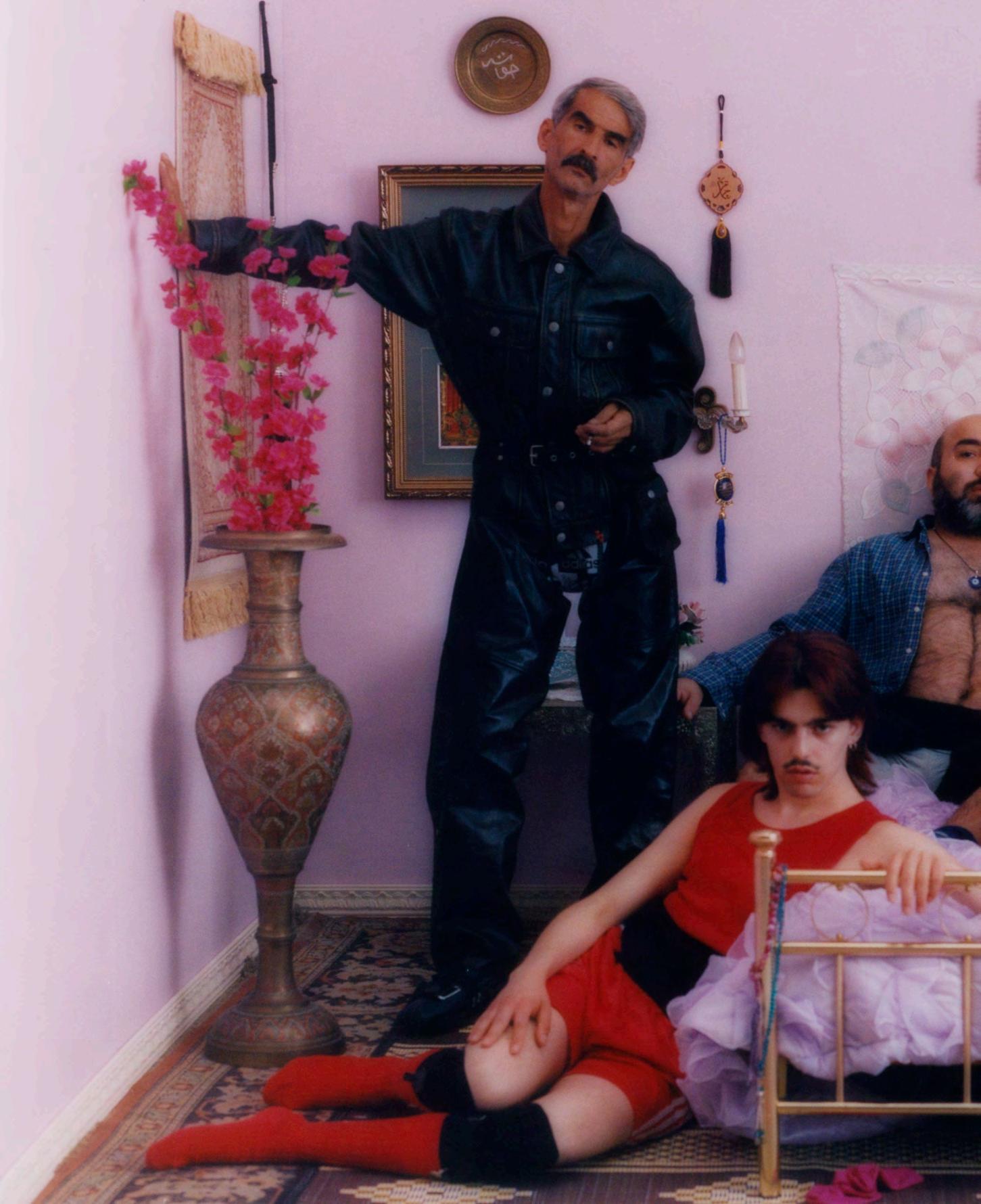
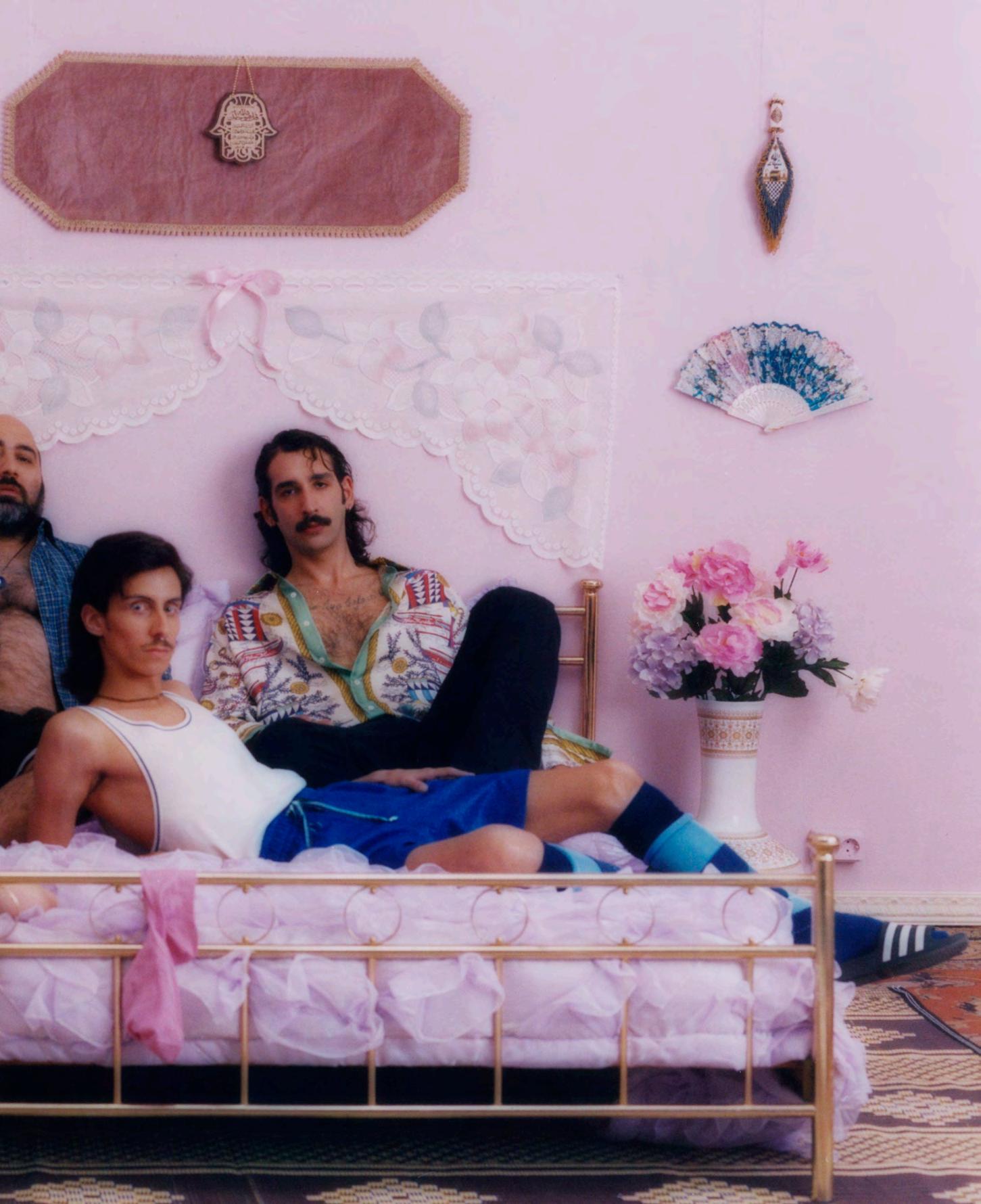 Hossein wears leather shirt Diesel, leather pants vintage Our Legacy/Night Boutique Berlin, shoes Georges Wendell, tesbih stylist’s own, boxer shorts Adidas. Ömer wears shirt model's own, cardigan Études, boxershorts stylist’s own, socks Burlington. Eren wears shirt and trousers Bluemarble Şafak wears top, cummerbund, and sock suspenders stylist’s own, sweater vest Axel Arigato, shorts Adidas, black socks Falke, red socks London Socks. Lorenzo wears top Schiesser, shorts AMESH, blue socks Falke, checkered socks Burlington, sliders Adidas.
Hossein wears leather shirt Diesel, leather pants vintage Our Legacy/Night Boutique Berlin, shoes Georges Wendell, tesbih stylist’s own, boxer shorts Adidas. Ömer wears shirt model's own, cardigan Études, boxershorts stylist’s own, socks Burlington. Eren wears shirt and trousers Bluemarble Şafak wears top, cummerbund, and sock suspenders stylist’s own, sweater vest Axel Arigato, shorts Adidas, black socks Falke, red socks London Socks. Lorenzo wears top Schiesser, shorts AMESH, blue socks Falke, checkered socks Burlington, sliders Adidas.

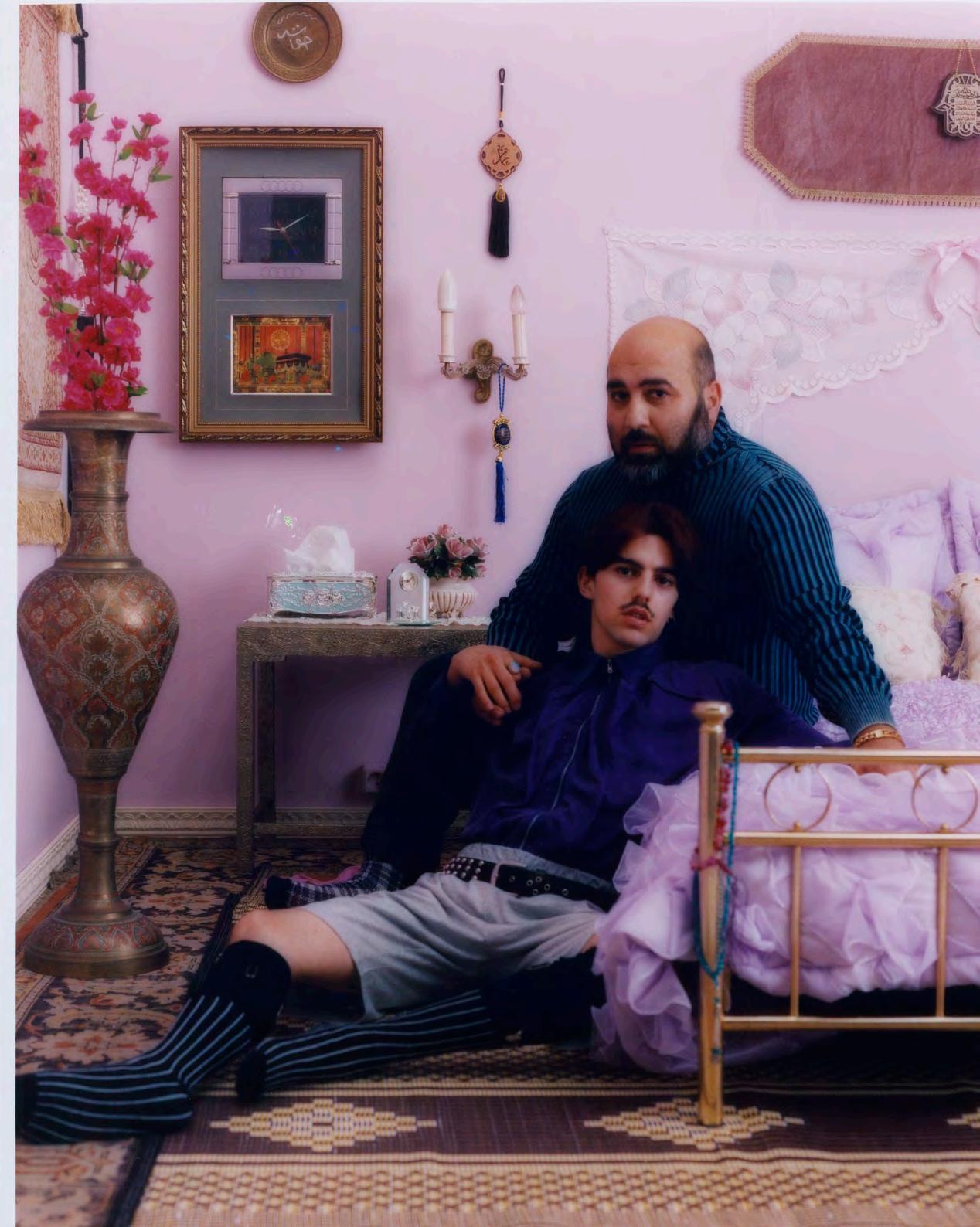
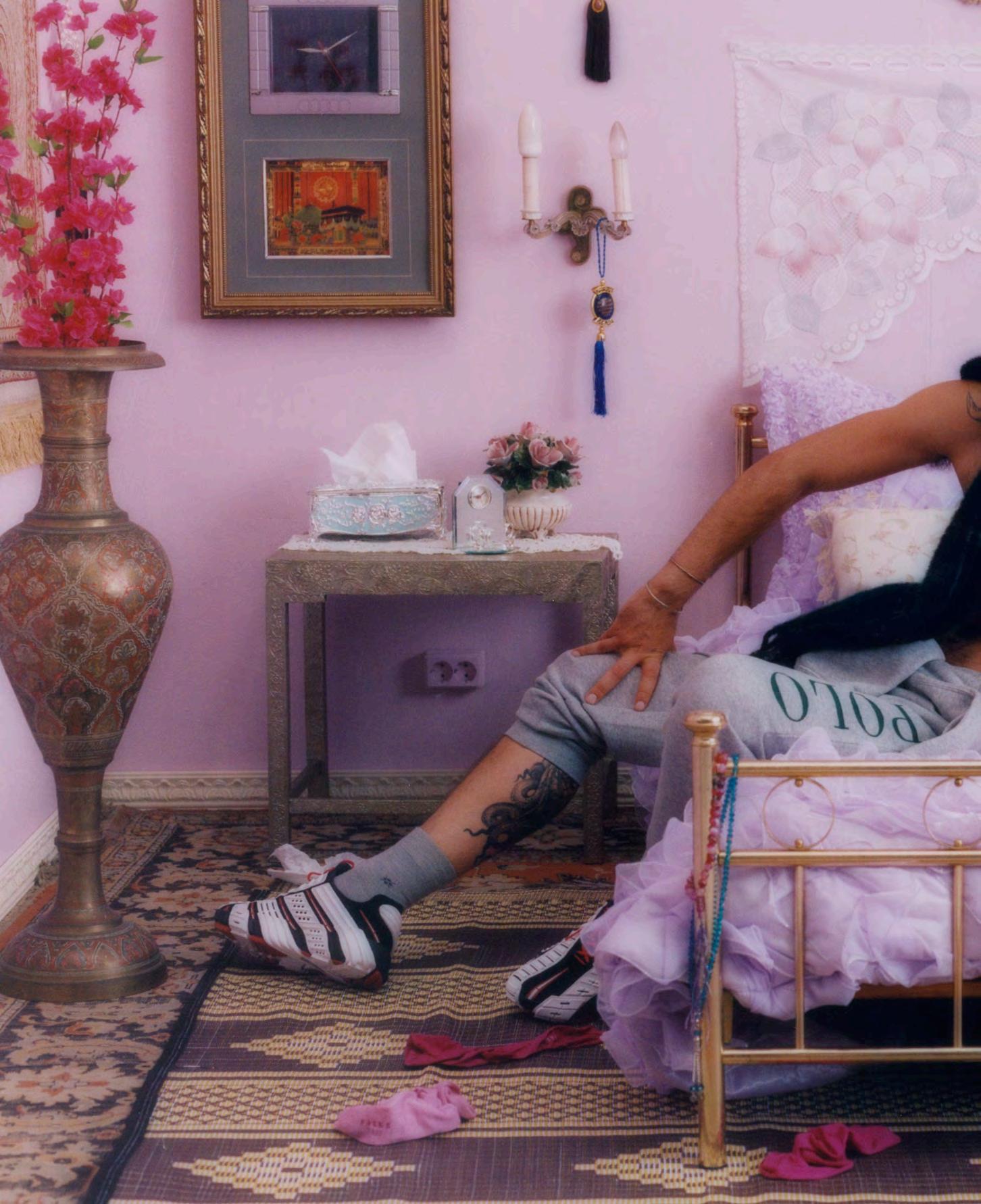



Anon Short for “anonymous.” This usually indicates a preference not to know a lot of personal details before connecting
JO Prefers self or mutual masturbation over penetration in their sex life.
BB An acronym for “bareback,” or penetrative sex without a condom.
Bondage Enjoys the state or practice of being physically restrained, tied up, chained, or put in handcuffs, for sexual gratification.
Bubblebutt Has a symmetrical, smooth, round and soft butt.
Carplay Having sexual relations in a car.
Chastity Has an interest in having their genitals locked down or otherwise restrained. This person might also not be looking for sex or has vowed celibacy.
Commando Prefers not wearing underwear, potentially as a fetish.
Condoms Practices sex with condoms.
Condoms only Condoms are their chosen form of protection all of the time.
Cruising Looking for partners. Cut Circumcised.
Dirty Refers to their interests in sex (dirty kinks, dirty armpits, dirty talk) rather than hygiene, STI status or substance use.
Discreet Wants to keep their private life private. This person may or may not be out about their LGBTQ identity or their kinks.
DL An acronym for “down-low” meaning closeted or seeking hooking up outside a relationship.
Dom Short for “dominant” (and the “D” in BDSM), a dom is the aggressive partner who typically takes charge during a sexual session. The dom serves to satisfy a sub who, in a healthy BDSM relationship, has already expressed their boundaries prior to play. Note: the dom may not always be a top.
DTF An acronym for “down to fuck” meaning open to connections that center having sex.
Edging Takes the long road to orgasm by repeatedly nearing and denying climax, building toward a deeper, stronger orgasm.
Feet This person is aroused by feet, by their own or other people's.
FF An acronym which means “fist fucking.” This person likes inserting the entire hand into someone's hole. One may be an FF top, and FF bottom, or both.
Flexible This person is physically flexible. Could also be referring to their sexuality.
Furries Has a sexual interest in anthropomorphic characters or animal-like characters. The fetish may also include an attraction to stuffed animals or wearing costumes and isn’t necessarily sexual.
FWB An acronym for “friends with benefits,” the benefit of which is sex. May be looking for ongoing sex with someone but not necessarily in a romantic way.
Gear Is aroused by fetish gear, such as harnesses, restraints, and the like.
GH An acronym for “glory hole,” which are fistsized holes used mostly for anonymous handjobs, oral, and penetrative sex. They’re typically found in bathhouses, adult theaters, restrooms, and even people’s homes.
Group Fond of orgies and group sex.
Hands This person is aroused by hands and appreciates manual methods of stimulation.
Hosting Can host someone at their place.
Hung Has a large penis.
Kink Is turned on by something that may not be considered the norm. Can also be described as in opposition to “vanilla” sex.
Kissing Enjoys kissing.
Latex Has a sexual preference or desire for latex items, usually apparel and accessories.
Leather Aroused by and attracted to leather. Also can be one's cultural identity.
Limits Has limits about what they'll do sexually, and often clarified beforehand and respected.
Lingerie Interested in wearing, or playing with someone dressed in, feminine undergarments.
Looking Is currently looking for sex.
Masc Has an appearance and/or mannerisms that could be perceived as what’s considered traditionally masculine.
Monogamy Seeking a monogamous relationship where sexual and romantic aspects are one-to-one only, meaning a relationship with one person, as opposed to multiple.
Nipples Gets aroused when their own nipples, or someone else's nipples, are teased or played with.
NSA An acronym for “no strings attached,” meaning sex without emotional fidelity or any future expectations.
Nylon Enjoys wearing, or playing with someone dressed in, nylon or pantyhose.
Oral Into oral sex.
Piercings Into body modification, wearing jewelry attached to the body.
Pits Enjoys licking and sniffing armpits, or having this done to them.
Poly Short for “polyamorous,” a type of openly non-monogamous relationship that refers to people who have multiple intimate relationships at the same time.
Public Having sex in a public place.
Pup Pup in pupplay, obedient to their handler.
Pupplay A subset of the “pet play” fetish, where individuals behave and inhabit the headspace of a dog. While the fetish centers around canines, no actual animals are involved.
Quickie Interested in a brief sexual encounter.
Roleplay Enjoys playing a character to help bring a sexual fantasy or dynamic to life. Some examples include acting out a teacher/student or doctor/patient experience.
Rough Refers to physically rough sexual encounters.
Rubber Has a sexual preference or desire for rubber apparel and accessories. See also: condoms, condoms only.
Rugged Gives the impression of a rough aesthetic. Often used to describe outdoorsy individuals.
Safer Sex Prefers safer sex practices, such as condom use, taking PrEP, and/or having an undetectable viral load. Could also indicate a preference not to have penetrative sex.
Showoff Enjoys being an exhibitionist, masturbating and/or showing off their body for others.
Socks Has a sexual interest in socks, generally including seeing them worn and/or smelling, trading, or otherwise handling them in a sexual context.
Spanking Is aroused by spanking/flogging.
Spit Turned on by spit.
Sub Short for “submissive” (and the “S” in BDSM), a sub takes the more compliant role during sex, but isn't always the bottom.
Tentacles Has a sexual interest in tentacles and the creatures that possess them. Tentacles are a sub-genre of hentai, the sexualized genre of Japanese manga and anime.
Thick Has a husky physique.
Toys Likes playing with sex toys (such as dildos or vibrators).
UC An acronym for “uncircumcised.”
Underwear Has a sexual interest in underwear, potentially a specific cut or kind, which could include seeing them worn, handling, smelling, or otherwise interacting with them in a sexual context.
Vanilla Interested in sex that may include kissing, masturbating, oral and/or anal sex, but typically without fetishes; may refer to condom use.
Video Chat Enjoys erotic interaction over video.
Visiting Wants to travel to someone else's place to meet up, or is visiting but doesn't live in the area.
Watching Enjoys watching someone else have sex.
WS Short for “water sports,” meaning this person likes pissing on someone or getting pissed on.


Artist, healer, radical teacher, progenitor of zine culture and independent publishing, AA Bronson has lived through it all and survived to tell his story. In the summer of 1969 in Toronto, Bronson—then a hippie architecture school drop out— and a group of revolutionary young artists interested in a new transcendental reimagination of the future went on to found General Idea. By 1973, the commune of countercultural free thinkers and artists became a trio: Bronson, Felix Partz and Jorge Zontal. For twenty-five years, General Idea took up arms against the hypocrisies of popular culture, consumerism, mass media, and the modern age through works that explored everything from queer politics, technological progress, and the AIDS crisis. Their famous motto was “Image Is Virus” and they used almost every medium at their disposal to “infect” the unwitting public with a battery of gestalt and subliminal modes of communication. From performance, to happenings, to mail art, to a self-published megazine called FILE (a complete visual appropriation of LIFE magazine, which espoused their manifesto), to a beauty pageant that satirized the hypercompetitive nature of the art market, General Idea crawled into the psychology of the zeitgeist and metastasized. Their final work, IMAGEVIRUS, which used posters, ephemera, artist’s multiples, and exhibitions, was a brutal counterattack on the world’s slow response to the AIDS epidemic, which was sweeping through queer communities and would take the lives of both his collaborators, Partz and Zontal, in 1994. After their deaths, Bronson continued the legacy of General Idea (the most comprehensive retrospective to date is on view now at National Gallery of Canada) and started exploring his own solo practice. He was also the director of Printed Matter and founded the NY Art Book Fair in 2006 and the LA Art Book Fair in 2013. With the threat of new pandemics raging, Europe under the shadow of war, and a flood that partially destroyed his Berlin apartment, Bronson discusses our new, dark and nervous era with prolific curator Defne Ayas, who was also the former director of Melly (formerly known as the Witte de With Center for Contemporary Art), where Bronson had his award-winning exhibition The TemptationofAABronson in 2013.
DEFNE AYAS You have been going through a lot recently, so has the world! One would like to hope there is a deeper transformation somewhere in all this, some recalibration. Where is this big shake-up going?
AA BRONSON Defne, I am insanely depressed. I have not been this depressed since 1994, when all my closest friends and collaborators died of AIDS. Is it the state of the world? Certainly, the various viruses, climate crisis, the demolition of
and Bertold Brecht’s Threepenny Opera is with us once more in a brilliant revival by the Berliner Ensemble in the original theatre where it was first performed; and the magnificent restoration of Mies van der Rohe’s masterpiece, the Neue Nationalgalerie, has been fitted out with Berlin’s subterranean art history, as if to mirror this moment in time. Berlin is a city of “the other,” a place of resistance, of movement towards a cultural, sexual, psychological liberation, a place of
humanity? Or some kind of political rebirth?
old growth forests, Ukraine, the various floods, fires and droughts, none of these help. And they seem to be mirrored by my own life, most recently a flood from above that destroyed our Berlin apartment, pictured here. I imagined myself to be the guru of Fasanenstraße, but I am not: I am a spoiled white person feeling very sorry for himself in a city, which currently houses over 100,000 Ukrainian refugees and 65,000 Syrian refugees, just for starters. Yes, I am without a country. Although born in Vancouver in 1946, Canada is not “mine,” it belongs to the countless Indigenous peoples who still live there today. Genetically and culturally, I suppose I am British. But who wants that mess? I lived in New York for decades, but I would slit my wrists before declaring myself “American.” The reality is that I am honored to be an immigrant in Germany, in the state of Berlin, which seems to me sane, and decent, and more inclusive than most in this dark world.
AYAS I am happy I played a minor role in this life change for you, nominating you for the prestigious DAAD Fellowship in Berlin. And yes, Berlin saw a lot of geopolitics and was subject to a lot. Its history is complex. It even resisted the Nazis in WWII.
BRONSON Yes, if one is going to harbor deep depression, there is certainly a history for it here in Berlin: we are surrounded by bullet holes at chest height; Kurt Weill
darkness and shadows. I feel that Berlin is my spiritual home, but why?
AYAS That is a beautiful shawl you have on in these photos, dear AA.
BRONSON In these photos I sport an immense shawl of tightly woven unbleached linen. It was given to me by Chrysanne Stathacos, an artist I have known since the early ‘70s. We first went to India together in 1995, and since then she has returned almost every single year. You will remember the immense mandala of rose petals she made for my exhibition The Temptation of AA Bronson you commissioned. She is involved with a Tibetan nunnery in the north of India and it was on a recent trip there that she found this shawl. It is woven by hand, of course—everything is woven by hand in India. It is very plain with a beautiful hand and a dull sheen, no decoration except the fabric itself. It is at once luxurious and intensely plain.
AYAS It looks like a spiritual, protective blanket.
BRONSON It is the shawl of the mendicant, one who gives up worldly things for the benefit of the soul. I don’t have the courage to take up that route in life, but I am envious of those who do. Weaving of course is a living metaphor for life itself.
AYAS Given the X-factor we are all after in our personal lives, I am wondering if there is room for spiritual growth for
BRONSON I have spent most of my life as an artist. My mother always claimed that I proclaimed my decision to become an artist at the age of three. But what does that mean? I lived as part of the Canadian artist group General Idea from 1969 through 1994, when my partners Jorge and Felix both died of AIDS. Since then, I have continued on my own. I still love to collaborate, and I get lonely and restless. But these days I am not producing at all. Am I still an artist if I am not making art? If I make art purely in my mind, does that make me an artist? Does this indicate some kind of political rebirth? It is certainly ecological! Here I am talking about myself again! Your questions are all about the world at large and all I can think of is myself. You mention humanity and I respond with ME!
AYAS But let’s talk about spiritual growth. I still recall your seminars in New York City—more than ten years ago now— exploring the crux of art, religion and social justice.
BRONSON Yes, at the age of sixty, in 2007, I began studying at Union Theological Seminary in New York City. I did not consider myself a Christian, but I needed to give Christianity another chance. Almost immediately, I realized that theologians and contemporary artists were often speaking the same language, thinking the same thoughts, although a schism had formed between them in the postwar period. I wanted to renew that conversation again. I founded the Institute for Art, Religion, and Social Justice together with the theologian Catherine Reklis, and the conversations began that you mention, with Marina Abramović, the Guerilla Girls, Gregg Bordowitz, Alfredo Jaar, and others. Carlos Motta and I organized the series RitualofQueer Rituals for my exhibition TheTemptation of AA Bronson, which you hosted at [the museum formerly known as] Witte de With Center for Contemporary Art in Rotterdam in 2013. But in a way, that was the end of that conversation for me. I moved to Berlin as a guest of the DAAD, and stayed, and became much more concerned with the voices of the dead than
"Am I still an artist if I am not making art? If I make art purely in my mind, does that make me an artist? Does this indicate some kind of political rebirth?"
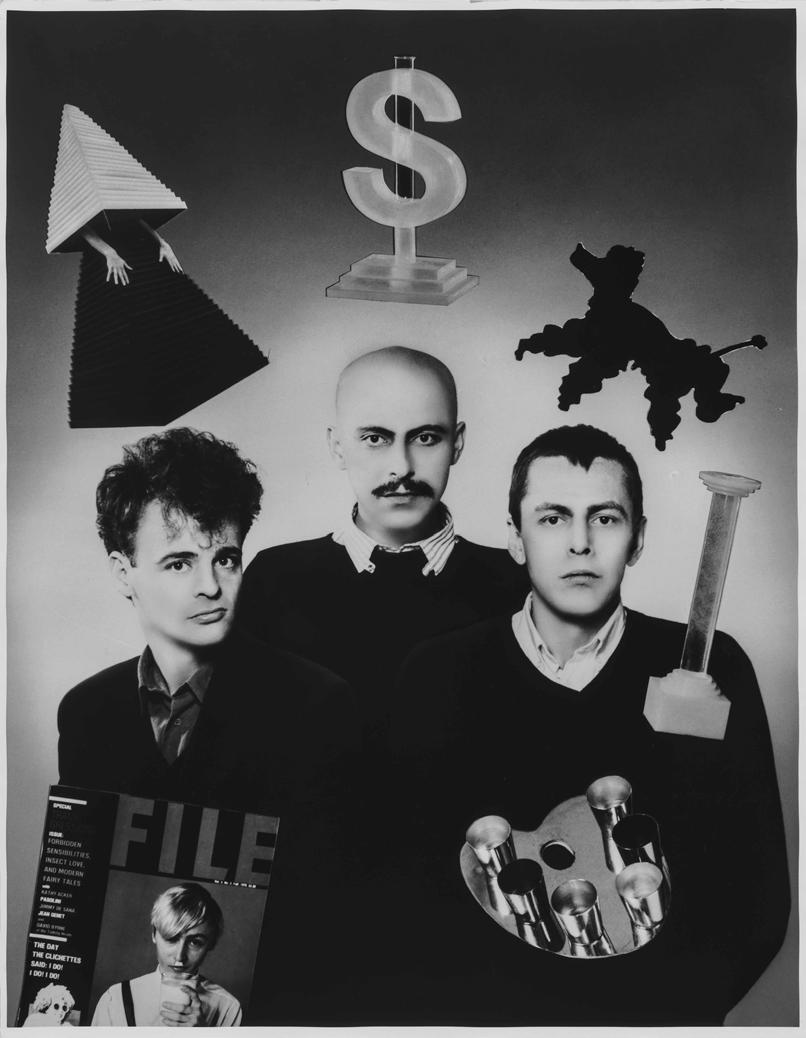

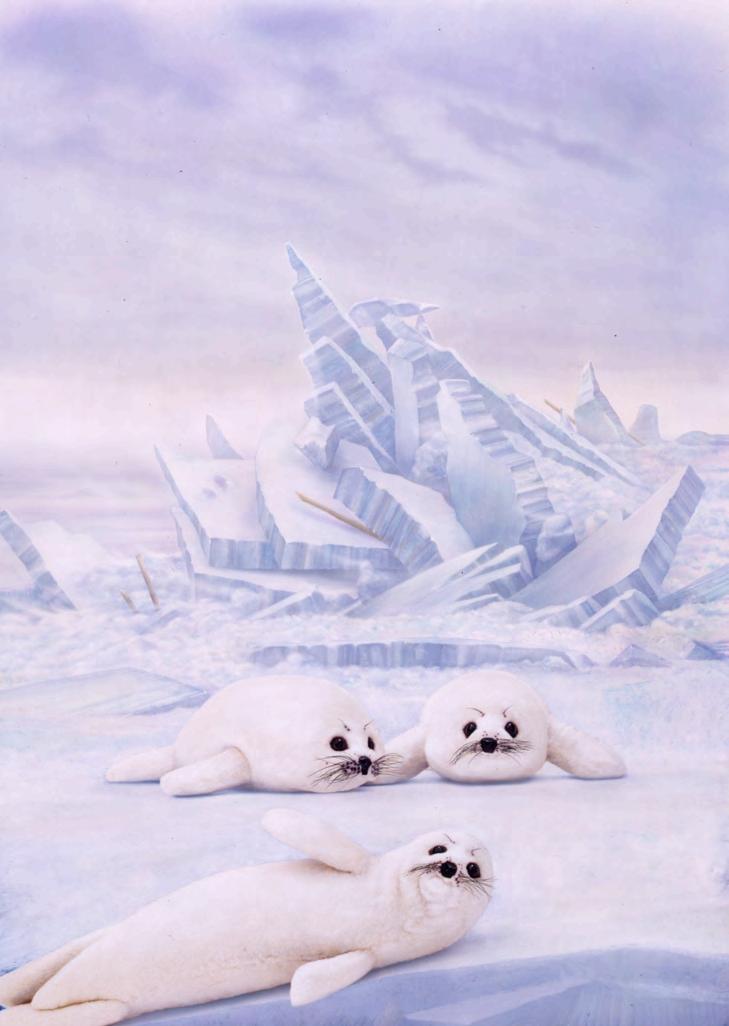



the living. The Institute for Art, Religion and Social Justice has been pretty quiet since then.
AYAS Berlin—and by extension Germany—still is grappling with issues though, like avoiding a radical reexamination of itself. Some histories are deliberately avoided.
BRONSON Berlin is all about the dead. Cemeteries, mostly Christian and Jewish, are woven into the fabric of the city. They are in every neighborhood. My father was a pilot in the Canadian Air Force. During World War II, he was a bomber pilot, bombing Cologne almost every day of the war. I hate to think how many people he must have killed, people who may have been the grandparents, parents, aunts, and uncles of people I now call my friends. And of course, the dead are present in other ways: in the presence of the brass stolpersteine, “stumblestones”, cobblestones, each engraved with the name of a Jewish victim of the Nazis, usually embedded in the sidewalk outside their home. On Kristallnacht, November 9, they are decorated with candles and flowers, and Berlin makes visible her deep sorrow. But the living are only slowly learning how to give voice to the dead of Berlin. It is an ongoing process.
AYAS These days, it seems the criminal also is playing the moral judge. Look what is happening at documenta. What are the deeply moral German values in all this? Or Christian ethics?
BRONSON OMG! What are Christian ethics? Yes, documenta 15 is certainly a case in point. The curators have given us a vast and sprawling multicultural panorama of art-making, and how does the German press respond? With another scandal about Jews and Christians and the JudeoChristian god! I think this is a way of sidestepping documenta’s engagement with Indigenous peoples and colonialism. And that story has a particular interest for me.
As you know, my project A Public Apology to Siksika Nation researched the history of my great grandfather, one of the earliest of the Anglican priests to set up residential schools on the newly founded Aboriginal reserves in Canada in the early 1880s. And my apology, like most apologies, is not enough! Our research dredged up scandalous behaviors on the part of the church. And as you know, it is only now that we are discovering hundreds and perhaps thousands of unmarked graves of Indigenous children in Canada. It is not surprising to me that I gave up Christianity at the age of seven and immersed myself in reading about other religions and spiritualities.
AYAS Having worked in China, Korea and so on, and having been shaped by Austrian nuns in Istanbul, I relate to the various forces at play in Christian histories, especially the evangelical turn and the rise of puritanism we are now witnessing. But placing Christianity as we know it to one side, how about more esoteric, gnostic traditions?
BRONSON Oh, that question opens the conversation into a black hole. All my life I have been especially interested in the more “secret” traditions, from the various forms of Western Gnosticism to Eastern Tantras. In 1974, through my partner Jorge Zontal of General Idea, I met a white witch in Caracas. I was in a similarly deep depression in my life. She gave me a spiritual practice, and foretold my spiritual travels, all of which came to pass exactly as she described. In 1983, through my Dutch friend Louwrien Wijers, Jorge and
I visited Dharamshala, had an audience with the Dalai Lama, and were led into a lengthy encounter with the Yamantaka. This ended when Jorge died in 1994.
But ultimately, all religions, all spiritualities, are manifestations of the same godhead: the unknowable, the indefinable, not so much the essence as the everything. It is our inability to know that defines us, and motivates us, and maddens us as human beings.
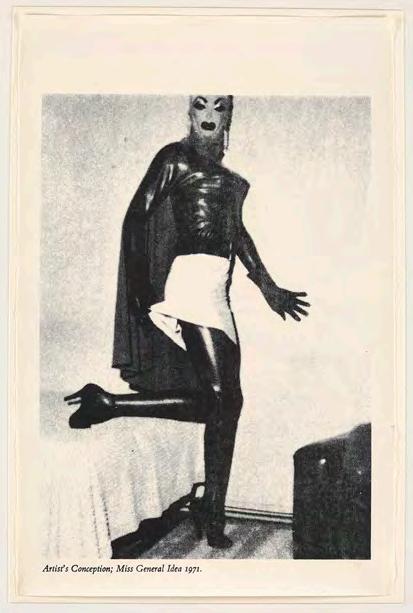
AYAS Your rebirth was as a shaman at one chapter of your life, where you led many healing sessions through massages and other forms of queer rituals. How can sex and sex culture play a role for the betterment of society? Is expansion of human consciousness through sex still a hopeful facet of life, given the grim future?
BRONSON Oh, sex! Dear Defne, your questions all suggest an eternal optimism that I do admire. We haven’t reproduced all your questions here, only the ones that I have been somewhat able to answer in my own way. But you are always willing to find a way out for mankind, as if it may be possible. I hope you are right. I do remind myself that in London in the 1940s, according to my mother, it was generally assumed that the world as we know it was over. And yet here we are again! It seems obvious to me that the systems we have set in motion will destroy us by the end of the century, if not well before. And yet, I must harbor some optimism as I continue to eat locally, cut travel to the bone, and generally live the life of the mendicant, albeit in luxury ... with this sumptuous linen shawl, for example.
Photography SUZIE & LEO (André Werther)
Styling CAMILLE ANGE PAILLER
Casting MARIE LEVY
Hair YUMIKO HIKAGE (CLM)
Makeup PAIGE WHITING
Model FRANSISKA PAULA (Elite Models)
Stylist Assistant ARINA KUCHEIEVA
Photo Assistant MATTHIEU BOUTIGNON

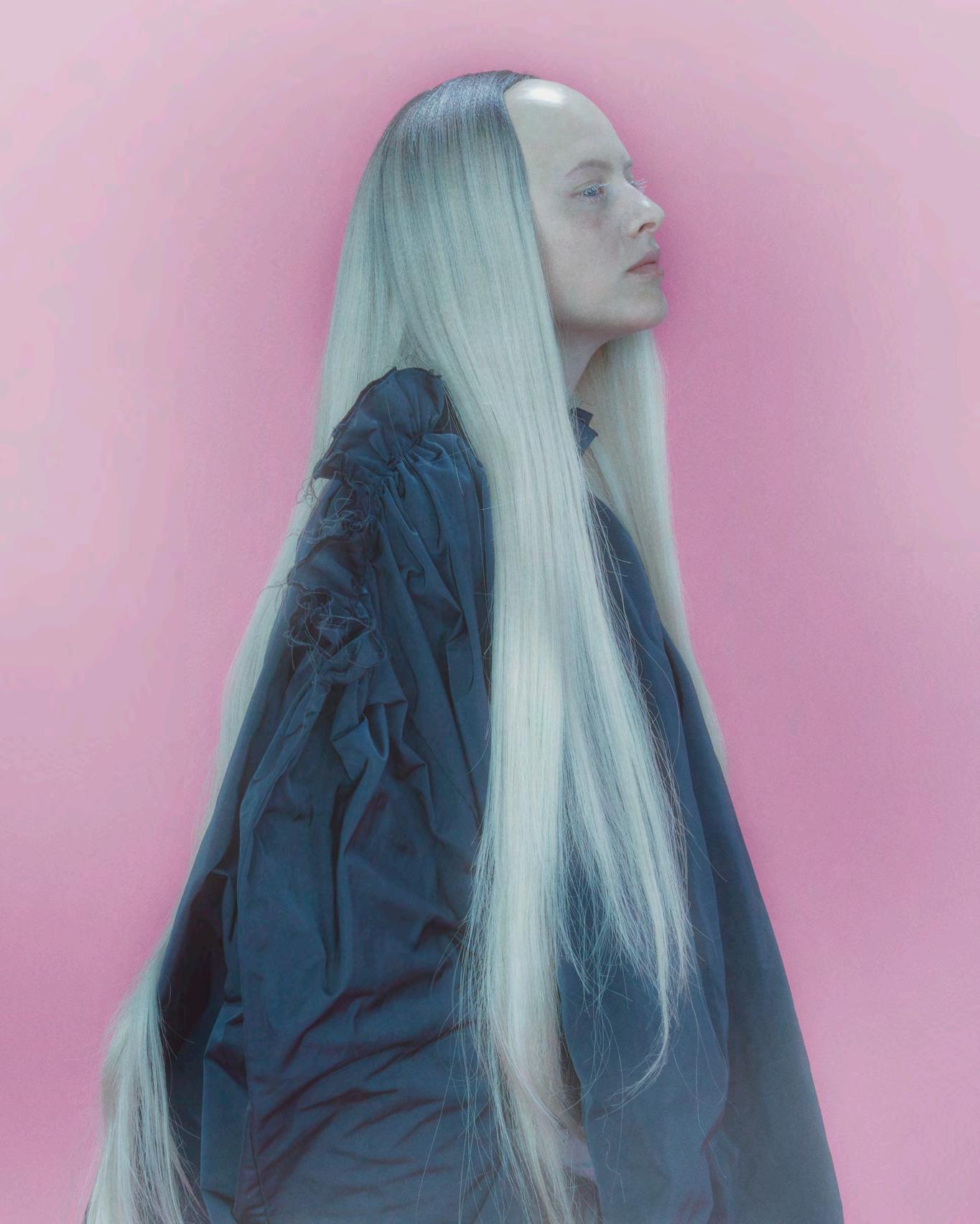
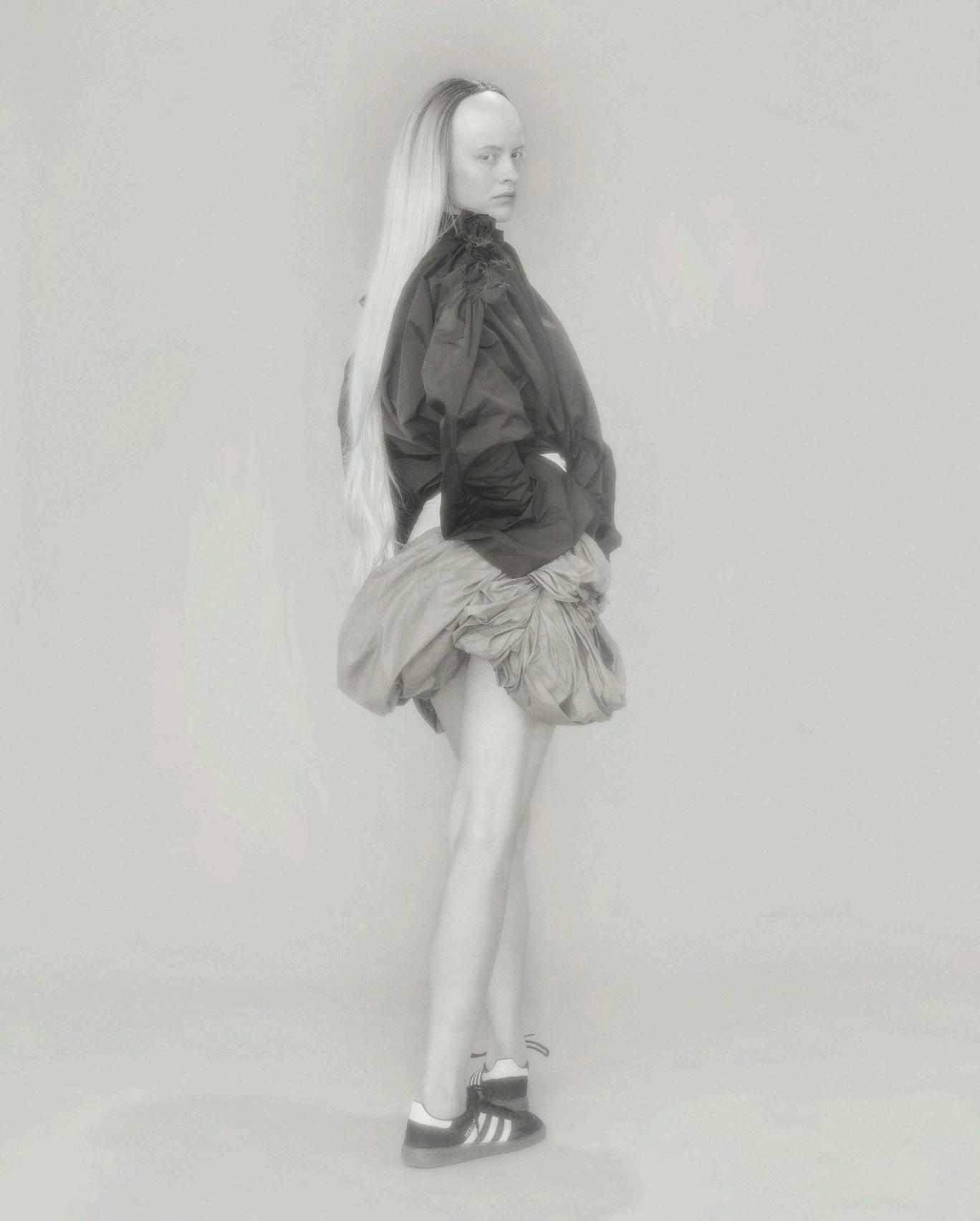
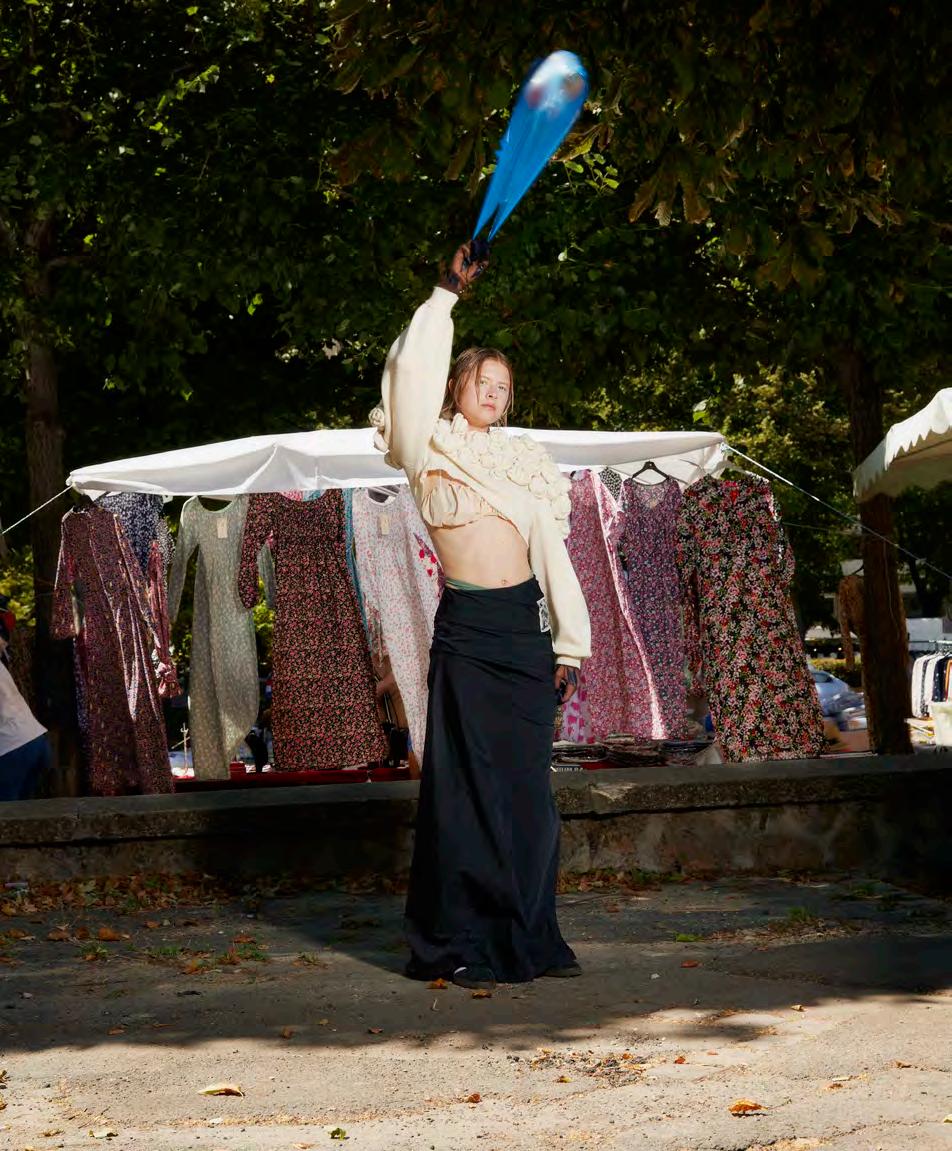
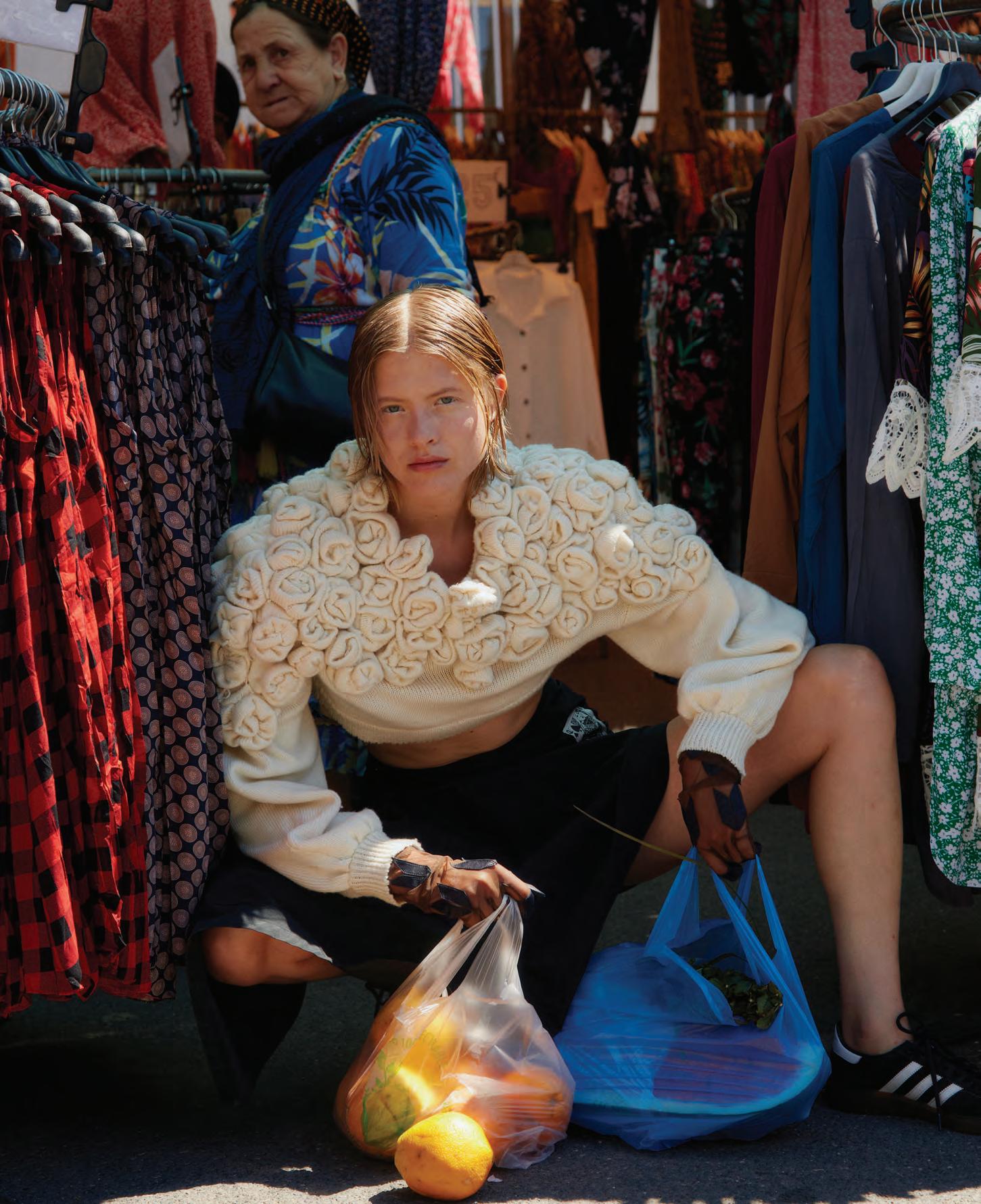
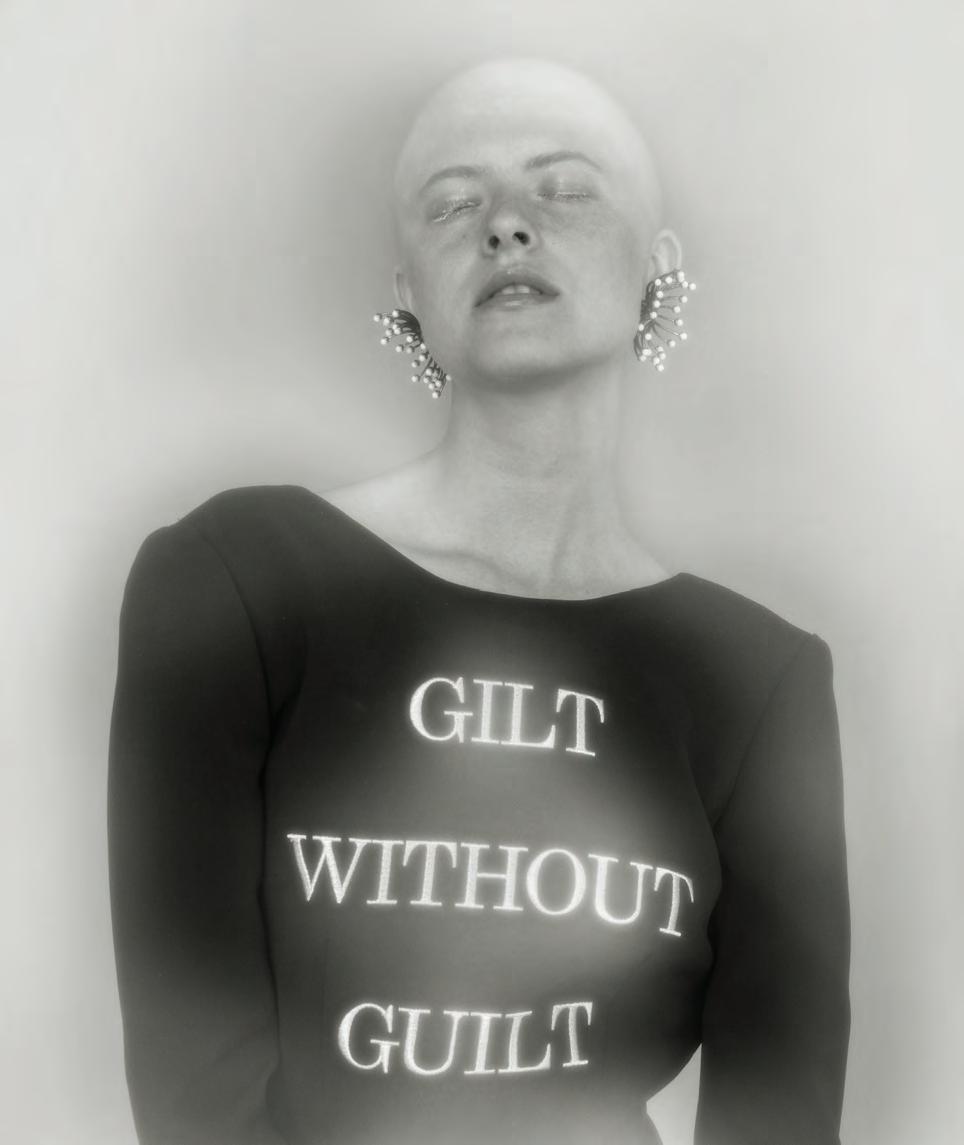

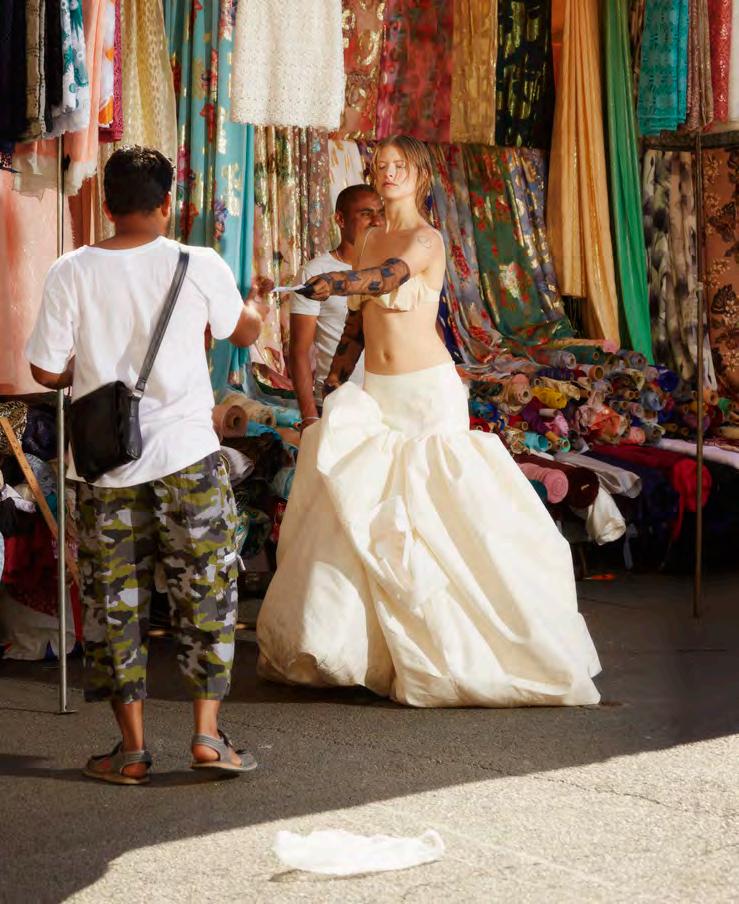
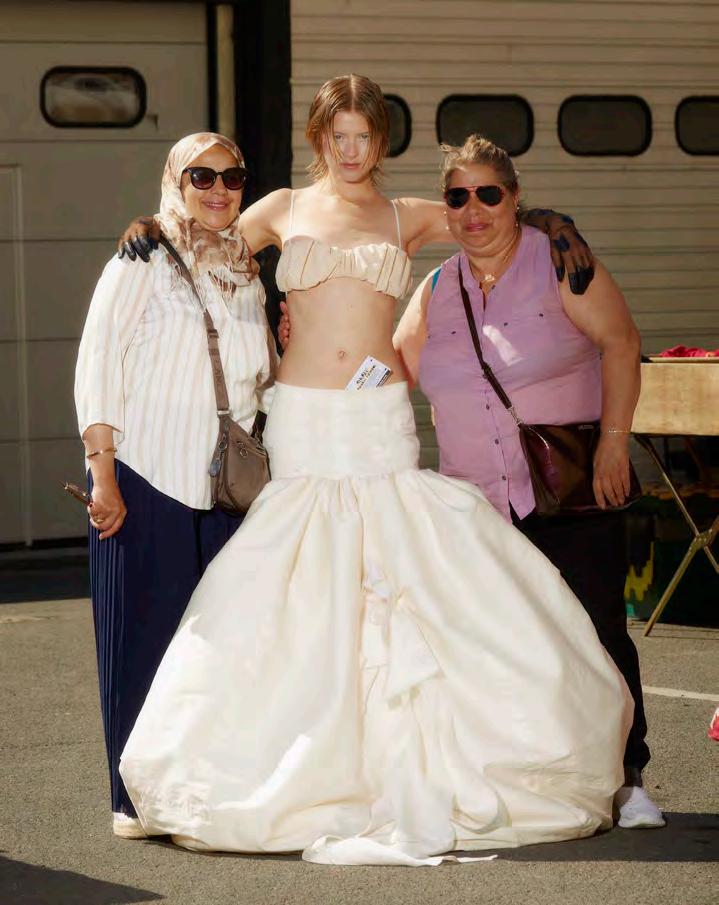

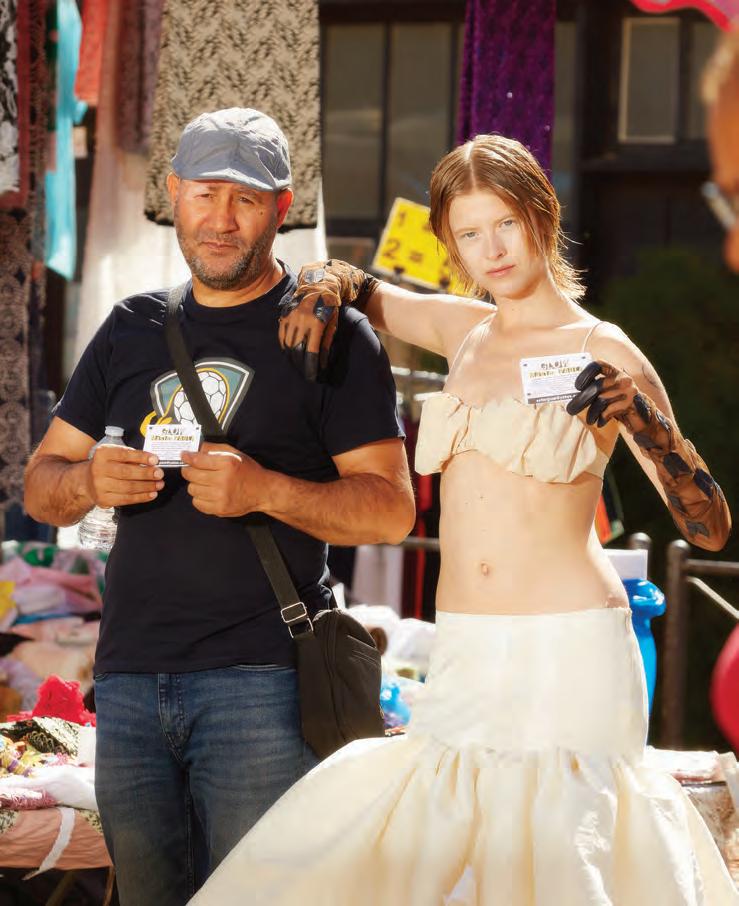
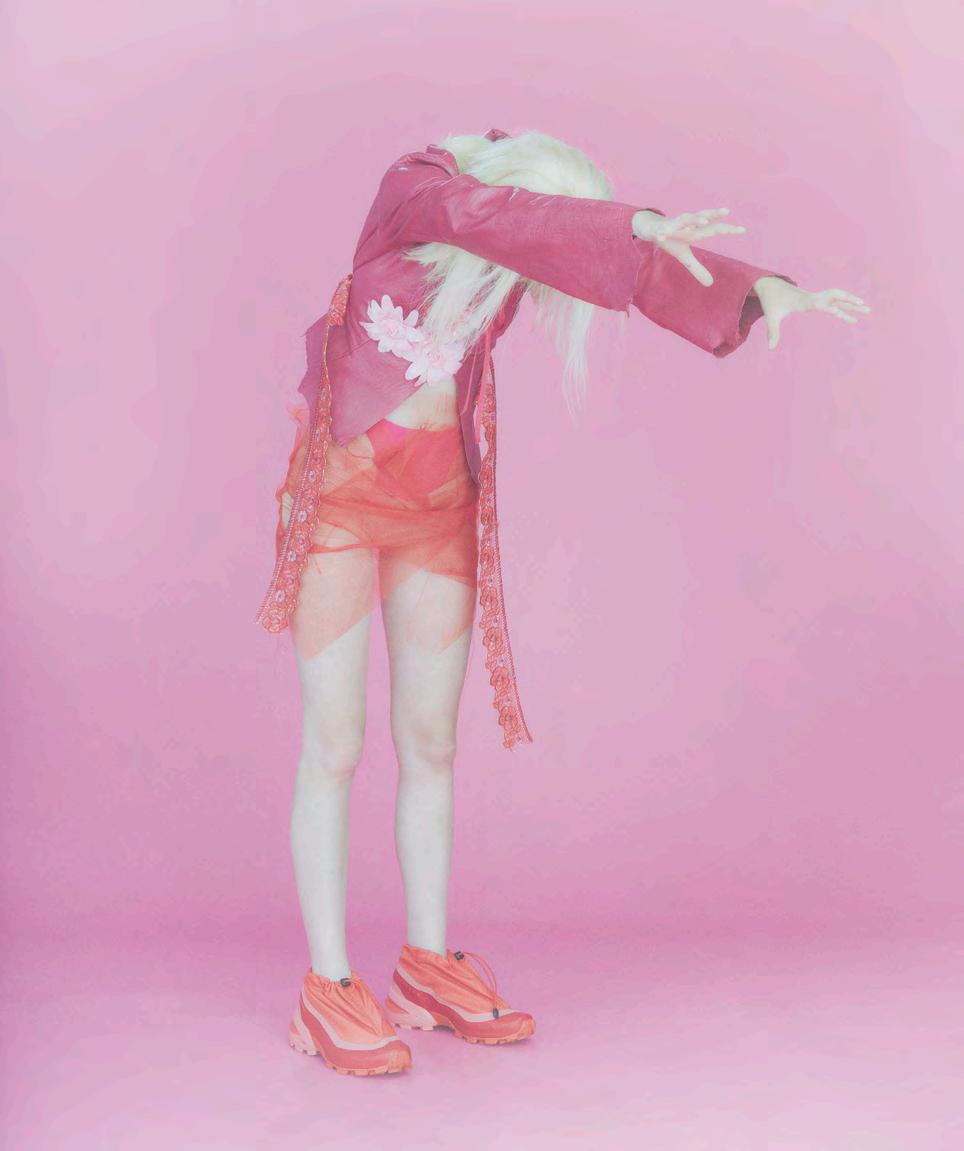
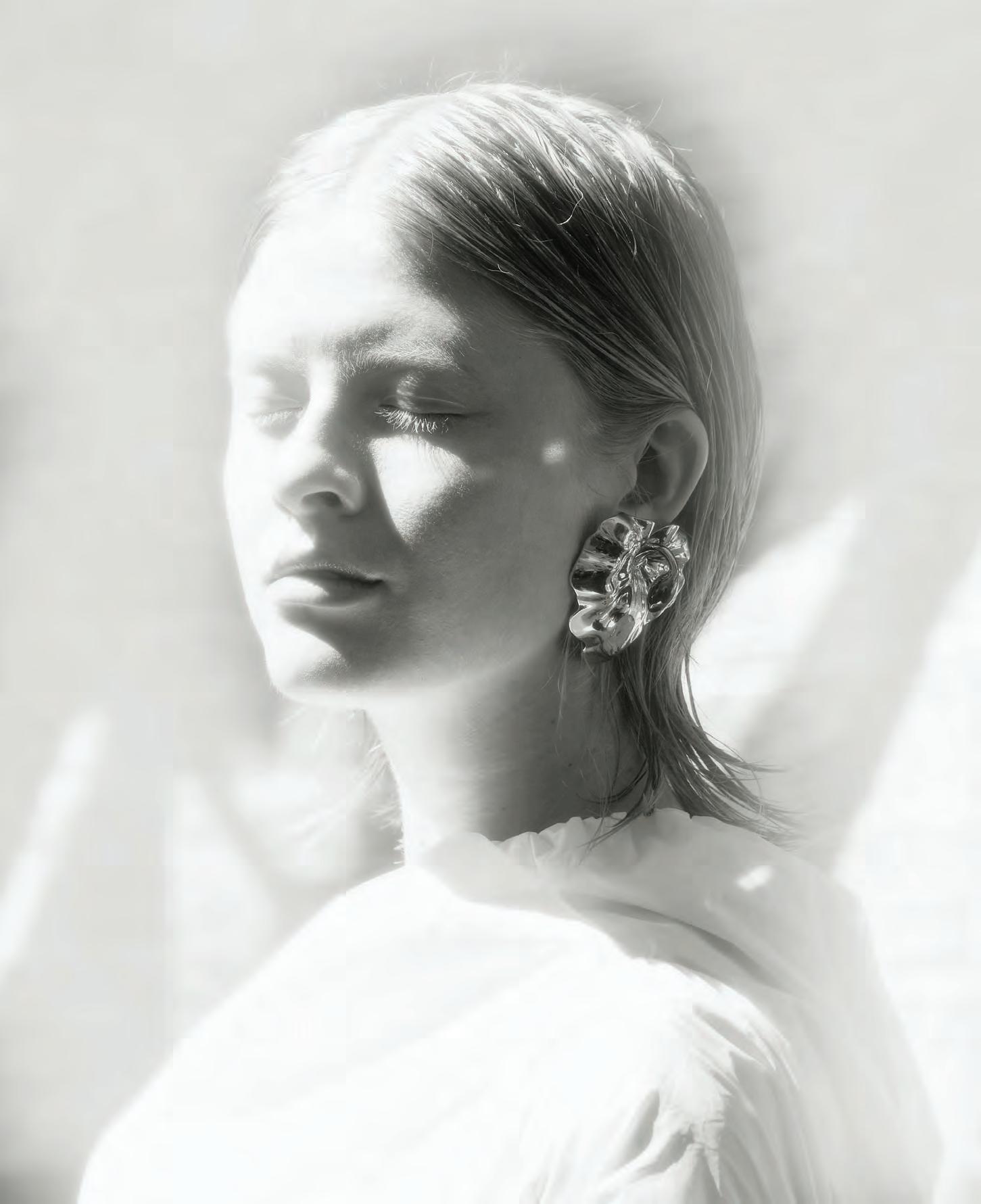

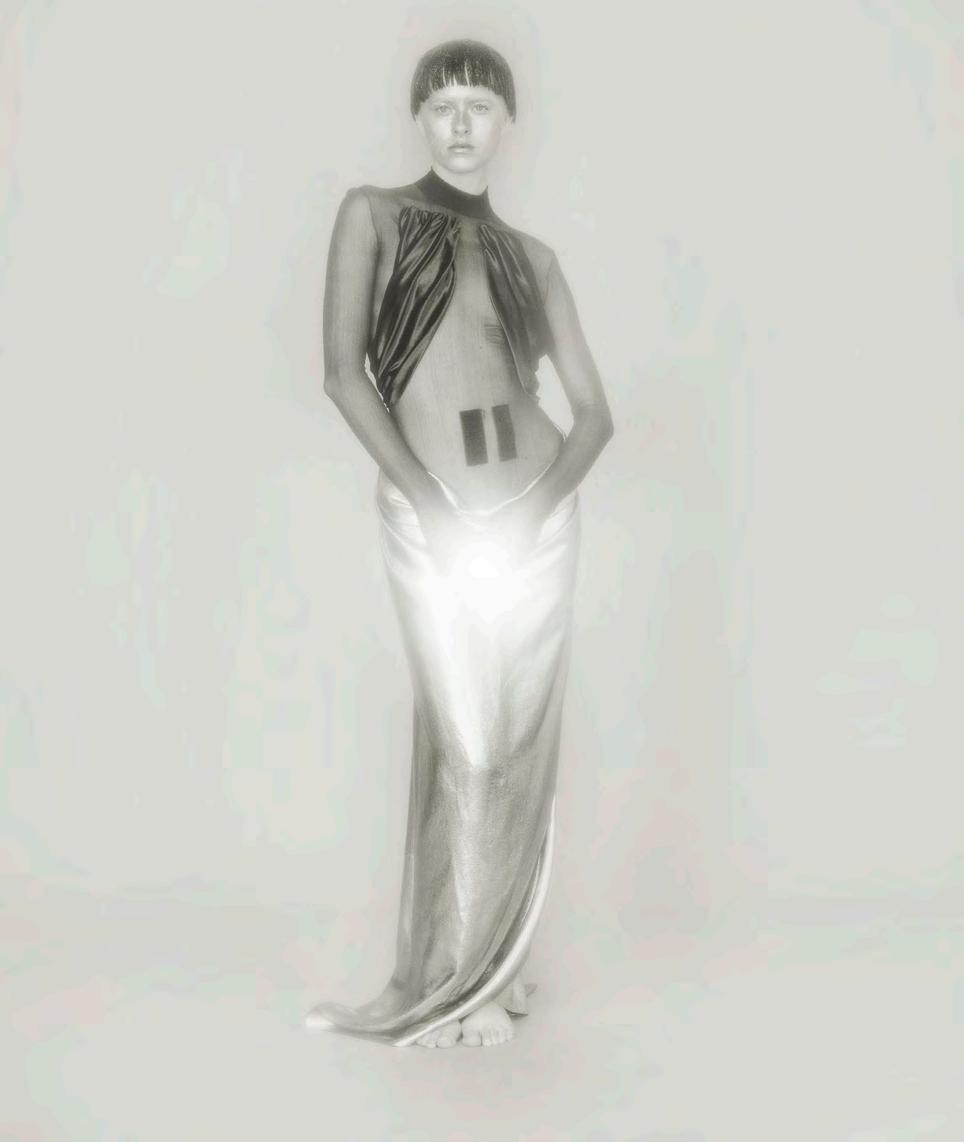

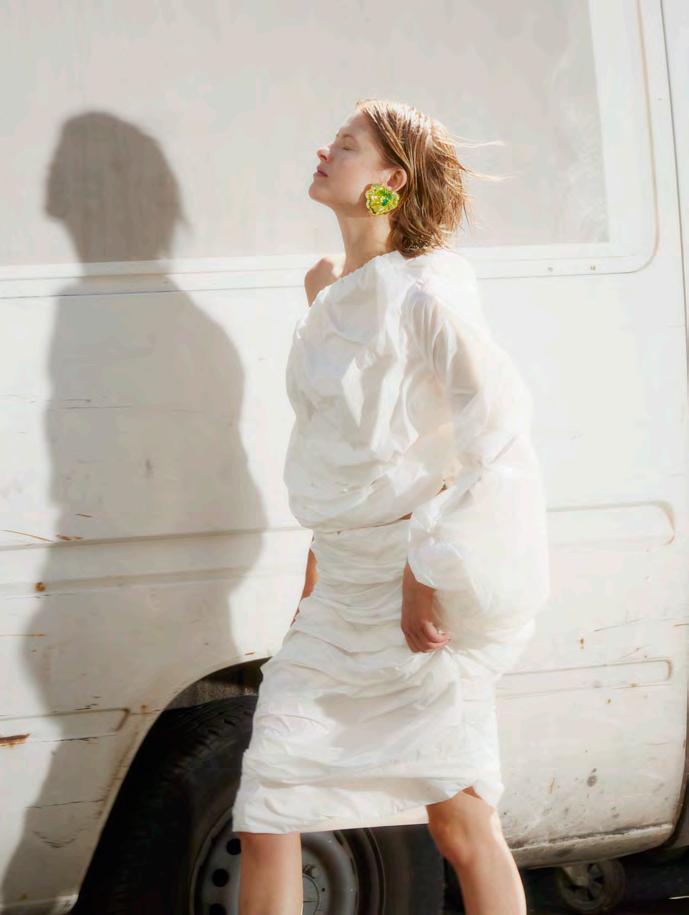


Paul Reubens is one of the most brilliant comedic talents of our era. His character, Pee-wee Herman, a maniacal man child with a famous red bow tie, hypernasality, and a predilection for mischief, is a Saturday morning cartoon come to life. Invented on the stage of The Groundlings, Pee-wee Herman is equally iconic and archetypal as Charlie Chaplin’s Tramp. Socially defective with the decency to wear a suit, both characters are rife with hilarious contradictions, and both characters are perfect representations of their respective zeitgeists. Whereas the Tramp was a silent and prophetic emblem of the forthcoming economic devastation of two global wars, Pee-wee may as well have been a louder-than-bombs manifestation of the late-capitalistic dreamscape of the 1980s. Pee-wee’sBigAdventure (Tim Burton’s 1985 directorial debut) and later Pee-wee’sPlayhouse, which aired on CBS and saw an average of ten million viewers per episode, was a fantasy of talking furniture in a supersaturated world that harkened back to 1950s diners and primetime dance competitions, a satirization of Post-War Americana as a frenzied pastiche. This pastiche was a siren call for rising artist and photographer Nadia Lee Cohen, who also trades in the currency of alter egos and consumeristic reverie through the lens of humor. Raised in the English countryside, a selfprofessed wild child, the Technicolor stagecraft of Hollywood had an irresistible allure. Her solo exhibition at Jeffrey Deitch Gallery, which was an unabashed sensation, included two large bodies of work from two sold out monographs published by IDEA Books. Women includes over 100 portraits of a diverse cast of female characters fictionalized by Cohen, at work and at play, all under the banner of Los Angeles’ disparate socioeconomic backdrop. Reminiscent of movie stills, the images are freeze frames in moments of action, repose, or seductive enchantment. In her most recent series, HELLO, My Name Is, Nadia utilizes extensive prosthetics and makeup to embody a vast array of characters inspired by found corporate name tags—each character has an invented story, thoughts, dreams, and desires. It is a Hitchcockian character study of self-portraiture. Jean Baudrillard talked about this escape from the self in an age of simulation and hyperreality: “Never to be oneself, but never to be alienated: to enter from the outside into the form of the other.” Both Paul Reubens and Nadia Lee Cohen take immense pleasure in this metamorphosis. Currently in production is a two-part HBO documentary on the life of Reubens, directed by Matt Wolf (Spaceship Earth) and produced by the Safdie Brothers. And Cohen recently completed a music video for a major pop star. In a time of shapeshifting realities and alternative facts, a time when we don’t even recognize the reflection in our mirrors, what can two masters of disguise teach us about who we really are?
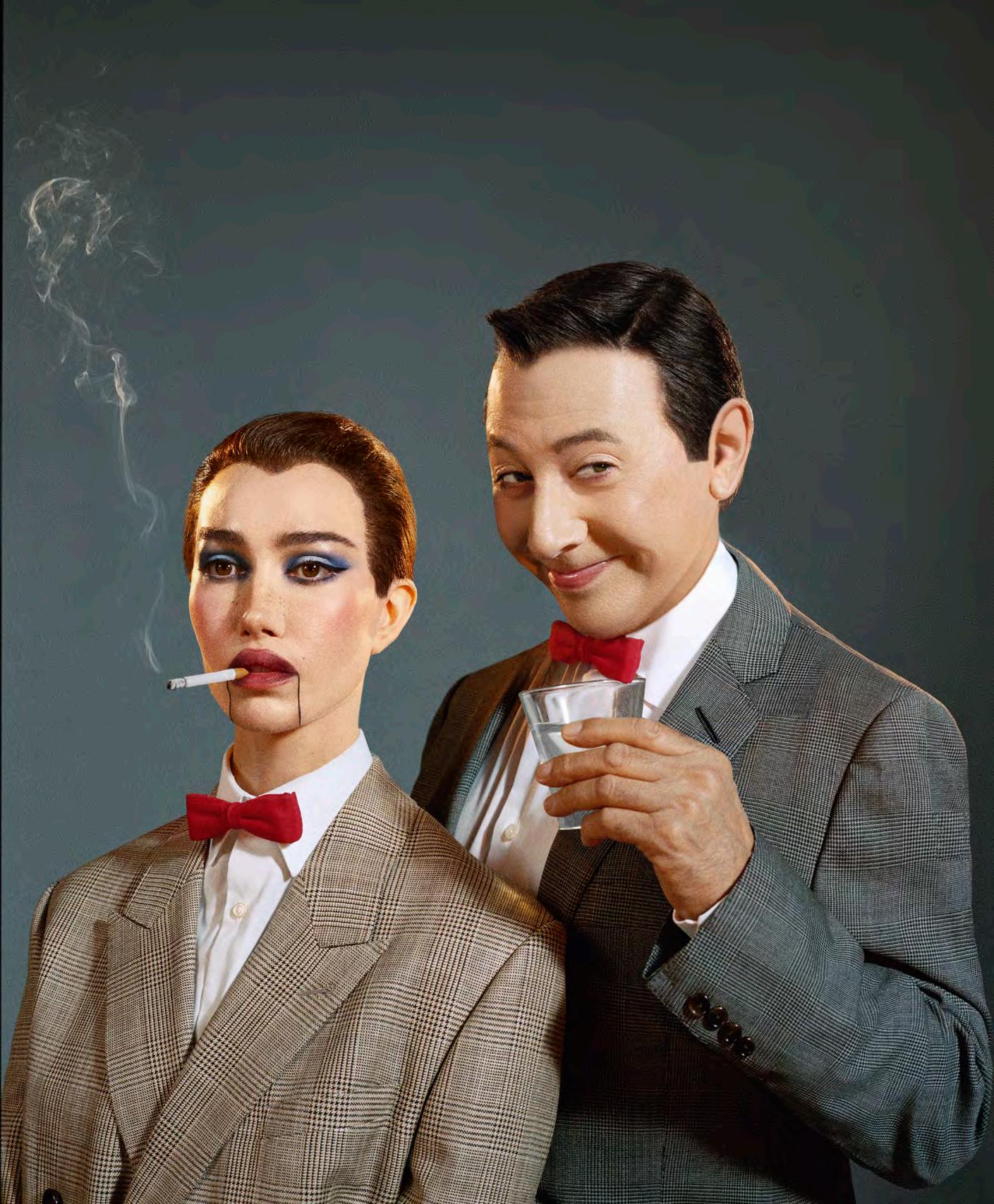
PAUL REUBENS Should we talk a little bit about how we met?
NADIA LEE COHEN I knew you way before you knew anything about me. I used to do your “Tequila” dance for relatives when they came over.
REUBENS I remember seeing you on Instagram. The more I saw, the more I was like, I have to know whothispersonis. And then, didn't I write you a note on Instagram?
COHEN Yes, you did. You shared something of mine and I thought it was a mistake. Tell me about growing up in Sarasota, [Florida] I Googled it last night. When did your fantasy world begin?
REUBENS Well, my fantasy world began way before Sarasota because we moved there when I was in fourth grade. I was already obsessed with
I had been to real show business. We would see them all over town. And we lived near some circus people. So, for a while I just thought, maybe this is my calling.
COHEN I was a tomboy, didn't brush my hair and was always covered in mud, cuts, and bruises. The farm we grew up on was kind of a building site, my dad was slowly doing it up. I had this little quad bike and I'd just roam around everywhere saving animals till the sun went down. There was this nasty disease the rabbits got in England called myxomatosis. It would make them go blind and mangy. So, I used to go around collecting them which is probably pretty unhygienic. They'd all eventually die. It was so sad but probably taught me a lot about death. There were also these cages around the fields
me no about something. If you tell me that something can't be done, that's like a challenge to me. I'm like, oh Iwillfigurethatout.Don't you have that?
COHEN Oh, 100%. Definitely. My mom says I have that, and maybe I got it from her. Her dad told her to ‘never call anyone sir,’ which I love as a life sentiment. I wanted to ask about your father building a stage for you?
show business and wanted to be an actor when I was just a little kid. But I also watched a lot of television. That’s what really made me want to become an actor. I watched a lot of American shows like the Mickey Mouse Club, and there was a marionette named Howdy Doody that I loved so much. And then I Love Lucy. Lucille Ball and Desi Arnaz. Somehow, I just recognized, without knowing it, what a clown she was.
COHEN People always ask about the connection of where I grew up in relation to why I’m inspired by what I’m inspired by. I really have to rack my brain for answers. Having that question repeated made me realize there’s a chance I've been lying all this time and only recently realized it’s probably just down to the color palette, which is a mass of wet green and muddy brown. That's all I saw for maybe fifteen years, and I think that caused me to become excited by things like signage and food packaging, which eventually led me to America and all things American.
REUBENS That makes sense to me too. As an infant—or almost an infant—I remember being obsessed by wallpaper, my blanket, and patterns. For me, it was patterns.
COHEN Patterns or color. I watched cartoons like TomandJerry or RenandStimpy. And a British show called BillandBen. When I think back to those, I remember the pattern and color rather than the narrative.
REUBENS Sarasota, Florida was the winter headquarters of the Ringling Brothers Circus. So, when you would go to the grocery store, you could tell who all the circus people were. They were just dressed differently.
COHEN I'm imagining the fat lady and the bearded lady buying eggs.
REUBENS There was an adjacent community where all the sideshow people lived.
COHEN Why? Because they were outcasts?
REUBENS Yeah. They lived in a different community.
COHEN So, who were you seeing?
REUBENS This is a long time ago, and this wouldn't be that uncommon now, but you would see somebody with dyed red hair or fishnet stockings. You would go, oh, wow, there's a circus performer That seemed like show business. That's the closest
where pheasants were trapped for the local gentry to shoot on the weekend. I used to free them too. One day the gamekeeper knocked at the door and told my dad “If your daughter keeps this shit up, I’ll shoot her.”
REUBENS I was waiting for you to bring up your dad. I wanted to talk about dads for one minute, because I feel like our dads have a bit in common and probably had a lot to do with how we turned out. You posted some pictures of your dad and he looked so amazing. He was on a motorcycle and he looked like a rebel. And my father was really like that too.
COHEN Tell me about him.
REUBENS Well, my father and four other Americans started the Israeli Air Force in 1947. There’s a documentary about it. But I grew up not really having very much context for his stories and feeling like they were all exaggerated. I didn't realize it was him and just four other people. I just thought it was a whole big thing with lots of people. And so my father was like Indiana Jones. And I got this vibe that your dad was like that too.
COHEN That’s incredible, I think I knew parts of that but I also didn’t realize it was just him and four other guys. My dad doesn’t like rules and I think I inherited that. My mom was married to somebody in the band Supertramp before I was born, they split and she fled to a kibbutz in Israel, which is apparently what the majority of 18-to-30-year-olds were doing in the 1970s. That’s where she met my dad. He just rode up to her on his motorbike, smoking with a red hoodie on. He was a rebel and always in trouble. He couldn't speak any English, so they couldn't actually converse for years. She brought him back to England and they're still together.
REUBENS Every detail of that sounds fantastic.
COHEN And the best thing is it’s recorded. My dad has such amazing documentation of his childhood, teens, and early manhood. He and his friends all chipped in to buy a camera when they were really young. Which was a big deal as they were dirt poor—like stealing-eggs-from-the-neighbors kind of poor.
REUBENS Going back to rules, and I have a feeling that we had this in common—I think one of many things I got from my dad was, do not tell
REUBENS I'm so happy you brought that up because I know that your father also built you a stage. When I was a kid, we lived in upstate New York— this was before we moved to Florida, so I must have been like five or six years old. One day my father came in and said that he would build something in the basement for both my sister and I—whatever we wanted. My sister wanted a pirate ship, so he built her a pirate ship. And I wanted a stage, so he built me a stage. I would do the craziest stuff on the stage. I became very popular in our neighborhood with older kids who would use me to get to the stage. They would put on shows and give me a bit part. One of them was a sci-fi play where I got pushed offstage into a vat of acid—that was my whole part. My father and I would go to these novelty stores in New York City and I would get to choose one thing to buy, and I would always buy something for my stage. One time, I bought this very small fake grass mat. I would put that on the stage and sit with my legs to the side, like a fawn, and I would turn on the blue light. It was like a tableau, like I was in the woods and I was some kind of animal in repose.
COHEN Was there an audience?
REUBENS No, I would do it by myself (laughs). I was pretty young to be like, letmejustbeasweirdasI canbetoday, but that's kind of what it was.
COHEN My stage was above the garage. It was a time when I was really obsessed with the reverse dream sequence in Twin Peaks. You know with the zigzag floor and red curtain? I asked my parents to help me make it, and one day I came home from school and they’d made it. My dad had put up the curtain and built the stage and my mom handpainted the zigzags. It’s still there, only now my parents have a Polish lodger who lives in the flat above the garage and works out in the Twin Peaks area (laughs). I feel like David Lynch would be very into the visual of a buff little Polish guy lifting weights in that set.
REUBENS Another obvious thing that we have in common is that we both deal in alter egos. That's where we overlap. But, I only really have one alter ego. I mean, being an actor in movies, you get to play an alter ego, but it's a scripted thing. You're co-creating something that somebody else wrote and conceived. Whereas you just go from scratch.
COHEN Do you find you're less self-conscious when dressed as somebody else? I find I have this freedom in not caring what I look like because they don't care about what they look like. Character gives me a certain confidence I don't have as Nadia.
REUBENS Absolutely. That’s part of the allure and the glamor of alter egos. You hide behind them or disappear into them.
COHEN I wonder if it has something to do with being insecure in yourself. Did you have a difficult upbringing with any bullying?
REUBENS I didn't really. I mean, I was an oddball kid, but it didn't really affect me that much. I remember my first day of school, when we moved to Florida, I showed up in a full beachcomber outfit. I had cutoff pirate pants and a rope belt. My mother took us shopping and we got to pick out whatever we wanted. I have to give it to my parents. They were never like,
"That’s part of the allure and the glamor of alter egos. You hide behind them or disappear into them. "
“Are you kidding? Are you crazy? No, you can't wear that.” She'd be like, “Go ahead.” So I showed up in the craziest outfits and the kids in school were all like, “What the hell are you supposed to be?”
COHEN Were they into it?
REUBENS No, they weren't at all. They made fun of me. But instead of saying to myself, “Oh my god, I've made a huge mistake.” I was more like, “What part of this don't you guys get? I'm a Beachcomber. We're in Florida. Are you insane?” And the next day I went to school in the same outfit—just different color pirate pants and shirt.
COHEN On my first day of high school I decided to have two Princess Leia buns. My skirt was extremely long whilst everybody else's was very short. And I had these shoes that my mom bought because they came with a free watch. They were big and clunky. So, I turned up looking like a real target. And also, at eleven, I was the height I am now—I used to stand with my hip dropped down to make myself shorter. Around a month into school, I piled on makeup, tanned my skin terracotta, and bleached my hair and eyebrows in order to successfully morph into the ‘Essex Girl’ I noticed was popular. I fully went for it.
REUBENS So, was it an early alter ego, do you think?
COHEN I guess so. It was quite extreme. It probably lasted the duration of school. As soon as I went to college I dropped it.
REUBENS Speaking of college, where did you get the skills that you have now? Did you go to art school?
COHEN I went to London College of Fashion for no reason other than fashion and art interested me. I took a course, which was basically a bit of everything: design, textiles, photography, styling, and whatever else is fashion related. And then, they whittled it down. The teacher would say,“You're shit at that, you’re good at that,”until you’re left with two things, which for me was styling and photography. And they said “pick one,” so I picked photography. Did you go to school for art?
REUBENS I dropped out of school in fourth grade. No, I'm kidding (both laugh). I came out here to attend the California Institute of the Arts (CalArts) that was founded and endowed by Walt Disney. He conceptualized it, but died before it was actually built. There was a film school, a theater school, an art school, a writing school, a dance school, a music school—all the visual and performing arts under one roof. It was very avant-garde when it started. I had gone to a school that was the opposite of that to start and thought, oh no, I want real crazy, avant-garde And that’s exactly what it was.
COHEN How long were you there?
REUBENS I was there for, I think, six years. I never wound up getting a degree, but the one thing that I did that was the smartest thing, or maybe dumb luck a little bit—because I always felt I was so interested in so many things—I just went: donotquestionwhat interests you. Just follow whatever interests you. At some point down the line, it's gonna all get mixed together and the meaning will be revealed in some dramaticway. I was so lucky, because when Pee-wee came along, I was present enough to go, thisisit,this isthething—thisiswhatallofthatstuffmeant.
COHEN Do you think you'd been building Peewee for years, unconsciously?
REUBENS Yes, because he’s a whole bunch of different things that all came together. Once I had become Pee-wee Herman, there was an American show called The Dating Game, which would have
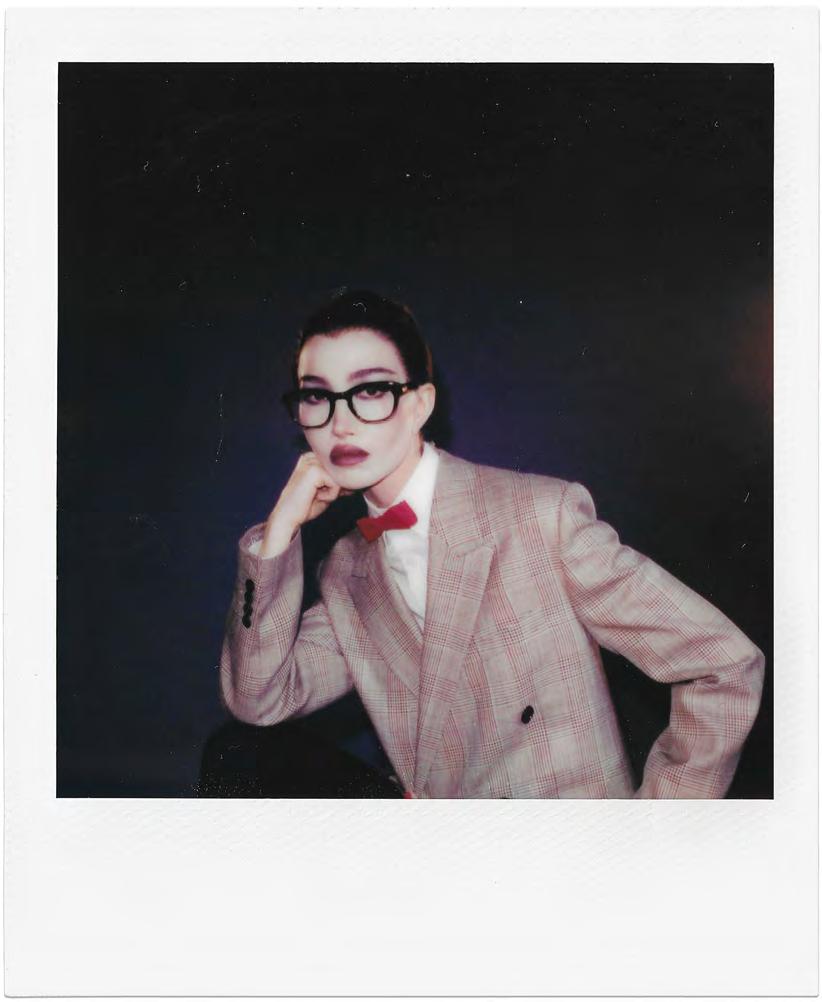



three bachelors, and a woman would pick one date. So, I put on my Pee-wee suit and auditioned to be a contestant. This was the first time I had ever gone out into the world as Pee-wee Herman. Prior to that, I'd just been in this little theater group. The second I walked into this audition, I could tell that the people running it were like, oh my god. They were all just trying to not lose their shit. And same with all the guys that were in there. When I filled out an application that asked about hobbies, I answered, cleaning my room—just weird stuff. When I left the audition, I thought to myself, I'm gonna be on this show. I just had this definite confidence that they were going to put me on the show. When I left the audition and walked outside down the street, people were practically walking into the sides of buildings and hitting lampposts. I just went, Donotignorethis.This isreal.Thisissomething.Thisispower.
COHEN Did you have the voice developed already?
REUBENS Yes. The voice was from a play I did long before that. I just mixed a bunch of stuff. You know, similar to what you said earlier, I've had to answer: how did I create Pee-wee? And where did the voice come from? You would think after this many years I would have a better story or I would at least make up a lie that would be interesting. But I don't. When you do these things, you’re just creating something that becomes somethinglater on.
COHEN Yeah, it just takes form—kind of like a snowball, which rolls until eventually it stops and looks exactly like Pee-wee. Does Pee-wee like anything that you don't like?
REUBENS Oh, I think probably a lot of things. Yeah. I think that if you're hiding behind the character, then there's at least something. I've been doing it for so long that there was a point when I decided I was going to have to change the rules for Pee-wee and allow him to do things and be things he wasn't originally, just because it started to get a little stale for me, and there were other things I wanted to do. Early on, I was in a comedy group and I had lots of other characters. I had about ten alter egos before Pee-wee.
COHEN Did they all have looks?
REUBENS They were all very detailed, but really different from Pee-wee, and nothing like the kind of impact that Pee-wee had. I feel like what was going on in art school in the ‘70s was performance art and conceptual art. So for me, Pee-wee Herman was always like conceptual art and performance art. And the conceptual part of it, the performance art part of it was my secret—that I wasn't really that person. Because I tried really hard to make it seem like he was a real person.
COHEN If you were invited to something, would they expect you to come as Pee-wee?
REUBENS Well, the point was that no one even knew who Paul was. No one. For example, when Peewee'sBigAdventure premiered and my credit came up as a screenwriter, nobody knew who that was. No one knew Paul Reubens had anything to do with Peewee Herman because I spent a lot of energy never doing anything out of character. I just thought that if people thought I was an actor, they'd be like, oh yeah,whatever. There was a guy that inspired me in a conceptual way named Tiny Tim. He was a freak, but you never went, oh,that'sanact. People were like, oh my god, he's a freaky person. There was also an act on the Ed Sullivan show who had an alter ego. This is when I was four or five years old. His name was Bill Dana and he would come out with this character named Jose Jimenez who was a Bolivian astronaut. It was very, very similar to Andy Kaufman’s foreign man
character. And the third or fourth time watching I realized, wait a minute, this is all made up. He's not reallythisguy. And I never thought about that again on a conscious level until I met him years later at an autograph show.
COHEN I’m trying to think of the British equivalent. Which would probably be Alan Partridge or Alistair McGowan’s The Big Impression. I remember being mesmerized at the concept of a person morphing their physicalities, mannerisms, and voice in order to become someone else.
REUBENS Did it influence what you do now?
COHEN It must have, along with Catherine Tate, or Little Britain. England had a lot of impressionist shows.
REUBENS One thing that is happening today culturally, is that it's harder and harder to set yourself apart.
COHEN Because we’re over saturated.
REUBENS Just to be cliché for a moment—Andy Warhol said, “in the future, everyone will be worldfamous for fifteen minutes.” And we live in a culture, at least in the United States, where lots of people seek fame, and social media is full of people who are trying to become known, and leave their mark. I think it's human nature to wanna leave your mark in some way.
COHEN Did you see the Andy Warhol documentary where they used AI to remake his voice? Would you want that ever, because your fifteen minutes would be forever?
REUBENS I'm hoping that I can, at some point, sell or lease my IP. And part of the lure of that is that it would include my digital scans so that you could make a Pee-wee movie long after I'm gone. And when I say that, people always ask about the voice, but by the time they can cheaply churn out an image of me that looks real, they’ll be able to figure out the voice as well.
COHEN But we all have so much more ability to create characters now. On the internet, you can just pretend that you're living whatever life that you want to live and sell that to whoever's buying it.
REUBENS So, how does art even fit into a time when things are so rotten, and horrible, and crazy, and weird, and mixed up? Who has the nerve to be an artist? You have to have some nerve to be an artist. And how do you, even in the art world, set yourself apart? You have to set yourself apart completely.
COHEN I think it's the confrontation—you absorb what's going on, confront it, turn it into something comical and entertaining, and then show it to people.
REUBENS You know, I hadn't really considered how much in the comedy realm you are. Because in my opinion, most art doesn't include comedy. When you mix a little comedy into art, it makes a whole different thing.
COHEN Yes. Take Jordan Wolfson's work. I think he falls into the category of creating comical, dark, and probably quite offensive art to certain people. That’s right up my alley.
REUBENS But your work also transcends so many things. It encompasses so many things. Some of those alter egos are dark and some of them, you can ask, what's their socioeconomic background? Some of those people seem like they could be down on their luck. It’s all over the map.
COHEN They’re a ‘Mr. Potato Head’ hybrid of personal relationships or people I’ve seen down at the shops. There’s one that's really representative of my uncle Terry, and he’s called Terry. There’s a continuous undercurrent of comedy with my family, my parents are always taking the piss out of each other and cracking jokes. My brother's a comic as well.
REUBENS And your parents are funny?
COHEN Yeah. My dad, to laugh at, and my mom to laugh with.
REUBENS How lucky is that? I think it’s so incredibly lucky that my parents were funny— that I grew up with this real intense sense of humor, or irony, or both.
COHEN Yes we are. I find that kind of irony rare in Los Angeles. I also have a lot of gay and camp influence. Are ‘camp’ or ‘kitsch’ annoying buzzwords to you?
REUBENS I hate the word kitsch. It’s such an ugly word. I also appreciate that if you say kitsch to certain people, they're like, oh, I get it. I know what youmean.
COHEN Maybe we feel like we're above kitsch.
REUBENS Not maybe—definitely. There's a sort of snobbery that I have to admit I do have in certain areas. In other areas, I feel just the opposite of that— like everyman kind of qualities, but I definitely feel snobbish about kitsch
COHEN What's the literal definition of kitsch? I’m curious. Should we look it up? ‘HeySiriwhatdoes Kitschmean?’
SIRI Noun. Kitsch means art objects designed or considered to be in poor taste because of excessive garishness or sentimentality, but sometimes appreciated in an ironic or knowing way.
COHEN It basically describes exactly what we do.
REUBENS So, therein lies why we don’t like it, because it’s so insulting. (laughs)
COHEN It's so accurate, though. (laughs)
REUBENS Maybe this is more a comment than a question. But it’s shocking how young you are. I guess I was around your age when I already had Peewee—I was thirty-two when I made Pee-wee’s Big Adventure and I had already been Pee-Wee for five years, but it’s admirable, and interesting, and amazing that you got it going on like this. I not only really appreciated the hell out of what you were doing at your exhibition, but it just raises all these possibilities of where you're going to go. To be young, and have your whole career ahead of you, and to be where you are right now, it's just staggering.
COHEN I wish little me doing the “Tequila” dance could hear what you just said now—thank you that really means a lot. But back to you … can you tell me a little bit about playing Michael Jackson’s stunt double? Because I don’t know anything about this.
REUBENS The answer to that is you'll have to wait until either my documentary comes out, or my memoir.
COHEN Oh, that's such a great end-of-interview plug. You’ve done this before. (both laugh). I want to pretend that I was somebody’s stunt double too, but I'm not sure who it could be.
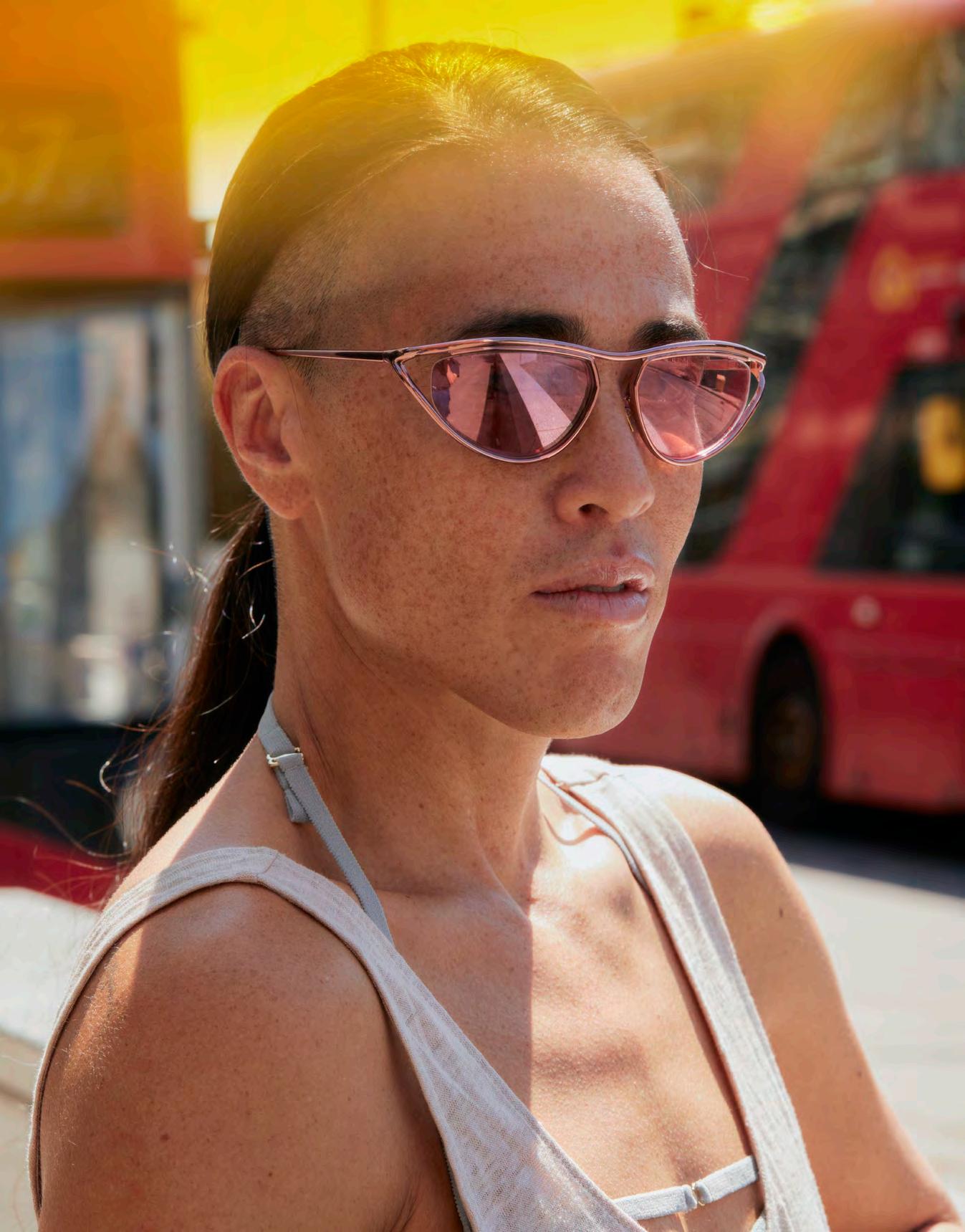
Artist Wu Tsang uses the power of moving images and performance to navigate what she calls “the politics of representation.” In a world thrown into constant upheaval, Tsang uses the potential energy of collaboration to amplify marginalized voices and hidden histories. Her first feature length film, WILDNESS (2012), is a tender cinematic portrait of Silver Platter, the legendary Latinx Los Angeles LGBTQ bar that dates back to 1963, before the Stonewall Riots. A coalescence of fiction and documentary—the bar itself is a character in the film who confronts a new generation of queer artists and activists (Wu Tsang, DJs NGUZUNGUZU, and Total Freedom) that organize a weekly performance art party, called Wildness. Tsang’s latest feature, MobyDick;or,TheWhale (2022), is a filmic recontextualization of Herman Melville’s great American novel that dives into its themes of sexuality, extractivism, colonialism, and crises both ecological and spiritual. The film premiered at The Shed in New York and its score, composed by Caroline Shaw and Andrew Yee with Asma Maroof, was performed live by members of the New York Philharmonic. Currently, Tsang and some of the members of her loose band of collaborators, Moved by the Motion, which includes her partner Tosh Basco (Boychild), are in residence at Schauspielhaus Zürich, one of Europe's most important art theaters.
OLIVER KUPPER I wanted to talk about your first major film, Wildness (2012), and the idea of these queer nightlife spaces as places of spirituality, community, and belonging.
WU TSANG I don't know if I connect to the word spirituality. It feels loaded, and just too big of a word to be working with as an artist. I think of spirituality as a very personal thing. As an artist, I can't necessarily make work that addresses such big abstract themes, but I can observe patterns or social relationships and try to reflect on those things. Spirituality is something that might come up in reflection of that. A word that I would maybe use is ‘connection’ or ‘vulnerability’— not solely being focused on one's individual needs, but also the needs of the people around you. The film, Wildness, is about a community that was very
text, which could be movement, choreography, music, other writing, and such. They're essentially layers and layers that create a palimpsest of notations. And then, I use this acid etching process that eats away at the color so you can make all these cool gradients.
KUPPER Is there any religious symbolism to these or are you making any statement about the place that these windows have in religious spaces and the making of icons?
TSANG Stained glass was one of the ways that churches would teach the stories of the Bible. They did this through imagery for people who couldn't read. My stained glass is very intentionally not narrativized. It's very text based and there’s a visuality to it, but I was really thinking of going against that tradition of something didactic or pictorial.
like the theater where I work is where we filmed the movie and cast the actors for the ensemble. Zurich Chamber Orchestra was also a partner for us here. Fred is also in the film. He's one of the main characters. So, there’s many layers of collaboration.
KUPPER It's such a misunderstood novel and both the queer studies reading and the post-colonial reading of it is so interesting.
TSANG. All of that's in there and that was really opened up for me by a book called Mariners Renegades andCastaways (2001) by C. L. R. James, who Fred's partner, Laura Harris, introduced me to. A lot of C. L. R. James's thinking about Moby Dick got me really excited and I decided to make a film. I actually knew that I wanted to make it before I read the book. I don't remember that we were ever required to read it in high school, but when I read the book it was even more exciting.
KUPPER A lot of the great American novels are these monoliths of heterosexuality and whiteness, and they’re often written during these really fraught historical times, like the Civil War. What were some of the codes that you discovered in the novel that were explored in the film?
ephemeral and grew out of a physical space in LA, which was a bar called Silver Platter. It had been a community for many decades, and then when my friends and I started throwing a party there, it birthed a community within that community that began mutually taking inspiration from each other. I say ephemeral because those spaces are very precious and fragile, and they rarely exist for very long. By the time you feel like you've grasped them, they're already gone. This film became a conversation about what it means to make documentary and the impulse that one might have to narrativize the events of their life. As someone who was very involved in trans organizing at the time, it felt like a very political thing to make a documentary and try to tell the story. But in that process, there was a lot that was lost in the condensing of representation and of narrating. Film is an interesting way of capturing that process and to take on some of the issues that come up in that capture. The last fifteen years of my life and my work has been growing out of that experience.
KUPPER You have also been working with Fred Moten on these incredible stained glass pieces that connect to the theme of religiosity. Can you talk about those works and the metaphor of the refracted window?
TSANG I love making stained glass windows. And yes, they are primarily objects you encounter in churches, or spaces of worship. I would be very happy to just be making stained glass all the time, because I really enjoy the process. There is something about working with color, with the light, and how light moves through color—because it's always based on the turning of the Earth. So, it's never one fixed thing. The first glass piece that I made, I was working with a text for a performance with my collective that's called Move by the Motion, and Fred is an unofficial member. We're all kind of unofficial members in the sense that it's just a name we use sometimes when we do things together. This particular performance was based on a text that Fred wrote with me called “Sudden Rise At A Given Tune.” Part of Fred’s work ethos is he writes with people, and that particular text became iterated and reiterated into several different performance pieces on a film as well. For me, the windows are like scores to these performance projects where we start with a text and then there's lots of annotation on that
KUPPER You had an exhibition of these glass pieces called Sustained Glass, which is a really interesting play on words. You use language in a really interesting way. Can you talk a little bit about how you use language as a tool, or maybe a weapon, in your activism and art?
TSANG Language is one of those things that is impossible to get away from as much as we might try. A lot of the work of Move by the Motion is this play that we have between language and nonverbal forms of expression. When we do performance, we usually start with a text and there's a lot of reading involved, a lot of submersion into research materials. But, we're often trying to find ways to express what we want say without words. So, subsuming the language into choreography or sound composition. Language is so inadequate as a form of communication. I'm interested in the voice as an instrument and how it contains a lot of meaning and content outside of the words themselves.
KUPPER Another one of your recent projects is the Moby Dick film, which has a lot of these themes that run through your work. How did that project come about?
TSANG Moby Dick is my second feature after Wildness. It's a narrative feature, and it's a silent film with a live orchestra score. We actually just recorded the score yesterday. So, there may soon be a version without the live orchestra, but as it currently exists, you can only see it if you are able to catch a performance with the orchestra. It's something that really subsumes the language of the book into mostly imagery and music. There is text and spoken parts, but it's mostly nonverbal. It also addresses some of the ongoing themes around storytelling and its function within a community, and the role of alternative interpretations and social coding. I always like to say with MobyDick, if you know you know, because there's all these very queer undertones to the book and when we were creating the adaptation, we didn’t change anything. We just chose to focus on certain details or thematic threads. I adapted it into a screenplay with Sophia AlMaria, who's the screenwriter. She's also an amazing artist herself. It’s many layers of collaboration. Telfar designed the costumes, and Caroline Shaw and Andrew Yee composed the music for the orchestra. And then, we have these bigger institutional partners,
TSANG Well, I should add that the book is also very problematic and racist. I can't believe this is considered required reading for teenagers. There's so much depiction or racial othering, like one of the main characters, Ishmael, is most in love with Queequeg, who's this “cannibal” from the South Pacific. It's just shocking how exoticizing Melville is in several parts of the book. It's also interesting because Melville himself worked on whaling ships when he was young. And, at one point he actually deserted the ship that he was working on and lived in the South Pacific amongst natives. So like, he went and had his native moment. There's his gaze that is so problematic, but it's also made messy by his desire. It’s homoerotic, but it also just reflects a desire to encounter difference that is beyond his personal understanding of identity, or what it means to be American. So, he kind of reaches for stuff and it's disturbing, but it's also inspiring to me because it's just not neatly done, and I think messy things always interest me.
KUPPER That white colonial gaze is so prevalent in a lot of these novels. It's so obvious in the writing that this Manifest Destiny thing is still informing our perspectives on the Indigenous populations that have been here since long before our arrival.
TSANG Yeah. We've inherited this legacy, so I think it's always productive to just kind of deal with it. That's what I try to do.
KUPPER You've dealt with it in some really interesting ways in this film. You used a sound stage and a lot of silent film era techniques. What made you decide to utilize a lot of those tools?
TSANG It was actually my cinematographer, Antonio Cisneros. He was the one in the beginning that said, “I think we should do virtual production.” I didn't even know what that was at the time. The most popular reference for virtual production is this TV show on Disney called The Mandalorian that they shot entirely on a soundstage with a 360 LED screen. There's a physical set, but most of it is extended by the digital background, which is created using VR. When Antonio suggested it, it kind of clicked for me thinking about silent film era techniques. They were also very innovative because they had to tell a story very visually, and they used a lot of rear projection in the ‘20s. I always loved that thing where it's not real, but it doesn't matter. Two actors are in a car and the streets are going by, and you know that they're not really there, but it still works. I realized that if we used a virtual
"...Those spaces are very precious and fragile, and they rarely exist for very long. By the time you feel like you've grasped them, they're already gone. "
ocean, we could do a lot more exciting stuff with the colors, the waves, the weather—we could just get really crazy with the world because I wanted it to be kind of psychedelic and to measure up to the way Melville wrote it. It gave us a lot of leeway on set. We built a ship deck on a soundstage, we had a projection, and we used this 3Dgame engine called Unreal to create the ocean, so you can literally art direct live. You can move the sun, or the clouds at will, which is really fun.
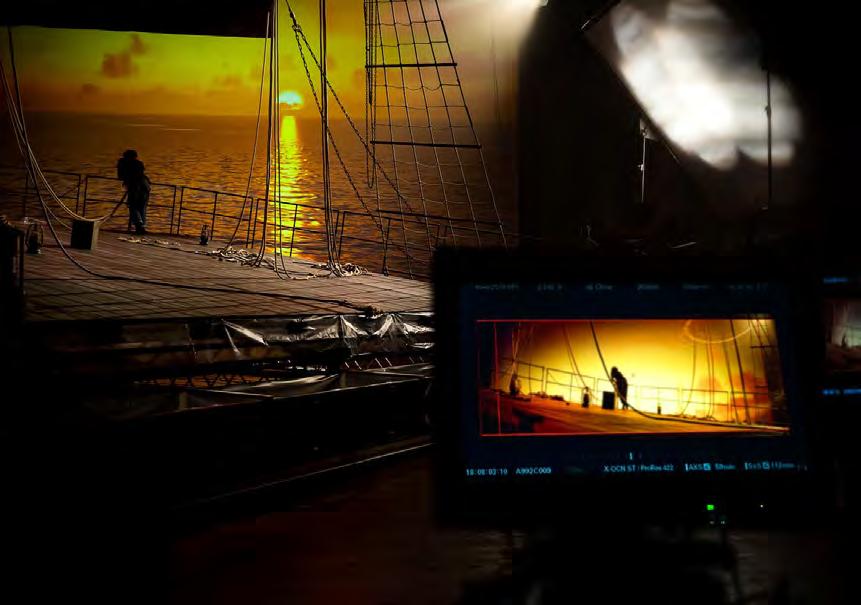
KUPPER When did film as a medium come into the fray and collide with your activism?

TSANG I don't even know if I would say I'm an activist at this point, but in the beginning I was feeling very invested in community organizing. By the time I was in my twenties, it was really easy to shoot MiniDV or even cell phone cameras. All those tools were really accessible, and editing was really accessible on the computer. There was a jump in what was possible for a young person with limited access. The generation before me had to have a professional point of entry, you know? So, making video, doing performances, throwing parties and organizing, all those things were very fluid. I never really distinguished one activity from another.
KUPPER Film also has this very naked quality. It has the ability to immediately make the invisible visible. It just shows how film as a medium can be a very powerful tool.
TSANG Yeah, and I think I learned everything I know about how to make movies from that period of about four years when I was making Wildness. I also made some short films in that time period, a lot of my early film and video stuff. When I look at it now, it makes me laugh because I just see someone learning a language. There's also something I try to appreciate about doing anything for the first or second time. There's a lot of naivety because you don't really know the rules, so you don’t even know which ones you're breaking. At some point in that process, I was a little overly concerned about doing things right, and now I don't feel constrained by those processes because I have a way that works for me.
KUPPER You also have this amazing ability to collaborate. The collaboration aspect is a tool in and of itself within your practice. You find the most incredible people to make your visions come to life.
TSANG For sure. The editor, for example, of Moby Dick is an amazing editor, Jerome Nel. We met on a job that we were working on together and kind of fell in love. I know we'll work together again, but I learned so much. I mean, Jerome kind of made the film as well. The film wouldn't exist without his input, without Antonio's input, without Sophia’s input.
KUPPER What is that process like, assembling all these incredibly talented artists to work on your projects?
TSANG Every collaboration is different and every collaboration needs something different. Some collaborations happen very organically. Other ones are very intentional and formalized. Like, let'sdothisthing togetherandhere'sacontract,andlet'sdefineit.Some collaborations, like with Fred, is just us hanging out after dinner many, many nights in a row over years and always having a conversation about whatever it is we're working on. And then, that evolved into something. I like to think that most of my collaborators are friends, but I've also come to realize that we don't have to be friends to collaborate. I did a film for example, with [Beverly] Glen Copeland, the singer, during COVID and I think I spent a total of eight hours with him. We were on Zoom a few times, then I had to go to Canada and quarantine for seventeen days, drive to his house, and we were trying to be really extra careful about
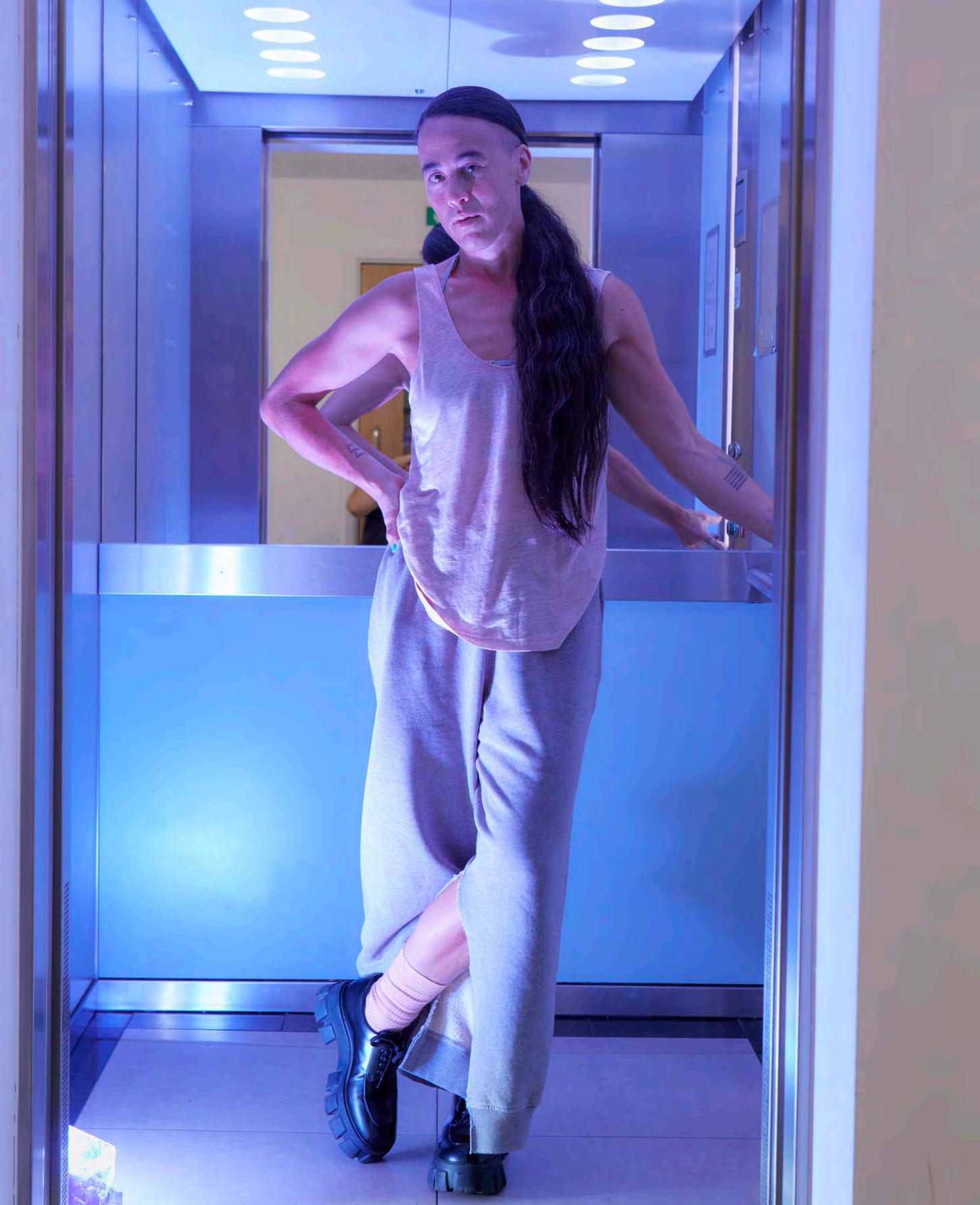
COVID things, so we didn't have too much time in person. But, I really appreciate what we were able to make together without really knowing each other.
KUPPER How did you discover his music, and how did the Anthemproject come about?
TSANG I started listening to Glen right around the time we all went into lockdown. My partner, Tosh [Basco], was playing his music while we were cooking dinner, and I think we both just started crying. Glen’s music just opens your heart in a really vulnerable way. My personal discovery of his music coincided with an invitation from the Guggenheim where they were like, “We want you to show a film in the rotunda,” which also was very COVID related. Usually they can't do projects like this one, but because all of their shows had been canceled and postponed, there was this weird, two-month gap where they were reaching out to filmmakers, because they thought filmmakers could fill the atrium. When they approached me to screen a film, I was like, “I think I need to make something for this space. You can't screen a film in here. It's a massive beehive.” So, that was special because they were really receptive to that and commissioned the film.
KUPPER It's the perfect work for that space, and Glen's voice is perfect for that space. Can you talk a little bit about the choice of song, “Deep River?” It’s very spiritual.
TSANG Well, I had a lot of discussion with Glen about the song choice, because what I knew was that it should be acapella. That space has so much reverb, it needed to be really spare and slow. So, we had a long dialogue about song choice and that was the one Glen wanted because he often does it acapella in his concerts. The way he creates music is very private and he doesn't just sing any song acapella. The way it exists is the way he intends it.
KUPPER Can you talk about some of the other projects that are coming up in the next few years, because you have a number of different pieces that you're working on.
TSANG Right now, we're doing a children's play at the theater. We're doing Pinocchio. It's for ages eight and up, it's opening at the end of November, and it’s running through the holiday season. One thing I really enjoy about working in theater is that there's a very different mandate for the cultural production. It's much more geared towards a general audience, and sure, the title of the work has to really sell tickets, but Pinocchio was actually our idea. It’s just that everything we do there is a conversation with the theater. They have to approve it. It's a familiar kid story, but we're also trying to do something different with it.
KUPPER It's another fraught story.
TSANG Yeah, a very fraught story. At first we looked at the premise of the Disney version with this puppet that wants to be a real boy and thought, that'll be fun to take apart. But we got really excited after reading the original children's story by Carlo Collodi. It's an Italian children's story, which is actually quite scary, but it's one of the most popular children's books of all time. In the Collodi version, Pinocchio never wants to be a human. He's a puppet and he's happy to be a puppet. The other thing is that Pinocchio actually begins as a piece of wood. Before he's carved into a human form, he already has a kind of spirit. He talks and he hits people, and we were kinda like, oh let'sstartthere. So, our Pinocchio starts as a tree who gets chopped down. And looking at the experience of being a tree gives us a possibility to talk to kids about what it means to be human versus non-human.
KUPPER There's also an ecological reading
in that.
TSANG For sure. So, we're having fun with that one, and we’re in a very early phase of working on Carmen for the following year. That'll be my first opera piece.

KUPPER A big part of this issue is also finding ways to build communities in a world that seems completely chaotic and violent. How do we come to terms with our past? How do we not become complacent in our present? Do you have advice for people trying to enter those worlds as artists and build community? And why is community so important right now?
TSANG Well, I teach at the art school here. Every quarter, I do a workshop and I've done lots of visiting lectures in various places, and one of the things I always try to tell students is that the best thing about being in school, and this doesn't have to be school, or wherever you are, is the people that you're there with; that's the real resource. It's cool to have teachers and you will learn from them, but the people you learn the
most from are your peers. Those are the relationships that carry you your whole life. Hopefully, some of them do. So, investing time and energy into relationships with the people around you will teach you the most about who you are and what you want to do.

Every year, artists Mickalene Thomas and Derrick Adams organize a joint birthday party, which can lasts upwards of three straight days, culminating with a dinner. The guestlist is a who’s who of art world luminaries. It is a celebration of their friendship, but also the joy of existence. Having met in the 1990s as undergraduates at Pratt University, both of their art practices reflect a similar joie de vivre. Black joy abounds—leisure—smiling figures, reclining nudes, barbeques and picnics; it is a rare and true look at Black life in America. Thomas is also the founder and director of Pratt>FORWARD, which helps young artists navigate the artworld. Adams recently founded Last Resort Artist Retreat in his native Baltimore, an invitation only residency that focuses on rejuvenation for artists. He also started The Black Baltimore Digital Database, an institutional space for safely storing local archives.
DERRICK ADAMS We’ve been friends for so long. I think I was in my sophomore year. We met on campus and bonded and have been close ever since. We have gone through so many different iterations of ourselves.
MICKALENE THOMAS Yeah…. We are a little more seasoned now. Our artistic journeys have been like navigating a series of dense forests, and now we have both reached great places in our respective careers. It’s nice to have it aligned.
ADAMS From the beginning of our meeting, it has always been on a supportive level as friends. I have so many great memories of you from our undergrad. You were an RA and you also started a Japanese catering business.
THOMAS Yes; I had started a sushi business with my friend, Alan Thomas. We delivered sushi and actually cooked it on campus at the president's house. Then I partnered with another Pratt alum, Andrew Sendor. And you were part of an incredible spoken word group called the Second To Last Poets at Pratt, which brought so much culture to the campus.
ADAMS Yes, we were doing performances at different places in New York, in Brooklyn, in Manhattan, in the Lower East Side. But we both kind of came to Pratt and immediately established a community of like minded POC creatives. There was not really a big population of Black people, so we gravitated towards each other and created these cultural experiences. I interned at City Hall and I worked at a gallery there as a curator for a few years. You actually would come and help me organize the files in Chelsea when I first started working there. At that time in our young artist careers, the idea of selling art, or being the artists that we are now, was never something we thought about.
THOMAS Yes, you’re right. Selling art was the last thing on our mind. We were excited about our community, gathering, and being creative. The energy and vibe of the city was electric … we traveled in groups and made sure everyone in our cohort knew what was happening. That was such an incredible time. We spent our time engaged with all the things artists were doing: going to openings and creating our work and our spaces.
ADAMS If anything, it was a time when the artists of our generation were looking at artists from the ‘90s, like Glenn Ligon and Lorna Simpson, and how they were
presenting ideas. We were figuring out how we connected and what we wanted to talk about. I also thought that if I’m going to make art, the visual representation had to be somehow unique, in the way that I bring my perspective.
THOMAS We were just happy to show our art in as many spaces as possible, but also supporting the artistic generation of the ‘90s by showing up at their exhibitions. The market was definitely not in the foreground of our minds the way it is with savvy young artists today. We were like, “Oh, you got a show … we're there” and we put our art on many white wall spaces. The white cube had no boundaries for us; we just put our work up on the wall for people to see it. Now, artists are more aware of the complex dynamics of the market. I would probably have a harder time coming up as an artist today; I think it would have been more challenging for me to have to keep up, or I would have been worried about where I’m showing or selling my art. I needed the space to simply explore and be myself. We had a lot of room to experiment without the pressures of our market. The market was always there, but it wasn’t as clearly defined as it is today. There was no external weight on us. We were cultivating spaces and challenging ourselves through experimentation—but most importantly, fostering a community.
ADAMS If, say, a Black-owned coffee shop or restaurant was opening in Brooklyn, we were not opposed to showing our work there and connecting with the community. We looked at ourselves as visual artists with the same level of appreciation for the culinary artists who were opening their restaurants.
THOMAS We weren't trying to separate it. There wasn’t any compartmentalizing during that time. In fact, someone should do a documentary about that period in the ‘90s, during which we also had a number of actors, musicians and writers around us, like Rosie Perez, Carrie Mae Weems, Wesley Snipes, Chris Rock, and Carl Rux Hancock.
ADAMS You would also see Spike Lee, Erykah Badu. Fort Greene was a place where there was this interesting mixture of a lot of different cultural producers of various genres occupying the same space. So, the hierarchy was not necessarily there. Music, art, and fashion were a very localized experience.
THOMAS We were working out of the Brooklyn Boheme, which was a hub of cultural diversity. It was inspiring to be in the room with such creative people,
from actors to hip-hop musicians to performance artists. You were doing spoken word, music, and poetry, and yet still also making paintings; your practice was not defined by being a visual artist. You were just an innovative artist who wasn’t afraid to explore various artistic mediums.
ADAMS There was the Sensationshow in Brooklyn back in ‘97 that had a number of memorable pieces. Renee Cox did her [Yo Mama’s] Last Supper—a Black woman posing naked as Christ. It was so controversial. A lot of those artists weren’t represented by large galleries at the time, or selling much of their work, but the conversations around their work became a blueprint for the next generation to think about content, and values, and your power as an artist. How to present your ideas and stand by them. Even the title of the show Sensation that could never be the title of a show now. No one would think that show is interesting.
THOMAS The artists in that show were from Europe, and they were all tapping into various genres—creating sensational and provocative bodies of work that challenge our notions and our perceived possibilities of what art could look like during that time—and a lot of the work was deeply personal. When you think about Renee Cox, even though she’s starting a specific conversation regarding the lack of presence of Black bodies in iconic images, she is claiming an agency that provided a platform for artists like myself. It’s still very personal. She’s exposing her body in a way that is conceptually complex and provocative. Then you have someone like Tracey Emin, who created a tent with the names of everyone she’d had sex with. Unapologetically, presenting her personal narrative of intimacy. Marc Quinn’s frozen head, composed of pints of his own blood; or Chris Ofili using elephant dung on paintings; or even Mona Hatoum’s video work; these created more than a sensation. It validated, yet ridiculed the process of painting. It was all groundbreaking for me and opened up seemingly endless possibilities for making images. For me, it presented that in art, anything was possible.
ADAMS That show really pushed the idea of what art is and what it could be.
THOMAS It was so lit! Everyone was talking about it, and it was in Brooklyn, putting Brooklyn Museum on the map as a cultural epicenter.
ADAMS The Sensation show really resuscitated the Brooklyn Museum. People looked at it as a major
contemporary art institution. Some museums weren’t showing this type of work, so questions about what museums should show, and freedom of expression all became part of this conversation. Living in Brooklyn and going to Pratt really pushed me to think about what type of art I wanted to make and how I wanted to share it. The materials I used were very unconventional and the idea of unconventional materials began to shift from kitsch and low culture to high culture. People were looking at things that were kitsch and talking about race—ideas that I was interested in. That was an important foundational platform for a lot of artists from different backgrounds seeing that exhibition.
THOMAS Did you know that I was one of the volunteers at the show? They partnered with Pratt Institute, allowing students to volunteer as guards. There was such high visitor traffic that they needed additional
work to Matisse or other painters, when I zoom in I totally see this influence of mark-making as a transformative way that these patterns are created, to create space and optical experiences. Since we have been around each other for so long, what I love about your work is that I know when I go to one of your shows, I will always see something I have never seen before.
THOMAS Having exhibitions all around the city in small gallery venues gave us an opportunity to challenge our own practices, to present something that gives context to the visual languages we have built and to say, “I am expanding on my ideas.” Exhibitions offer a forum to engage with the audience and to create a dialogue. You have to look around your studio and say, “What am I going to say to these people now?”
ADAMS When I go see a Mickalene show, I feel like I’m looking at what Mickalene was thinking and feeling,
THOMAS You have to be the architect and the innovator of your own story. No one can do it for you. Part of the process is to elevate yourself by determining for yourself what you want your world to be or look like. And it doesn’t matter what people think about it; you have to go into the studio and say, “Okay, this is what I’m generating.”
ADAMS The reason why I think the term ‘Black joy’ became associated with my work is because it offered viewers another aspect of looking at Black culture. What I presented in the Funtime Unicorn piece automatically defaulted back to the idea of positivity and Black joy simply because I was presenting the Black subject without addressing colonialism or trauma. It was creating a space that reflected the Black people I know and what we talk about together. Contrary to popular belief, Black people do not go around talking about trauma or white people all day. We have our own world like everyone else that consists of having fun and talking about serious issues that may not be related to any other race. We are a culture of perseverance, and although things are thrown at us constantly, we are able to help each other survive and support other communities, which is what my work is about.
support to protect the work. Many were upset that Holy Virgin Mary [by Chris Ofili] had dung on it … people were so offended that they were trying to attack it. We were a part of the “Ask Me” program, so we would talk to visitors about the art and the artists. Standing in front of those works weekly gave me close and upfront access with a sense of agency and an awareness of who I was as an artist. I felt like there wasn’t any material that was off limits, as long as there was a reference related to who I am or something happening in the world. Has there been a show as groundbreaking as Sensation during our time? One that people still talk about as shifting the paradigm in art? Usually, there is a show about gender, or sexuality, or race, but encompassing all of them in one collective space, and within one conversation was completely new for me.
ADAMS Yeah, the artists themselves were the center. You could not separate the materiality from the artists. There were certain things pushing the envelope of what art is and could be. There have been exhibitions in the Whitney or MOMA that have sprinkles of these ideas, but not really as a collective.
THOMAS I think you and I are very similar with how we explore materials, and we’re definitely not afraid to throw it against the wall. I remember you working in the studio at Pratt, making Popsicle cutouts of the African continent; it was so radical, and way before the Sensation show. You are definitely an innovative artist who makes groundbreaking, avant-garde, conceptual art. You were always thinking of how your material provided context for and exploration of your ideas. You always made many things simultaneously, from costumes for your performances to full installations for a video or production. Your experimentation carries such a strong intellectual and conceptual thread. You recognized early in your career that not everything needed to be a painting—some ideas were better executed in other mediums, and that freedom of exploration created different methods of production. I was also very interested in experimenting with different forms of collage by incorporating alternative materials, which opened me up to investigating the various ways to make an image. It was all about the opportunity to have that space to explore and not worry about the pressure to show the work. It was more about sharing new work and ideas with your peers.
ADAMS Most people don’t know that you went to Australia to study Aboriginal dot painting and stayed an extra year because you were enjoying it so much. But when I look at the patterns in your work, and your configuration, and the mark-making, I go to that history all the time. Although, some people might compare your
and I’m looking at the way she presented the idea based on how she felt it should take shape. Every time you make a body of work, you present the female figure in a totally different way. That’s the most exciting part. How can you present something that you feel so strongly about in a fresh, interesting way that keeps people guessing? People kind of lose interest when artists are so accessible these days. When they know what to expect, they don’t want to see the opening, they figure they’ll just go see it later.
THOMAS Yes. When they go see our shows, they have no idea what to expect from either of us. But they know it will be an amazing experience with new work; we know how to install a damn good exhibition with a little bit of everything. I’m a huge fan of your work and I love living with it; it makes me feel happy. I can’t figure out how you make it look so direct and clear; you’re such a genius with how you formalize your concepts and intent with execution. Your work is layered with signifiers that refer to Black joy, Black excellence, and the Black American experience. It’s a dialogue between language, music, and your own personal narrative. Whether it’s architecture, landscape, or the figure, it allows you to go deeper and question your own sense of place. Your understanding of assemblage and constructivism is a testament to your knowledge of language, art, music, and performance. One can see that you are not just someone who wants to make a pretty picture. The execution is deeply considered, from your choices of material to concept, and they are damn good images.
ADAMS Looking at artists like Robert Rauschenberg and Bruce Nauman, then looking at Black American quiltmakers like Gee’s Bend, or African sculpture makes you think about the functionality of the work versus the Western perspective, which is about the institution, where things are in cases and they’re untouchable. It provides context for David Hammons’ interactive work. I like the idea of creating these environments that people can occupy, works that people can engage with, not just standing in awe—some level of sensation, touch, smell. I learned a lot about the formal execution established with these artists, but also looked back at other real influences such as family gatherings and more traditional practices with real substance. Those are the things I learned outside of school, which helped me to transcend beyond the Western influence of the academic space. Hanging out with different people and experimenting with new materials obviously affects the decisions you make. As a creative person, you have to ask yourself what kind of world you want your work to live in, and how you want people to engage with it.
THOMAS I agree, because I also see my work as celebrating beauty and engaging with what we see within the art historical canon—as with the reclining nude, the freedom to just recline and luxuriate is a radical act of selfcare. I want to position and celebrate Black women within the same notion of leisure. Oftentimes, art history doesn’t associate Black women with the concept of luxuriating for themselves; it relegates us to luxuriating for others, being the object of pleasure, rather than bodies that experience our own joy and pleasure. So, for me, that idea of Black joy is luxury. It’s about understanding the prowess of Black women without it being in the service of somebody else, or without it being on other people’s terms. Of course, we understand our own beauty, and we’ve been celebrating that for many years, but it’s often been conformed and commoditized into something else. The stories are easier if you focus on the trauma of Black people and Black life, to perpetuate the same perception of who we are as Black people, of Black history, because the truth is that in spite of the trauma, we have contributed to this country in great ways. Our contributions are endless … beyond picking cotton and slavery. So, a lot of the images I make come from notions of luxury, reclining, the landscape—we’re luncheoning on the grass. We are le déjeuner sur l’herbe.
ADAMS Yeah, I think it’s important for this generation to see Black people represented in joyous settings, because honestly, we are never going to be short of art that highlights the struggle. So, we have to balance out the idea of Blackness.
THOMAS Yes, and it’s also about inspiring and making people feel good. There’s so much trauma in the news and on social media outlets that sometimes you need to pause and take a deep breath as a reminder of playfulness and the spirit of being grateful for being alive. That’s what it’s about, bringing people back to themselves—look at Derrick’s painting and think to yourself, “Yeah, I should be at the pool right now on a floatie. Why not?” Yesterday we were getting our photographs taken together and this gorgeous, young Black couple decided to set up a hammock in Fort Greene Park, enjoying each other on a beautiful day and taking a moment to just luxuriate. We need to see more of that.
ADAMS If anything, we’re more motivated to make work about things we feel should be normalized. We’re looking at all the gaps that are not being filled, when you look at the way the Black body is not being presented. Not just with the body itself, but also the environment that it occupies. The way you present a figure has a certain level of dignity and I know that you’ve considered how to allow this figure to have its own space and power. I can sense the power not only in the subject, but of the space you created for her to live in. And the power is so formally excellent. I love the new work with the pixelations on certain parts of the body.
THOMAS Sometimes, I deliberately don’t put the
"...The freedom to just recline and luxuriate is a radical act of self-care. I want to position and celebrate Black women within the same notion of leisure."
ABOVE
Blue
Thomas
pixelations on the part of the body that would normally be obscured. Because I’m interested in the visual framework of what’s exposed rather than what’s covered up. Normally, these aspects of female beauty are censored; that’s why I appreciate some of the powerful images on Instagram, where Black women are unapologetically celebrating themselves through their power and beauty. All these images and positive affirmations are needed as an act of self-love. It’s our responsibility as artists to counter the negative imagery that is often perpetuated and to show the other side. To say, “This is a different perspective on how to see the world.” Recently, I opened one of the architecture magazines and saw a queer male couple standing in their home with their children in front of one of your paintings. It put a smile on my face seeing your Floaterpainting in the background with this family. The image was a real reflection of the diverse group of collectors connecting to your work who are recognizing and connecting to the joy and leisure of life.

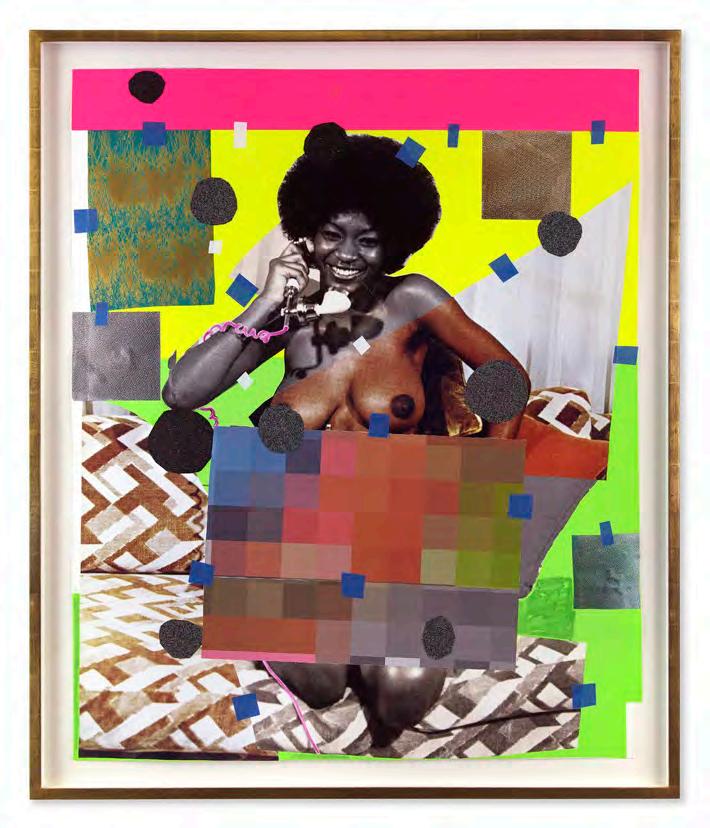
ADAMS When people talk about radical Black joy, it’s because Blackness and leisure, normalcy, and perseverance is radical! When you look at the news, it’s usually stories about Black people being attacked at the supermarket, or in church, or someone is shooting at a Black person’s car because the music was too loud. It’s always about Black people moving forward in a way that is somehow jeopardizing a non-Black person’s level of leisure or self empowerment. Our joy is always presented as a thing that compromises someone else’s joy.
THOMAS As if we are taking something from others.
ADAMS These things are never happening to neighborhoods where gang members are hanging out with guns. They’re not going over there. The threat for them is that people are prospering and creating space for themselves.
THOMAS They want us to think of leisure as something that we don’t deserve. That it’s too expensive for us. But the truth is that it’s not expensive. Going back to the couple in the park on the hammock, what they were doing is not expensive; Fort Greene Park is a free public park and they creatively made use of the space. Oftentimes, there’s an overwhelming feeling of not belonging. We don’t often know what’s accessible or that it's possible for us to occupy that kind of space. There should have been ten more Black people out there on hammocks, but it will only happen through exposure.
ADAMS Young, Black people need to see themselves in ways that will give them the level of confidence required for them to thrive. They should see themselves in a way that makes them feel normal, like they’re a part of the structure, the core of humanity. I want them to feel that sense of entitlement. I’m from Baltimore and in 2019, I decided to create this space where creatives can talk, and hang out, and just be in each other's orbit, and from that, ideas manifest and opportunities are presented. I can see the genuineness happening in the community in Baltimore, so I wanted to harness it and help to develop it. I don’t want to be the front person. I want to be the facilitator, to bring some of this New York energy to Baltimore, and let them develop their own community by being more connected to New York. Places like New York, or LA are more high-profile, there’s much more pressure to be well known, but people in Baltimore want to show their work as well. So, I thought it would be more beneficial to help there.
THOMAS Your residency, The Last Resort, is an incredible game-changer. It’s a phenomenal concept to provide space to “just relax” without feeling obligated to make. You’re also embarking on another innovative phenomenon by creating your digital database.
ADAMS Yeah, that is another extension of one of the projects that I’m doing, helping the Black citizens of Baltimore secure their history by creating a digital database to store their family archives. We’re having archivists in Baltimore working with different institutions that help people to scan their materials and put them into digital format. I don’t own the database, it’s more like a space that you can use as a repository when you need to access it. This makes the whole idea of looking

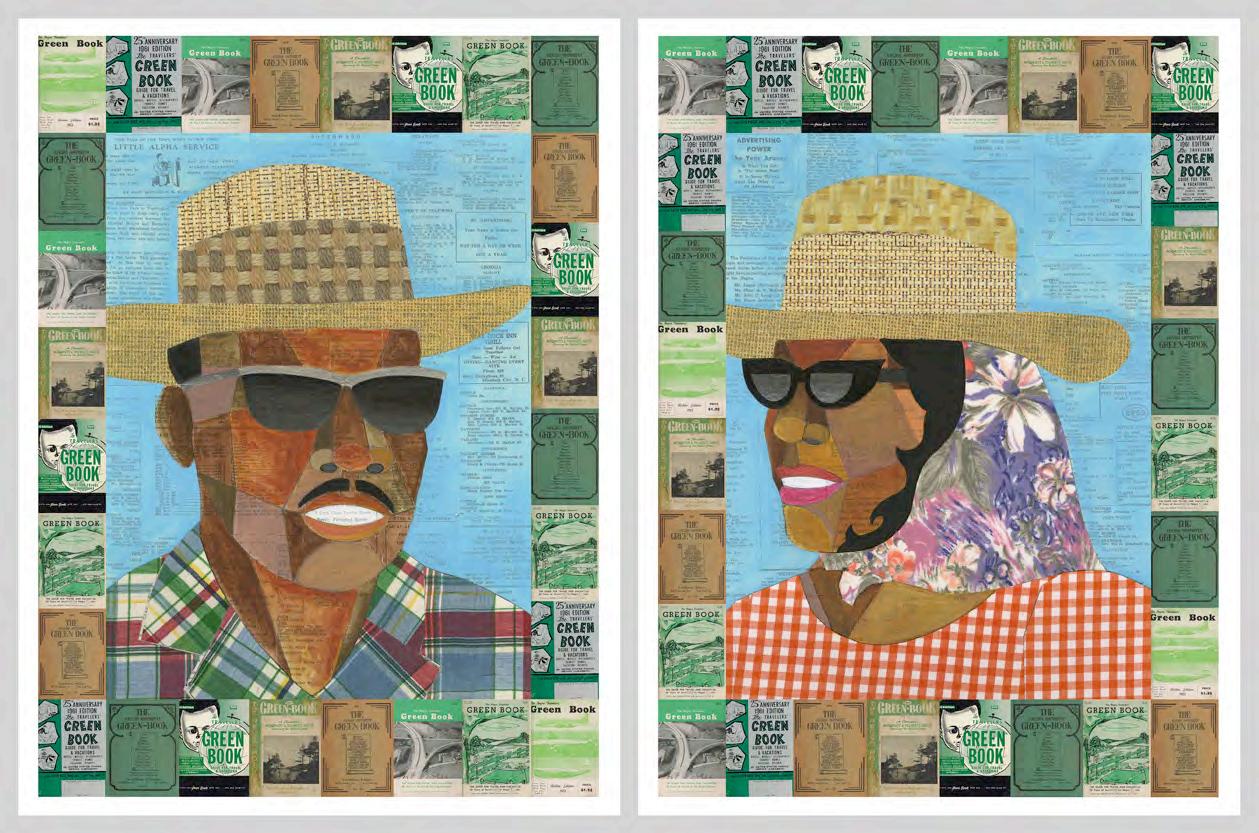
at data less of an institutionalized or academic thing, and more of a community thing. People can go and do their own research. And if people want to sell their images to a corporation or something, it’s up to them. We are not charging them for storage or anything. We don’t own the images. We just want Black people to be more comfortable going to an archive. Normally, the archive system works like you gather information and put it in a bigger institution, but to access that information you have to have an account with credentials to get in. We want to create an ongoing archive of the city just to know what happens over time with things like gentrification. Who lived there? What kind of restaurants were there? The database is going to operate to keep people familiar with their history, which creates a certain value system of looking at yourself, but also to have this kind of art retreat.
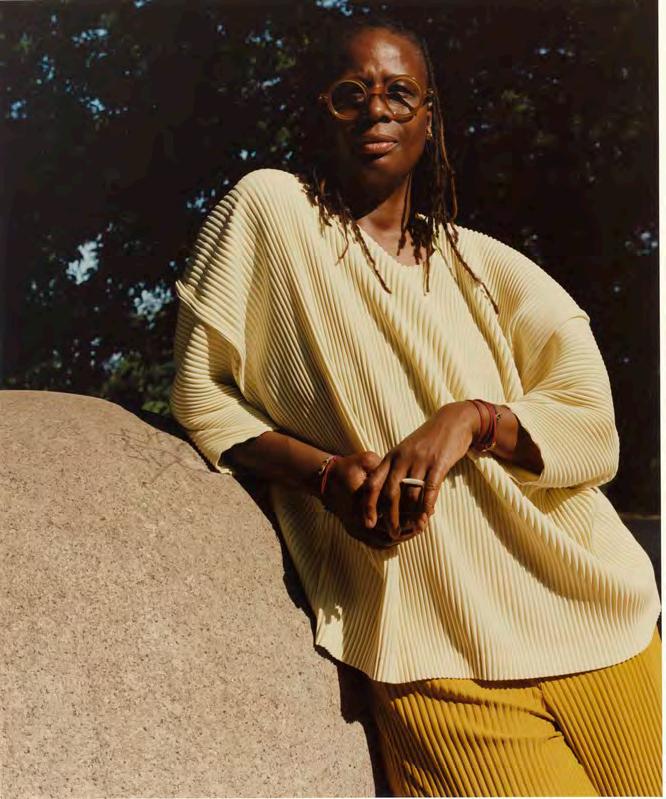

THOMAS Incredible. This should be implemented as a model to use in other urban places. I’m so happy you are doing this, and I’m inspired by you. Watching you build this community like many others, such as Titus Kaphar, gives me hope for the residency I want to create. As you know, like yourself, I have been close with Pratt for a long time. After graduate school, I came back and taught there, and I’ve remained in dialogue with the Fine Arts Department Chair, Jane South. I proposed a series of questions for post-graduates, one of them being, “how can we create practices for artists to have better structure and understand the market for themselves?” Through our conversations we co-founded Pratt>FORWARD, a creative ecosystem and mentorship program where artists can have access to something that resembles a post-graduate program by connecting them to curators, artists, mentors, art professionals and business associates. The concept is to enhance artists’ practices by providing career development skills. The idea of Pratt>FORWARD came from me going back to my hometown of Camden, New Jersey, and I’m working with a group of Camdenites to create an established art institution that would be a community-oriented incubator space for people to go to in Camden proper, because there are no contemporary art museums in Camden. Honestly, if it weren’t for me going to after-school museum programs at Newark Museum, I would not be the artist that I am today.
ADAMS That is so important, because you have to think about art in those communities as a learning tool for young people to explore their ideas through art making. As an artist, I can see myself driving my thought process in a way that helps my problem solving; art is beneficial in that way.
THOMAS Art creates the culture. Many people create art when they’re young but may not choose it as a career; in any case, they will always have it as a foundation through which to see the world. There are some schools that teach science and math from a creative perspective. Everyone thinks differently, so if you can teach them to comprehend situations creatively, then they always have an alternative to the more formal or traditional aspects of life. My mother needed a break sometimes, too, so sending me to the free after-school activities at the museum was valuable for both of us. She was able to luxuriate in her Black joy and I learned to be creative. Art institutions add value and cultivate culture. A community like Camden, NJ needs more creative spaces that can become centers for Black communities.
ADAMS That is where our power and our platform allows us to do that; to look at other communities that we understand as being valuable, and deserving of attention and care. That is so embedded in our personalities. It’s what bonds us as friends.
Pioneering skateboard filmmaker William Strobeck cut his teeth skating outside Everson Museum of Art in Syracuse and LOVE Park in Philadelphia as a teenager in the '90s. He earned his first gig with Alien Workshop helping film their legendary skate video Photosynthesis (2000), which saw the first appearances of Jason Dill and Anthony van Engelen. His fresh, personal, idiosyncratic style saw its apotheosis with cherry (2014), a debut feature for himself and Supreme, which featured newcomers and legends alike. This year, Strobeck started his own skate brand, Violet, which like his films is a radically progressive and inclusive amalgamation of prodigious talent and subcultural cool. A platform for collaboration in a deeply unstable world. We caught up with Strobeck and his skaters on the streets of New York City.
OLIVER KUPPER I want to talk about skating and how it relates to the chaotic world we're living in right now. Skating is very communal and almost spiritual. What are your insights on this?
WILLIAM STROBECK The only way I can explain it is like, you're an individual in a crew of kids that you decide you want to hang with. I was younger when I found my crew, but there were not a lot of skateboarders in Syracuse, where I grew up, there were probably like fifteen to twenty kids that skated. It wasn’t really an East Coast thing yet, but for some reason, it just clicked with certain people. It was an outcast thing. We would hear about skateboarders down at the Everson Museum of Art. It was a destination. Luckily for me, I had a mother that would pretty much let me do anything I wanted. I hardly even knew how to skate, but I was this little dude, and they were excited because it was like some little brother type shit. I was looking up to these heads. But with skaters, once you find another head to hang out with, that's who you want to roll with. It's like, “Oh, you skateboard. I skateboard. Let's go skate.” Back in the early ‘90s, these were the only people you had.
KUPPER In the early ‘90s, it still felt like an underground subculture that was slowly moving its way to New York.
STROBECK It 100% was. On the East Coast, you would get in a fight with somebody at your school because you were trying to do something different and you looked different. Skaters are tough, but I was cool with everyone, because I was just such a weird outcast. I was running size 42 waist pants, bleached hair, and three times baggy shirts. I just looked like an early '90s skater in a town where the football players were the cool kids. I'd be in class looking through Thrashermagazine and Trans World, all that stuff in my hand at school. Like, this is my world.
KUPPER It’s interesting that skateboarding is so athletic, but it’s a sport that attracts outcasts.
STROBECK It’s because you can be whoever you want in it. You got one chance at life—like, are you gonna be a follower or are you gonna be a leader? Do you want to be who you are without getting judged? New York is a huge thing for that. You can literally be whoever you
want. Dating back to the ‘60s with the Warhol crew— these were people being exactly who they wanted to be. And Warhol pulled half those people in. If you want to walk down the street in high heels and a wig, you got it. There's no problem.
KUPPER Once skateboarding came to New York in the ‘90s, it feels like the city transformed the skateboarding world.
STROBECK There was skateboarding here for a while before Kids (1995) came out. There were some old school heads, like Harry Jumonji and Andy Kessler. But it didn’t get big on the East Coast until Kids came out. I saw it in the theater where I grew up. I was just like, man,there'salotofotherpeopleouttherelikeus doingwhatwe'redoinginoursmalltown.Thisshould happeneverywhere.
KUPPER Before you came to New York, you went to Philadelphia?
STROBECK I was in Philly for seven years. And then I moved to New York. I had friends here—a couple kids from Philly that I was filming. So that was one of the reasons why I moved here. And then, I moved in with some kids that I grew up with skating, people I considered family. And then, I met a lot of kids outside of skating, like graffiti writers and artists. In New York, with the skating nightlife here, you get to meet so many people, which I loved because I just wanted to learn. I’m a people person. I just wanted to learn about everyone and know everything.
KUPPER Going back a little bit, you mentioned that your mom gave you a lot of freedom. What was she like? What was your experience growing up in Syracuse and having that much freedom?
STROBECK My mother hooked up with this dude, got pregnant, and then she didn't really tell him. It was a weird, wild situation. So, I was an only child and I never had a father around my whole life. I lived with my mother and my grandmother, and my mother was schizophrenic. So, when I was born, she got really sick and wasn't emotionally around, which affected me a lot. Luckily, I did have a pretty good support system with my aunt, and uncle, and my grandmother. But for the first six years, my mother was going back and forth. They didn't
have the right medicine at the time for schizophrenics. I acted out at times, but I was a jokester—I still am— and that’s probably how I dealt with these situations. Apparently, my father was a goofy dude. But when my mother finally got the right medication, there was a part of her that felt guilty about her absence, and she just started smothering me with love. I actually ended up being annoyed with her because I was a teenager and that’s when you turn on your folks for some reason. But she would just drop me off in the city with friends and I would stay out there for like three days. Once I got involved with those kids, there was no turning back. They were my big brothers. They wouldn’t let anyone fuck with me. But my mother was a big part of letting me do the things that I wanted. Now, I take care of her. I’d do anything for her. She's my rock.
KUPPER It seems like a lot of skaters find family in their crews.
STROBECK 100%. But there's a part of me that had to break away from them in order to do what I wanted professionally. I couldn't bring all of them along. I found my niche in filming when I moved to Philadelphia and I’ve tried to include them when it fits, but I was going on skate trips with teams and stuff. I couldn't bring them along. When I came home, I would kick it with them.
KUPPER When did you first start filming and did you always know you wanted to be a filmmaker?
STROBECK My grandmother got me a camera for Christmas, so I was filming the kids that I grew up with, but when I moved to Philly, I decided to start documenting. Once I started doing that, some of the pros were like, “Yo, will you film this trick real quick?” I was hanging out at LOVE Park in Philly, which is where all the skaters would hang out. Then, I ended up acquiring a nicer camera because my girlfriend helped me out. I didn’t have any money, but I realized I could actually do this. A year later, I was filming for Alien Workshop. They called me up and said, “We’re working on this video [Photosynthesis] for another two years. Do you want to help?” And then, I was totally immersed in that over everything else in my life. I found my thing.
KUPPER Your skate films are incredibly cinematic. Where did that come from?

STROBECK At that time, they weren't. They were more about skateboarding. I was just filming tricks and handing in the footage. I wish I filmed more personality stuff at that time, like I did later. But I wasn't even thinking like that then. And I wasn’t shooting digitally. I had 60-minute miniDV tapes. When you recorded it, that was it. I was pretty specific with what I filmed. Now, I can film a thousand tries, and I can erase things. Back then, you couldn't. You might get maybe three tricks on tape, but I was involved with the best skate company at the time. I was so psyched. Around that time when I got the job, they had just hired this dude, Joe Castrucci, who was from Ohio, and he was very visual and really pushed the Alien Workshop brand to be more image based. I was in the right place at the right time.
KUPPER So, did the more personality-based filming style start with Supreme?
STROBECK The personality stuff was there when I was putting stuff on YouTube. That’s where I started to get more of a following. I started doing stuff by myself and wanted to make it look more like what I imagined skateboarding should be. That’s when people started hitting me up. I also started to get my own confidence. So, when I was approached by Supreme, I had a lot of ideas that had been brewing for a full-length video. cherry (2014) was my first full-length skate video and Supreme’s. During filming, we came across all these kids that were hanging out at the shop. I felt like these kids are the soul of skating and this is what skateboard videos are for. I needed people to see who these kids are. It's like when you find a group of friends. It was way more important than just like, here's some tricks. I just fell in love with what skateboarding is. And when you mix those kids with Dylan Rieder, Alex Olson, Jason Dill, and Mark Gonzales, there’s no way to lose.
KUPPER We should talk about Violet, because everything seems like it has led up to your brand Violet.
STROBECK During the filming of this last bit for Supreme, I met some really great skaters. I realized that some of them don’t have sponsorship, so I thought why not start something. I just felt like it was a really special crew, and they just looked like the word ‘violet’ to me. There are an array of energies and styles that can fit under that name. It's tough, but also feminine too. And that's how I want the company to look. We got a lot of really different things coming out that's hopefully going to be a little more outside of what everyone else is doing. But with the crew—their opinions really matter a lot. I ask them every time I do something like, “Should we do this?” Or “What do you think?” It’s not an easy task to do something like this. You have to love what you’re doing. And I'm doing it because I want to promote these kids and give them a cool skateboard company, so that they can do all the other cool stuff that they are doing.
KUPPER Where did the initial idea come from?
STROBECK Around 2021, everyone was working just to keep skateboarding going, and I felt like something new needed to happen. That was what was in my heart, but I’ve never just ordered a couple hundred skateboards before. It's just like, oh, what do I do? So, I talked to a lot of people in the industry. When we had an ad come out and we wheatpasted around town, that's when I was like, ohwe'rereallydoingit. I had to convince myself that I'm really doing it too. It was like a daydream. I'm used to making videos, and films, and photography, and not having to think too much after that. Now, there's another responsibility. But the kids are just enjoying being their age. I present them with the boards, see if they like 'em, and then they escape into the city, and the rest is history.

KUPPER What were some of the recent collaborations you worked on?
STROBECK We did this series of handmade artist hoodies. A total of fifty. Twenty-five were made by New York-based artist Atticus Torre, and the other twentyfive by Philly-based Keith DeBottis. The things that
were done on them took a lot of work, but it paid off, because it looks great visually.
KUPPER Where do you see Violet in a few years?
STROBECK Well, I hope to do a video in the next few years—just for Violet. And I’d like to keep doing outof-the-box stuff, and veer away from what everyone else is doing. We already work for Supreme, which is like the dopest streetwear company. So, I think we can do something just as interesting. I mean, I got ideas up the yin-yang, you know what I'm saying? So, even with the next video, we're gonna see something new that no one has seen before. I get bored with doing the same thing over and over again.
KUPPER You have to keep pushing the culture forward—it can’t stay this one stagnant thing.
STROBECK Violet is not at a point where everyone has taken it seriously, because they just don't know what it is yet. It’s low key and that's what I like about it. It feels like it did when I was skateboarding as a kid—it's our little circle and we can do what we want. I was like, “If we can do this, this is how I wanna start the brand.” Some of the skaters don't care about the glamorous stuff and the magazines. They're like, “Dude, I just want to skate.” But then, some of the kids are like, “No, I want to do more like that.”
KUPPER And that’s what’s great about some skate brands—they can actually push the culture forward in an interesting way.
STROBECK You know, when James [Jebbia] started Supreme, he wanted his shop to feel like an art gallery. The boards are a certain way. The clothing is on the rack in a certain way. It was clean in a cool way. And the kids that were surrounding it made it strong. It was all about the energy of the skaters hanging out there. Throughout the years, Supreme has stuck to its guns. There's still a crew of heads there that make sure that it's gonna be right.
KUPPER Violet is so interesting because it feels like a really fresh platform and you seem to know exactly what direction you want to take. And the skaters are so interesting.
STROBECK I needed something that feels more personal. I have done stuff for other brands. I mean, I'm working on a video right now that I'm putting my brain and balls into. So, having that other thing makes me feel a little more wholesome. I love these kids and I want to see what happens with them in the next few years. They are really special, so I want to be able to capture that and show everyone who they are. At the same time, they are doing what they want to do. A lot of people nowadays can do what they want and you can’t stop that. You have to roll with the punches. But these skaters are all really unlike skaters from the '90s. They're all really polite and nice. In the '90s, everyone was a dick. You can't be a dick anymore, man.
Hopefully I’m still in God’s hands. Shoutouts?
#FreeJunior, #FreeNaz, #PeaceJoy and Love forever and ever Amen.
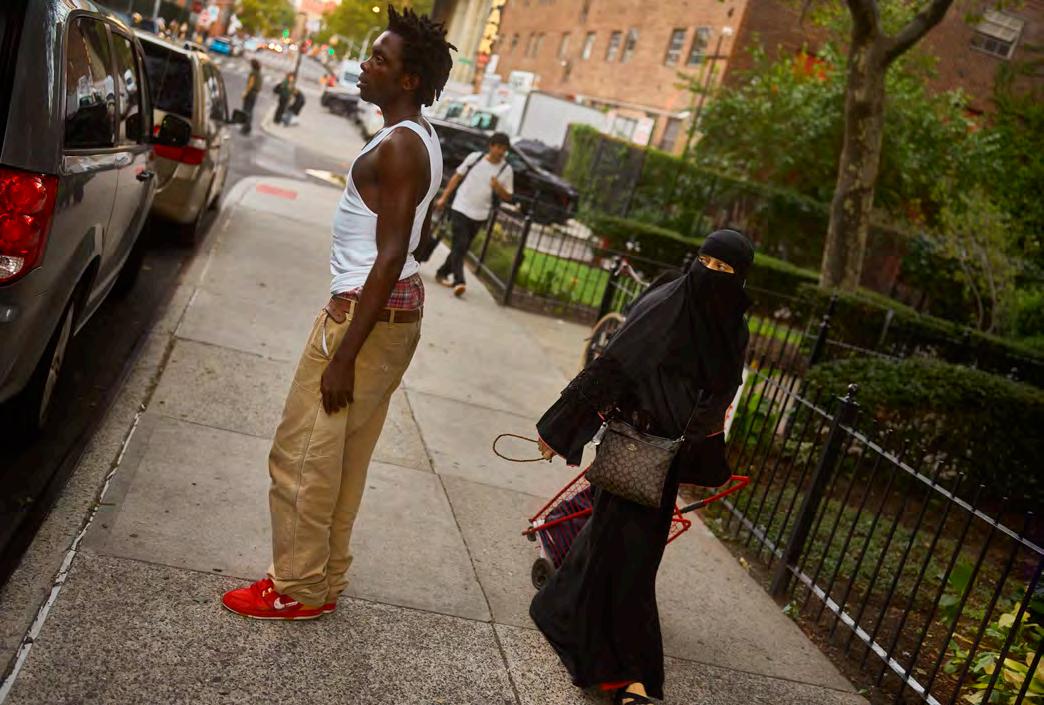
to express myself is constantly changing though. As of lately, I’ve been into creating with sound. What does the future look like to you? That’s always a difficult question to answer, right?
and the ground feels good. What are your interests outside of skating? I make art. I guess it would all fall under the genre of “conceptual art?” I’m not sure…The format in which I’m trying
Where did you grow up? Simi Valley, CA. First trick? Hmm…maybe a “rock to fakie” on a two foot quarter pipe. Favorite place to skate? Hollywood Blvd. It’s cool looking over there,
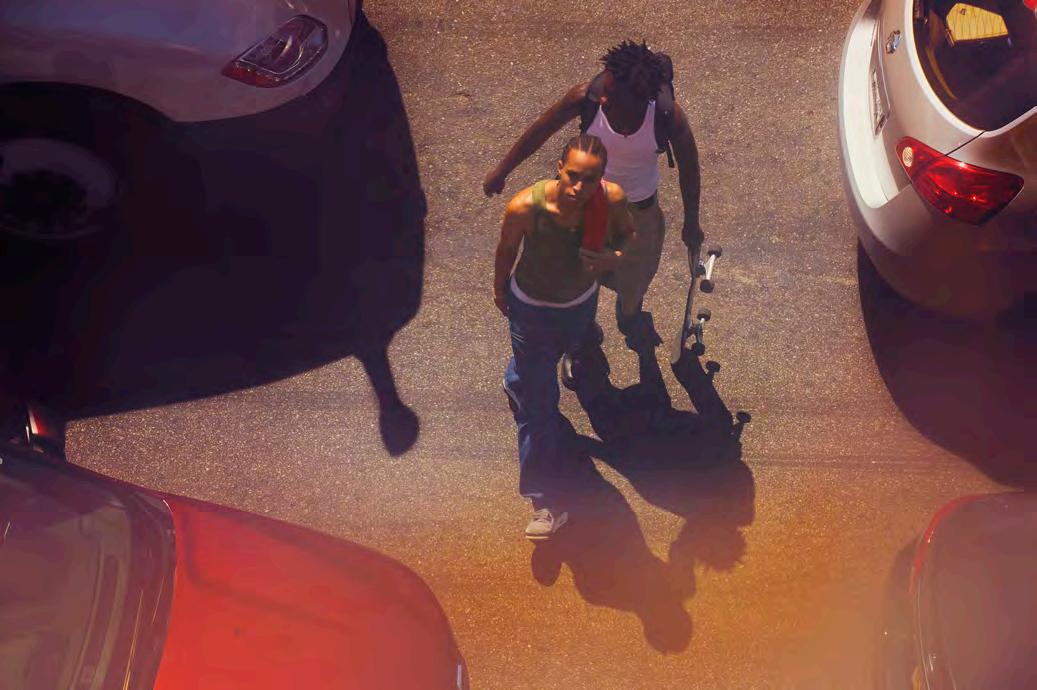
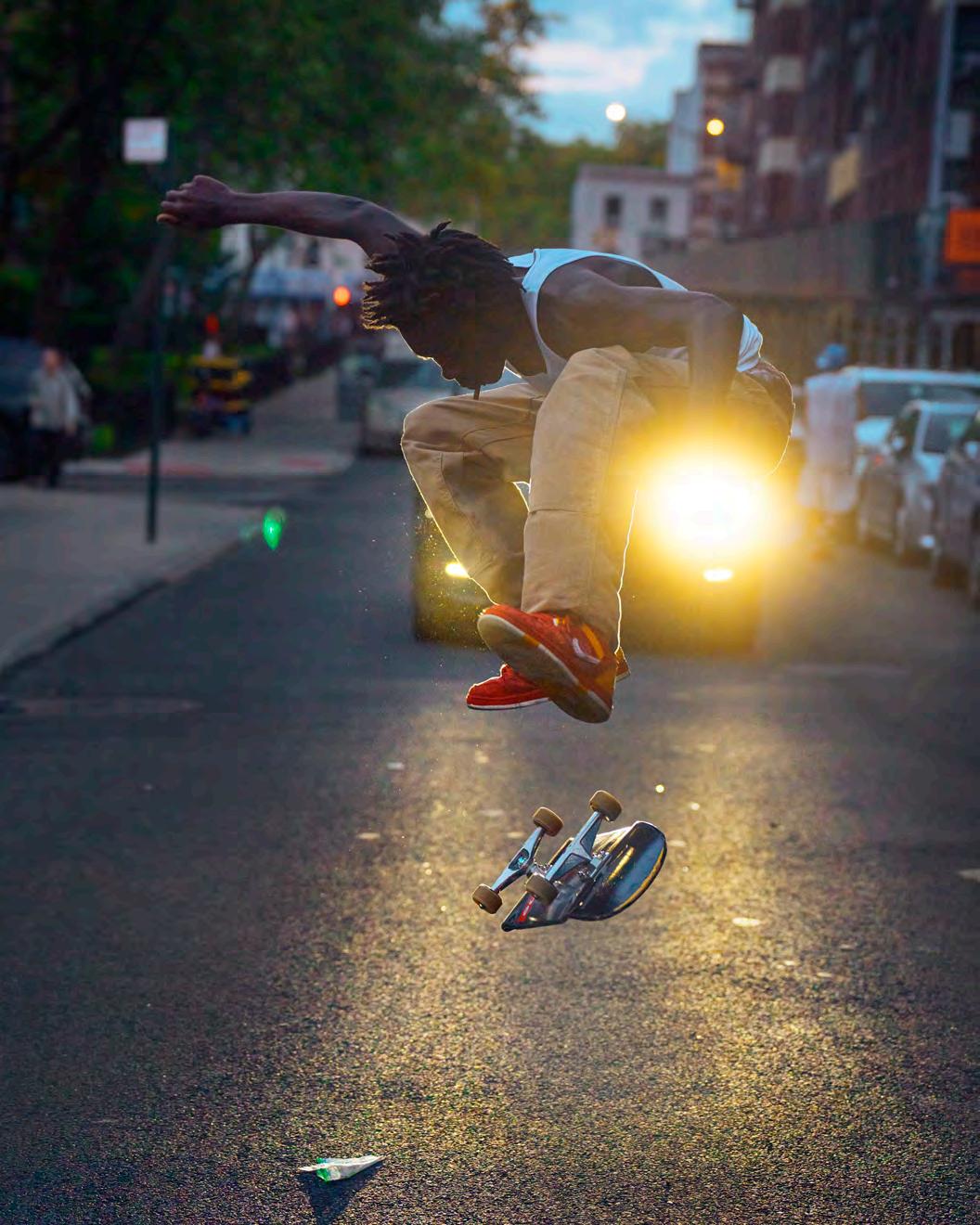
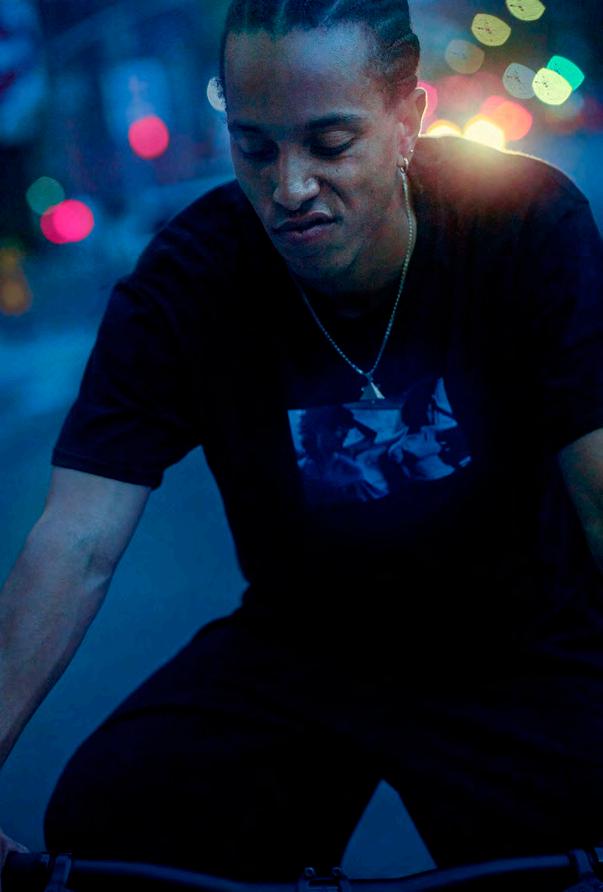

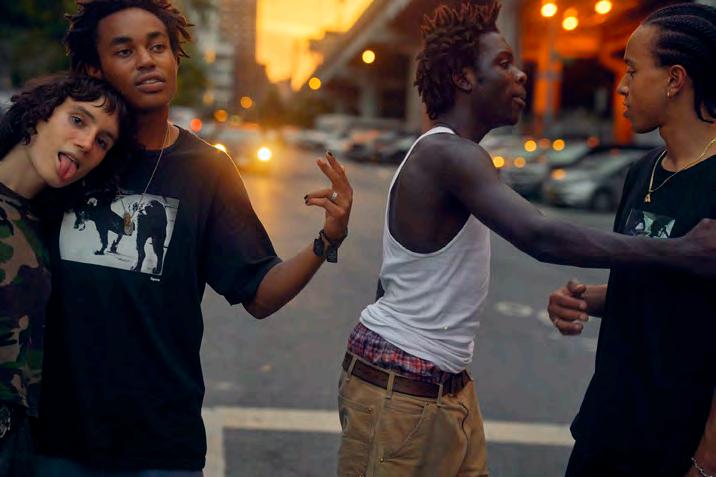


EFRON DANZIG (23) What does your name mean? My name means songbird. Where did you grow up? Back and forth between NYC and Philly. Where is your favorite place to skate? Tompkins. If you asked me a few months ago, I would’ve said Muni. What are your interests outside of skating? I like to make art, music, clothes, write, take photos. Idk, I just like trying new things, so a bunch of hobbies have stuck with me over the years. What does the future look like to you? The future of Earth? It will be here for a long long time, but humans are on the way out. There’s a beautiful camaraderie that develops between people in what feels like the beginning of the end.

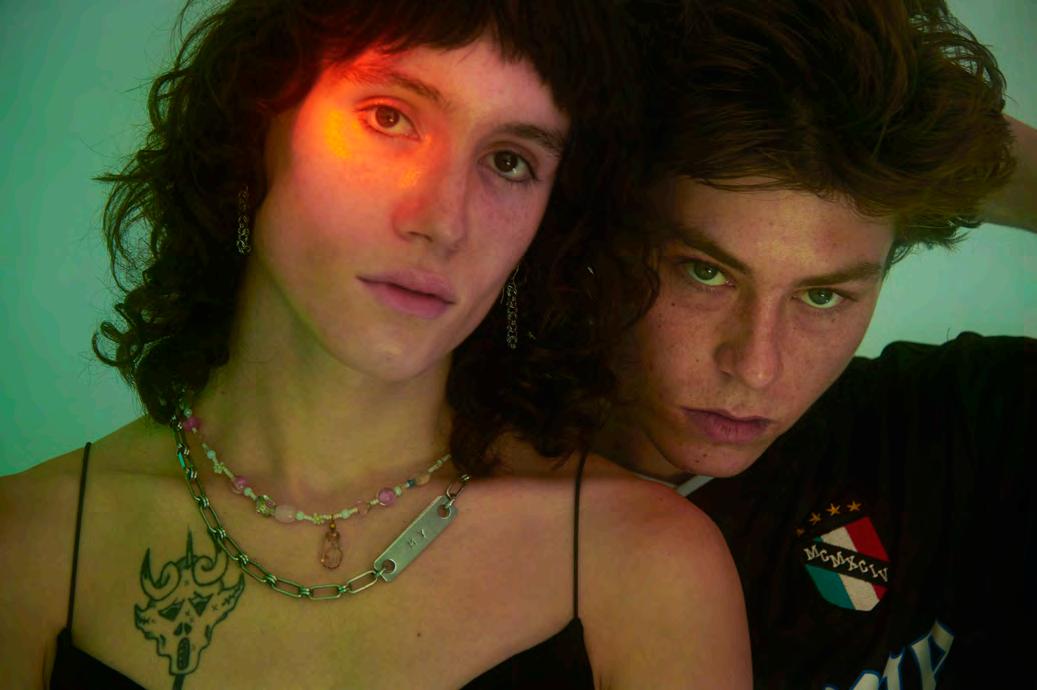
PATRICK O’MARA (19) Where did you grow up? Los Angeles. Where is your favorite place to skate? Valley Skate Park in Burbank. What does the future look like to you? Spending time with friends/family, whatever interests me in that moment. I'm excited for the future and to go to new places do new things.

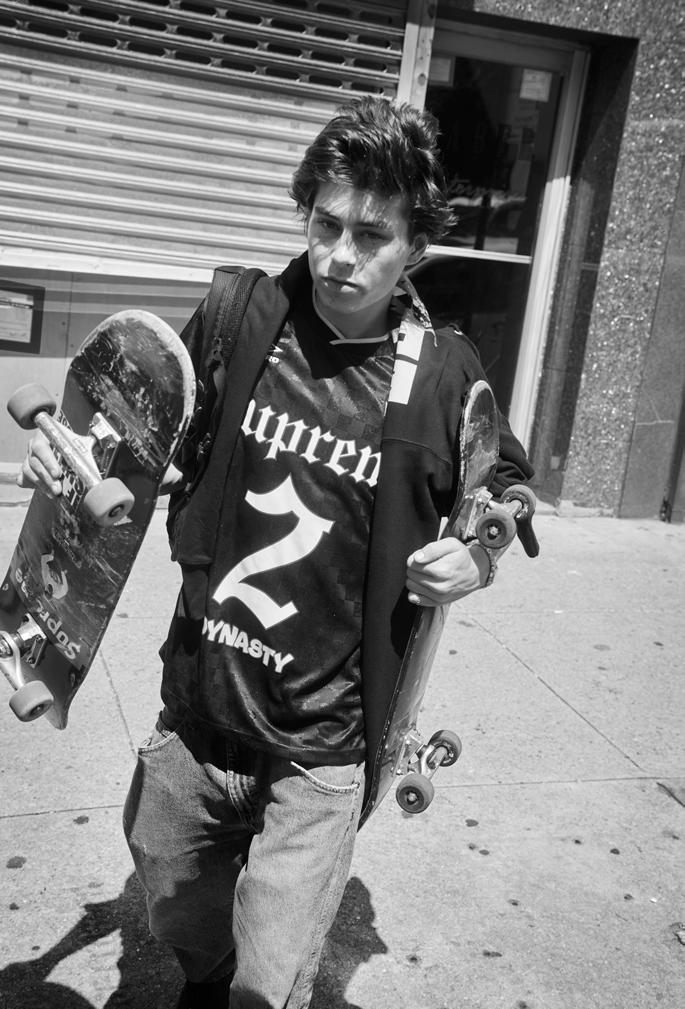

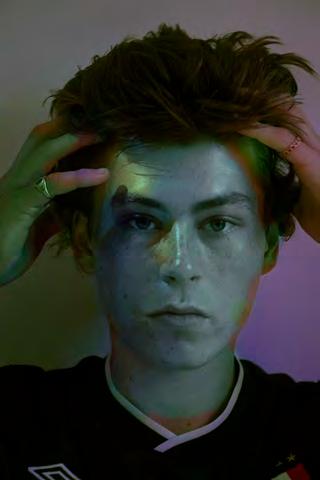

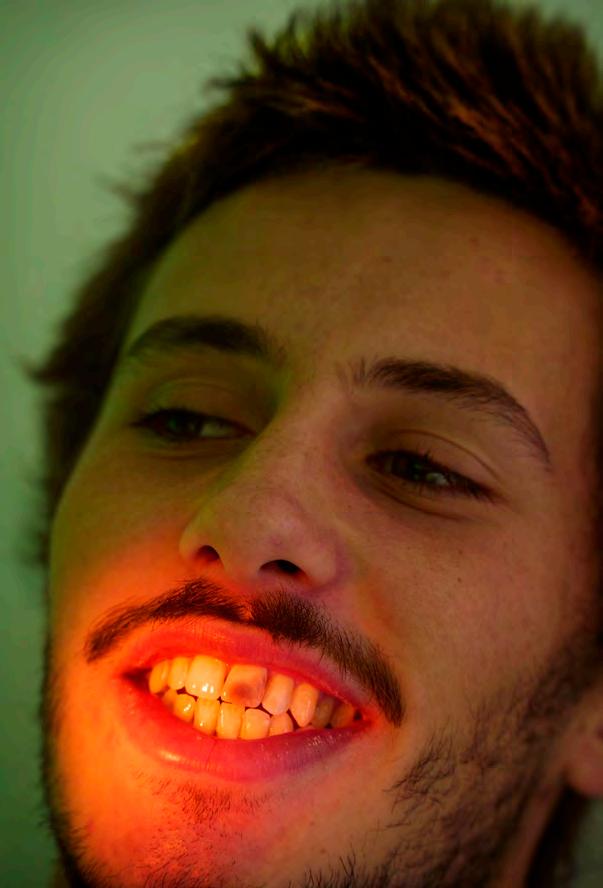
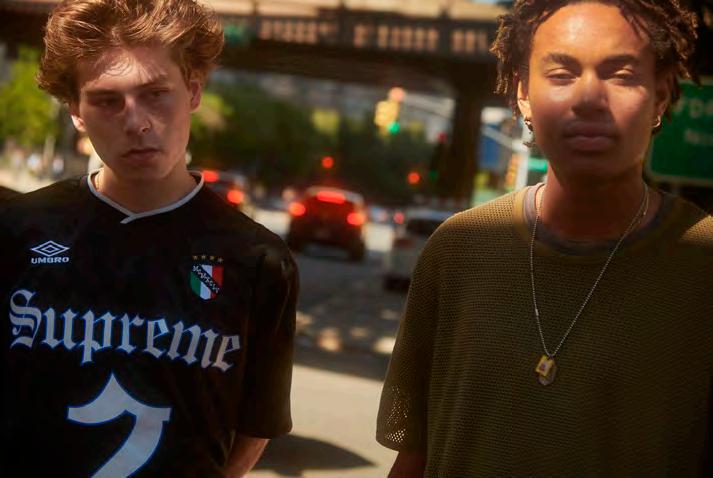
grew
skate?
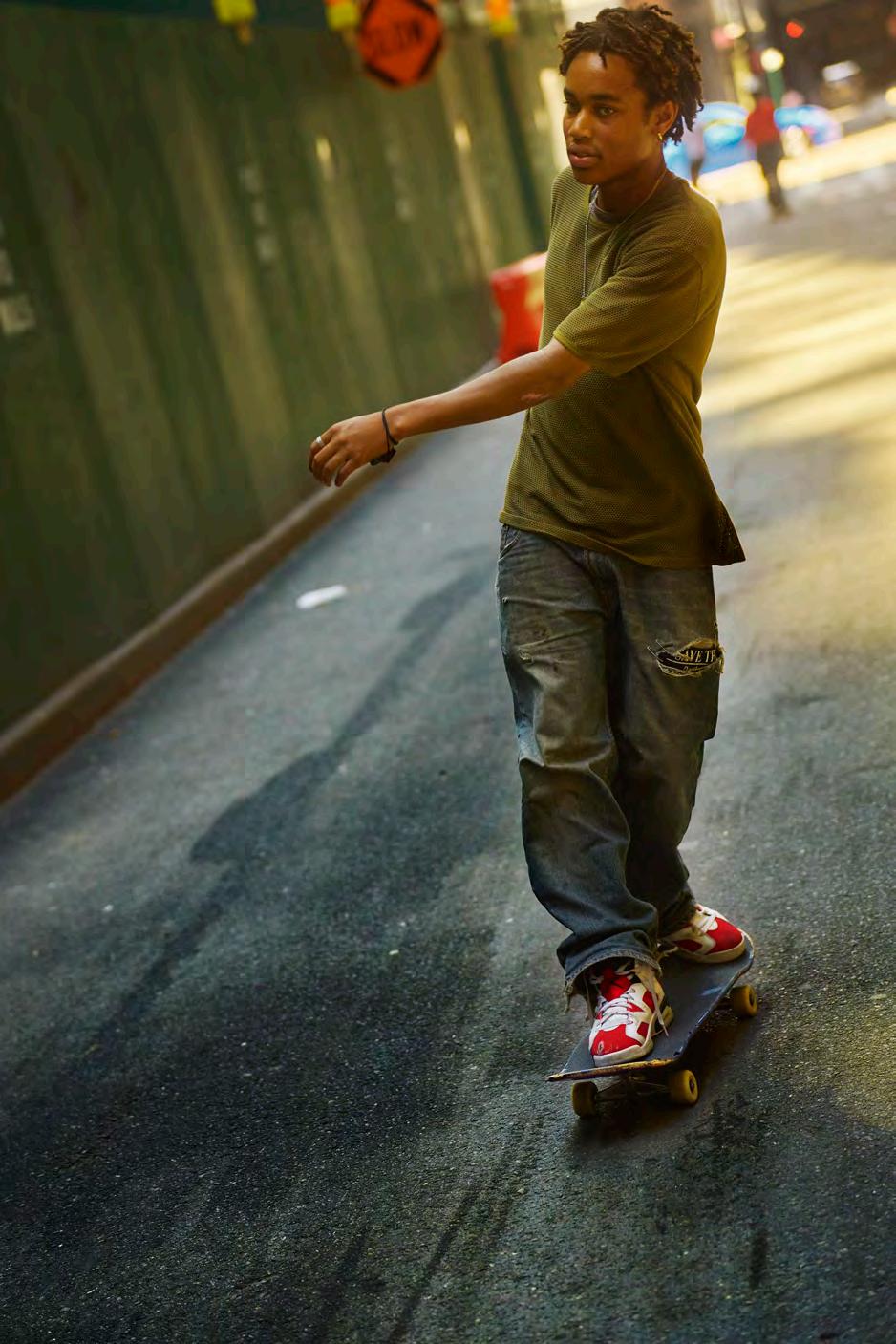
What
Lake in Seattle has
interests
of
like making
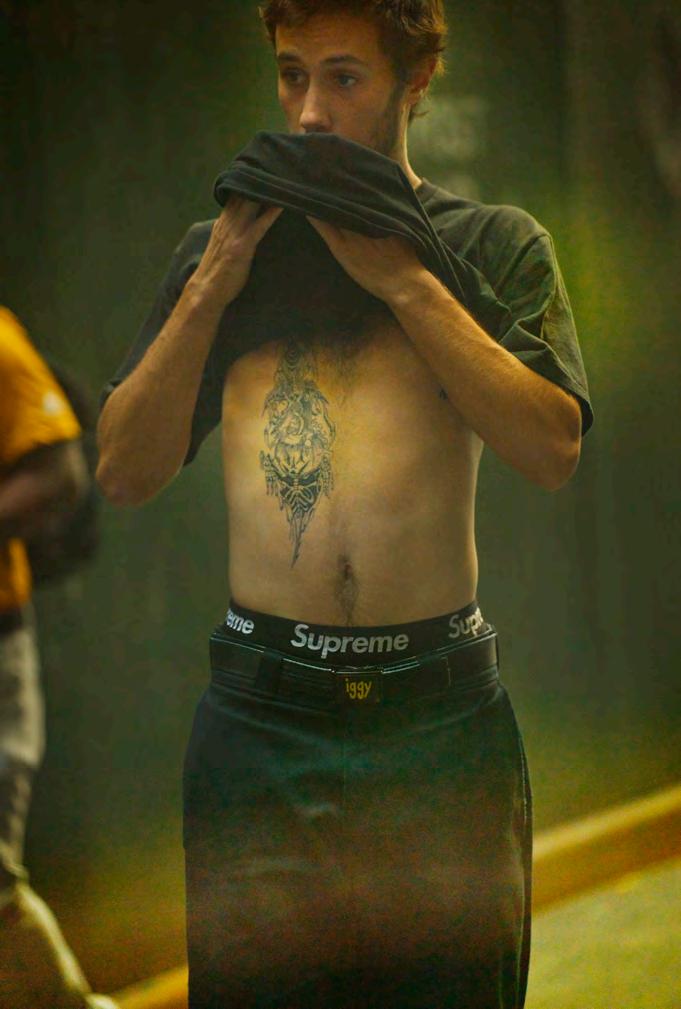
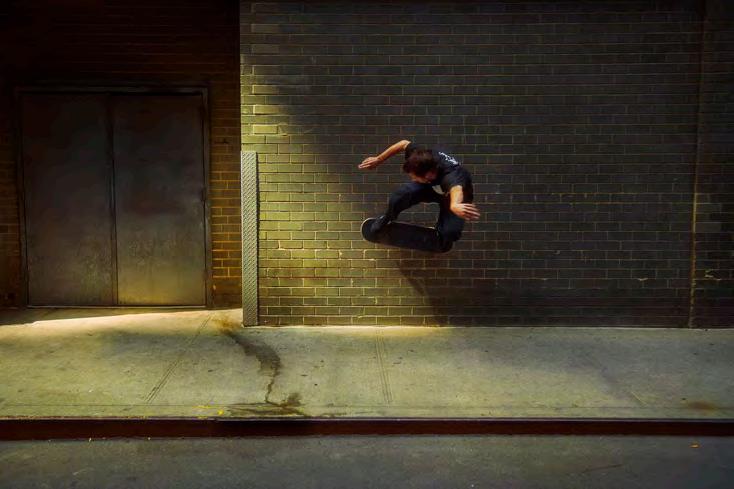
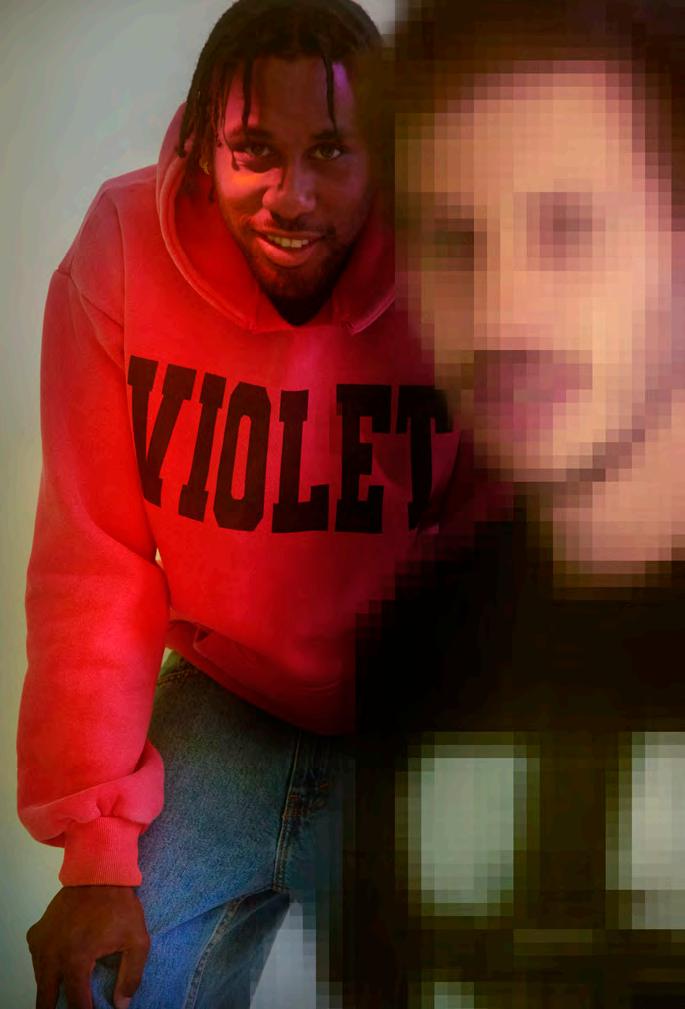
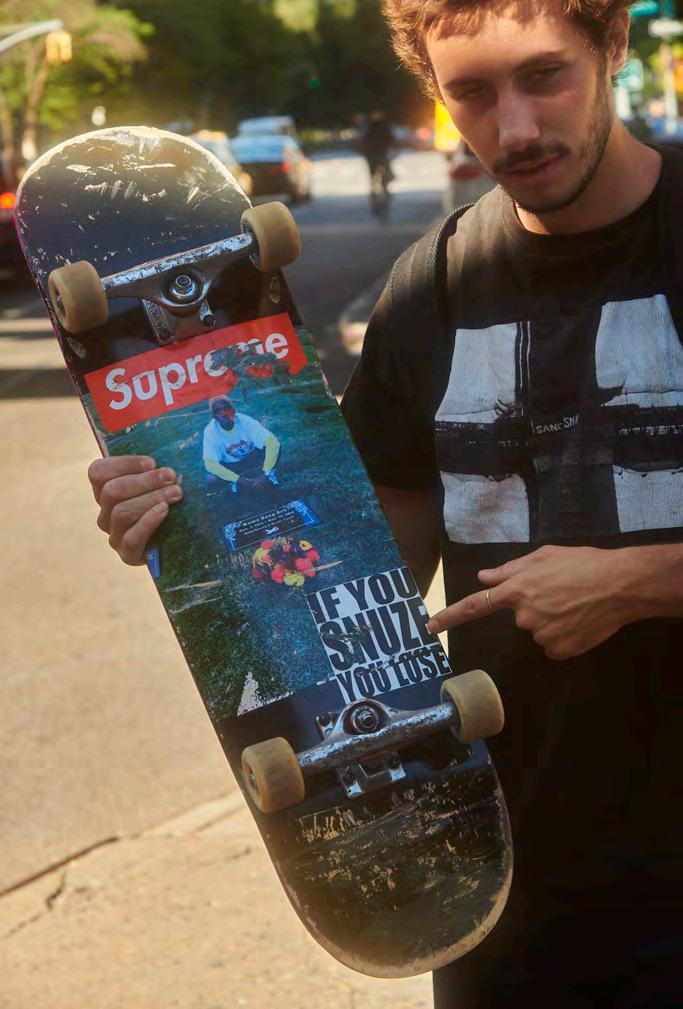

grow

think
learned how to kickflip at ten years old. It was on a fake Walmart board in my cousin’s basement, haha. Favorite place to skate? The Municipal building in Philly. What are your interests outside skating? I’m into boxing and video games. Although, I haven’t done much of either lately. What does the future look like to you? Just looking forward to growth and more skating and traveling.
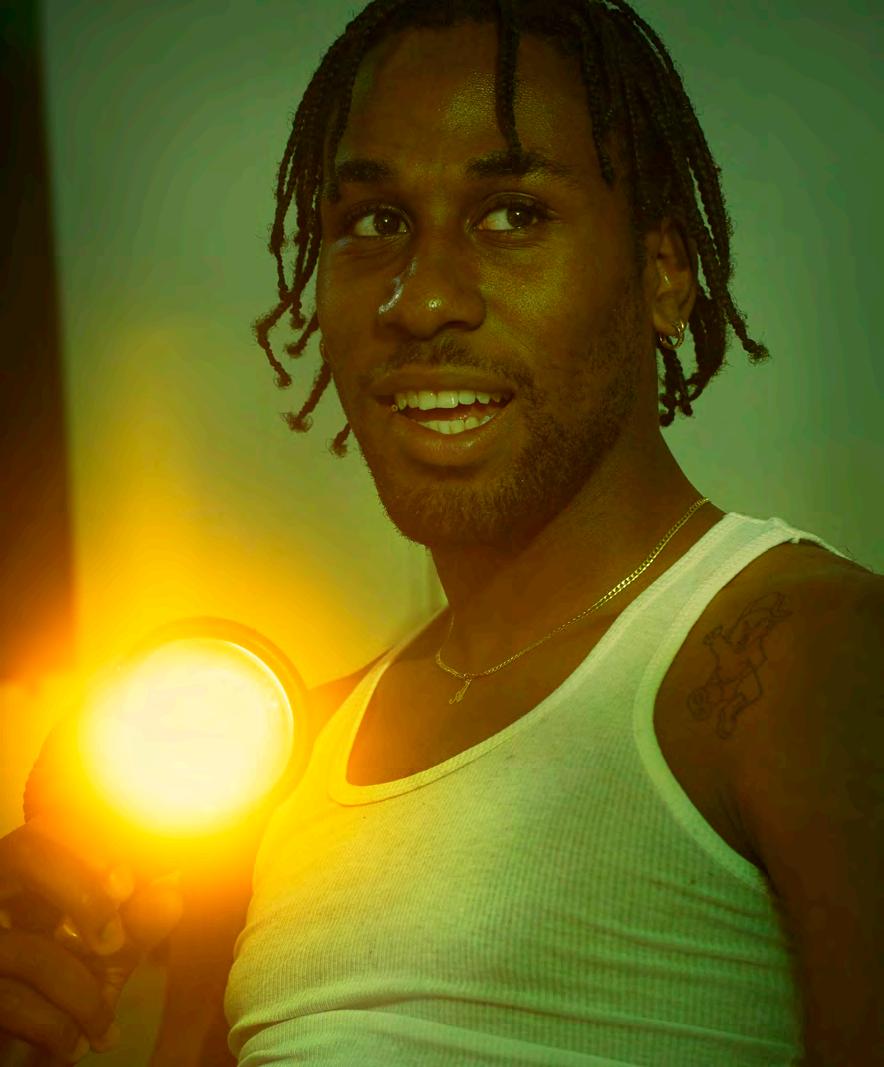

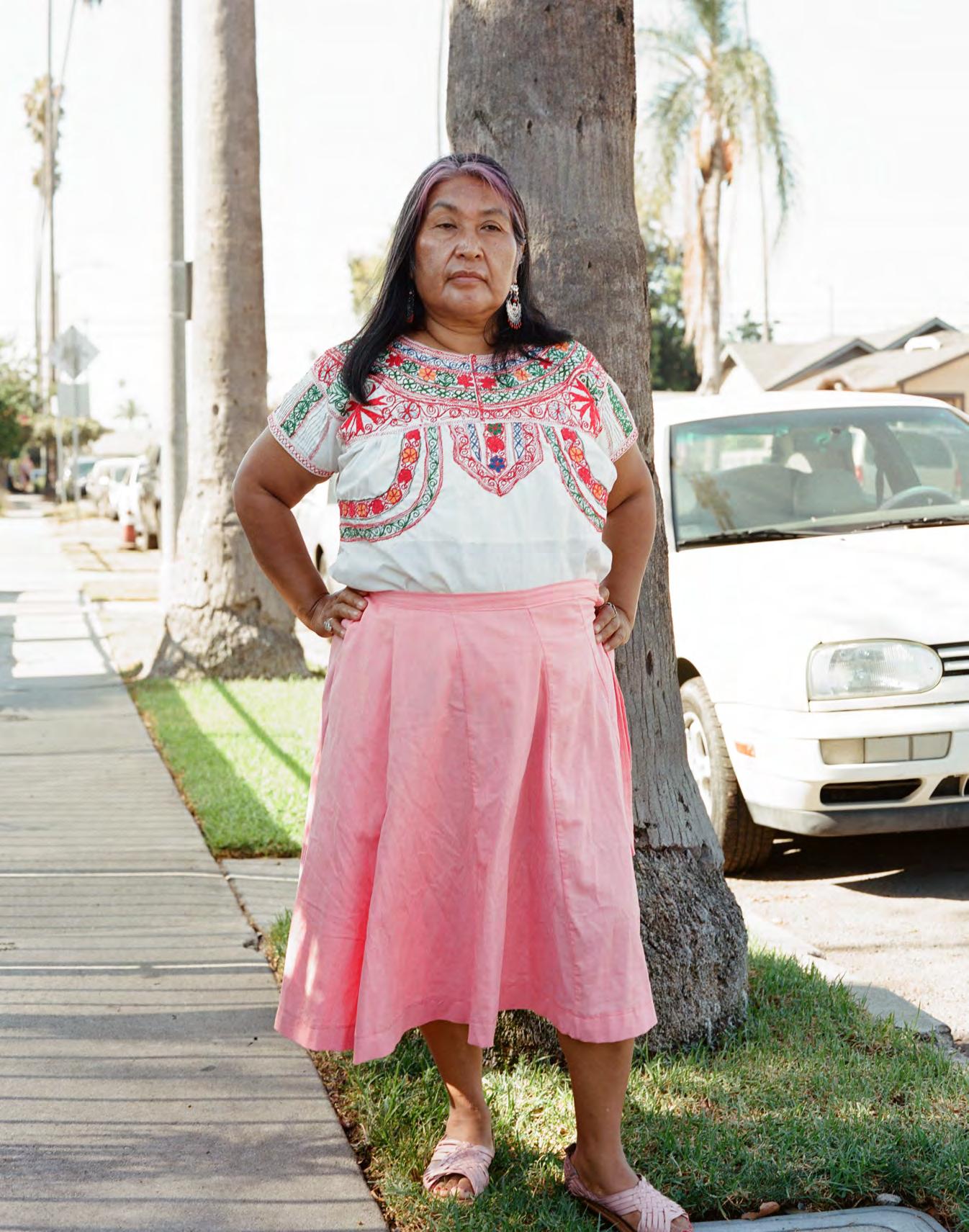
Odilia Romero is the matriarch of CIELO [Comunidades Indigenas en Liderazgo], a womenled, family-run nonprofit providing critical aid to the displaced Indigenous populations of Los Angeles. I sat down to speak with her just one day after the tragic incident in San Antonio, Texas this summer, where few survivors were found amongst the fifty-three dead in and around the trailer of an abandoned 18-wheeler. Trapped inside the vehicle, enduring temperatures that exceeded 100°F without air conditioning, food or water, these adults and children from Mexico, Guatemala, and Honduras were discovered nearly 140 miles from the border. A trail of bodies was found along the road leading up to the truck, suggesting that some were able to escape before their untimely deaths, and it is still unknown how many managed to survive. It is during crises like these that CIELO steps in to provide interpreters and legal counsel for those who are routinely displaced by the dehumanizing will of the free market and then denied the right to asylum. Across Mexico and Central America, communities that were once safe and selfsustaining have been ravaged by extractive corporate land management for the past century, but the problem was accelerated exponentially by the North American Free Trade Agreement of 1994 and the Dominican Republic–Central America Free Trade Agreement [CAFTA] of 2004. As we enter the mid-term elections, what we refer to as the ‘immigration crisis’ once again takes center stage with migrants being used as pawns in dehumanizing political stunts. As voters and consumers implicated in this unyielding catastrophe, it behooves us to listen to elders like Romero on the origins of what should be referred to as the displacement crisis, the lifethreatening repercussions of language violence, and the fallacy of the American Dream.
SUMMER BOWIE As a child, what was it like growing up in the Zapotec community of Zoogocho?
ODILIA ROMERO I grew up in the Northern mountains of the state of Oaxaca. All I knew until the age of ten is the mountains. I used to live next to a river that no longer exists where there was a lot of bamboo and coffee. And actually, my last name in Zapotec is Yego, which means the people of the river. My grandparents grew coffee for their own consumption. You were very careful with water, because it was hard work to get it up from the top of the mountain and carry it in this red clay vase. And you used to go wash your clothes at the river or at your home. When we were kids here in the US, my dad would limit your time to two minutes of shower and you would use a bucket. But back home, we already knew that water was something that you grab with the sacredness of food. You only grab what you need to eat because it was a communal process. Everything in proportion to what your body actually needs.
SB I read that when you were a child, the population of your Zoogocho community was about two thousand, and now it's under a hundred. Is that true?
OR Yeah, it was never a big population, and now probably less than one hundred people that were born in the community. Most of us are now in the United States, but we have two boarding schools. And because we have the huge Thursday markets that starts on Wednesdays, that gives life to the town.
SB How old were you when your parents immigrated to Los Angeles? Because I know they left before you, and then they sent for you.
OR I was quite young. That's a topic that we never talk about (laughs) 'cause it's very triggering for all of us. So, I don't remember at what age they left, but I do remember the age that they sent for me was ten.
SB Do you remember your journey to the United States?
OR You know, I assumed that there were mountains all over. Like there's your parents behind the mountains.
The city of Oaxaca was the first stop, I'm sure, because there is no other way. I don't recall it. And then, we stopped in Mexico City, and that's very clear in my mind because they cut my hair for the first time. They're like, "We're gonna give you some bangs, so you look less Indian." At the time I did not know what it meant. Now you're like, "Oh, due to the racism and discrimination, they wanted me to avoid being noticeable or different.”
I don't remember how we got to Tijuana. I don't know if we flew or took the bus, but I do remember my aunt leaving me there with an unknown woman. Luckily, she was from the community and spoke my variant of Zapotec. That gave me a lot of comfort because I was able to communicate with her and she told me, "Hey, you're gonna meet your parents in a few hours. You're gonna get on the bus and pretend like you're sleeping."
So, I said, "Okay," and that was done. Now, there's thousands of children who are the first to migrate without a person who speaks their language and then they get detained. No one speaks their language. So, the big difference was that she spoke my language.
SB How did you navigate the Los Angeles school system?
OR (laughs) You know, there was an assumption that I was Latina or Mexican. At that time, they had a bilingual program, and since I didn't understand Spanish, they sent me to an all-English class, which I didn't understand. So, they kept on passing me. To this day—thank god for audiobooks, because that saves me a lot of time. If I need to read a book, an article, I always do it through Speechify. That has been super useful because I'm able to think, and I'm able to analyze
stuff. But when I do read a book, it takes me two or three months to fully comprehend it. So, the effect of people not knowing I spoke another language impacts me today at fifty-one. Now, I have a writing coach, so I'll dictate my thoughts, and I will write it, but then she edits the punctuation and the grammar that I never learned. I can speak the language, but I clearly can't write.
SB Where did you go to high school and what did you do afterwards?
OR I went to Belmont [Senior High School] for one year, but then I really fell behind and dropped out. Then, I worked at a sewing factory with my mom. I know what it is to be in the sewing factory, in the restaurant industry, to be a bank teller, because I've done all these jobs. I got married as a teen and had a daughter.
SB And how did you initially begin your activist work for the Indigenous community?
OR My parents had a restaurant where I was working and there was a community member that came in. He was like, "You're always up to something and doing stuff at the restaurant." We had exhibits for Indigenous people, we had them bringing poetry, and he was like, "You should join this organization." I began to really get involved in the binational movement advocating for Indigenous people, but I also began to name things. I didn't know the words 'discrimination', or 'institutional racism.’ I experienced them, but I didn't have a name for them.
SB Of course, giving you bangs so that you look less Indigenous was the beginning of that erasure, but how could a child understand what that is? Was that the FIOB [Frente Indígena de Organizaciones Binacionales] that you worked with at that point?
OR Yeah, which is an amazing organization whose work is so essential for us to exist in California.
A lot of US-born, Indigenous kids from the Oaxacan community are going to university, which has a lot to do with the work of the FIOB and the politicization of our cause.
SB You spoke at Cornell, Elmira College and SUNY Cortland on behalf of FIOB in your “Tales from the trenches: [Developing and defending Indigenous identities, rights and cultural practices through community organizing”] series.
OR I did. It was a great opportunity to share the struggles of Indigneous peoples, the root cause of migration/displacement of Indigenous peoples, but also the resistance and resilience of Indigenous migrant people in the United States. How we reorganize to support each other. Within that organization, I held the highest position as a non-Mixteco woman, because it's mainly a Mixteco organization. So, to be elected as
SB The map is such an amazing tool because it shows you just how many people from each Indigenous group live within each neighborhood of Los Angeles.
OR It's precisely in response to the lack of data of our existence, the lack of recognition of our existence as Indigenous people. People think that the Zapotecs existed, but they don't think that we exist today. This is the danger of Latinidad. Everybody thinks we're Latinos and I always say, “Latinidad is deadly” because it kills our existence. It refuses to accept that we exist, that we are here, that we're speaking our language, that we're resisting, that we're fighting for our lands, that we're fighting for the water, and protecting the water. It's very problematic because when we don't exist in numbers, then there's no services for us. There's no language rights, and language is the basis of our humanity. If we don't exist, then we don't have any rights.
not come to help Indigenous peasants in Mexico. It actually has increased the migration of Indigenous people, the displacement and criminalization of Indigenous people. It’s the same thing with CAFTA in Central America. It didn't help. We have the largest migration of Indigenous Q’eqchi’s and Indigenous K'iche' from Guatemala. So, the free trade agreements have been a tool for displacement, for criminalization, and for poverty.
NAFTA gives American and Canadian companies access to our natural resources. It benefits transnational corporations that send their businesses to Mexico. And then, it criminalizes the poor, working, Indigenous people who are displaced as they attempt to cross the imposed border.
SB We have a major problem with cognitive dissonance in this country when it comes to our perceptions on immigration. The Republicans are always claiming that the immigrants are causing violent problems and putting a strain on our economy. And the Democrats may dismiss these claims by focusing on their contribution to the economy, but they all fall short of acknowledging the violence and the economic strain that American industry has created abroad, which is what drives immigration in the first place. Why would anyone want to leave a home that they call heaven?
the binational leader was historic. It came with a lot of gender dynamics, but it was accomplished. Eventually, I left because I wanted to focus on creating a structure for CIELO. At the FIOB you're a volunteer, so everything you do for the movement comes out of pocket, and after twenty years you realize it's unsustainable. I was talking to a gentleman the other day who I offered a job in CIELO, and he's like, “I want nothing to do with the nonprofit world, with the social movements—all I want is stability. I want to know that I'm gonna get a paycheck every two weeks, that I'm gonna pay my bills, that I'm not gonna run late on my credit cards, on my car payment, on my rent. That's all I want.”
SB Sure. Who could reasonably expect to feel up for challenging the system when they're not afforded the basic necessities of survival? You challenge the idea of the odds being stacked against you, though. CIELO is a women-led, Indigenous, nonprofit organization, and most of your staff are women. Why is this such an important part of the work that you do?
OR It's important because women are not given these spaces in any society, not only Indigenous people, but from journalists to the food industry, it's usually men. We always have to do double, triple the work in order to assert ourselves. Even if I ask someone, “Hey, can I have that paper?” And it comes out in a stressful tone, people take offense to it. That's why I wanted to create an Indigenous organization with my daughter, Janet [Martinez], who is the co-founder. It was the importance of creating a space for women to support women, and allow women to take the lead. Out of the sixteen of us, there's only four men. And they're challenging as it is.
SB (laughs). Zapotec refers to the ‘cloud people’ and CIELO means ‘sky’ or ‘heaven’ in Spanish. Is that a coincidence?
OR No, everything's very intentional at CIELO. Where I'm from, when you wake up, it's very cloudy and foggy. We always say, “this is the heaven.” And then, the logo looks like a star, but it's actually the four directions, the four pillars of the universe. The circle symbolizes the universe and water of course. Water is life
SB Wikipedia refers to the Zapotec civilization as existing from 700 BCE to 1521 CE. Why is it so difficult and problematic when internationally accessible databases fail to recognize existing communities?
OR (laughs) Well, that is our struggle. I don't know if you saw our map, it's called “We are here.” The discourse is always they existed, they were, they lived, and no talk about us existing today. No one wants to accept that we are here.
SB In lieu of government support, Pre-Columbian communities rely on the development of strong networks to provide a safety net in times of crisis. Can you talk about this concept of ‘guelaguetza’ and why it's so important?
OR It's a way of living for Indigenous people. I wrote this really pessimistic story where we're all about to die. And my friend was like, “Odilia, you know, five hundred years ago they must have done the same thing when they were being assassinated.” When they were being imposed upon by a religion. They put bodies all over the Sierra to make sure we converted, but it's the community that came through with their organizing. The nation-states are never gonna come and rescue us. In the end, humanity needs to think about how we support each other. And that is the guelaguetza. How do we support each other when Oaxaca has an earthquake, or a flood, or a hurricane? It is not the government that comes to our aid. It is the communities that organize the sale of tamales, the sale of water and chocolate to survive. Here, like in times of COVID, it was reinforced that the only people that are gonna save us is ourselves.
There was a lot of trade. Poncho, my husband, is a chef and he cooks a lot of traditional food. They were like, “Hey Poncho, let me exchange blood sausage for avocados. Let me exchange cheese for bread or for eggs.” That is what the guelaguetza is. Now they call it a mutual aid society. When people think guelaguetza, they think about the festival, but it's not the festival. The festival was imposed by the government in 1932 after an earthquake to bring tourists to Oaxaca, but the action of it is different. It's about the transparency. When somebody passes away, we go house by house to collect money for the family, and at the viewing and funeral, we stand by the door where people can see us to donate. We write down the names and then say, “Hey, you know Odilia donated $5, Janet donated $10”, so that by the end, after the burial, you give it to the family.
“We have collected $5,000, $10,000”, whatever it is, because the record of your contribution is how you get the money back. That's the guelaguetza support system.
SB How were communities like yours in Oaxaca impacted once NAFTA went into effect in 1994?
OR Oh, well, NAFTA was quite painful. It takes me a while to even talk about NAFTA because that's when most in my community actually left. A lot of people from the Highlands of Oaxaca started leaving because we couldn't compete with the changes of NAFTA and that has a direct impact to this day. Now, NAFTA has another name, but the free trade agreement did
OR Why would I want to leave a place I call heaven, next to a river, full of mountains and birds? A place where I know everybody and everybody speaks my language so that I can die in a trailer in San Antonio!? No one is in pursuit of an American dream. It's about having access to healthcare, to education, to a job, to a roof over your head. That is a human right. Not an American dream. With politicians, it doesn't matter if it's the left, the right, the center, Indigenous people are not important to none of them. Through history it has been shown over and over. We're not important to them. In the case of San Antonio, people don't want to see that there was a war in Guatemala and we had a lot to do with it as the United States. It was over a corporation, Chiquita Banana, that this war started, and it's this same US corporation [United Fruit Company] that continues to have its impact today. The US companies, the Canadian companies—they're the same in Arizona as they are in the Amazon, as they are in Guatemala, or in Africa. And there's the palm oil companies that are pushing Indigenous people out, there's multinationals from all over the world, which are from Spain, Spain never left. But now, there is a fourth war, which is the mining companies. In the case of Oaxaca, over two hundred mining concessions to multinational companies have been given, so that's gonna cause more migration. We're talking about water, we're talking about land, we're talking about displacement. It doesn't matter who's in power because the power is in the hands of the transnational corporations.
SB Many people are familiar with the traumatic impacts of separating families at the border, but many don't know how Indigenous families are often separated even after they've crossed the border due to their lack of access to interpreters. What are some of the more common ways that these issues occur?
OR Family separation has more than five hundred years of history and it continues to happen today. In the case of this ongoing colonization, it's the children that are detained. Many of 'em don't come alone. They come with parents. But it's purposely done. If the child doesn't speak the language, the chances of reunifying with their family are very slim, and they end up in foster care with other family members. Mom and dad get deported immediately while the child is detained. Once you are released, they give you a bunch of documents that say you have a court hearing, but if you don't know how to read and write, you're probably not going to show up to the court hearing. If you don't know where to get an attorney or that you have a right to an interpreter, then most likely you're not gonna show up. And then you become undocumented and you lose your status or your possibilities of getting asylum or a refugee status.
"No one is in pursuit of an American dream. It's about having access to healthcare, to education, to a job, to a roof over your head. That is a human right. Not an American dream."
Guatemalan Languages:
(Can-ho-ball)
Mexican Languages:
That's why I always say language is the basis of our human rights. Without language you don't know that you have to register your kids to school. You don't know that you have to get a medical exam before you show up to court, and all the requirements that come within that package, you don't fulfill them. And then, you become deportable again. It's a very violent process. After the detention center, they go through a lot of language violence. Once you are released, you have to go to school, you have to follow up on your document. But if you don't know, and there's an assumption that you're Latino, Mexican, or Guatemalan, then it's really hard for you to have your human rights respected.
SB There's the story of Cirila Baltazar Cruz, an Indigenous woman living in Mississippi who was pregnant and didn't buy baby bottles or a crib because she planned to breastfeed and share her bed with her baby, and they deported her because they thought she was a sex worker.

OR Cirila went through multiple levels of institutional language violence. At the hospital, her interpreter refused to acknowledge that she did not speak Spanish, she spoke Chatino. It’s one of the sixteen Indigenous language families spoken in Oaxaca. So, due to Cirila's broken Spanish, the interpreter made the assumption that she was exchanging sex with her roommates. But in reality, she was living with people from her community. So, the child was removed and given into adoption for a year while Cirila got deported. Luckily they reunified, but imagine losing a year of your baby's life.
SB Not having a lawyer makes every difference in the world as well. How else would you know that they're looking for you to say specific things, like “My life is in danger and that's why I'm seeking asylum.” Something so obvious feels like it goes without saying, but if they don't say those exact words, then they don't get their refugee status.
Contact number

que aldea
(What town
Como se llama
(What town
OR We go back to the power of words, and how language is the basis of your human rights. Language is a fundamental human right. That's the importance of training the interpreters. Because you have to know how to say things. And if you borrow from Spanish or English, then the person is not understanding. There was a woman that called me and she was like, “Mixteco” and I don't speak Mixteco but we monitor the most recent migrations. So I'm like, “Okay, Guerrero?” And she's like, “Sí, Guerrero.” So, then I know she's Mixteco from Guerrero—let's try this interpreter. Immediately they understood each other and she's like, “They killed my parents, my grandparents and all my siblings, but I was able to run.” And I asked, “Why did they kill them?” She's like, “Over land.” And I say, "What's on that land?” She says, “Water.” And these are the questions to ask. Instead they ask, “Did you migrate for a better life?” And people are like, “Well, yeah.” And then they lose their opportunity for asylum. Mexicans have very slim chances of getting asylum in the US. There's a book called We Build A Wall [How the US Keeps Out Asylum Seekers from Mexico, Central America and Beyond] (2018) that explains in detail the process of how Mexicans lose their right to asylum. Getting asylum is rare. This woman has to prove that there was a reason they killed her entire family and that she was running for her life.
SB Do recipients of CIELO's aid ever become staff members themselves?
OR Yes, they do. Especially when they speak an Indigenous language, we train them. A lot of the staff worked in factories. Some were once children that had been detained, and now they have their status, or they have their asylum that are working at CIELO.
SB It's such a generative process where resources are constantly being exchanged, rather than extracted.
OR Yes. For example, the case of Alba, she has her work permit, now she's a trained interpreter, and all the judges are asking for her nationwide because she's a woman and most of the interpreting roles have been by men. She's one of the first trained Indigenous
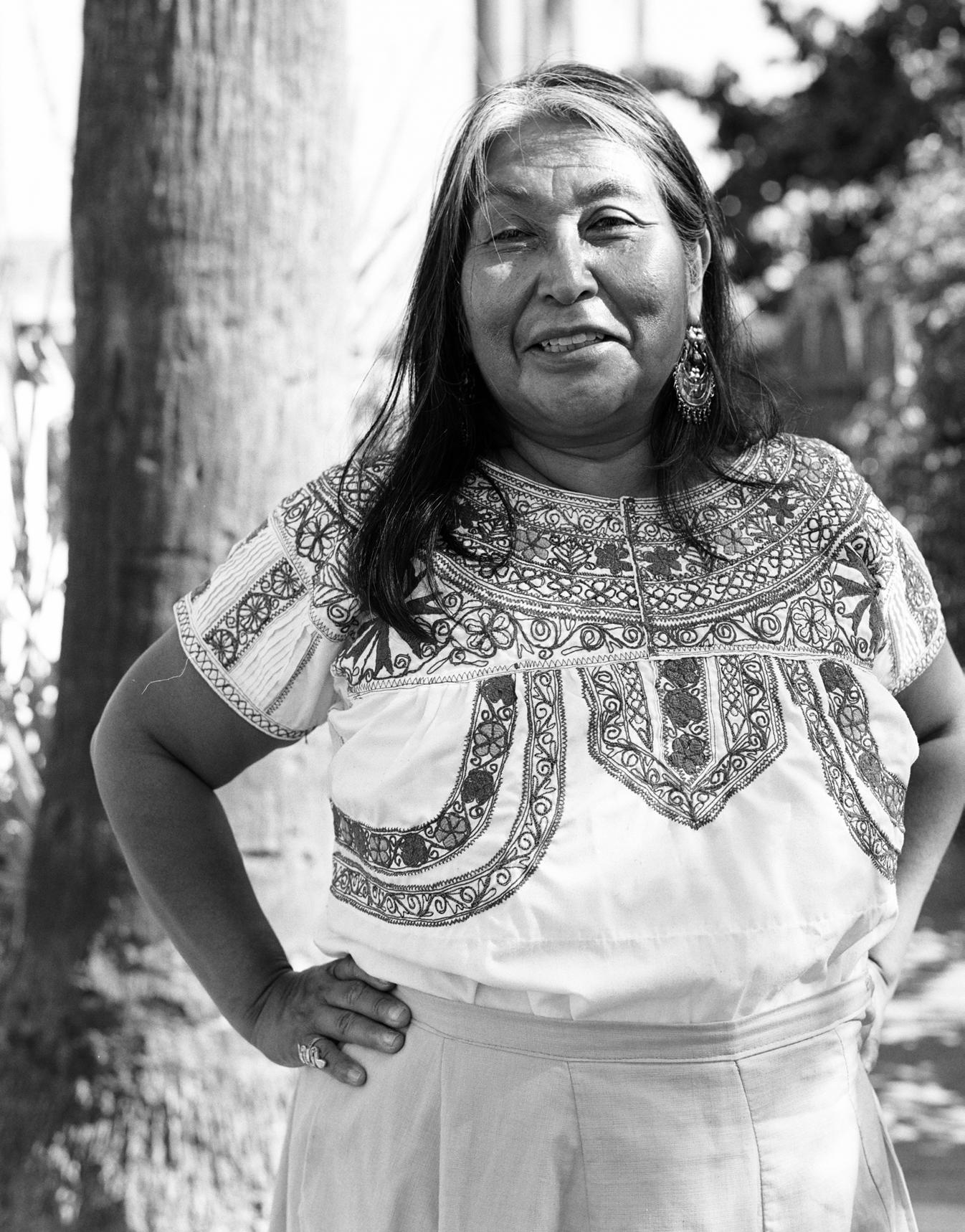
K'iche' women to go to courts. And Alba has gone back to the detention center to interpret for children, has interpreted for murders, rapes, really intense stuff. I used to be an interpreter for medical, and it's so heavy to tell someone things like, “Your child's gonna die and they have ten days.” But I cannot imagine what it is to interpret multiple cases of sexual violence in a month.
SB After surviving acts of violence, sexual or otherwise, committed by men, I’m sure anyone would feel much safer recounting those events to a woman.
OR Absolutely, after a violent event committed by a man, the victim would feel safer with a female interpreter. And that's why we are very intentional in making sure that these interpreters are trained and also have therapy. We have a circle of therapy every two weeks with all our interpreters. It's so important to get rid of that intense energy, because there's second hand trauma and your brain doesn't distinguish between if it's you or another person. So, we have a therapy circle. We make sure the fridge is full of snacks, things from the garden. We make sure we buy them food once a week because it's important to acknowledge the amazing work, but also we need to support everyone to heal, recuperate, and go for the next case.
SB Can you talk about the work that CIELO is doing with the LAPD to ensure that they are doing their best to protect and serve Indigenous communities in Los Angeles?
OR The LAPD (laughs). You know, it's been an exciting experience. Actually the assistant chief, Al Labrada, was just at our office last night—we’ve known him a while. When we initially met, he was a sergeant and there had been a shooting of a Mayan man. And at the beginning, it was really rough because the officers would walk away from us. They would roll their eyes. It was quite intense. The relationship has not been perfect, but it has gotten better to the point that they're now carrying language cards. We started with the Rampart Station to carry these language cards and they read it to the detainees or to the victims. They were using it quite often. And now, they've ordered them for the whole 10,000 officers, and they arrived the day before yesterday. So, he came to drop some off, and also to share the experience with other law enforcement institutions that were here yesterday to find out how the card works, and how we can partner. Because they're encountering more and more Indigenous people, but it took the killing of Manuel Jamines for us to have this conversation. My community has been here for the last sixty years and we're talking like ten years in a relationship with LAPD. The other fifty, they didn't know about our existence or understand the language diversity. Now that they know, they're calling a lot.
SB What kind of information is included on the card?
OR You have things like, “Do you speak K'iche'?” We use five main Mayan languages, four Mexican Indigenous languages, and Spanish. And there’s a phone number to access Cielo interpreters.
SB America was founded on the principle that its people should not be subject to taxation without representation. How is it that we failed to live up to this principle nearly 250 years later?
OR (laughs) Well, that's very interesting, right? Migrants, undocumented and displaced people pay billions of dollars. Undocumented, yet there’s no representation.
SB We say 'undocumented workers' but many of them have an ITIN that they use to report their annual earnings and pay taxes, but it doesn't qualify as a work authorization, there’s no right to vote, and they don't have access to the public benefits and services that are provided for American citizens. Not to mention what they contribute to sales tax. How is that possible?
OR The criminalization of people and the narrative is important. In the media we're portrayed by politicians like, “They just come and take.” But nobody ever talks about what we contribute economically. A Zapotec
businessman was here yesterday and he's like, “How is it possible that we're treated this way when I pay a million dollars of my income to California in taxes?” (laughs) But it's a narrative. They don't talk about how the people who work with a ITIN will never be able to get their social security. They'll never be able to get Medicare or MediCal, but they contribute a lot, in multiple ways.
SB And our economy would collapse without that labor.
OR Our economy would collapse without migrants and without undocumented migrants. The whole point is to keep us undocumented so that we won't have rights and we continue paying taxes without representation.
SB Can you talk about the way that the coronavirus pandemic disproportionately affected Indigenous laborers?
OR The coronavirus just brought to light what was already going on with the lack of resources to Indigenous peoples that have been rendered invisible by Latinidad. There was no information in the different Indigenous languages for Covid prevention. There were no resources due to those language barriers for the thousands of Indigenous peoples affected by Covid.
SB They were all left out of the stimulus.
OR No stimulus, no nothing. Not until someone came and donated like $5,000. Then, we had somebody else and it became $25,000. And then, there was an article written in the LA Times about how someone knocked on the door and said, “Hey, can you guys handle $200,000?” We were like, “Uh, we will learn how to handle it.” Until finally, that fund got to $2.3 million. At one point it was all the family, like Janet was printing the checks, I was putting the addresses, the kids were sealing the envelopes, because there was no infrastructure money. It was pass through money. People were in the hospital with no interpretation. People had no funeral money. People didn't have a place to quarantine. People were sleeping in their cars to protect their families and prevent further infection.
SB Sleeping in their cars in 100° weather. And these funds are being used to pay rent, buy food, go to the hospital; they're stimulating our economy in a time of crisis.
OR We raised $2.3 million, which is a lot of money, but it wasn't nearly enough to meet the needs of the community. We raised an additional $1.8 million in grocery cards through LA County, totaling more than $4 million. Most of the cash solidarity based on what we heard from the community, went to the rent. So, we basically bailed out the landlords.
SB Who were not respecting the rent moratorium.
OR Yes. So we bailed out the landlords and LA county had us do a survey in exchange for the grocery cards with questions like, “Are you eating less?” At first I was very uncomfortable with it. But then, when you hear people say, “I'm eating less,” or “I have lost my house and now I live with another family. So, we share a pizza for the kids and the rest of us just eat beans.” It feels important for us to know what’s happening, so that we can serve the community according to their needs.
SB Capital and Main, a nonprofit publication reported that Los Angeles has the second highest population of Native Alaskans and Native Americans in the country. A number that would be even higher, if not for the fact that Indigenous communities from Mexico and Central America are undercounted and considered simply Latino. Why is it so difficult for us to recognize these communities?
OR I think it's intentional. I mean, everybody loves Oaxaca, right? Everybody loves the mezcal, the clothing, the culture, but they don't love us. When it comes to our rights, nobody talks about the 200-plus mining concessions. Nobody talks about the femicide that happens in Oaxaca. You know, talking about the Guelaguetza.
There is an activist woman named María Elena Ríos Ortíz who is a saxophonist from the Mixteco region, and a powerful politician attacked
her with acid. So, during the Guelaguetza this year she went out with a big banner that said, “Oaxaca is a femicide state” [Oaxaca Feminicida]. And the police immediately escorted her out. But nobody talks about that. What about the people? If you like our stuff, you would know that we exist, otherwise who produces it? But you are not wanting to recognize our humanity and our indigeneity is what I'm getting when you love everything but us.
SB A lot of foreign enterprises are participating in Oaxaca's coveted mezcal market in very extractive ways, but you collaborate frequently with Yola Mezcal. How are they different.
OR My experience with Yola has been very positive as an Indigenous person. They're always supporting the work, making donations, they conserve the agave sustainably, they're careful with the water, they're women-led and they support women mezcaleras. For me, that's important—women supporting women. And of course, Yola is Oaxacan.
SB Are there any ways that the US Census could be modified to correct a lot of these problems of erasure?
OR It's been modified in the last twenty years, but I think there needs to be more effort, because now I could check “Mexican” or I could check “other” and then write Zapotec. But you need to be informed that you can do that, because it's a confusing process for someone that doesn't know how to read and write in the language. It's also still hard to say, "I'm Indigenous" because of the racism and discrimination that comes through. People don't want to be singled out.
SB CIELO has organized a concert series called Weaving Words and Rhyme. Can you talk about how gatherings like these enrich and foster pride in these communities?
OR Weaving Words and Rhyme is an amazing, intergenerational small concert series that we have for the community, for the youth. We have traditional music, but also we have hip hop to reach the younger generation. We have food, we have poetry—these are important healing spaces for the community. It's important to see other people thriving in the music industry. The singer's language makes a big difference in a young person's life. When we started with Weaving Words and Rhyme and the literature conference, people thought we were crazy. Like, “Why do you want to learn the language? Why do you want to continue the language?” But now I've talked to people that are naming their children in Zapotec, they're relearning the language, they're teaching the language to their kids now. And that's the ultimate goal for Weaving Words and the literature conference.
SB What exactly is the Indigenous Literature Conference and why is it so important?
OR It has the same purpose for people to embrace their indigeneity. We want to encourage people to say, “Hey, I want to relearn my language.” It's alive, it exists.
SB Is there anything that non-Indigenous Americans can do to make life easier for their Indigenous neighbors? And what can we learn from one another?
OR Don't assume that everybody that looks Brown speaks Spanish. And know that everybody who comes to the United States comes for a reason. And always remember your migration story. This country's 250 years old. Unless you’re Tongva, Chumash, Navajo, Mohawk, et cetera, you have a migration story. Ask yourself why your ancestors left their land. It might help you understand why some people leave their land and take that risk to die in a trailer, like what happened in the San Antonio tragedy. end

Luke Kemp is a research associate at The Centre for the Study of Existential Risk at University of Cambridge. The group's aim is to study and mitigate risks associated with anthropogenic impacts powerful enough to wipe out the human species. A dark new report authored by Kemp and his colleagues, “Climate Endgame: Exploring catastrophic climate change scenarios,” which was released in August 2022, is a dramatic analysis of the dangerously unexplored probability of human extinction due to global heating. They propose a research agenda that includes what they deem the “four horsemen” of the climate endgame: famine and malnutrition, extreme weather, conflict, and vector-borne diseases. The report also examines the prospects of potential “warm wars,” where the nuclear superpowers of the world fight for carbon space and technologies to deflect sunlight. Aiming to guide policymakers through this apocalyptic future, Kemp studies the collapse of past civilizations. According to Kemp, the time for preparation is now.
OLIVER KUPPER What is The Centre for the Study of Existential Risk and what are some of the key objectives?
LUKE KEMP The Centre for the Study of Existential Risk is an organization located under Cambridge University. It was co-founded by Astronomer Royal, Lord Martin Rees; Huw Price, who was formerly a Bertrand Russell Professor of Philosophy at Cambridge; and the co-founder of Skype, Jaan Tallinn. It was initially founded to essentially look at these worst-case scenarios— to study and mitigate the risks that could cause either human extinction, society collapse, or existential risk, as we call it. It was founded back in 2012 and the missions have essentially stayed the same since then, but the actual organization has expanded.
KUPPER Your recent report was on climate endgame scenarios, but you also study a number of endgame potentialities. Obviously, the climate emergency is a primary existential risk, but is climate change your main focus right now?
KEMP I naturally joined to climate change because that's where my background initially was. I attended international climate negotiations for almost a decade. My PhD, as well as all my research, focused on climate policy. I also lectured in climate science and policy back at the Australian National University. So, I've always had a natural inclination to think about this through the lens of climate change. And my report was
partially driven by both a concern that we lack knowledge about these worst-case scenarios and that they are vital for risk management. The way scholars in the field of global catastrophic risk currently talk about and analyze different catastrophic risks, including climate change, is essentially both flawed and limiting. We tend to always think about global risks as these individual hazards, like artificial intelligence, engineered pandemics, climate change, and nuclear war. A risk is actually a combination of your hazard, your vulnerability, and your exposure. A hazard, for instance, would be a meteorite. Your vulnerability is the fact that you don't have the infrastructure in place to either handle it, or to actually stop it. And the exposure is the fact that it's hitting you. I think there's an additional point on top of that, which is how society actually responds to risks. And this is something that the IPCC [Intergovernmental Panel on Climate Change] has recently introduced into their definitions and discussions of risk. A large part of what “Endgame” is trying to do is to actually provide a scientific foundation for talking about catastrophic risks, including climate change. And obviously provide more nuanced definitions of things like existential risk. We frame it along the lines of, what are the extreme risks posed by climate change that could contribute to an overall level of extinction or global catastrophic risk? There’s a world in which we have four degrees of warming and society is both highly equitable,
very cooperative, and we have excellent adaptive technologies. And there's another world in which we have vast levels of inequality, international conflict, and maladaptive responses, which simply can't handle a four-degree warming. So, it's simplistic to be thinking about these different hazards in some kind of weird, abstract space, rather than thinking about the plausible futures. It's a very different, fundamentally radical way of thinking about global catastrophic risk, and we put climate change at the center.
KUPPER It definitely seems like there's a problem of communication when it comes to making these predictions. Has it been an uphill battle?
KEMP It's been surprisingly difficult to simply say, as we do in the article, that there's plausible reasons for concern. They are understudied, and they're really important to understand from a risk management perspective, and here's some ways of doing research on them. I've been surprised that, despite a fairly moderate series of insights, people have often pushed back pretty strongly. And I think there is confusion between saying there's plausible reasons to be concerned about extreme risks and saying they're definitely going to happen. For basically all of our research, as well as coverage, we've been very clear that these could happen. They're plausible. We don't know the exact mechanisms of probabilities. We don't have any predictions here. The entire point of doing this
research is so that if we do have predictions about extreme risks, to stop them from playing out.
KUPPER It seems like a bad bet to place all your money on the best-case scenario.
KEMP I mean, it's something we don't do for risk management in other areas of life. You wouldn't be betting on the best case when it comes to designing cars or airplanes, for instance. Understanding worst-case scenarios is a pretty basic component of doing what's called robust decision making when things are uncertain. When it comes to climate change, we definitely need robust decision making. Apart from that, I think that this is not really about predictions per se. I've always liked the metaphor of Jack Goldstone, a scholar of both revolutions and societal collapse,
a disconnect between their levels of concern about these global risks and who they end up voting for, which is also a relic of our political systems. We don't have people voting on policies, we have people voting on parties. Most of this comes back down to the agents of doom—these power networks, which profit in both power and money from creating public risks.
KUPPER Oil industries have been raking in a staggering $3 billion in profit every single day, for the past fifty years. That kind of power and money can buy any policy or decision to keep the engines running.
KEMP I think it's pretty clear cut that while there are several different contributors to the lack of action on climate change, the primary
power, the public is way too concerned about health risks. And there's pretty good evidence that in general, people can often be too risk averse when it comes to business and the roles they play. Non-disclosure agreements, NDAs, are prolific across corporations. Also, most militaries now have overly profuse abilities to redact and censor material. I think this all comes back to the point that they often benefit from having secrecy because if they didn't, they'd be regulated.
KUPPER In terms of societal collapse, what can we learn about the collapse of previous societies? What are some of the biggest trends in these previous collapses that you've noticed?
where he basically says we shouldn't be talking about crystal balls. Rather than saying, “Here's a particular date for doomsday”, we can say, “Here are all the pressures and stresses that could lead to catastrophes and societal collapse.” And that's more useful because it doesn't distract people with these probabilistic numbers, which can resign people to fatalism.
KUPPER We have known about climate change for over a hundred years and we keep gaining new insight. Why haven’t we done anything about it? Through your research, do you have any insight into why there is this extreme cognitive dissonance?
KEMP I think it's because of power. I had an article published in BBC Future a number of months ago called “Agents of Doom: Who is creating the apocalypse and why.” In it, I put forward the hypothesis, and I think the pretty compelling case, that underpinning most global catastrophic risks are certain networks of power. And these tend to be concentrated networks of economic power, which lack democratic accountability.
Even when you look at the most paradigmatic examples of existential risk, like the creation of the first nuclear weapon. The Manhattan Project is literally now synonymous with the idea of having great secrecy and huge concentrations of both military and economic power. When you look at risks like climate change, for instance, we have very well-documented evidence that companies have been burying the science. They knew about climate change, and that they've employed merchants of doubt to distort, delay, and undermine both the science of climate change, but also policy to respond to it. There's not good evidence that this comes down to people's cognitive biases, or some kind of mass inability to think over the long term, because when you actually look at the survey data on say climate change, nuclear weapons, the majority—across major countries like China, the US and EU—are actually concerned and support surprisingly drastic actions. Now, there's definitely
one has been the political economy. It has been the fossil fuel industry, or as Naomi Oreskes calls it, “The Carbon Combustion Complex.” It's the entire supply chain, rather than just the fossil fuel companies per se, and their ability to influence politics and legislation. I was involved with Frank Jotso, who's a climate economist and lead author on the 5th and 6th IPCC assessments reports. We wrote a series of briefs for the World Wildlife Fund, which essentially just tried to summarize and analyze existing models and studies of how much it would cost for Australia to reduce its carbon emissions dramatically, or even to reach net zero emissions. We found that across all the studies, there was this really consistent message that even if you decarbonize, the cost is gonna be very low. And the cost ends up being to economic growth, not to your overall level of GDP. So, you don't even shrink the economy. Despite that contribution, and also the vast majority of responses during the public consultation process being essentially along the lines of Australia shouldbedecarbonizedandshouldhaveafarmore ambitious target, the Australian government took an incredibly conservative target. The only kind of contributions it seemed to really reflect were those of key industry players, which undermines the entire point of doing a public consultation.
KUPPER In your BBC article, you talk about the secrecy of governmental organizations. It seems like secrecy is a key factor in citizens knowing how much control they have. Can you talk about secrecy and the power it has in our society?
KEMP First of all, it’s worthwhile noting why secrecy is such a big issue here. The big one is that people don't like their tax money being wasted on destroying the world unnecessarily. In general, people don't really like taking unnecessarily big risks. This is one of the funny points of cognitive dissonance. On the one hand, we accuse the public of not taking these risks seriously and not thinking about the long term. On the other hand, when it comes to things like GMOs, or nuclear
KEMP One is that we often get too distracted by thinking about the role of external shocks leading up to the breakdown of these societies, like climate change, environmental degradation, diseases and pandemics, or external invasion. However, what we’re often missing is a much bigger focus on signs of fragility and vulnerability. We have multiple cases where societies appear to be dealing with very similar pressures and hazards, but they respond in dramatically different fashions. This is one of the insights of the book, The Global Crisis (2013), by Geoffrey Parker, which looks at a previous example of climatic variations that affected multiple societies. There's a good paper by a colleague of mine where they tried to essentially nuance the discussion about this, and one of the things they draw on here is the case study of Caracol, which is a Mayan city state. Caracol experienced a period of prolonged and severe drought in which they actually grew and expanded as a city. They later on experienced a similar drought and yet they appeared to have broken down. It seems like the biggest difference there was that in the latter case, they had large levels of warfare, inequality, and essentially the city state was incapable of properly responding. So, we really need to start thinking much more about societal fragility, and vulnerability, and the different processes that can cause societies to become more fragile or more resilient at a time. Because, of course, the flip side of all this is thinking about resilience, not just collapse and fragility.
KUPPER It's interesting the way that Egyptian civilization collapsed and then came back. What was the process behind that rise and fall, and then rise and fall again?
KEMP There's been multiple intermediate periods in Egyptian history and these are essentially periods where—I almost wouldn't classify them as collapses—you had the loss of a centralized political system under a Pharaoh, and a decentralization towards more regional systems.
The most untold story about collapse is that it has benefits. Historically, collapse has largely been a beneficial outcome for the majority of citizens.
It's almost always bad for leaders, but it's not necessarily bad for commoners. So, if you look at the first intermediate period in Egypt, there's this lamentation in literature, which talks about how it's so terrible that suddenly commoners are sleeping in master’s beds, and servants are disrespecting their previous master. This really just reflects a change in the balance of power, rather than actually showing this great calamity.
"We don't have people voting on policies, we have people voting on parties. Most of this comes back down to the agents of doom—these power networks, which profit in both power and money from creating public risks. "
It's worthwhile bearing in mind that all these sources end up getting written by a very, very small segment of society. In this case, a small collection of sycophantic scribes and elites, essentially a 1% field history. I think there's only been a couple of cases of true, deep collapse where you actually have large-scale depopulation. And there's been even fewer cases of what you could call a world system collapse, which is probably the best comparative when thinking about global societies. We’re not talking about individual, small, nation states undergoing state failure. We're talking about the international systems and the systems of power that underpin our world contracting and fragmenting. The best comparative here is the late Bronze Age collapse, which has been really well studied by Eric Cline. I recommend both his updated version of 1177B.C.:TheYearCivilization Collapsed, and his forthcoming book, which looks at resilience because even in that case of collapse, there were multiple societies that actually showed remarkable resilience and transformed. And indeed, even in those which did collapse, there's usually certain institutions, groups, or even regions that suffer far less damage.
KUPPER We're not a nomadic society anymore and we're less capable than we once were of surviving off the land. So, we're in a situation where a global collapse could be a lot more devastating for us.
KEMP This is something I mentioned in a small piece I did for Aeon. One of the key points of state failure is that the state explodes into an eruption of violence. While societal collapse may be largely a blessing, it might have darker implications for our current society. One is, as you've mentioned, citizens are more reliant on both states as well as international institutions, which are usually the entities that fail. Second, is that the weapons at the disposal of the state are far more damaging and worrisome than what you had previously, particularly now that we have nuclear weapons. So, there's numerous reasons for suspecting that collapse could be worse in the future, but this is all probabilistic. Collapse is a big and fuzzy term. I can imagine cases of collapse, where across the world you have an evolution towards more regional forms of economy and a dilution of power from the nation state level towards more local individual governance levels. But it also has the risk of ending really badly. This is all about a probabilistic distribution, rather than a kind of clear, black and white series of scenarios.
KUPPER It definitely seems like we are becoming more tribalistic in our approach to governance. There's a return back to community, but it also seems like this tribalism is causing more violence. Looking at historical trends, do you notice an uptick in violence in the 21st century?
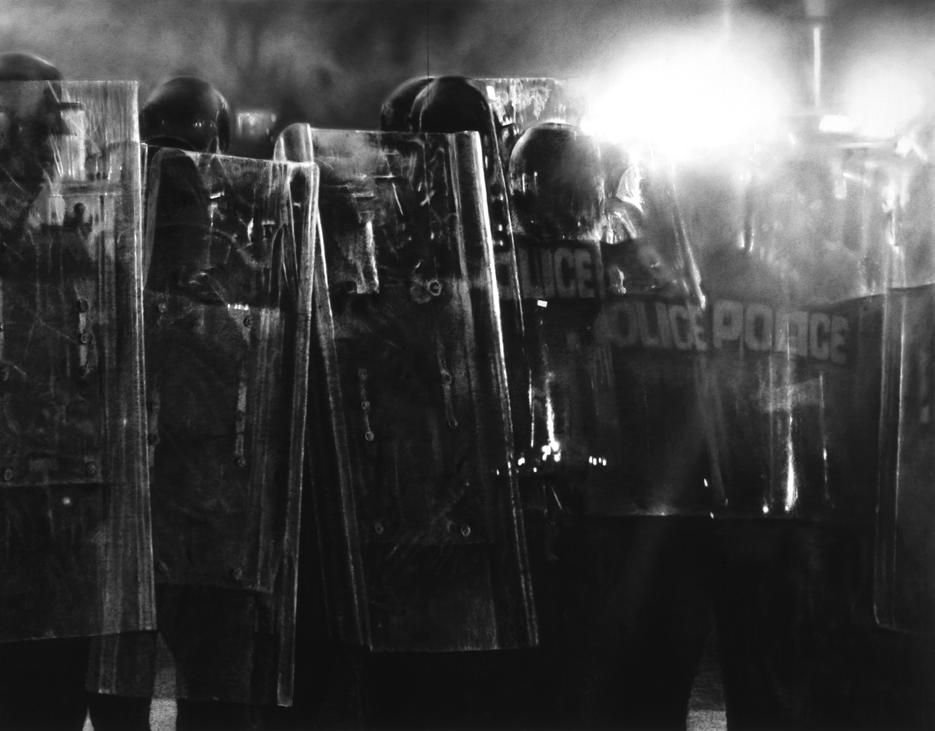
KEMP My inclination would be that we don't have good enough data on the relationship between polarization and violence to previous eras to be able to compare reliably to the current world. One thing I can say is that there is a good case to be made, and good evidence, that existing levels of polarization and the increase over the last few decades is pretty closely tied to things like wealth inequality. Wealth inequality ends up being one of those key variables, which drives a

whole bunch of different outcomes and processes that can make society more fragile.
KUPPER How do technology and artificial intelligence play into the fragility of our societies right now?
KEMP Technology in an abstract sense can of course either improve our resilience or it can deteriorate our fragility. So, it's like in the old IPAT equation, which is something we often use in sustainability science to say impact equals population times affluence times technology. Technology can either mediate or aggravate your environmental impact, and it's very similar when it comes to societal collapse and global risk. Technology can either make things potentially worse or potentially better. That's the abstract of it. I don't fully buy that, because technology doesn't just simply pop up out of the ether. It's not a lottery we're playing. Technologies are funded, researched, and developed for very express purposes. My key concern is that we are frequently trying to develop technologies that dramatically increase the amount of control that governments and power hierarchies have over their citizens. If you compare the amount of money being spent on facial recognition, and tracking and surveillance technologies versus improving our ability to deliberate and reach democratic decisions, there's no big comparison there. Technology is not a neutral factor in the network. It is created by power networks and it almost always acts in service of those networks.
KUPPER Surveillance capitalism is a driving factor in the distrust of our institutions, which in and of itself can cause societal fracture.
KEMP Over time, we've actually seen most citizens under more control of the government. The average citizen under your Mesopotamian god king wasn't actually subject to that much direct control. Most of your leaders historically would have no idea where most of the population was at a given time. They had very little idea of what their direct income level was. Compare that to the modern world where your average head of state has access to a bureaucracy, which knows a lot about its citizens: where they live, what they earn, how much taxes they've paid or not, what their travel history is, and frequently personality information, including things like views expressed on social media. The business as usual trajectory of heading towards something close to surveillance states where our hierarchies have an immense amount of knowledge and control of their citizens, that's not a good place to be.
KUPPER You also talk about creating a new lexicon for these various sorts of calamities. What are some tools you're using to implement that new lexicon?
KEMP In the “Climate Endgame” article, one of the key contributions we make is providing a new set of terminology, which clarifies terms like existential risk, extinction risk, global catastrophic risk, et cetera. One of the big pivots here is actually conceptual rather than linguistic. That's the pivot away from thinking, isthisanexponentialrisk? to whatisthecontributionofthisextinctionorglobal catastrophic risk under a particular future? Apart from providing that lexicon, in my own book about collapse, I’m trying to do a very similar thing,
because collapse is as an incredibly ambiguous and fuzzy term, and it captures a huge amount of different processes ranging from state failure, to the disruption of power networks, regionalization, et cetera, and a range of different outcomes, some of which are pretty benign, though some can be quite shocking.
KUPPER The IPCC report doesn't even mention catastrophic climate change. Is that correct?
KEMP As far as I know, they don't use the term and they don’t define the term catastrophic climate change. They do definitely talk about higher-emission scenarios. So, there's both RCP and now SSP8-5, which is looking at a level of anthropogenic emissions, which is incredibly high, probably to a fairly understood, unrealistic extent. In general, we have good evidence that the impacts of these higher-temperature scenarios are under studied. And that in general, the IPCC doesn't think about these catastrophic scenarios. Also, thinking about things like risk cascades, how one risk can trigger another one, or amplify another one. That's something the IPCC doesn't do, and it's not entirely within their mandate. And additionally, it's just harder to do.
KUPPER Are you pessimistic or optimistic about the future? Do you personally think that society collapse is inevitable?
KEMP I'm never quite sure how to respond to this one and it's one I actually get asked quite frequently. The platitude of course, is to respond with, “I’m not pessimistic or optimistic. I'm a realist”, which I think is a bit of a cop out. I am pessimistic about the business-as-usual path that humanity finds itself on. And I'm pessimistic about most of the trends and pressures relevant to global catastrophic risk. However, I'm very optimistic about humankind. I'm optimistic about our ability to coordinate and to reach collective decisions. And I'm optimistic that if we actually do have genuine democracy in our societies, then we can coordinate effectively to minimize most of these risks.
end


Michael Stipe, the soulful vocalist, lyricist, poet, photographer, and visual artist from Athens, Georgia woefully echoes the dark and melancholic with his unique, once-in-a-generation voice and a stage presence that recalls a Southern preacher summoning distant ghosts. He has said that generations of men in his family were Methodist ministers and that he comes from a place of faith. REM, the band he founded with fellow students at the University Of Georgia, which released its debut album in 1981, inspired a generation of bands after them: The Smiths, Nirvana, Pixies, The Cranberries, and countless others. For three decades, the band cemented itself as one of the most important and foundational fulcrums of alternative music. Their song “Losing My Religion,” an unlikely smash hit from the band’s 1991 album Out Of Time, is a haunting, prophetic, and abstract ballad of fractured spirituality, existential questioning, and yearning that could very well be a soundtrack to our present reality. In September 2022, the music video for “Losing My Religion,” directed by Tarsem Singh, reached the rare milestone of one billion views on YouTube. In the following interview with Hans Ulrich Obrist, Stipe discusses his disparate art-making practices, alternative truths, and art as the highest form of hope.

HANS ULRICH OBRIST I have some questions about the past, but I think we should start with the extreme present. You're working a lot, as always, and you're editing images. The last time we spoke you were involved with the curation of some shows and also with your own visual art practice. So, I'd love to hear more about what you're working on now.
MICHAEL STIPE Right now, it feels like there's this upsurge of interest in magazines. I'm doing all this work for different magazines, like this conversation. And it's exciting to me. I was editing images for a collection of nudes—photos that I took some years back, but have never been seen before. Some were in the books that I've done with Damiani. I've done three books now with Damiani out of Bologna, and I'm working on a fourth. I'm also working on another
generations, or decades later. I love the photo books that I've worked on for that reason, because I think they can be either seen or not seen right now. One of my most recent purchases that I've been reading is this hysterically funny memoir, a biography of John Hurt, the actor. I bought it on eBay. It's signed to Michael, withmyverybestwishes,JohnHurt. Well, I bought it on eBay and it was some other Michael that he signed this book to, but it's quite interesting. And then, I have this book by the photographer Dino Pedriali—images of [Pier Paolo] Pasolini.
HUO So, you also collect books?
MS I love books. To answer your question about the three books with Damiani—Volume One was the first one that I did, with Jonathan Berger, the artist and curator. And the second one that I did
to be. With the advent of Deepfake and AI, we have to be quite careful about where it's all headed and establish grounded attitudes towards what is real and what is not real. We also need grounded attitudes about the importance of privacy and how that impacts our daily lives.
HUO The book addresses that big theme?
MS Mostly it's visual. It's about how if you move into a digital image, it eventually looks like a molecular photograph of nature, and how as we get further away from analog through digital technology, we become perhaps a little more understanding of the magnificence of nature, and we maybe have a greater calling towards preserving our place here on this beautiful planet, and acknowledging the impact that we've had through all these advancements that we've made—some of which are absolutely brilliant. But moving forward with true stewardship, not only towards ourselves, but towards other species and the concerns that have arisen with our dominance over the past couple hundred years.
book with a different publisher, which is a collection of lyrics. And I'm doing that with Patti Smith. Then I'm working on my first solo album, which hopefully will be out by September of 2023, and a solo show at ICA Milan—also in fall of 2023. That will be a lot of photographic works, some sculpture pieces, and some audio/visual stuff, not unlike what you saw at the Serpentine so long ago.
HUO Can you tell me about these books? Helen Levitt once told me that when a photographer makes a book, it's often as important as an exhibition. And that's not only true for photographers, it's also true for visual artists. The artist book is such an important medium. We just lost Lawrence Weiner, one of the great masters of artist books, who had done hundreds of them. And you've given a lot of time to these artist books with Damiani. Can you tell me about these three different volumes?
MS Sure. I'd love to. But first I have to ask, you spoke with Helen Levitt?
HUO I had a conversation with Helen Levitt when she was in her late eighties. In her house, in New York, the heating wasn't so great, it was a bit chilly. And she had layouts of books around. And then there was a lamp in the middle of the table—quite a big lamp. And that was the warmest place, because the lamp emanated some warmth. And her cat sat underneath the lamp because the cat was also freezing. So, it was a trialogue between her, myself and the cat.
MS Incredible. I tried with two friends in 1989 to make a documentary film on the life of Helen Levitt and the work that she produced as an artist. I think she's extraordinary. But we never succeeded in making the documentary. We had to go through a woman who was acting as her agent, but this woman had severe allergies to everything. So, we were not allowed to wash our bodies with soap, or wear deodorant, or use shampoo, or smoke within three days of seeing this woman. And we never got past her to Helen. So, I'm thrilled that you did. As a fan of her work, I purchased several of her images in the 1980s and I still have them. I still have the box where she wrote in her beautiful script: fragile, please do not bend. I have to say, I agree with Helen Levitt in terms of images done for books. At this point in my early sixties, I'm realizing that books are quite permanent, and they'll get lost or forgotten, and then they'll get found again many
with Douglas Coupland, [Our Interference Times: A Visual Record], is about the strange moment that we are in now between analog and digital, and how generationally you can sit down with a 15-year-old or a 25-year-old and have a completely different perspective on what imagery is and what it means, and the power of imagery based on how they've received their information digitally versus how we received our information. Our generation received it first in analog. Now, there’s a renewed interest in younger generations working with analog methods like cameras with film, which I've gone back to. Having been almost exclusively digital for a while, I've now gone back to [Kodak] Tri-X, which I just love shooting with.
HUO It's interesting about the analog—the fact that our generation kind of lived in this inbetween space because we had an analog childhood and then at a certain point in the ‘90s, the digital arrived. I remember when I visited you in your apartment in New York, maybe ten years ago, when we started to work on a Serpentine performance, you showed me some sculptures of analog media, like audio cassettes. It would be great to hear a little more about your sculpture.
MS I mean, those felt necessary at the time. But now, it's interesting that there's a renewed interest in vinyl for listening to records. There's a renewed interest in cassettes for listening to music. There's a renewed interest in all these cameras that I thought were just moving into the past. They became relics, which is what I called those bronze pieces. I love picking up a camera that looks like it's made of plastic, and it's bronze, and it weighs five pounds, it's quite fun to watch people's reaction when they pick up one of those pieces. I've certainly moved on from there, though. I think I did those pieces in 2008. But the book does address the cultural and generational shift that's occurred with the advent of digital technology and how impactful that's been on our lives. We now see the pathetic or rather sad impact of social media on politics and on political movements. We're currently at battle with ourselves to try and establish what is truth and what is alternative versions of truth, and what is an alternative version of an alternative version of truth, and this is leading into territory that you and Doug [Coupland] certainly cover a lot in your work, which is more looking into the future to and where we're going
HUO It’s interesting because I remember about fifteen years ago, when we saw these sculptures of yours and there were the first exhibitions, and then you started working on the books—you didn’t stop making performances. People thought that you transitioned from music into arts, but looking at your trajectory, that's far from the truth. The truth is that you've always had these parallel realities. There is music, but there is also poetry to the lyrics. There is visual arts. There is photography, and of course, performance.
MS Performance is profoundly important, because it’s always what I did.
HUO Your practice is very fluid. It incorporates poetry, music, performance, architecture. They are parallel realities.
MS Yes. I agree entirely. I'm happy that this century has provided us with a language and an understanding of stepping away from that sandboxing, where you do one thing and that's all that you should do. And rather, acknowledging that there's a Venn diagram. There are areas that overlap, particularly within the creative community now. People are able to establish their work in more than one medium. Patti Smith is an excellent example of that as well. The work that she's done as a writer in the past decade has added to the understanding of her as a polyglot—and added to the work that she did as a singer, songwriter, musician, and performer. And there's a younger generation of people that don't feel constrained by these same ideas; that if you're an actor, that's all that you can be. If you're a musician, that's all that you can be. If you're a painter, you should absolutely not try sculpture or poetry. Well, I think that's hooey.
HUO And of course, Patti Smith has to do with an early epiphany of yours because there’s a rumor that you were fourteen when you saw an article in Creem magazine by Lisa Robinson on the CBGB scene. There was a photo of Patti Smith and that somehow was a trigger. It’s interesting because I spoke to Kazuyo Sejima and I asked, “Why did you become an architect?” And she said, “You know, when I was a teenager, I opened a magazine in my parents' house and there was a photo of Sky House by Kiyonori Kikutake and this little black/white photo opened everything.” It seems like that photo of Patti Smith, who later became a friend and colleague, has been really liberating for you. Can you talk a little bit about that?
MS It's really wild to count her among my closest friends and to be able to observe the work that she does as an artist from a distance as a fan, but also from really up close and to see how dedicated she is
"We're currently at battle with ourselves to try and establish what is truth and what is alternative versions of truth... "
to her work. As a friend, she'll ghost me for two weeks at a time and I'll finally reach out to her, like, are you okay?Iseverythingright? It turns out she's just been off writing and working. Phone calls and texts and communication with friends and family fall to the wayside. She has this sense of priority to her work that I find extremely invigorating and thrilling—it pushes me to embrace the moment when I'm working, to step away from the phone, to step away from this feeling that I have to be in constant contact with people all the time. I mean, I'm doing this conversation with you partly because I just haven't seen you in so long and I wanted to say hi, but I'm in the middle of writing a series of songs—I've got eight finished, I'm working on another ten of those, and about six are in very good shape. And so, I've been in the studio all week, working predominantly with synthesizers, and working with a live drummer, which is brand new for me since my former band disbanded. It's my first solo record, but I just had to step away from what turned into about five years because it was so all-encompassing. In the most beautiful way, it steals every breath that I had for the better part of my adult life. I needed to take a really long break away from music in order to either approach it again or to find other mediums that I wanted to explore. As it turns out, because of the 21st century, with the understanding that a lyricist can do all these other things, I feel free and open to exploring this publicly. It's stuff that I would've been doing privately anyway, but now there's this interest in books and how permanent books are compared to performance, compared to other ways that I've expressed myself in the past. I'm really excited about my books being stuck on a shelf somewhere and discovered fifteen years from now by someone who doesn't even know that I once sang with a band, or that I have a voice outside of photography, or portraiture.
HUO And there is one book that’s missing—a book of earlier poems and lyrics, that doesn't exist yet. No?
MS That's the book that I'm working on with Patti. It was her idea and she really pushed me to put out a classic volume of poetry in the form of lyrics.
HUO And what are the new lyrics about?
MS I'm right in the middle of it, so it's hard to talk about, but there's a very 21st-century duality. The themes that I'm addressing are extremely layered and nuanced. There seem to be threads running through the songs not only thematically, but there are these characters I’ve written that keep appearing at different times in their lives. There are a few examples of new work online, a song called “Your Capricious Soul” and there's a song called “Drive To The Ocean” that you can find on all the streaming platforms. I released them as they came out because I didn't want to feel like I was holding material for a big solo album splash. I just felt more comfortable putting it out into the world and letting it be what it is right now.
HUO And the theme, of course, of the magazine is “Losing My Religion.” It will be an exploration of changing belief systems in the age of information and disinformation, secularization, conspiracy theory. You already talked about the information age in relation to your books, and I suppose those are themes that appear in the new lyrics.
MS I'm quite suspicious of social media. I was on it for a while and I was having fun with it. But then, I felt violated by it, truthfully. I felt like this was not the truest or best way for me to establish communication with, not only people that are in my life, but also with some spoken or unspoken audience that's out there watching or listening. This is something that we really do have to address in a big way: the impact that this has
on how we are able to, or not able to, communicate with each other as individuals, as people, and to question these very important issues of privacy and truth. What is truth? You know, Wolfgang Tillmans did this book called What Is Different? (2018), which addressed the idea of people that have believed something, and then when that thing is proven to be false, rather than acknowledging that they've been tricked, they double down. It’s called the Backfire Effect. So, what is truth and what is alternative truth? Another one of my main sources is a podcast that I strongly recommend called Conspirituality. It's these guys that talk about exactly these topics in a way that I find very interesting. I follow them quite routinely. One of the last books that I thoroughly enjoyed was a recommendation from that podcast by an author named Benjamin Teitelbaum called War For Eternity (2020). It's quite prescient to the moment that we're in, because one of the main characters in the book is Alexander Dugin, the Russian philosopher whose daughter was just murdered in a car bomb in Moscow.

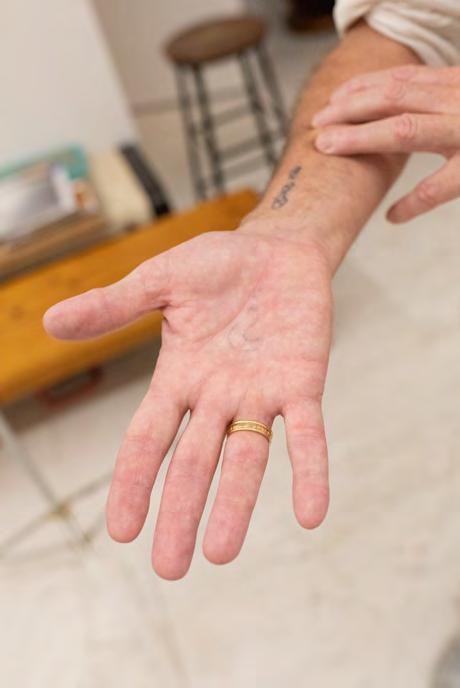
HUO Who is a nationalist philosopher.
MS Yes, but he's also a follower of a spiritual belief called Traditionalism, and he shares that belief system with other people, such as Steve Bannon and Olavo de Carvalho, who died this past February in Virginia, but was an advisor to [Jair ] Bolsonaro in Brazil. So, it's all these places where these somewhat despotic or protofascist leaders are espousing these ideas and putting them into policy, and behind them are these people that have this shared spiritual belief system.
HUO This issue is connected to these current discussions. You already addressed information, and disinformation, but it's also an homage to the extraordinary hit single of yours and REM, “Losing My Religion.” And it connects to what we just said about your lyrics being great poetry, which are about very existential torment. What I understood is that the title comes from a Southern expression that refers to being so desperate and at the end of your rope that you lose faith. Can you talk about the moment or the epiphany for this song?
MS I don't remember the moment of titling the song “Losing My Religion.” The lyrics came out of automatic writing. The actual Southern phrase that I drew from is not losing, it's lost. I lost my religion. You would say, “The rain was so intense I almost lost my religion.” Or, “We were late to the party and she kept yelling in the car—I almost lost my religion.” You would say it in this very casual way. But in the song, it becomes much more than that. It turned out to be the biggest hit that my band had at the time—other songs eclipsed it later, but that was and remains one of our best known songs. The book I was just talking about with these followers of Traditionalism is, in a way, a 21st-century version of a made up religion that is inspired by Hinduism, but has been pieced together. And these quite significant characters in our history as we are living it in the present moment, they each have their own version of it, and they don't even necessarily agree. In one case, you know, Alexander Dugin and Steve Bannon are working against each other in terms of China and what China means to the Soviet Union or what China means to the Western world. And so, it reminds me of another song I wrote called “Oh My Heart.” And the opening line is the kids have a new takeonfaith.Pickupthepiecesandgetcarriedaway. It addresses this idea that in our generation, Hans Ulrich, people in the 1960s and ‘70s started to question organized religion and the importance it had in our lives. Not just politically, but spiritually and emotionally how manipulated we were by our belief systems. In questioning these organized religions, we all started

piecing together from different belief systems. So it was like, here's this new thing called Transcendental Meditation, or here's an understanding of Hinduism that we didn't have before through the advent of yoga, and the Beatles going to hang out with the Maharishi, or the concert for Bangladesh. All these different understandings coming at us and people pulling from Judaism, from Buddhism, from Islam, from Christianity, from Catholicism, from atheism, pulling together and creating each of us, a church of ourselves, a belief that what's right for Michael is the church of Michael. And I'm gonna alter and shift these beliefs and these ideas as they fit what I need them to be. And you could say the same for the church of Hans Ulrich. There may be a lot of overlap in your belief system with my belief system, the things that we agree or disagree about, but there might be places where mine just goes flying off into outer space with let's say an interest in Vedic astrology. And yours might go flying off in a different direction with an interest in a messenger RNA technology brought about by fever dreams, let's say. So that’s something that the 21st century has afforded us. And it's interesting to me—this phrase “Losing My Religion” is something that can be taken in many, many different ways. And it's a nice song—it's a song about kind of an obsessive, yearning love—but as a phrase it moves into culture in a way that it has a much broader and more nuanced meaning.
HUO It’s one of my favorite songs. Also, what happens when religion is gone and there are no gods to turn to? It brings me to the question of art being a new religion—maybe not a new religion, but art as the highest form of hope, as Gerhard Richter said.
MS Oh, I would not be in disagreement with that. You know, it's a little bit of church of Michael for me to say this, but I do believe that artists at their best are providing new ways to look at who we are in the moment in order to present a more hopeful, more progressive or optimistic future, to move forward as humans with a greater understanding of the complexity of our emotional and our spiritual lives, and allowing ourselves as artists to be vulnerable, to fall on our face publicly, to put together an entire body of work that may be actual shit. And then to say, “Well, what doesn't kill me, makes me stronger.” I think with live performance, certainly, and I know this firsthand, every night wasn't brilliant, and there were nights when people recognized that. But there was an understanding that these are humans trying to do their very best work, and we have to acknowledge and understand the positive things that they've done .
HUO Another thing, which has to do with this idea of collapse is the extinction crisis. MIT published a report in the ‘70s saying that by the mid-21st century, with the extraction of resources, mining, and environmental disasters, we are on track for this collapse of civilization. And now predictions are that this could even be earlier than 2040 as predicted, but as soon as 2030. There are more wars and famines. So, that of course also raises the question, not only of art being hope, but also of the agency we have in finding solutions. Can you talk a little bit about this?
MS For me, it started at a very young age. I bought my first toys as a seven-year-old by collecting bottles and newspapers, and recycling them. But I had a very early class at the age of thirteen or fourteen in environmental science. It was a year-long class and I believed quite naively that my generation would be the one that would bring about alternative energy— That we would cure the problems of air pollution, of industrial pollution, of landfills. Climate change was not something that was spoken about in 1973 or ‘74, but
everything that was written then was leading towards this ultimate collapse of our relationship with our planet, with the world. The idea that our grandparents’ generation had about the world’s resources being endless, and not finite, we now understand to be inaccurate. Something that art can provide, hopefully, is optimism. I'm the glass half full guy, I always will be, even with my darkest writing, my darkest songs, I try to infuse a bit of hope and optimism into them, or a bit of an epiphany into the character so that even if they are in this very dark place, they're coming
understanding of humanity and the idea of Gaia, the idea of Earth as its own entity, and our relationship to it.
HUO I met James Lovelock and did long interviews with him about his ideas on Gaia. One of the things we can concretely do about climate change is eat less meat. So, you've also opened a vegetarian restaurant in Athens, Georgia—is that still open?
MS It is ongoing, but I didn't open it. I'm the landlord of the building that the restaurant is in. I was never involved beyond that. So, that's been a
through it into something else. We didn’t recognize growing up, the idea that by the mid-21st century, and now possibly sooner with this ecological disaster upon us, this would have such an impact on young people. They’re bombarded with this message from social media, television, their parents, school teachers, policymakers that it's hopeless. And this hopelessness is emotionally and spiritually infused into these younger generations. But I see the exact opposite of that. I feel like culturally, there is this immense problem of hopelessness. But I also see—and I'm speaking of my goddaughters here, so this is anecdotal—people that are teenagers now, or in their early twenties, and are turning this on its head and saying, “This is our time to make vast change, to implement the knowledge that we have available to us, and push it towards something that is hopeful, and not just a collapsing dystopian universe.”
HUO In terms of positive contributions that actually can be done, you did the Hurricane Katrina disaster relief fund, covering Joseph Arthur's “In The Sun.” Can you talk a little bit about this?
MS My response to Katrina was visceral because I had worked in New Orleans and I felt obligated to that city. The song that I quoted earlier about the kids having a new take on faith is a song written about Katrina. It's a character that has survived the storm and is now being bussed off to some other place, and he has no idea where he's going. There's two songs— one called “Houston,” and that was immediately after Katrina. And then, there's another song called, “Oh, My Heart.” Each of these are the same character, in the first song, leaving New Orleans as a destroyed flooded city. And in the second song, returning to New Orleans to help bring it back to the majesty of a city. We raised over a million dollars for Katrina hurricane relief and Justin Timberlake helped with the record. All these people stepped forward and donated their time and energy towards providing something that would allow for a little bit of relief for the people that lived there and the people that were displaced. And displacement is another part of what we're looking at—we're going to have environmental refugees and political refugees for the remainder of our lives. This is something that we need to address immediately because of these larger ideas of: what is a nation, what is a border? What is our obligation? Where is nationalism after the perversion of what we found in the 20th century during World War II? What is nationalism and what is the importance of nation states and borders? And a greater understanding, that might be extremely church of Michael, but a greater
misunderstanding or rumor for decades. I decided very early on as a young man that I didn't want to eat meat and I stopped for twenty years. And then, I started again, and stopped again. But it’s a very minor example of something that we can do individually. There are greater understandings to address and questions to be thrown into the conversation in terms of where we are with climate refugees and with climate change, and all the other problems we are facing now. Brian Eno also started the organization Earth Percent which is basically a tithing for people who work in the music industry, to offer a percentage of the money that they are able to bring in towards addressing climate change.
HUO Somebody who is in the younger generation of music and has been very active in environmentalism is the amazing Mykki Blanco. And you worked on a new track with Mykki for her album. Can you tell me about that?
MS We've known each other for a while and she just sent me a text and said, “I'm doing a new record. I've got a song, I hear your voice on it. What do you say?” And I said, “send me the song. Let me see what I think about it.” And I loved the song—it’s called “Family Ties.” I recorded my voice and did some footage for a music video and they mixed it in. It's a beautiful song and a beautiful record. And Mykki is a beautiful, beautiful performer. The album and song is available online.
HUO I forgot to ask you before, do you remember the day when you decided that REM would be called REM and what prompted that name?
MS Yes, it’s funny. We needed to have a name. So, we opened a dictionary, stayed up all night and wrote names with chalk on the wall of the apartment we were renting at the time. There were a lot of joke names that were silly and stupid, but the name REM I found in the dictionary, which stands for ‘rapid eye movement.’ We decided to take the name and make it stand for nothing. I hadn't really written a proper song at the age of twenty when we chose that name, but a year and a half later, I had started writing proper songs. I found my voice as a writer and as a lyricist. Looking back, it's interesting to me that a lot of the inspiration that I have comes from this quasi-somnambulant dream state. And that's where these lyrics and these ideas are coming from. So, REM was quite appropriate as a name.
HUO We know a lot about architects' unrealized projects because architects enter into competitions, and they publish them, which helps with later making them seem perfectly realizable. But we know almost nothing about visual artists, musicians, composers,
"I'm the glass half full guy, I always will be, even with my darkest writing, my darkest songs, I try to infuse a bit of hope and optimism into them..."
poets, and filmmakers’ unrealized projects. It's interesting to talk about unrealized projects, not in order to keep them unrealized, but to actually create awareness and maybe find ways to get them realized. I was curious if you could tell me about one, or two, or three of your favorite unrealized projects.
MS Speaking as a 62-year-old, and realizing that my time on Earth is limited, and the ideas that I have just keep compounding, I have to really focus on what's significant enough for me with the time I've got remaining and focus on that. I want to be happy in the work that I'm doing. I want to feel satisfied and fulfilled on a personal level, but I also want to feel like I'm leaving something behind. Not only am I addressing something in the moment, which is crucial to the artist, but I'm also leaving something behind that's significant and important. And that resonates past the moment of August of 2022. So unrealized projects—about ten or twelve years ago, I approached a couple of people with the idea of creating a marble bust. The three people that I will name are a friend of mine named John, who just has a very beautiful face, a very long nose, a very prominent brow, and large ears that stick out; Amanda Lepore; and the Londonbased chef, Margo Henderson—she and her husband have several restaurants. I just think she's one of the most extraordinarily beautiful women on Earth. Marc Quinn did some pretty significant busts, but I don't know of anyone who has really carried it into the 21st century. I felt someone needed to do that.
HUO Beautiful. And then, there are also some of your films. I remember you once told me that just after launching the debut album of REM, you worked on a low-budget, Super 8 film, and that's a realized, unrealized project. It was shot in Athens, Georgia but it's actually never been released. Is that true?
MS I’m in my studio right now in Athens, Georgia and there are several boxes of undeveloped Super 8 film that I shot in the 1980s that had thematic thread running through them. The project was called SelfTimer. And then, of course, there's the project that I mentioned at the very top of our conversation— the documentary film about the work and life of Helen Levitt.
HUO And that’s an amazing coincidence that we started with that. There is also an unrealized album with Kurt Cobain. I couldn't find much information online, but I know that you wanted to lure him away from his home to help him. And there was no more time, because he passed away. You did a tribute to him on the album Monster, but before that, when he was still alive, you wanted to do an album together.
MS The word lure is exactly perfect. I created a project to try to get him out of the frame of mind that he was in. He was in a very dark place and ultimately, he didn't survive that dark place. The plan was to geographically take him out of that house and put him in a recording studio with a project in mind. And I was dangling myself and the idea of a collaboration as the carrot, but it didn't work. I sent plane tickets. I sent a driver to pick him up. The driver sat outside the house for hours. Kurt never came to the door. And after his death, the plane tickets were found thumbtacked to the wall in the bedroom. I'd like to think that he considered the possibility. I had turned to Jem Cohen, the astonishing film director out of Brooklyn, and he wrote a letter to Kurt describing a film project and saying that his voice and his working with me would be the perfect collaboration. But it was really something that I just made up to try to lure him out of a dark place.
HUO I just reread Kurt Cobain's diaries. They're beautiful. I was wondering if you have diaries?
MS I don't, no. My diaries are photographs. I never liked my handwriting, so I try not to write anything down. I find it very distracting and embarrassing, and it’s the same with my signature, but as a public figure I'm expected to sign things. I've never kept a diary. Do you keep a diary? I would think that your conversations really are a brilliant testament of what you do.
HUO My diary is thousands of hours of conversations with artists, musicians, poets, architects. It’s a daily practice.
MS I don't know that anyone has matched the number of insanely talented people who you've sat down and had brilliant conversations with. It is, in its own right, a lost art. And so, thank you for that.
HUO No, thank you for an amazing interview. It would have never happened without our friend Jonas Mekas. When I was in my early twenties, I was at a cafe in Paris and I told him what I was doing, that I wanted to document the ideas and lives of artists and architects. He always had his Super 8 camera, and he told me, “You are going to regret it one day, if you don't record all these conversations.” So, Jonas really pushed me to do it.
MS Wow. Of course it would be Jonas who did that. And I found in the Do It book, his instruction is one of the simplest: Do it, move your finger up and down for one minute every morning. That's Jonas. God bless him.
HUO And last, but not least. Rainer Maria Rilke wrote this beautiful little book with advice to a young poet. Obviously a lot of young artists, musicians, poets, filmmakers will read our interview and want to listen to you. So I’m wondering, what would be your advice to them? What's your advice to a young artist, filmmaker, musician?
MS Trust your voice, trust your instinct, allow yourself the space to hear what your instinct is telling you and make sure to write it down. Get it down on video, put it down on your phone—however you have to get it down. And then trust that.
HUO I think that could not be a more beautiful conclusion. Thank you so much.
MS Thank you Hans Ulrich, have a wonderful sleep tonight.
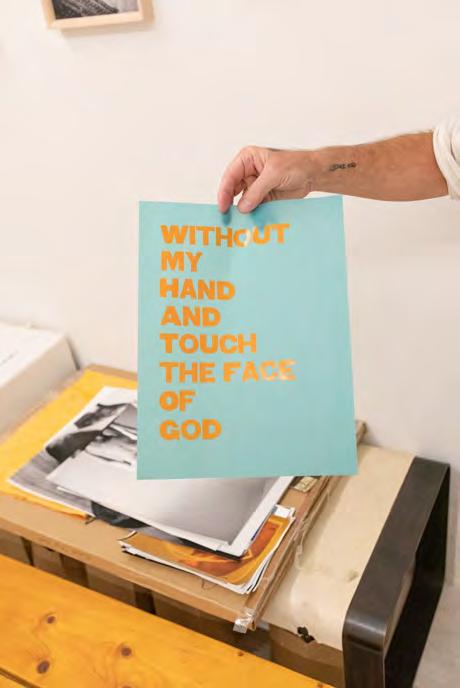


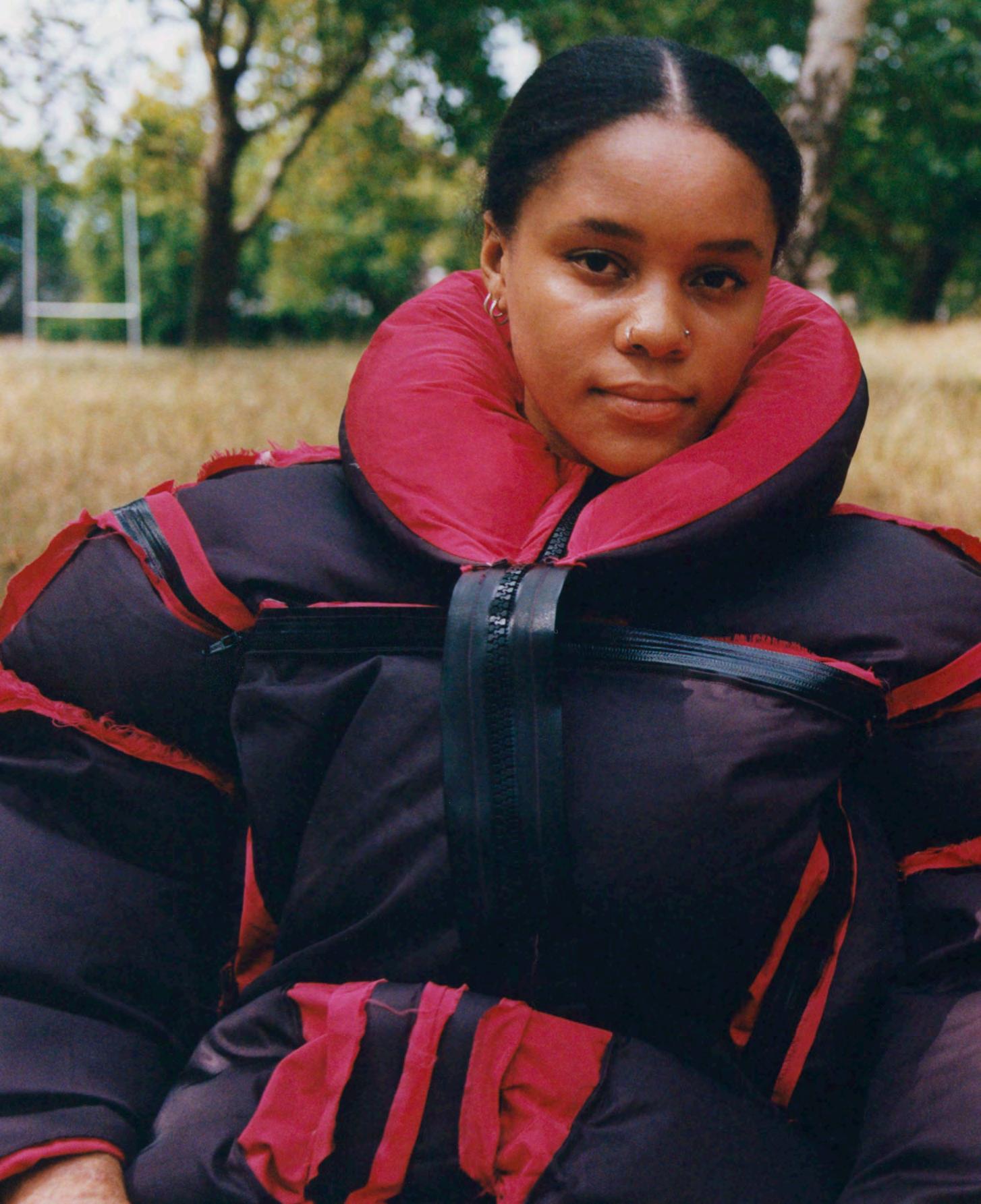

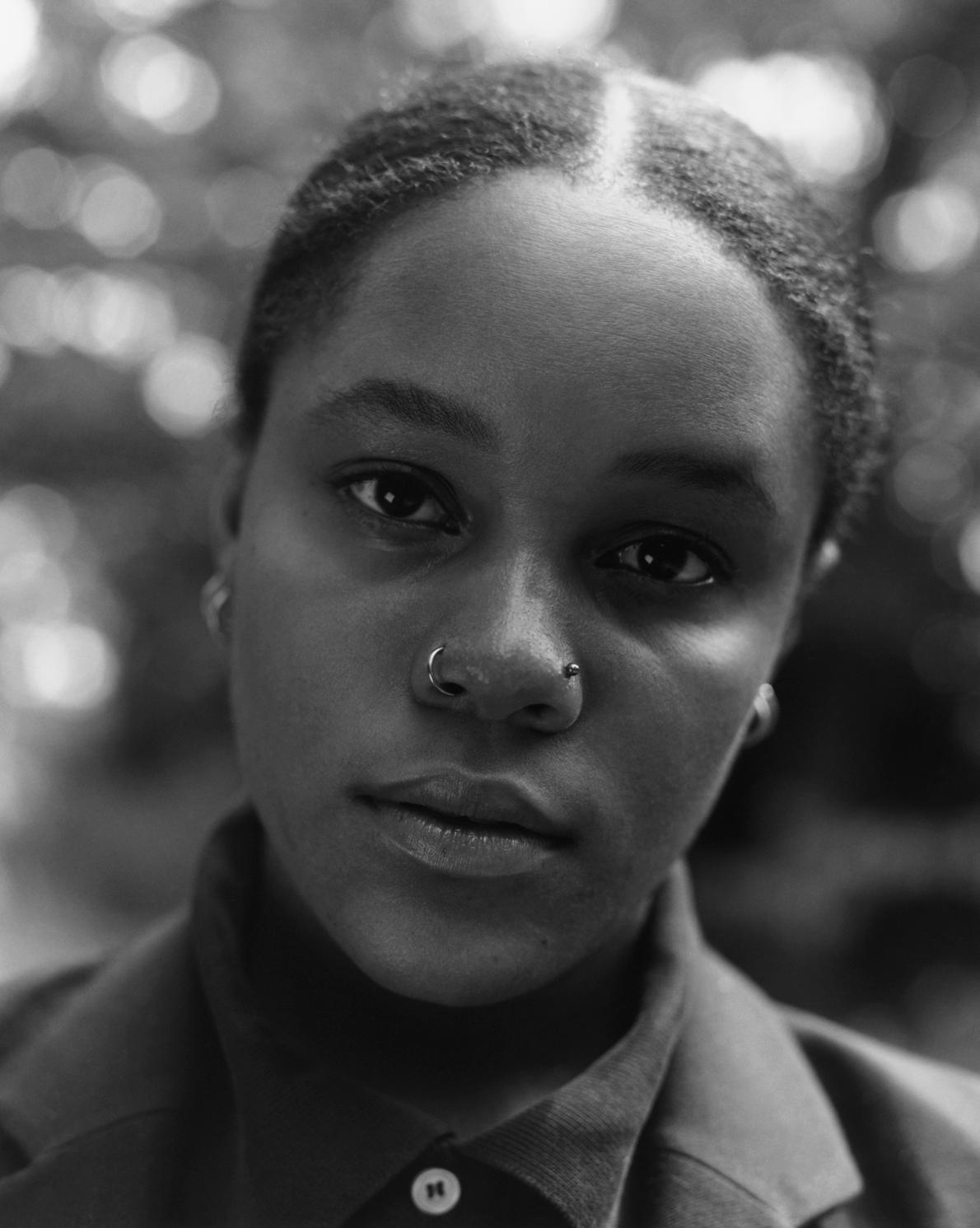

“What I fear most is life after university, and not being able to rely on the ‘comfort’ of the education system since its all I've ever known. Then having to find a job thats pays enough money to sustain a fulfilling enjoyable life—that is also something that I want to do in the creative industry. And other things like climate change and Al taking over the world.”SELINA



"What I fear most personally is failure. Not finding the right path in life and constantly second guessing my decisions because I might not be successful. And this fear isn’t fueled by money, it’s more about making sure I do exactly what I am destined to do and finding the field in which I will succeed the most."
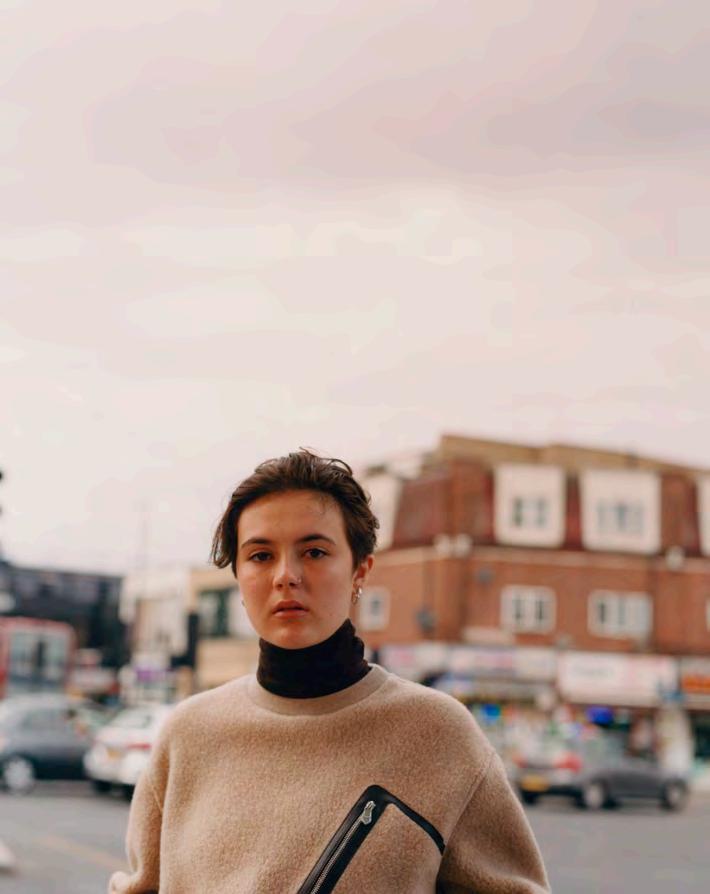
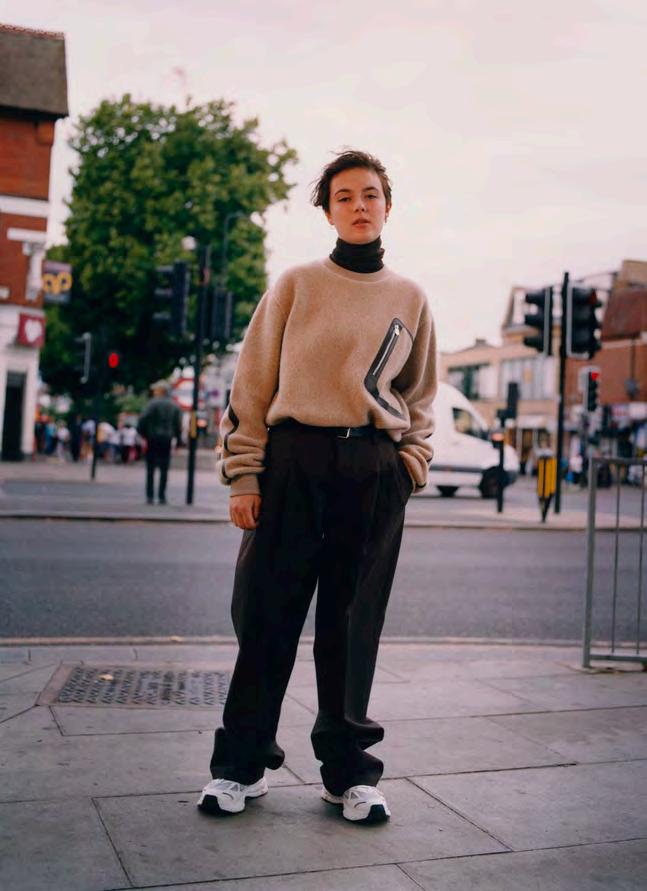
"My greatest personal ambition is to become one of the best at what I do. I’m not sure which part of the industry I fit into just yet but I do know that I want to be extremely good in the niche I end up in. Hopefully that kind of manifests in a company or brand, something I can have ownership over. It’s like if somebody wanted to work on a project within my area of expertise they would immediately think of working with me before anyone else. It’s a bit of an ego thing, but also a bit of a Capricorn thing, I think."


THIS PAGE (left) Isabel wears sweater Nicholas Daley, trousers Marie Lueder, shoes Axel Arigato Emily wears sweater & trousers A Spectrum, shoes Axel Arigato (above) jacket Marie Lueder OPPOSITE PAGE top, trousers & jacket Miriam Griffiths, shoes model's own


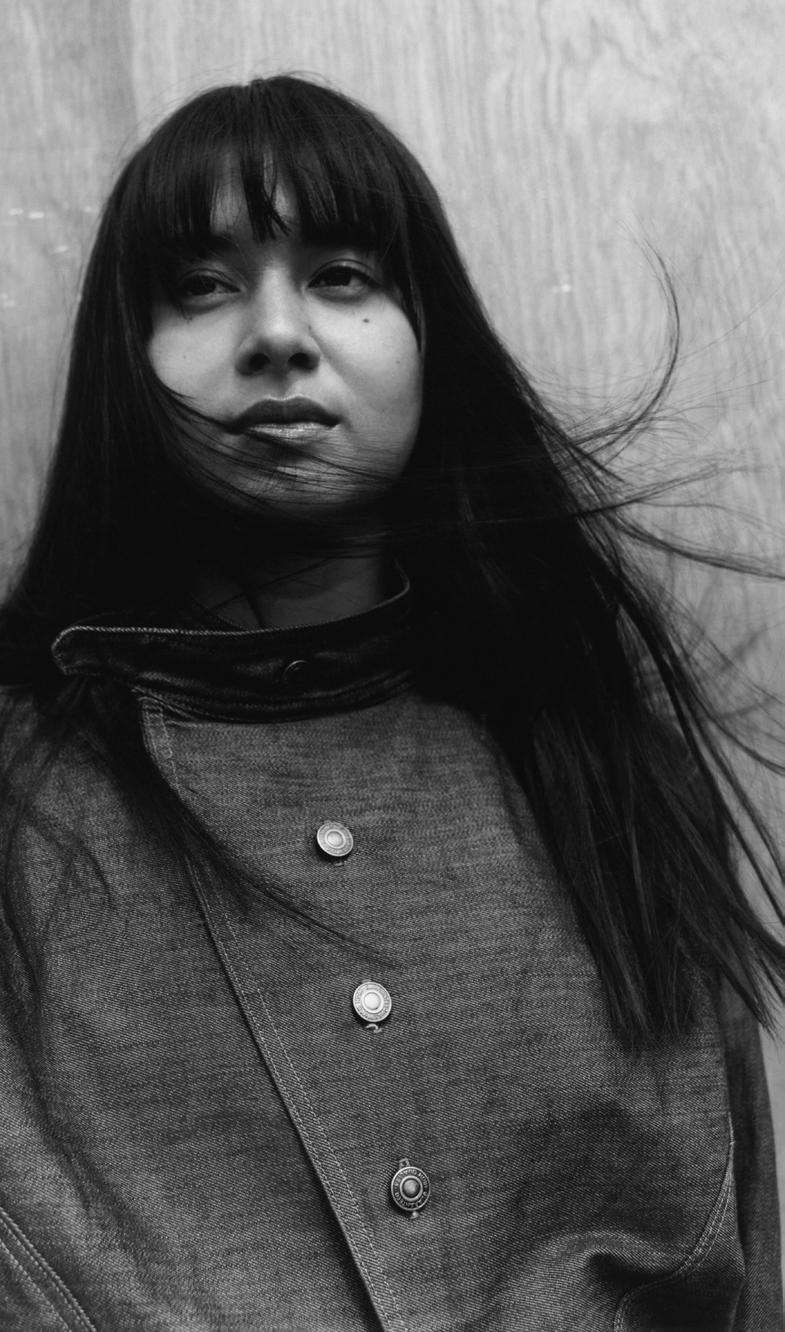
THIS PAGE Alegria wears long sleeve t-shirt & trousers Marie Lueder, shoes

Axel Arigato OPPOSITE PAGE Selina wears sweater Stefan Cooke, jacket & trousers Nicholas Daley. Emily wears top, sweater & trousers by Hermès
Alegria wears jacket Nicholas Daley Isabel wears top & jacket Miriam Griffiths
of the work I put out into the world, and to feel personal success, whatever that may look like."
young and there are so many different paths and things I want to try. Ultimately, I aspire to feel proud

"My greatest personal ambition is to simply reach my creative potential in whatever I do. I am still very
